Contract
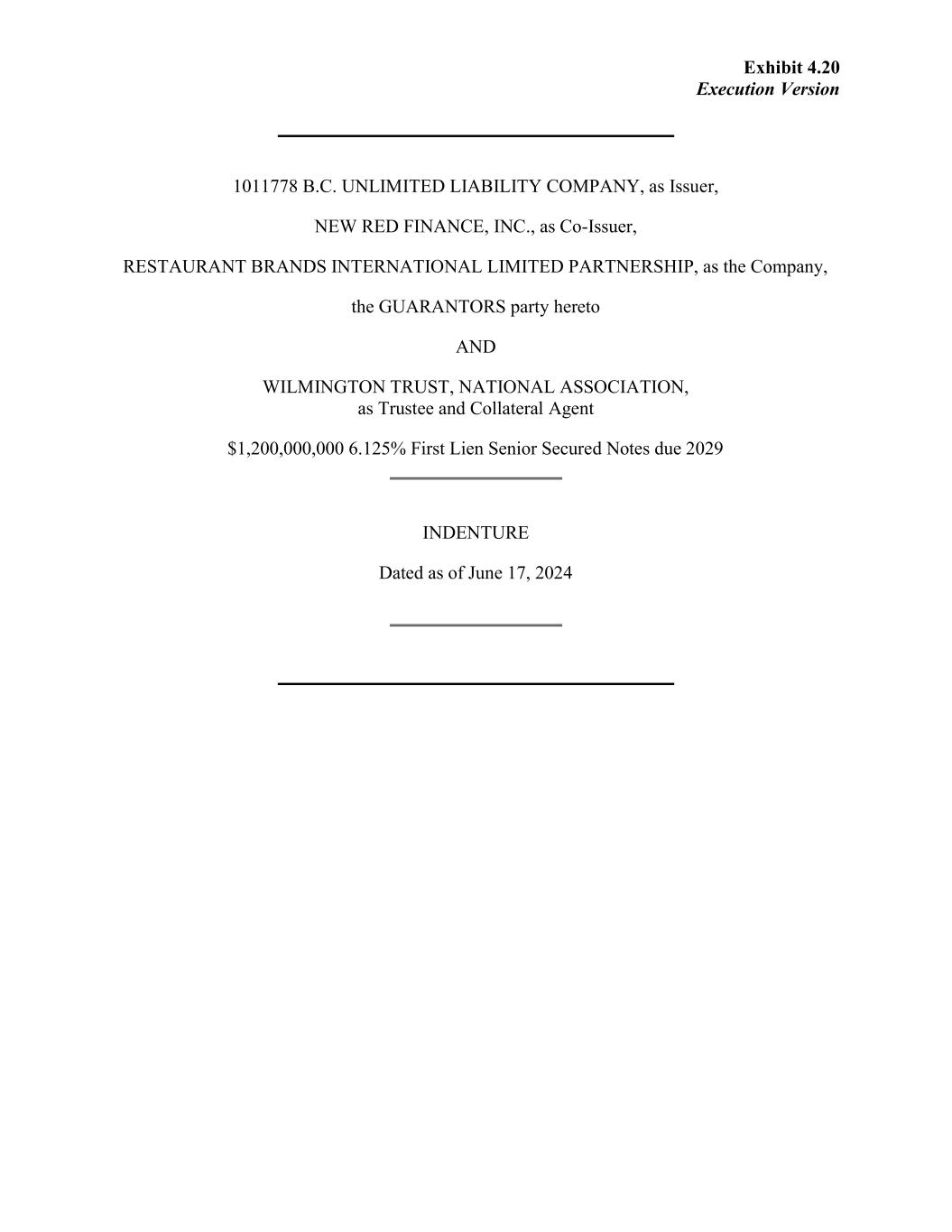
Exhibit 4.20 Execution Version 1011778 B.C. UNLIMITED LIABILITY COMPANY, as Issuer, NEW RED FINANCE, INC., as Co-Issuer, RESTAURANT BRANDS INTERNATIONAL LIMITED PARTNERSHIP, as the Company, the GUARANTORS party hereto AND WILMINGTON TRUST, NATIONAL ASSOCIATION, as Trustee and Collateral Agent $1,200,000,000 6.125% First Lien Senior Secured Notes due 2029 INDENTURE Dated as of June 17, 2024
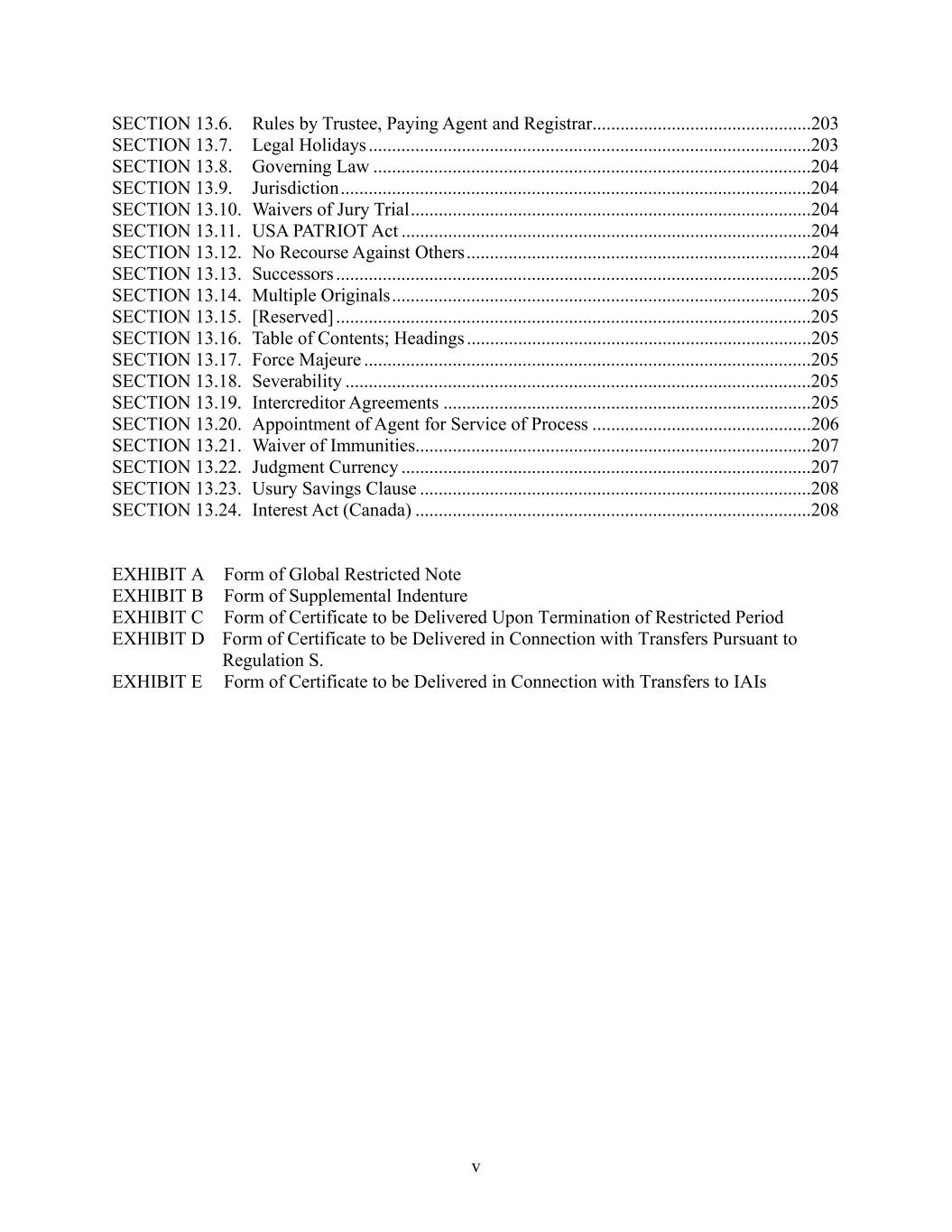
v SECTION 13.6. Rules by Trustee, Paying Agent and Registrar...............................................203 SECTION 13.7. Legal Holidays ...............................................................................................203 SECTION 13.8. Governing Law ..............................................................................................204 SECTION 13.9. Jurisdiction .....................................................................................................204 SECTION 13.10. Waivers of Jury Trial ......................................................................................204 SECTION 13.11. USA PATRIOT Act ........................................................................................204 SECTION 13.12. No Recourse Against Others ..........................................................................204 SECTION 13.13. Successors ......................................................................................................205 SECTION 13.14. Multiple Originals ..........................................................................................205 SECTION 13.15. [Reserved] ......................................................................................................205 SECTION 13.16. Table of Contents; Headings ..........................................................................205 SECTION 13.17. Force Majeure ................................................................................................205 SECTION 13.18. Severability ....................................................................................................205 SECTION 13.19. Intercreditor Agreements ...............................................................................205 SECTION 13.20. Appointment of Agent for Service of Process ...............................................206 SECTION 13.21. Waiver of Immunities.....................................................................................207 SECTION 13.22. Judgment Currency ........................................................................................207 SECTION 13.23. Usury Savings Clause ....................................................................................208 SECTION 13.24. Interest Act (Canada) .....................................................................................208 EXHIBIT A Form of Global Restricted Note EXHIBIT B Form of Supplemental Indenture EXHIBIT C Form of Certificate to be Delivered Upon Termination of Restricted Period EXHIBIT D Form of Certificate to be Delivered in Connection with Transfers Pursuant to Regulation S. EXHIBIT E Form of Certificate to be Delivered in Connection with Transfers to IAIs
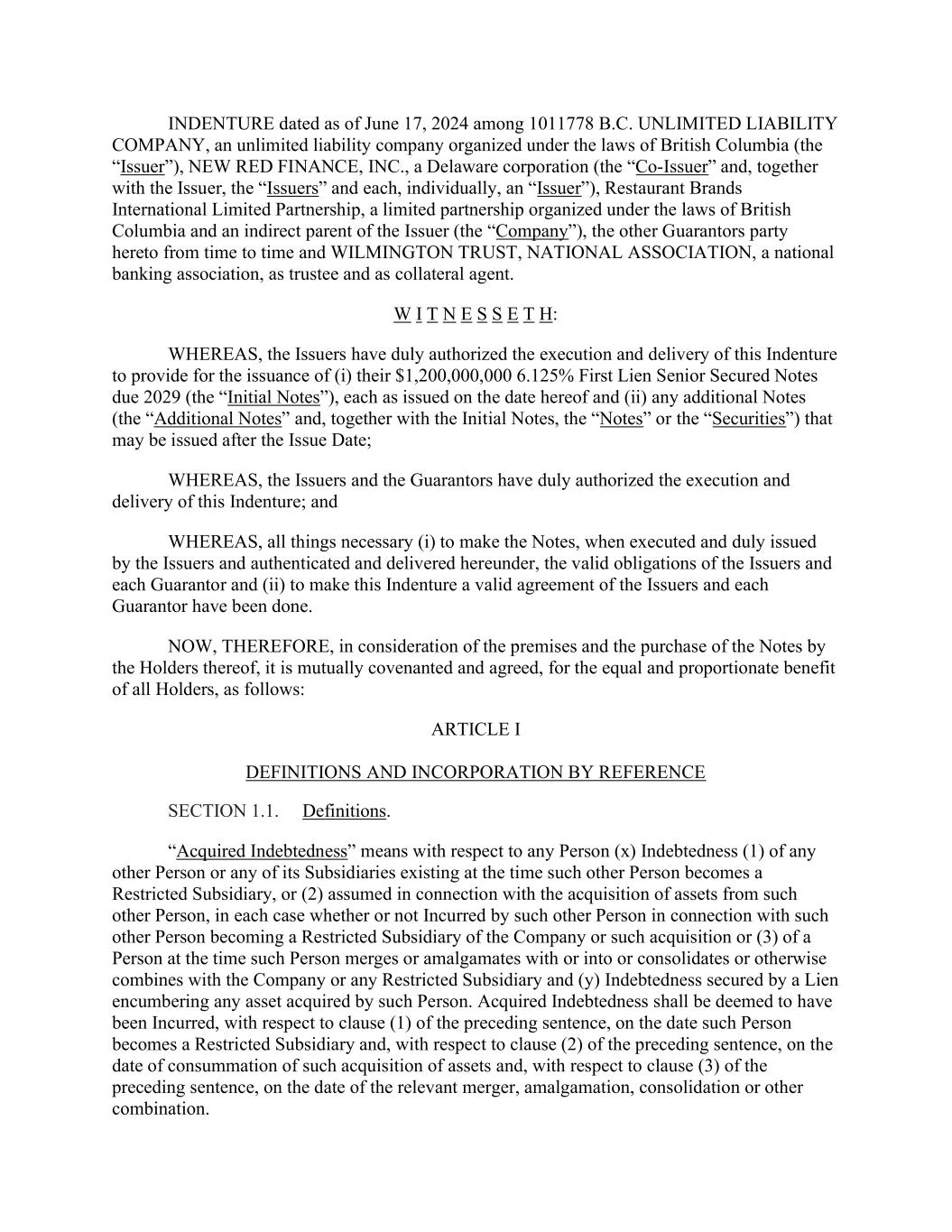
INDENTURE dated as of June 17, 2024 among 1011778 B.C. UNLIMITED LIABILITY COMPANY, an unlimited liability company organized under the laws of British Columbia (the “Issuer”), NEW RED FINANCE, INC., a Delaware corporation (the “Co-Issuer” and, together with the Issuer, the “Issuers” and each, individually, an “Issuer”), Restaurant Brands International Limited Partnership, a limited partnership organized under the laws of British Columbia and an indirect parent of the Issuer (the “Company”), the other Guarantors party hereto from time to time and WILMINGTON TRUST, NATIONAL ASSOCIATION, a national banking association, as trustee and as collateral agent. W I T N E S S E T H: WHEREAS, the Issuers have duly authorized the execution and delivery of this Indenture to provide for the issuance of (i) their $1,200,000,000 6.125% First Lien Senior Secured Notes due 2029 (the “Initial Notes”), each as issued on the date hereof and (ii) any additional Notes (the “Additional Notes” and, together with the Initial Notes, the “Notes” or the “Securities”) that may be issued after the Issue Date; WHEREAS, the Issuers and the Guarantors have duly authorized the execution and delivery of this Indenture; and WHEREAS, all things necessary (i) to make the Notes, when executed and duly issued by the Issuers and authenticated and delivered hereunder, the valid obligations of the Issuers and each Guarantor and (ii) to make this Indenture a valid agreement of the Issuers and each Guarantor have been done. NOW, THEREFORE, in consideration of the premises and the purchase of the Notes by the Holders thereof, it is mutually covenanted and agreed, for the equal and proportionate benefit of all Holders, as follows: ARTICLE I DEFINITIONS AND INCORPORATION BY REFERENCE SECTION 1.1. Definitions. “Acquired Indebtedness” means with respect to any Person (x) Indebtedness (1) of any other Person or any of its Subsidiaries existing at the time such other Person becomes a Restricted Subsidiary, or (2) assumed in connection with the acquisition of assets from such other Person, in each case whether or not Incurred by such other Person in connection with such other Person becoming a Restricted Subsidiary of the Company or such acquisition or (3) of a Person at the time such Person merges or amalgamates with or into or consolidates or otherwise combines with the Company or any Restricted Subsidiary and (y) Indebtedness secured by a Lien encumbering any asset acquired by such Person. Acquired Indebtedness shall be deemed to have been Incurred, with respect to clause (1) of the preceding sentence, on the date such Person becomes a Restricted Subsidiary and, with respect to clause (2) of the preceding sentence, on the date of consummation of such acquisition of assets and, with respect to clause (3) of the preceding sentence, on the date of the relevant merger, amalgamation, consolidation or other combination.
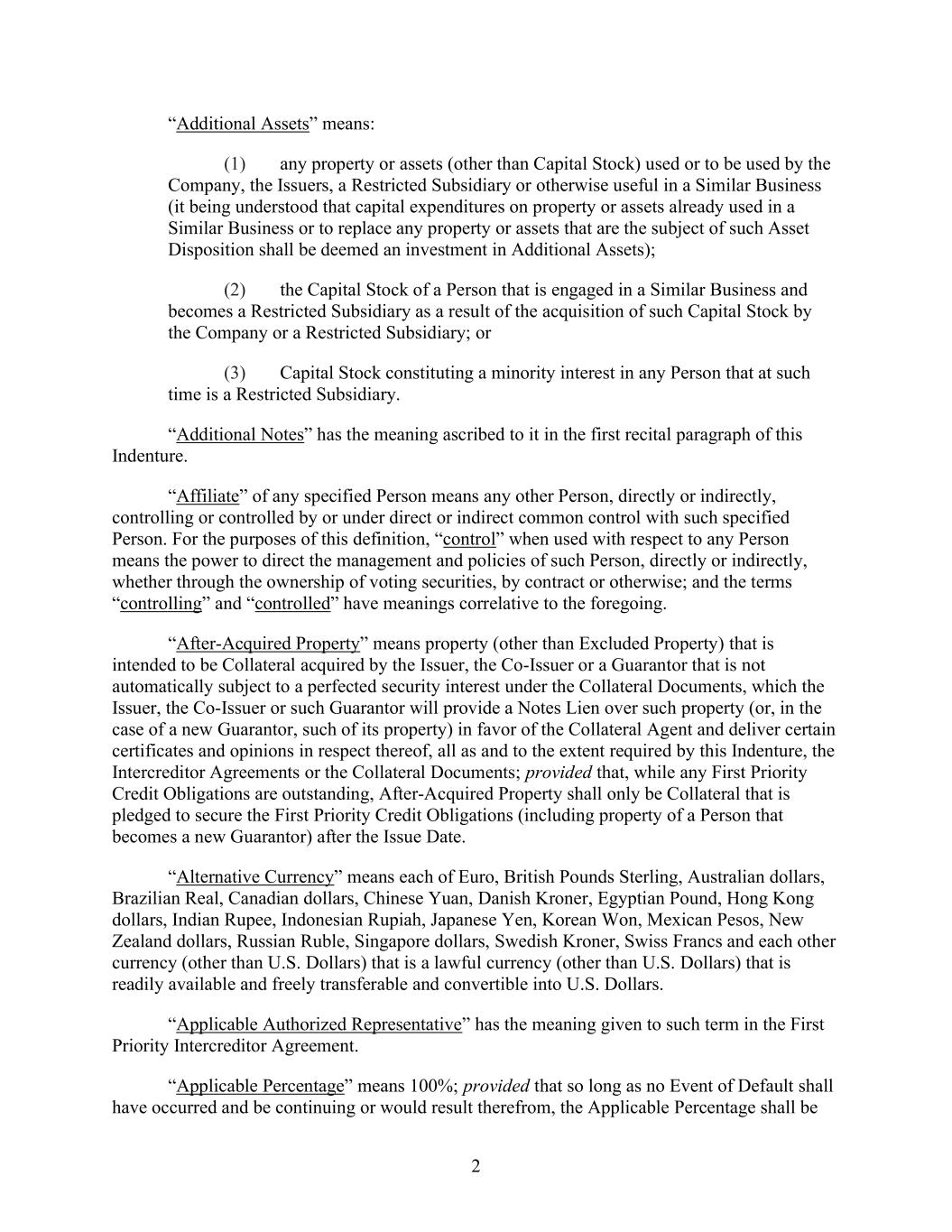
2 “Additional Assets” means: (1) any property or assets (other than Capital Stock) used or to be used by the Company, the Issuers, a Restricted Subsidiary or otherwise useful in a Similar Business (it being understood that capital expenditures on property or assets already used in a Similar Business or to replace any property or assets that are the subject of such Asset Disposition shall be deemed an investment in Additional Assets); (2) the Capital Stock of a Person that is engaged in a Similar Business and becomes a Restricted Subsidiary as a result of the acquisition of such Capital Stock by the Company or a Restricted Subsidiary; or (3) Capital Stock constituting a minority interest in any Person that at such time is a Restricted Subsidiary. “Additional Notes” has the meaning ascribed to it in the first recital paragraph of this Indenture. “Affiliate” of any specified Person means any other Person, directly or indirectly, controlling or controlled by or under direct or indirect common control with such specified Person. For the purposes of this definition, “control” when used with respect to any Person means the power to direct the management and policies of such Person, directly or indirectly, whether through the ownership of voting securities, by contract or otherwise; and the terms “controlling” and “controlled” have meanings correlative to the foregoing. “After-Acquired Property” means property (other than Excluded Property) that is intended to be Collateral acquired by the Issuer, the Co-Issuer or a Guarantor that is not automatically subject to a perfected security interest under the Collateral Documents, which the Issuer, the Co-Issuer or such Guarantor will provide a Notes Lien over such property (or, in the case of a new Guarantor, such of its property) in favor of the Collateral Agent and deliver certain certificates and opinions in respect thereof, all as and to the extent required by this Indenture, the Intercreditor Agreements or the Collateral Documents; provided that, while any First Priority Credit Obligations are outstanding, After-Acquired Property shall only be Collateral that is pledged to secure the First Priority Credit Obligations (including property of a Person that becomes a new Guarantor) after the Issue Date. “Alternative Currency” means each of Euro, British Pounds Sterling, Australian dollars, Brazilian Real, Canadian dollars, Chinese Yuan, Danish Kroner, Egyptian Pound, Hong Kong dollars, Indian Rupee, Indonesian Rupiah, Japanese Yen, Korean Won, Mexican Pesos, New Zealand dollars, Russian Xxxxx, Singapore dollars, Swedish Kroner, Swiss Francs and each other currency (other than U.S. Dollars) that is a lawful currency (other than U.S. Dollars) that is readily available and freely transferable and convertible into U.S. Dollars. “Applicable Authorized Representative” has the meaning given to such term in the First Priority Intercreditor Agreement. “Applicable Percentage” means 100%; provided that so long as no Event of Default shall have occurred and be continuing or would result therefrom, the Applicable Percentage shall be
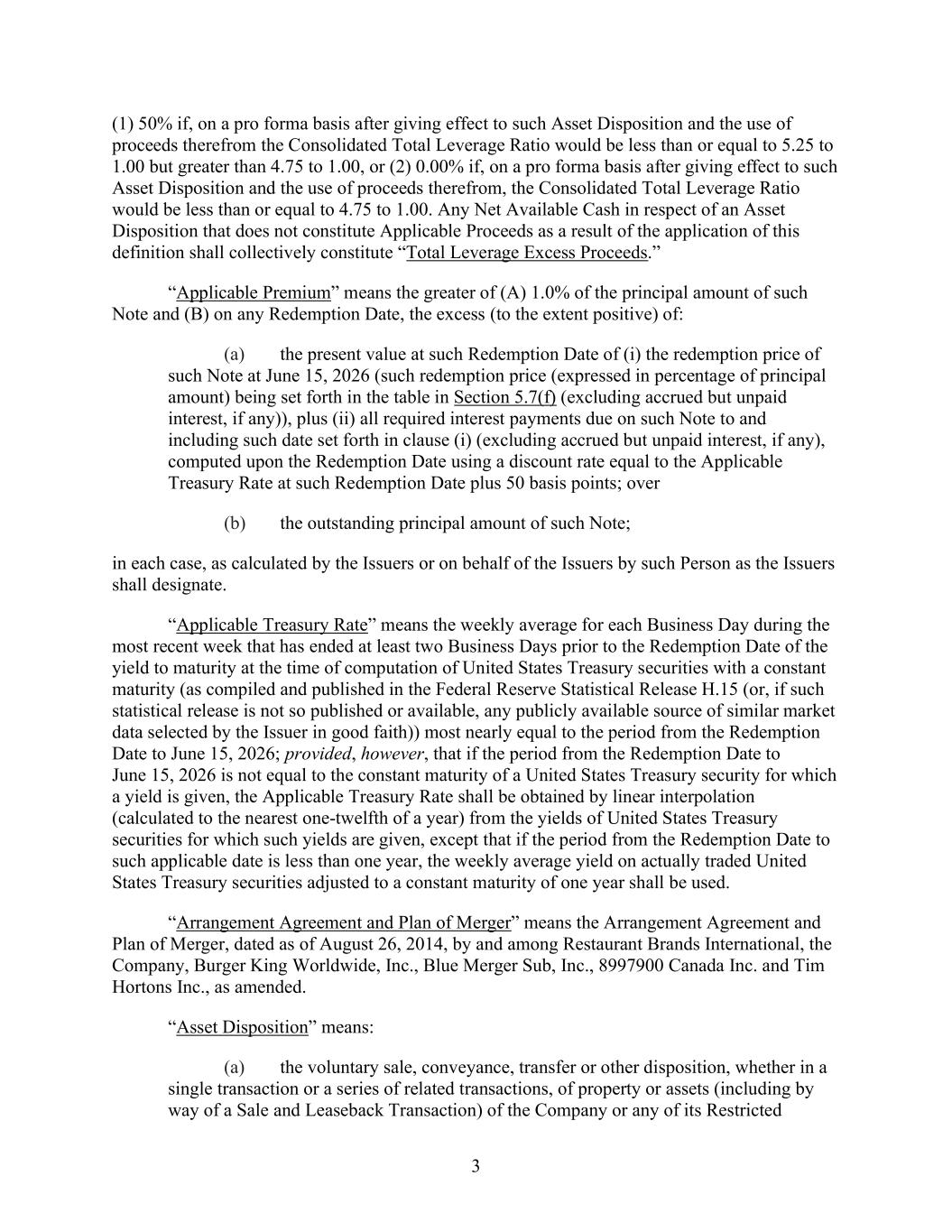
3 (1) 50% if, on a pro forma basis after giving effect to such Asset Disposition and the use of proceeds therefrom the Consolidated Total Leverage Ratio would be less than or equal to 5.25 to 1.00 but greater than 4.75 to 1.00, or (2) 0.00% if, on a pro forma basis after giving effect to such Asset Disposition and the use of proceeds therefrom, the Consolidated Total Leverage Ratio would be less than or equal to 4.75 to 1.00. Any Net Available Cash in respect of an Asset Disposition that does not constitute Applicable Proceeds as a result of the application of this definition shall collectively constitute “Total Leverage Excess Proceeds.” “Applicable Premium” means the greater of (A) 1.0% of the principal amount of such Note and (B) on any Redemption Date, the excess (to the extent positive) of: (a) the present value at such Redemption Date of (i) the redemption price of such Note at June 15, 2026 (such redemption price (expressed in percentage of principal amount) being set forth in the table in Section 5.7(f) (excluding accrued but unpaid interest, if any)), plus (ii) all required interest payments due on such Note to and including such date set forth in clause (i) (excluding accrued but unpaid interest, if any), computed upon the Redemption Date using a discount rate equal to the Applicable Treasury Rate at such Redemption Date plus 50 basis points; over (b) the outstanding principal amount of such Note; in each case, as calculated by the Issuers or on behalf of the Issuers by such Person as the Issuers shall designate. “Applicable Treasury Rate” means the weekly average for each Business Day during the most recent week that has ended at least two Business Days prior to the Redemption Date of the yield to maturity at the time of computation of United States Treasury securities with a constant maturity (as compiled and published in the Federal Reserve Statistical Release H.15 (or, if such statistical release is not so published or available, any publicly available source of similar market data selected by the Issuer in good faith)) most nearly equal to the period from the Redemption Date to June 15, 2026; provided, however, that if the period from the Redemption Date to June 15, 2026 is not equal to the constant maturity of a United States Treasury security for which a yield is given, the Applicable Treasury Rate shall be obtained by linear interpolation (calculated to the nearest one-twelfth of a year) from the yields of United States Treasury securities for which such yields are given, except that if the period from the Redemption Date to such applicable date is less than one year, the weekly average yield on actually traded United States Treasury securities adjusted to a constant maturity of one year shall be used. “Arrangement Agreement and Plan of Merger” means the Arrangement Agreement and Plan of Merger, dated as of August 26, 2014, by and among Restaurant Brands International, the Company, Burger King Worldwide, Inc., Blue Merger Sub, Inc., 8997900 Canada Inc. and Xxx Xxxxxxx Inc., as amended. “Asset Disposition” means: (a) the voluntary sale, conveyance, transfer or other disposition, whether in a single transaction or a series of related transactions, of property or assets (including by way of a Sale and Leaseback Transaction) of the Company or any of its Restricted
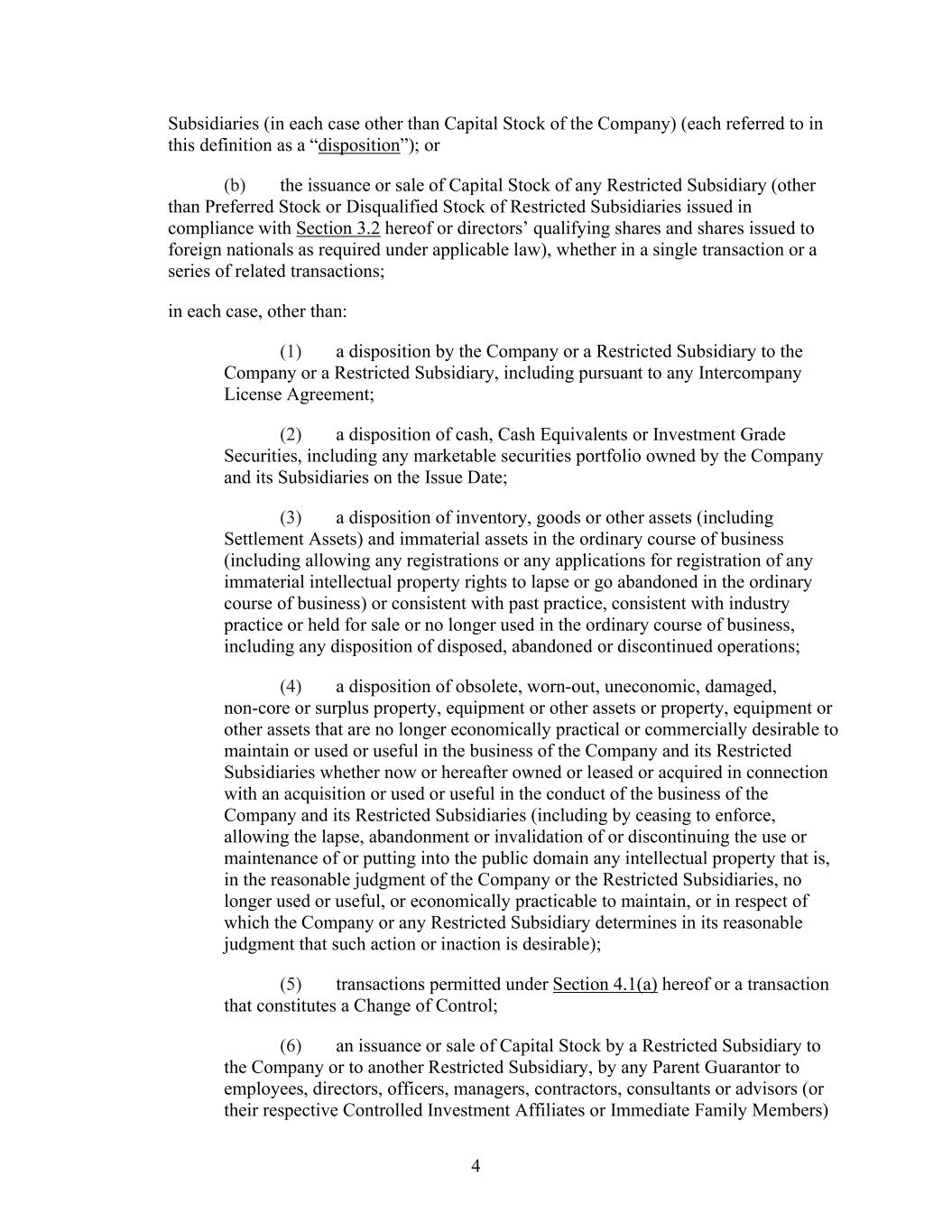
4 Subsidiaries (in each case other than Capital Stock of the Company) (each referred to in this definition as a “disposition”); or (b) the issuance or sale of Capital Stock of any Restricted Subsidiary (other than Preferred Stock or Disqualified Stock of Restricted Subsidiaries issued in compliance with Section 3.2 hereof or directors’ qualifying shares and shares issued to foreign nationals as required under applicable law), whether in a single transaction or a series of related transactions; in each case, other than: (1) a disposition by the Company or a Restricted Subsidiary to the Company or a Restricted Subsidiary, including pursuant to any Intercompany License Agreement; (2) a disposition of cash, Cash Equivalents or Investment Grade Securities, including any marketable securities portfolio owned by the Company and its Subsidiaries on the Issue Date; (3) a disposition of inventory, goods or other assets (including Settlement Assets) and immaterial assets in the ordinary course of business (including allowing any registrations or any applications for registration of any immaterial intellectual property rights to lapse or go abandoned in the ordinary course of business) or consistent with past practice, consistent with industry practice or held for sale or no longer used in the ordinary course of business, including any disposition of disposed, abandoned or discontinued operations; (4) a disposition of obsolete, worn-out, uneconomic, damaged, non-core or surplus property, equipment or other assets or property, equipment or other assets that are no longer economically practical or commercially desirable to maintain or used or useful in the business of the Company and its Restricted Subsidiaries whether now or hereafter owned or leased or acquired in connection with an acquisition or used or useful in the conduct of the business of the Company and its Restricted Subsidiaries (including by ceasing to enforce, allowing the lapse, abandonment or invalidation of or discontinuing the use or maintenance of or putting into the public domain any intellectual property that is, in the reasonable judgment of the Company or the Restricted Subsidiaries, no longer used or useful, or economically practicable to maintain, or in respect of which the Company or any Restricted Subsidiary determines in its reasonable judgment that such action or inaction is desirable); (5) transactions permitted under Section 4.1(a) hereof or a transaction that constitutes a Change of Control; (6) an issuance or sale of Capital Stock by a Restricted Subsidiary to the Company or to another Restricted Subsidiary, by any Parent Guarantor to employees, directors, officers, managers, contractors, consultants or advisors (or their respective Controlled Investment Affiliates or Immediate Family Members)
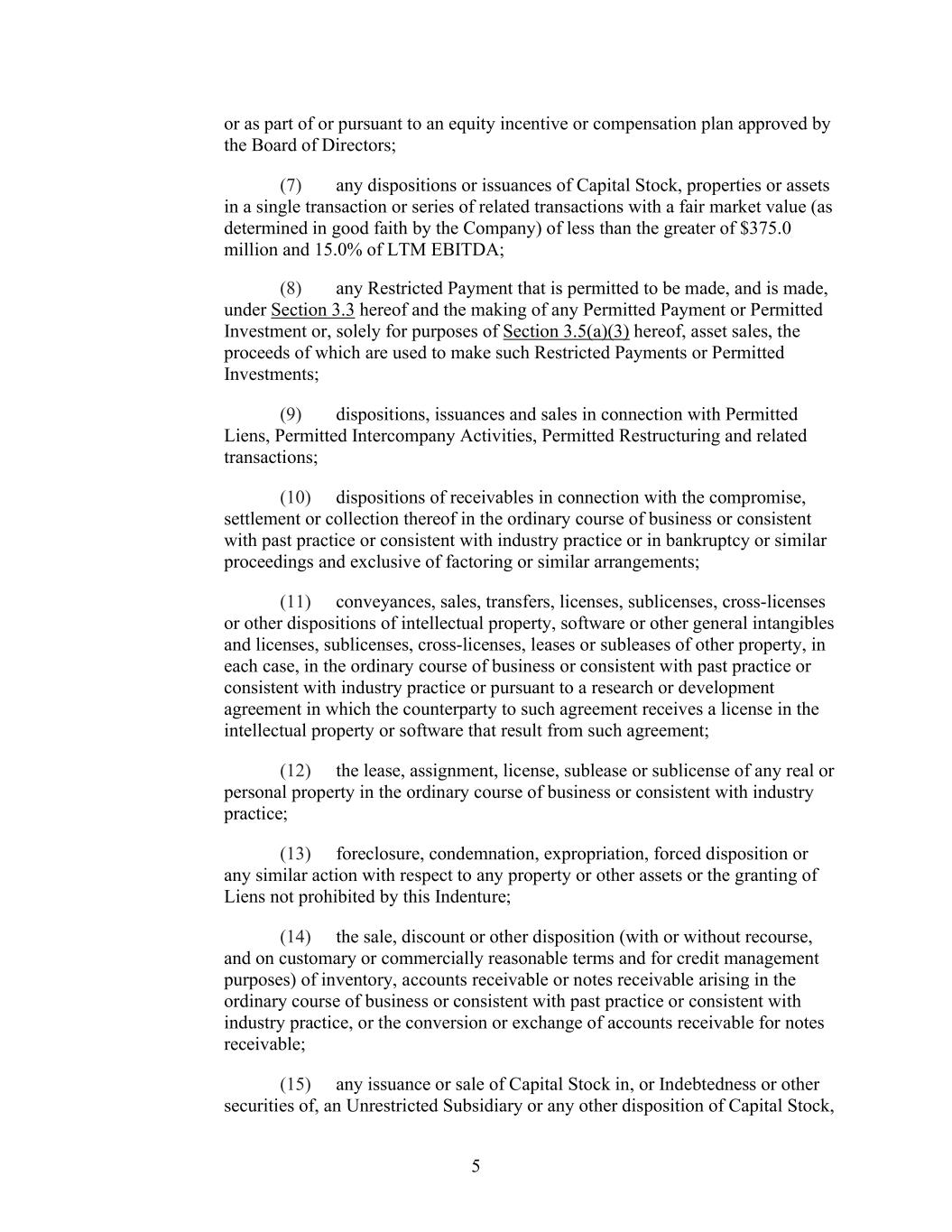
5 or as part of or pursuant to an equity incentive or compensation plan approved by the Board of Directors; (7) any dispositions or issuances of Capital Stock, properties or assets in a single transaction or series of related transactions with a fair market value (as determined in good faith by the Company) of less than the greater of $375.0 million and 15.0% of LTM EBITDA; (8) any Restricted Payment that is permitted to be made, and is made, under Section 3.3 hereof and the making of any Permitted Payment or Permitted Investment or, solely for purposes of Section 3.5(a)(3) hereof, asset sales, the proceeds of which are used to make such Restricted Payments or Permitted Investments; (9) dispositions, issuances and sales in connection with Permitted Liens, Permitted Intercompany Activities, Permitted Restructuring and related transactions; (10) dispositions of receivables in connection with the compromise, settlement or collection thereof in the ordinary course of business or consistent with past practice or consistent with industry practice or in bankruptcy or similar proceedings and exclusive of factoring or similar arrangements; (11) conveyances, sales, transfers, licenses, sublicenses, cross-licenses or other dispositions of intellectual property, software or other general intangibles and licenses, sublicenses, cross-licenses, leases or subleases of other property, in each case, in the ordinary course of business or consistent with past practice or consistent with industry practice or pursuant to a research or development agreement in which the counterparty to such agreement receives a license in the intellectual property or software that result from such agreement; (12) the lease, assignment, license, sublease or sublicense of any real or personal property in the ordinary course of business or consistent with industry practice; (13) foreclosure, condemnation, expropriation, forced disposition or any similar action with respect to any property or other assets or the granting of Liens not prohibited by this Indenture; (14) the sale, discount or other disposition (with or without recourse, and on customary or commercially reasonable terms and for credit management purposes) of inventory, accounts receivable or notes receivable arising in the ordinary course of business or consistent with past practice or consistent with industry practice, or the conversion or exchange of accounts receivable for notes receivable; (15) any issuance or sale of Capital Stock in, or Indebtedness or other securities of, an Unrestricted Subsidiary or any other disposition of Capital Stock,
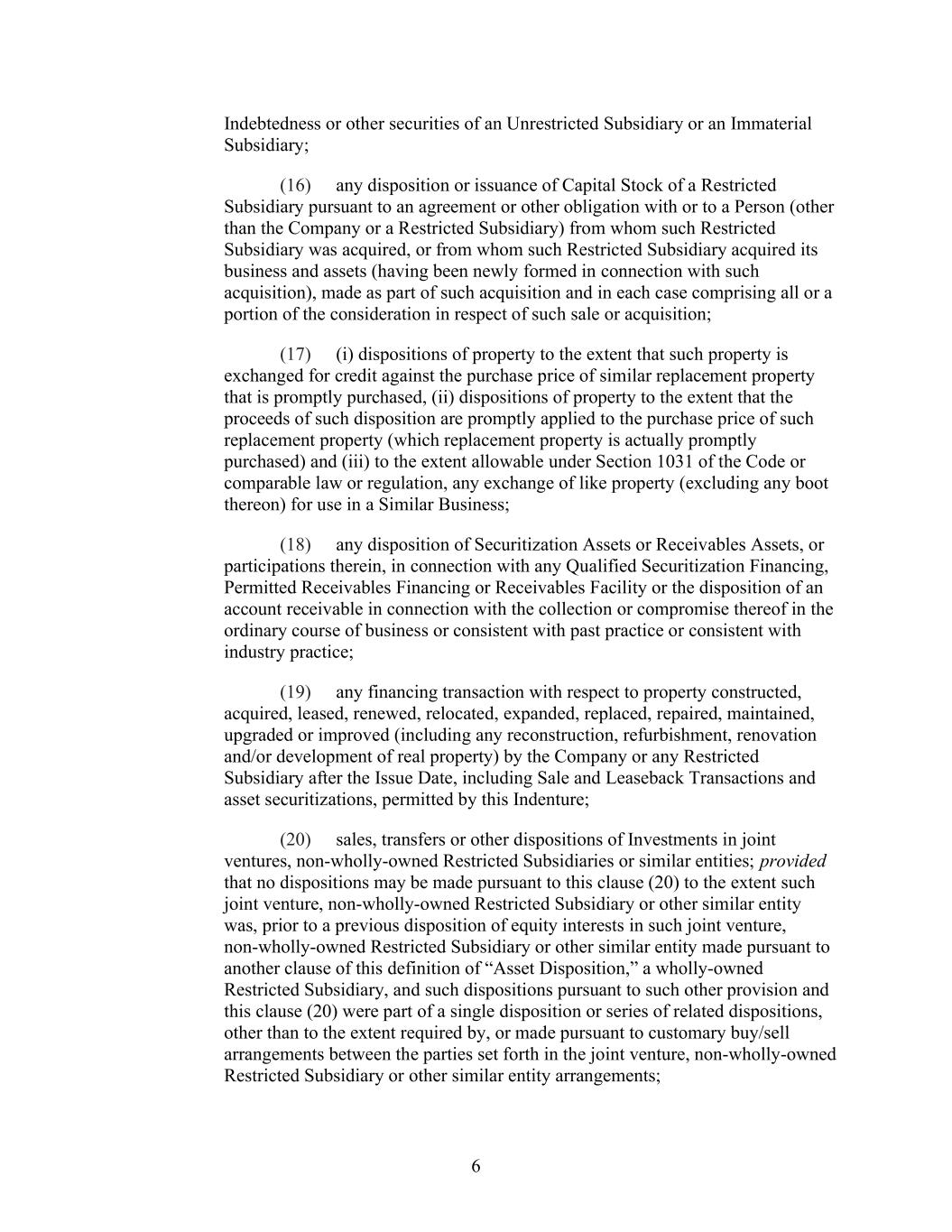
6 Indebtedness or other securities of an Unrestricted Subsidiary or an Immaterial Subsidiary; (16) any disposition or issuance of Capital Stock of a Restricted Subsidiary pursuant to an agreement or other obligation with or to a Person (other than the Company or a Restricted Subsidiary) from whom such Restricted Subsidiary was acquired, or from whom such Restricted Subsidiary acquired its business and assets (having been newly formed in connection with such acquisition), made as part of such acquisition and in each case comprising all or a portion of the consideration in respect of such sale or acquisition; (17) (i) dispositions of property to the extent that such property is exchanged for credit against the purchase price of similar replacement property that is promptly purchased, (ii) dispositions of property to the extent that the proceeds of such disposition are promptly applied to the purchase price of such replacement property (which replacement property is actually promptly purchased) and (iii) to the extent allowable under Section 1031 of the Code or comparable law or regulation, any exchange of like property (excluding any boot thereon) for use in a Similar Business; (18) any disposition of Securitization Assets or Receivables Assets, or participations therein, in connection with any Qualified Securitization Financing, Permitted Receivables Financing or Receivables Facility or the disposition of an account receivable in connection with the collection or compromise thereof in the ordinary course of business or consistent with past practice or consistent with industry practice; (19) any financing transaction with respect to property constructed, acquired, leased, renewed, relocated, expanded, replaced, repaired, maintained, upgraded or improved (including any reconstruction, refurbishment, renovation and/or development of real property) by the Company or any Restricted Subsidiary after the Issue Date, including Sale and Leaseback Transactions and asset securitizations, permitted by this Indenture; (20) sales, transfers or other dispositions of Investments in joint ventures, non-wholly-owned Restricted Subsidiaries or similar entities; provided that no dispositions may be made pursuant to this clause (20) to the extent such joint venture, non-wholly-owned Restricted Subsidiary or other similar entity was, prior to a previous disposition of equity interests in such joint venture, non-wholly-owned Restricted Subsidiary or other similar entity made pursuant to another clause of this definition of “Asset Disposition,” a wholly-owned Restricted Subsidiary, and such dispositions pursuant to such other provision and this clause (20) were part of a single disposition or series of related dispositions, other than to the extent required by, or made pursuant to customary buy/sell arrangements between the parties set forth in the joint venture, non-wholly-owned Restricted Subsidiary or other similar entity arrangements;
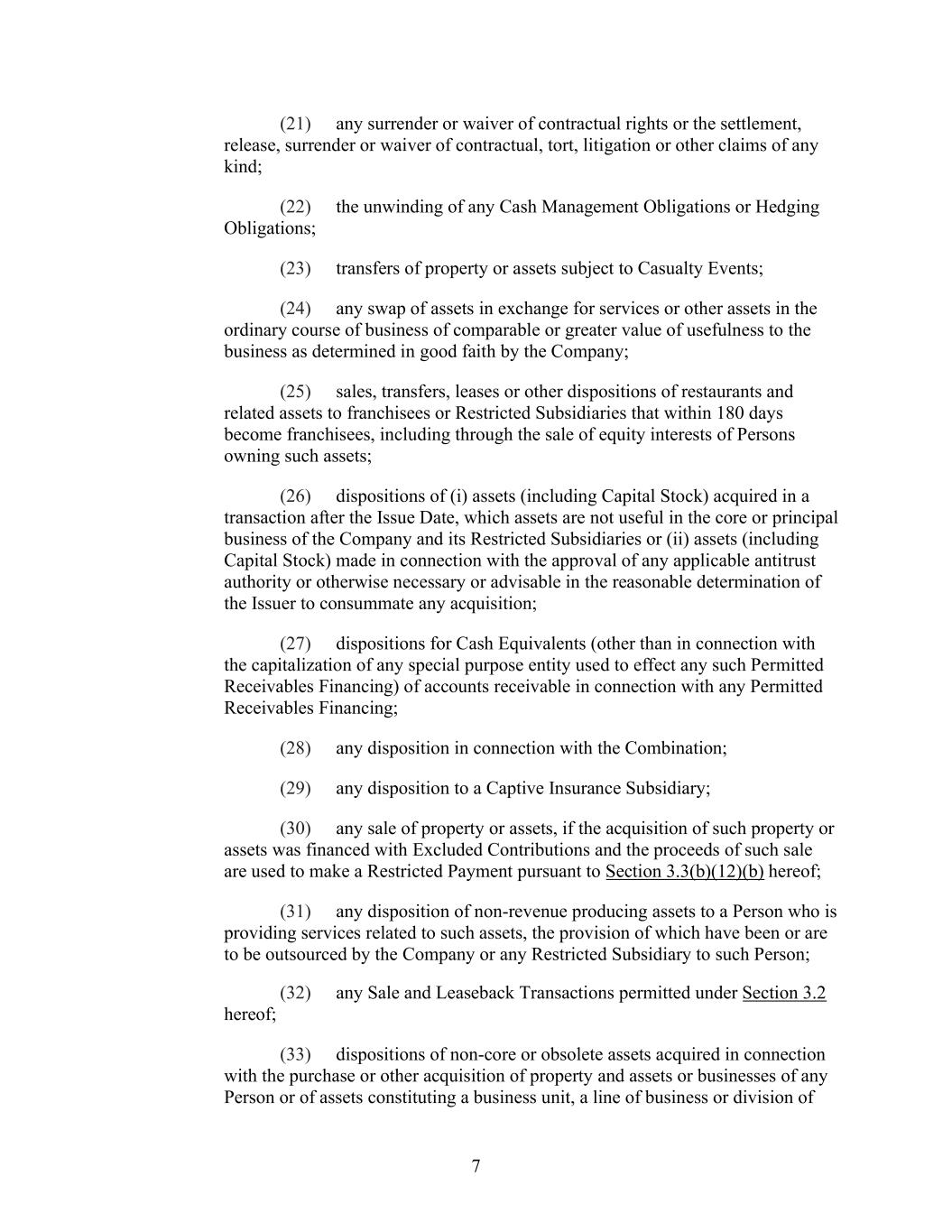
7 (21) any surrender or waiver of contractual rights or the settlement, release, surrender or waiver of contractual, tort, litigation or other claims of any kind; (22) the unwinding of any Cash Management Obligations or Hedging Obligations; (23) transfers of property or assets subject to Casualty Events; (24) any swap of assets in exchange for services or other assets in the ordinary course of business of comparable or greater value of usefulness to the business as determined in good faith by the Company; (25) sales, transfers, leases or other dispositions of restaurants and related assets to franchisees or Restricted Subsidiaries that within 180 days become franchisees, including through the sale of equity interests of Persons owning such assets; (26) dispositions of (i) assets (including Capital Stock) acquired in a transaction after the Issue Date, which assets are not useful in the core or principal business of the Company and its Restricted Subsidiaries or (ii) assets (including Capital Stock) made in connection with the approval of any applicable antitrust authority or otherwise necessary or advisable in the reasonable determination of the Issuer to consummate any acquisition; (27) dispositions for Cash Equivalents (other than in connection with the capitalization of any special purpose entity used to effect any such Permitted Receivables Financing) of accounts receivable in connection with any Permitted Receivables Financing; (28) any disposition in connection with the Combination; (29) any disposition to a Captive Insurance Subsidiary; (30) any sale of property or assets, if the acquisition of such property or assets was financed with Excluded Contributions and the proceeds of such sale are used to make a Restricted Payment pursuant to Section 3.3(b)(12)(b) hereof; (31) any disposition of non-revenue producing assets to a Person who is providing services related to such assets, the provision of which have been or are to be outsourced by the Company or any Restricted Subsidiary to such Person; (32) any Sale and Leaseback Transactions permitted under Section 3.2 hereof; (33) dispositions of non-core or obsolete assets acquired in connection with the purchase or other acquisition of property and assets or businesses of any Person or of assets constituting a business unit, a line of business or division of
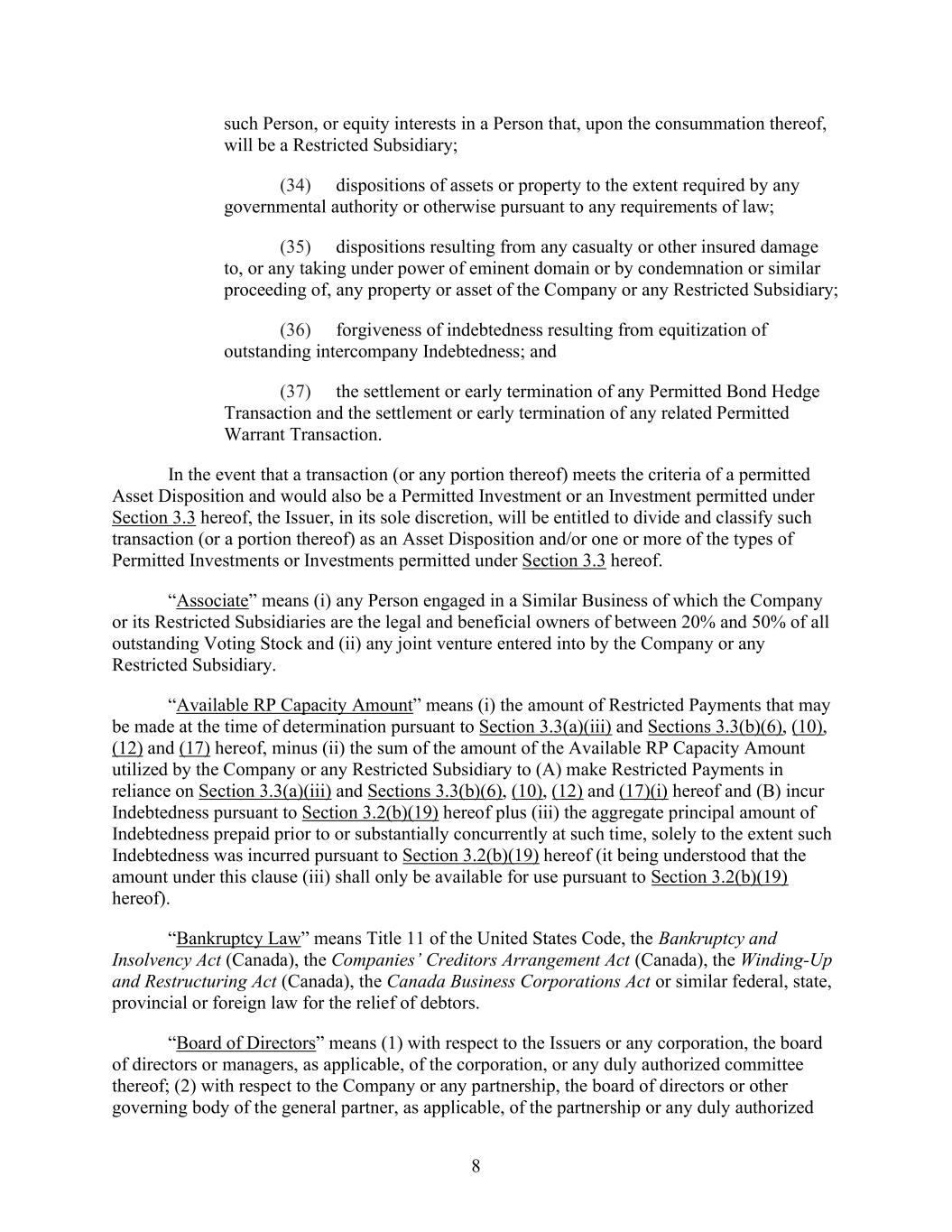
8 such Person, or equity interests in a Person that, upon the consummation thereof, will be a Restricted Subsidiary; (34) dispositions of assets or property to the extent required by any governmental authority or otherwise pursuant to any requirements of law; (35) dispositions resulting from any casualty or other insured damage to, or any taking under power of eminent domain or by condemnation or similar proceeding of, any property or asset of the Company or any Restricted Subsidiary; (36) forgiveness of indebtedness resulting from equitization of outstanding intercompany Indebtedness; and (37) the settlement or early termination of any Permitted Bond Hedge Transaction and the settlement or early termination of any related Permitted Warrant Transaction. In the event that a transaction (or any portion thereof) meets the criteria of a permitted Asset Disposition and would also be a Permitted Investment or an Investment permitted under Section 3.3 hereof, the Issuer, in its sole discretion, will be entitled to divide and classify such transaction (or a portion thereof) as an Asset Disposition and/or one or more of the types of Permitted Investments or Investments permitted under Section 3.3 hereof. “Associate” means (i) any Person engaged in a Similar Business of which the Company or its Restricted Subsidiaries are the legal and beneficial owners of between 20% and 50% of all outstanding Voting Stock and (ii) any joint venture entered into by the Company or any Restricted Subsidiary. “Available RP Capacity Amount” means (i) the amount of Restricted Payments that may be made at the time of determination pursuant to Section 3.3(a)(iii) and Sections 3.3(b)(6), (10), (12) and (17) hereof, minus (ii) the sum of the amount of the Available RP Capacity Amount utilized by the Company or any Restricted Subsidiary to (A) make Restricted Payments in reliance on Section 3.3(a)(iii) and Sections 3.3(b)(6), (10), (12) and (17)(i) hereof and (B) incur Indebtedness pursuant to Section 3.2(b)(19) hereof plus (iii) the aggregate principal amount of Indebtedness prepaid prior to or substantially concurrently at such time, solely to the extent such Indebtedness was incurred pursuant to Section 3.2(b)(19) hereof (it being understood that the amount under this clause (iii) shall only be available for use pursuant to Section 3.2(b)(19) hereof). “Bankruptcy Law” means Title 11 of the United States Code, the Bankruptcy and Insolvency Act (Canada), the Companies’ Creditors Arrangement Act (Canada), the Winding-Up and Restructuring Act (Canada), the Canada Business Corporations Act or similar federal, state, provincial or foreign law for the relief of debtors. “Board of Directors” means (1) with respect to the Issuers or any corporation, the board of directors or managers, as applicable, of the corporation, or any duly authorized committee thereof; (2) with respect to the Company or any partnership, the board of directors or other governing body of the general partner, as applicable, of the partnership or any duly authorized
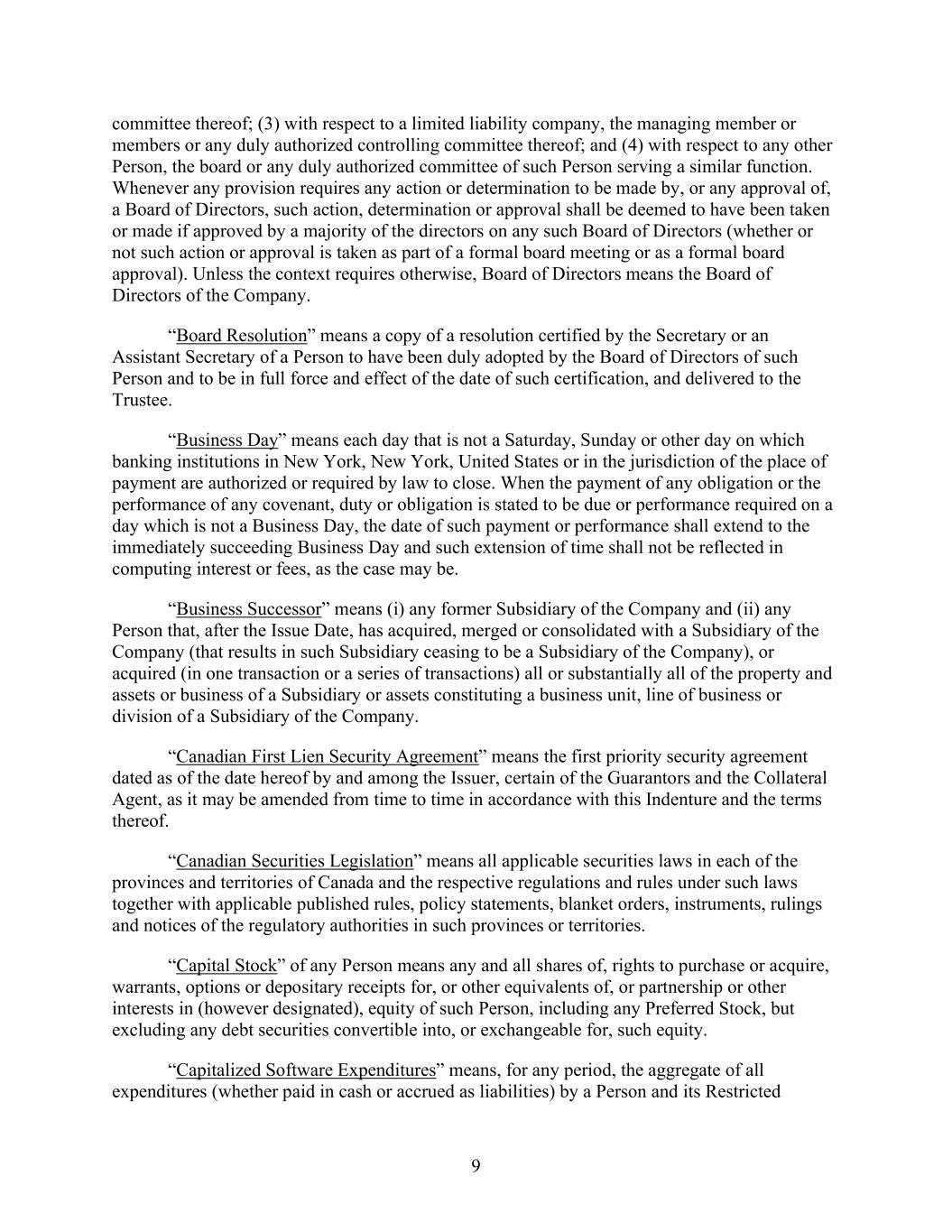
9 committee thereof; (3) with respect to a limited liability company, the managing member or members or any duly authorized controlling committee thereof; and (4) with respect to any other Person, the board or any duly authorized committee of such Person serving a similar function. Whenever any provision requires any action or determination to be made by, or any approval of, a Board of Directors, such action, determination or approval shall be deemed to have been taken or made if approved by a majority of the directors on any such Board of Directors (whether or not such action or approval is taken as part of a formal board meeting or as a formal board approval). Unless the context requires otherwise, Board of Directors means the Board of Directors of the Company. “Board Resolution” means a copy of a resolution certified by the Secretary or an Assistant Secretary of a Person to have been duly adopted by the Board of Directors of such Person and to be in full force and effect of the date of such certification, and delivered to the Trustee. “Business Day” means each day that is not a Saturday, Sunday or other day on which banking institutions in New York, New York, United States or in the jurisdiction of the place of payment are authorized or required by law to close. When the payment of any obligation or the performance of any covenant, duty or obligation is stated to be due or performance required on a day which is not a Business Day, the date of such payment or performance shall extend to the immediately succeeding Business Day and such extension of time shall not be reflected in computing interest or fees, as the case may be. “Business Successor” means (i) any former Subsidiary of the Company and (ii) any Person that, after the Issue Date, has acquired, merged or consolidated with a Subsidiary of the Company (that results in such Subsidiary ceasing to be a Subsidiary of the Company), or acquired (in one transaction or a series of transactions) all or substantially all of the property and assets or business of a Subsidiary or assets constituting a business unit, line of business or division of a Subsidiary of the Company. “Canadian First Lien Security Agreement” means the first priority security agreement dated as of the date hereof by and among the Issuer, certain of the Guarantors and the Collateral Agent, as it may be amended from time to time in accordance with this Indenture and the terms thereof. “Canadian Securities Legislation” means all applicable securities laws in each of the provinces and territories of Canada and the respective regulations and rules under such laws together with applicable published rules, policy statements, blanket orders, instruments, rulings and notices of the regulatory authorities in such provinces or territories. “Capital Stock” of any Person means any and all shares of, rights to purchase or acquire, warrants, options or depositary receipts for, or other equivalents of, or partnership or other interests in (however designated), equity of such Person, including any Preferred Stock, but excluding any debt securities convertible into, or exchangeable for, such equity. “Capitalized Software Expenditures” means, for any period, the aggregate of all expenditures (whether paid in cash or accrued as liabilities) by a Person and its Restricted
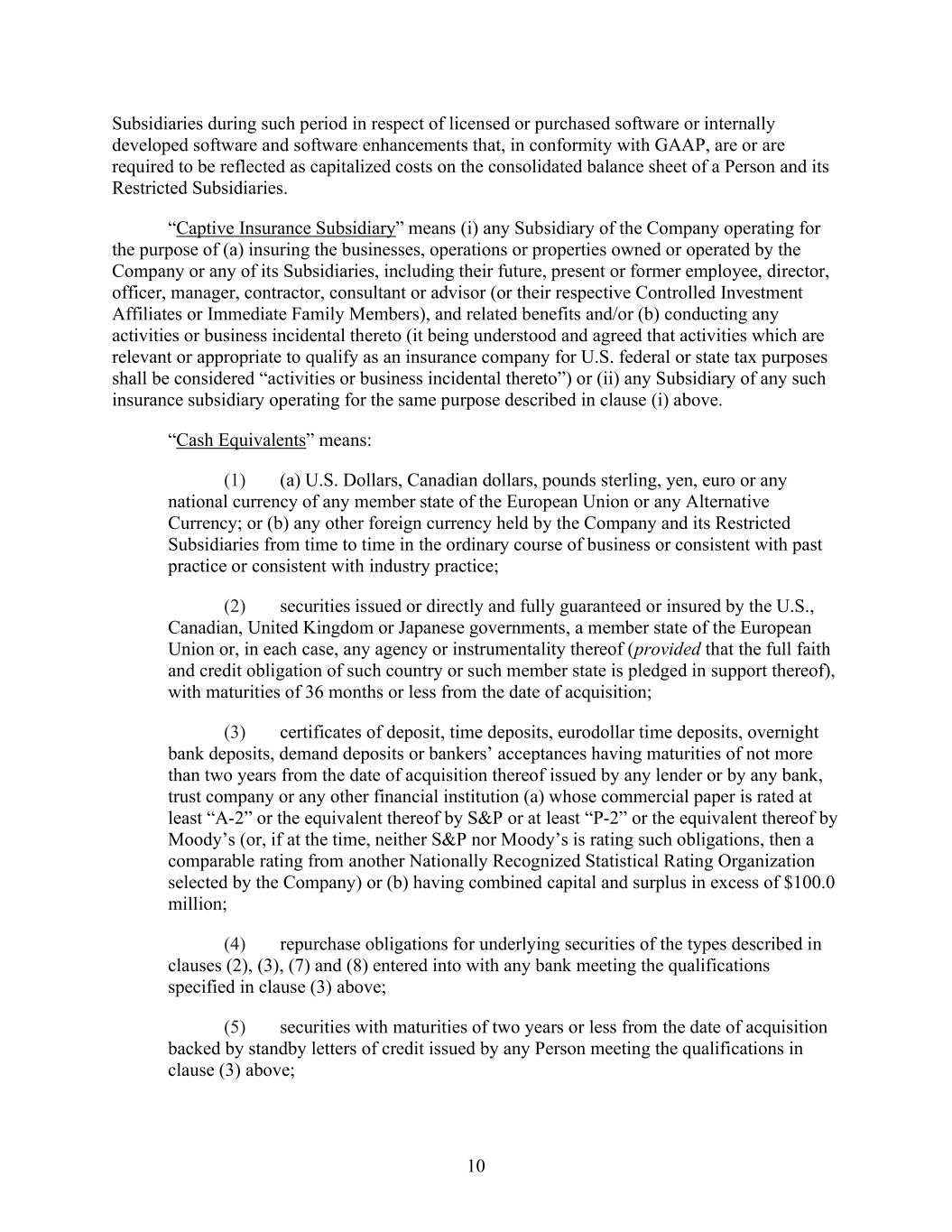
10 Subsidiaries during such period in respect of licensed or purchased software or internally developed software and software enhancements that, in conformity with GAAP, are or are required to be reflected as capitalized costs on the consolidated balance sheet of a Person and its Restricted Subsidiaries. “Captive Insurance Subsidiary” means (i) any Subsidiary of the Company operating for the purpose of (a) insuring the businesses, operations or properties owned or operated by the Company or any of its Subsidiaries, including their future, present or former employee, director, officer, manager, contractor, consultant or advisor (or their respective Controlled Investment Affiliates or Immediate Family Members), and related benefits and/or (b) conducting any activities or business incidental thereto (it being understood and agreed that activities which are relevant or appropriate to qualify as an insurance company for U.S. federal or state tax purposes shall be considered “activities or business incidental thereto”) or (ii) any Subsidiary of any such insurance subsidiary operating for the same purpose described in clause (i) above. “Cash Equivalents” means: (1) (a) U.S. Dollars, Canadian dollars, pounds sterling, yen, euro or any national currency of any member state of the European Union or any Alternative Currency; or (b) any other foreign currency held by the Company and its Restricted Subsidiaries from time to time in the ordinary course of business or consistent with past practice or consistent with industry practice; (2) securities issued or directly and fully guaranteed or insured by the U.S., Canadian, United Kingdom or Japanese governments, a member state of the European Union or, in each case, any agency or instrumentality thereof (provided that the full faith and credit obligation of such country or such member state is pledged in support thereof), with maturities of 36 months or less from the date of acquisition; (3) certificates of deposit, time deposits, eurodollar time deposits, overnight bank deposits, demand deposits or bankers’ acceptances having maturities of not more than two years from the date of acquisition thereof issued by any lender or by any bank, trust company or any other financial institution (a) whose commercial paper is rated at least “A-2” or the equivalent thereof by S&P or at least “P-2” or the equivalent thereof by Xxxxx’x (or, if at the time, neither S&P nor Xxxxx’x is rating such obligations, then a comparable rating from another Nationally Recognized Statistical Rating Organization selected by the Company) or (b) having combined capital and surplus in excess of $100.0 million; (4) repurchase obligations for underlying securities of the types described in clauses (2), (3), (7) and (8) entered into with any bank meeting the qualifications specified in clause (3) above; (5) securities with maturities of two years or less from the date of acquisition backed by standby letters of credit issued by any Person meeting the qualifications in clause (3) above;
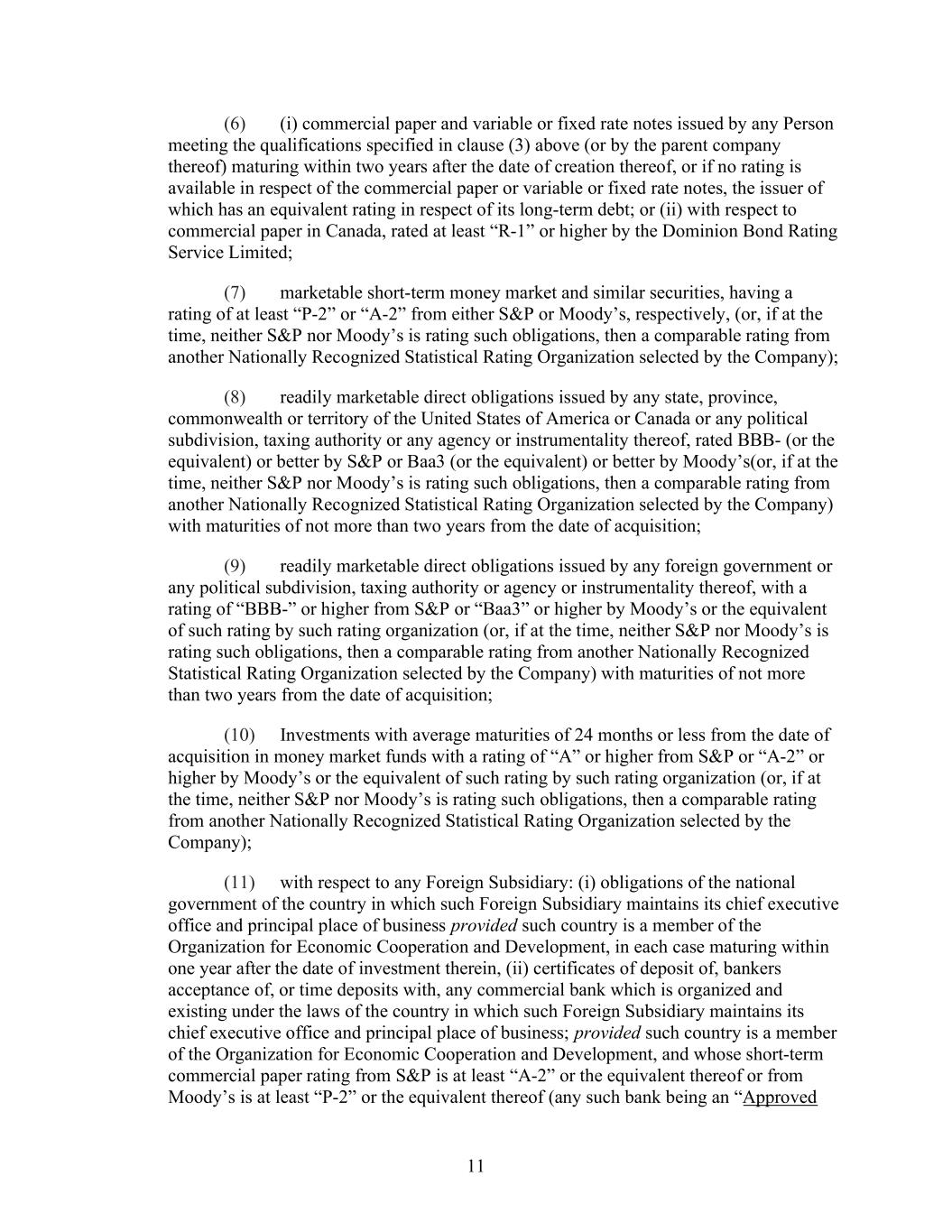
11 (6) (i) commercial paper and variable or fixed rate notes issued by any Person meeting the qualifications specified in clause (3) above (or by the parent company thereof) maturing within two years after the date of creation thereof, or if no rating is available in respect of the commercial paper or variable or fixed rate notes, the issuer of which has an equivalent rating in respect of its long-term debt; or (ii) with respect to commercial paper in Canada, rated at least “R-1” or higher by the Dominion Bond Rating Service Limited; (7) marketable short-term money market and similar securities, having a rating of at least “P-2” or “A-2” from either S&P or Xxxxx’x, respectively, (or, if at the time, neither S&P nor Xxxxx’x is rating such obligations, then a comparable rating from another Nationally Recognized Statistical Rating Organization selected by the Company); (8) readily marketable direct obligations issued by any state, province, commonwealth or territory of the United States of America or Canada or any political subdivision, taxing authority or any agency or instrumentality thereof, rated BBB- (or the equivalent) or better by S&P or Baa3 (or the equivalent) or better by Xxxxx’x(or, if at the time, neither S&P nor Xxxxx’x is rating such obligations, then a comparable rating from another Nationally Recognized Statistical Rating Organization selected by the Company) with maturities of not more than two years from the date of acquisition; (9) readily marketable direct obligations issued by any foreign government or any political subdivision, taxing authority or agency or instrumentality thereof, with a rating of “BBB-” or higher from S&P or “Baa3” or higher by Xxxxx’x or the equivalent of such rating by such rating organization (or, if at the time, neither S&P nor Xxxxx’x is rating such obligations, then a comparable rating from another Nationally Recognized Statistical Rating Organization selected by the Company) with maturities of not more than two years from the date of acquisition; (10) Investments with average maturities of 24 months or less from the date of acquisition in money market funds with a rating of “A” or higher from S&P or “A-2” or higher by Xxxxx’x or the equivalent of such rating by such rating organization (or, if at the time, neither S&P nor Xxxxx’x is rating such obligations, then a comparable rating from another Nationally Recognized Statistical Rating Organization selected by the Company); (11) with respect to any Foreign Subsidiary: (i) obligations of the national government of the country in which such Foreign Subsidiary maintains its chief executive office and principal place of business provided such country is a member of the Organization for Economic Cooperation and Development, in each case maturing within one year after the date of investment therein, (ii) certificates of deposit of, bankers acceptance of, or time deposits with, any commercial bank which is organized and existing under the laws of the country in which such Foreign Subsidiary maintains its chief executive office and principal place of business; provided such country is a member of the Organization for Economic Cooperation and Development, and whose short-term commercial paper rating from S&P is at least “A-2” or the equivalent thereof or from Xxxxx’x is at least “P-2” or the equivalent thereof (any such bank being an “Approved
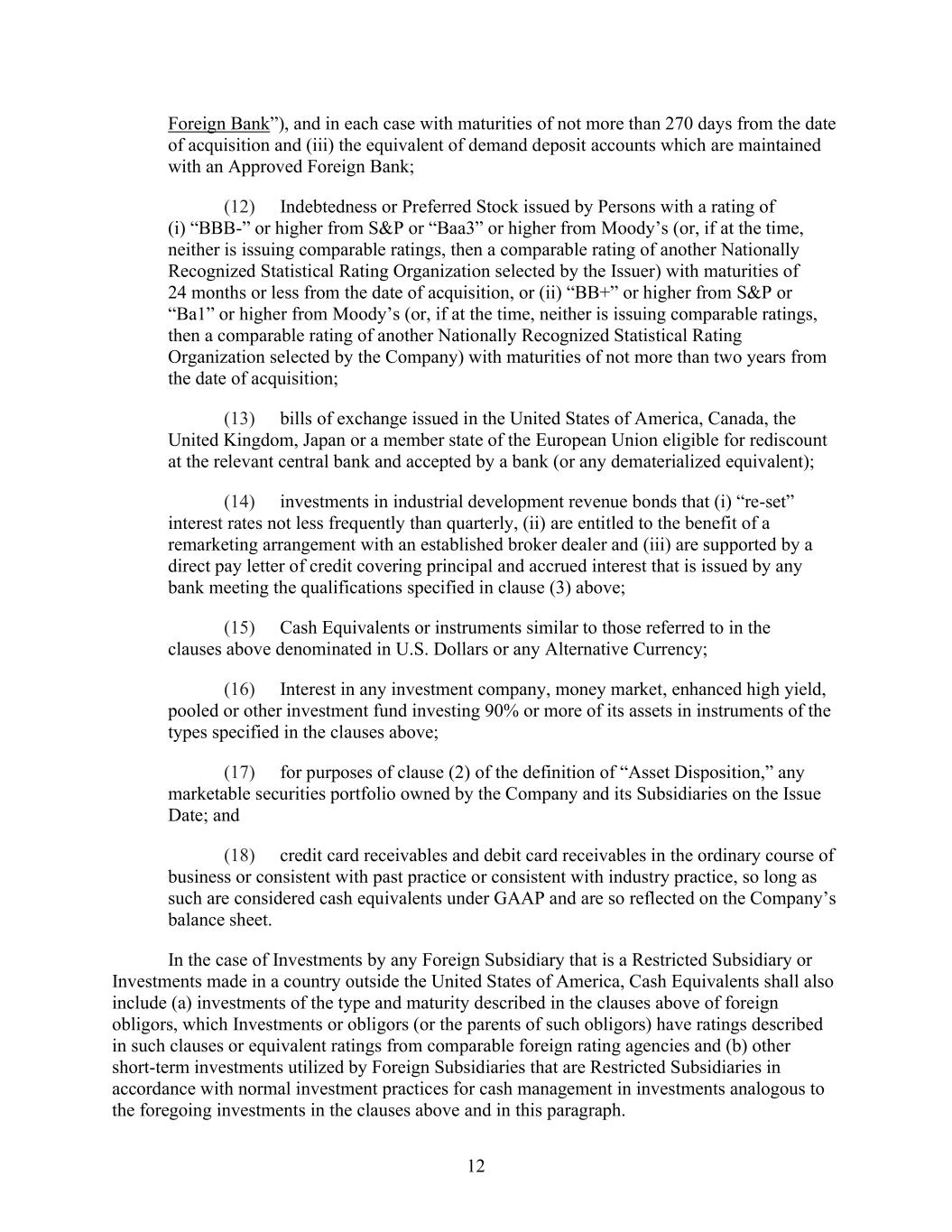
12 Foreign Bank”), and in each case with maturities of not more than 270 days from the date of acquisition and (iii) the equivalent of demand deposit accounts which are maintained with an Approved Foreign Bank; (12) Indebtedness or Preferred Stock issued by Persons with a rating of (i) “BBB-” or higher from S&P or “Baa3” or higher from Xxxxx’x (or, if at the time, neither is issuing comparable ratings, then a comparable rating of another Nationally Recognized Statistical Rating Organization selected by the Issuer) with maturities of 24 months or less from the date of acquisition, or (ii) “BB+” or higher from S&P or “Ba1” or higher from Xxxxx’x (or, if at the time, neither is issuing comparable ratings, then a comparable rating of another Nationally Recognized Statistical Rating Organization selected by the Company) with maturities of not more than two years from the date of acquisition; (13) bills of exchange issued in the United States of America, Canada, the United Kingdom, Japan or a member state of the European Union eligible for rediscount at the relevant central bank and accepted by a bank (or any dematerialized equivalent); (14) investments in industrial development revenue bonds that (i) “re-set” interest rates not less frequently than quarterly, (ii) are entitled to the benefit of a remarketing arrangement with an established broker dealer and (iii) are supported by a direct pay letter of credit covering principal and accrued interest that is issued by any bank meeting the qualifications specified in clause (3) above; (15) Cash Equivalents or instruments similar to those referred to in the clauses above denominated in U.S. Dollars or any Alternative Currency; (16) Interest in any investment company, money market, enhanced high yield, pooled or other investment fund investing 90% or more of its assets in instruments of the types specified in the clauses above; (17) for purposes of clause (2) of the definition of “Asset Disposition,” any marketable securities portfolio owned by the Company and its Subsidiaries on the Issue Date; and (18) credit card receivables and debit card receivables in the ordinary course of business or consistent with past practice or consistent with industry practice, so long as such are considered cash equivalents under GAAP and are so reflected on the Company’s balance sheet. In the case of Investments by any Foreign Subsidiary that is a Restricted Subsidiary or Investments made in a country outside the United States of America, Cash Equivalents shall also include (a) investments of the type and maturity described in the clauses above of foreign obligors, which Investments or obligors (or the parents of such obligors) have ratings described in such clauses or equivalent ratings from comparable foreign rating agencies and (b) other short-term investments utilized by Foreign Subsidiaries that are Restricted Subsidiaries in accordance with normal investment practices for cash management in investments analogous to the foregoing investments in the clauses above and in this paragraph.
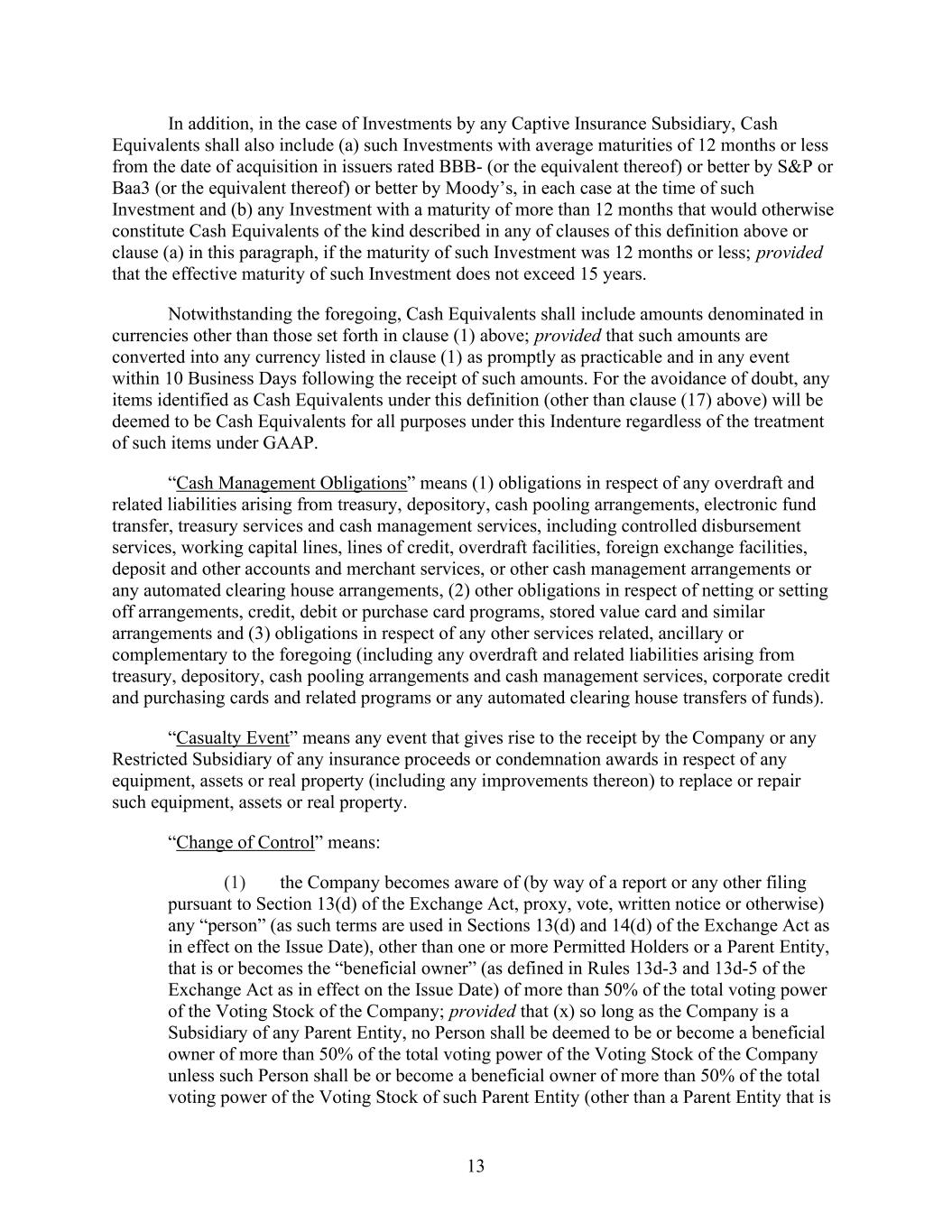
13 In addition, in the case of Investments by any Captive Insurance Subsidiary, Cash Equivalents shall also include (a) such Investments with average maturities of 12 months or less from the date of acquisition in issuers rated BBB- (or the equivalent thereof) or better by S&P or Baa3 (or the equivalent thereof) or better by Xxxxx’x, in each case at the time of such Investment and (b) any Investment with a maturity of more than 12 months that would otherwise constitute Cash Equivalents of the kind described in any of clauses of this definition above or clause (a) in this paragraph, if the maturity of such Investment was 12 months or less; provided that the effective maturity of such Investment does not exceed 15 years. Notwithstanding the foregoing, Cash Equivalents shall include amounts denominated in currencies other than those set forth in clause (1) above; provided that such amounts are converted into any currency listed in clause (1) as promptly as practicable and in any event within 10 Business Days following the receipt of such amounts. For the avoidance of doubt, any items identified as Cash Equivalents under this definition (other than clause (17) above) will be deemed to be Cash Equivalents for all purposes under this Indenture regardless of the treatment of such items under GAAP. “Cash Management Obligations” means (1) obligations in respect of any overdraft and related liabilities arising from treasury, depository, cash pooling arrangements, electronic fund transfer, treasury services and cash management services, including controlled disbursement services, working capital lines, lines of credit, overdraft facilities, foreign exchange facilities, deposit and other accounts and merchant services, or other cash management arrangements or any automated clearing house arrangements, (2) other obligations in respect of netting or setting off arrangements, credit, debit or purchase card programs, stored value card and similar arrangements and (3) obligations in respect of any other services related, ancillary or complementary to the foregoing (including any overdraft and related liabilities arising from treasury, depository, cash pooling arrangements and cash management services, corporate credit and purchasing cards and related programs or any automated clearing house transfers of funds). “Casualty Event” means any event that gives rise to the receipt by the Company or any Restricted Subsidiary of any insurance proceeds or condemnation awards in respect of any equipment, assets or real property (including any improvements thereon) to replace or repair such equipment, assets or real property. “Change of Control” means: (1) the Company becomes aware of (by way of a report or any other filing pursuant to Section 13(d) of the Exchange Act, proxy, vote, written notice or otherwise) any “person” (as such terms are used in Sections 13(d) and 14(d) of the Exchange Act as in effect on the Issue Date), other than one or more Permitted Holders or a Parent Entity, that is or becomes the “beneficial owner” (as defined in Rules 13d-3 and 13d-5 of the Exchange Act as in effect on the Issue Date) of more than 50% of the total voting power of the Voting Stock of the Company; provided that (x) so long as the Company is a Subsidiary of any Parent Entity, no Person shall be deemed to be or become a beneficial owner of more than 50% of the total voting power of the Voting Stock of the Company unless such Person shall be or become a beneficial owner of more than 50% of the total voting power of the Voting Stock of such Parent Entity (other than a Parent Entity that is

14 a Subsidiary of another Parent Entity) and (y) any Voting Stock of which any Permitted Holder is the beneficial owner shall not in any case be included in any Voting Stock of which any such Person is the beneficial owner; or (2) the sale or transfer, in one or a series of related transactions, of all or substantially all of the assets of the Company and its Restricted Subsidiaries, taken as a whole, to a Person (other than the Company or any of its Restricted Subsidiaries or one or more Permitted Holders) and any “person” (as defined in clause (1) above), other than one or more Permitted Holders or any Parent Entity, is or becomes the “beneficial owner” (as so defined) of more than 50% of the total voting power of the Voting Stock of the transferee Person in such sale or transfer of assets, as the case may be; provided that (x) so long as the Company is a Subsidiary of any Parent Entity, no Person shall be deemed to be or become a beneficial owner of more than 50% of the total voting power of the Voting Stock of the Company unless such Person shall be or become a beneficial owner of more than 50% of the total voting power of the Voting Stock of such Parent Entity (other than a Parent Entity that is a Subsidiary of another Parent Entity) and (y) any Voting Stock of which any Permitted Holder is the beneficial owner shall not in any case be included in any Voting Stock of which any such Person is the beneficial owner. Notwithstanding the foregoing, a transaction shall not be deemed to involve a Change of Control solely as a result of the Company becoming a direct or indirect wholly owned subsidiary of a holding company if (a) the direct or indirect holders of the Voting Stock of such holding company immediately following that transaction are substantially the same as the holders of the Voting Stock of the Company immediately prior to that transaction (and such holders of the Voting Stock of the Company immediately prior to such transaction would not have otherwise caused a Change of Control) or (b) immediately following that transaction no person (other than a holding company satisfying the requirements of this sentence) is the beneficial owner, directly or indirectly of more than 50% of the Voting Stock of such holding company. Notwithstanding the preceding or any provision of Section 13d-3 of the Exchange Act, (i) a Person or group shall not be deemed to beneficially own Voting Stock subject to a stock or asset purchase agreement, merger agreement, option agreement, warrant agreement or similar agreement (or voting or option or similar agreement related thereto) until the consummation of the acquisition of the Voting Stock in connection with the transactions contemplated by such agreement, (ii) if any group includes one or more Permitted Holders, the issued and outstanding Voting Stock of the Company owned, directly or indirectly, by any Permitted Holders that are part of such group shall not be treated as being beneficially owned by such group or any other member of such group for purposes of determining whether a Change of Control has occurred, (iii) a Person or group will not be deemed to beneficially own the Voting Stock of another Person as a result of its ownership of Voting Stock or other securities of such other Person’s parent entity (or related contractual rights) unless it owns 50% or more of the total voting power of the Voting Stock entitled to vote for the election of directors of such parent entity having a majority of the aggregate votes on the board of directors (or similar body) of such parent entity, (iv) the right to acquire Voting Stock (so long as such Person does not have the right to direct the voting of the Voting Stock subject to such right) or any veto power in connection with the acquisition or disposition of Voting Stock will not cause a party to be a beneficial owner and (v) any veto or approval rights in respect of certain matters provided to any equityholder in any shareholder
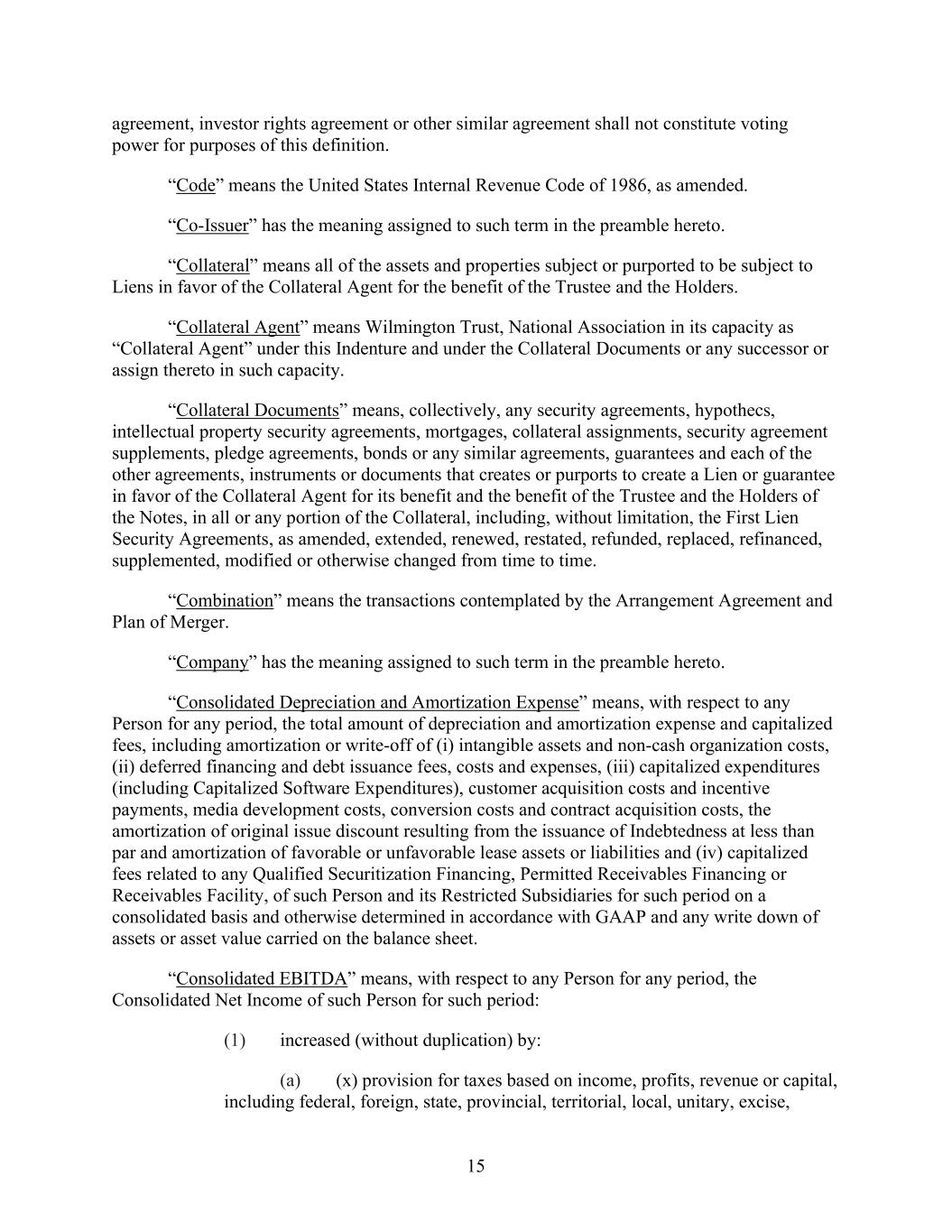
15 agreement, investor rights agreement or other similar agreement shall not constitute voting power for purposes of this definition. “Code” means the United States Internal Revenue Code of 1986, as amended. “Co-Issuer” has the meaning assigned to such term in the preamble hereto. “Collateral” means all of the assets and properties subject or purported to be subject to Liens in favor of the Collateral Agent for the benefit of the Trustee and the Holders. “Collateral Agent” means Wilmington Trust, National Association in its capacity as “Collateral Agent” under this Indenture and under the Collateral Documents or any successor or assign thereto in such capacity. “Collateral Documents” means, collectively, any security agreements, hypothecs, intellectual property security agreements, mortgages, collateral assignments, security agreement supplements, pledge agreements, bonds or any similar agreements, guarantees and each of the other agreements, instruments or documents that creates or purports to create a Lien or guarantee in favor of the Collateral Agent for its benefit and the benefit of the Trustee and the Holders of the Notes, in all or any portion of the Collateral, including, without limitation, the First Lien Security Agreements, as amended, extended, renewed, restated, refunded, replaced, refinanced, supplemented, modified or otherwise changed from time to time. “Combination” means the transactions contemplated by the Arrangement Agreement and Plan of Merger. “Company” has the meaning assigned to such term in the preamble hereto. “Consolidated Depreciation and Amortization Expense” means, with respect to any Person for any period, the total amount of depreciation and amortization expense and capitalized fees, including amortization or write-off of (i) intangible assets and non-cash organization costs, (ii) deferred financing and debt issuance fees, costs and expenses, (iii) capitalized expenditures (including Capitalized Software Expenditures), customer acquisition costs and incentive payments, media development costs, conversion costs and contract acquisition costs, the amortization of original issue discount resulting from the issuance of Indebtedness at less than par and amortization of favorable or unfavorable lease assets or liabilities and (iv) capitalized fees related to any Qualified Securitization Financing, Permitted Receivables Financing or Receivables Facility, of such Person and its Restricted Subsidiaries for such period on a consolidated basis and otherwise determined in accordance with GAAP and any write down of assets or asset value carried on the balance sheet. “Consolidated EBITDA” means, with respect to any Person for any period, the Consolidated Net Income of such Person for such period: (1) increased (without duplication) by: (a) (x) provision for taxes based on income, profits, revenue or capital, including federal, foreign, state, provincial, territorial, local, unitary, excise,
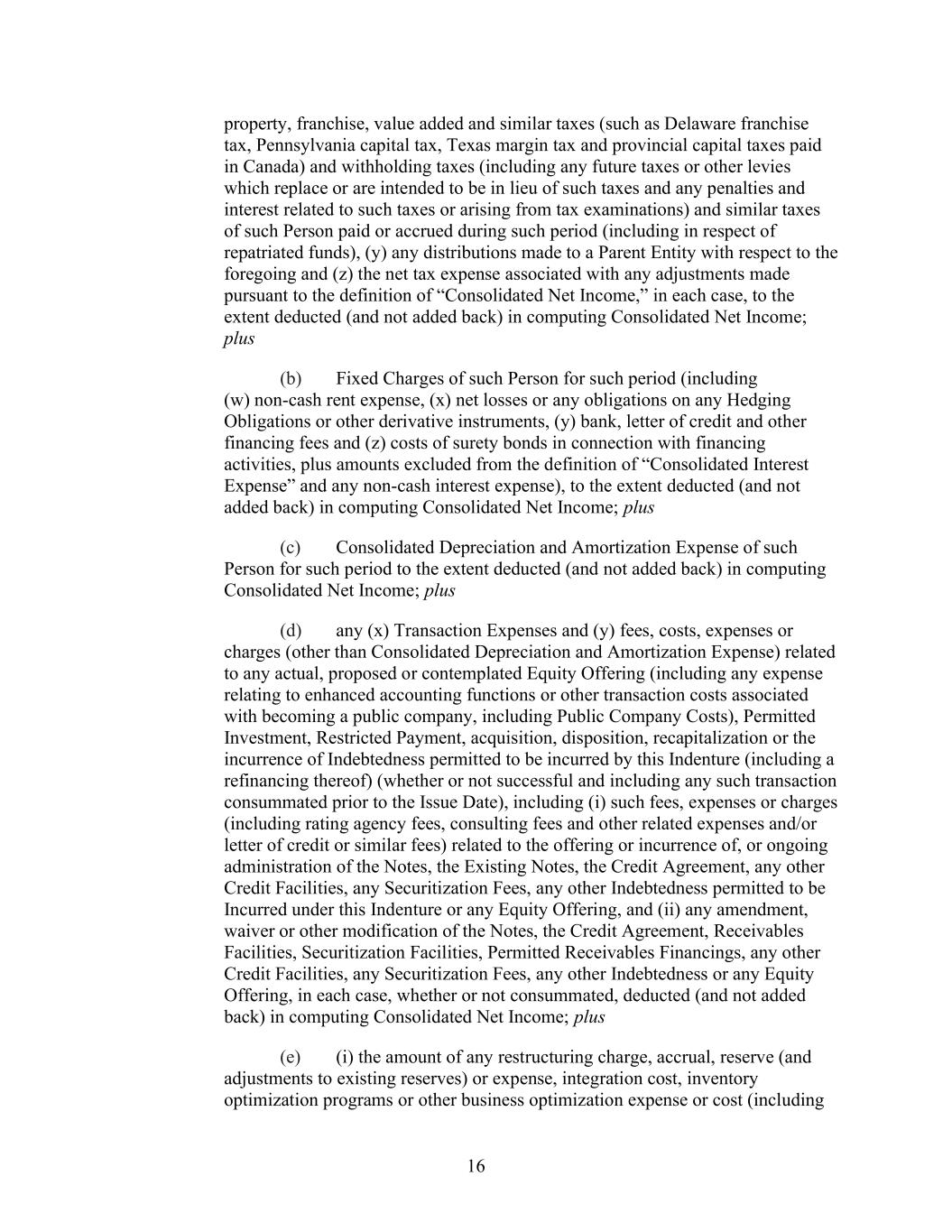
16 property, franchise, value added and similar taxes (such as Delaware franchise tax, Pennsylvania capital tax, Texas margin tax and provincial capital taxes paid in Canada) and withholding taxes (including any future taxes or other levies which replace or are intended to be in lieu of such taxes and any penalties and interest related to such taxes or arising from tax examinations) and similar taxes of such Person paid or accrued during such period (including in respect of repatriated funds), (y) any distributions made to a Parent Entity with respect to the foregoing and (z) the net tax expense associated with any adjustments made pursuant to the definition of “Consolidated Net Income,” in each case, to the extent deducted (and not added back) in computing Consolidated Net Income; plus (b) Fixed Charges of such Person for such period (including (w) non-cash rent expense, (x) net losses or any obligations on any Hedging Obligations or other derivative instruments, (y) bank, letter of credit and other financing fees and (z) costs of surety bonds in connection with financing activities, plus amounts excluded from the definition of “Consolidated Interest Expense” and any non-cash interest expense), to the extent deducted (and not added back) in computing Consolidated Net Income; plus (c) Consolidated Depreciation and Amortization Expense of such Person for such period to the extent deducted (and not added back) in computing Consolidated Net Income; plus (d) any (x) Transaction Expenses and (y) fees, costs, expenses or charges (other than Consolidated Depreciation and Amortization Expense) related to any actual, proposed or contemplated Equity Offering (including any expense relating to enhanced accounting functions or other transaction costs associated with becoming a public company, including Public Company Costs), Permitted Investment, Restricted Payment, acquisition, disposition, recapitalization or the incurrence of Indebtedness permitted to be incurred by this Indenture (including a refinancing thereof) (whether or not successful and including any such transaction consummated prior to the Issue Date), including (i) such fees, expenses or charges (including rating agency fees, consulting fees and other related expenses and/or letter of credit or similar fees) related to the offering or incurrence of, or ongoing administration of the Notes, the Existing Notes, the Credit Agreement, any other Credit Facilities, any Securitization Fees, any other Indebtedness permitted to be Incurred under this Indenture or any Equity Offering, and (ii) any amendment, waiver or other modification of the Notes, the Credit Agreement, Receivables Facilities, Securitization Facilities, Permitted Receivables Financings, any other Credit Facilities, any Securitization Fees, any other Indebtedness or any Equity Offering, in each case, whether or not consummated, deducted (and not added back) in computing Consolidated Net Income; plus (e) (i) the amount of any restructuring charge, accrual, reserve (and adjustments to existing reserves) or expense, integration cost, inventory optimization programs or other business optimization expense or cost (including
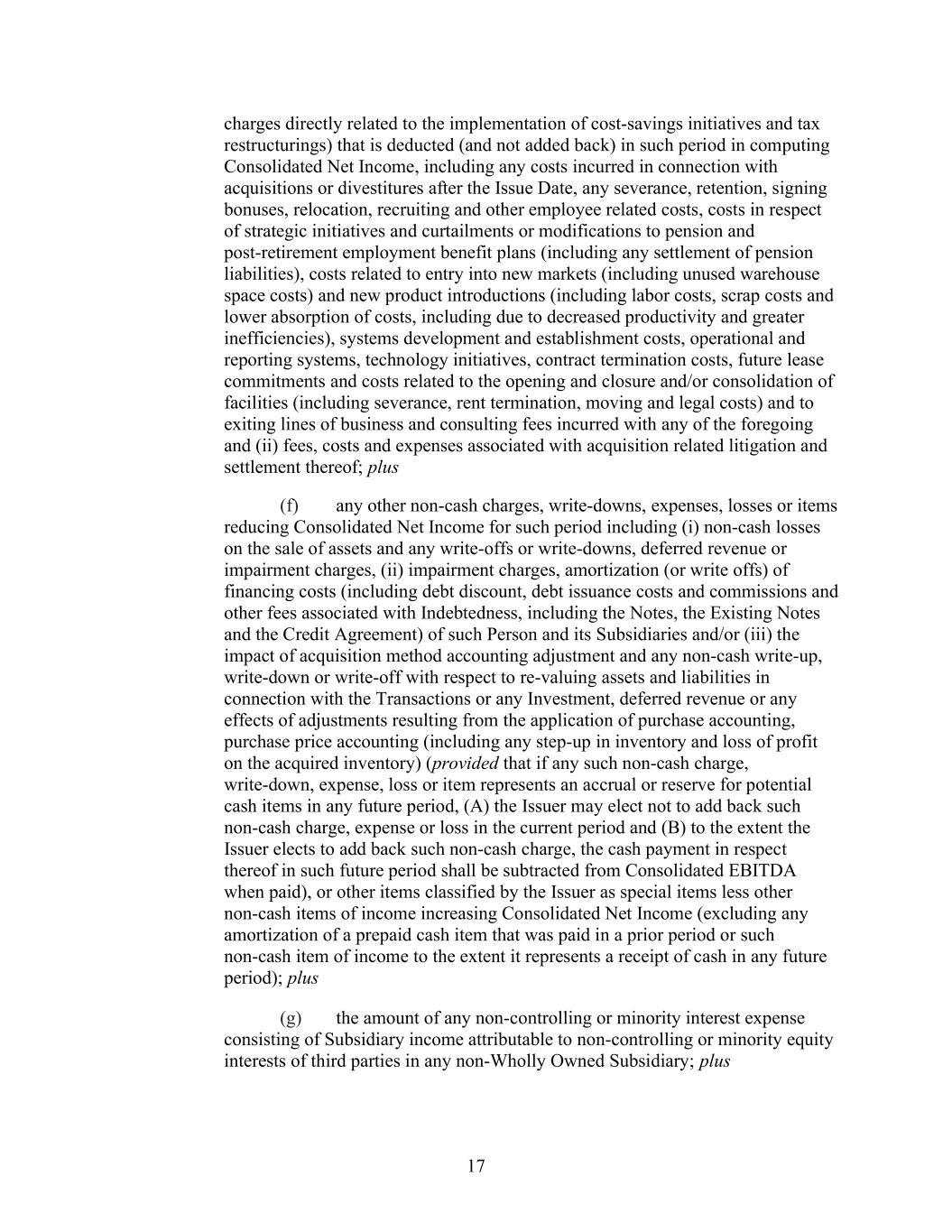
17 charges directly related to the implementation of cost-savings initiatives and tax restructurings) that is deducted (and not added back) in such period in computing Consolidated Net Income, including any costs incurred in connection with acquisitions or divestitures after the Issue Date, any severance, retention, signing bonuses, relocation, recruiting and other employee related costs, costs in respect of strategic initiatives and curtailments or modifications to pension and post-retirement employment benefit plans (including any settlement of pension liabilities), costs related to entry into new markets (including unused warehouse space costs) and new product introductions (including labor costs, scrap costs and lower absorption of costs, including due to decreased productivity and greater inefficiencies), systems development and establishment costs, operational and reporting systems, technology initiatives, contract termination costs, future lease commitments and costs related to the opening and closure and/or consolidation of facilities (including severance, rent termination, moving and legal costs) and to exiting lines of business and consulting fees incurred with any of the foregoing and (ii) fees, costs and expenses associated with acquisition related litigation and settlement thereof; plus (f) any other non-cash charges, write-downs, expenses, losses or items reducing Consolidated Net Income for such period including (i) non-cash losses on the sale of assets and any write-offs or write-downs, deferred revenue or impairment charges, (ii) impairment charges, amortization (or write offs) of financing costs (including debt discount, debt issuance costs and commissions and other fees associated with Indebtedness, including the Notes, the Existing Notes and the Credit Agreement) of such Person and its Subsidiaries and/or (iii) the impact of acquisition method accounting adjustment and any non-cash write-up, write-down or write-off with respect to re-valuing assets and liabilities in connection with the Transactions or any Investment, deferred revenue or any effects of adjustments resulting from the application of purchase accounting, purchase price accounting (including any step-up in inventory and loss of profit on the acquired inventory) (provided that if any such non-cash charge, write-down, expense, loss or item represents an accrual or reserve for potential cash items in any future period, (A) the Issuer may elect not to add back such non-cash charge, expense or loss in the current period and (B) to the extent the Issuer elects to add back such non-cash charge, the cash payment in respect thereof in such future period shall be subtracted from Consolidated EBITDA when paid), or other items classified by the Issuer as special items less other non-cash items of income increasing Consolidated Net Income (excluding any amortization of a prepaid cash item that was paid in a prior period or such non-cash item of income to the extent it represents a receipt of cash in any future period); plus (g) the amount of any non-controlling or minority interest expense consisting of Subsidiary income attributable to non-controlling or minority equity interests of third parties in any non-Wholly Owned Subsidiary; plus
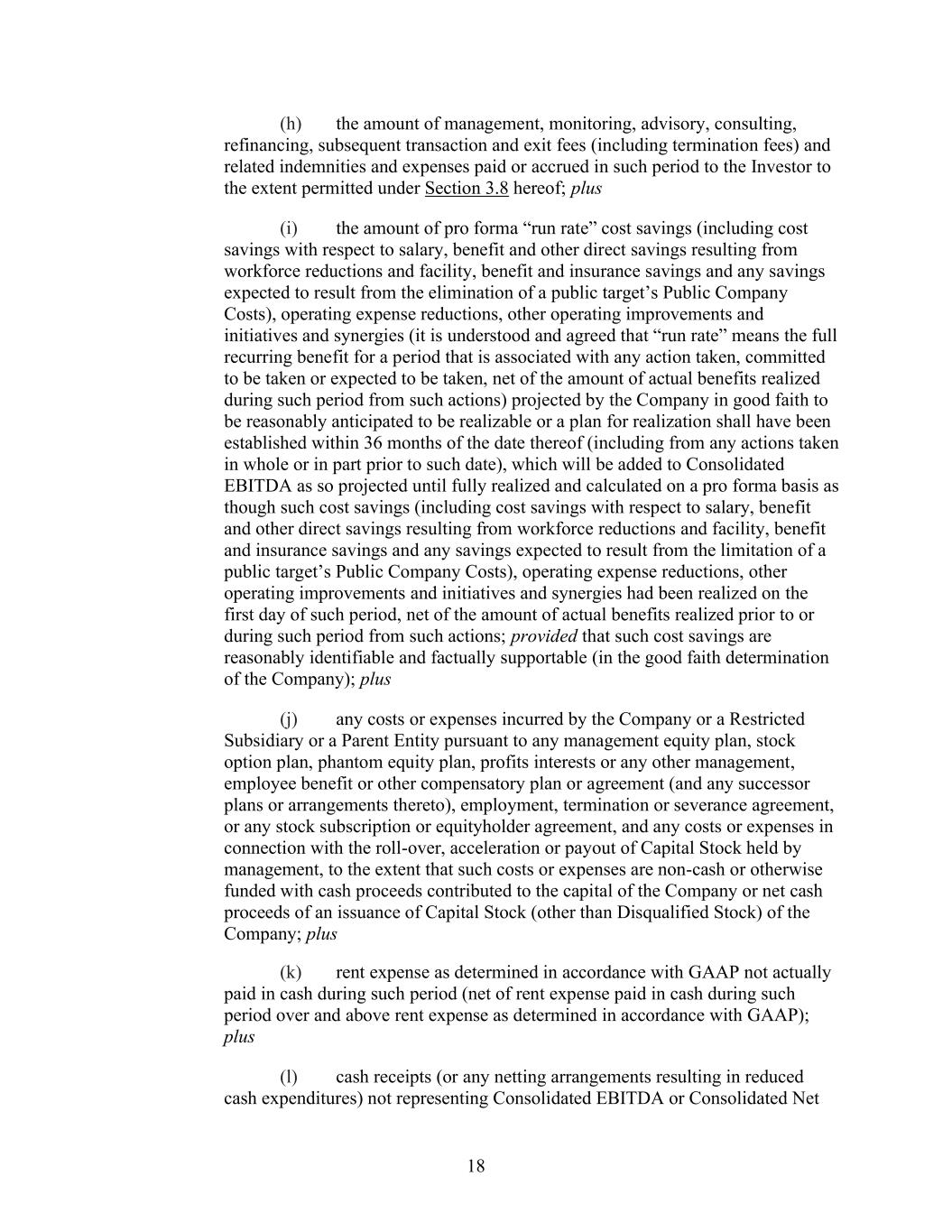
18 (h) the amount of management, monitoring, advisory, consulting, refinancing, subsequent transaction and exit fees (including termination fees) and related indemnities and expenses paid or accrued in such period to the Investor to the extent permitted under Section 3.8 hereof; plus (i) the amount of pro forma “run rate” cost savings (including cost savings with respect to salary, benefit and other direct savings resulting from workforce reductions and facility, benefit and insurance savings and any savings expected to result from the elimination of a public target’s Public Company Costs), operating expense reductions, other operating improvements and initiatives and synergies (it is understood and agreed that “run rate” means the full recurring benefit for a period that is associated with any action taken, committed to be taken or expected to be taken, net of the amount of actual benefits realized during such period from such actions) projected by the Company in good faith to be reasonably anticipated to be realizable or a plan for realization shall have been established within 36 months of the date thereof (including from any actions taken in whole or in part prior to such date), which will be added to Consolidated EBITDA as so projected until fully realized and calculated on a pro forma basis as though such cost savings (including cost savings with respect to salary, benefit and other direct savings resulting from workforce reductions and facility, benefit and insurance savings and any savings expected to result from the limitation of a public target’s Public Company Costs), operating expense reductions, other operating improvements and initiatives and synergies had been realized on the first day of such period, net of the amount of actual benefits realized prior to or during such period from such actions; provided that such cost savings are reasonably identifiable and factually supportable (in the good faith determination of the Company); plus (j) any costs or expenses incurred by the Company or a Restricted Subsidiary or a Parent Entity pursuant to any management equity plan, stock option plan, phantom equity plan, profits interests or any other management, employee benefit or other compensatory plan or agreement (and any successor plans or arrangements thereto), employment, termination or severance agreement, or any stock subscription or equityholder agreement, and any costs or expenses in connection with the roll-over, acceleration or payout of Capital Stock held by management, to the extent that such costs or expenses are non-cash or otherwise funded with cash proceeds contributed to the capital of the Company or net cash proceeds of an issuance of Capital Stock (other than Disqualified Stock) of the Company; plus (k) rent expense as determined in accordance with GAAP not actually paid in cash during such period (net of rent expense paid in cash during such period over and above rent expense as determined in accordance with GAAP); plus (l) cash receipts (or any netting arrangements resulting in reduced cash expenditures) not representing Consolidated EBITDA or Consolidated Net
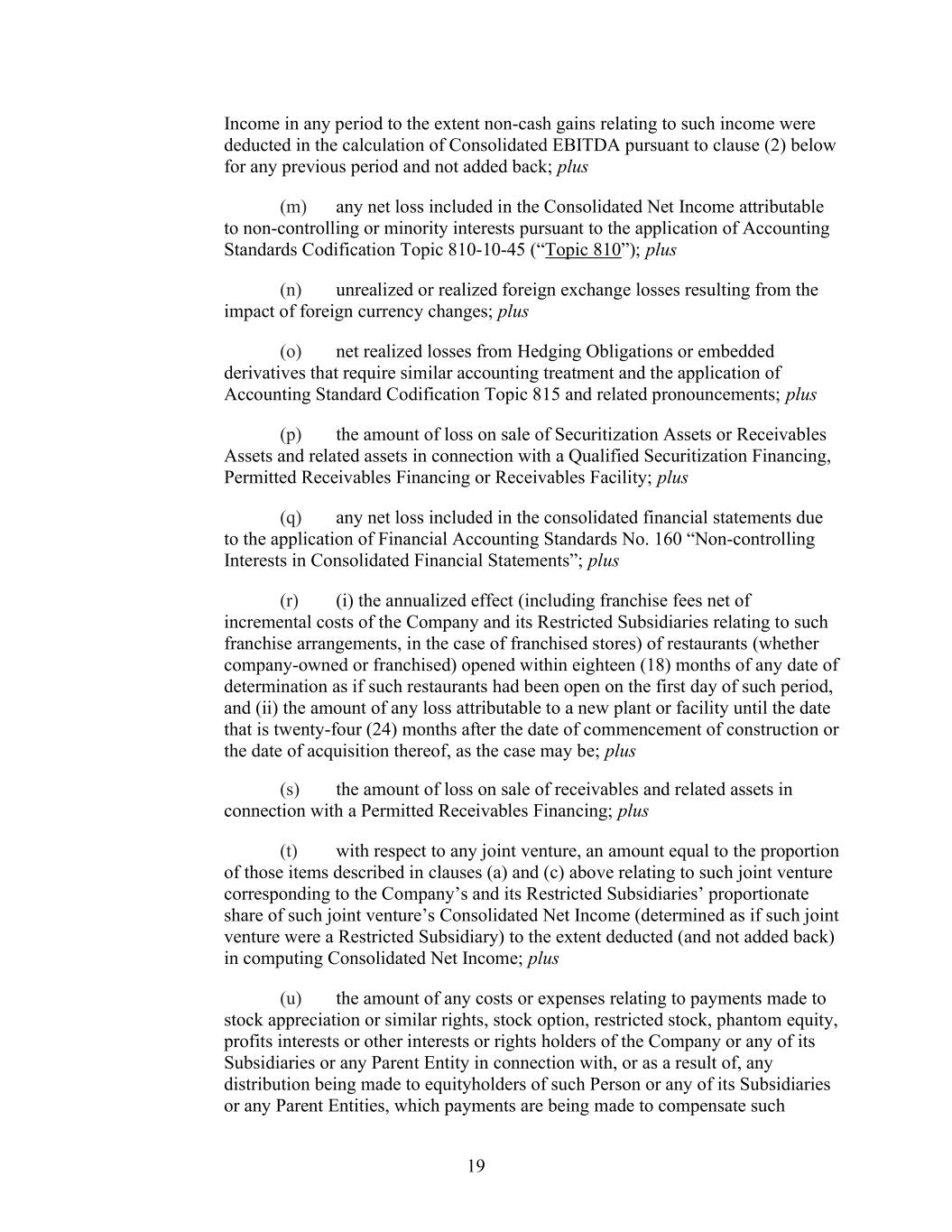
19 Income in any period to the extent non-cash gains relating to such income were deducted in the calculation of Consolidated EBITDA pursuant to clause (2) below for any previous period and not added back; plus (m) any net loss included in the Consolidated Net Income attributable to non-controlling or minority interests pursuant to the application of Accounting Standards Codification Topic 000-00-00 (“Topic 810”); plus (n) unrealized or realized foreign exchange losses resulting from the impact of foreign currency changes; plus (o) net realized losses from Hedging Obligations or embedded derivatives that require similar accounting treatment and the application of Accounting Standard Codification Topic 815 and related pronouncements; plus (p) the amount of loss on sale of Securitization Assets or Receivables Assets and related assets in connection with a Qualified Securitization Financing, Permitted Receivables Financing or Receivables Facility; plus (q) any net loss included in the consolidated financial statements due to the application of Financial Accounting Standards No. 160 “Non-controlling Interests in Consolidated Financial Statements”; plus (r) (i) the annualized effect (including franchise fees net of incremental costs of the Company and its Restricted Subsidiaries relating to such franchise arrangements, in the case of franchised stores) of restaurants (whether company-owned or franchised) opened within eighteen (18) months of any date of determination as if such restaurants had been open on the first day of such period, and (ii) the amount of any loss attributable to a new plant or facility until the date that is twenty-four (24) months after the date of commencement of construction or the date of acquisition thereof, as the case may be; plus (s) the amount of loss on sale of receivables and related assets in connection with a Permitted Receivables Financing; plus (t) with respect to any joint venture, an amount equal to the proportion of those items described in clauses (a) and (c) above relating to such joint venture corresponding to the Company’s and its Restricted Subsidiaries’ proportionate share of such joint venture’s Consolidated Net Income (determined as if such joint venture were a Restricted Subsidiary) to the extent deducted (and not added back) in computing Consolidated Net Income; plus (u) the amount of any costs or expenses relating to payments made to stock appreciation or similar rights, stock option, restricted stock, phantom equity, profits interests or other interests or rights holders of the Company or any of its Subsidiaries or any Parent Entity in connection with, or as a result of, any distribution being made to equityholders of such Person or any of its Subsidiaries or any Parent Entities, which payments are being made to compensate such
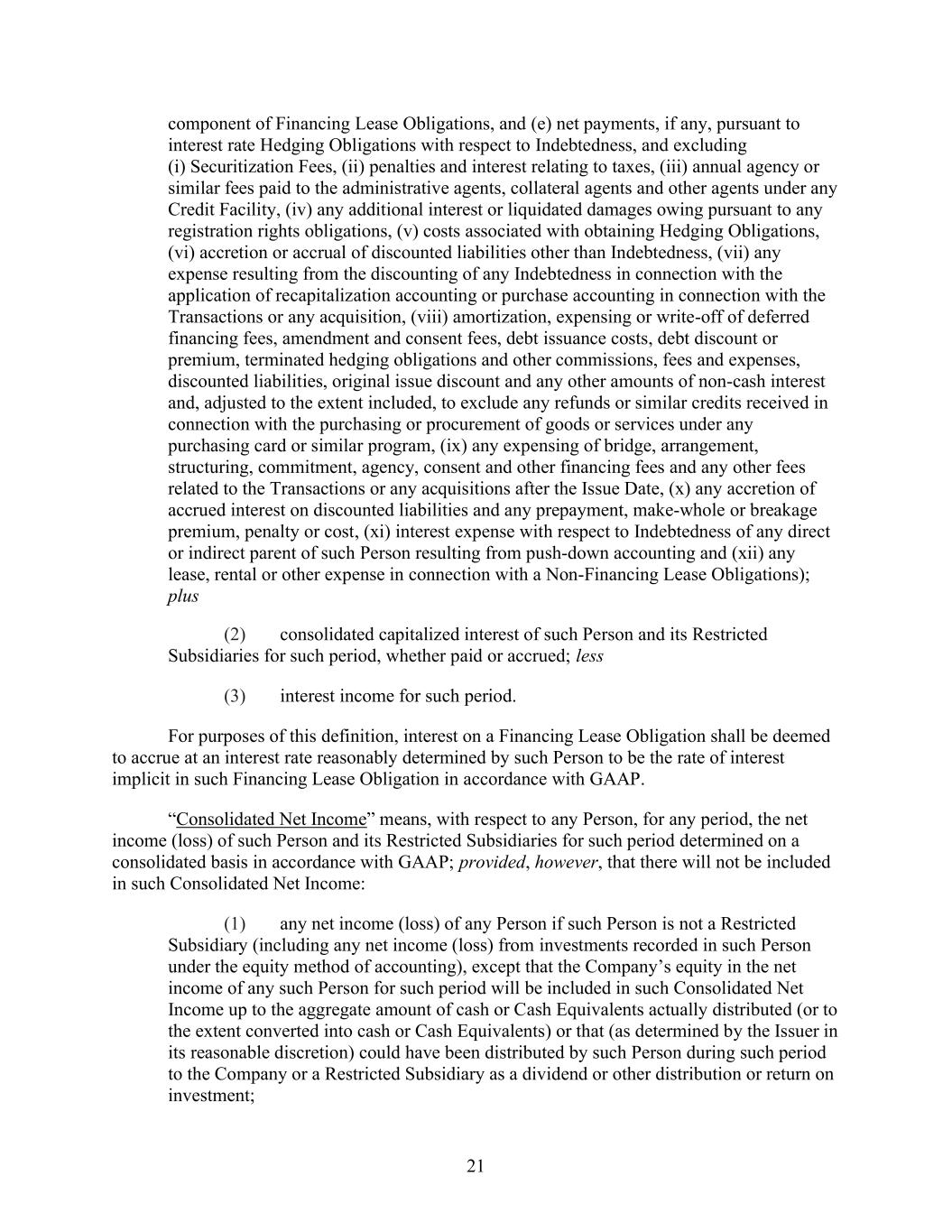
21 component of Financing Lease Obligations, and (e) net payments, if any, pursuant to interest rate Hedging Obligations with respect to Indebtedness, and excluding (i) Securitization Fees, (ii) penalties and interest relating to taxes, (iii) annual agency or similar fees paid to the administrative agents, collateral agents and other agents under any Credit Facility, (iv) any additional interest or liquidated damages owing pursuant to any registration rights obligations, (v) costs associated with obtaining Hedging Obligations, (vi) accretion or accrual of discounted liabilities other than Indebtedness, (vii) any expense resulting from the discounting of any Indebtedness in connection with the application of recapitalization accounting or purchase accounting in connection with the Transactions or any acquisition, (viii) amortization, expensing or write-off of deferred financing fees, amendment and consent fees, debt issuance costs, debt discount or premium, terminated hedging obligations and other commissions, fees and expenses, discounted liabilities, original issue discount and any other amounts of non-cash interest and, adjusted to the extent included, to exclude any refunds or similar credits received in connection with the purchasing or procurement of goods or services under any purchasing card or similar program, (ix) any expensing of bridge, arrangement, structuring, commitment, agency, consent and other financing fees and any other fees related to the Transactions or any acquisitions after the Issue Date, (x) any accretion of accrued interest on discounted liabilities and any prepayment, make-whole or breakage premium, penalty or cost, (xi) interest expense with respect to Indebtedness of any direct or indirect parent of such Person resulting from push-down accounting and (xii) any lease, rental or other expense in connection with a Non-Financing Lease Obligations); plus (2) consolidated capitalized interest of such Person and its Restricted Subsidiaries for such period, whether paid or accrued; less (3) interest income for such period. For purposes of this definition, interest on a Financing Lease Obligation shall be deemed to accrue at an interest rate reasonably determined by such Person to be the rate of interest implicit in such Financing Lease Obligation in accordance with GAAP. “Consolidated Net Income” means, with respect to any Person, for any period, the net income (loss) of such Person and its Restricted Subsidiaries for such period determined on a consolidated basis in accordance with GAAP; provided, however, that there will not be included in such Consolidated Net Income: (1) any net income (loss) of any Person if such Person is not a Restricted Subsidiary (including any net income (loss) from investments recorded in such Person under the equity method of accounting), except that the Company’s equity in the net income of any such Person for such period will be included in such Consolidated Net Income up to the aggregate amount of cash or Cash Equivalents actually distributed (or to the extent converted into cash or Cash Equivalents) or that (as determined by the Issuer in its reasonable discretion) could have been distributed by such Person during such period to the Company or a Restricted Subsidiary as a dividend or other distribution or return on investment;
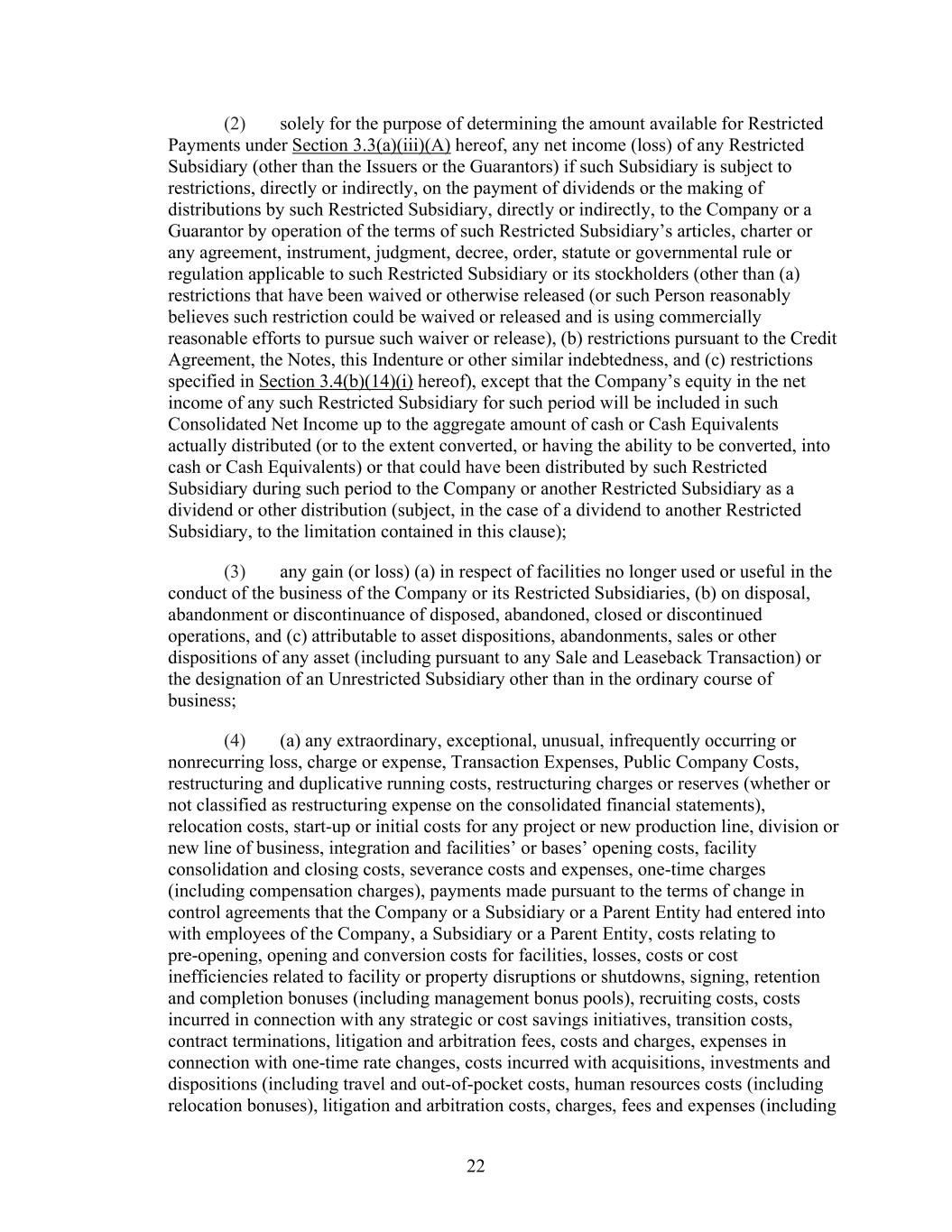
22 (2) solely for the purpose of determining the amount available for Restricted Payments under Section 3.3(a)(iii)(A) hereof, any net income (loss) of any Restricted Subsidiary (other than the Issuers or the Guarantors) if such Subsidiary is subject to restrictions, directly or indirectly, on the payment of dividends or the making of distributions by such Restricted Subsidiary, directly or indirectly, to the Company or a Guarantor by operation of the terms of such Restricted Subsidiary’s articles, charter or any agreement, instrument, judgment, decree, order, statute or governmental rule or regulation applicable to such Restricted Subsidiary or its stockholders (other than (a) restrictions that have been waived or otherwise released (or such Person reasonably believes such restriction could be waived or released and is using commercially reasonable efforts to pursue such waiver or release), (b) restrictions pursuant to the Credit Agreement, the Notes, this Indenture or other similar indebtedness, and (c) restrictions specified in Section 3.4(b)(14)(i) hereof), except that the Company’s equity in the net income of any such Restricted Subsidiary for such period will be included in such Consolidated Net Income up to the aggregate amount of cash or Cash Equivalents actually distributed (or to the extent converted, or having the ability to be converted, into cash or Cash Equivalents) or that could have been distributed by such Restricted Subsidiary during such period to the Company or another Restricted Subsidiary as a dividend or other distribution (subject, in the case of a dividend to another Restricted Subsidiary, to the limitation contained in this clause); (3) any gain (or loss) (a) in respect of facilities no longer used or useful in the conduct of the business of the Company or its Restricted Subsidiaries, (b) on disposal, abandonment or discontinuance of disposed, abandoned, closed or discontinued operations, and (c) attributable to asset dispositions, abandonments, sales or other dispositions of any asset (including pursuant to any Sale and Leaseback Transaction) or the designation of an Unrestricted Subsidiary other than in the ordinary course of business; (4) (a) any extraordinary, exceptional, unusual, infrequently occurring or nonrecurring loss, charge or expense, Transaction Expenses, Public Company Costs, restructuring and duplicative running costs, restructuring charges or reserves (whether or not classified as restructuring expense on the consolidated financial statements), relocation costs, start-up or initial costs for any project or new production line, division or new line of business, integration and facilities’ or bases’ opening costs, facility consolidation and closing costs, severance costs and expenses, one-time charges (including compensation charges), payments made pursuant to the terms of change in control agreements that the Company or a Subsidiary or a Parent Entity had entered into with employees of the Company, a Subsidiary or a Parent Entity, costs relating to pre-opening, opening and conversion costs for facilities, losses, costs or cost inefficiencies related to facility or property disruptions or shutdowns, signing, retention and completion bonuses (including management bonus pools), recruiting costs, costs incurred in connection with any strategic or cost savings initiatives, transition costs, contract terminations, litigation and arbitration fees, costs and charges, expenses in connection with one-time rate changes, costs incurred with acquisitions, investments and dispositions (including travel and out-of-pocket costs, human resources costs (including relocation bonuses), litigation and arbitration costs, charges, fees and expenses (including
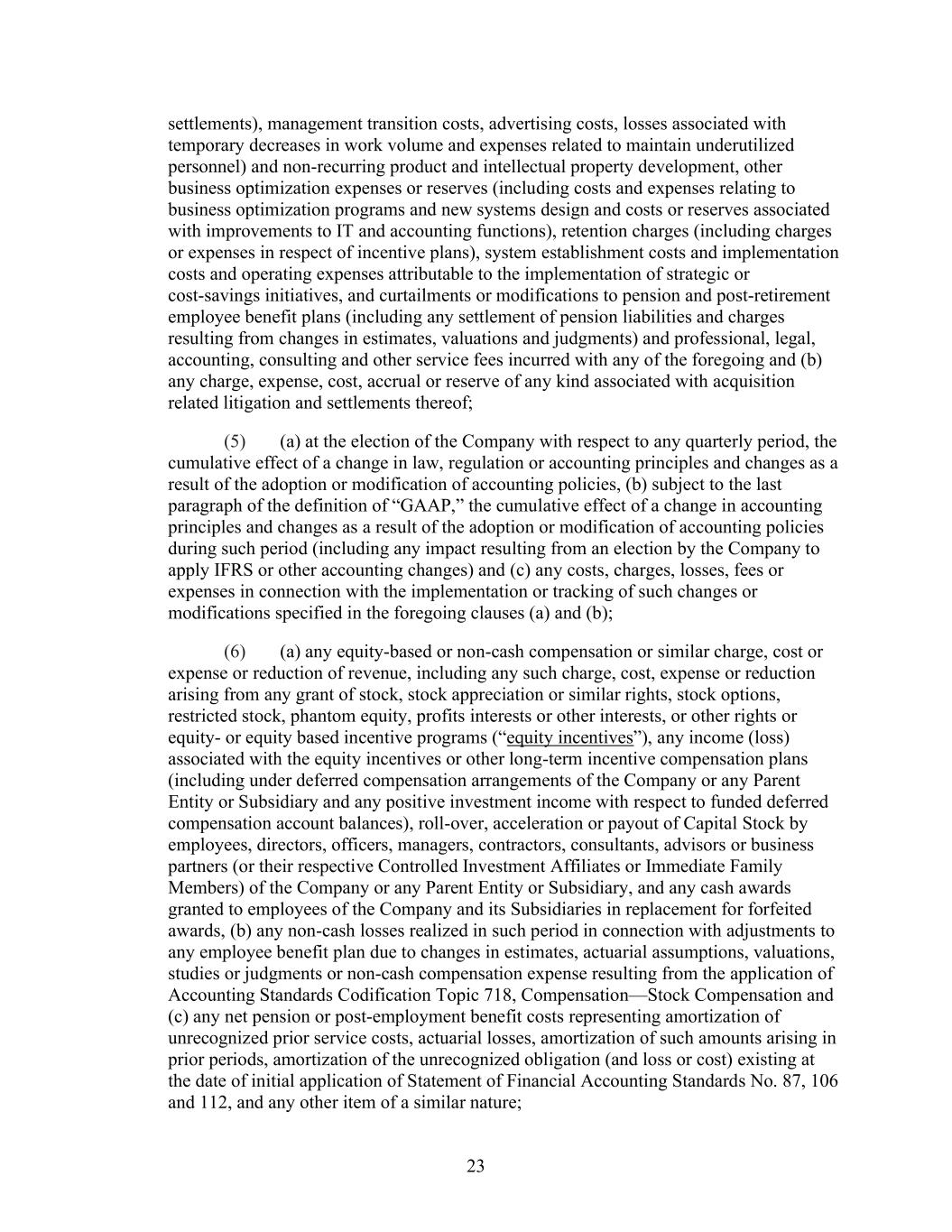
23 settlements), management transition costs, advertising costs, losses associated with temporary decreases in work volume and expenses related to maintain underutilized personnel) and non-recurring product and intellectual property development, other business optimization expenses or reserves (including costs and expenses relating to business optimization programs and new systems design and costs or reserves associated with improvements to IT and accounting functions), retention charges (including charges or expenses in respect of incentive plans), system establishment costs and implementation costs and operating expenses attributable to the implementation of strategic or cost-savings initiatives, and curtailments or modifications to pension and post-retirement employee benefit plans (including any settlement of pension liabilities and charges resulting from changes in estimates, valuations and judgments) and professional, legal, accounting, consulting and other service fees incurred with any of the foregoing and (b) any charge, expense, cost, accrual or reserve of any kind associated with acquisition related litigation and settlements thereof; (5) (a) at the election of the Company with respect to any quarterly period, the cumulative effect of a change in law, regulation or accounting principles and changes as a result of the adoption or modification of accounting policies, (b) subject to the last paragraph of the definition of “GAAP,” the cumulative effect of a change in accounting principles and changes as a result of the adoption or modification of accounting policies during such period (including any impact resulting from an election by the Company to apply IFRS or other accounting changes) and (c) any costs, charges, losses, fees or expenses in connection with the implementation or tracking of such changes or modifications specified in the foregoing clauses (a) and (b); (6) (a) any equity-based or non-cash compensation or similar charge, cost or expense or reduction of revenue, including any such charge, cost, expense or reduction arising from any grant of stock, stock appreciation or similar rights, stock options, restricted stock, phantom equity, profits interests or other interests, or other rights or equity- or equity based incentive programs (“equity incentives”), any income (loss) associated with the equity incentives or other long-term incentive compensation plans (including under deferred compensation arrangements of the Company or any Parent Entity or Subsidiary and any positive investment income with respect to funded deferred compensation account balances), roll-over, acceleration or payout of Capital Stock by employees, directors, officers, managers, contractors, consultants, advisors or business partners (or their respective Controlled Investment Affiliates or Immediate Family Members) of the Company or any Parent Entity or Subsidiary, and any cash awards granted to employees of the Company and its Subsidiaries in replacement for forfeited awards, (b) any non-cash losses realized in such period in connection with adjustments to any employee benefit plan due to changes in estimates, actuarial assumptions, valuations, studies or judgments or non-cash compensation expense resulting from the application of Accounting Standards Codification Topic 718, Compensation—Stock Compensation and (c) any net pension or post-employment benefit costs representing amortization of unrecognized prior service costs, actuarial losses, amortization of such amounts arising in prior periods, amortization of the unrecognized obligation (and loss or cost) existing at the date of initial application of Statement of Financial Accounting Standards No. 87, 106 and 112, and any other item of a similar nature;
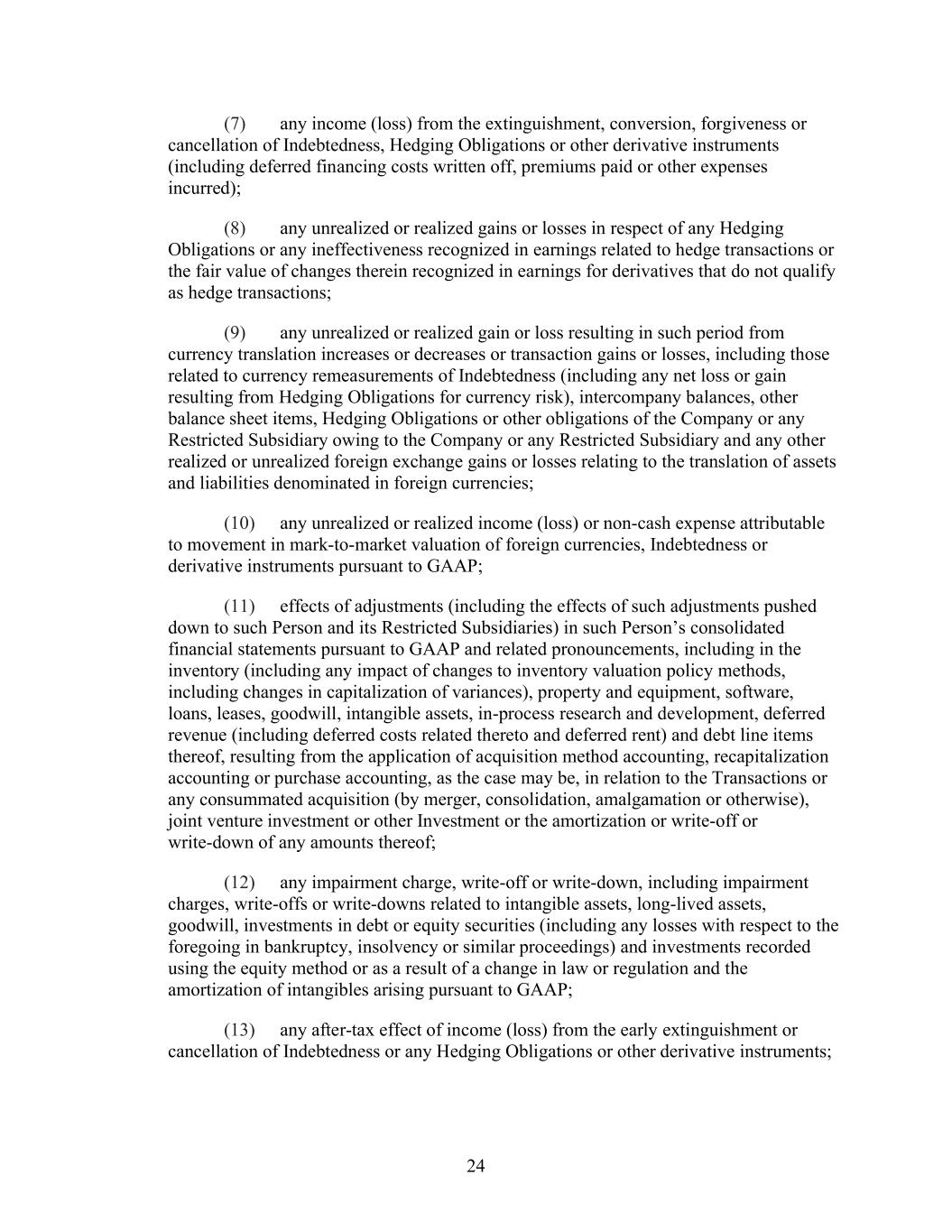
24 (7) any income (loss) from the extinguishment, conversion, forgiveness or cancellation of Indebtedness, Hedging Obligations or other derivative instruments (including deferred financing costs written off, premiums paid or other expenses incurred); (8) any unrealized or realized gains or losses in respect of any Hedging Obligations or any ineffectiveness recognized in earnings related to hedge transactions or the fair value of changes therein recognized in earnings for derivatives that do not qualify as hedge transactions; (9) any unrealized or realized gain or loss resulting in such period from currency translation increases or decreases or transaction gains or losses, including those related to currency remeasurements of Indebtedness (including any net loss or gain resulting from Hedging Obligations for currency risk), intercompany balances, other balance sheet items, Hedging Obligations or other obligations of the Company or any Restricted Subsidiary owing to the Company or any Restricted Subsidiary and any other realized or unrealized foreign exchange gains or losses relating to the translation of assets and liabilities denominated in foreign currencies; (10) any unrealized or realized income (loss) or non-cash expense attributable to movement in mark-to-market valuation of foreign currencies, Indebtedness or derivative instruments pursuant to GAAP; (11) effects of adjustments (including the effects of such adjustments pushed down to such Person and its Restricted Subsidiaries) in such Person’s consolidated financial statements pursuant to GAAP and related pronouncements, including in the inventory (including any impact of changes to inventory valuation policy methods, including changes in capitalization of variances), property and equipment, software, loans, leases, goodwill, intangible assets, in-process research and development, deferred revenue (including deferred costs related thereto and deferred rent) and debt line items thereof, resulting from the application of acquisition method accounting, recapitalization accounting or purchase accounting, as the case may be, in relation to the Transactions or any consummated acquisition (by merger, consolidation, amalgamation or otherwise), joint venture investment or other Investment or the amortization or write-off or write-down of any amounts thereof; (12) any impairment charge, write-off or write-down, including impairment charges, write-offs or write-downs related to intangible assets, long-lived assets, goodwill, investments in debt or equity securities (including any losses with respect to the foregoing in bankruptcy, insolvency or similar proceedings) and investments recorded using the equity method or as a result of a change in law or regulation and the amortization of intangibles arising pursuant to GAAP; (13) any after-tax effect of income (loss) from the early extinguishment or cancellation of Indebtedness or any Hedging Obligations or other derivative instruments;
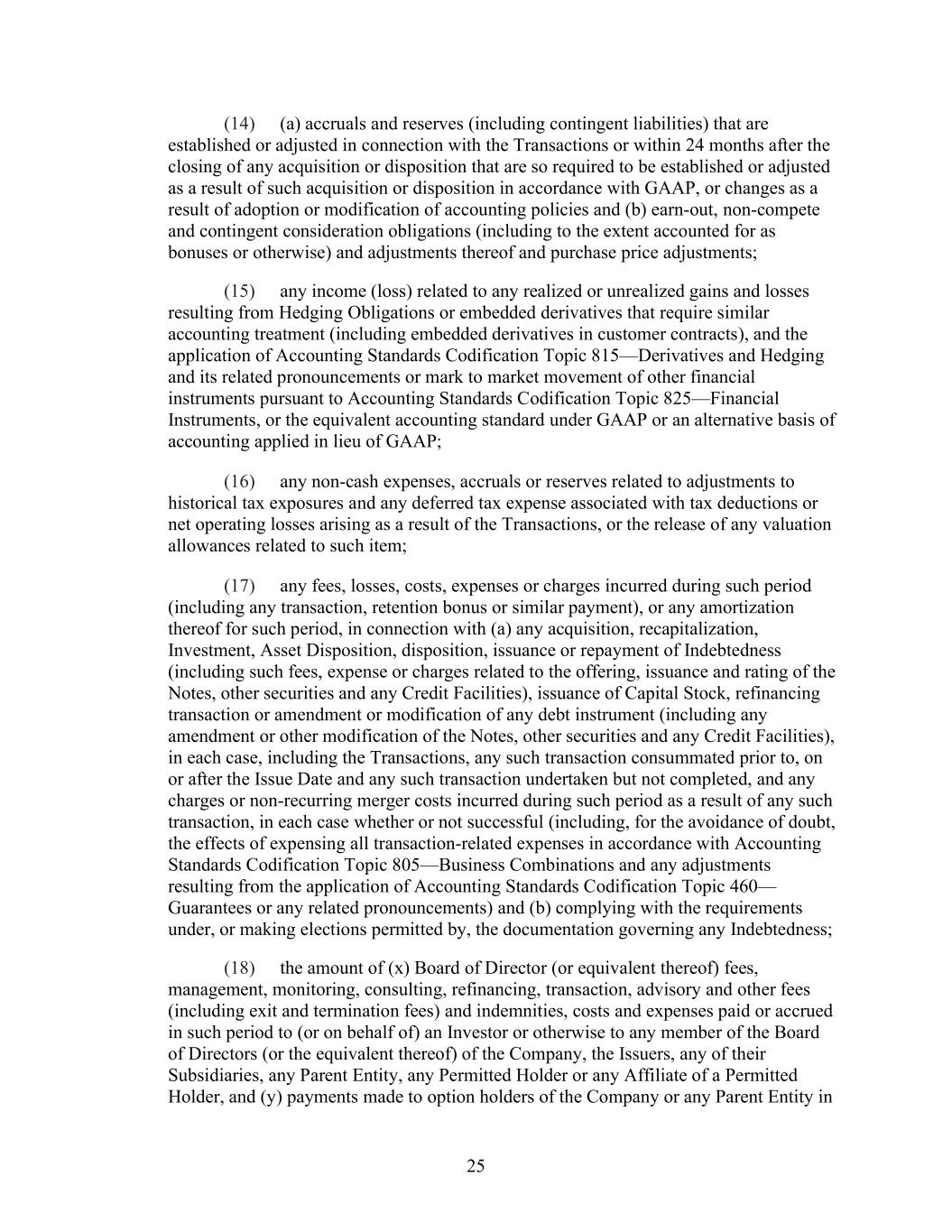
25 (14) (a) accruals and reserves (including contingent liabilities) that are established or adjusted in connection with the Transactions or within 24 months after the closing of any acquisition or disposition that are so required to be established or adjusted as a result of such acquisition or disposition in accordance with GAAP, or changes as a result of adoption or modification of accounting policies and (b) earn-out, non-compete and contingent consideration obligations (including to the extent accounted for as bonuses or otherwise) and adjustments thereof and purchase price adjustments; (15) any income (loss) related to any realized or unrealized gains and losses resulting from Hedging Obligations or embedded derivatives that require similar accounting treatment (including embedded derivatives in customer contracts), and the application of Accounting Standards Codification Topic 815—Derivatives and Hedging and its related pronouncements or mark to market movement of other financial instruments pursuant to Accounting Standards Codification Topic 825—Financial Instruments, or the equivalent accounting standard under GAAP or an alternative basis of accounting applied in lieu of GAAP; (16) any non-cash expenses, accruals or reserves related to adjustments to historical tax exposures and any deferred tax expense associated with tax deductions or net operating losses arising as a result of the Transactions, or the release of any valuation allowances related to such item; (17) any fees, losses, costs, expenses or charges incurred during such period (including any transaction, retention bonus or similar payment), or any amortization thereof for such period, in connection with (a) any acquisition, recapitalization, Investment, Asset Disposition, disposition, issuance or repayment of Indebtedness (including such fees, expense or charges related to the offering, issuance and rating of the Notes, other securities and any Credit Facilities), issuance of Capital Stock, refinancing transaction or amendment or modification of any debt instrument (including any amendment or other modification of the Notes, other securities and any Credit Facilities), in each case, including the Transactions, any such transaction consummated prior to, on or after the Issue Date and any such transaction undertaken but not completed, and any charges or non-recurring merger costs incurred during such period as a result of any such transaction, in each case whether or not successful (including, for the avoidance of doubt, the effects of expensing all transaction-related expenses in accordance with Accounting Standards Codification Topic 805—Business Combinations and any adjustments resulting from the application of Accounting Standards Codification Topic 460— Guarantees or any related pronouncements) and (b) complying with the requirements under, or making elections permitted by, the documentation governing any Indebtedness; (18) the amount of (x) Board of Director (or equivalent thereof) fees, management, monitoring, consulting, refinancing, transaction, advisory and other fees (including exit and termination fees) and indemnities, costs and expenses paid or accrued in such period to (or on behalf of) an Investor or otherwise to any member of the Board of Directors (or the equivalent thereof) of the Company, the Issuers, any of their Subsidiaries, any Parent Entity, any Permitted Holder or any Affiliate of a Permitted Holder, and (y) payments made to option holders of the Company or any Parent Entity in
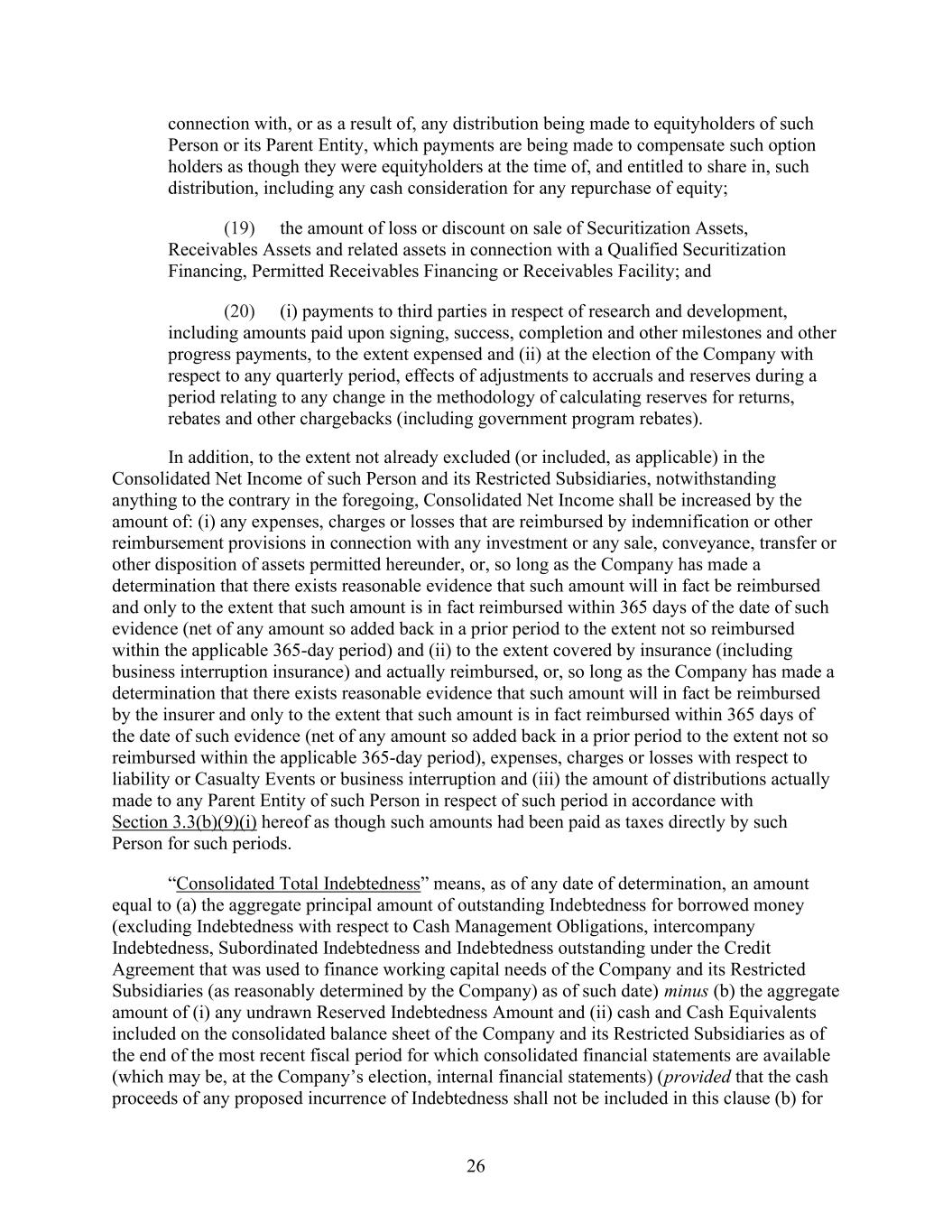
26 connection with, or as a result of, any distribution being made to equityholders of such Person or its Parent Entity, which payments are being made to compensate such option holders as though they were equityholders at the time of, and entitled to share in, such distribution, including any cash consideration for any repurchase of equity; (19) the amount of loss or discount on sale of Securitization Assets, Receivables Assets and related assets in connection with a Qualified Securitization Financing, Permitted Receivables Financing or Receivables Facility; and (20) (i) payments to third parties in respect of research and development, including amounts paid upon signing, success, completion and other milestones and other progress payments, to the extent expensed and (ii) at the election of the Company with respect to any quarterly period, effects of adjustments to accruals and reserves during a period relating to any change in the methodology of calculating reserves for returns, rebates and other chargebacks (including government program rebates). In addition, to the extent not already excluded (or included, as applicable) in the Consolidated Net Income of such Person and its Restricted Subsidiaries, notwithstanding anything to the contrary in the foregoing, Consolidated Net Income shall be increased by the amount of: (i) any expenses, charges or losses that are reimbursed by indemnification or other reimbursement provisions in connection with any investment or any sale, conveyance, transfer or other disposition of assets permitted hereunder, or, so long as the Company has made a determination that there exists reasonable evidence that such amount will in fact be reimbursed and only to the extent that such amount is in fact reimbursed within 365 days of the date of such evidence (net of any amount so added back in a prior period to the extent not so reimbursed within the applicable 365-day period) and (ii) to the extent covered by insurance (including business interruption insurance) and actually reimbursed, or, so long as the Company has made a determination that there exists reasonable evidence that such amount will in fact be reimbursed by the insurer and only to the extent that such amount is in fact reimbursed within 365 days of the date of such evidence (net of any amount so added back in a prior period to the extent not so reimbursed within the applicable 365-day period), expenses, charges or losses with respect to liability or Casualty Events or business interruption and (iii) the amount of distributions actually made to any Parent Entity of such Person in respect of such period in accordance with Section 3.3(b)(9)(i) hereof as though such amounts had been paid as taxes directly by such Person for such periods. “Consolidated Total Indebtedness” means, as of any date of determination, an amount equal to (a) the aggregate principal amount of outstanding Indebtedness for borrowed money (excluding Indebtedness with respect to Cash Management Obligations, intercompany Indebtedness, Subordinated Indebtedness and Indebtedness outstanding under the Credit Agreement that was used to finance working capital needs of the Company and its Restricted Subsidiaries (as reasonably determined by the Company) as of such date) minus (b) the aggregate amount of (i) any undrawn Reserved Indebtedness Amount and (ii) cash and Cash Equivalents included on the consolidated balance sheet of the Company and its Restricted Subsidiaries as of the end of the most recent fiscal period for which consolidated financial statements are available (which may be, at the Company’s election, internal financial statements) (provided that the cash proceeds of any proposed incurrence of Indebtedness shall not be included in this clause (b) for
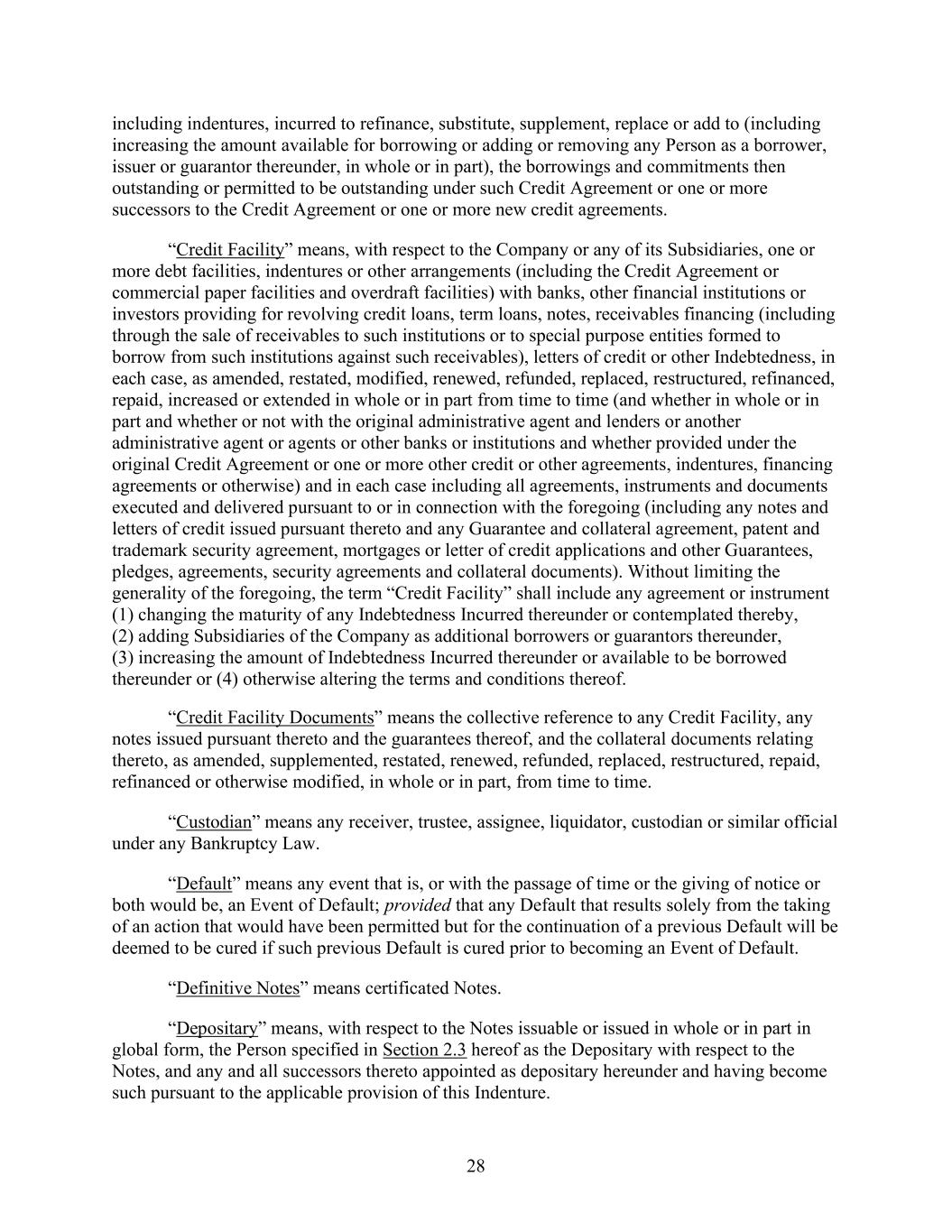
28 including indentures, incurred to refinance, substitute, supplement, replace or add to (including increasing the amount available for borrowing or adding or removing any Person as a borrower, issuer or guarantor thereunder, in whole or in part), the borrowings and commitments then outstanding or permitted to be outstanding under such Credit Agreement or one or more successors to the Credit Agreement or one or more new credit agreements. “Credit Facility” means, with respect to the Company or any of its Subsidiaries, one or more debt facilities, indentures or other arrangements (including the Credit Agreement or commercial paper facilities and overdraft facilities) with banks, other financial institutions or investors providing for revolving credit loans, term loans, notes, receivables financing (including through the sale of receivables to such institutions or to special purpose entities formed to borrow from such institutions against such receivables), letters of credit or other Indebtedness, in each case, as amended, restated, modified, renewed, refunded, replaced, restructured, refinanced, repaid, increased or extended in whole or in part from time to time (and whether in whole or in part and whether or not with the original administrative agent and lenders or another administrative agent or agents or other banks or institutions and whether provided under the original Credit Agreement or one or more other credit or other agreements, indentures, financing agreements or otherwise) and in each case including all agreements, instruments and documents executed and delivered pursuant to or in connection with the foregoing (including any notes and letters of credit issued pursuant thereto and any Guarantee and collateral agreement, patent and trademark security agreement, mortgages or letter of credit applications and other Guarantees, pledges, agreements, security agreements and collateral documents). Without limiting the generality of the foregoing, the term “Credit Facility” shall include any agreement or instrument (1) changing the maturity of any Indebtedness Incurred thereunder or contemplated thereby, (2) adding Subsidiaries of the Company as additional borrowers or guarantors thereunder, (3) increasing the amount of Indebtedness Incurred thereunder or available to be borrowed thereunder or (4) otherwise altering the terms and conditions thereof. “Credit Facility Documents” means the collective reference to any Credit Facility, any notes issued pursuant thereto and the guarantees thereof, and the collateral documents relating thereto, as amended, supplemented, restated, renewed, refunded, replaced, restructured, repaid, refinanced or otherwise modified, in whole or in part, from time to time. “Custodian” means any receiver, trustee, assignee, liquidator, custodian or similar official under any Bankruptcy Law. “Default” means any event that is, or with the passage of time or the giving of notice or both would be, an Event of Default; provided that any Default that results solely from the taking of an action that would have been permitted but for the continuation of a previous Default will be deemed to be cured if such previous Default is cured prior to becoming an Event of Default. “Definitive Notes” means certificated Notes. “Depositary” means, with respect to the Notes issuable or issued in whole or in part in global form, the Person specified in Section 2.3 hereof as the Depositary with respect to the Notes, and any and all successors thereto appointed as depositary hereunder and having become such pursuant to the applicable provision of this Indenture.
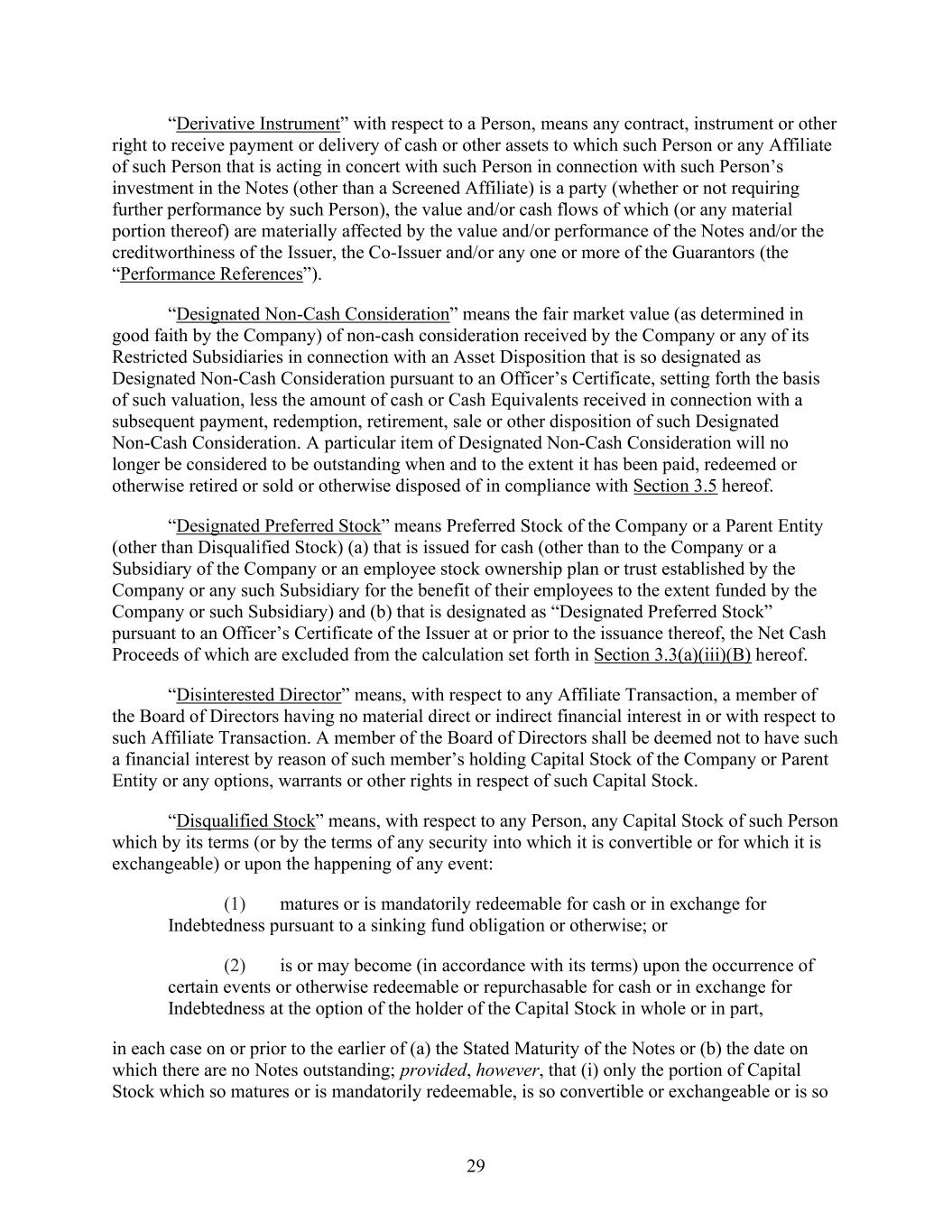
29 “Derivative Instrument” with respect to a Person, means any contract, instrument or other right to receive payment or delivery of cash or other assets to which such Person or any Affiliate of such Person that is acting in concert with such Person in connection with such Person’s investment in the Notes (other than a Screened Affiliate) is a party (whether or not requiring further performance by such Person), the value and/or cash flows of which (or any material portion thereof) are materially affected by the value and/or performance of the Notes and/or the creditworthiness of the Issuer, the Co-Issuer and/or any one or more of the Guarantors (the “Performance References”). “Designated Non-Cash Consideration” means the fair market value (as determined in good faith by the Company) of non-cash consideration received by the Company or any of its Restricted Subsidiaries in connection with an Asset Disposition that is so designated as Designated Non-Cash Consideration pursuant to an Officer’s Certificate, setting forth the basis of such valuation, less the amount of cash or Cash Equivalents received in connection with a subsequent payment, redemption, retirement, sale or other disposition of such Designated Non-Cash Consideration. A particular item of Designated Non-Cash Consideration will no longer be considered to be outstanding when and to the extent it has been paid, redeemed or otherwise retired or sold or otherwise disposed of in compliance with Section 3.5 hereof. “Designated Preferred Stock” means Preferred Stock of the Company or a Parent Entity (other than Disqualified Stock) (a) that is issued for cash (other than to the Company or a Subsidiary of the Company or an employee stock ownership plan or trust established by the Company or any such Subsidiary for the benefit of their employees to the extent funded by the Company or such Subsidiary) and (b) that is designated as “Designated Preferred Stock” pursuant to an Officer’s Certificate of the Issuer at or prior to the issuance thereof, the Net Cash Proceeds of which are excluded from the calculation set forth in Section 3.3(a)(iii)(B) hereof. “Disinterested Director” means, with respect to any Affiliate Transaction, a member of the Board of Directors having no material direct or indirect financial interest in or with respect to such Affiliate Transaction. A member of the Board of Directors shall be deemed not to have such a financial interest by reason of such member’s holding Capital Stock of the Company or Parent Entity or any options, warrants or other rights in respect of such Capital Stock. “Disqualified Stock” means, with respect to any Person, any Capital Stock of such Person which by its terms (or by the terms of any security into which it is convertible or for which it is exchangeable) or upon the happening of any event: (1) matures or is mandatorily redeemable for cash or in exchange for Indebtedness pursuant to a sinking fund obligation or otherwise; or (2) is or may become (in accordance with its terms) upon the occurrence of certain events or otherwise redeemable or repurchasable for cash or in exchange for Indebtedness at the option of the holder of the Capital Stock in whole or in part, in each case on or prior to the earlier of (a) the Stated Maturity of the Notes or (b) the date on which there are no Notes outstanding; provided, however, that (i) only the portion of Capital Stock which so matures or is mandatorily redeemable, is so convertible or exchangeable or is so
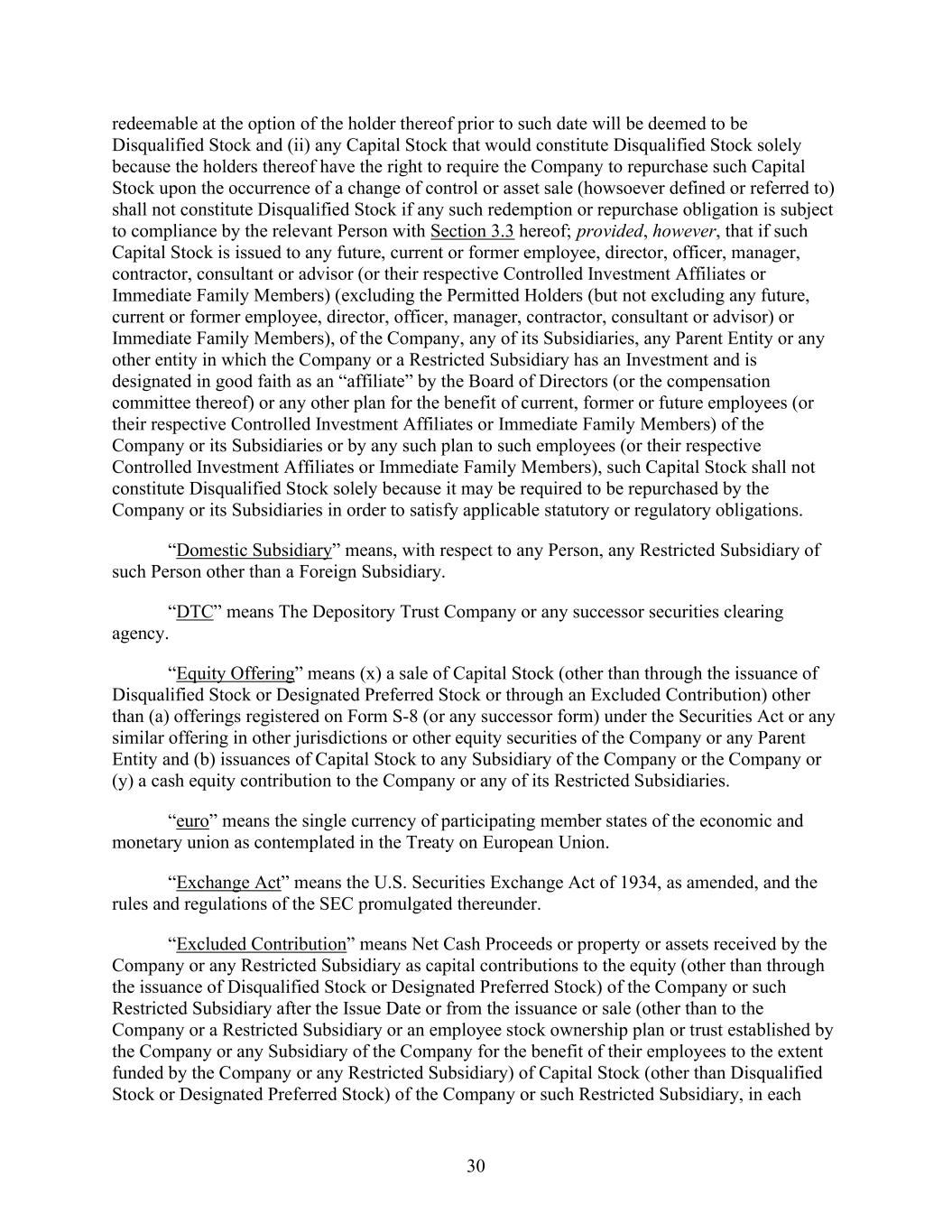
30 redeemable at the option of the holder thereof prior to such date will be deemed to be Disqualified Stock and (ii) any Capital Stock that would constitute Disqualified Stock solely because the holders thereof have the right to require the Company to repurchase such Capital Stock upon the occurrence of a change of control or asset sale (howsoever defined or referred to) shall not constitute Disqualified Stock if any such redemption or repurchase obligation is subject to compliance by the relevant Person with Section 3.3 hereof; provided, however, that if such Capital Stock is issued to any future, current or former employee, director, officer, manager, contractor, consultant or advisor (or their respective Controlled Investment Affiliates or Immediate Family Members) (excluding the Permitted Holders (but not excluding any future, current or former employee, director, officer, manager, contractor, consultant or advisor) or Immediate Family Members), of the Company, any of its Subsidiaries, any Parent Entity or any other entity in which the Company or a Restricted Subsidiary has an Investment and is designated in good faith as an “affiliate” by the Board of Directors (or the compensation committee thereof) or any other plan for the benefit of current, former or future employees (or their respective Controlled Investment Affiliates or Immediate Family Members) of the Company or its Subsidiaries or by any such plan to such employees (or their respective Controlled Investment Affiliates or Immediate Family Members), such Capital Stock shall not constitute Disqualified Stock solely because it may be required to be repurchased by the Company or its Subsidiaries in order to satisfy applicable statutory or regulatory obligations. “Domestic Subsidiary” means, with respect to any Person, any Restricted Subsidiary of such Person other than a Foreign Subsidiary. “DTC” means The Depository Trust Company or any successor securities clearing agency. “Equity Offering” means (x) a sale of Capital Stock (other than through the issuance of Disqualified Stock or Designated Preferred Stock or through an Excluded Contribution) other than (a) offerings registered on Form S-8 (or any successor form) under the Securities Act or any similar offering in other jurisdictions or other equity securities of the Company or any Parent Entity and (b) issuances of Capital Stock to any Subsidiary of the Company or the Company or (y) a cash equity contribution to the Company or any of its Restricted Subsidiaries. “euro” means the single currency of participating member states of the economic and monetary union as contemplated in the Treaty on European Union. “Exchange Act” means the U.S. Securities Exchange Act of 1934, as amended, and the rules and regulations of the SEC promulgated thereunder. “Excluded Contribution” means Net Cash Proceeds or property or assets received by the Company or any Restricted Subsidiary as capital contributions to the equity (other than through the issuance of Disqualified Stock or Designated Preferred Stock) of the Company or such Restricted Subsidiary after the Issue Date or from the issuance or sale (other than to the Company or a Restricted Subsidiary or an employee stock ownership plan or trust established by the Company or any Subsidiary of the Company for the benefit of their employees to the extent funded by the Company or any Restricted Subsidiary) of Capital Stock (other than Disqualified Stock or Designated Preferred Stock) of the Company or such Restricted Subsidiary, in each
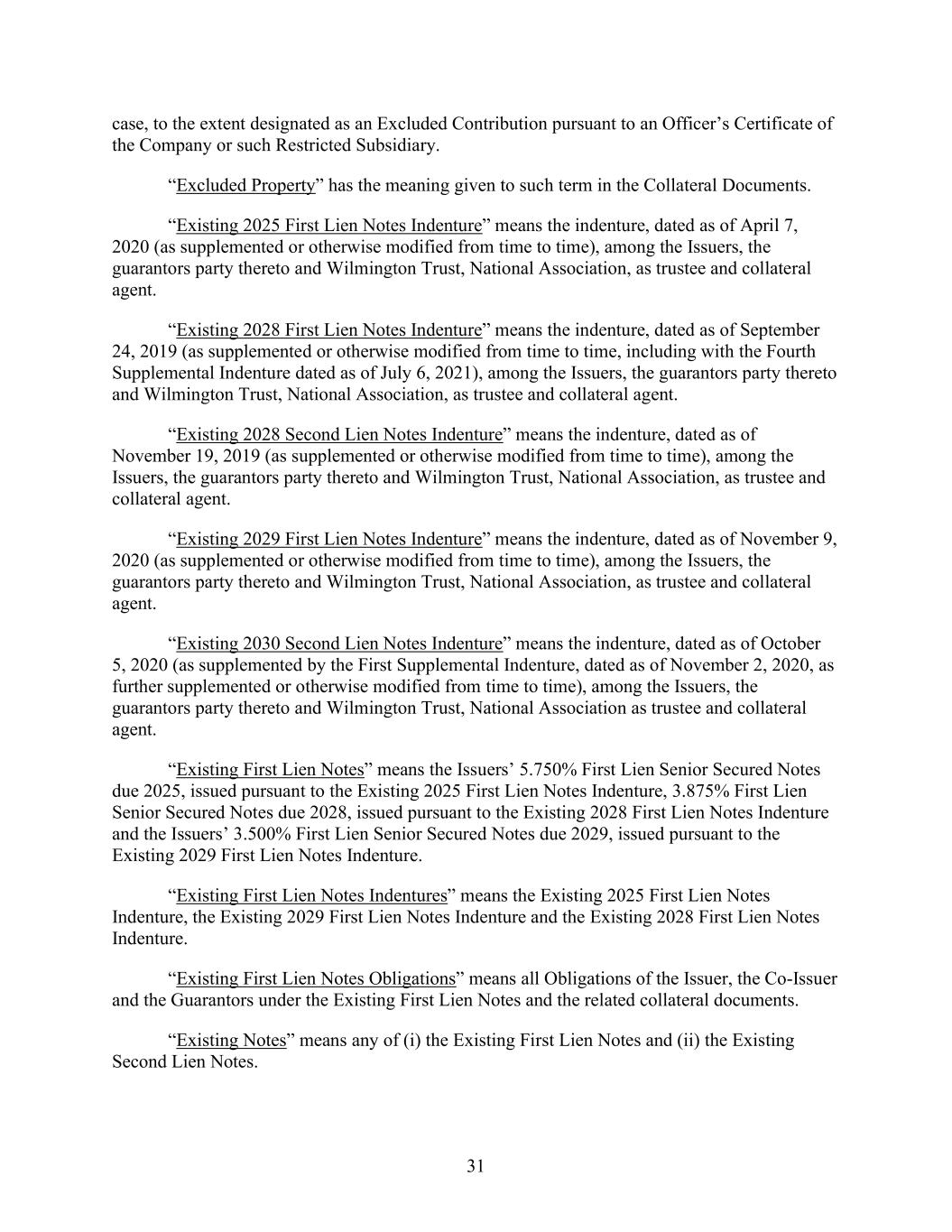
31 case, to the extent designated as an Excluded Contribution pursuant to an Officer’s Certificate of the Company or such Restricted Subsidiary. “Excluded Property” has the meaning given to such term in the Collateral Documents. “Existing 2025 First Lien Notes Indenture” means the indenture, dated as of April 7, 2020 (as supplemented or otherwise modified from time to time), among the Issuers, the guarantors party thereto and Wilmington Trust, National Association, as trustee and collateral agent. “Existing 2028 First Lien Notes Indenture” means the indenture, dated as of September 24, 2019 (as supplemented or otherwise modified from time to time, including with the Fourth Supplemental Indenture dated as of July 6, 2021), among the Issuers, the guarantors party thereto and Wilmington Trust, National Association, as trustee and collateral agent. “Existing 2028 Second Lien Notes Indenture” means the indenture, dated as of November 19, 2019 (as supplemented or otherwise modified from time to time), among the Issuers, the guarantors party thereto and Wilmington Trust, National Association, as trustee and collateral agent. “Existing 2029 First Lien Notes Indenture” means the indenture, dated as of November 9, 2020 (as supplemented or otherwise modified from time to time), among the Issuers, the guarantors party thereto and Wilmington Trust, National Association, as trustee and collateral agent. “Existing 2030 Second Lien Notes Indenture” means the indenture, dated as of October 5, 2020 (as supplemented by the First Supplemental Indenture, dated as of November 2, 2020, as further supplemented or otherwise modified from time to time), among the Issuers, the guarantors party thereto and Wilmington Trust, National Association as trustee and collateral agent. “Existing First Lien Notes” means the Issuers’ 5.750% First Lien Senior Secured Notes due 2025, issued pursuant to the Existing 2025 First Lien Notes Indenture, 3.875% First Lien Senior Secured Notes due 2028, issued pursuant to the Existing 2028 First Lien Notes Indenture and the Issuers’ 3.500% First Lien Senior Secured Notes due 2029, issued pursuant to the Existing 2029 First Lien Notes Indenture. “Existing First Lien Notes Indentures” means the Existing 2025 First Lien Notes Indenture, the Existing 2029 First Lien Notes Indenture and the Existing 2028 First Lien Notes Indenture. “Existing First Lien Notes Obligations” means all Obligations of the Issuer, the Co-Issuer and the Guarantors under the Existing First Lien Notes and the related collateral documents. “Existing Notes” means any of (i) the Existing First Lien Notes and (ii) the Existing Second Lien Notes.
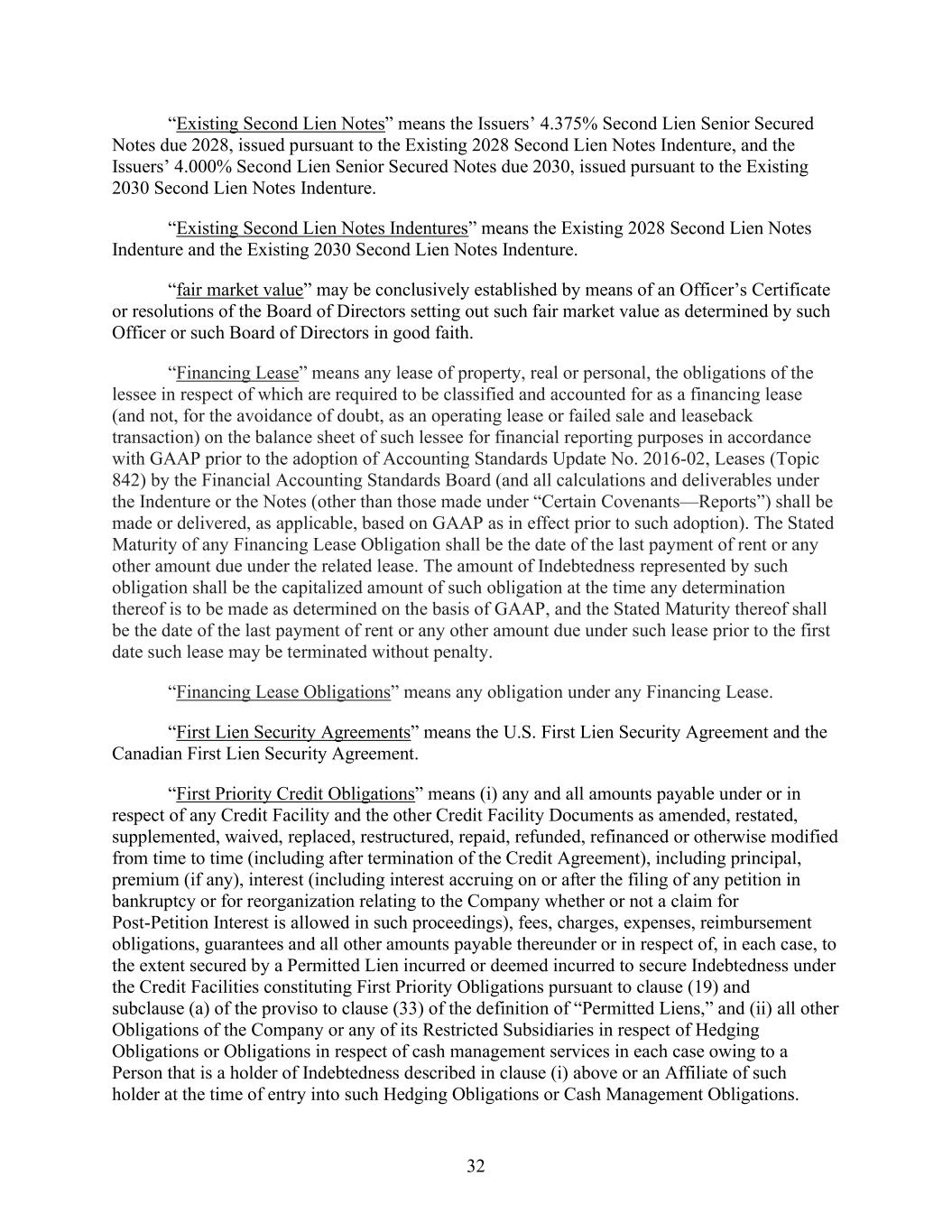
32 “Existing Second Lien Notes” means the Issuers’ 4.375% Second Lien Senior Secured Notes due 2028, issued pursuant to the Existing 2028 Second Lien Notes Indenture, and the Issuers’ 4.000% Second Lien Senior Secured Notes due 2030, issued pursuant to the Existing 2030 Second Lien Notes Indenture. “Existing Second Lien Notes Indentures” means the Existing 2028 Second Lien Notes Indenture and the Existing 2030 Second Lien Notes Indenture. “fair market value” may be conclusively established by means of an Officer’s Certificate or resolutions of the Board of Directors setting out such fair market value as determined by such Officer or such Board of Directors in good faith. “Financing Lease” means any lease of property, real or personal, the obligations of the lessee in respect of which are required to be classified and accounted for as a financing lease (and not, for the avoidance of doubt, as an operating lease or failed sale and leaseback transaction) on the balance sheet of such lessee for financial reporting purposes in accordance with GAAP prior to the adoption of Accounting Standards Update No. 2016-02, Leases (Topic 842) by the Financial Accounting Standards Board (and all calculations and deliverables under the Indenture or the Notes (other than those made under “Certain Covenants—Reports”) shall be made or delivered, as applicable, based on GAAP as in effect prior to such adoption). The Stated Maturity of any Financing Lease Obligation shall be the date of the last payment of rent or any other amount due under the related lease. The amount of Indebtedness represented by such obligation shall be the capitalized amount of such obligation at the time any determination thereof is to be made as determined on the basis of GAAP, and the Stated Maturity thereof shall be the date of the last payment of rent or any other amount due under such lease prior to the first date such lease may be terminated without penalty. “Financing Lease Obligations” means any obligation under any Financing Lease. “First Lien Security Agreements” means the U.S. First Lien Security Agreement and the Canadian First Lien Security Agreement. “First Priority Credit Obligations” means (i) any and all amounts payable under or in respect of any Credit Facility and the other Credit Facility Documents as amended, restated, supplemented, waived, replaced, restructured, repaid, refunded, refinanced or otherwise modified from time to time (including after termination of the Credit Agreement), including principal, premium (if any), interest (including interest accruing on or after the filing of any petition in bankruptcy or for reorganization relating to the Company whether or not a claim for Post-Petition Interest is allowed in such proceedings), fees, charges, expenses, reimbursement obligations, guarantees and all other amounts payable thereunder or in respect of, in each case, to the extent secured by a Permitted Lien incurred or deemed incurred to secure Indebtedness under the Credit Facilities constituting First Priority Obligations pursuant to clause (19) and subclause (a) of the proviso to clause (33) of the definition of “Permitted Liens,” and (ii) all other Obligations of the Company or any of its Restricted Subsidiaries in respect of Hedging Obligations or Obligations in respect of cash management services in each case owing to a Person that is a holder of Indebtedness described in clause (i) above or an Affiliate of such holder at the time of entry into such Hedging Obligations or Cash Management Obligations.
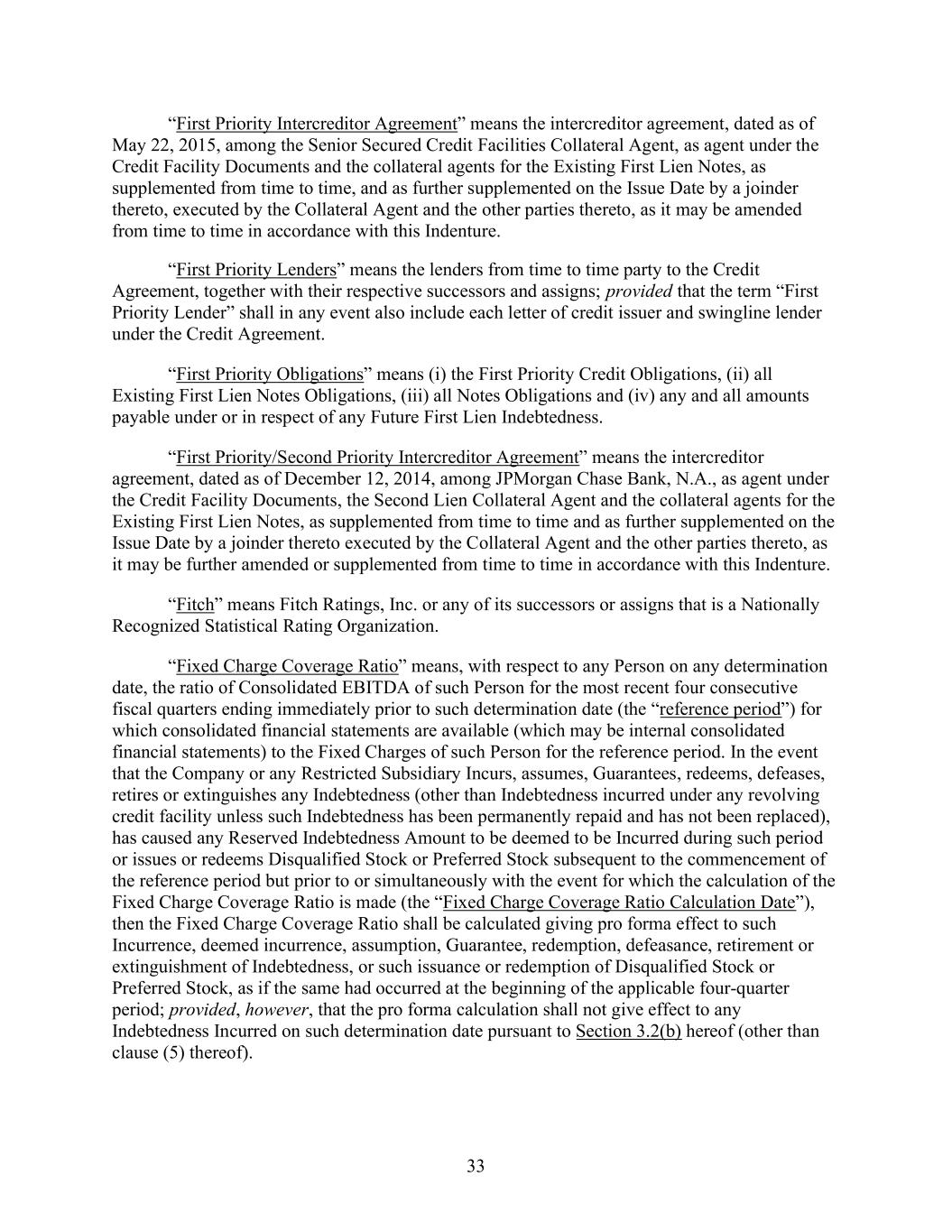
33 “First Priority Intercreditor Agreement” means the intercreditor agreement, dated as of May 22, 2015, among the Senior Secured Credit Facilities Collateral Agent, as agent under the Credit Facility Documents and the collateral agents for the Existing First Lien Notes, as supplemented from time to time, and as further supplemented on the Issue Date by a joinder thereto, executed by the Collateral Agent and the other parties thereto, as it may be amended from time to time in accordance with this Indenture. “First Priority Lenders” means the lenders from time to time party to the Credit Agreement, together with their respective successors and assigns; provided that the term “First Priority Lender” shall in any event also include each letter of credit issuer and swingline lender under the Credit Agreement. “First Priority Obligations” means (i) the First Priority Credit Obligations, (ii) all Existing First Lien Notes Obligations, (iii) all Notes Obligations and (iv) any and all amounts payable under or in respect of any Future First Lien Indebtedness. “First Priority/Second Priority Intercreditor Agreement” means the intercreditor agreement, dated as of December 12, 2014, among JPMorgan Chase Bank, N.A., as agent under the Credit Facility Documents, the Second Lien Collateral Agent and the collateral agents for the Existing First Lien Notes, as supplemented from time to time and as further supplemented on the Issue Date by a joinder thereto executed by the Collateral Agent and the other parties thereto, as it may be further amended or supplemented from time to time in accordance with this Indenture. “Fitch” means Fitch Ratings, Inc. or any of its successors or assigns that is a Nationally Recognized Statistical Rating Organization. “Fixed Charge Coverage Ratio” means, with respect to any Person on any determination date, the ratio of Consolidated EBITDA of such Person for the most recent four consecutive fiscal quarters ending immediately prior to such determination date (the “reference period”) for which consolidated financial statements are available (which may be internal consolidated financial statements) to the Fixed Charges of such Person for the reference period. In the event that the Company or any Restricted Subsidiary Incurs, assumes, Guarantees, redeems, defeases, retires or extinguishes any Indebtedness (other than Indebtedness incurred under any revolving credit facility unless such Indebtedness has been permanently repaid and has not been replaced), has caused any Reserved Indebtedness Amount to be deemed to be Incurred during such period or issues or redeems Disqualified Stock or Preferred Stock subsequent to the commencement of the reference period but prior to or simultaneously with the event for which the calculation of the Fixed Charge Coverage Ratio is made (the “Fixed Charge Coverage Ratio Calculation Date”), then the Fixed Charge Coverage Ratio shall be calculated giving pro forma effect to such Incurrence, deemed incurrence, assumption, Guarantee, redemption, defeasance, retirement or extinguishment of Indebtedness, or such issuance or redemption of Disqualified Stock or Preferred Stock, as if the same had occurred at the beginning of the applicable four-quarter period; provided, however, that the pro forma calculation shall not give effect to any Indebtedness Incurred on such determination date pursuant to Section 3.2(b) hereof (other than clause (5) thereof).
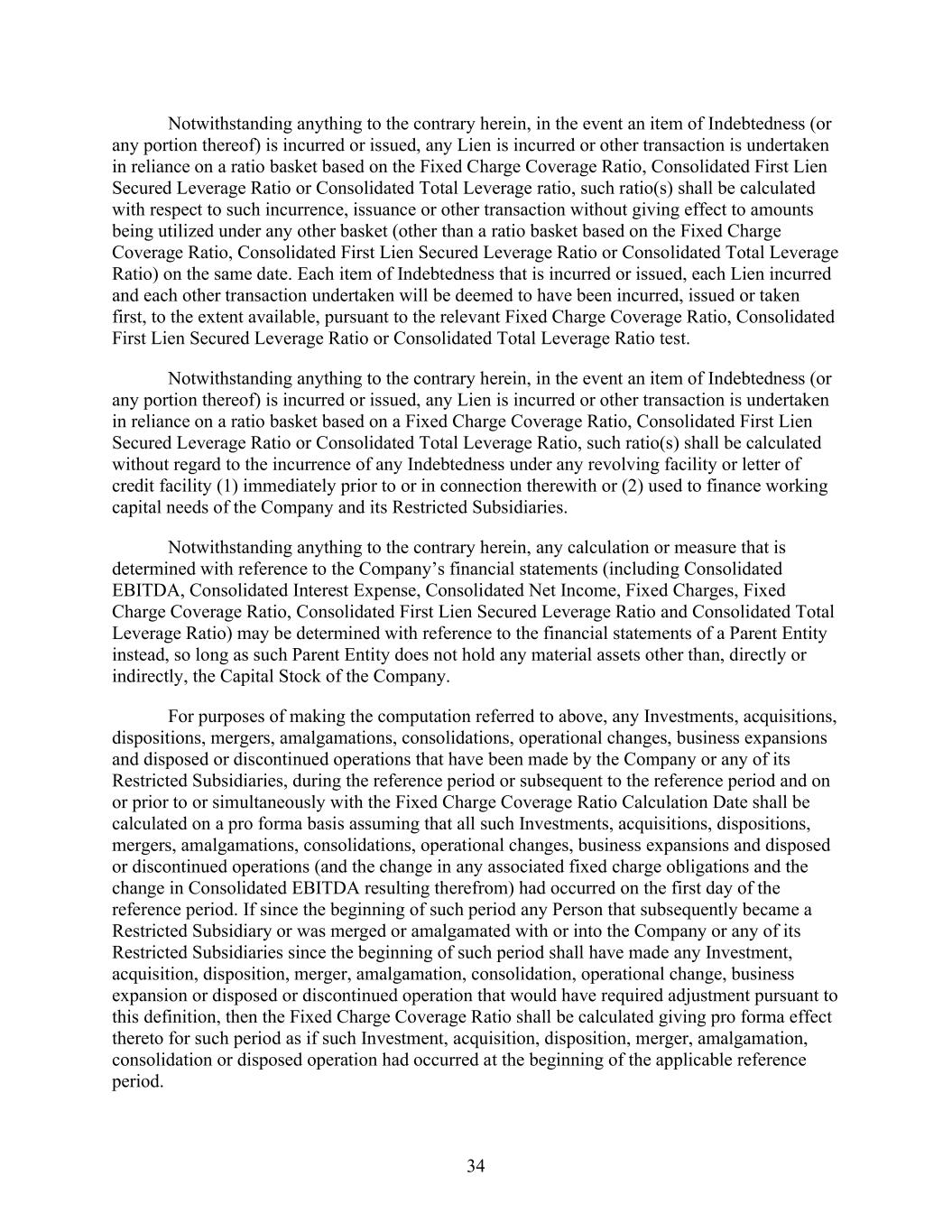
34 Notwithstanding anything to the contrary herein, in the event an item of Indebtedness (or any portion thereof) is incurred or issued, any Lien is incurred or other transaction is undertaken in reliance on a ratio basket based on the Fixed Charge Coverage Ratio, Consolidated First Lien Secured Leverage Ratio or Consolidated Total Leverage ratio, such ratio(s) shall be calculated with respect to such incurrence, issuance or other transaction without giving effect to amounts being utilized under any other basket (other than a ratio basket based on the Fixed Charge Coverage Ratio, Consolidated First Lien Secured Leverage Ratio or Consolidated Total Leverage Ratio) on the same date. Each item of Indebtedness that is incurred or issued, each Lien incurred and each other transaction undertaken will be deemed to have been incurred, issued or taken first, to the extent available, pursuant to the relevant Fixed Charge Coverage Ratio, Consolidated First Lien Secured Leverage Ratio or Consolidated Total Leverage Ratio test. Notwithstanding anything to the contrary herein, in the event an item of Indebtedness (or any portion thereof) is incurred or issued, any Lien is incurred or other transaction is undertaken in reliance on a ratio basket based on a Fixed Charge Coverage Ratio, Consolidated First Lien Secured Leverage Ratio or Consolidated Total Leverage Ratio, such ratio(s) shall be calculated without regard to the incurrence of any Indebtedness under any revolving facility or letter of credit facility (1) immediately prior to or in connection therewith or (2) used to finance working capital needs of the Company and its Restricted Subsidiaries. Notwithstanding anything to the contrary herein, any calculation or measure that is determined with reference to the Company’s financial statements (including Consolidated EBITDA, Consolidated Interest Expense, Consolidated Net Income, Fixed Charges, Fixed Charge Coverage Ratio, Consolidated First Lien Secured Leverage Ratio and Consolidated Total Leverage Ratio) may be determined with reference to the financial statements of a Parent Entity instead, so long as such Parent Entity does not hold any material assets other than, directly or indirectly, the Capital Stock of the Company. For purposes of making the computation referred to above, any Investments, acquisitions, dispositions, mergers, amalgamations, consolidations, operational changes, business expansions and disposed or discontinued operations that have been made by the Company or any of its Restricted Subsidiaries, during the reference period or subsequent to the reference period and on or prior to or simultaneously with the Fixed Charge Coverage Ratio Calculation Date shall be calculated on a pro forma basis assuming that all such Investments, acquisitions, dispositions, mergers, amalgamations, consolidations, operational changes, business expansions and disposed or discontinued operations (and the change in any associated fixed charge obligations and the change in Consolidated EBITDA resulting therefrom) had occurred on the first day of the reference period. If since the beginning of such period any Person that subsequently became a Restricted Subsidiary or was merged or amalgamated with or into the Company or any of its Restricted Subsidiaries since the beginning of such period shall have made any Investment, acquisition, disposition, merger, amalgamation, consolidation, operational change, business expansion or disposed or discontinued operation that would have required adjustment pursuant to this definition, then the Fixed Charge Coverage Ratio shall be calculated giving pro forma effect thereto for such period as if such Investment, acquisition, disposition, merger, amalgamation, consolidation or disposed operation had occurred at the beginning of the applicable reference period.
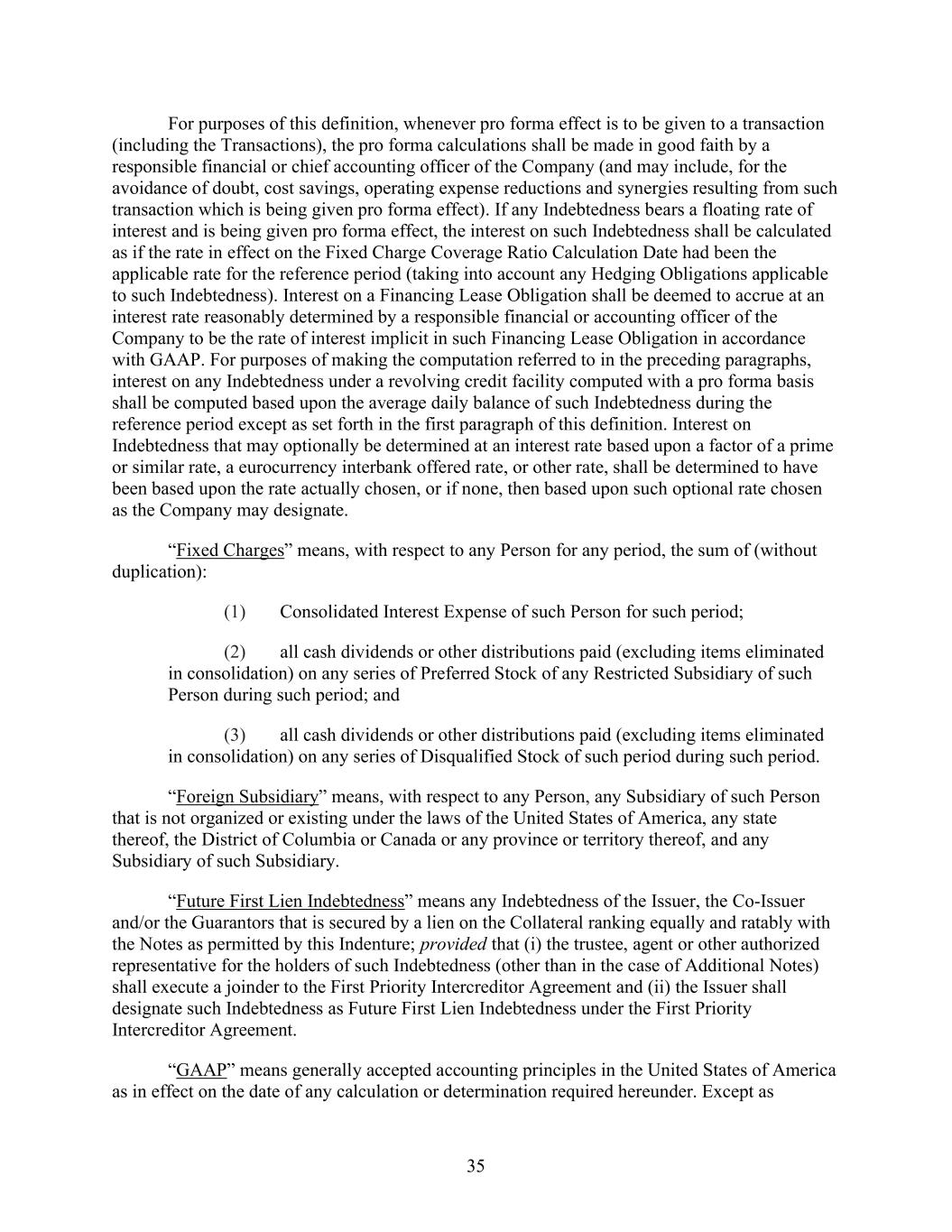
35 For purposes of this definition, whenever pro forma effect is to be given to a transaction (including the Transactions), the pro forma calculations shall be made in good faith by a responsible financial or chief accounting officer of the Company (and may include, for the avoidance of doubt, cost savings, operating expense reductions and synergies resulting from such transaction which is being given pro forma effect). If any Indebtedness bears a floating rate of interest and is being given pro forma effect, the interest on such Indebtedness shall be calculated as if the rate in effect on the Fixed Charge Coverage Ratio Calculation Date had been the applicable rate for the reference period (taking into account any Hedging Obligations applicable to such Indebtedness). Interest on a Financing Lease Obligation shall be deemed to accrue at an interest rate reasonably determined by a responsible financial or accounting officer of the Company to be the rate of interest implicit in such Financing Lease Obligation in accordance with GAAP. For purposes of making the computation referred to in the preceding paragraphs, interest on any Indebtedness under a revolving credit facility computed with a pro forma basis shall be computed based upon the average daily balance of such Indebtedness during the reference period except as set forth in the first paragraph of this definition. Interest on Indebtedness that may optionally be determined at an interest rate based upon a factor of a prime or similar rate, a eurocurrency interbank offered rate, or other rate, shall be determined to have been based upon the rate actually chosen, or if none, then based upon such optional rate chosen as the Company may designate. “Fixed Charges” means, with respect to any Person for any period, the sum of (without duplication): (1) Consolidated Interest Expense of such Person for such period; (2) all cash dividends or other distributions paid (excluding items eliminated in consolidation) on any series of Preferred Stock of any Restricted Subsidiary of such Person during such period; and (3) all cash dividends or other distributions paid (excluding items eliminated in consolidation) on any series of Disqualified Stock of such period during such period. “Foreign Subsidiary” means, with respect to any Person, any Subsidiary of such Person that is not organized or existing under the laws of the United States of America, any state thereof, the District of Columbia or Canada or any province or territory thereof, and any Subsidiary of such Subsidiary. “Future First Lien Indebtedness” means any Indebtedness of the Issuer, the Co-Issuer and/or the Guarantors that is secured by a lien on the Collateral ranking equally and ratably with the Notes as permitted by this Indenture; provided that (i) the trustee, agent or other authorized representative for the holders of such Indebtedness (other than in the case of Additional Notes) shall execute a joinder to the First Priority Intercreditor Agreement and (ii) the Issuer shall designate such Indebtedness as Future First Lien Indebtedness under the First Priority Intercreditor Agreement. “GAAP” means generally accepted accounting principles in the United States of America as in effect on the date of any calculation or determination required hereunder. Except as
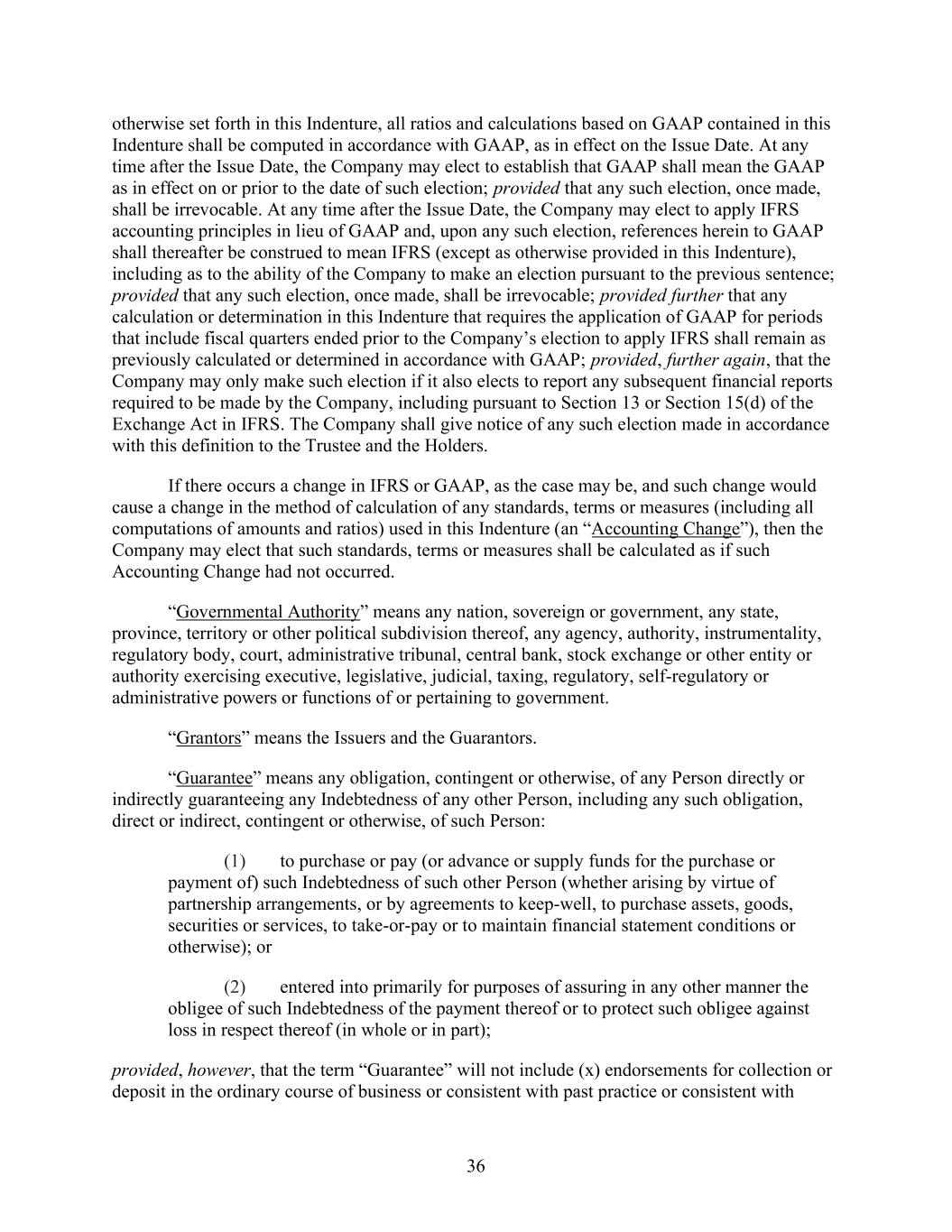
36 otherwise set forth in this Indenture, all ratios and calculations based on GAAP contained in this Indenture shall be computed in accordance with GAAP, as in effect on the Issue Date. At any time after the Issue Date, the Company may elect to establish that GAAP shall mean the GAAP as in effect on or prior to the date of such election; provided that any such election, once made, shall be irrevocable. At any time after the Issue Date, the Company may elect to apply IFRS accounting principles in lieu of GAAP and, upon any such election, references herein to GAAP shall thereafter be construed to mean IFRS (except as otherwise provided in this Indenture), including as to the ability of the Company to make an election pursuant to the previous sentence; provided that any such election, once made, shall be irrevocable; provided further that any calculation or determination in this Indenture that requires the application of GAAP for periods that include fiscal quarters ended prior to the Company’s election to apply IFRS shall remain as previously calculated or determined in accordance with GAAP; provided, further again, that the Company may only make such election if it also elects to report any subsequent financial reports required to be made by the Company, including pursuant to Section 13 or Section 15(d) of the Exchange Act in IFRS. The Company shall give notice of any such election made in accordance with this definition to the Trustee and the Holders. If there occurs a change in IFRS or GAAP, as the case may be, and such change would cause a change in the method of calculation of any standards, terms or measures (including all computations of amounts and ratios) used in this Indenture (an “Accounting Change”), then the Company may elect that such standards, terms or measures shall be calculated as if such Accounting Change had not occurred. “Governmental Authority” means any nation, sovereign or government, any state, province, territory or other political subdivision thereof, any agency, authority, instrumentality, regulatory body, court, administrative tribunal, central bank, stock exchange or other entity or authority exercising executive, legislative, judicial, taxing, regulatory, self-regulatory or administrative powers or functions of or pertaining to government. “Grantors” means the Issuers and the Guarantors. “Guarantee” means any obligation, contingent or otherwise, of any Person directly or indirectly guaranteeing any Indebtedness of any other Person, including any such obligation, direct or indirect, contingent or otherwise, of such Person: (1) to purchase or pay (or advance or supply funds for the purchase or payment of) such Indebtedness of such other Person (whether arising by virtue of partnership arrangements, or by agreements to keep-well, to purchase assets, goods, securities or services, to take-or-pay or to maintain financial statement conditions or otherwise); or (2) entered into primarily for purposes of assuring in any other manner the obligee of such Indebtedness of the payment thereof or to protect such obligee against loss in respect thereof (in whole or in part); provided, however, that the term “Guarantee” will not include (x) endorsements for collection or deposit in the ordinary course of business or consistent with past practice or consistent with
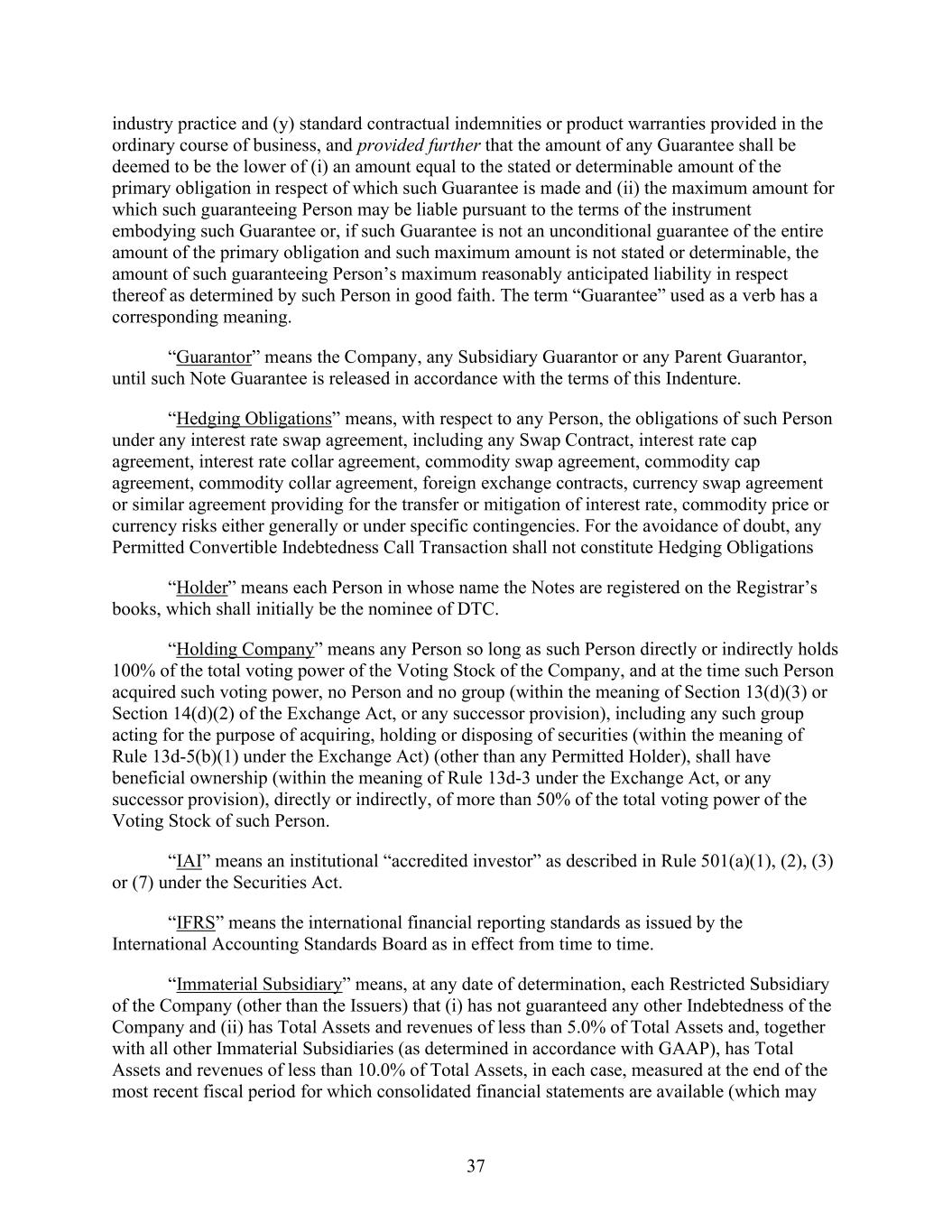
37 industry practice and (y) standard contractual indemnities or product warranties provided in the ordinary course of business, and provided further that the amount of any Guarantee shall be deemed to be the lower of (i) an amount equal to the stated or determinable amount of the primary obligation in respect of which such Guarantee is made and (ii) the maximum amount for which such guaranteeing Person may be liable pursuant to the terms of the instrument embodying such Guarantee or, if such Guarantee is not an unconditional guarantee of the entire amount of the primary obligation and such maximum amount is not stated or determinable, the amount of such guaranteeing Person’s maximum reasonably anticipated liability in respect thereof as determined by such Person in good faith. The term “Guarantee” used as a verb has a corresponding meaning. “Guarantor” means the Company, any Subsidiary Guarantor or any Parent Guarantor, until such Note Guarantee is released in accordance with the terms of this Indenture. “Hedging Obligations” means, with respect to any Person, the obligations of such Person under any interest rate swap agreement, including any Swap Contract, interest rate cap agreement, interest rate collar agreement, commodity swap agreement, commodity cap agreement, commodity collar agreement, foreign exchange contracts, currency swap agreement or similar agreement providing for the transfer or mitigation of interest rate, commodity price or currency risks either generally or under specific contingencies. For the avoidance of doubt, any Permitted Convertible Indebtedness Call Transaction shall not constitute Hedging Obligations “Holder” means each Person in whose name the Notes are registered on the Registrar’s books, which shall initially be the nominee of DTC. “Holding Company” means any Person so long as such Person directly or indirectly holds 100% of the total voting power of the Voting Stock of the Company, and at the time such Person acquired such voting power, no Person and no group (within the meaning of Section 13(d)(3) or Section 14(d)(2) of the Exchange Act, or any successor provision), including any such group acting for the purpose of acquiring, holding or disposing of securities (within the meaning of Rule 13d-5(b)(1) under the Exchange Act) (other than any Permitted Holder), shall have beneficial ownership (within the meaning of Rule 13d-3 under the Exchange Act, or any successor provision), directly or indirectly, of more than 50% of the total voting power of the Voting Stock of such Person. “IAI” means an institutional “accredited investor” as described in Rule 501(a)(1), (2), (3) or (7) under the Securities Act. “IFRS” means the international financial reporting standards as issued by the International Accounting Standards Board as in effect from time to time. “Immaterial Subsidiary” means, at any date of determination, each Restricted Subsidiary of the Company (other than the Issuers) that (i) has not guaranteed any other Indebtedness of the Company and (ii) has Total Assets and revenues of less than 5.0% of Total Assets and, together with all other Immaterial Subsidiaries (as determined in accordance with GAAP), has Total Assets and revenues of less than 10.0% of Total Assets, in each case, measured at the end of the most recent fiscal period for which consolidated financial statements are available (which may
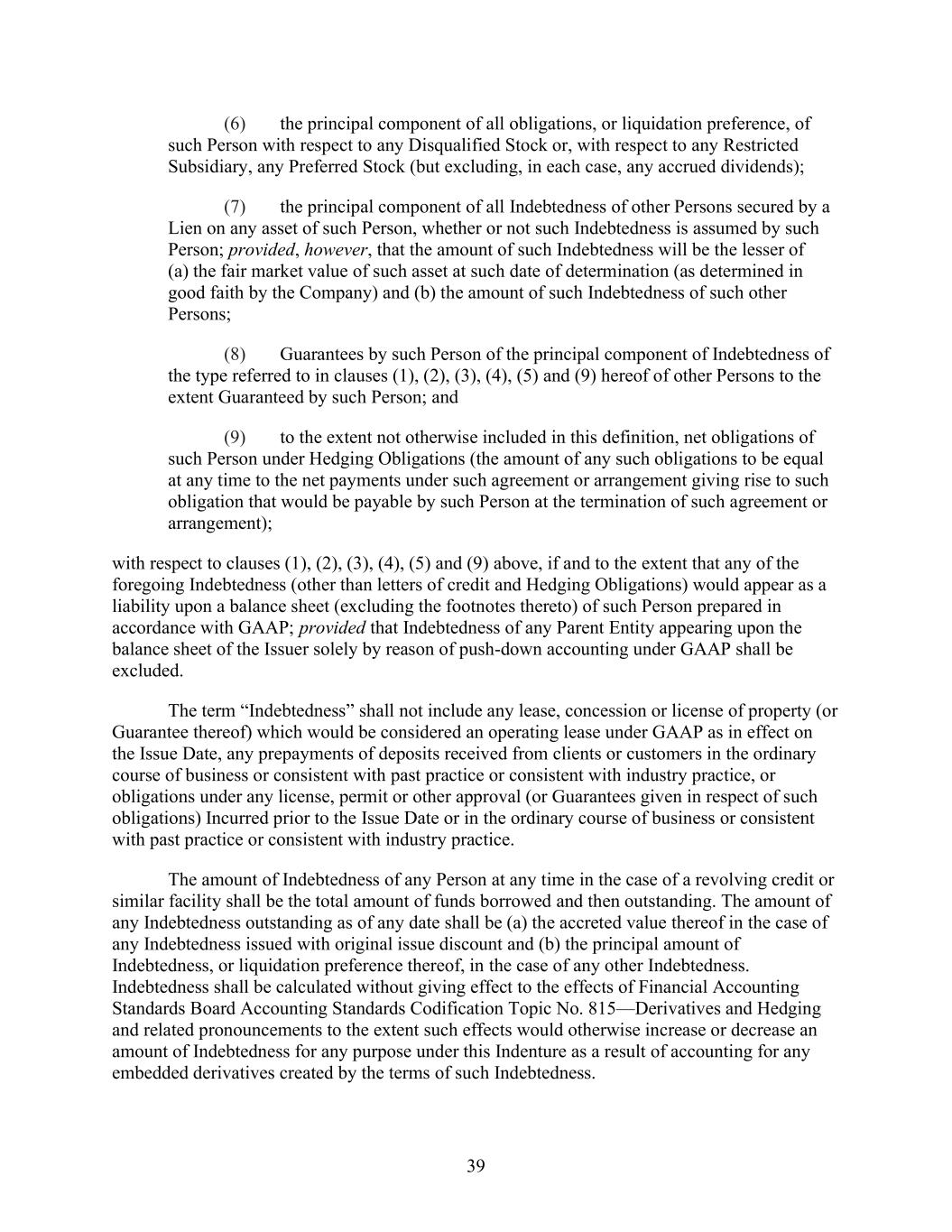
39 (6) the principal component of all obligations, or liquidation preference, of such Person with respect to any Disqualified Stock or, with respect to any Restricted Subsidiary, any Preferred Stock (but excluding, in each case, any accrued dividends); (7) the principal component of all Indebtedness of other Persons secured by a Lien on any asset of such Person, whether or not such Indebtedness is assumed by such Person; provided, however, that the amount of such Indebtedness will be the lesser of (a) the fair market value of such asset at such date of determination (as determined in good faith by the Company) and (b) the amount of such Indebtedness of such other Persons; (8) Guarantees by such Person of the principal component of Indebtedness of the type referred to in clauses (1), (2), (3), (4), (5) and (9) hereof of other Persons to the extent Guaranteed by such Person; and (9) to the extent not otherwise included in this definition, net obligations of such Person under Hedging Obligations (the amount of any such obligations to be equal at any time to the net payments under such agreement or arrangement giving rise to such obligation that would be payable by such Person at the termination of such agreement or arrangement); with respect to clauses (1), (2), (3), (4), (5) and (9) above, if and to the extent that any of the foregoing Indebtedness (other than letters of credit and Hedging Obligations) would appear as a liability upon a balance sheet (excluding the footnotes thereto) of such Person prepared in accordance with GAAP; provided that Indebtedness of any Parent Entity appearing upon the balance sheet of the Issuer solely by reason of push-down accounting under GAAP shall be excluded. The term “Indebtedness” shall not include any lease, concession or license of property (or Guarantee thereof) which would be considered an operating lease under GAAP as in effect on the Issue Date, any prepayments of deposits received from clients or customers in the ordinary course of business or consistent with past practice or consistent with industry practice, or obligations under any license, permit or other approval (or Guarantees given in respect of such obligations) Incurred prior to the Issue Date or in the ordinary course of business or consistent with past practice or consistent with industry practice. The amount of Indebtedness of any Person at any time in the case of a revolving credit or similar facility shall be the total amount of funds borrowed and then outstanding. The amount of any Indebtedness outstanding as of any date shall be (a) the accreted value thereof in the case of any Indebtedness issued with original issue discount and (b) the principal amount of Indebtedness, or liquidation preference thereof, in the case of any other Indebtedness. Indebtedness shall be calculated without giving effect to the effects of Financial Accounting Standards Board Accounting Standards Codification Topic No. 815—Derivatives and Hedging and related pronouncements to the extent such effects would otherwise increase or decrease an amount of Indebtedness for any purpose under this Indenture as a result of accounting for any embedded derivatives created by the terms of such Indebtedness.
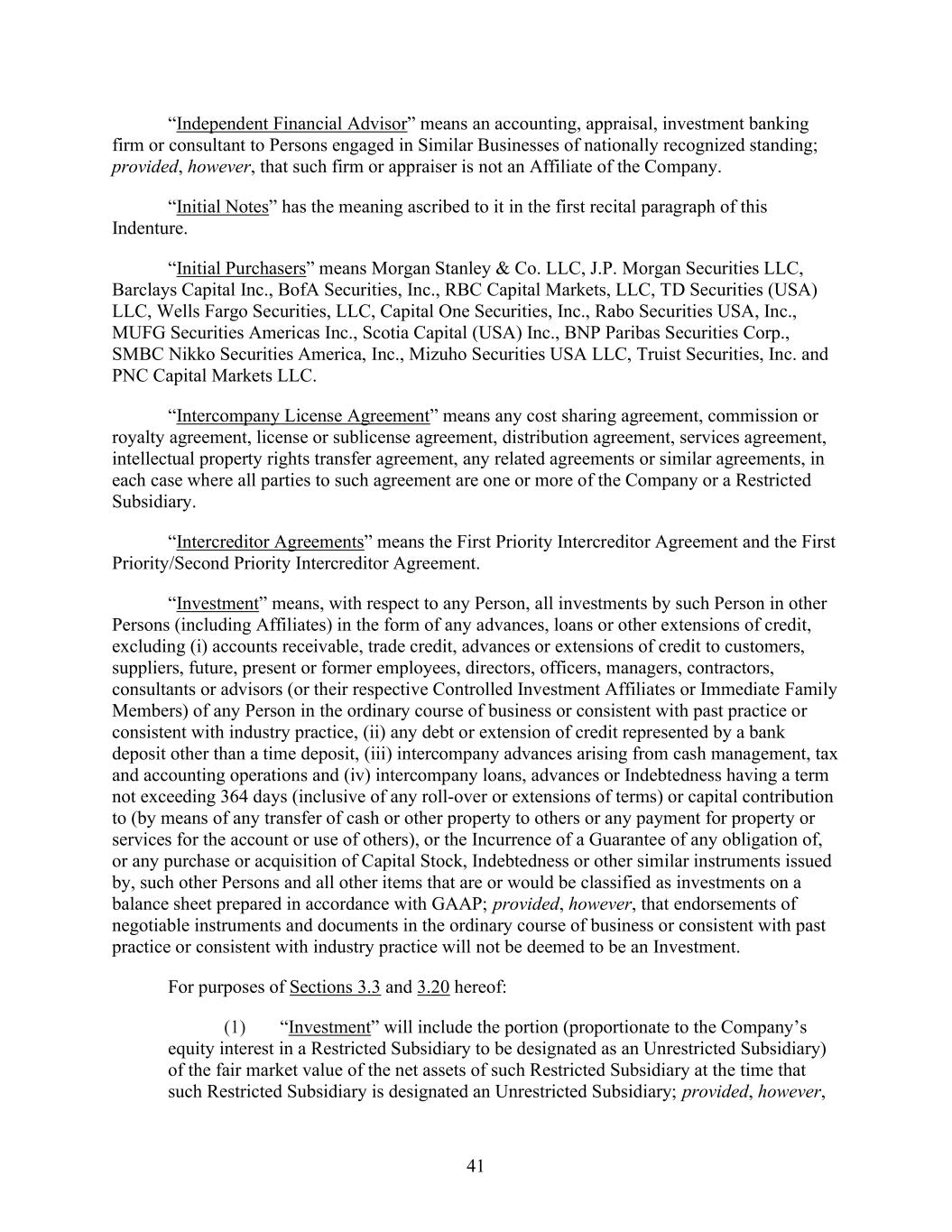
41 “Independent Financial Advisor” means an accounting, appraisal, investment banking firm or consultant to Persons engaged in Similar Businesses of nationally recognized standing; provided, however, that such firm or appraiser is not an Affiliate of the Company. “Initial Notes” has the meaning ascribed to it in the first recital paragraph of this Indenture. “Initial Purchasers” means Xxxxxx Xxxxxxx & Co. LLC, X.X. Xxxxxx Securities LLC, Barclays Capital Inc., BofA Securities, Inc., RBC Capital Markets, LLC, TD Securities (USA) LLC, Xxxxx Fargo Securities, LLC, Capital One Securities, Inc., Rabo Securities USA, Inc., MUFG Securities Americas Inc., Scotia Capital (USA) Inc., BNP Paribas Securities Corp., SMBC Nikko Securities America, Inc., Mizuho Securities USA LLC, Truist Securities, Inc. and PNC Capital Markets LLC. “Intercompany License Agreement” means any cost sharing agreement, commission or royalty agreement, license or sublicense agreement, distribution agreement, services agreement, intellectual property rights transfer agreement, any related agreements or similar agreements, in each case where all parties to such agreement are one or more of the Company or a Restricted Subsidiary. “Intercreditor Agreements” means the First Priority Intercreditor Agreement and the First Priority/Second Priority Intercreditor Agreement. “Investment” means, with respect to any Person, all investments by such Person in other Persons (including Affiliates) in the form of any advances, loans or other extensions of credit, excluding (i) accounts receivable, trade credit, advances or extensions of credit to customers, suppliers, future, present or former employees, directors, officers, managers, contractors, consultants or advisors (or their respective Controlled Investment Affiliates or Immediate Family Members) of any Person in the ordinary course of business or consistent with past practice or consistent with industry practice, (ii) any debt or extension of credit represented by a bank deposit other than a time deposit, (iii) intercompany advances arising from cash management, tax and accounting operations and (iv) intercompany loans, advances or Indebtedness having a term not exceeding 364 days (inclusive of any roll-over or extensions of terms) or capital contribution to (by means of any transfer of cash or other property to others or any payment for property or services for the account or use of others), or the Incurrence of a Guarantee of any obligation of, or any purchase or acquisition of Capital Stock, Indebtedness or other similar instruments issued by, such other Persons and all other items that are or would be classified as investments on a balance sheet prepared in accordance with GAAP; provided, however, that endorsements of negotiable instruments and documents in the ordinary course of business or consistent with past practice or consistent with industry practice will not be deemed to be an Investment. For purposes of Sections 3.3 and 3.20 hereof: (1) “Investment” will include the portion (proportionate to the Company’s equity interest in a Restricted Subsidiary to be designated as an Unrestricted Subsidiary) of the fair market value of the net assets of such Restricted Subsidiary at the time that such Restricted Subsidiary is designated an Unrestricted Subsidiary; provided, however,
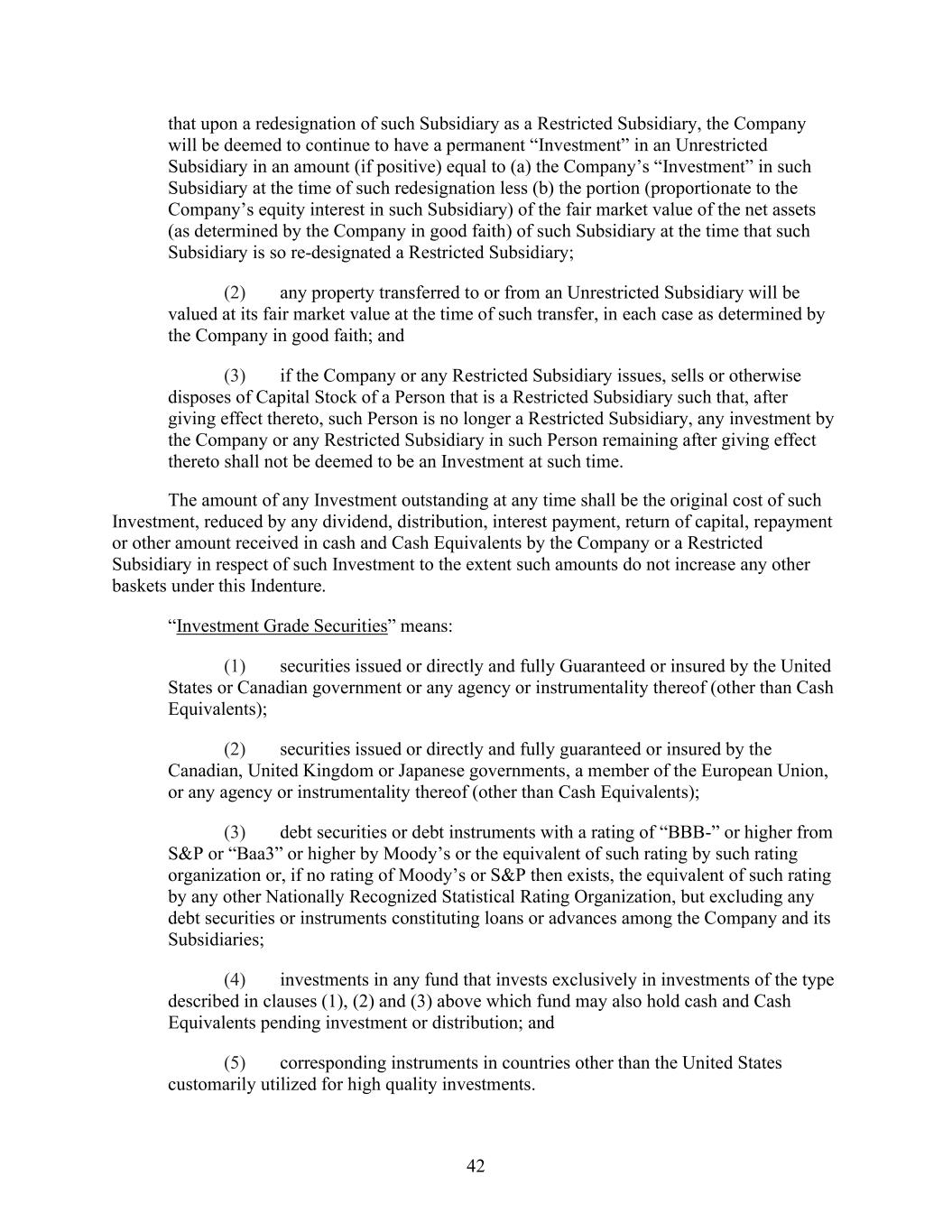
42 that upon a redesignation of such Subsidiary as a Restricted Subsidiary, the Company will be deemed to continue to have a permanent “Investment” in an Unrestricted Subsidiary in an amount (if positive) equal to (a) the Company’s “Investment” in such Subsidiary at the time of such redesignation less (b) the portion (proportionate to the Company’s equity interest in such Subsidiary) of the fair market value of the net assets (as determined by the Company in good faith) of such Subsidiary at the time that such Subsidiary is so re-designated a Restricted Subsidiary; (2) any property transferred to or from an Unrestricted Subsidiary will be valued at its fair market value at the time of such transfer, in each case as determined by the Company in good faith; and (3) if the Company or any Restricted Subsidiary issues, sells or otherwise disposes of Capital Stock of a Person that is a Restricted Subsidiary such that, after giving effect thereto, such Person is no longer a Restricted Subsidiary, any investment by the Company or any Restricted Subsidiary in such Person remaining after giving effect thereto shall not be deemed to be an Investment at such time. The amount of any Investment outstanding at any time shall be the original cost of such Investment, reduced by any dividend, distribution, interest payment, return of capital, repayment or other amount received in cash and Cash Equivalents by the Company or a Restricted Subsidiary in respect of such Investment to the extent such amounts do not increase any other baskets under this Indenture. “Investment Grade Securities” means: (1) securities issued or directly and fully Guaranteed or insured by the United States or Canadian government or any agency or instrumentality thereof (other than Cash Equivalents); (2) securities issued or directly and fully guaranteed or insured by the Canadian, United Kingdom or Japanese governments, a member of the European Union, or any agency or instrumentality thereof (other than Cash Equivalents); (3) debt securities or debt instruments with a rating of “BBB-” or higher from S&P or “Baa3” or higher by Moody’s or the equivalent of such rating by such rating organization or, if no rating of Moody’s or S&P then exists, the equivalent of such rating by any other Nationally Recognized Statistical Rating Organization, but excluding any debt securities or instruments constituting loans or advances among the Company and its Subsidiaries; (4) investments in any fund that invests exclusively in investments of the type described in clauses (1), (2) and (3) above which fund may also hold cash and Cash Equivalents pending investment or distribution; and (5) corresponding instruments in countries other than the United States customarily utilized for high quality investments.
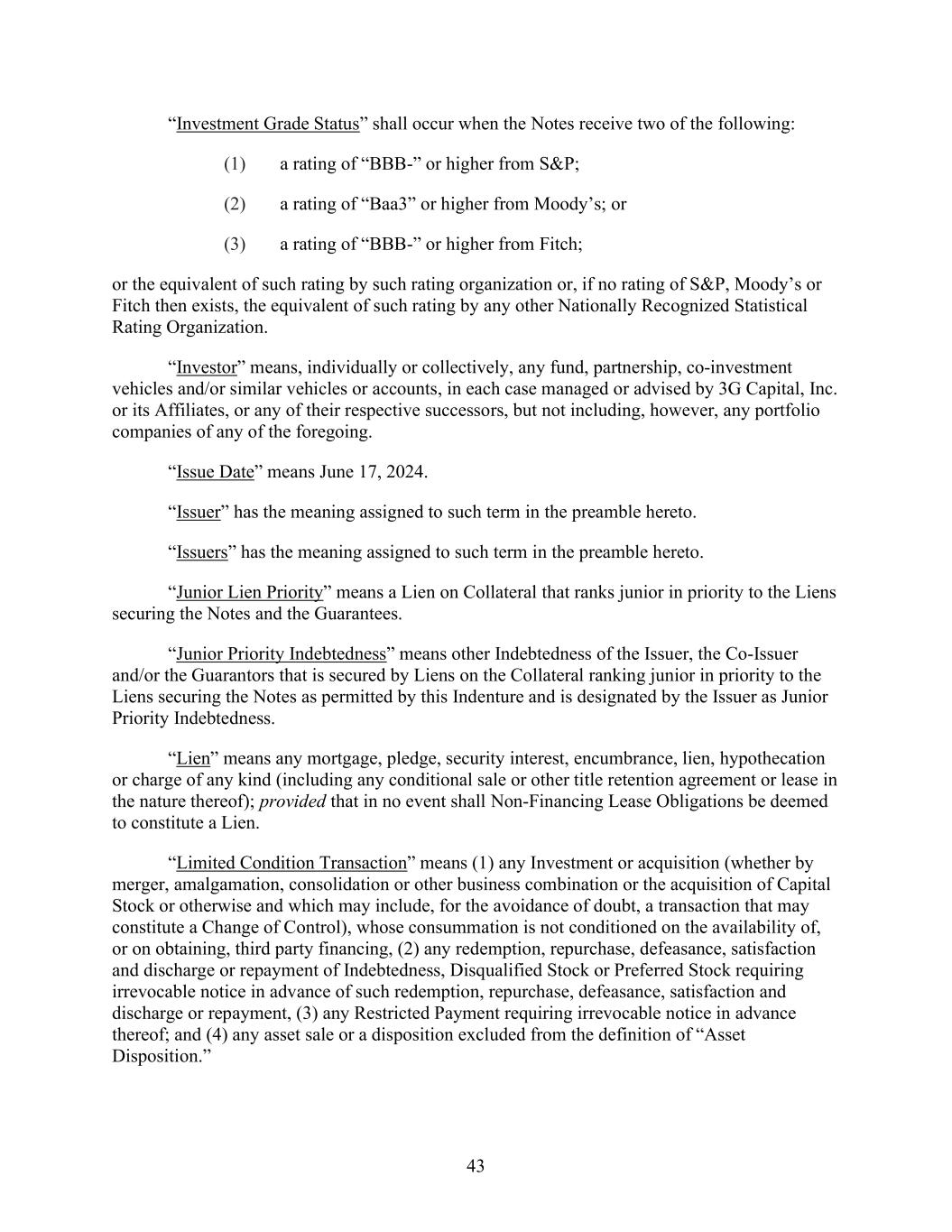
43 “Investment Grade Status” shall occur when the Notes receive two of the following: (1) a rating of “BBB-” or higher from S&P; (2) a rating of “Baa3” or higher from Moody’s; or (3) a rating of “BBB-” or higher from Fitch; or the equivalent of such rating by such rating organization or, if no rating of S&P, Moody’s or Fitch then exists, the equivalent of such rating by any other Nationally Recognized Statistical Rating Organization. “Investor” means, individually or collectively, any fund, partnership, co-investment vehicles and/or similar vehicles or accounts, in each case managed or advised by 3G Capital, Inc. or its Affiliates, or any of their respective successors, but not including, however, any portfolio companies of any of the foregoing. “Issue Date” means June 17, 2024. “Issuer” has the meaning assigned to such term in the preamble hereto. “Issuers” has the meaning assigned to such term in the preamble hereto. “Junior Lien Priority” means a Lien on Collateral that ranks junior in priority to the Liens securing the Notes and the Guarantees. “Junior Priority Indebtedness” means other Indebtedness of the Issuer, the Co-Issuer and/or the Guarantors that is secured by Liens on the Collateral ranking junior in priority to the Liens securing the Notes as permitted by this Indenture and is designated by the Issuer as Junior Priority Indebtedness. “Lien” means any mortgage, pledge, security interest, encumbrance, lien, hypothecation or charge of any kind (including any conditional sale or other title retention agreement or lease in the nature thereof); provided that in no event shall Non-Financing Lease Obligations be deemed to constitute a Lien. “Limited Condition Transaction” means (1) any Investment or acquisition (whether by merger, amalgamation, consolidation or other business combination or the acquisition of Capital Stock or otherwise and which may include, for the avoidance of doubt, a transaction that may constitute a Change of Control), whose consummation is not conditioned on the availability of, or on obtaining, third party financing, (2) any redemption, repurchase, defeasance, satisfaction and discharge or repayment of Indebtedness, Disqualified Stock or Preferred Stock requiring irrevocable notice in advance of such redemption, repurchase, defeasance, satisfaction and discharge or repayment, (3) any Restricted Payment requiring irrevocable notice in advance thereof; and (4) any asset sale or a disposition excluded from the definition of “Asset Disposition.”
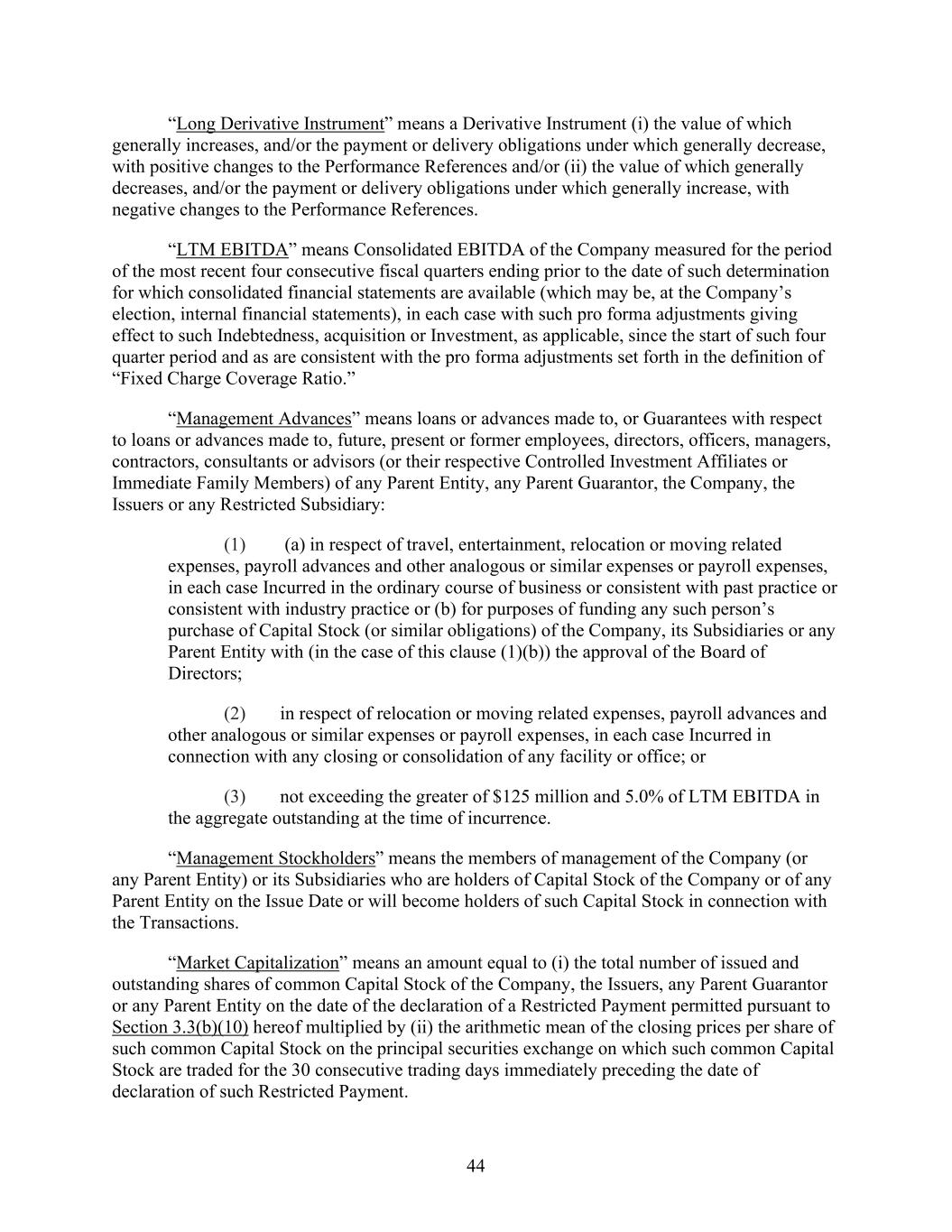
44 “Long Derivative Instrument” means a Derivative Instrument (i) the value of which generally increases, and/or the payment or delivery obligations under which generally decrease, with positive changes to the Performance References and/or (ii) the value of which generally decreases, and/or the payment or delivery obligations under which generally increase, with negative changes to the Performance References. “LTM EBITDA” means Consolidated EBITDA of the Company measured for the period of the most recent four consecutive fiscal quarters ending prior to the date of such determination for which consolidated financial statements are available (which may be, at the Company’s election, internal financial statements), in each case with such pro forma adjustments giving effect to such Indebtedness, acquisition or Investment, as applicable, since the start of such four quarter period and as are consistent with the pro forma adjustments set forth in the definition of “Fixed Charge Coverage Ratio.” “Management Advances” means loans or advances made to, or Guarantees with respect to loans or advances made to, future, present or former employees, directors, officers, managers, contractors, consultants or advisors (or their respective Controlled Investment Affiliates or Immediate Family Members) of any Parent Entity, any Parent Guarantor, the Company, the Issuers or any Restricted Subsidiary: (1) (a) in respect of travel, entertainment, relocation or moving related expenses, payroll advances and other analogous or similar expenses or payroll expenses, in each case Incurred in the ordinary course of business or consistent with past practice or consistent with industry practice or (b) for purposes of funding any such person’s purchase of Capital Stock (or similar obligations) of the Company, its Subsidiaries or any Parent Entity with (in the case of this clause (1)(b)) the approval of the Board of Directors; (2) in respect of relocation or moving related expenses, payroll advances and other analogous or similar expenses or payroll expenses, in each case Incurred in connection with any closing or consolidation of any facility or office; or (3) not exceeding the greater of $125 million and 5.0% of LTM EBITDA in the aggregate outstanding at the time of incurrence. “Management Stockholders” means the members of management of the Company (or any Parent Entity) or its Subsidiaries who are holders of Capital Stock of the Company or of any Parent Entity on the Issue Date or will become holders of such Capital Stock in connection with the Transactions. “Market Capitalization” means an amount equal to (i) the total number of issued and outstanding shares of common Capital Stock of the Company, the Issuers, any Parent Guarantor or any Parent Entity on the date of the declaration of a Restricted Payment permitted pursuant to Section 3.3(b)(10) hereof multiplied by (ii) the arithmetic mean of the closing prices per share of such common Capital Stock on the principal securities exchange on which such common Capital Stock are traded for the 30 consecutive trading days immediately preceding the date of declaration of such Restricted Payment.
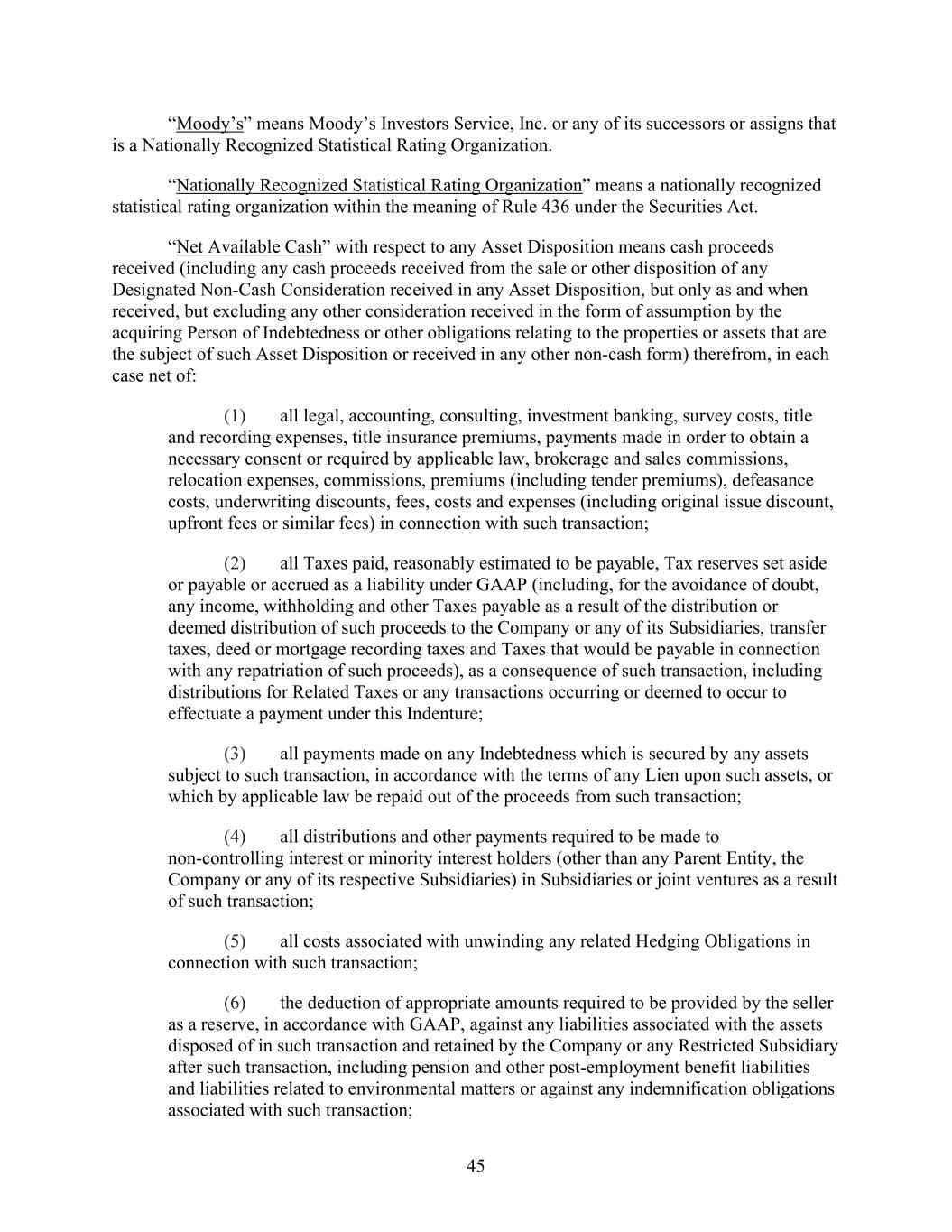
45 “Moody’s” means Xxxxx’x Investors Service, Inc. or any of its successors or assigns that is a Nationally Recognized Statistical Rating Organization. “Nationally Recognized Statistical Rating Organization” means a nationally recognized statistical rating organization within the meaning of Rule 436 under the Securities Act. “Net Available Cash” with respect to any Asset Disposition means cash proceeds received (including any cash proceeds received from the sale or other disposition of any Designated Non-Cash Consideration received in any Asset Disposition, but only as and when received, but excluding any other consideration received in the form of assumption by the acquiring Person of Indebtedness or other obligations relating to the properties or assets that are the subject of such Asset Disposition or received in any other non-cash form) therefrom, in each case net of: (1) all legal, accounting, consulting, investment banking, survey costs, title and recording expenses, title insurance premiums, payments made in order to obtain a necessary consent or required by applicable law, brokerage and sales commissions, relocation expenses, commissions, premiums (including tender premiums), defeasance costs, underwriting discounts, fees, costs and expenses (including original issue discount, upfront fees or similar fees) in connection with such transaction; (2) all Taxes paid, reasonably estimated to be payable, Tax reserves set aside or payable or accrued as a liability under GAAP (including, for the avoidance of doubt, any income, withholding and other Taxes payable as a result of the distribution or deemed distribution of such proceeds to the Company or any of its Subsidiaries, transfer taxes, deed or mortgage recording taxes and Taxes that would be payable in connection with any repatriation of such proceeds), as a consequence of such transaction, including distributions for Related Taxes or any transactions occurring or deemed to occur to effectuate a payment under this Indenture; (3) all payments made on any Indebtedness which is secured by any assets subject to such transaction, in accordance with the terms of any Lien upon such assets, or which by applicable law be repaid out of the proceeds from such transaction; (4) all distributions and other payments required to be made to non-controlling interest or minority interest holders (other than any Parent Entity, the Company or any of its respective Subsidiaries) in Subsidiaries or joint ventures as a result of such transaction; (5) all costs associated with unwinding any related Hedging Obligations in connection with such transaction; (6) the deduction of appropriate amounts required to be provided by the seller as a reserve, in accordance with GAAP, against any liabilities associated with the assets disposed of in such transaction and retained by the Company or any Restricted Subsidiary after such transaction, including pension and other post-employment benefit liabilities and liabilities related to environmental matters or against any indemnification obligations associated with such transaction;
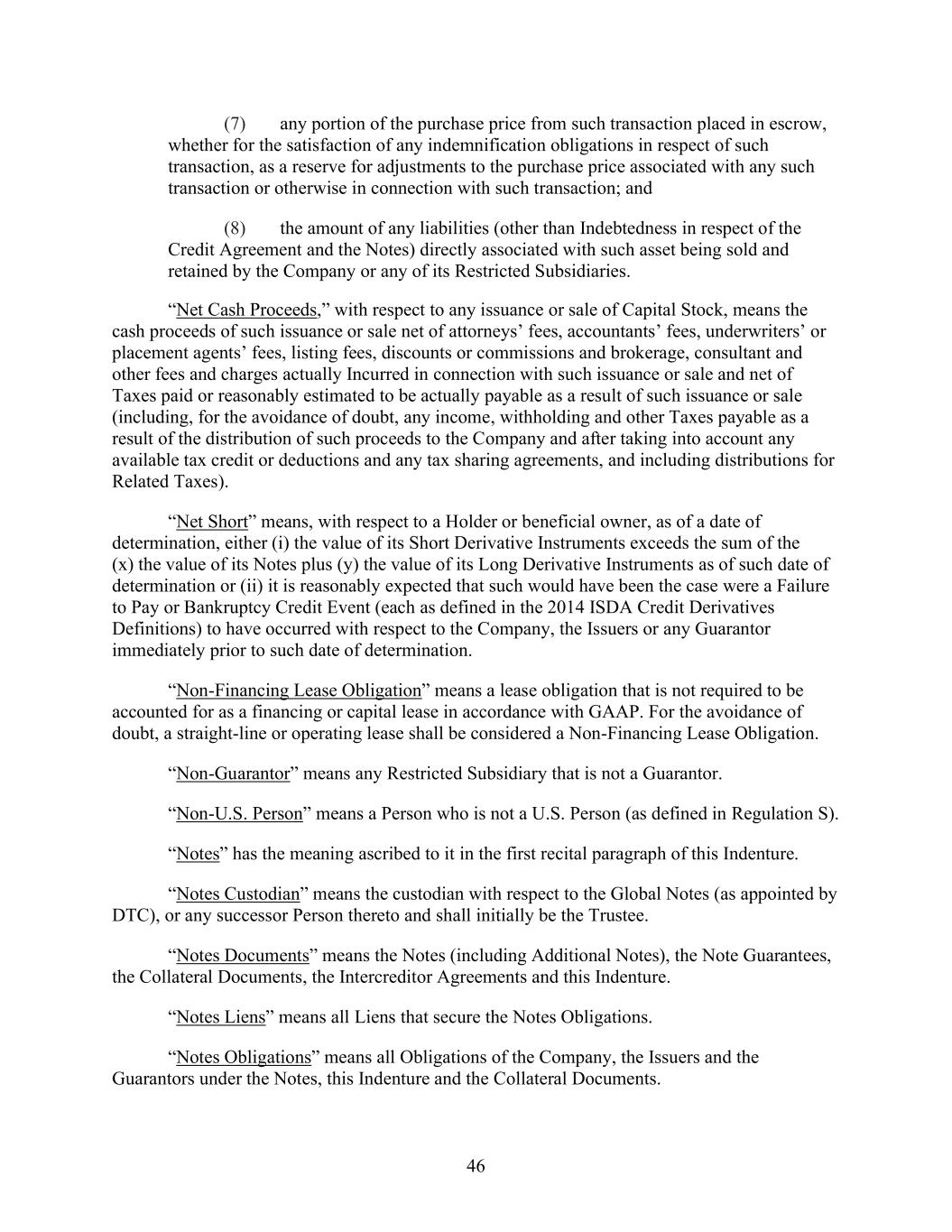
46 (7) any portion of the purchase price from such transaction placed in escrow, whether for the satisfaction of any indemnification obligations in respect of such transaction, as a reserve for adjustments to the purchase price associated with any such transaction or otherwise in connection with such transaction; and (8) the amount of any liabilities (other than Indebtedness in respect of the Credit Agreement and the Notes) directly associated with such asset being sold and retained by the Company or any of its Restricted Subsidiaries. “Net Cash Proceeds,” with respect to any issuance or sale of Capital Stock, means the cash proceeds of such issuance or sale net of attorneys’ fees, accountants’ fees, underwriters’ or placement agents’ fees, listing fees, discounts or commissions and brokerage, consultant and other fees and charges actually Incurred in connection with such issuance or sale and net of Taxes paid or reasonably estimated to be actually payable as a result of such issuance or sale (including, for the avoidance of doubt, any income, withholding and other Taxes payable as a result of the distribution of such proceeds to the Company and after taking into account any available tax credit or deductions and any tax sharing agreements, and including distributions for Related Taxes). “Net Short” means, with respect to a Holder or beneficial owner, as of a date of determination, either (i) the value of its Short Derivative Instruments exceeds the sum of the (x) the value of its Notes plus (y) the value of its Long Derivative Instruments as of such date of determination or (ii) it is reasonably expected that such would have been the case were a Failure to Pay or Bankruptcy Credit Event (each as defined in the 2014 ISDA Credit Derivatives Definitions) to have occurred with respect to the Company, the Issuers or any Guarantor immediately prior to such date of determination. “Non-Financing Lease Obligation” means a lease obligation that is not required to be accounted for as a financing or capital lease in accordance with GAAP. For the avoidance of doubt, a straight-line or operating lease shall be considered a Non-Financing Lease Obligation. “Non-Guarantor” means any Restricted Subsidiary that is not a Guarantor. “Non-U.S. Person” means a Person who is not a U.S. Person (as defined in Regulation S). “Notes” has the meaning ascribed to it in the first recital paragraph of this Indenture. “Notes Custodian” means the custodian with respect to the Global Notes (as appointed by DTC), or any successor Person thereto and shall initially be the Trustee. “Notes Documents” means the Notes (including Additional Notes), the Note Guarantees, the Collateral Documents, the Intercreditor Agreements and this Indenture. “Notes Liens” means all Liens that secure the Notes Obligations. “Notes Obligations” means all Obligations of the Company, the Issuers and the Guarantors under the Notes, this Indenture and the Collateral Documents.
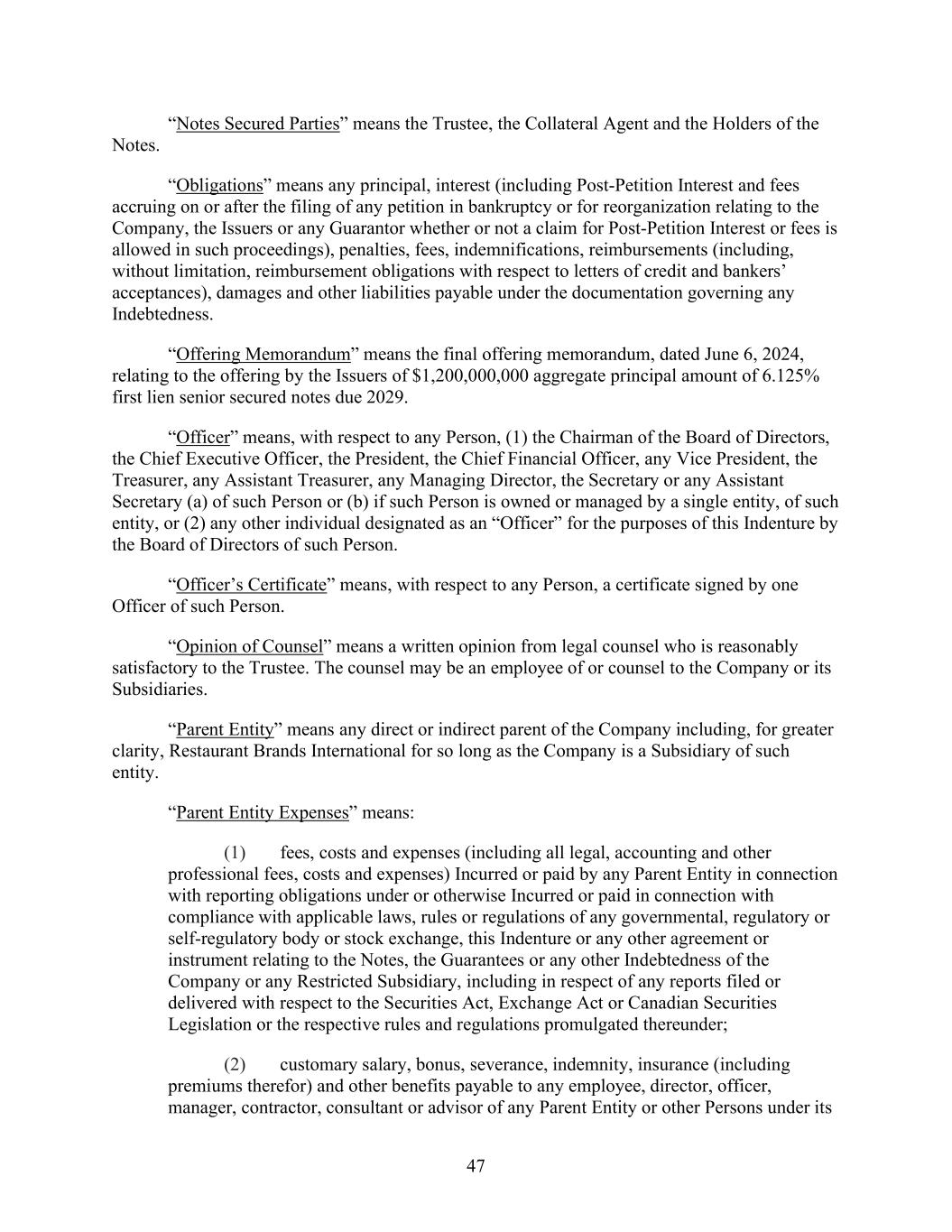
47 “Notes Secured Parties” means the Trustee, the Collateral Agent and the Holders of the Notes. “Obligations” means any principal, interest (including Post-Petition Interest and fees accruing on or after the filing of any petition in bankruptcy or for reorganization relating to the Company, the Issuers or any Guarantor whether or not a claim for Post-Petition Interest or fees is allowed in such proceedings), penalties, fees, indemnifications, reimbursements (including, without limitation, reimbursement obligations with respect to letters of credit and bankers’ acceptances), damages and other liabilities payable under the documentation governing any Indebtedness. “Offering Memorandum” means the final offering memorandum, dated June 6, 2024, relating to the offering by the Issuers of $1,200,000,000 aggregate principal amount of 6.125% first lien senior secured notes due 2029. “Officer” means, with respect to any Person, (1) the Chairman of the Board of Directors, the Chief Executive Officer, the President, the Chief Financial Officer, any Vice President, the Treasurer, any Assistant Treasurer, any Managing Director, the Secretary or any Assistant Secretary (a) of such Person or (b) if such Person is owned or managed by a single entity, of such entity, or (2) any other individual designated as an “Officer” for the purposes of this Indenture by the Board of Directors of such Person. “Officer’s Certificate” means, with respect to any Person, a certificate signed by one Officer of such Person. “Opinion of Counsel” means a written opinion from legal counsel who is reasonably satisfactory to the Trustee. The counsel may be an employee of or counsel to the Company or its Subsidiaries. “Parent Entity” means any direct or indirect parent of the Company including, for greater clarity, Restaurant Brands International for so long as the Company is a Subsidiary of such entity. “Parent Entity Expenses” means: (1) fees, costs and expenses (including all legal, accounting and other professional fees, costs and expenses) Incurred or paid by any Parent Entity in connection with reporting obligations under or otherwise Incurred or paid in connection with compliance with applicable laws, rules or regulations of any governmental, regulatory or self-regulatory body or stock exchange, this Indenture or any other agreement or instrument relating to the Notes, the Guarantees or any other Indebtedness of the Company or any Restricted Subsidiary, including in respect of any reports filed or delivered with respect to the Securities Act, Exchange Act or Canadian Securities Legislation or the respective rules and regulations promulgated thereunder; (2) customary salary, bonus, severance, indemnity, insurance (including premiums therefor) and other benefits payable to any employee, director, officer, manager, contractor, consultant or advisor of any Parent Entity or other Persons under its
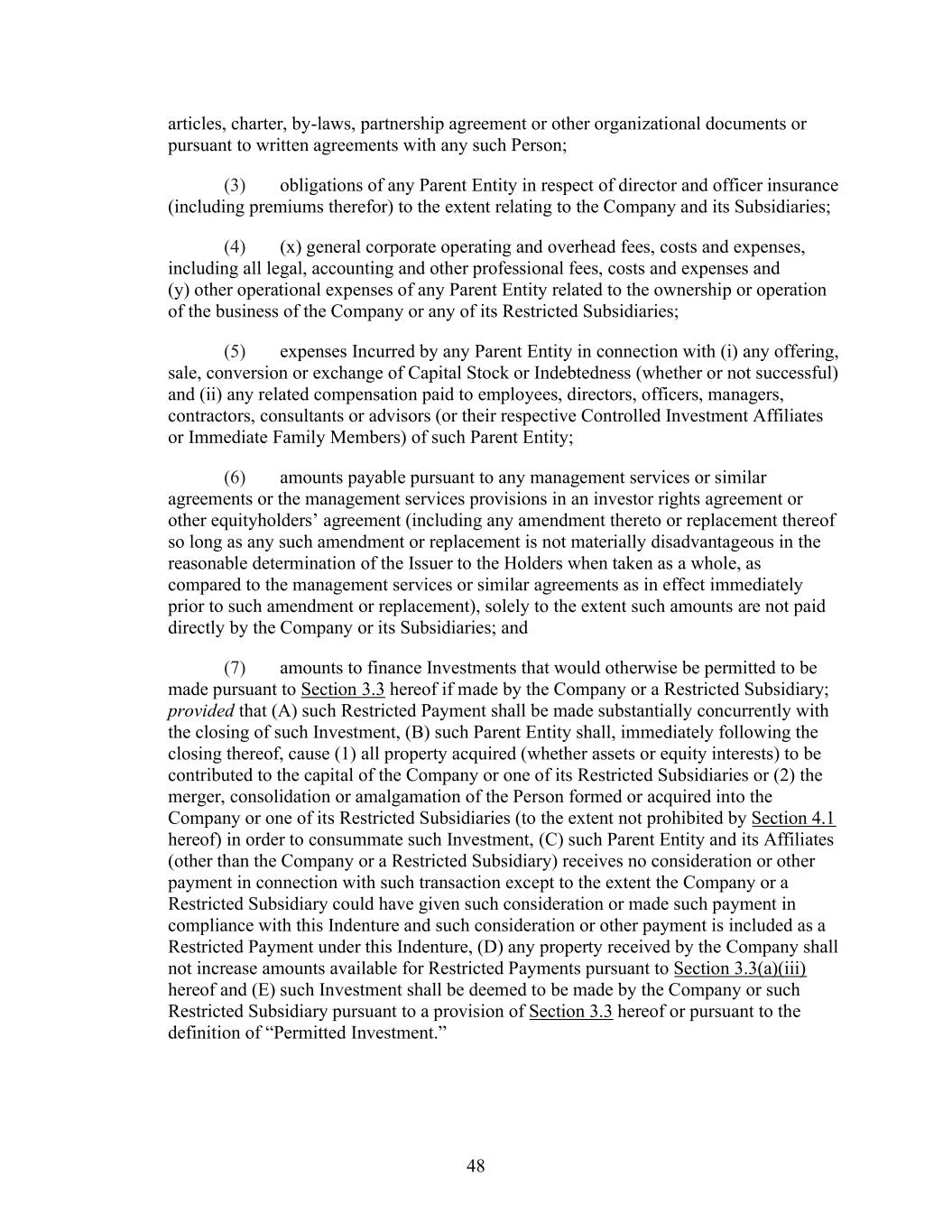
48 articles, charter, by-laws, partnership agreement or other organizational documents or pursuant to written agreements with any such Person; (3) obligations of any Parent Entity in respect of director and officer insurance (including premiums therefor) to the extent relating to the Company and its Subsidiaries; (4) (x) general corporate operating and overhead fees, costs and expenses, including all legal, accounting and other professional fees, costs and expenses and (y) other operational expenses of any Parent Entity related to the ownership or operation of the business of the Company or any of its Restricted Subsidiaries; (5) expenses Incurred by any Parent Entity in connection with (i) any offering, sale, conversion or exchange of Capital Stock or Indebtedness (whether or not successful) and (ii) any related compensation paid to employees, directors, officers, managers, contractors, consultants or advisors (or their respective Controlled Investment Affiliates or Immediate Family Members) of such Parent Entity; (6) amounts payable pursuant to any management services or similar agreements or the management services provisions in an investor rights agreement or other equityholders’ agreement (including any amendment thereto or replacement thereof so long as any such amendment or replacement is not materially disadvantageous in the reasonable determination of the Issuer to the Holders when taken as a whole, as compared to the management services or similar agreements as in effect immediately prior to such amendment or replacement), solely to the extent such amounts are not paid directly by the Company or its Subsidiaries; and (7) amounts to finance Investments that would otherwise be permitted to be made pursuant to Section 3.3 hereof if made by the Company or a Restricted Subsidiary; provided that (A) such Restricted Payment shall be made substantially concurrently with the closing of such Investment, (B) such Parent Entity shall, immediately following the closing thereof, cause (1) all property acquired (whether assets or equity interests) to be contributed to the capital of the Company or one of its Restricted Subsidiaries or (2) the merger, consolidation or amalgamation of the Person formed or acquired into the Company or one of its Restricted Subsidiaries (to the extent not prohibited by Section 4.1 hereof) in order to consummate such Investment, (C) such Parent Entity and its Affiliates (other than the Company or a Restricted Subsidiary) receives no consideration or other payment in connection with such transaction except to the extent the Company or a Restricted Subsidiary could have given such consideration or made such payment in compliance with this Indenture and such consideration or other payment is included as a Restricted Payment under this Indenture, (D) any property received by the Company shall not increase amounts available for Restricted Payments pursuant to Section 3.3(a)(iii) hereof and (E) such Investment shall be deemed to be made by the Company or such Restricted Subsidiary pursuant to a provision of Section 3.3 hereof or pursuant to the definition of “Permitted Investment.”
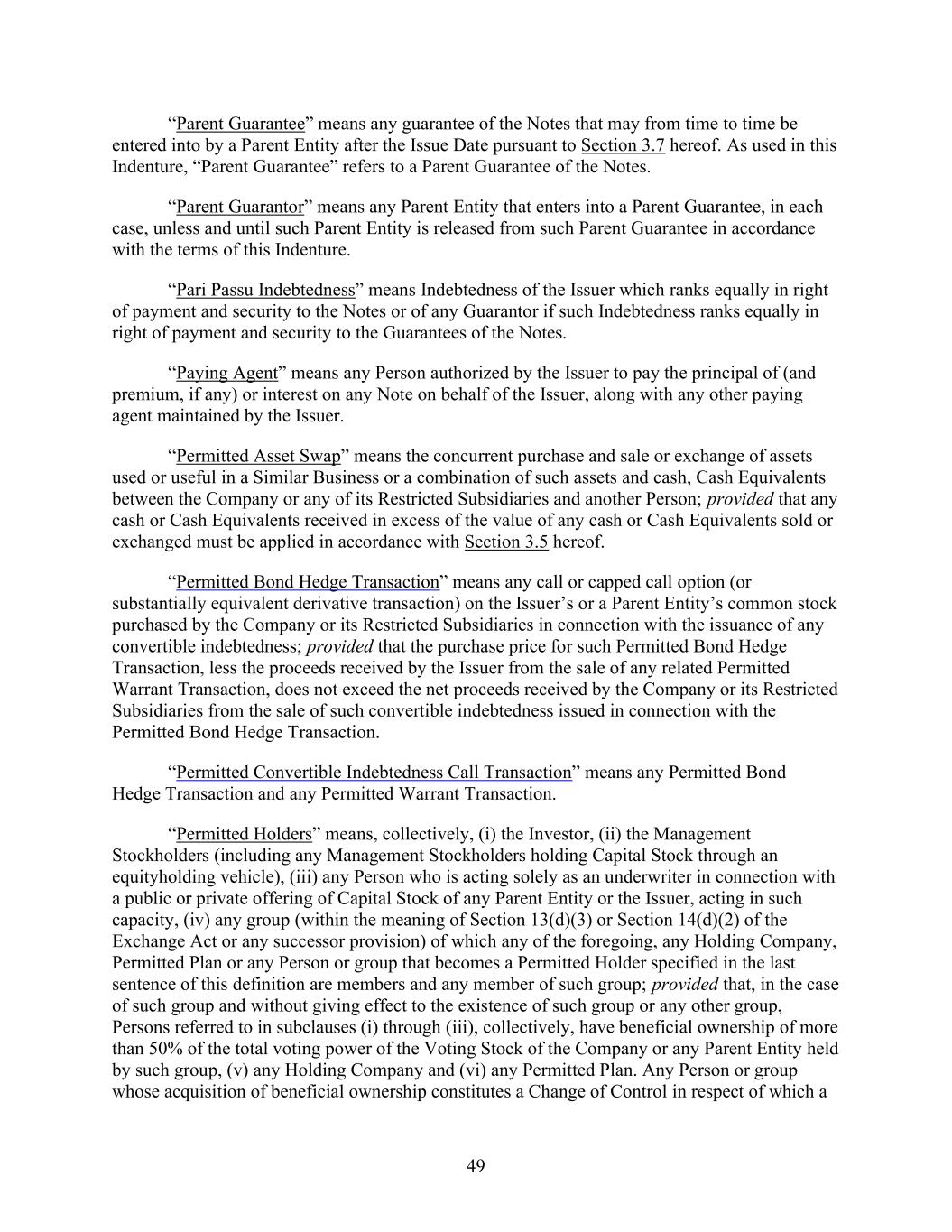
49 “Parent Guarantee” means any guarantee of the Notes that may from time to time be entered into by a Parent Entity after the Issue Date pursuant to Section 3.7 hereof. As used in this Indenture, “Parent Guarantee” refers to a Parent Guarantee of the Notes. “Parent Guarantor” means any Parent Entity that enters into a Parent Guarantee, in each case, unless and until such Parent Entity is released from such Parent Guarantee in accordance with the terms of this Indenture. “Pari Passu Indebtedness” means Indebtedness of the Issuer which ranks equally in right of payment and security to the Notes or of any Guarantor if such Indebtedness ranks equally in right of payment and security to the Guarantees of the Notes. “Paying Agent” means any Person authorized by the Issuer to pay the principal of (and premium, if any) or interest on any Note on behalf of the Issuer, along with any other paying agent maintained by the Issuer. “Permitted Asset Swap” means the concurrent purchase and sale or exchange of assets used or useful in a Similar Business or a combination of such assets and cash, Cash Equivalents between the Company or any of its Restricted Subsidiaries and another Person; provided that any cash or Cash Equivalents received in excess of the value of any cash or Cash Equivalents sold or exchanged must be applied in accordance with Section 3.5 hereof. “Permitted Bond Hedge Transaction” means any call or capped call option (or substantially equivalent derivative transaction) on the Issuer’s or a Parent Entity’s common stock purchased by the Company or its Restricted Subsidiaries in connection with the issuance of any convertible indebtedness; provided that the purchase price for such Permitted Bond Hedge Transaction, less the proceeds received by the Issuer from the sale of any related Permitted Warrant Transaction, does not exceed the net proceeds received by the Company or its Restricted Subsidiaries from the sale of such convertible indebtedness issued in connection with the Permitted Bond Hedge Transaction. “Permitted Convertible Indebtedness Call Transaction” means any Permitted Bond Hedge Transaction and any Permitted Warrant Transaction. “Permitted Holders” means, collectively, (i) the Investor, (ii) the Management Stockholders (including any Management Stockholders holding Capital Stock through an equityholding vehicle), (iii) any Person who is acting solely as an underwriter in connection with a public or private offering of Capital Stock of any Parent Entity or the Issuer, acting in such capacity, (iv) any group (within the meaning of Section 13(d)(3) or Section 14(d)(2) of the Exchange Act or any successor provision) of which any of the foregoing, any Holding Company, Permitted Plan or any Person or group that becomes a Permitted Holder specified in the last sentence of this definition are members and any member of such group; provided that, in the case of such group and without giving effect to the existence of such group or any other group, Persons referred to in subclauses (i) through (iii), collectively, have beneficial ownership of more than 50% of the total voting power of the Voting Stock of the Company or any Parent Entity held by such group, (v) any Holding Company and (vi) any Permitted Plan. Any Person or group whose acquisition of beneficial ownership constitutes a Change of Control in respect of which a
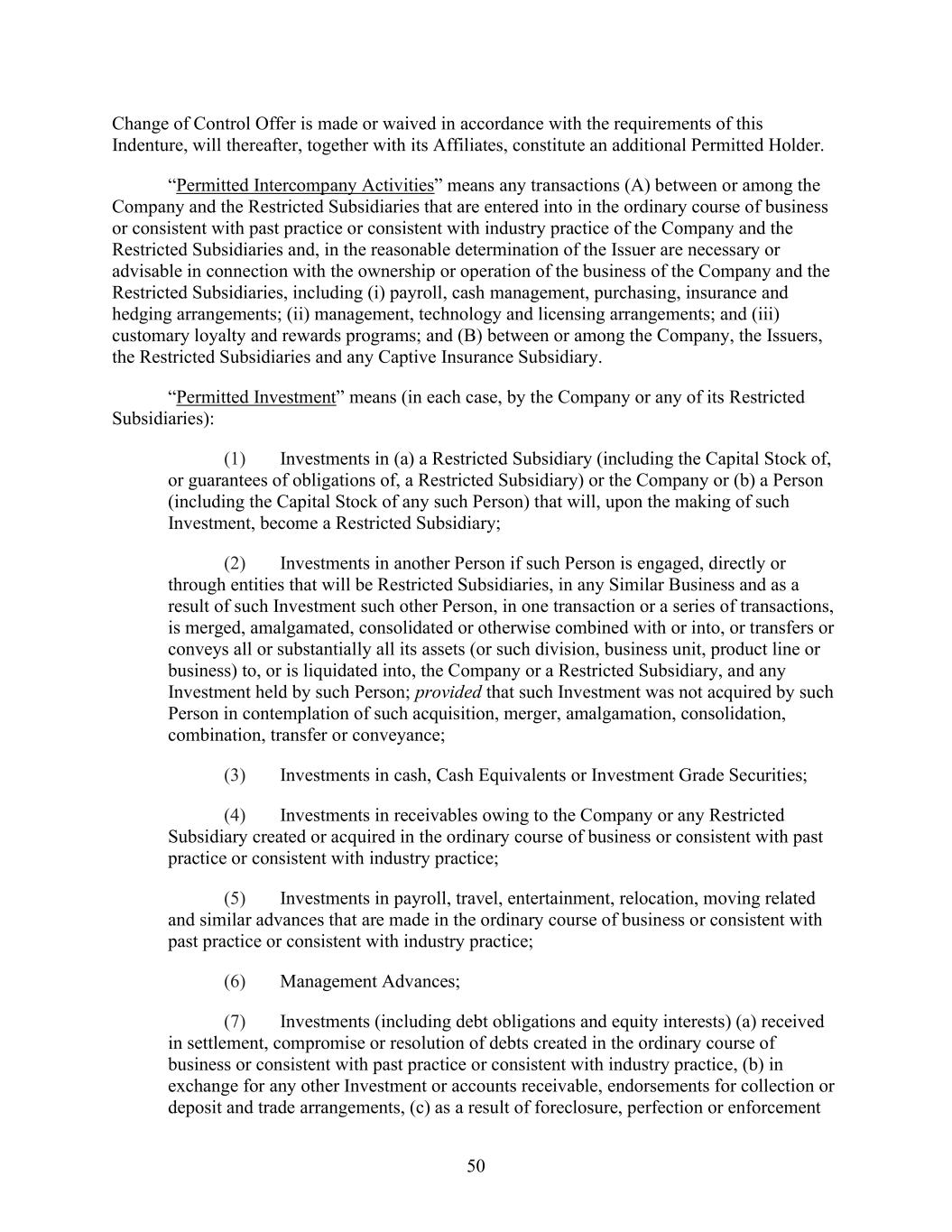
50 Change of Control Offer is made or waived in accordance with the requirements of this Indenture, will thereafter, together with its Affiliates, constitute an additional Permitted Holder. “Permitted Intercompany Activities” means any transactions (A) between or among the Company and the Restricted Subsidiaries that are entered into in the ordinary course of business or consistent with past practice or consistent with industry practice of the Company and the Restricted Subsidiaries and, in the reasonable determination of the Issuer are necessary or advisable in connection with the ownership or operation of the business of the Company and the Restricted Subsidiaries, including (i) payroll, cash management, purchasing, insurance and hedging arrangements; (ii) management, technology and licensing arrangements; and (iii) customary loyalty and rewards programs; and (B) between or among the Company, the Issuers, the Restricted Subsidiaries and any Captive Insurance Subsidiary. “Permitted Investment” means (in each case, by the Company or any of its Restricted Subsidiaries): (1) Investments in (a) a Restricted Subsidiary (including the Capital Stock of, or guarantees of obligations of, a Restricted Subsidiary) or the Company or (b) a Person (including the Capital Stock of any such Person) that will, upon the making of such Investment, become a Restricted Subsidiary; (2) Investments in another Person if such Person is engaged, directly or through entities that will be Restricted Subsidiaries, in any Similar Business and as a result of such Investment such other Person, in one transaction or a series of transactions, is merged, amalgamated, consolidated or otherwise combined with or into, or transfers or conveys all or substantially all its assets (or such division, business unit, product line or business) to, or is liquidated into, the Company or a Restricted Subsidiary, and any Investment held by such Person; provided that such Investment was not acquired by such Person in contemplation of such acquisition, merger, amalgamation, consolidation, combination, transfer or conveyance; (3) Investments in cash, Cash Equivalents or Investment Grade Securities; (4) Investments in receivables owing to the Company or any Restricted Subsidiary created or acquired in the ordinary course of business or consistent with past practice or consistent with industry practice; (5) Investments in payroll, travel, entertainment, relocation, moving related and similar advances that are made in the ordinary course of business or consistent with past practice or consistent with industry practice; (6) Management Advances; (7) Investments (including debt obligations and equity interests) (a) received in settlement, compromise or resolution of debts created in the ordinary course of business or consistent with past practice or consistent with industry practice, (b) in exchange for any other Investment or accounts receivable, endorsements for collection or deposit and trade arrangements, (c) as a result of foreclosure, perfection or enforcement
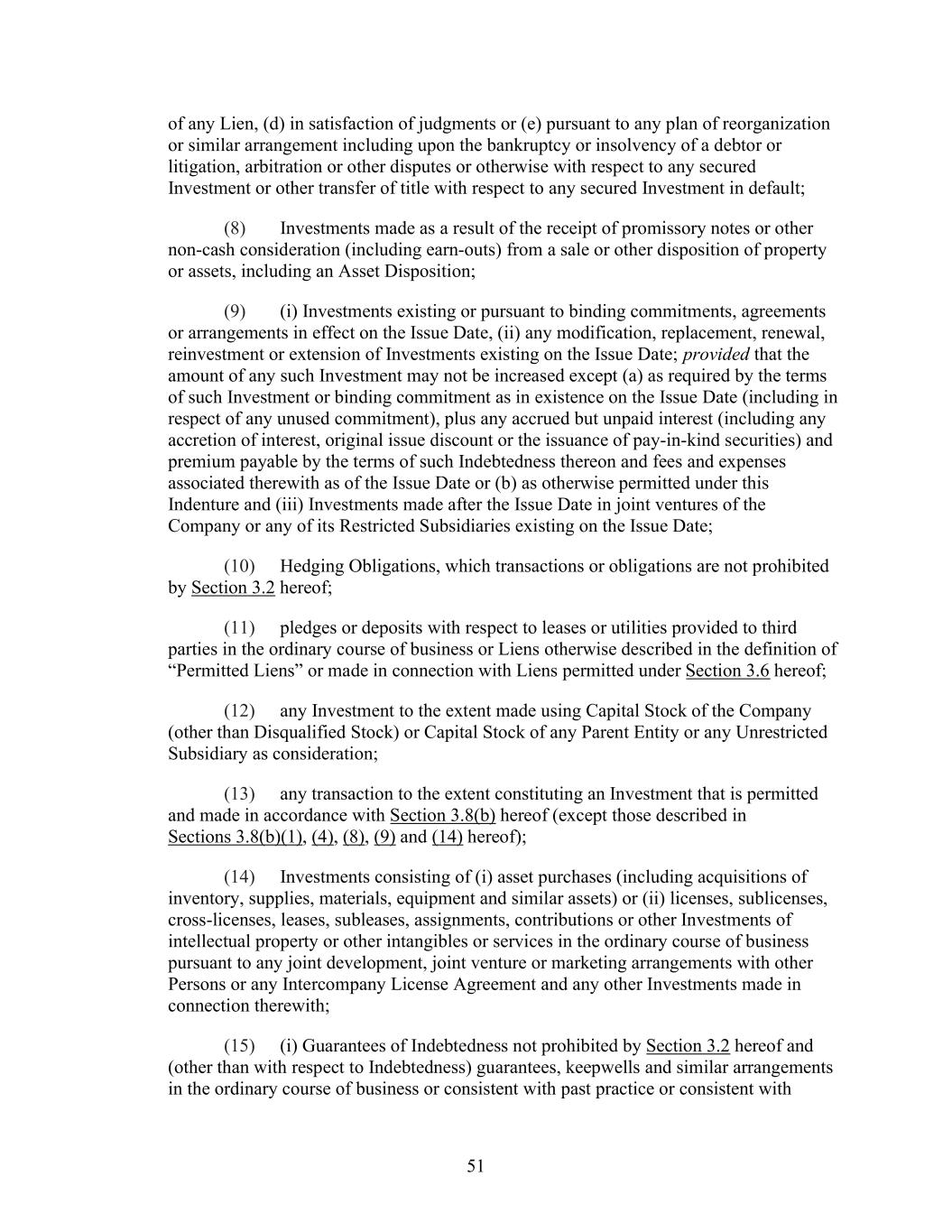
51 of any Lien, (d) in satisfaction of judgments or (e) pursuant to any plan of reorganization or similar arrangement including upon the bankruptcy or insolvency of a debtor or litigation, arbitration or other disputes or otherwise with respect to any secured Investment or other transfer of title with respect to any secured Investment in default; (8) Investments made as a result of the receipt of promissory notes or other non-cash consideration (including earn-outs) from a sale or other disposition of property or assets, including an Asset Disposition; (9) (i) Investments existing or pursuant to binding commitments, agreements or arrangements in effect on the Issue Date, (ii) any modification, replacement, renewal, reinvestment or extension of Investments existing on the Issue Date; provided that the amount of any such Investment may not be increased except (a) as required by the terms of such Investment or binding commitment as in existence on the Issue Date (including in respect of any unused commitment), plus any accrued but unpaid interest (including any accretion of interest, original issue discount or the issuance of pay-in-kind securities) and premium payable by the terms of such Indebtedness thereon and fees and expenses associated therewith as of the Issue Date or (b) as otherwise permitted under this Indenture and (iii) Investments made after the Issue Date in joint ventures of the Company or any of its Restricted Subsidiaries existing on the Issue Date; (10) Hedging Obligations, which transactions or obligations are not prohibited by Section 3.2 hereof; (11) pledges or deposits with respect to leases or utilities provided to third parties in the ordinary course of business or Liens otherwise described in the definition of “Permitted Liens” or made in connection with Liens permitted under Section 3.6 hereof; (12) any Investment to the extent made using Capital Stock of the Company (other than Disqualified Stock) or Capital Stock of any Parent Entity or any Unrestricted Subsidiary as consideration; (13) any transaction to the extent constituting an Investment that is permitted and made in accordance with Section 3.8(b) hereof (except those described in Sections 3.8(b)(1), (4), (8), (9) and (14) hereof); (14) Investments consisting of (i) asset purchases (including acquisitions of inventory, supplies, materials, equipment and similar assets) or (ii) licenses, sublicenses, cross-licenses, leases, subleases, assignments, contributions or other Investments of intellectual property or other intangibles or services in the ordinary course of business pursuant to any joint development, joint venture or marketing arrangements with other Persons or any Intercompany License Agreement and any other Investments made in connection therewith; (15) (i) Guarantees of Indebtedness not prohibited by Section 3.2 hereof and (other than with respect to Indebtedness) guarantees, keepwells and similar arrangements in the ordinary course of business or consistent with past practice or consistent with
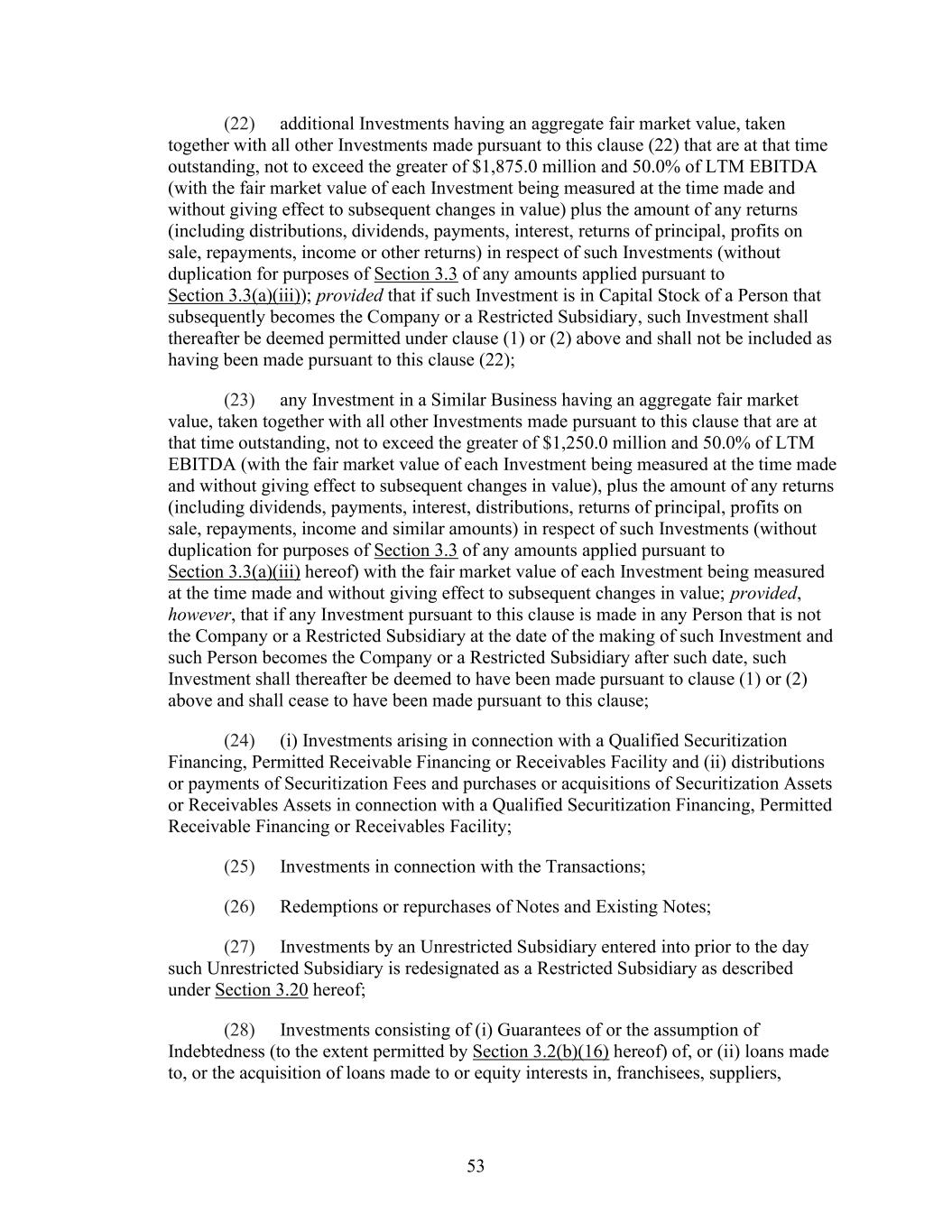
53 (22) additional Investments having an aggregate fair market value, taken together with all other Investments made pursuant to this clause (22) that are at that time outstanding, not to exceed the greater of $1,875.0 million and 50.0% of LTM EBITDA (with the fair market value of each Investment being measured at the time made and without giving effect to subsequent changes in value) plus the amount of any returns (including distributions, dividends, payments, interest, returns of principal, profits on sale, repayments, income or other returns) in respect of such Investments (without duplication for purposes of Section 3.3 of any amounts applied pursuant to Section 3.3(a)(iii)); provided that if such Investment is in Capital Stock of a Person that subsequently becomes the Company or a Restricted Subsidiary, such Investment shall thereafter be deemed permitted under clause (1) or (2) above and shall not be included as having been made pursuant to this clause (22); (23) any Investment in a Similar Business having an aggregate fair market value, taken together with all other Investments made pursuant to this clause that are at that time outstanding, not to exceed the greater of $1,250.0 million and 50.0% of LTM EBITDA (with the fair market value of each Investment being measured at the time made and without giving effect to subsequent changes in value), plus the amount of any returns (including dividends, payments, interest, distributions, returns of principal, profits on sale, repayments, income and similar amounts) in respect of such Investments (without duplication for purposes of Section 3.3 of any amounts applied pursuant to Section 3.3(a)(iii) hereof) with the fair market value of each Investment being measured at the time made and without giving effect to subsequent changes in value; provided, however, that if any Investment pursuant to this clause is made in any Person that is not the Company or a Restricted Subsidiary at the date of the making of such Investment and such Person becomes the Company or a Restricted Subsidiary after such date, such Investment shall thereafter be deemed to have been made pursuant to clause (1) or (2) above and shall cease to have been made pursuant to this clause; (24) (i) Investments arising in connection with a Qualified Securitization Financing, Permitted Receivable Financing or Receivables Facility and (ii) distributions or payments of Securitization Fees and purchases or acquisitions of Securitization Assets or Receivables Assets in connection with a Qualified Securitization Financing, Permitted Receivable Financing or Receivables Facility; (25) Investments in connection with the Transactions; (26) Redemptions or repurchases of Notes and Existing Notes; (27) Investments by an Unrestricted Subsidiary entered into prior to the day such Unrestricted Subsidiary is redesignated as a Restricted Subsidiary as described under Section 3.20 hereof; (28) Investments consisting of (i) Guarantees of or the assumption of Indebtedness (to the extent permitted by Section 3.2(b)(16) hereof) of, or (ii) loans made to, or the acquisition of loans made to or equity interests in, franchisees, suppliers,
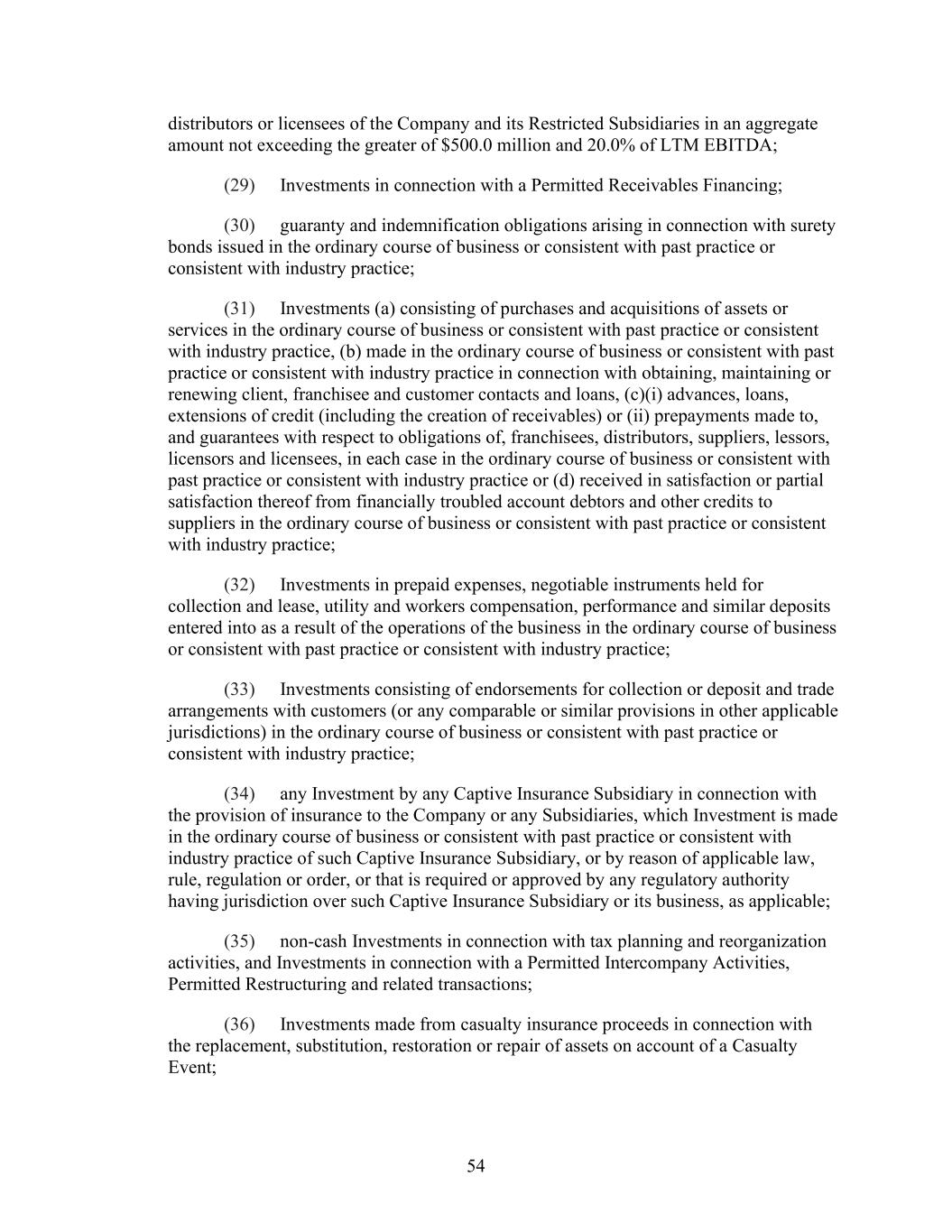
54 distributors or licensees of the Company and its Restricted Subsidiaries in an aggregate amount not exceeding the greater of $500.0 million and 20.0% of LTM EBITDA; (29) Investments in connection with a Permitted Receivables Financing; (30) guaranty and indemnification obligations arising in connection with surety bonds issued in the ordinary course of business or consistent with past practice or consistent with industry practice; (31) Investments (a) consisting of purchases and acquisitions of assets or services in the ordinary course of business or consistent with past practice or consistent with industry practice, (b) made in the ordinary course of business or consistent with past practice or consistent with industry practice in connection with obtaining, maintaining or renewing client, franchisee and customer contacts and loans, (c)(i) advances, loans, extensions of credit (including the creation of receivables) or (ii) prepayments made to, and guarantees with respect to obligations of, franchisees, distributors, suppliers, lessors, licensors and licensees, in each case in the ordinary course of business or consistent with past practice or consistent with industry practice or (d) received in satisfaction or partial satisfaction thereof from financially troubled account debtors and other credits to suppliers in the ordinary course of business or consistent with past practice or consistent with industry practice; (32) Investments in prepaid expenses, negotiable instruments held for collection and lease, utility and workers compensation, performance and similar deposits entered into as a result of the operations of the business in the ordinary course of business or consistent with past practice or consistent with industry practice; (33) Investments consisting of endorsements for collection or deposit and trade arrangements with customers (or any comparable or similar provisions in other applicable jurisdictions) in the ordinary course of business or consistent with past practice or consistent with industry practice; (34) any Investment by any Captive Insurance Subsidiary in connection with the provision of insurance to the Company or any Subsidiaries, which Investment is made in the ordinary course of business or consistent with past practice or consistent with industry practice of such Captive Insurance Subsidiary, or by reason of applicable law, rule, regulation or order, or that is required or approved by any regulatory authority having jurisdiction over such Captive Insurance Subsidiary or its business, as applicable; (35) non-cash Investments in connection with tax planning and reorganization activities, and Investments in connection with a Permitted Intercompany Activities, Permitted Restructuring and related transactions; (36) Investments made from casualty insurance proceeds in connection with the replacement, substitution, restoration or repair of assets on account of a Casualty Event;
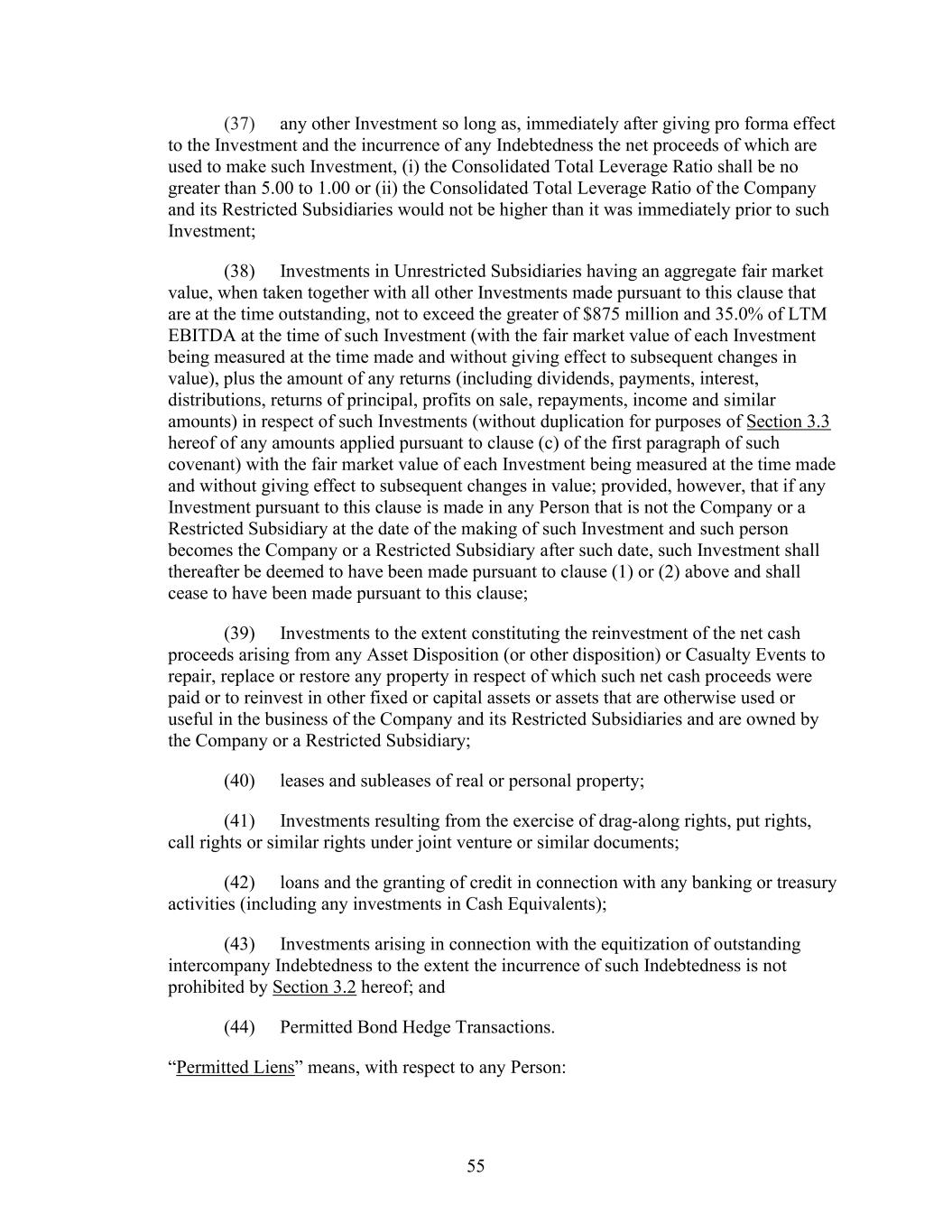
55 (37) any other Investment so long as, immediately after giving pro forma effect to the Investment and the incurrence of any Indebtedness the net proceeds of which are used to make such Investment, (i) the Consolidated Total Leverage Ratio shall be no greater than 5.00 to 1.00 or (ii) the Consolidated Total Leverage Ratio of the Company and its Restricted Subsidiaries would not be higher than it was immediately prior to such Investment; (38) Investments in Unrestricted Subsidiaries having an aggregate fair market value, when taken together with all other Investments made pursuant to this clause that are at the time outstanding, not to exceed the greater of $875 million and 35.0% of LTM EBITDA at the time of such Investment (with the fair market value of each Investment being measured at the time made and without giving effect to subsequent changes in value), plus the amount of any returns (including dividends, payments, interest, distributions, returns of principal, profits on sale, repayments, income and similar amounts) in respect of such Investments (without duplication for purposes of Section 3.3 hereof of any amounts applied pursuant to clause (c) of the first paragraph of such covenant) with the fair market value of each Investment being measured at the time made and without giving effect to subsequent changes in value; provided, however, that if any Investment pursuant to this clause is made in any Person that is not the Company or a Restricted Subsidiary at the date of the making of such Investment and such person becomes the Company or a Restricted Subsidiary after such date, such Investment shall thereafter be deemed to have been made pursuant to clause (1) or (2) above and shall cease to have been made pursuant to this clause; (39) Investments to the extent constituting the reinvestment of the net cash proceeds arising from any Asset Disposition (or other disposition) or Casualty Events to repair, replace or restore any property in respect of which such net cash proceeds were paid or to reinvest in other fixed or capital assets or assets that are otherwise used or useful in the business of the Company and its Restricted Subsidiaries and are owned by the Company or a Restricted Subsidiary; (40) leases and subleases of real or personal property; (41) Investments resulting from the exercise of drag-along rights, put rights, call rights or similar rights under joint venture or similar documents; (42) loans and the granting of credit in connection with any banking or treasury activities (including any investments in Cash Equivalents); (43) Investments arising in connection with the equitization of outstanding intercompany Indebtedness to the extent the incurrence of such Indebtedness is not prohibited by Section 3.2 hereof; and (44) Permitted Bond Hedge Transactions. “Permitted Liens” means, with respect to any Person:
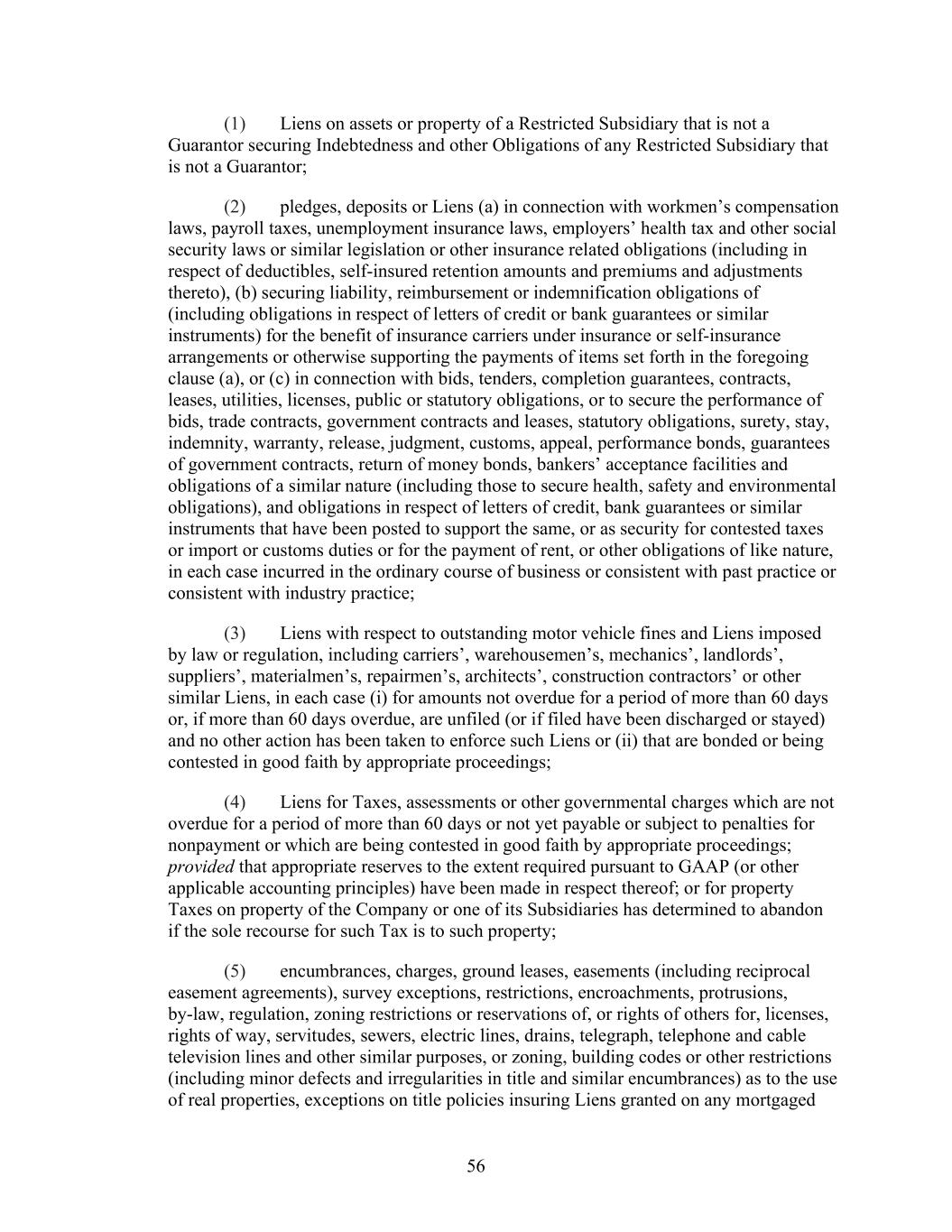
56 (1) Liens on assets or property of a Restricted Subsidiary that is not a Guarantor securing Indebtedness and other Obligations of any Restricted Subsidiary that is not a Guarantor; (2) pledges, deposits or Liens (a) in connection with workmen’s compensation laws, payroll taxes, unemployment insurance laws, employers’ health tax and other social security laws or similar legislation or other insurance related obligations (including in respect of deductibles, self-insured retention amounts and premiums and adjustments thereto), (b) securing liability, reimbursement or indemnification obligations of (including obligations in respect of letters of credit or bank guarantees or similar instruments) for the benefit of insurance carriers under insurance or self-insurance arrangements or otherwise supporting the payments of items set forth in the foregoing clause (a), or (c) in connection with bids, tenders, completion guarantees, contracts, leases, utilities, licenses, public or statutory obligations, or to secure the performance of bids, trade contracts, government contracts and leases, statutory obligations, surety, stay, indemnity, warranty, release, judgment, customs, appeal, performance bonds, guarantees of government contracts, return of money bonds, bankers’ acceptance facilities and obligations of a similar nature (including those to secure health, safety and environmental obligations), and obligations in respect of letters of credit, bank guarantees or similar instruments that have been posted to support the same, or as security for contested taxes or import or customs duties or for the payment of rent, or other obligations of like nature, in each case incurred in the ordinary course of business or consistent with past practice or consistent with industry practice; (3) Liens with respect to outstanding motor vehicle fines and Liens imposed by law or regulation, including carriers’, warehousemen’s, mechanics’, landlords’, suppliers’, materialmen’s, repairmen’s, architects’, construction contractors’ or other similar Liens, in each case (i) for amounts not overdue for a period of more than 60 days or, if more than 60 days overdue, are unfiled (or if filed have been discharged or stayed) and no other action has been taken to enforce such Liens or (ii) that are bonded or being contested in good faith by appropriate proceedings; (4) Liens for Taxes, assessments or other governmental charges which are not overdue for a period of more than 60 days or not yet payable or subject to penalties for nonpayment or which are being contested in good faith by appropriate proceedings; provided that appropriate reserves to the extent required pursuant to GAAP (or other applicable accounting principles) have been made in respect thereof; or for property Taxes on property of the Company or one of its Subsidiaries has determined to abandon if the sole recourse for such Tax is to such property; (5) encumbrances, charges, ground leases, easements (including reciprocal easement agreements), survey exceptions, restrictions, encroachments, protrusions, by-law, regulation, zoning restrictions or reservations of, or rights of others for, licenses, rights of way, servitudes, sewers, electric lines, drains, telegraph, telephone and cable television lines and other similar purposes, or zoning, building codes or other restrictions (including minor defects and irregularities in title and similar encumbrances) as to the use of real properties, exceptions on title policies insuring Liens granted on any mortgaged
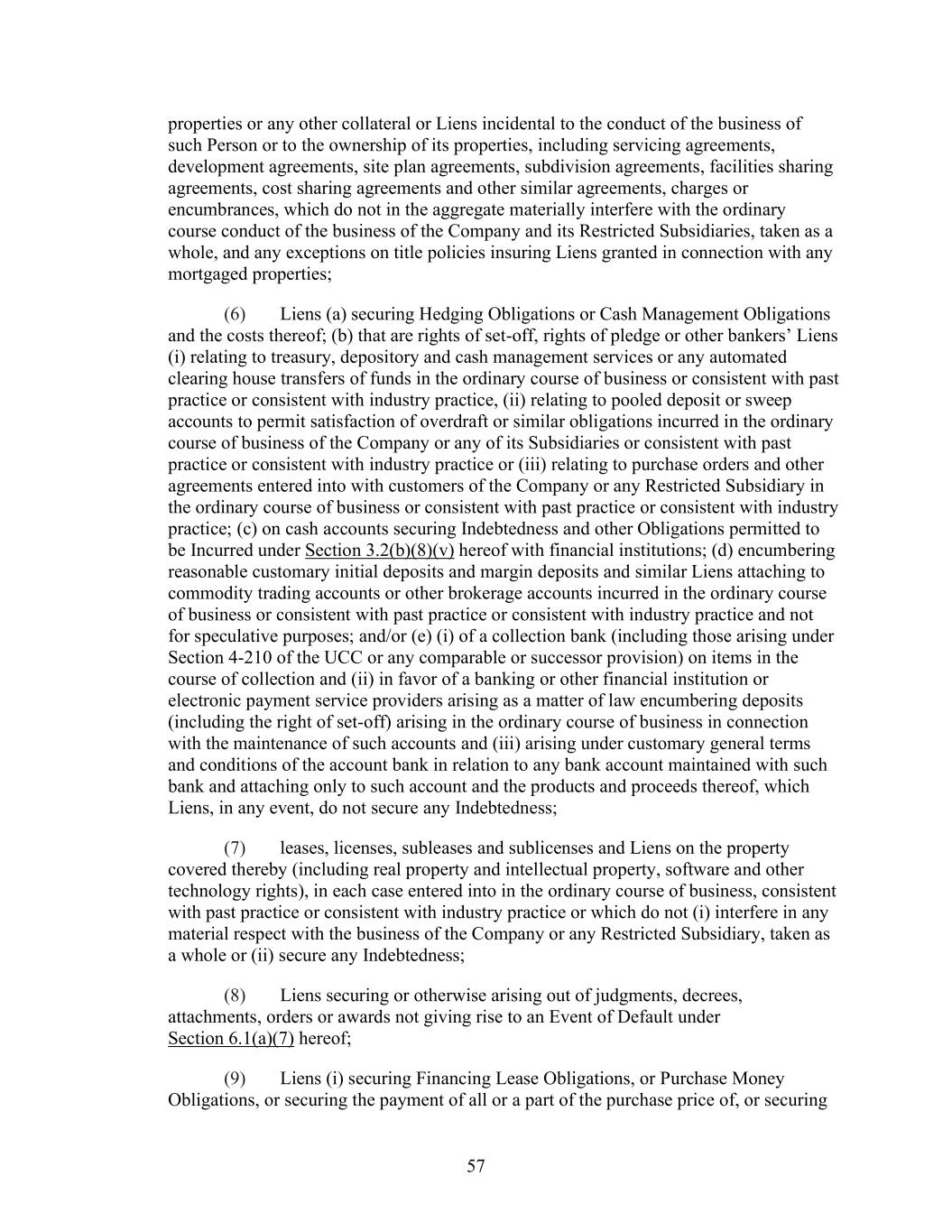
57 properties or any other collateral or Liens incidental to the conduct of the business of such Person or to the ownership of its properties, including servicing agreements, development agreements, site plan agreements, subdivision agreements, facilities sharing agreements, cost sharing agreements and other similar agreements, charges or encumbrances, which do not in the aggregate materially interfere with the ordinary course conduct of the business of the Company and its Restricted Subsidiaries, taken as a whole, and any exceptions on title policies insuring Liens granted in connection with any mortgaged properties; (6) Liens (a) securing Hedging Obligations or Cash Management Obligations and the costs thereof; (b) that are rights of set-off, rights of pledge or other bankers’ Liens (i) relating to treasury, depository and cash management services or any automated clearing house transfers of funds in the ordinary course of business or consistent with past practice or consistent with industry practice, (ii) relating to pooled deposit or sweep accounts to permit satisfaction of overdraft or similar obligations incurred in the ordinary course of business of the Company or any of its Subsidiaries or consistent with past practice or consistent with industry practice or (iii) relating to purchase orders and other agreements entered into with customers of the Company or any Restricted Subsidiary in the ordinary course of business or consistent with past practice or consistent with industry practice; (c) on cash accounts securing Indebtedness and other Obligations permitted to be Incurred under Section 3.2(b)(8)(v) hereof with financial institutions; (d) encumbering reasonable customary initial deposits and margin deposits and similar Liens attaching to commodity trading accounts or other brokerage accounts incurred in the ordinary course of business or consistent with past practice or consistent with industry practice and not for speculative purposes; and/or (e) (i) of a collection bank (including those arising under Section 4-210 of the UCC or any comparable or successor provision) on items in the course of collection and (ii) in favor of a banking or other financial institution or electronic payment service providers arising as a matter of law encumbering deposits (including the right of set-off) arising in the ordinary course of business in connection with the maintenance of such accounts and (iii) arising under customary general terms and conditions of the account bank in relation to any bank account maintained with such bank and attaching only to such account and the products and proceeds thereof, which Liens, in any event, do not secure any Indebtedness; (7) leases, licenses, subleases and sublicenses and Liens on the property covered thereby (including real property and intellectual property, software and other technology rights), in each case entered into in the ordinary course of business, consistent with past practice or consistent with industry practice or which do not (i) interfere in any material respect with the business of the Company or any Restricted Subsidiary, taken as a whole or (ii) secure any Indebtedness; (8) Liens securing or otherwise arising out of judgments, decrees, attachments, orders or awards not giving rise to an Event of Default under Section 6.1(a)(7) hereof; (9) Liens (i) securing Financing Lease Obligations, or Purchase Money Obligations, or securing the payment of all or a part of the purchase price of, or securing
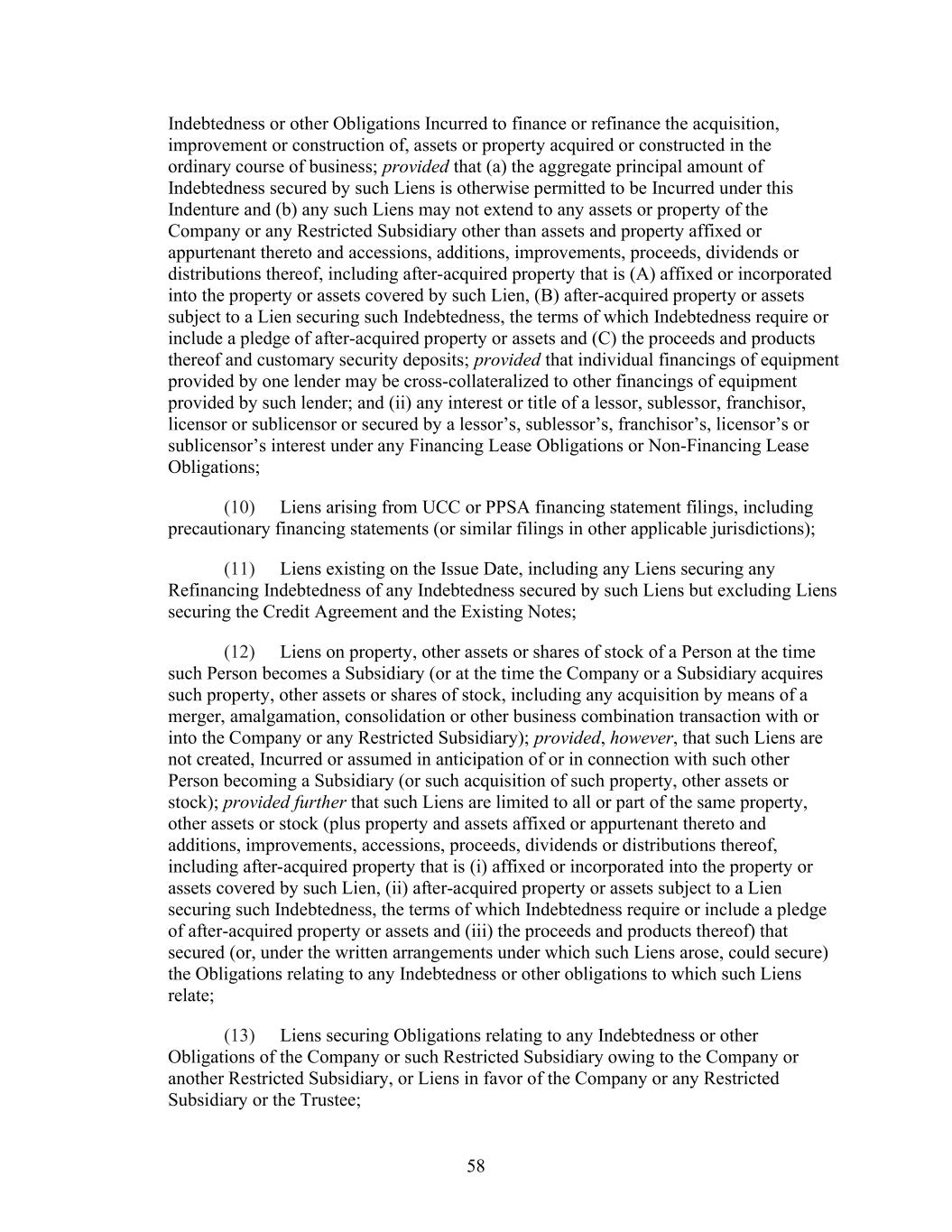
58 Indebtedness or other Obligations Incurred to finance or refinance the acquisition, improvement or construction of, assets or property acquired or constructed in the ordinary course of business; provided that (a) the aggregate principal amount of Indebtedness secured by such Liens is otherwise permitted to be Incurred under this Indenture and (b) any such Liens may not extend to any assets or property of the Company or any Restricted Subsidiary other than assets and property affixed or appurtenant thereto and accessions, additions, improvements, proceeds, dividends or distributions thereof, including after-acquired property that is (A) affixed or incorporated into the property or assets covered by such Lien, (B) after-acquired property or assets subject to a Lien securing such Indebtedness, the terms of which Indebtedness require or include a pledge of after-acquired property or assets and (C) the proceeds and products thereof and customary security deposits; provided that individual financings of equipment provided by one lender may be cross-collateralized to other financings of equipment provided by such lender; and (ii) any interest or title of a lessor, sublessor, franchisor, licensor or sublicensor or secured by a lessor’s, sublessor’s, franchisor’s, licensor’s or sublicensor’s interest under any Financing Lease Obligations or Non-Financing Lease Obligations; (10) Liens arising from UCC or PPSA financing statement filings, including precautionary financing statements (or similar filings in other applicable jurisdictions); (11) Liens existing on the Issue Date, including any Liens securing any Refinancing Indebtedness of any Indebtedness secured by such Liens but excluding Liens securing the Credit Agreement and the Existing Notes; (12) Liens on property, other assets or shares of stock of a Person at the time such Person becomes a Subsidiary (or at the time the Company or a Subsidiary acquires such property, other assets or shares of stock, including any acquisition by means of a merger, amalgamation, consolidation or other business combination transaction with or into the Company or any Restricted Subsidiary); provided, however, that such Liens are not created, Incurred or assumed in anticipation of or in connection with such other Person becoming a Subsidiary (or such acquisition of such property, other assets or stock); provided further that such Liens are limited to all or part of the same property, other assets or stock (plus property and assets affixed or appurtenant thereto and additions, improvements, accessions, proceeds, dividends or distributions thereof, including after-acquired property that is (i) affixed or incorporated into the property or assets covered by such Lien, (ii) after-acquired property or assets subject to a Lien securing such Indebtedness, the terms of which Indebtedness require or include a pledge of after-acquired property or assets and (iii) the proceeds and products thereof) that secured (or, under the written arrangements under which such Liens arose, could secure) the Obligations relating to any Indebtedness or other obligations to which such Liens relate; (13) Liens securing Obligations relating to any Indebtedness or other Obligations of the Company or such Restricted Subsidiary owing to the Company or another Restricted Subsidiary, or Liens in favor of the Company or any Restricted Subsidiary or the Trustee;
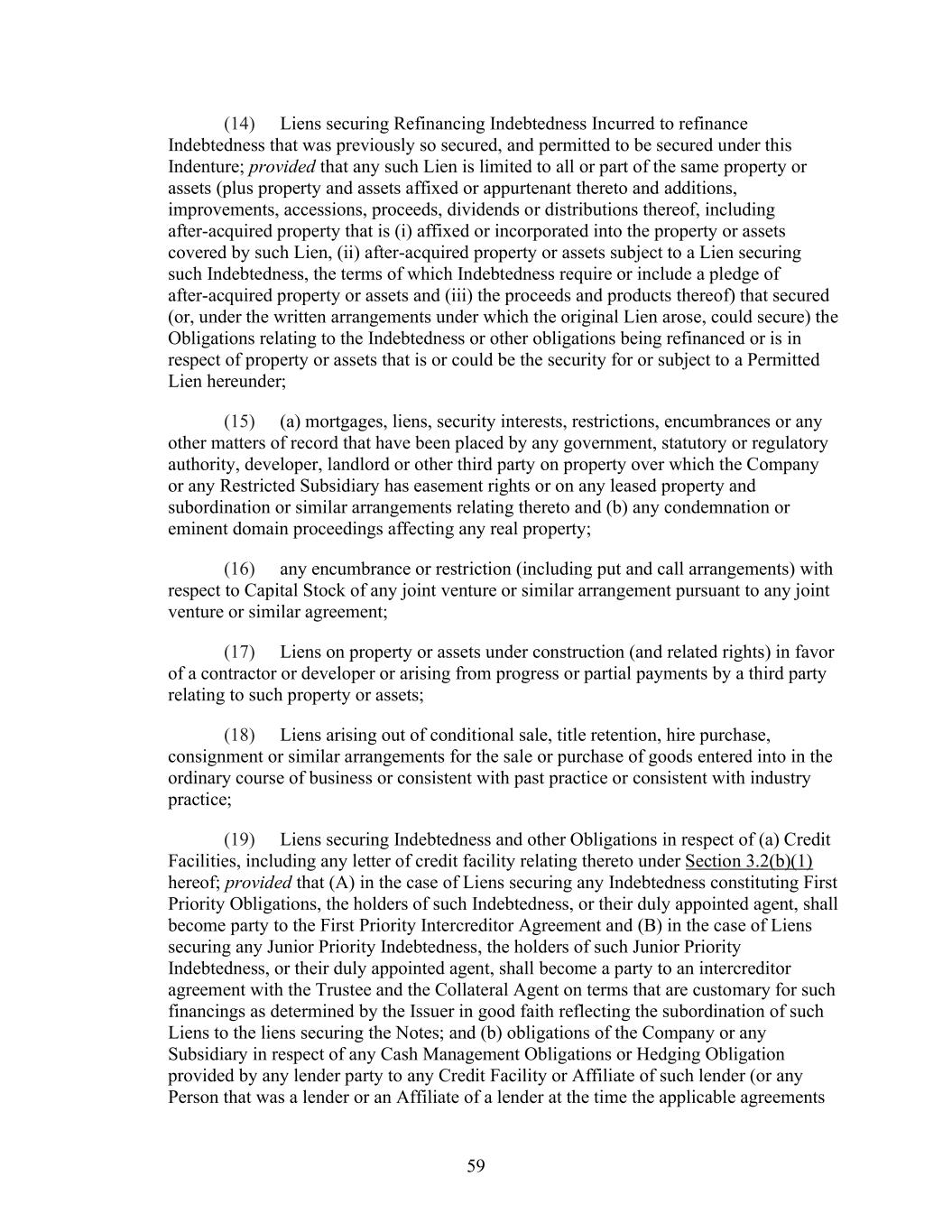
59 (14) Liens securing Refinancing Indebtedness Incurred to refinance Indebtedness that was previously so secured, and permitted to be secured under this Indenture; provided that any such Lien is limited to all or part of the same property or assets (plus property and assets affixed or appurtenant thereto and additions, improvements, accessions, proceeds, dividends or distributions thereof, including after-acquired property that is (i) affixed or incorporated into the property or assets covered by such Lien, (ii) after-acquired property or assets subject to a Lien securing such Indebtedness, the terms of which Indebtedness require or include a pledge of after-acquired property or assets and (iii) the proceeds and products thereof) that secured (or, under the written arrangements under which the original Lien arose, could secure) the Obligations relating to the Indebtedness or other obligations being refinanced or is in respect of property or assets that is or could be the security for or subject to a Permitted Lien hereunder; (15) (a) mortgages, liens, security interests, restrictions, encumbrances or any other matters of record that have been placed by any government, statutory or regulatory authority, developer, landlord or other third party on property over which the Company or any Restricted Subsidiary has easement rights or on any leased property and subordination or similar arrangements relating thereto and (b) any condemnation or eminent domain proceedings affecting any real property; (16) any encumbrance or restriction (including put and call arrangements) with respect to Capital Stock of any joint venture or similar arrangement pursuant to any joint venture or similar agreement; (17) Liens on property or assets under construction (and related rights) in favor of a contractor or developer or arising from progress or partial payments by a third party relating to such property or assets; (18) Liens arising out of conditional sale, title retention, hire purchase, consignment or similar arrangements for the sale or purchase of goods entered into in the ordinary course of business or consistent with past practice or consistent with industry practice; (19) Liens securing Indebtedness and other Obligations in respect of (a) Credit Facilities, including any letter of credit facility relating thereto under Section 3.2(b)(1) hereof; provided that (A) in the case of Liens securing any Indebtedness constituting First Priority Obligations, the holders of such Indebtedness, or their duly appointed agent, shall become party to the First Priority Intercreditor Agreement and (B) in the case of Liens securing any Junior Priority Indebtedness, the holders of such Junior Priority Indebtedness, or their duly appointed agent, shall become a party to an intercreditor agreement with the Trustee and the Collateral Agent on terms that are customary for such financings as determined by the Issuer in good faith reflecting the subordination of such Liens to the liens securing the Notes; and (b) obligations of the Company or any Subsidiary in respect of any Cash Management Obligations or Hedging Obligation provided by any lender party to any Credit Facility or Affiliate of such lender (or any Person that was a lender or an Affiliate of a lender at the time the applicable agreements
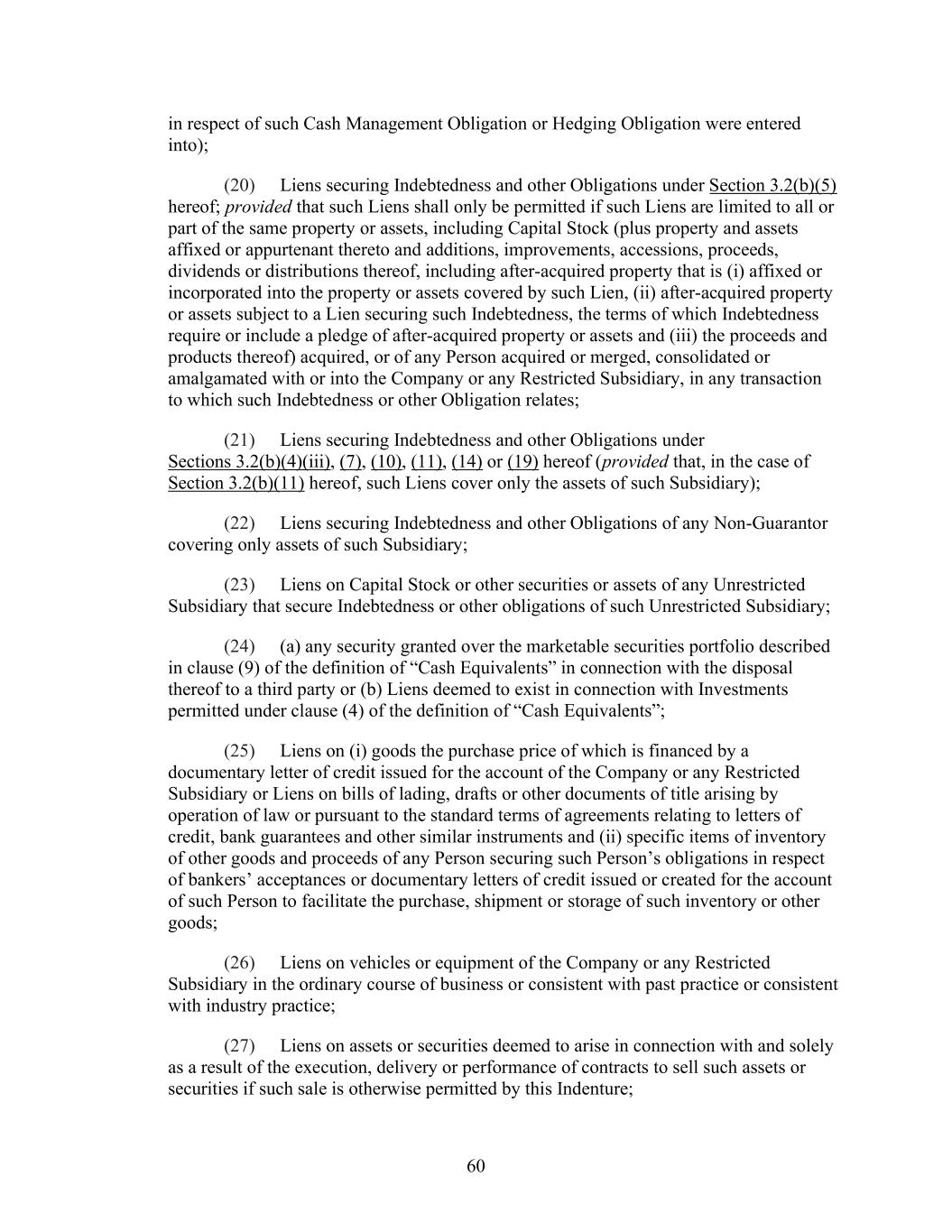
60 in respect of such Cash Management Obligation or Hedging Obligation were entered into); (20) Liens securing Indebtedness and other Obligations under Section 3.2(b)(5) hereof; provided that such Liens shall only be permitted if such Liens are limited to all or part of the same property or assets, including Capital Stock (plus property and assets affixed or appurtenant thereto and additions, improvements, accessions, proceeds, dividends or distributions thereof, including after-acquired property that is (i) affixed or incorporated into the property or assets covered by such Lien, (ii) after-acquired property or assets subject to a Lien securing such Indebtedness, the terms of which Indebtedness require or include a pledge of after-acquired property or assets and (iii) the proceeds and products thereof) acquired, or of any Person acquired or merged, consolidated or amalgamated with or into the Company or any Restricted Subsidiary, in any transaction to which such Indebtedness or other Obligation relates; (21) Liens securing Indebtedness and other Obligations under Sections 3.2(b)(4)(iii), (7), (10), (11), (14) or (19) hereof (provided that, in the case of Section 3.2(b)(11) hereof, such Liens cover only the assets of such Subsidiary); (22) Liens securing Indebtedness and other Obligations of any Non-Guarantor covering only assets of such Subsidiary; (23) Liens on Capital Stock or other securities or assets of any Unrestricted Subsidiary that secure Indebtedness or other obligations of such Unrestricted Subsidiary; (24) (a) any security granted over the marketable securities portfolio described in clause (9) of the definition of “Cash Equivalents” in connection with the disposal thereof to a third party or (b) Liens deemed to exist in connection with Investments permitted under clause (4) of the definition of “Cash Equivalents”; (25) Liens on (i) goods the purchase price of which is financed by a documentary letter of credit issued for the account of the Company or any Restricted Subsidiary or Liens on bills of lading, drafts or other documents of title arising by operation of law or pursuant to the standard terms of agreements relating to letters of credit, bank guarantees and other similar instruments and (ii) specific items of inventory of other goods and proceeds of any Person securing such Person’s obligations in respect of bankers’ acceptances or documentary letters of credit issued or created for the account of such Person to facilitate the purchase, shipment or storage of such inventory or other goods; (26) Liens on vehicles or equipment of the Company or any Restricted Subsidiary in the ordinary course of business or consistent with past practice or consistent with industry practice; (27) Liens on assets or securities deemed to arise in connection with and solely as a result of the execution, delivery or performance of contracts to sell such assets or securities if such sale is otherwise permitted by this Indenture;
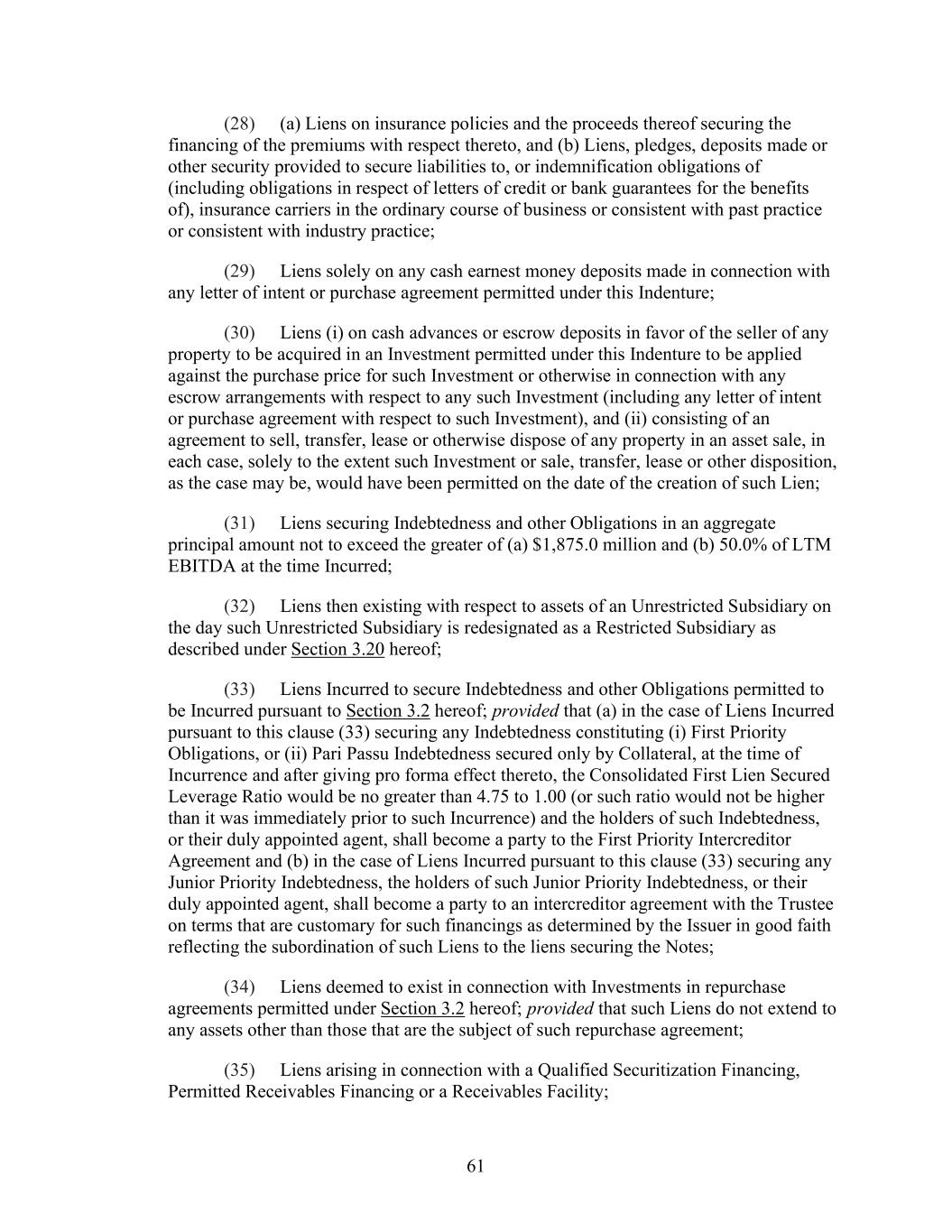
61 (28) (a) Liens on insurance policies and the proceeds thereof securing the financing of the premiums with respect thereto, and (b) Liens, pledges, deposits made or other security provided to secure liabilities to, or indemnification obligations of (including obligations in respect of letters of credit or bank guarantees for the benefits of), insurance carriers in the ordinary course of business or consistent with past practice or consistent with industry practice; (29) Liens solely on any xxxx xxxxxxx money deposits made in connection with any letter of intent or purchase agreement permitted under this Indenture; (30) Liens (i) on cash advances or escrow deposits in favor of the seller of any property to be acquired in an Investment permitted under this Indenture to be applied against the purchase price for such Investment or otherwise in connection with any escrow arrangements with respect to any such Investment (including any letter of intent or purchase agreement with respect to such Investment), and (ii) consisting of an agreement to sell, transfer, lease or otherwise dispose of any property in an asset sale, in each case, solely to the extent such Investment or sale, transfer, lease or other disposition, as the case may be, would have been permitted on the date of the creation of such Lien; (31) Liens securing Indebtedness and other Obligations in an aggregate principal amount not to exceed the greater of (a) $1,875.0 million and (b) 50.0% of LTM EBITDA at the time Incurred; (32) Liens then existing with respect to assets of an Unrestricted Subsidiary on the day such Unrestricted Subsidiary is redesignated as a Restricted Subsidiary as described under Section 3.20 hereof; (33) Liens Incurred to secure Indebtedness and other Obligations permitted to be Incurred pursuant to Section 3.2 hereof; provided that (a) in the case of Liens Incurred pursuant to this clause (33) securing any Indebtedness constituting (i) First Priority Obligations, or (ii) Pari Passu Indebtedness secured only by Collateral, at the time of Incurrence and after giving pro forma effect thereto, the Consolidated First Lien Secured Leverage Ratio would be no greater than 4.75 to 1.00 (or such ratio would not be higher than it was immediately prior to such Incurrence) and the holders of such Indebtedness, or their duly appointed agent, shall become a party to the First Priority Intercreditor Agreement and (b) in the case of Liens Incurred pursuant to this clause (33) securing any Junior Priority Indebtedness, the holders of such Junior Priority Indebtedness, or their duly appointed agent, shall become a party to an intercreditor agreement with the Trustee on terms that are customary for such financings as determined by the Issuer in good faith reflecting the subordination of such Liens to the liens securing the Notes; (34) Liens deemed to exist in connection with Investments in repurchase agreements permitted under Section 3.2 hereof; provided that such Liens do not extend to any assets other than those that are the subject of such repurchase agreement; (35) Liens arising in connection with a Qualified Securitization Financing, Permitted Receivables Financing or a Receivables Facility;
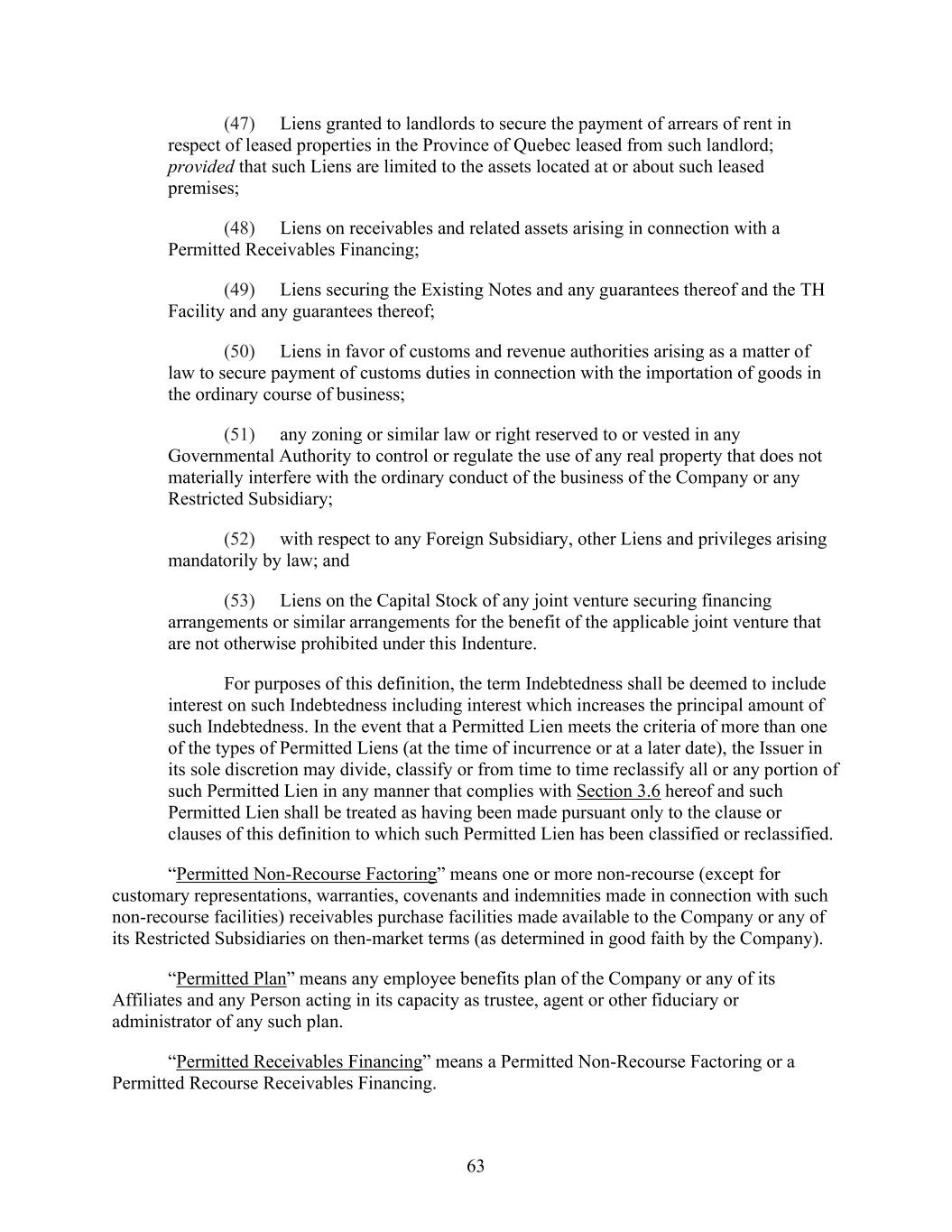
63 (47) Liens granted to landlords to secure the payment of arrears of rent in respect of leased properties in the Province of Quebec leased from such landlord; provided that such Liens are limited to the assets located at or about such leased premises; (48) Liens on receivables and related assets arising in connection with a Permitted Receivables Financing; (49) Liens securing the Existing Notes and any guarantees thereof and the TH Facility and any guarantees thereof; (50) Liens in favor of customs and revenue authorities arising as a matter of law to secure payment of customs duties in connection with the importation of goods in the ordinary course of business; (51) any zoning or similar law or right reserved to or vested in any Governmental Authority to control or regulate the use of any real property that does not materially interfere with the ordinary conduct of the business of the Company or any Restricted Subsidiary; (52) with respect to any Foreign Subsidiary, other Liens and privileges arising mandatorily by law; and (53) Liens on the Capital Stock of any joint venture securing financing arrangements or similar arrangements for the benefit of the applicable joint venture that are not otherwise prohibited under this Indenture. For purposes of this definition, the term Indebtedness shall be deemed to include interest on such Indebtedness including interest which increases the principal amount of such Indebtedness. In the event that a Permitted Lien meets the criteria of more than one of the types of Permitted Liens (at the time of incurrence or at a later date), the Issuer in its sole discretion may divide, classify or from time to time reclassify all or any portion of such Permitted Lien in any manner that complies with Section 3.6 hereof and such Permitted Lien shall be treated as having been made pursuant only to the clause or clauses of this definition to which such Permitted Lien has been classified or reclassified. “Permitted Non-Recourse Factoring” means one or more non-recourse (except for customary representations, warranties, covenants and indemnities made in connection with such non-recourse facilities) receivables purchase facilities made available to the Company or any of its Restricted Subsidiaries on then-market terms (as determined in good faith by the Company). “Permitted Plan” means any employee benefits plan of the Company or any of its Affiliates and any Person acting in its capacity as trustee, agent or other fiduciary or administrator of any such plan. “Permitted Receivables Financing” means a Permitted Non-Recourse Factoring or a Permitted Recourse Receivables Financing.
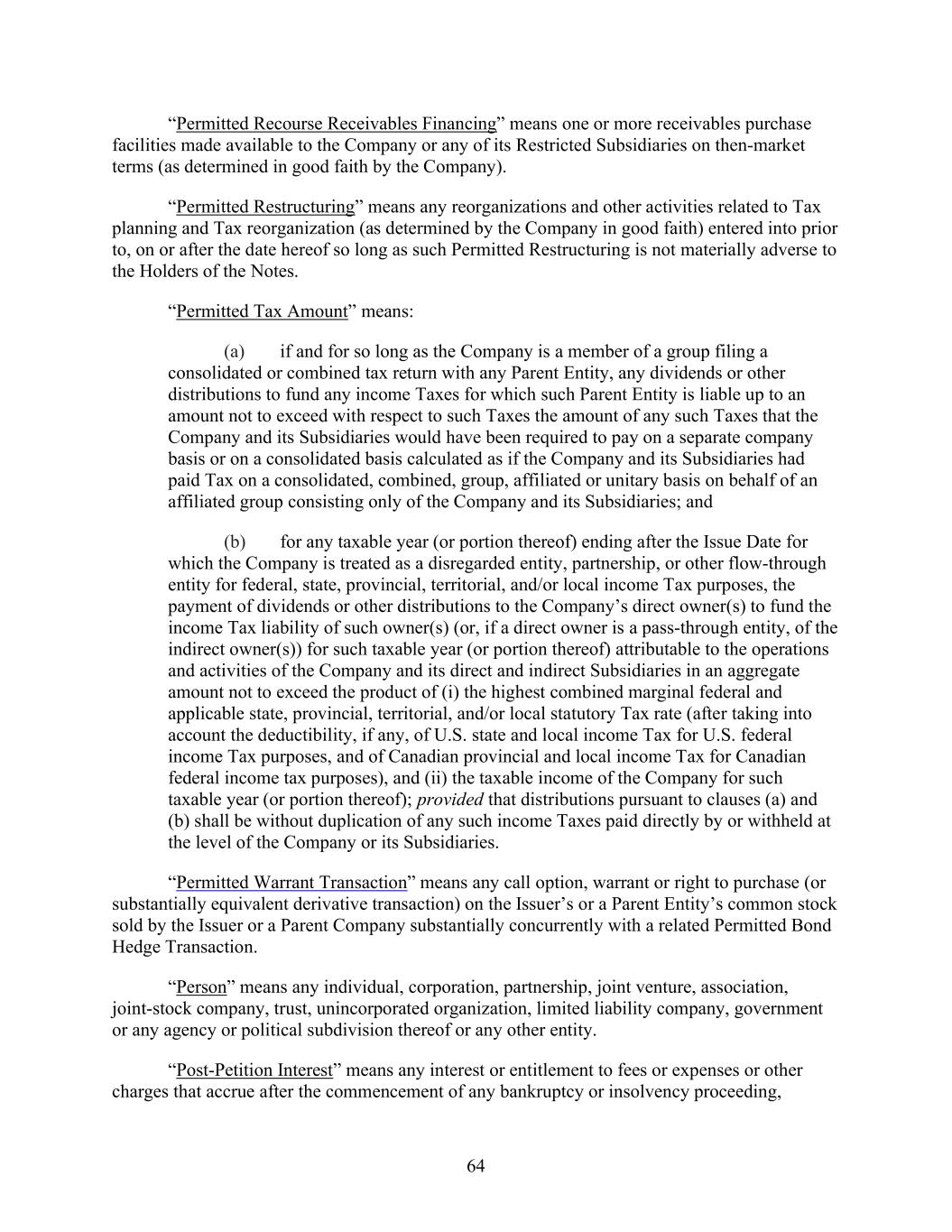
64 “Permitted Recourse Receivables Financing” means one or more receivables purchase facilities made available to the Company or any of its Restricted Subsidiaries on then-market terms (as determined in good faith by the Company). “Permitted Restructuring” means any reorganizations and other activities related to Tax planning and Tax reorganization (as determined by the Company in good faith) entered into prior to, on or after the date hereof so long as such Permitted Restructuring is not materially adverse to the Holders of the Notes. “Permitted Tax Amount” means: (a) if and for so long as the Company is a member of a group filing a consolidated or combined tax return with any Parent Entity, any dividends or other distributions to fund any income Taxes for which such Parent Entity is liable up to an amount not to exceed with respect to such Taxes the amount of any such Taxes that the Company and its Subsidiaries would have been required to pay on a separate company basis or on a consolidated basis calculated as if the Company and its Subsidiaries had paid Tax on a consolidated, combined, group, affiliated or unitary basis on behalf of an affiliated group consisting only of the Company and its Subsidiaries; and (b) for any taxable year (or portion thereof) ending after the Issue Date for which the Company is treated as a disregarded entity, partnership, or other flow-through entity for federal, state, provincial, territorial, and/or local income Tax purposes, the payment of dividends or other distributions to the Company’s direct owner(s) to fund the income Tax liability of such owner(s) (or, if a direct owner is a pass-through entity, of the indirect owner(s)) for such taxable year (or portion thereof) attributable to the operations and activities of the Company and its direct and indirect Subsidiaries in an aggregate amount not to exceed the product of (i) the highest combined marginal federal and applicable state, provincial, territorial, and/or local statutory Tax rate (after taking into account the deductibility, if any, of U.S. state and local income Tax for U.S. federal income Tax purposes, and of Canadian provincial and local income Tax for Canadian federal income tax purposes), and (ii) the taxable income of the Company for such taxable year (or portion thereof); provided that distributions pursuant to clauses (a) and (b) shall be without duplication of any such income Taxes paid directly by or withheld at the level of the Company or its Subsidiaries. “Permitted Warrant Transaction” means any call option, warrant or right to purchase (or substantially equivalent derivative transaction) on the Issuer’s or a Parent Entity’s common stock sold by the Issuer or a Parent Company substantially concurrently with a related Permitted Bond Hedge Transaction. “Person” means any individual, corporation, partnership, joint venture, association, joint-stock company, trust, unincorporated organization, limited liability company, government or any agency or political subdivision thereof or any other entity. “Post-Petition Interest” means any interest or entitlement to fees or expenses or other charges that accrue after the commencement of any bankruptcy or insolvency proceeding,
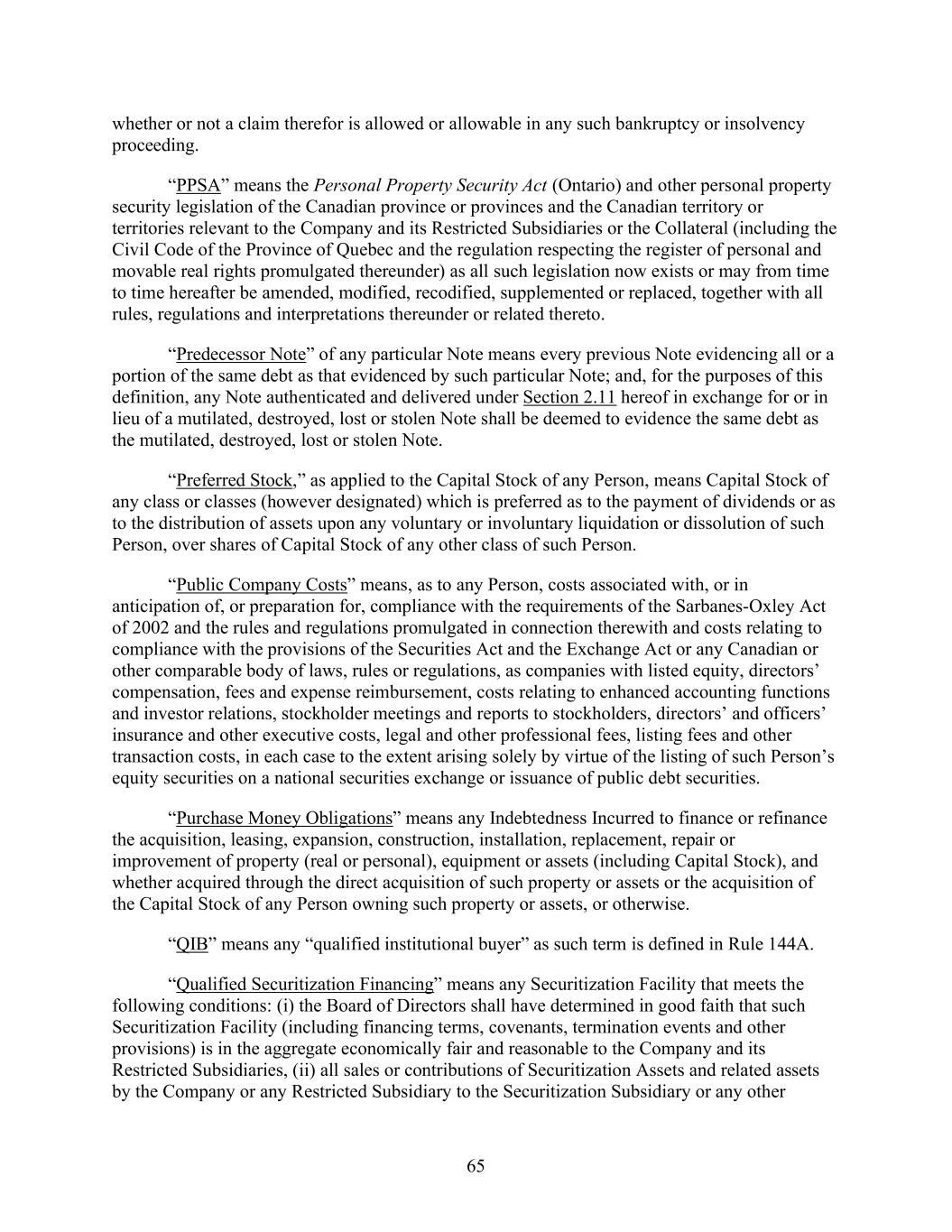
65 whether or not a claim therefor is allowed or allowable in any such bankruptcy or insolvency proceeding. “PPSA” means the Personal Property Security Act (Ontario) and other personal property security legislation of the Canadian province or provinces and the Canadian territory or territories relevant to the Company and its Restricted Subsidiaries or the Collateral (including the Civil Code of the Province of Quebec and the regulation respecting the register of personal and movable real rights promulgated thereunder) as all such legislation now exists or may from time to time hereafter be amended, modified, recodified, supplemented or replaced, together with all rules, regulations and interpretations thereunder or related thereto. “Predecessor Note” of any particular Note means every previous Note evidencing all or a portion of the same debt as that evidenced by such particular Note; and, for the purposes of this definition, any Note authenticated and delivered under Section 2.11 hereof in exchange for or in lieu of a mutilated, destroyed, lost or stolen Note shall be deemed to evidence the same debt as the mutilated, destroyed, lost or stolen Note. “Preferred Stock,” as applied to the Capital Stock of any Person, means Capital Stock of any class or classes (however designated) which is preferred as to the payment of dividends or as to the distribution of assets upon any voluntary or involuntary liquidation or dissolution of such Person, over shares of Capital Stock of any other class of such Person. “Public Company Costs” means, as to any Person, costs associated with, or in anticipation of, or preparation for, compliance with the requirements of the Xxxxxxxx-Xxxxx Act of 2002 and the rules and regulations promulgated in connection therewith and costs relating to compliance with the provisions of the Securities Act and the Exchange Act or any Canadian or other comparable body of laws, rules or regulations, as companies with listed equity, directors’ compensation, fees and expense reimbursement, costs relating to enhanced accounting functions and investor relations, stockholder meetings and reports to stockholders, directors’ and officers’ insurance and other executive costs, legal and other professional fees, listing fees and other transaction costs, in each case to the extent arising solely by virtue of the listing of such Person’s equity securities on a national securities exchange or issuance of public debt securities. “Purchase Money Obligations” means any Indebtedness Incurred to finance or refinance the acquisition, leasing, expansion, construction, installation, replacement, repair or improvement of property (real or personal), equipment or assets (including Capital Stock), and whether acquired through the direct acquisition of such property or assets or the acquisition of the Capital Stock of any Person owning such property or assets, or otherwise. “QIB” means any “qualified institutional buyer” as such term is defined in Rule 144A. “Qualified Securitization Financing” means any Securitization Facility that meets the following conditions: (i) the Board of Directors shall have determined in good faith that such Securitization Facility (including financing terms, covenants, termination events and other provisions) is in the aggregate economically fair and reasonable to the Company and its Restricted Subsidiaries, (ii) all sales or contributions of Securitization Assets and related assets by the Company or any Restricted Subsidiary to the Securitization Subsidiary or any other
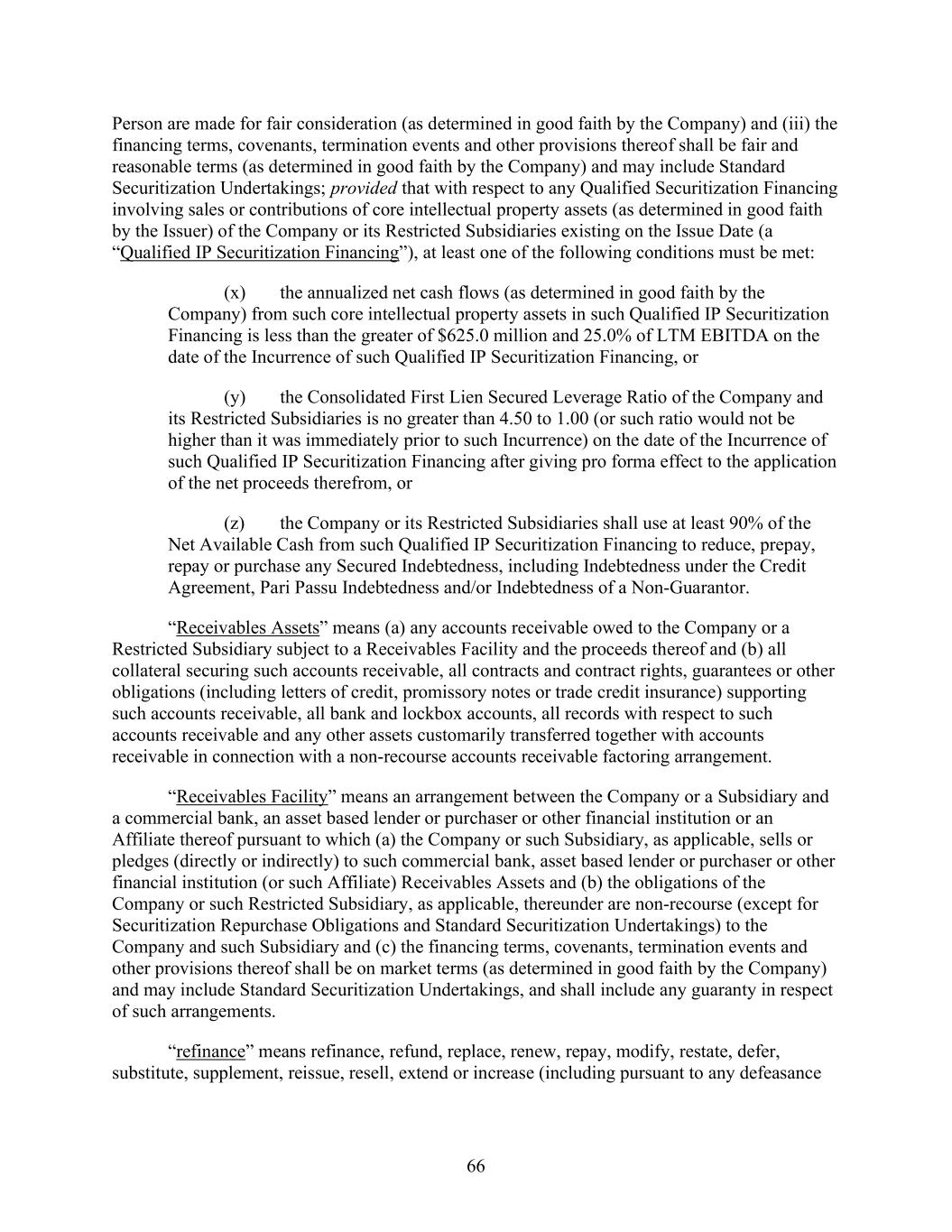
66 Person are made for fair consideration (as determined in good faith by the Company) and (iii) the financing terms, covenants, termination events and other provisions thereof shall be fair and reasonable terms (as determined in good faith by the Company) and may include Standard Securitization Undertakings; provided that with respect to any Qualified Securitization Financing involving sales or contributions of core intellectual property assets (as determined in good faith by the Issuer) of the Company or its Restricted Subsidiaries existing on the Issue Date (a “Qualified IP Securitization Financing”), at least one of the following conditions must be met: (x) the annualized net cash flows (as determined in good faith by the Company) from such core intellectual property assets in such Qualified IP Securitization Financing is less than the greater of $625.0 million and 25.0% of LTM EBITDA on the date of the Incurrence of such Qualified IP Securitization Financing, or (y) the Consolidated First Lien Secured Leverage Ratio of the Company and its Restricted Subsidiaries is no greater than 4.50 to 1.00 (or such ratio would not be higher than it was immediately prior to such Incurrence) on the date of the Incurrence of such Qualified IP Securitization Financing after giving pro forma effect to the application of the net proceeds therefrom, or (z) the Company or its Restricted Subsidiaries shall use at least 90% of the Net Available Cash from such Qualified IP Securitization Financing to reduce, prepay, repay or purchase any Secured Indebtedness, including Indebtedness under the Credit Agreement, Pari Passu Indebtedness and/or Indebtedness of a Non-Guarantor. “Receivables Assets” means (a) any accounts receivable owed to the Company or a Restricted Subsidiary subject to a Receivables Facility and the proceeds thereof and (b) all collateral securing such accounts receivable, all contracts and contract rights, guarantees or other obligations (including letters of credit, promissory notes or trade credit insurance) supporting such accounts receivable, all bank and lockbox accounts, all records with respect to such accounts receivable and any other assets customarily transferred together with accounts receivable in connection with a non-recourse accounts receivable factoring arrangement. “Receivables Facility” means an arrangement between the Company or a Subsidiary and a commercial bank, an asset based lender or purchaser or other financial institution or an Affiliate thereof pursuant to which (a) the Company or such Subsidiary, as applicable, sells or pledges (directly or indirectly) to such commercial bank, asset based lender or purchaser or other financial institution (or such Affiliate) Receivables Assets and (b) the obligations of the Company or such Restricted Subsidiary, as applicable, thereunder are non-recourse (except for Securitization Repurchase Obligations and Standard Securitization Undertakings) to the Company and such Subsidiary and (c) the financing terms, covenants, termination events and other provisions thereof shall be on market terms (as determined in good faith by the Company) and may include Standard Securitization Undertakings, and shall include any guaranty in respect of such arrangements. “refinance” means refinance, refund, replace, renew, repay, modify, restate, defer, substitute, supplement, reissue, resell, extend or increase (including pursuant to any defeasance
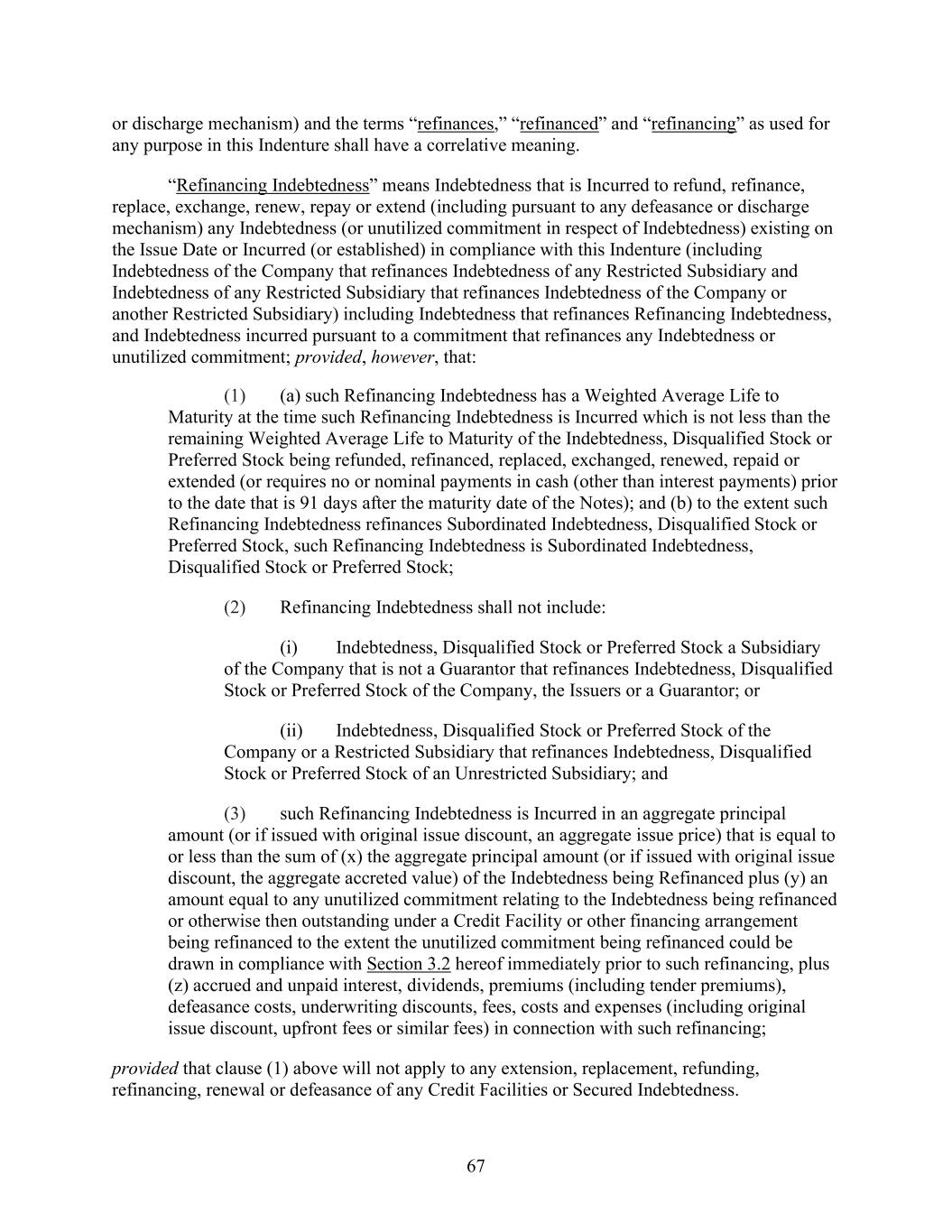
67 or discharge mechanism) and the terms “refinances,” “refinanced” and “refinancing” as used for any purpose in this Indenture shall have a correlative meaning. “Refinancing Indebtedness” means Indebtedness that is Incurred to refund, refinance, replace, exchange, renew, repay or extend (including pursuant to any defeasance or discharge mechanism) any Indebtedness (or unutilized commitment in respect of Indebtedness) existing on the Issue Date or Incurred (or established) in compliance with this Indenture (including Indebtedness of the Company that refinances Indebtedness of any Restricted Subsidiary and Indebtedness of any Restricted Subsidiary that refinances Indebtedness of the Company or another Restricted Subsidiary) including Indebtedness that refinances Refinancing Indebtedness, and Indebtedness incurred pursuant to a commitment that refinances any Indebtedness or unutilized commitment; provided, however, that: (1) (a) such Refinancing Indebtedness has a Weighted Average Life to Maturity at the time such Refinancing Indebtedness is Incurred which is not less than the remaining Weighted Average Life to Maturity of the Indebtedness, Disqualified Stock or Preferred Stock being refunded, refinanced, replaced, exchanged, renewed, repaid or extended (or requires no or nominal payments in cash (other than interest payments) prior to the date that is 91 days after the maturity date of the Notes); and (b) to the extent such Refinancing Indebtedness refinances Subordinated Indebtedness, Disqualified Stock or Preferred Stock, such Refinancing Indebtedness is Subordinated Indebtedness, Disqualified Stock or Preferred Stock; (2) Refinancing Indebtedness shall not include: (i) Indebtedness, Disqualified Stock or Preferred Stock a Subsidiary of the Company that is not a Guarantor that refinances Indebtedness, Disqualified Stock or Preferred Stock of the Company, the Issuers or a Guarantor; or (ii) Indebtedness, Disqualified Stock or Preferred Stock of the Company or a Restricted Subsidiary that refinances Indebtedness, Disqualified Stock or Preferred Stock of an Unrestricted Subsidiary; and (3) such Refinancing Indebtedness is Incurred in an aggregate principal amount (or if issued with original issue discount, an aggregate issue price) that is equal to or less than the sum of (x) the aggregate principal amount (or if issued with original issue discount, the aggregate accreted value) of the Indebtedness being Refinanced plus (y) an amount equal to any unutilized commitment relating to the Indebtedness being refinanced or otherwise then outstanding under a Credit Facility or other financing arrangement being refinanced to the extent the unutilized commitment being refinanced could be drawn in compliance with Section 3.2 hereof immediately prior to such refinancing, plus (z) accrued and unpaid interest, dividends, premiums (including tender premiums), defeasance costs, underwriting discounts, fees, costs and expenses (including original issue discount, upfront fees or similar fees) in connection with such refinancing; provided that clause (1) above will not apply to any extension, replacement, refunding, refinancing, renewal or defeasance of any Credit Facilities or Secured Indebtedness.
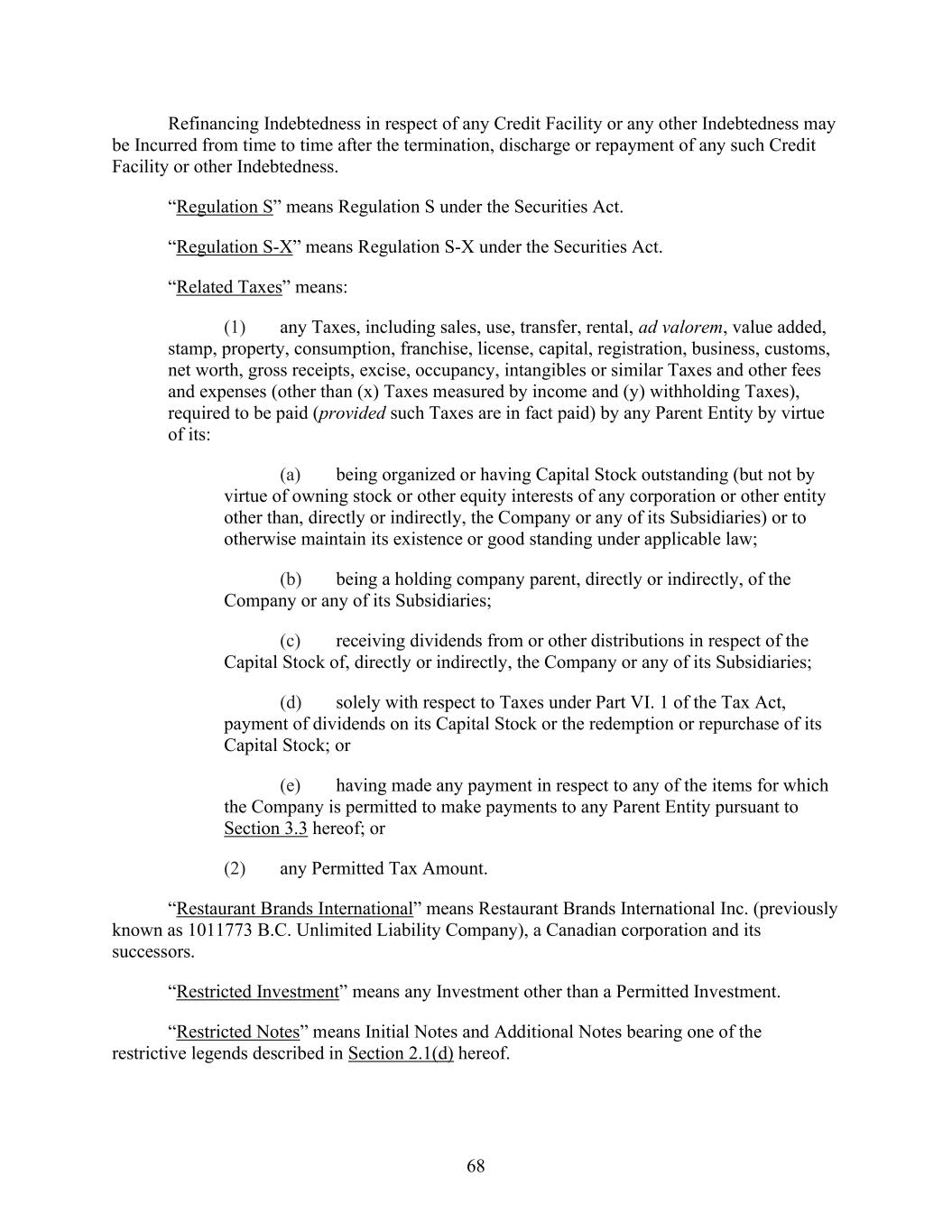
68 Refinancing Indebtedness in respect of any Credit Facility or any other Indebtedness may be Incurred from time to time after the termination, discharge or repayment of any such Credit Facility or other Indebtedness. “Regulation S” means Regulation S under the Securities Act. “Regulation S-X” means Regulation S-X under the Securities Act. “Related Taxes” means: (1) any Taxes, including sales, use, transfer, rental, ad valorem, value added, stamp, property, consumption, franchise, license, capital, registration, business, customs, net worth, gross receipts, excise, occupancy, intangibles or similar Taxes and other fees and expenses (other than (x) Taxes measured by income and (y) withholding Taxes), required to be paid (provided such Taxes are in fact paid) by any Parent Entity by virtue of its: (a) being organized or having Capital Stock outstanding (but not by virtue of owning stock or other equity interests of any corporation or other entity other than, directly or indirectly, the Company or any of its Subsidiaries) or to otherwise maintain its existence or good standing under applicable law; (b) being a holding company parent, directly or indirectly, of the Company or any of its Subsidiaries; (c) receiving dividends from or other distributions in respect of the Capital Stock of, directly or indirectly, the Company or any of its Subsidiaries; (d) solely with respect to Taxes under Part VI. 1 of the Tax Act, payment of dividends on its Capital Stock or the redemption or repurchase of its Capital Stock; or (e) having made any payment in respect to any of the items for which the Company is permitted to make payments to any Parent Entity pursuant to Section 3.3 hereof; or (2) any Permitted Tax Amount. “Restaurant Brands International” means Restaurant Brands International Inc. (previously known as 1011773 B.C. Unlimited Liability Company), a Canadian corporation and its successors. “Restricted Investment” means any Investment other than a Permitted Investment. “Restricted Notes” means Initial Notes and Additional Notes bearing one of the restrictive legends described in Section 2.1(d) hereof.
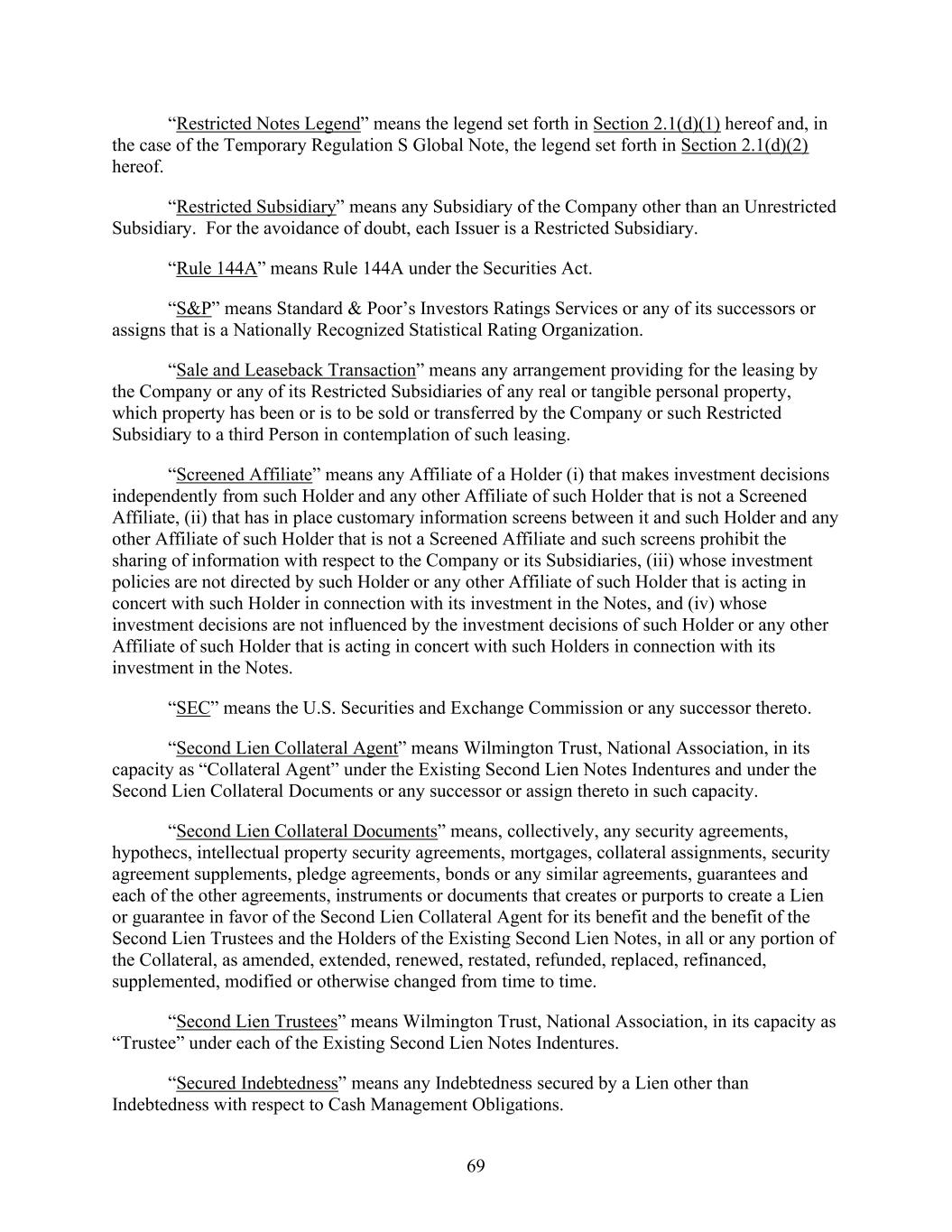
69 “Restricted Notes Legend” means the legend set forth in Section 2.1(d)(1) hereof and, in the case of the Temporary Regulation S Global Note, the legend set forth in Section 2.1(d)(2) hereof. “Restricted Subsidiary” means any Subsidiary of the Company other than an Unrestricted Subsidiary. For the avoidance of doubt, each Issuer is a Restricted Subsidiary. “Rule 144A” means Rule 144A under the Securities Act. “S&P” means Standard & Poor’s Investors Ratings Services or any of its successors or assigns that is a Nationally Recognized Statistical Rating Organization. “Sale and Leaseback Transaction” means any arrangement providing for the leasing by the Company or any of its Restricted Subsidiaries of any real or tangible personal property, which property has been or is to be sold or transferred by the Company or such Restricted Subsidiary to a third Person in contemplation of such leasing. “Screened Affiliate” means any Affiliate of a Holder (i) that makes investment decisions independently from such Holder and any other Affiliate of such Holder that is not a Screened Affiliate, (ii) that has in place customary information screens between it and such Holder and any other Affiliate of such Holder that is not a Screened Affiliate and such screens prohibit the sharing of information with respect to the Company or its Subsidiaries, (iii) whose investment policies are not directed by such Holder or any other Affiliate of such Holder that is acting in concert with such Holder in connection with its investment in the Notes, and (iv) whose investment decisions are not influenced by the investment decisions of such Holder or any other Affiliate of such Holder that is acting in concert with such Holders in connection with its investment in the Notes. “SEC” means the U.S. Securities and Exchange Commission or any successor thereto. “Second Lien Collateral Agent” means Wilmington Trust, National Association, in its capacity as “Collateral Agent” under the Existing Second Lien Notes Indentures and under the Second Lien Collateral Documents or any successor or assign thereto in such capacity. “Second Lien Collateral Documents” means, collectively, any security agreements, hypothecs, intellectual property security agreements, mortgages, collateral assignments, security agreement supplements, pledge agreements, bonds or any similar agreements, guarantees and each of the other agreements, instruments or documents that creates or purports to create a Lien or guarantee in favor of the Second Lien Collateral Agent for its benefit and the benefit of the Second Lien Trustees and the Holders of the Existing Second Lien Notes, in all or any portion of the Collateral, as amended, extended, renewed, restated, refunded, replaced, refinanced, supplemented, modified or otherwise changed from time to time. “Second Lien Trustees” means Wilmington Trust, National Association, in its capacity as “Trustee” under each of the Existing Second Lien Notes Indentures. “Secured Indebtedness” means any Indebtedness secured by a Lien other than Indebtedness with respect to Cash Management Obligations.
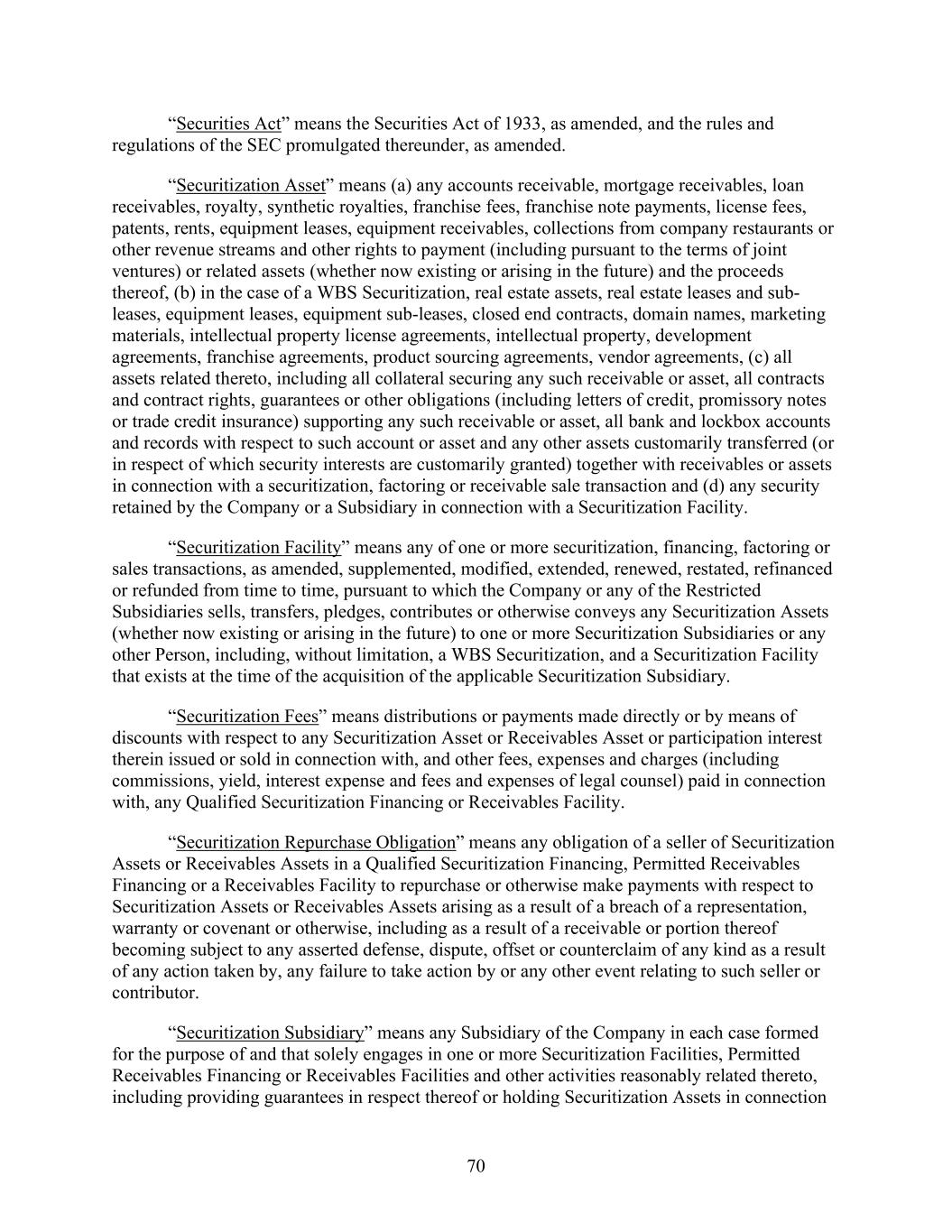
70 “Securities Act” means the Securities Act of 1933, as amended, and the rules and regulations of the SEC promulgated thereunder, as amended. “Securitization Asset” means (a) any accounts receivable, mortgage receivables, loan receivables, royalty, synthetic royalties, franchise fees, franchise note payments, license fees, patents, rents, equipment leases, equipment receivables, collections from company restaurants or other revenue streams and other rights to payment (including pursuant to the terms of joint ventures) or related assets (whether now existing or arising in the future) and the proceeds thereof, (b) in the case of a WBS Securitization, real estate assets, real estate leases and sub- leases, equipment leases, equipment sub-leases, closed end contracts, domain names, marketing materials, intellectual property license agreements, intellectual property, development agreements, franchise agreements, product sourcing agreements, vendor agreements, (c) all assets related thereto, including all collateral securing any such receivable or asset, all contracts and contract rights, guarantees or other obligations (including letters of credit, promissory notes or trade credit insurance) supporting any such receivable or asset, all bank and lockbox accounts and records with respect to such account or asset and any other assets customarily transferred (or in respect of which security interests are customarily granted) together with receivables or assets in connection with a securitization, factoring or receivable sale transaction and (d) any security retained by the Company or a Subsidiary in connection with a Securitization Facility. “Securitization Facility” means any of one or more securitization, financing, factoring or sales transactions, as amended, supplemented, modified, extended, renewed, restated, refinanced or refunded from time to time, pursuant to which the Company or any of the Restricted Subsidiaries sells, transfers, pledges, contributes or otherwise conveys any Securitization Assets (whether now existing or arising in the future) to one or more Securitization Subsidiaries or any other Person, including, without limitation, a WBS Securitization, and a Securitization Facility that exists at the time of the acquisition of the applicable Securitization Subsidiary. “Securitization Fees” means distributions or payments made directly or by means of discounts with respect to any Securitization Asset or Receivables Asset or participation interest therein issued or sold in connection with, and other fees, expenses and charges (including commissions, yield, interest expense and fees and expenses of legal counsel) paid in connection with, any Qualified Securitization Financing or Receivables Facility. “Securitization Repurchase Obligation” means any obligation of a seller of Securitization Assets or Receivables Assets in a Qualified Securitization Financing, Permitted Receivables Financing or a Receivables Facility to repurchase or otherwise make payments with respect to Securitization Assets or Receivables Assets arising as a result of a breach of a representation, warranty or covenant or otherwise, including as a result of a receivable or portion thereof becoming subject to any asserted defense, dispute, offset or counterclaim of any kind as a result of any action taken by, any failure to take action by or any other event relating to such seller or contributor. “Securitization Subsidiary” means any Subsidiary of the Company in each case formed for the purpose of and that solely engages in one or more Securitization Facilities, Permitted Receivables Financing or Receivables Facilities and other activities reasonably related thereto, including providing guarantees in respect thereof or holding Securitization Assets in connection
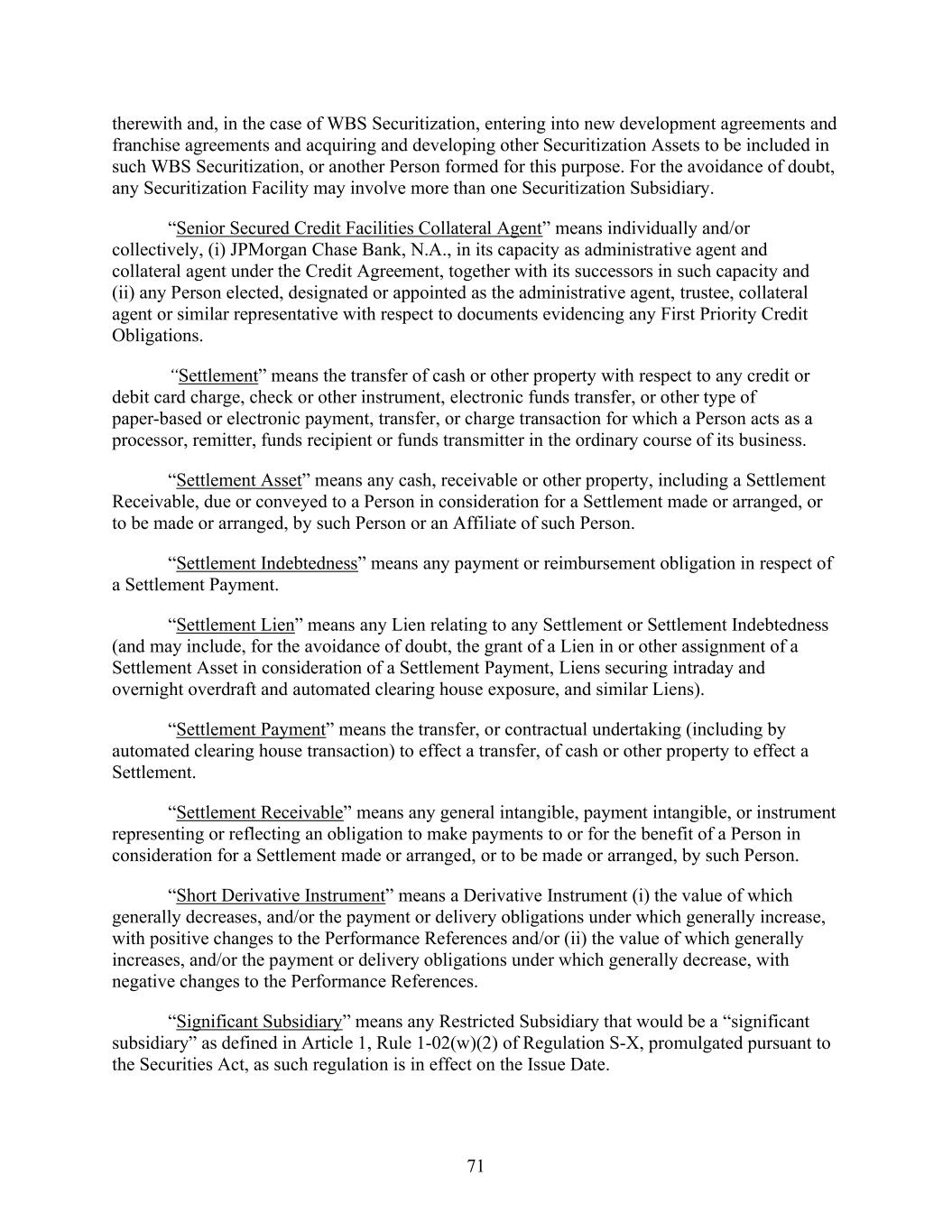
71 therewith and, in the case of WBS Securitization, entering into new development agreements and franchise agreements and acquiring and developing other Securitization Assets to be included in such WBS Securitization, or another Person formed for this purpose. For the avoidance of doubt, any Securitization Facility may involve more than one Securitization Subsidiary. “Senior Secured Credit Facilities Collateral Agent” means individually and/or collectively, (i) JPMorgan Chase Bank, N.A., in its capacity as administrative agent and collateral agent under the Credit Agreement, together with its successors in such capacity and (ii) any Person elected, designated or appointed as the administrative agent, trustee, collateral agent or similar representative with respect to documents evidencing any First Priority Credit Obligations. “Settlement” means the transfer of cash or other property with respect to any credit or debit card charge, check or other instrument, electronic funds transfer, or other type of paper-based or electronic payment, transfer, or charge transaction for which a Person acts as a processor, remitter, funds recipient or funds transmitter in the ordinary course of its business. “Settlement Asset” means any cash, receivable or other property, including a Settlement Receivable, due or conveyed to a Person in consideration for a Settlement made or arranged, or to be made or arranged, by such Person or an Affiliate of such Person. “Settlement Indebtedness” means any payment or reimbursement obligation in respect of a Settlement Payment. “Settlement Lien” means any Lien relating to any Settlement or Settlement Indebtedness (and may include, for the avoidance of doubt, the grant of a Lien in or other assignment of a Settlement Asset in consideration of a Settlement Payment, Liens securing intraday and overnight overdraft and automated clearing house exposure, and similar Liens). “Settlement Payment” means the transfer, or contractual undertaking (including by automated clearing house transaction) to effect a transfer, of cash or other property to effect a Settlement. “Settlement Receivable” means any general intangible, payment intangible, or instrument representing or reflecting an obligation to make payments to or for the benefit of a Person in consideration for a Settlement made or arranged, or to be made or arranged, by such Person. “Short Derivative Instrument” means a Derivative Instrument (i) the value of which generally decreases, and/or the payment or delivery obligations under which generally increase, with positive changes to the Performance References and/or (ii) the value of which generally increases, and/or the payment or delivery obligations under which generally decrease, with negative changes to the Performance References. “Significant Subsidiary” means any Restricted Subsidiary that would be a “significant subsidiary” as defined in Article 1, Rule 1-02(w)(2) of Regulation S-X, promulgated pursuant to the Securities Act, as such regulation is in effect on the Issue Date.
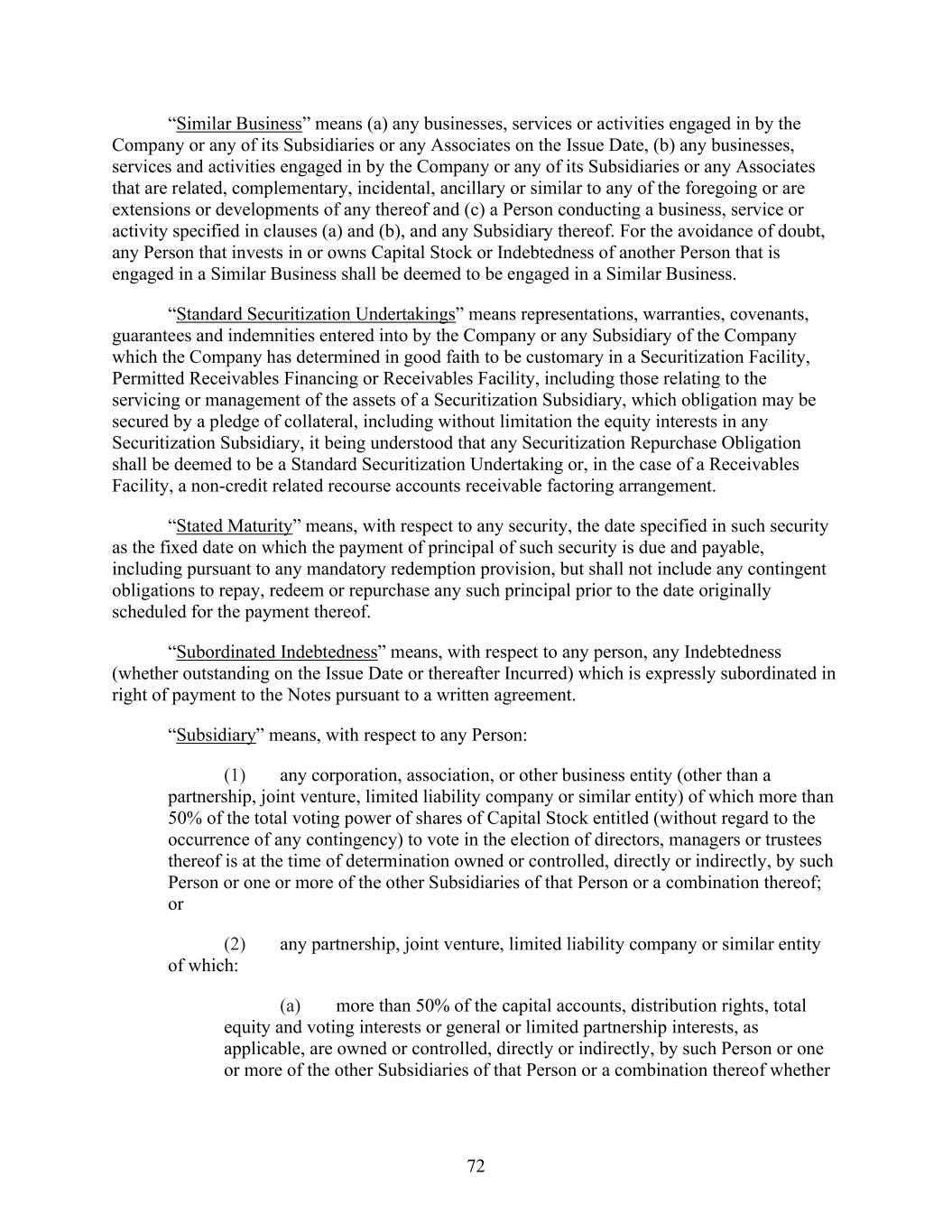
72 “Similar Business” means (a) any businesses, services or activities engaged in by the Company or any of its Subsidiaries or any Associates on the Issue Date, (b) any businesses, services and activities engaged in by the Company or any of its Subsidiaries or any Associates that are related, complementary, incidental, ancillary or similar to any of the foregoing or are extensions or developments of any thereof and (c) a Person conducting a business, service or activity specified in clauses (a) and (b), and any Subsidiary thereof. For the avoidance of doubt, any Person that invests in or owns Capital Stock or Indebtedness of another Person that is engaged in a Similar Business shall be deemed to be engaged in a Similar Business. “Standard Securitization Undertakings” means representations, warranties, covenants, guarantees and indemnities entered into by the Company or any Subsidiary of the Company which the Company has determined in good faith to be customary in a Securitization Facility, Permitted Receivables Financing or Receivables Facility, including those relating to the servicing or management of the assets of a Securitization Subsidiary, which obligation may be secured by a pledge of collateral, including without limitation the equity interests in any Securitization Subsidiary, it being understood that any Securitization Repurchase Obligation shall be deemed to be a Standard Securitization Undertaking or, in the case of a Receivables Facility, a non-credit related recourse accounts receivable factoring arrangement. “Stated Maturity” means, with respect to any security, the date specified in such security as the fixed date on which the payment of principal of such security is due and payable, including pursuant to any mandatory redemption provision, but shall not include any contingent obligations to repay, redeem or repurchase any such principal prior to the date originally scheduled for the payment thereof. “Subordinated Indebtedness” means, with respect to any person, any Indebtedness (whether outstanding on the Issue Date or thereafter Incurred) which is expressly subordinated in right of payment to the Notes pursuant to a written agreement. “Subsidiary” means, with respect to any Person: (1) any corporation, association, or other business entity (other than a partnership, joint venture, limited liability company or similar entity) of which more than 50% of the total voting power of shares of Capital Stock entitled (without regard to the occurrence of any contingency) to vote in the election of directors, managers or trustees thereof is at the time of determination owned or controlled, directly or indirectly, by such Person or one or more of the other Subsidiaries of that Person or a combination thereof; or (2) any partnership, joint venture, limited liability company or similar entity of which: (a) more than 50% of the capital accounts, distribution rights, total equity and voting interests or general or limited partnership interests, as applicable, are owned or controlled, directly or indirectly, by such Person or one or more of the other Subsidiaries of that Person or a combination thereof whether
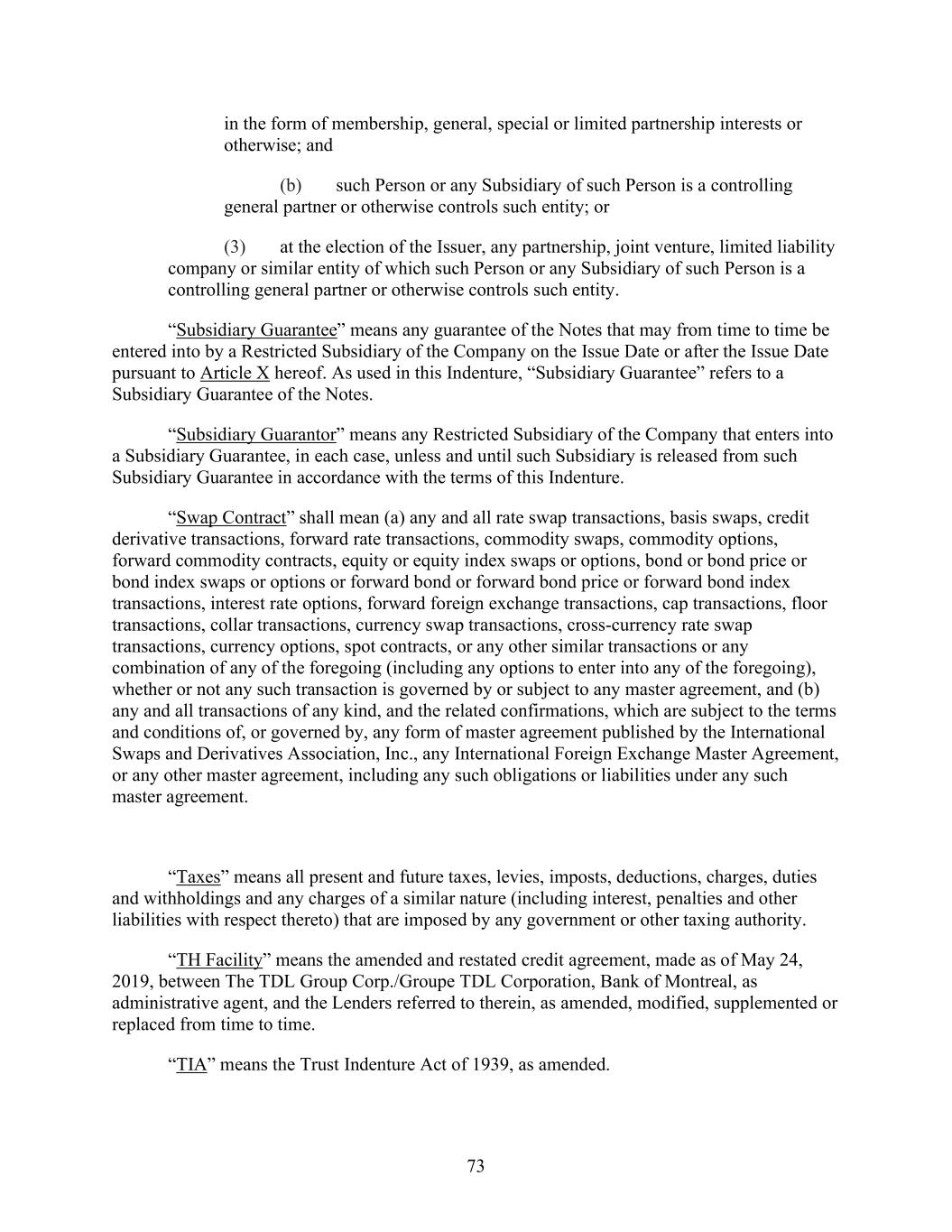
73 in the form of membership, general, special or limited partnership interests or otherwise; and (b) such Person or any Subsidiary of such Person is a controlling general partner or otherwise controls such entity; or (3) at the election of the Issuer, any partnership, joint venture, limited liability company or similar entity of which such Person or any Subsidiary of such Person is a controlling general partner or otherwise controls such entity. “Subsidiary Guarantee” means any guarantee of the Notes that may from time to time be entered into by a Restricted Subsidiary of the Company on the Issue Date or after the Issue Date pursuant to Article X hereof. As used in this Indenture, “Subsidiary Guarantee” refers to a Subsidiary Guarantee of the Notes. “Subsidiary Guarantor” means any Restricted Subsidiary of the Company that enters into a Subsidiary Guarantee, in each case, unless and until such Subsidiary is released from such Subsidiary Guarantee in accordance with the terms of this Indenture. “Swap Contract” shall mean (a) any and all rate swap transactions, basis swaps, credit derivative transactions, forward rate transactions, commodity swaps, commodity options, forward commodity contracts, equity or equity index swaps or options, bond or bond price or bond index swaps or options or forward bond or forward bond price or forward bond index transactions, interest rate options, forward foreign exchange transactions, cap transactions, floor transactions, collar transactions, currency swap transactions, cross-currency rate swap transactions, currency options, spot contracts, or any other similar transactions or any combination of any of the foregoing (including any options to enter into any of the foregoing), whether or not any such transaction is governed by or subject to any master agreement, and (b) any and all transactions of any kind, and the related confirmations, which are subject to the terms and conditions of, or governed by, any form of master agreement published by the International Swaps and Derivatives Association, Inc., any International Foreign Exchange Master Agreement, or any other master agreement, including any such obligations or liabilities under any such master agreement. “Taxes” means all present and future taxes, levies, imposts, deductions, charges, duties and withholdings and any charges of a similar nature (including interest, penalties and other liabilities with respect thereto) that are imposed by any government or other taxing authority. “TH Facility” means the amended and restated credit agreement, made as of May 24, 2019, between The TDL Group Corp./Groupe TDL Corporation, Bank of Montreal, as administrative agent, and the Lenders referred to therein, as amended, modified, supplemented or replaced from time to time. “TIA” means the Trust Indenture Act of 1939, as amended.
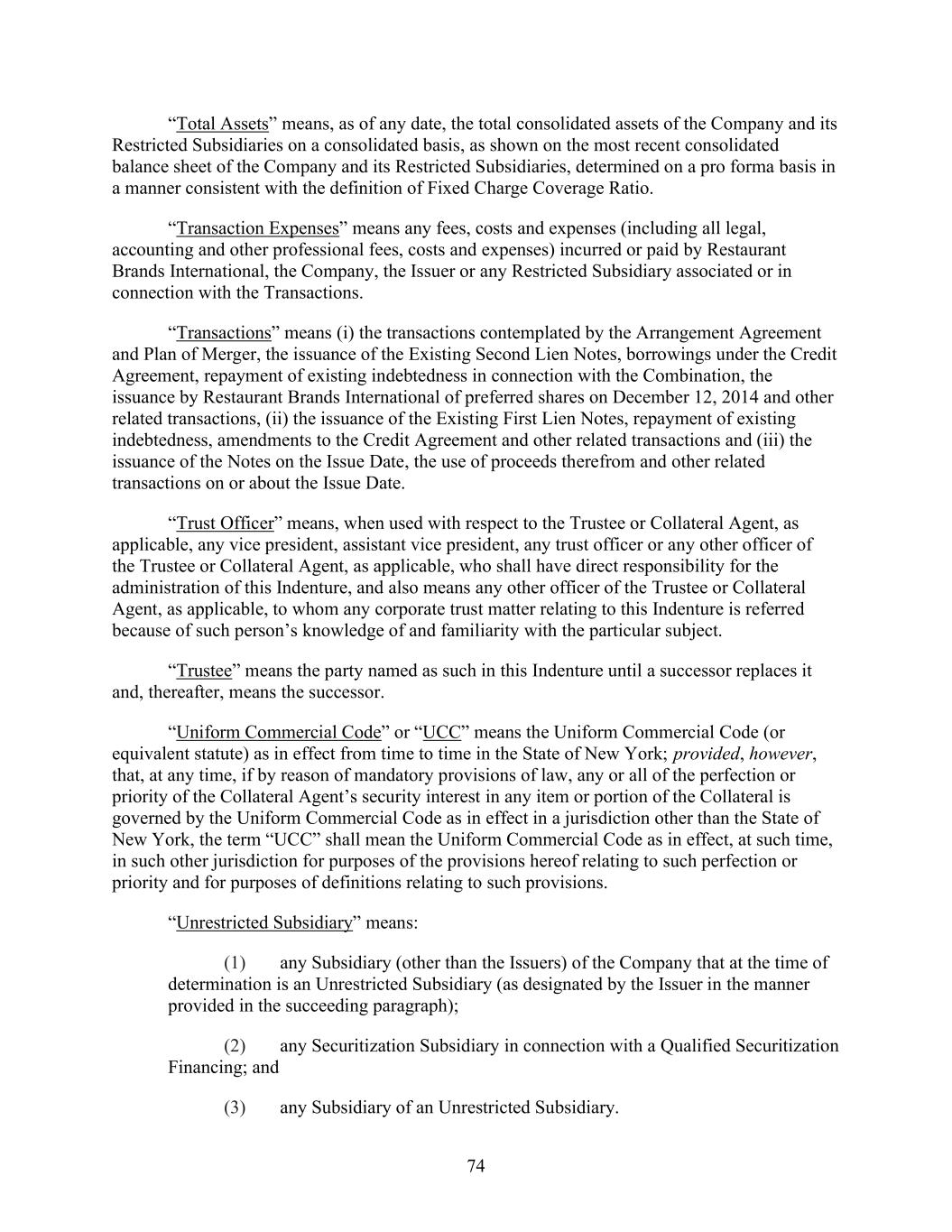
74 “Total Assets” means, as of any date, the total consolidated assets of the Company and its Restricted Subsidiaries on a consolidated basis, as shown on the most recent consolidated balance sheet of the Company and its Restricted Subsidiaries, determined on a pro forma basis in a manner consistent with the definition of Fixed Charge Coverage Ratio. “Transaction Expenses” means any fees, costs and expenses (including all legal, accounting and other professional fees, costs and expenses) incurred or paid by Restaurant Brands International, the Company, the Issuer or any Restricted Subsidiary associated or in connection with the Transactions. “Transactions” means (i) the transactions contemplated by the Arrangement Agreement and Plan of Merger, the issuance of the Existing Second Lien Notes, borrowings under the Credit Agreement, repayment of existing indebtedness in connection with the Combination, the issuance by Restaurant Brands International of preferred shares on December 12, 2014 and other related transactions, (ii) the issuance of the Existing First Lien Notes, repayment of existing indebtedness, amendments to the Credit Agreement and other related transactions and (iii) the issuance of the Notes on the Issue Date, the use of proceeds therefrom and other related transactions on or about the Issue Date. “Trust Officer” means, when used with respect to the Trustee or Collateral Agent, as applicable, any vice president, assistant vice president, any trust officer or any other officer of the Trustee or Collateral Agent, as applicable, who shall have direct responsibility for the administration of this Indenture, and also means any other officer of the Trustee or Collateral Agent, as applicable, to whom any corporate trust matter relating to this Indenture is referred because of such person’s knowledge of and familiarity with the particular subject. “Trustee” means the party named as such in this Indenture until a successor replaces it and, thereafter, means the successor. “Uniform Commercial Code” or “UCC” means the Uniform Commercial Code (or equivalent statute) as in effect from time to time in the State of New York; provided, however, that, at any time, if by reason of mandatory provisions of law, any or all of the perfection or priority of the Collateral Agent’s security interest in any item or portion of the Collateral is governed by the Uniform Commercial Code as in effect in a jurisdiction other than the State of New York, the term “UCC” shall mean the Uniform Commercial Code as in effect, at such time, in such other jurisdiction for purposes of the provisions hereof relating to such perfection or priority and for purposes of definitions relating to such provisions. “Unrestricted Subsidiary” means: (1) any Subsidiary (other than the Issuers) of the Company that at the time of determination is an Unrestricted Subsidiary (as designated by the Issuer in the manner provided in the succeeding paragraph); (2) any Securitization Subsidiary in connection with a Qualified Securitization Financing; and (3) any Subsidiary of an Unrestricted Subsidiary.
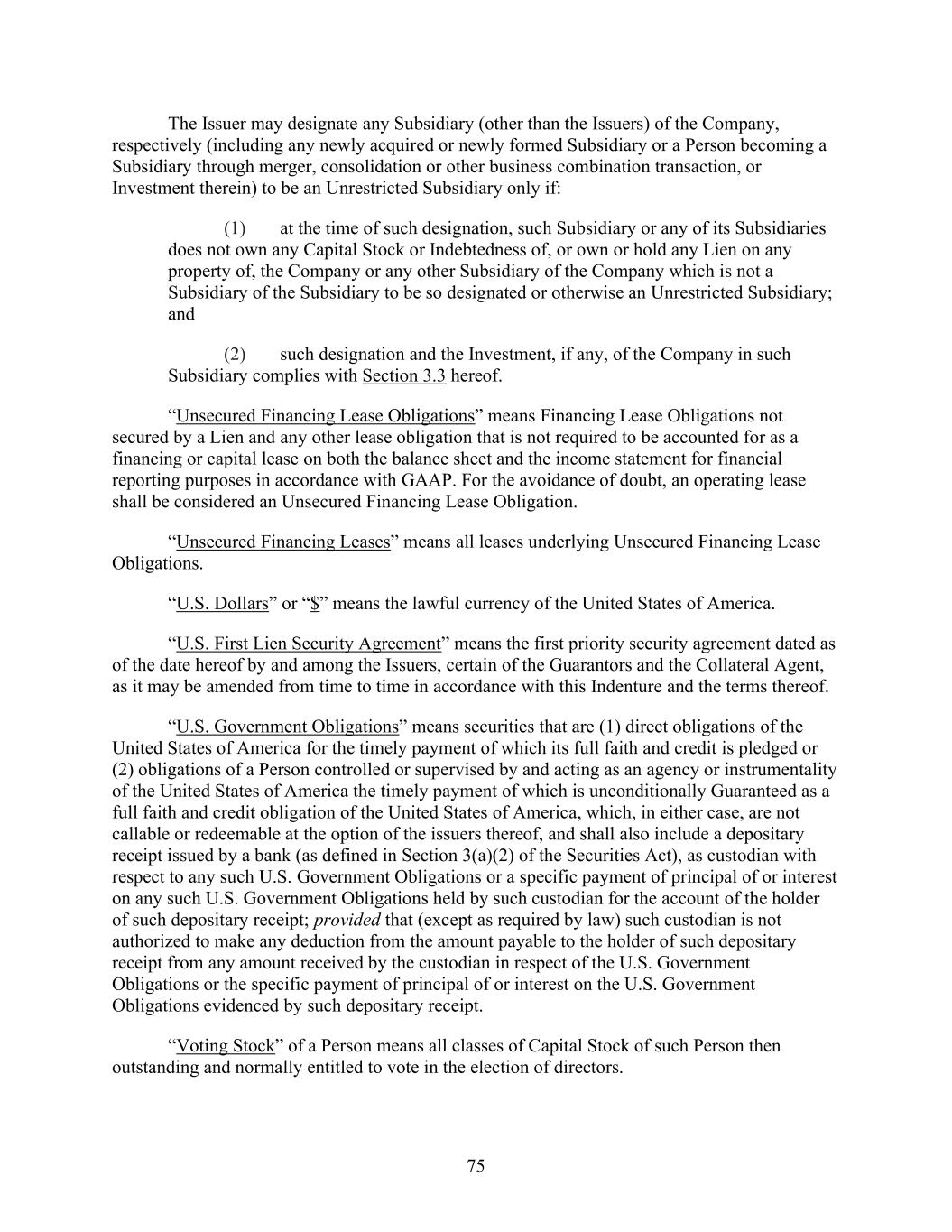
75 The Issuer may designate any Subsidiary (other than the Issuers) of the Company, respectively (including any newly acquired or newly formed Subsidiary or a Person becoming a Subsidiary through merger, consolidation or other business combination transaction, or Investment therein) to be an Unrestricted Subsidiary only if: (1) at the time of such designation, such Subsidiary or any of its Subsidiaries does not own any Capital Stock or Indebtedness of, or own or hold any Lien on any property of, the Company or any other Subsidiary of the Company which is not a Subsidiary of the Subsidiary to be so designated or otherwise an Unrestricted Subsidiary; and (2) such designation and the Investment, if any, of the Company in such Subsidiary complies with Section 3.3 hereof. “Unsecured Financing Lease Obligations” means Financing Lease Obligations not secured by a Lien and any other lease obligation that is not required to be accounted for as a financing or capital lease on both the balance sheet and the income statement for financial reporting purposes in accordance with GAAP. For the avoidance of doubt, an operating lease shall be considered an Unsecured Financing Lease Obligation. “Unsecured Financing Leases” means all leases underlying Unsecured Financing Lease Obligations. “U.S. Dollars” or “$” means the lawful currency of the United States of America. “U.S. First Lien Security Agreement” means the first priority security agreement dated as of the date hereof by and among the Issuers, certain of the Guarantors and the Collateral Agent, as it may be amended from time to time in accordance with this Indenture and the terms thereof. “U.S. Government Obligations” means securities that are (1) direct obligations of the United States of America for the timely payment of which its full faith and credit is pledged or (2) obligations of a Person controlled or supervised by and acting as an agency or instrumentality of the United States of America the timely payment of which is unconditionally Guaranteed as a full faith and credit obligation of the United States of America, which, in either case, are not callable or redeemable at the option of the issuers thereof, and shall also include a depositary receipt issued by a bank (as defined in Section 3(a)(2) of the Securities Act), as custodian with respect to any such U.S. Government Obligations or a specific payment of principal of or interest on any such U.S. Government Obligations held by such custodian for the account of the holder of such depositary receipt; provided that (except as required by law) such custodian is not authorized to make any deduction from the amount payable to the holder of such depositary receipt from any amount received by the custodian in respect of the U.S. Government Obligations or the specific payment of principal of or interest on the U.S. Government Obligations evidenced by such depositary receipt. “Voting Stock” of a Person means all classes of Capital Stock of such Person then outstanding and normally entitled to vote in the election of directors.
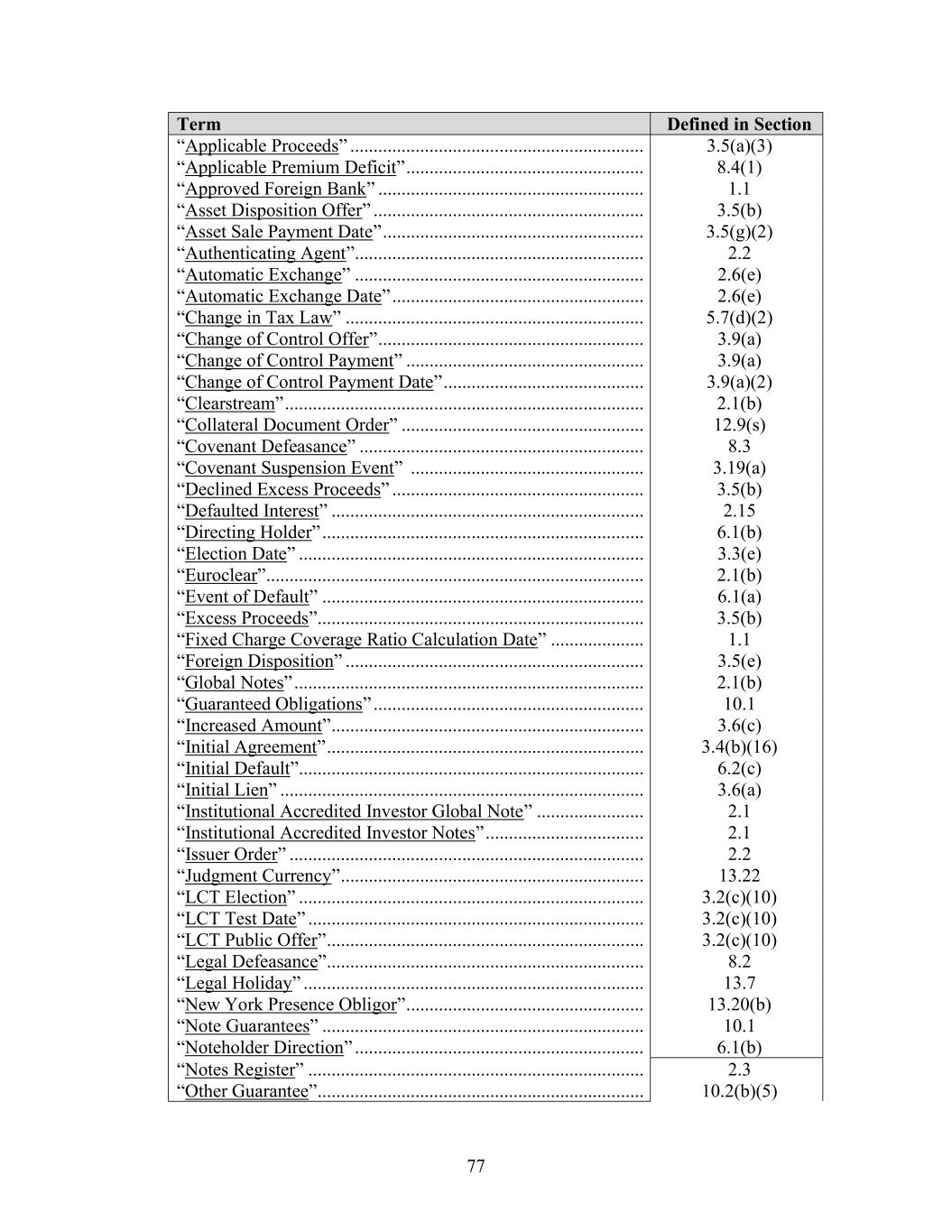
77 Term Defined in Section “Applicable Proceeds” ............................................................... 3.5(a)(3) “Applicable Premium Deficit” ................................................... 8.4(1) “Approved Foreign Bank” ......................................................... 1.1 “Asset Disposition Offer” .......................................................... 3.5(b) “Asset Sale Payment Date” ........................................................ 3.5(g)(2) “Authenticating Agent”.............................................................. 2.2 “Automatic Exchange” .............................................................. 2.6(e) “Automatic Exchange Date” ...................................................... 2.6(e) “Change in Tax Law” ................................................................ 5.7(d)(2) “Change of Control Offer” ......................................................... 3.9(a) “Change of Control Payment” ................................................... 3.9(a) “Change of Control Payment Date” ........................................... 3.9(a)(2) “Clearstream” ............................................................................. 2.1(b) “Collateral Document Order” .................................................... 12.9(s) “Covenant Defeasance” ............................................................. 8.3 “Covenant Suspension Event” .................................................. 3.19(a) “Declined Excess Proceeds” ...................................................... 3.5(b) “Defaulted Interest” ................................................................... 2.15 “Directing Holder” ..................................................................... 6.1(b) “Election Date” .......................................................................... 3.3(e) “Euroclear” ................................................................................. 2.1(b) “Event of Default” ..................................................................... 6.1(a) “Excess Proceeds”...................................................................... 3.5(b) “Fixed Charge Coverage Ratio Calculation Date” .................... 1.1 “Foreign Disposition” ................................................................ 3.5(e) “Global Notes” ........................................................................... 2.1(b) “Guaranteed Obligations” .......................................................... 10.1 “Increased Amount” ................................................................... 3.6(c) “Initial Agreement” .................................................................... 3.4(b)(16) “Initial Default” .......................................................................... 6.2(c) “Initial Lien” .............................................................................. 3.6(a) “Institutional Accredited Investor Global Note” ....................... 2.1 “Institutional Accredited Investor Notes” .................................. 2.1 “Issuer Order” ............................................................................ 2.2 “Judgment Currency” ................................................................. 13.22 “LCT Election” .......................................................................... 3.2(c)(10) “LCT Test Date” ........................................................................ 3.2(c)(10) “LCT Public Offer” .................................................................... 3.2(c)(10) “Legal Defeasance” .................................................................... 8.2 “Legal Holiday” ......................................................................... 13.7 “New York Presence Obligor” ................................................... 13.20(b) “Note Guarantees” ..................................................................... 10.1 “Noteholder Direction” .............................................................. 6.1(b) “Notes Register” ........................................................................ 2.3 “Other Guarantee” ...................................................................... 10.2(b)(5)
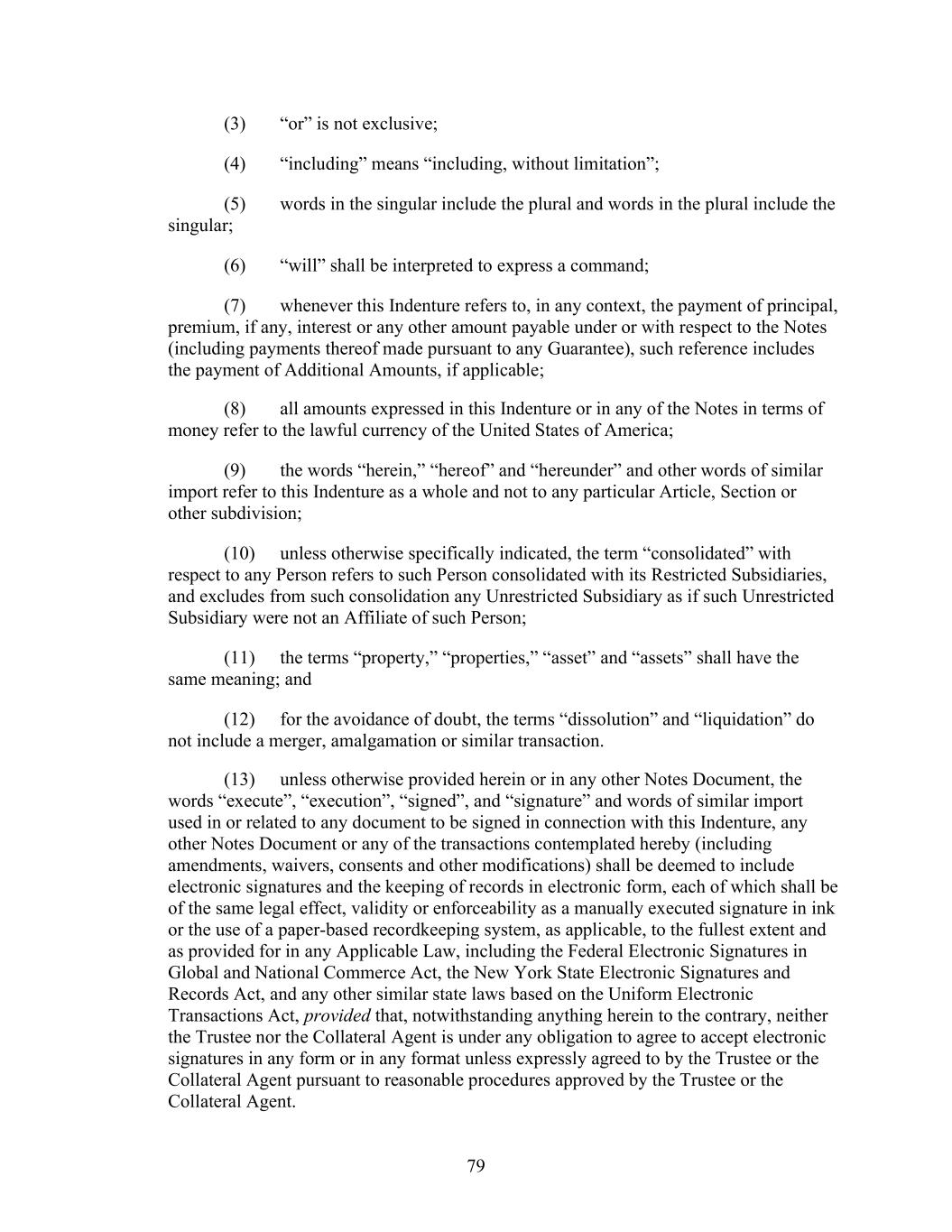
79 (3) “or” is not exclusive; (4) “including” means “including, without limitation”; (5) words in the singular include the plural and words in the plural include the singular; (6) “will” shall be interpreted to express a command; (7) whenever this Indenture refers to, in any context, the payment of principal, premium, if any, interest or any other amount payable under or with respect to the Notes (including payments thereof made pursuant to any Guarantee), such reference includes the payment of Additional Amounts, if applicable; (8) all amounts expressed in this Indenture or in any of the Notes in terms of money refer to the lawful currency of the United States of America; (9) the words “herein,” “hereof” and “hereunder” and other words of similar import refer to this Indenture as a whole and not to any particular Article, Section or other subdivision; (10) unless otherwise specifically indicated, the term “consolidated” with respect to any Person refers to such Person consolidated with its Restricted Subsidiaries, and excludes from such consolidation any Unrestricted Subsidiary as if such Unrestricted Subsidiary were not an Affiliate of such Person; (11) the terms “property,” “properties,” “asset” and “assets” shall have the same meaning; and (12) for the avoidance of doubt, the terms “dissolution” and “liquidation” do not include a merger, amalgamation or similar transaction. (13) unless otherwise provided herein or in any other Notes Document, the words “execute”, “execution”, “signed”, and “signature” and words of similar import used in or related to any document to be signed in connection with this Indenture, any other Notes Document or any of the transactions contemplated hereby (including amendments, waivers, consents and other modifications) shall be deemed to include electronic signatures and the keeping of records in electronic form, each of which shall be of the same legal effect, validity or enforceability as a manually executed signature in ink or the use of a paper-based recordkeeping system, as applicable, to the fullest extent and as provided for in any Applicable Law, including the Federal Electronic Signatures in Global and National Commerce Act, the New York State Electronic Signatures and Records Act, and any other similar state laws based on the Uniform Electronic Transactions Act, provided that, notwithstanding anything herein to the contrary, neither the Trustee nor the Collateral Agent is under any obligation to agree to accept electronic signatures in any form or in any format unless expressly agreed to by the Trustee or the Collateral Agent pursuant to reasonable procedures approved by the Trustee or the Collateral Agent.
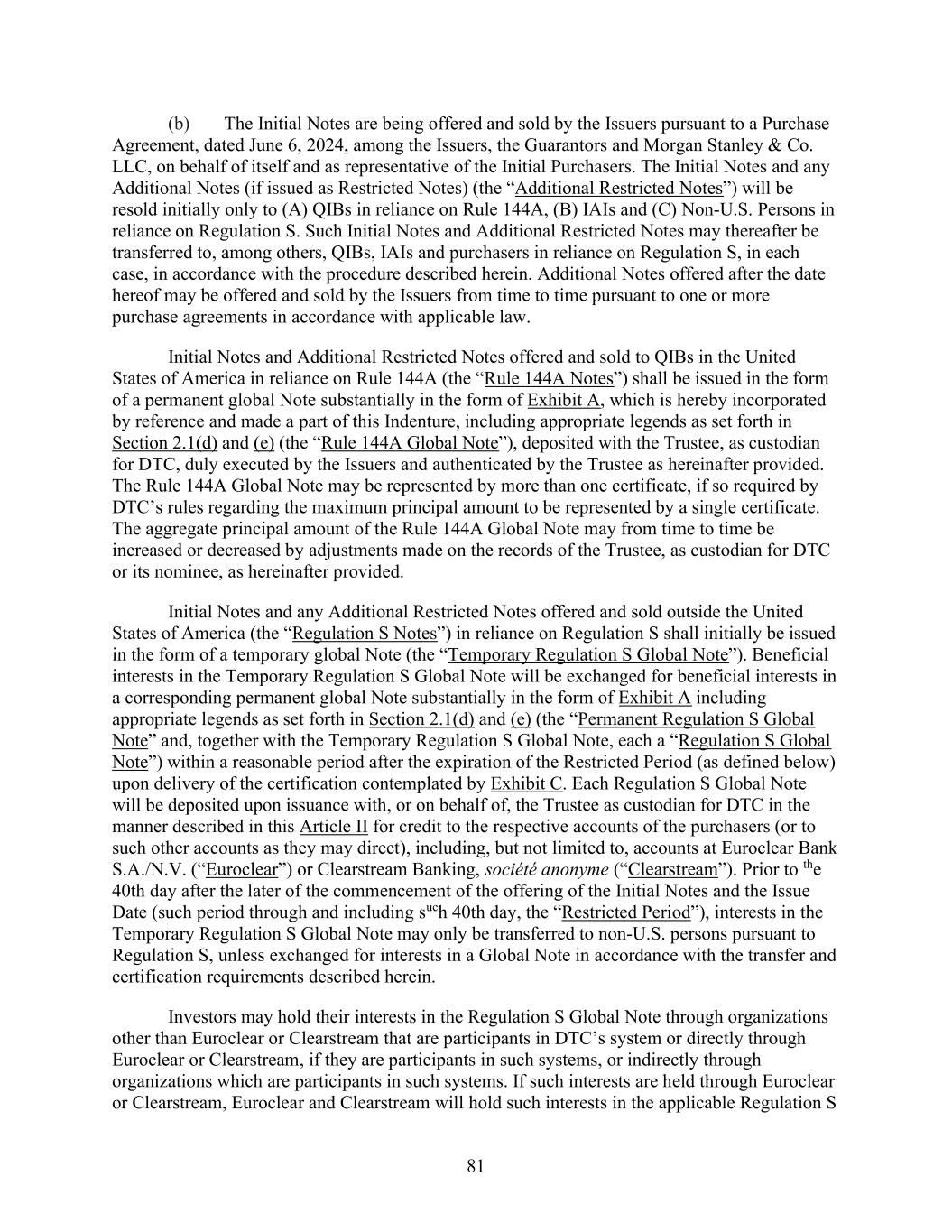
81 (b) The Initial Notes are being offered and sold by the Issuers pursuant to a Purchase Agreement, dated June 6, 2024, among the Issuers, the Guarantors and Xxxxxx Xxxxxxx & Co. LLC, on behalf of itself and as representative of the Initial Purchasers. The Initial Notes and any Additional Notes (if issued as Restricted Notes) (the “Additional Restricted Notes”) will be resold initially only to (A) QIBs in reliance on Rule 144A, (B) IAIs and (C) Non-U.S. Persons in reliance on Regulation S. Such Initial Notes and Additional Restricted Notes may thereafter be transferred to, among others, QIBs, IAIs and purchasers in reliance on Regulation S, in each case, in accordance with the procedure described herein. Additional Notes offered after the date hereof may be offered and sold by the Issuers from time to time pursuant to one or more purchase agreements in accordance with applicable law. Initial Notes and Additional Restricted Notes offered and sold to QIBs in the United States of America in reliance on Rule 144A (the “Rule 144A Notes”) shall be issued in the form of a permanent global Note substantially in the form of Exhibit A, which is hereby incorporated by reference and made a part of this Indenture, including appropriate legends as set forth in Section 2.1(d) and (e) (the “Rule 144A Global Note”), deposited with the Trustee, as custodian for DTC, duly executed by the Issuers and authenticated by the Trustee as hereinafter provided. The Rule 144A Global Note may be represented by more than one certificate, if so required by DTC’s rules regarding the maximum principal amount to be represented by a single certificate. The aggregate principal amount of the Rule 144A Global Note may from time to time be increased or decreased by adjustments made on the records of the Trustee, as custodian for DTC or its nominee, as hereinafter provided. Initial Notes and any Additional Restricted Notes offered and sold outside the United States of America (the “Regulation S Notes”) in reliance on Regulation S shall initially be issued in the form of a temporary global Note (the “Temporary Regulation S Global Note”). Beneficial interests in the Temporary Regulation S Global Note will be exchanged for beneficial interests in a corresponding permanent global Note substantially in the form of Exhibit A including appropriate legends as set forth in Section 2.1(d) and (e) (the “Permanent Regulation S Global Note” and, together with the Temporary Regulation S Global Note, each a “Regulation S Global Note”) within a reasonable period after the expiration of the Restricted Period (as defined below) upon delivery of the certification contemplated by Exhibit C. Each Regulation S Global Note will be deposited upon issuance with, or on behalf of, the Trustee as custodian for DTC in the manner described in this Article II for credit to the respective accounts of the purchasers (or to such other accounts as they may direct), including, but not limited to, accounts at Euroclear Bank S.A./N.V. (“Euroclear”) or Clearstream Banking, société anonyme (“Clearstream”). Prior to the 40th day after the later of the commencement of the offering of the Initial Notes and the Issue Date (such period through and including such 40th day, the “Restricted Period”), interests in the Temporary Regulation S Global Note may only be transferred to non-U.S. persons pursuant to Regulation S, unless exchanged for interests in a Global Note in accordance with the transfer and certification requirements described herein. Investors may hold their interests in the Regulation S Global Note through organizations other than Euroclear or Clearstream that are participants in DTC’s system or directly through Euroclear or Clearstream, if they are participants in such systems, or indirectly through organizations which are participants in such systems. If such interests are held through Euroclear or Clearstream, Euroclear and Clearstream will hold such interests in the applicable Regulation S
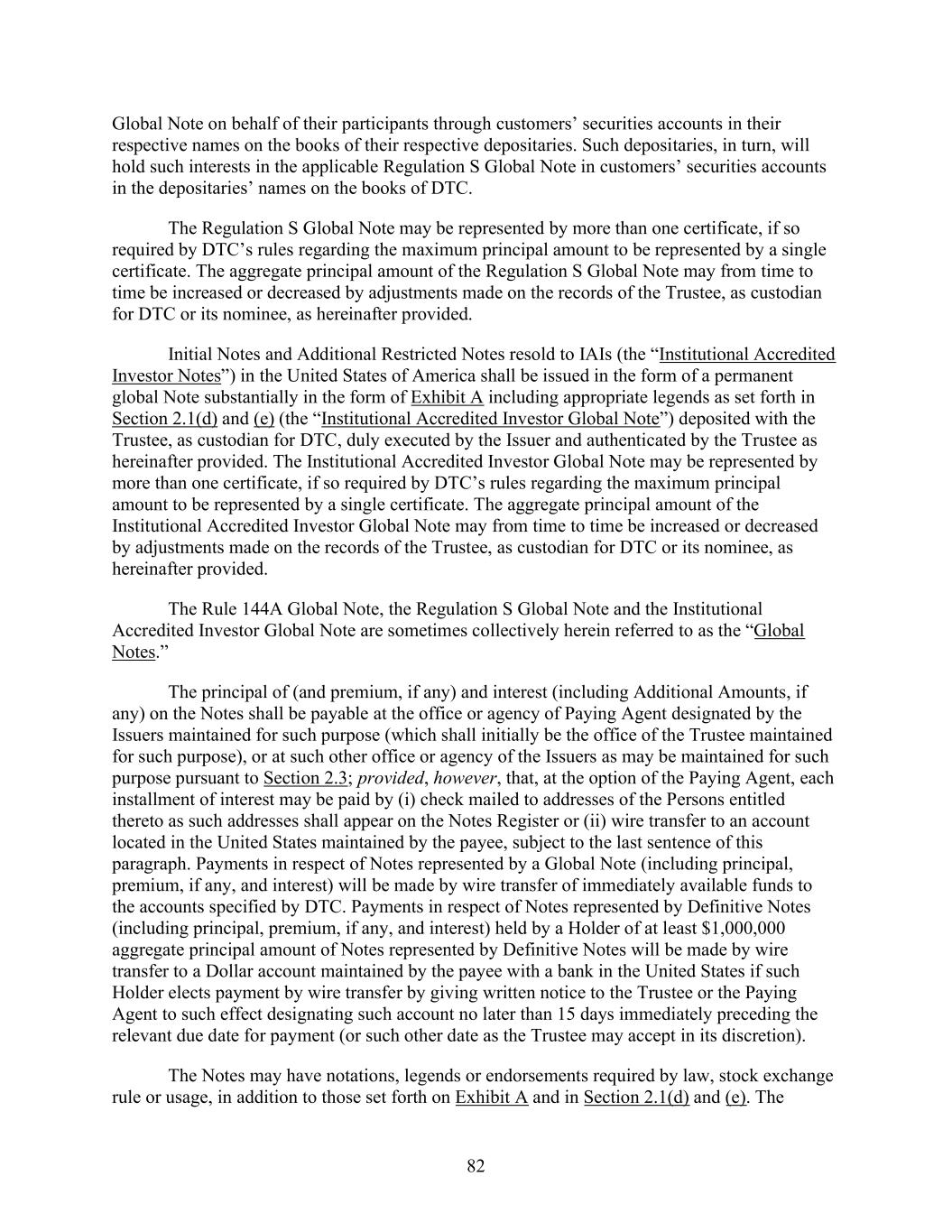
82 Global Note on behalf of their participants through customers’ securities accounts in their respective names on the books of their respective depositaries. Such depositaries, in turn, will hold such interests in the applicable Regulation S Global Note in customers’ securities accounts in the depositaries’ names on the books of DTC. The Regulation S Global Note may be represented by more than one certificate, if so required by DTC’s rules regarding the maximum principal amount to be represented by a single certificate. The aggregate principal amount of the Regulation S Global Note may from time to time be increased or decreased by adjustments made on the records of the Trustee, as custodian for DTC or its nominee, as hereinafter provided. Initial Notes and Additional Restricted Notes resold to IAIs (the “Institutional Accredited Investor Notes”) in the United States of America shall be issued in the form of a permanent global Note substantially in the form of Exhibit A including appropriate legends as set forth in Section 2.1(d) and (e) (the “Institutional Accredited Investor Global Note”) deposited with the Trustee, as custodian for DTC, duly executed by the Issuer and authenticated by the Trustee as hereinafter provided. The Institutional Accredited Investor Global Note may be represented by more than one certificate, if so required by DTC’s rules regarding the maximum principal amount to be represented by a single certificate. The aggregate principal amount of the Institutional Accredited Investor Global Note may from time to time be increased or decreased by adjustments made on the records of the Trustee, as custodian for DTC or its nominee, as hereinafter provided. The Rule 144A Global Note, the Regulation S Global Note and the Institutional Accredited Investor Global Note are sometimes collectively herein referred to as the “Global Notes.” The principal of (and premium, if any) and interest (including Additional Amounts, if any) on the Notes shall be payable at the office or agency of Paying Agent designated by the Issuers maintained for such purpose (which shall initially be the office of the Trustee maintained for such purpose), or at such other office or agency of the Issuers as may be maintained for such purpose pursuant to Section 2.3; provided, however, that, at the option of the Paying Agent, each installment of interest may be paid by (i) check mailed to addresses of the Persons entitled thereto as such addresses shall appear on the Notes Register or (ii) wire transfer to an account located in the United States maintained by the payee, subject to the last sentence of this paragraph. Payments in respect of Notes represented by a Global Note (including principal, premium, if any, and interest) will be made by wire transfer of immediately available funds to the accounts specified by DTC. Payments in respect of Notes represented by Definitive Notes (including principal, premium, if any, and interest) held by a Holder of at least $1,000,000 aggregate principal amount of Notes represented by Definitive Notes will be made by wire transfer to a Dollar account maintained by the payee with a bank in the United States if such Holder elects payment by wire transfer by giving written notice to the Trustee or the Paying Agent to such effect designating such account no later than 15 days immediately preceding the relevant due date for payment (or such other date as the Trustee may accept in its discretion). The Notes may have notations, legends or endorsements required by law, stock exchange rule or usage, in addition to those set forth on Exhibit A and in Section 2.1(d) and (e). The
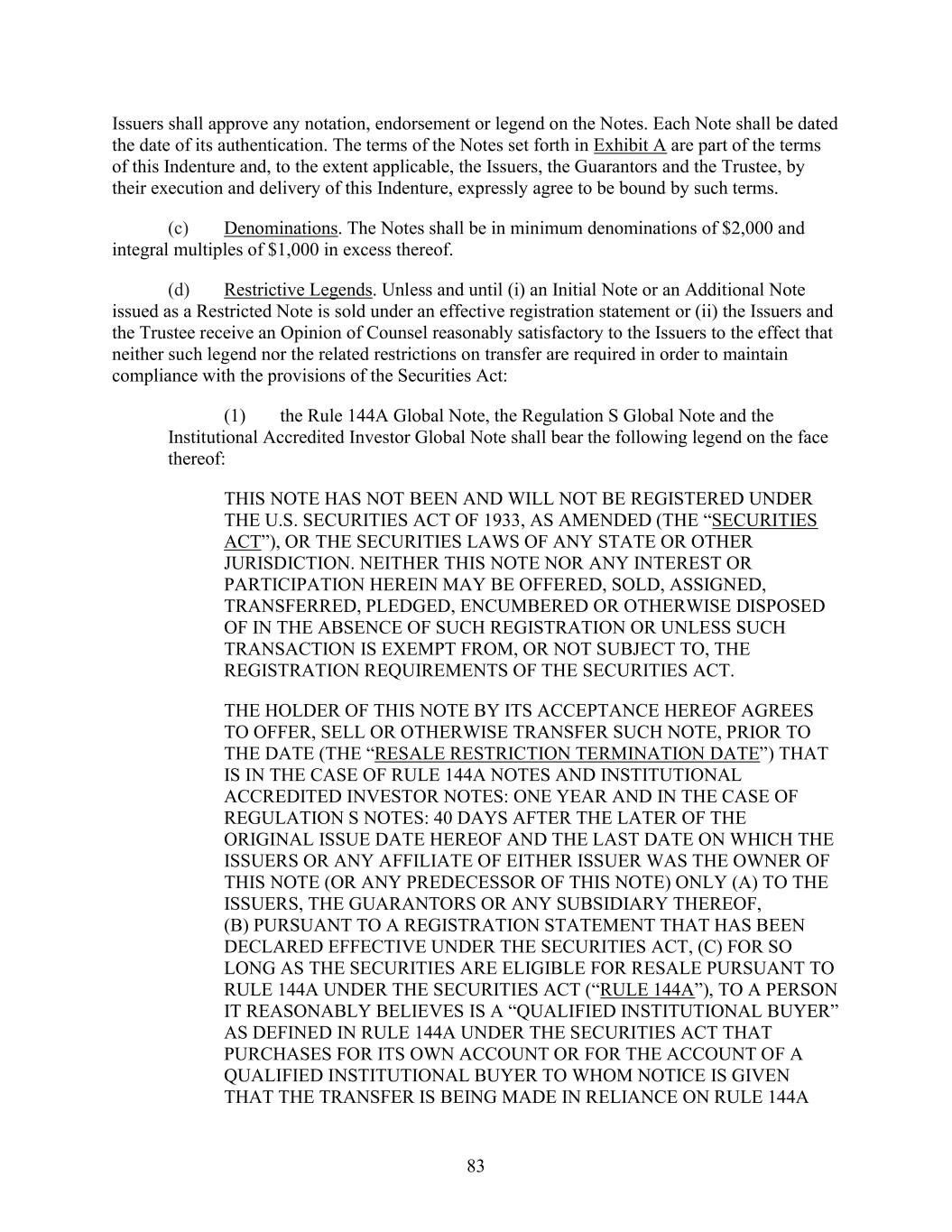
83 Issuers shall approve any notation, endorsement or legend on the Notes. Each Note shall be dated the date of its authentication. The terms of the Notes set forth in Exhibit A are part of the terms of this Indenture and, to the extent applicable, the Issuers, the Guarantors and the Trustee, by their execution and delivery of this Indenture, expressly agree to be bound by such terms. (c) Denominations. The Notes shall be in minimum denominations of $2,000 and integral multiples of $1,000 in excess thereof. (d) Restrictive Legends. Unless and until (i) an Initial Note or an Additional Note issued as a Restricted Note is sold under an effective registration statement or (ii) the Issuers and the Trustee receive an Opinion of Counsel reasonably satisfactory to the Issuers to the effect that neither such legend nor the related restrictions on transfer are required in order to maintain compliance with the provisions of the Securities Act: (1) the Rule 144A Global Note, the Regulation S Global Note and the Institutional Accredited Investor Global Note shall bear the following legend on the face thereof: THIS NOTE HAS NOT BEEN AND WILL NOT BE REGISTERED UNDER THE U.S. SECURITIES ACT OF 1933, AS AMENDED (THE “SECURITIES ACT”), OR THE SECURITIES LAWS OF ANY STATE OR OTHER JURISDICTION. NEITHER THIS NOTE NOR ANY INTEREST OR PARTICIPATION HEREIN MAY BE OFFERED, SOLD, ASSIGNED, TRANSFERRED, PLEDGED, ENCUMBERED OR OTHERWISE DISPOSED OF IN THE ABSENCE OF SUCH REGISTRATION OR UNLESS SUCH TRANSACTION IS EXEMPT FROM, OR NOT SUBJECT TO, THE REGISTRATION REQUIREMENTS OF THE SECURITIES ACT. THE HOLDER OF THIS NOTE BY ITS ACCEPTANCE HEREOF AGREES TO OFFER, SELL OR OTHERWISE TRANSFER SUCH NOTE, PRIOR TO THE DATE (THE “RESALE RESTRICTION TERMINATION DATE”) THAT IS IN THE CASE OF RULE 144A NOTES AND INSTITUTIONAL ACCREDITED INVESTOR NOTES: ONE YEAR AND IN THE CASE OF REGULATION S NOTES: 40 DAYS AFTER THE LATER OF THE ORIGINAL ISSUE DATE HEREOF AND THE LAST DATE ON WHICH THE ISSUERS OR ANY AFFILIATE OF EITHER ISSUER WAS THE OWNER OF THIS NOTE (OR ANY PREDECESSOR OF THIS NOTE) ONLY (A) TO THE ISSUERS, THE GUARANTORS OR ANY SUBSIDIARY THEREOF, (B) PURSUANT TO A REGISTRATION STATEMENT THAT HAS BEEN DECLARED EFFECTIVE UNDER THE SECURITIES ACT, (C) FOR SO LONG AS THE SECURITIES ARE ELIGIBLE FOR RESALE PURSUANT TO RULE 144A UNDER THE SECURITIES ACT (“RULE 144A”), TO A PERSON IT REASONABLY BELIEVES IS A “QUALIFIED INSTITUTIONAL BUYER” AS DEFINED IN RULE 144A UNDER THE SECURITIES ACT THAT PURCHASES FOR ITS OWN ACCOUNT OR FOR THE ACCOUNT OF A QUALIFIED INSTITUTIONAL BUYER TO WHOM NOTICE IS GIVEN THAT THE TRANSFER IS BEING MADE IN RELIANCE ON RULE 144A
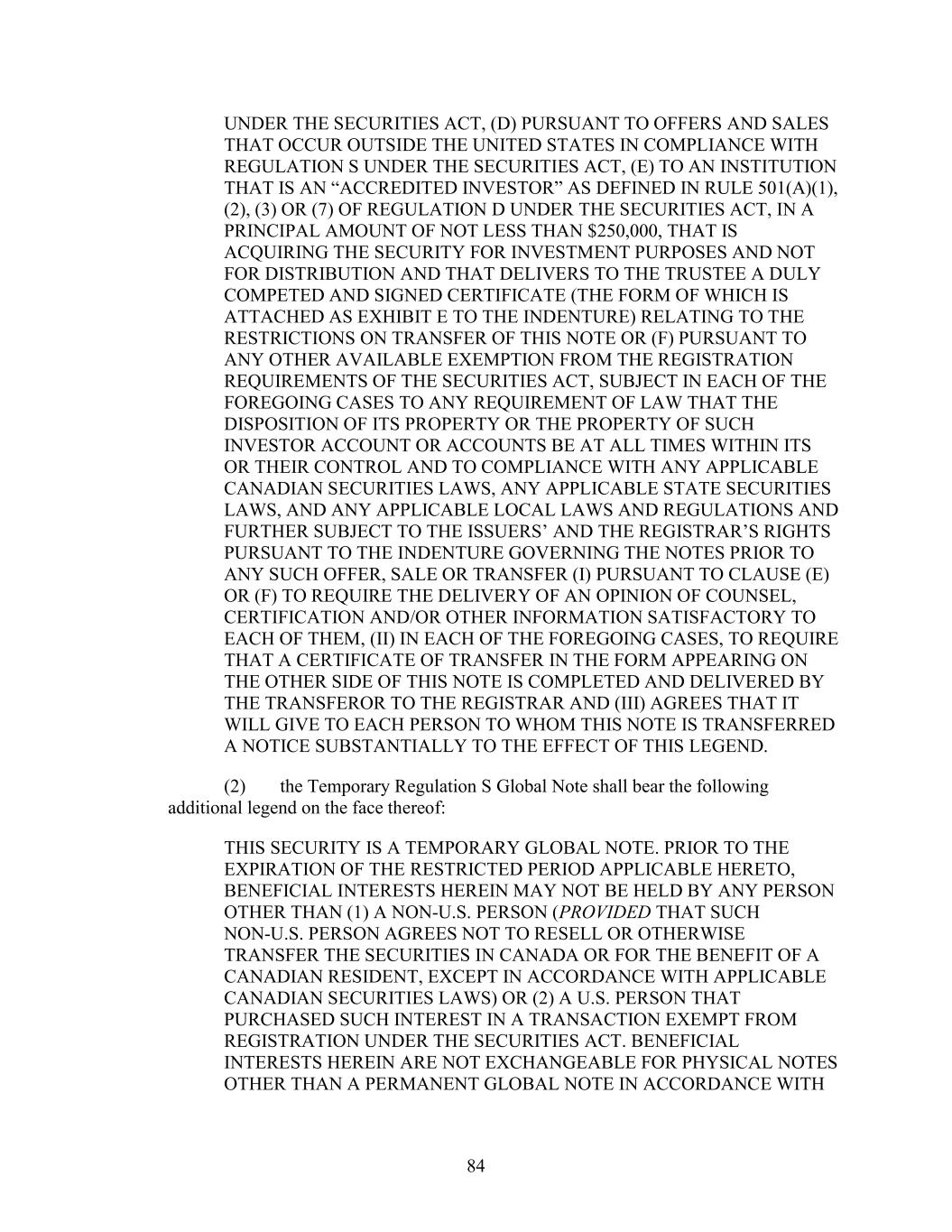
84 UNDER THE SECURITIES ACT, (D) PURSUANT TO OFFERS AND SALES THAT OCCUR OUTSIDE THE UNITED STATES IN COMPLIANCE WITH REGULATION S UNDER THE SECURITIES ACT, (E) TO AN INSTITUTION THAT IS AN “ACCREDITED INVESTOR” AS DEFINED IN RULE 501(A)(1), (2), (3) OR (7) OF REGULATION D UNDER THE SECURITIES ACT, IN A PRINCIPAL AMOUNT OF NOT LESS THAN $250,000, THAT IS ACQUIRING THE SECURITY FOR INVESTMENT PURPOSES AND NOT FOR DISTRIBUTION AND THAT DELIVERS TO THE TRUSTEE A DULY COMPETED AND SIGNED CERTIFICATE (THE FORM OF WHICH IS ATTACHED AS EXHIBIT E TO THE INDENTURE) RELATING TO THE RESTRICTIONS ON TRANSFER OF THIS NOTE OR (F) PURSUANT TO ANY OTHER AVAILABLE EXEMPTION FROM THE REGISTRATION REQUIREMENTS OF THE SECURITIES ACT, SUBJECT IN EACH OF THE FOREGOING CASES TO ANY REQUIREMENT OF LAW THAT THE DISPOSITION OF ITS PROPERTY OR THE PROPERTY OF SUCH INVESTOR ACCOUNT OR ACCOUNTS BE AT ALL TIMES WITHIN ITS OR THEIR CONTROL AND TO COMPLIANCE WITH ANY APPLICABLE CANADIAN SECURITIES LAWS, ANY APPLICABLE STATE SECURITIES LAWS, AND ANY APPLICABLE LOCAL LAWS AND REGULATIONS AND FURTHER SUBJECT TO THE ISSUERS’ AND THE REGISTRAR’S RIGHTS PURSUANT TO THE INDENTURE GOVERNING THE NOTES PRIOR TO ANY SUCH OFFER, SALE OR TRANSFER (I) PURSUANT TO CLAUSE (E) OR (F) TO REQUIRE THE DELIVERY OF AN OPINION OF COUNSEL, CERTIFICATION AND/OR OTHER INFORMATION SATISFACTORY TO EACH OF THEM, (II) IN EACH OF THE FOREGOING CASES, TO REQUIRE THAT A CERTIFICATE OF TRANSFER IN THE FORM APPEARING ON THE OTHER SIDE OF THIS NOTE IS COMPLETED AND DELIVERED BY THE TRANSFEROR TO THE REGISTRAR AND (III) AGREES THAT IT WILL GIVE TO EACH PERSON TO WHOM THIS NOTE IS TRANSFERRED A NOTICE SUBSTANTIALLY TO THE EFFECT OF THIS LEGEND. (2) the Temporary Regulation S Global Note shall bear the following additional legend on the face thereof: THIS SECURITY IS A TEMPORARY GLOBAL NOTE. PRIOR TO THE EXPIRATION OF THE RESTRICTED PERIOD APPLICABLE HERETO, BENEFICIAL INTERESTS HEREIN MAY NOT BE HELD BY ANY PERSON OTHER THAN (1) A NON-U.S. PERSON (PROVIDED THAT SUCH NON-U.S. PERSON AGREES NOT TO RESELL OR OTHERWISE TRANSFER THE SECURITIES IN CANADA OR FOR THE BENEFIT OF A CANADIAN RESIDENT, EXCEPT IN ACCORDANCE WITH APPLICABLE CANADIAN SECURITIES LAWS) OR (2) A U.S. PERSON THAT PURCHASED SUCH INTEREST IN A TRANSACTION EXEMPT FROM REGISTRATION UNDER THE SECURITIES ACT. BENEFICIAL INTERESTS HEREIN ARE NOT EXCHANGEABLE FOR PHYSICAL NOTES OTHER THAN A PERMANENT GLOBAL NOTE IN ACCORDANCE WITH
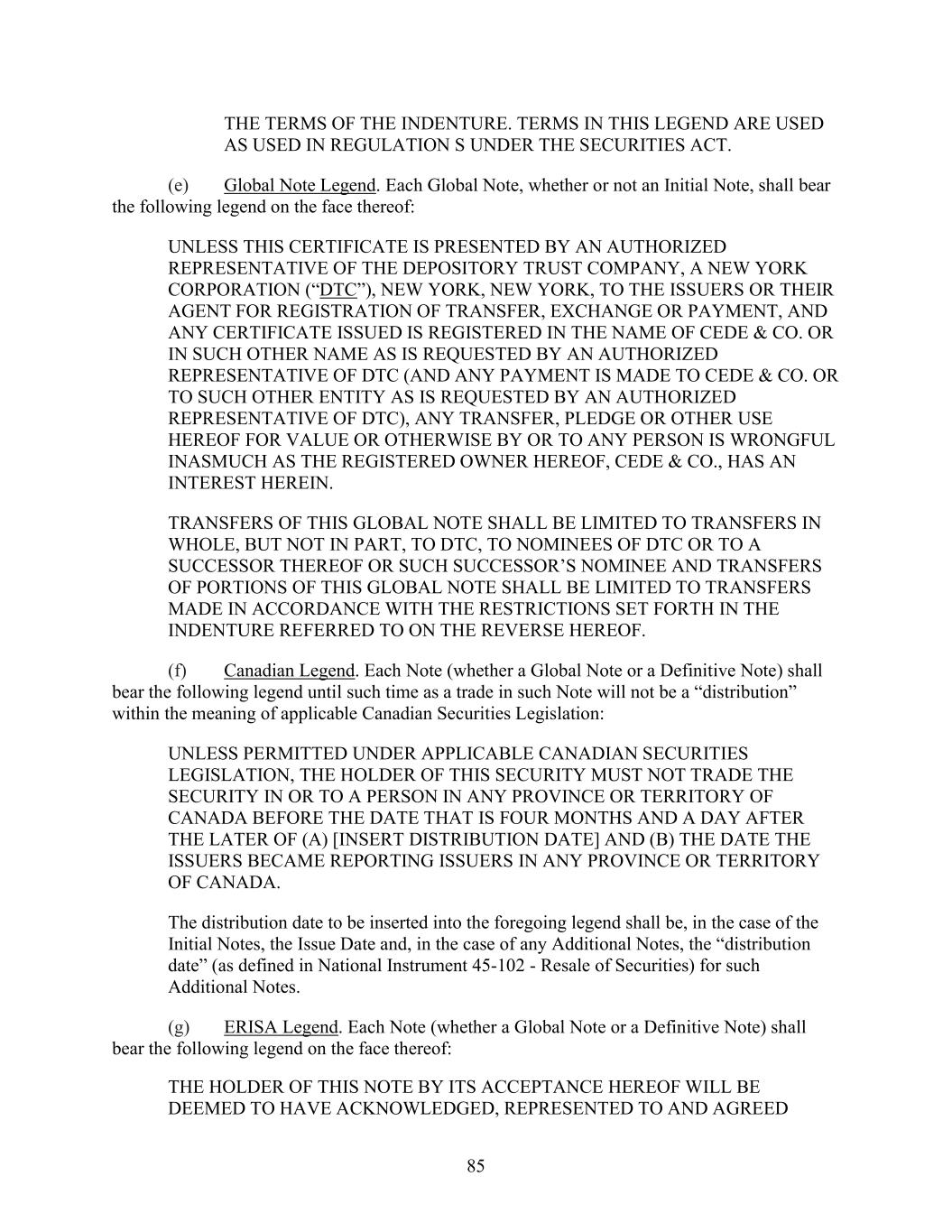
85 THE TERMS OF THE INDENTURE. TERMS IN THIS LEGEND ARE USED AS USED IN REGULATION S UNDER THE SECURITIES ACT. (e) Global Note Legend. Each Global Note, whether or not an Initial Note, shall bear the following legend on the face thereof: UNLESS THIS CERTIFICATE IS PRESENTED BY AN AUTHORIZED REPRESENTATIVE OF THE DEPOSITORY TRUST COMPANY, A NEW YORK CORPORATION (“DTC”), NEW YORK, NEW YORK, TO THE ISSUERS OR THEIR AGENT FOR REGISTRATION OF TRANSFER, EXCHANGE OR PAYMENT, AND ANY CERTIFICATE ISSUED IS REGISTERED IN THE NAME OF CEDE & CO. OR IN SUCH OTHER NAME AS IS REQUESTED BY AN AUTHORIZED REPRESENTATIVE OF DTC (AND ANY PAYMENT IS MADE TO CEDE & CO. OR TO SUCH OTHER ENTITY AS IS REQUESTED BY AN AUTHORIZED REPRESENTATIVE OF DTC), ANY TRANSFER, PLEDGE OR OTHER USE HEREOF FOR VALUE OR OTHERWISE BY OR TO ANY PERSON IS WRONGFUL INASMUCH AS THE REGISTERED OWNER HEREOF, CEDE & CO., HAS AN INTEREST HEREIN. TRANSFERS OF THIS GLOBAL NOTE SHALL BE LIMITED TO TRANSFERS IN WHOLE, BUT NOT IN PART, TO DTC, TO NOMINEES OF DTC OR TO A SUCCESSOR THEREOF OR SUCH SUCCESSOR’S NOMINEE AND TRANSFERS OF PORTIONS OF THIS GLOBAL NOTE SHALL BE LIMITED TO TRANSFERS MADE IN ACCORDANCE WITH THE RESTRICTIONS SET FORTH IN THE INDENTURE REFERRED TO ON THE REVERSE HEREOF. (f) Canadian Legend. Each Note (whether a Global Note or a Definitive Note) shall bear the following legend until such time as a trade in such Note will not be a “distribution” within the meaning of applicable Canadian Securities Legislation: UNLESS PERMITTED UNDER APPLICABLE CANADIAN SECURITIES LEGISLATION, THE HOLDER OF THIS SECURITY MUST NOT TRADE THE SECURITY IN OR TO A PERSON IN ANY PROVINCE OR TERRITORY OF CANADA BEFORE THE DATE THAT IS FOUR MONTHS AND A DAY AFTER THE LATER OF (A) [INSERT DISTRIBUTION DATE] AND (B) THE DATE THE ISSUERS BECAME REPORTING ISSUERS IN ANY PROVINCE OR TERRITORY OF CANADA. The distribution date to be inserted into the foregoing legend shall be, in the case of the Initial Notes, the Issue Date and, in the case of any Additional Notes, the “distribution date” (as defined in National Instrument 45-102 - Resale of Securities) for such Additional Notes. (g) ERISA Legend. Each Note (whether a Global Note or a Definitive Note) shall bear the following legend on the face thereof: THE HOLDER OF THIS NOTE BY ITS ACCEPTANCE HEREOF WILL BE DEEMED TO HAVE ACKNOWLEDGED, REPRESENTED TO AND AGREED
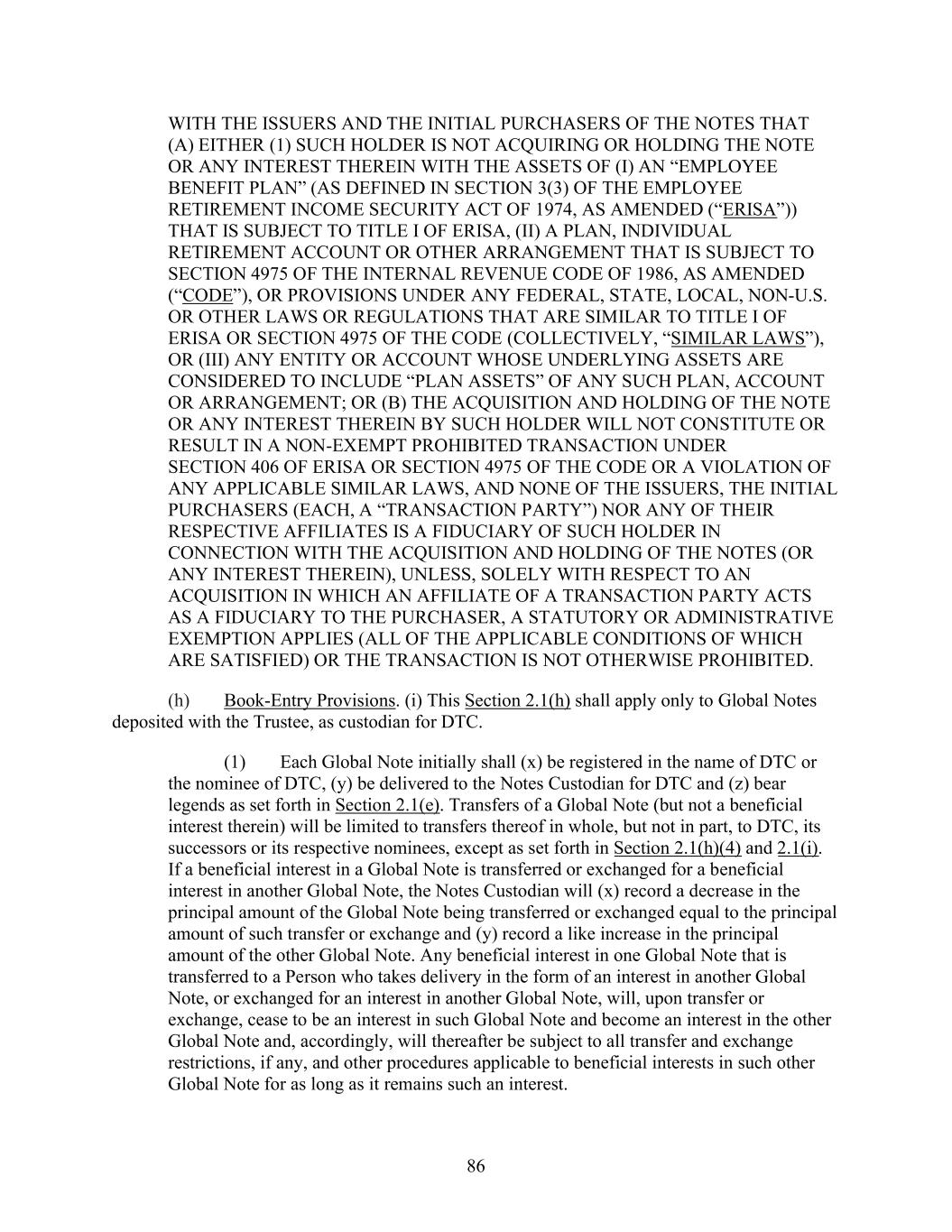
86 WITH THE ISSUERS AND THE INITIAL PURCHASERS OF THE NOTES THAT (A) EITHER (1) SUCH HOLDER IS NOT ACQUIRING OR HOLDING THE NOTE OR ANY INTEREST THEREIN WITH THE ASSETS OF (I) AN “EMPLOYEE BENEFIT PLAN” (AS DEFINED IN SECTION 3(3) OF THE EMPLOYEE RETIREMENT INCOME SECURITY ACT OF 1974, AS AMENDED (“ERISA”)) THAT IS SUBJECT TO TITLE I OF ERISA, (II) A PLAN, INDIVIDUAL RETIREMENT ACCOUNT OR OTHER ARRANGEMENT THAT IS SUBJECT TO SECTION 4975 OF THE INTERNAL REVENUE CODE OF 1986, AS AMENDED (“CODE”), OR PROVISIONS UNDER ANY FEDERAL, STATE, LOCAL, NON-U.S. OR OTHER LAWS OR REGULATIONS THAT ARE SIMILAR TO TITLE I OF ERISA OR SECTION 4975 OF THE CODE (COLLECTIVELY, “SIMILAR LAWS”), OR (III) ANY ENTITY OR ACCOUNT WHOSE UNDERLYING ASSETS ARE CONSIDERED TO INCLUDE “PLAN ASSETS” OF ANY SUCH PLAN, ACCOUNT OR ARRANGEMENT; OR (B) THE ACQUISITION AND HOLDING OF THE NOTE OR ANY INTEREST THEREIN BY SUCH HOLDER WILL NOT CONSTITUTE OR RESULT IN A NON-EXEMPT PROHIBITED TRANSACTION UNDER SECTION 406 OF ERISA OR SECTION 4975 OF THE CODE OR A VIOLATION OF ANY APPLICABLE SIMILAR LAWS, AND NONE OF THE ISSUERS, THE INITIAL PURCHASERS (EACH, A “TRANSACTION PARTY”) NOR ANY OF THEIR RESPECTIVE AFFILIATES IS A FIDUCIARY OF SUCH HOLDER IN CONNECTION WITH THE ACQUISITION AND HOLDING OF THE NOTES (OR ANY INTEREST THEREIN), UNLESS, SOLELY WITH RESPECT TO AN ACQUISITION IN WHICH AN AFFILIATE OF A TRANSACTION PARTY ACTS AS A FIDUCIARY TO THE PURCHASER, A STATUTORY OR ADMINISTRATIVE EXEMPTION APPLIES (ALL OF THE APPLICABLE CONDITIONS OF WHICH ARE SATISFIED) OR THE TRANSACTION IS NOT OTHERWISE PROHIBITED. (h) Book-Entry Provisions. (i) This Section 2.1(h) shall apply only to Global Notes deposited with the Trustee, as custodian for DTC. (1) Each Global Note initially shall (x) be registered in the name of DTC or the nominee of DTC, (y) be delivered to the Notes Custodian for DTC and (z) bear legends as set forth in Section 2.1(e). Transfers of a Global Note (but not a beneficial interest therein) will be limited to transfers thereof in whole, but not in part, to DTC, its successors or its respective nominees, except as set forth in Section 2.1(h)(4) and 2.1(i). If a beneficial interest in a Global Note is transferred or exchanged for a beneficial interest in another Global Note, the Notes Custodian will (x) record a decrease in the principal amount of the Global Note being transferred or exchanged equal to the principal amount of such transfer or exchange and (y) record a like increase in the principal amount of the other Global Note. Any beneficial interest in one Global Note that is transferred to a Person who takes delivery in the form of an interest in another Global Note, or exchanged for an interest in another Global Note, will, upon transfer or exchange, cease to be an interest in such Global Note and become an interest in the other Global Note and, accordingly, will thereafter be subject to all transfer and exchange restrictions, if any, and other procedures applicable to beneficial interests in such other Global Note for as long as it remains such an interest.
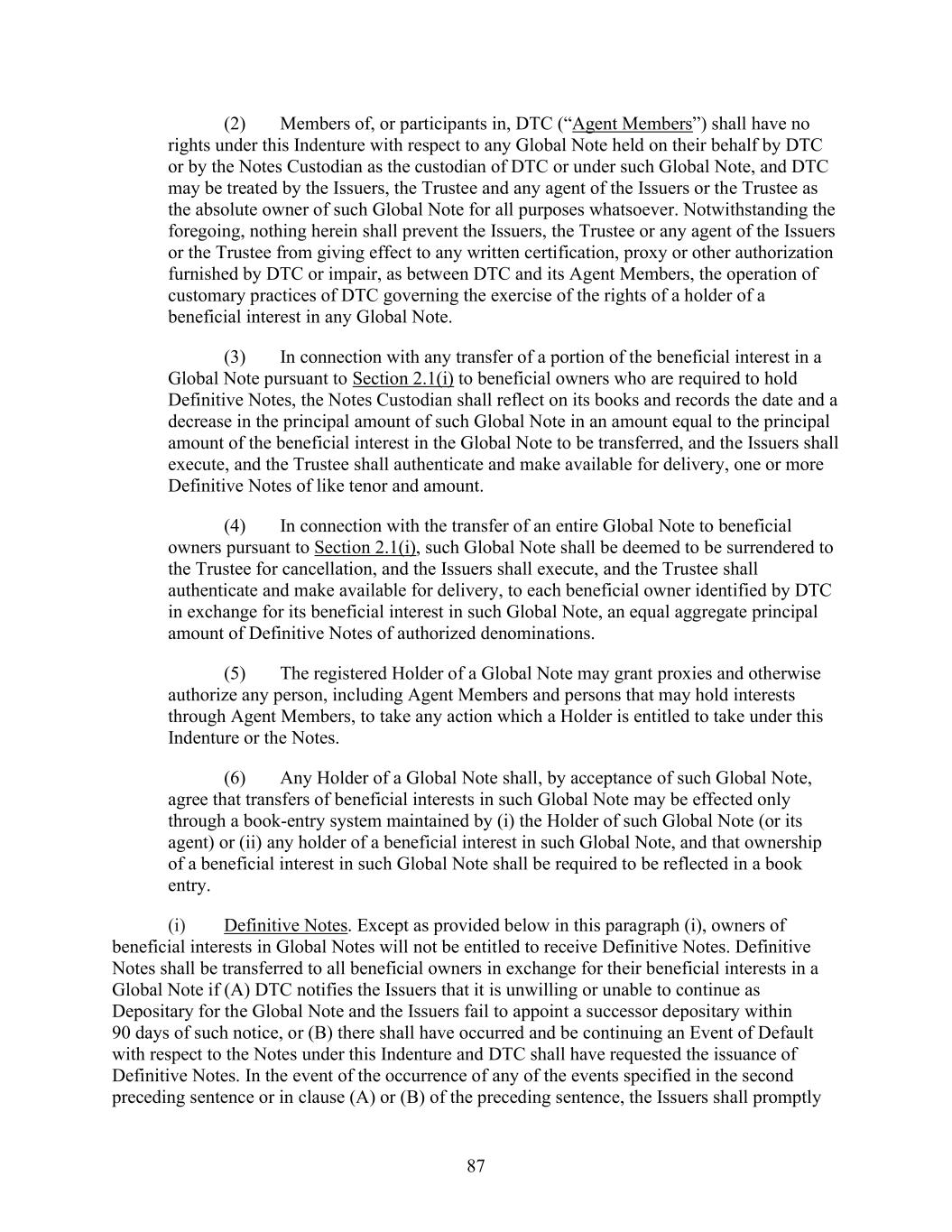
87 (2) Members of, or participants in, DTC (“Agent Members”) shall have no rights under this Indenture with respect to any Global Note held on their behalf by DTC or by the Notes Custodian as the custodian of DTC or under such Global Note, and DTC may be treated by the Issuers, the Trustee and any agent of the Issuers or the Trustee as the absolute owner of such Global Note for all purposes whatsoever. Notwithstanding the foregoing, nothing herein shall prevent the Issuers, the Trustee or any agent of the Issuers or the Trustee from giving effect to any written certification, proxy or other authorization furnished by DTC or impair, as between DTC and its Agent Members, the operation of customary practices of DTC governing the exercise of the rights of a holder of a beneficial interest in any Global Note. (3) In connection with any transfer of a portion of the beneficial interest in a Global Note pursuant to Section 2.1(i) to beneficial owners who are required to hold Definitive Notes, the Notes Custodian shall reflect on its books and records the date and a decrease in the principal amount of such Global Note in an amount equal to the principal amount of the beneficial interest in the Global Note to be transferred, and the Issuers shall execute, and the Trustee shall authenticate and make available for delivery, one or more Definitive Notes of like tenor and amount. (4) In connection with the transfer of an entire Global Note to beneficial owners pursuant to Section 2.1(i), such Global Note shall be deemed to be surrendered to the Trustee for cancellation, and the Issuers shall execute, and the Trustee shall authenticate and make available for delivery, to each beneficial owner identified by DTC in exchange for its beneficial interest in such Global Note, an equal aggregate principal amount of Definitive Notes of authorized denominations. (5) The registered Holder of a Global Note may grant proxies and otherwise authorize any person, including Agent Members and persons that may hold interests through Agent Members, to take any action which a Holder is entitled to take under this Indenture or the Notes. (6) Any Holder of a Global Note shall, by acceptance of such Global Note, agree that transfers of beneficial interests in such Global Note may be effected only through a book-entry system maintained by (i) the Holder of such Global Note (or its agent) or (ii) any holder of a beneficial interest in such Global Note, and that ownership of a beneficial interest in such Global Note shall be required to be reflected in a book entry. (i) Definitive Notes. Except as provided below in this paragraph (i), owners of beneficial interests in Global Notes will not be entitled to receive Definitive Notes. Definitive Notes shall be transferred to all beneficial owners in exchange for their beneficial interests in a Global Note if (A) DTC notifies the Issuers that it is unwilling or unable to continue as Depositary for the Global Note and the Issuers fail to appoint a successor depositary within 90 days of such notice, or (B) there shall have occurred and be continuing an Event of Default with respect to the Notes under this Indenture and DTC shall have requested the issuance of Definitive Notes. In the event of the occurrence of any of the events specified in the second preceding sentence or in clause (A) or (B) of the preceding sentence, the Issuers shall promptly
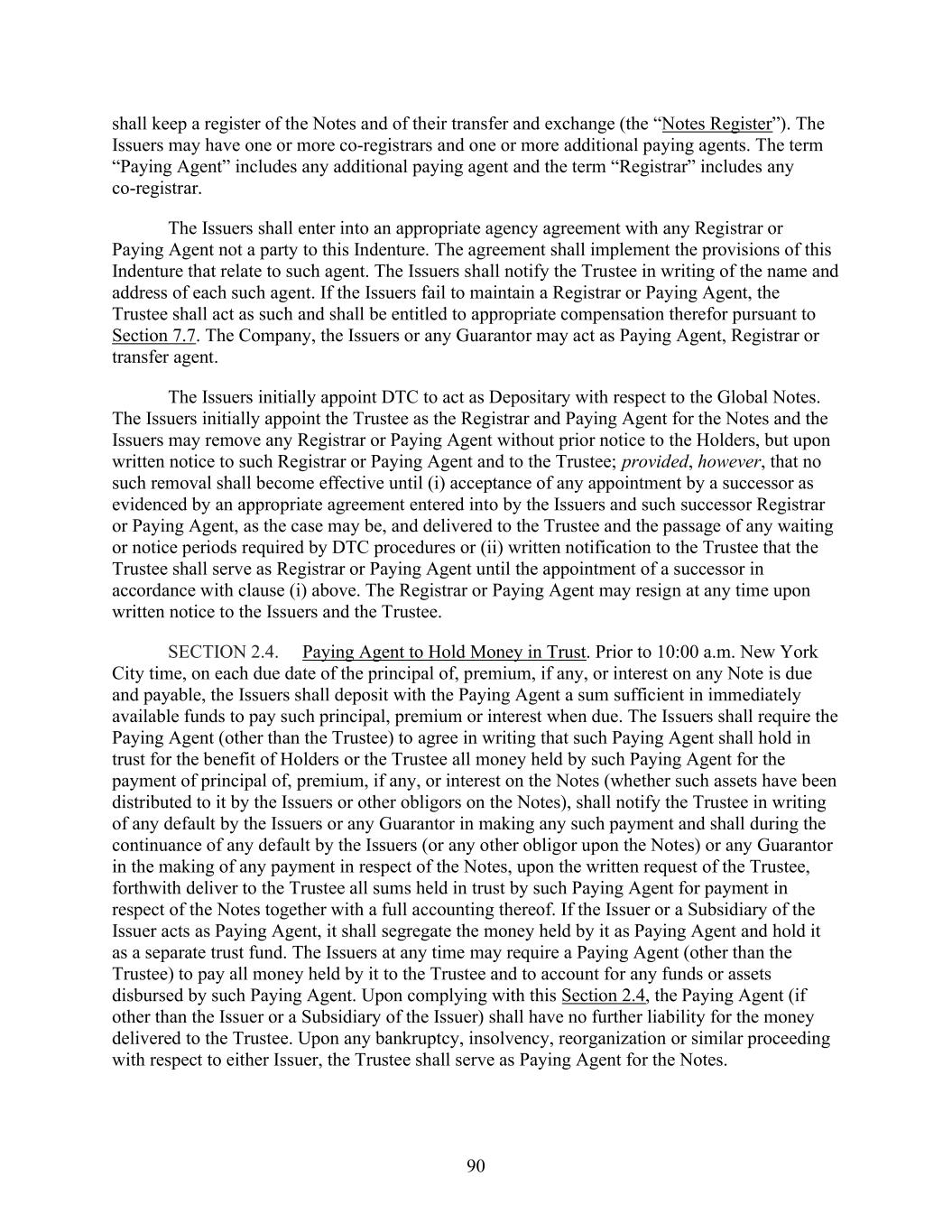
90 shall keep a register of the Notes and of their transfer and exchange (the “Notes Register”). The Issuers may have one or more co-registrars and one or more additional paying agents. The term “Paying Agent” includes any additional paying agent and the term “Registrar” includes any co-registrar. The Issuers shall enter into an appropriate agency agreement with any Registrar or Paying Agent not a party to this Indenture. The agreement shall implement the provisions of this Indenture that relate to such agent. The Issuers shall notify the Trustee in writing of the name and address of each such agent. If the Issuers fail to maintain a Registrar or Paying Agent, the Trustee shall act as such and shall be entitled to appropriate compensation therefor pursuant to Section 7.7. The Company, the Issuers or any Guarantor may act as Paying Agent, Registrar or transfer agent. The Issuers initially appoint DTC to act as Depositary with respect to the Global Notes. The Issuers initially appoint the Trustee as the Registrar and Paying Agent for the Notes and the Issuers may remove any Registrar or Paying Agent without prior notice to the Holders, but upon written notice to such Registrar or Paying Agent and to the Trustee; provided, however, that no such removal shall become effective until (i) acceptance of any appointment by a successor as evidenced by an appropriate agreement entered into by the Issuers and such successor Registrar or Paying Agent, as the case may be, and delivered to the Trustee and the passage of any waiting or notice periods required by DTC procedures or (ii) written notification to the Trustee that the Trustee shall serve as Registrar or Paying Agent until the appointment of a successor in accordance with clause (i) above. The Registrar or Paying Agent may resign at any time upon written notice to the Issuers and the Trustee. SECTION 2.4. Paying Agent to Hold Money in Trust. Prior to 10:00 a.m. New York City time, on each due date of the principal of, premium, if any, or interest on any Note is due and payable, the Issuers shall deposit with the Paying Agent a sum sufficient in immediately available funds to pay such principal, premium or interest when due. The Issuers shall require the Paying Agent (other than the Trustee) to agree in writing that such Paying Agent shall hold in trust for the benefit of Holders or the Trustee all money held by such Paying Agent for the payment of principal of, premium, if any, or interest on the Notes (whether such assets have been distributed to it by the Issuers or other obligors on the Notes), shall notify the Trustee in writing of any default by the Issuers or any Guarantor in making any such payment and shall during the continuance of any default by the Issuers (or any other obligor upon the Notes) or any Guarantor in the making of any payment in respect of the Notes, upon the written request of the Trustee, forthwith deliver to the Trustee all sums held in trust by such Paying Agent for payment in respect of the Notes together with a full accounting thereof. If the Issuer or a Subsidiary of the Issuer acts as Paying Agent, it shall segregate the money held by it as Paying Agent and hold it as a separate trust fund. The Issuers at any time may require a Paying Agent (other than the Trustee) to pay all money held by it to the Trustee and to account for any funds or assets disbursed by such Paying Agent. Upon complying with this Section 2.4, the Paying Agent (if other than the Issuer or a Subsidiary of the Issuer) shall have no further liability for the money delivered to the Trustee. Upon any bankruptcy, insolvency, reorganization or similar proceeding with respect to either Issuer, the Trustee shall serve as Paying Agent for the Notes.
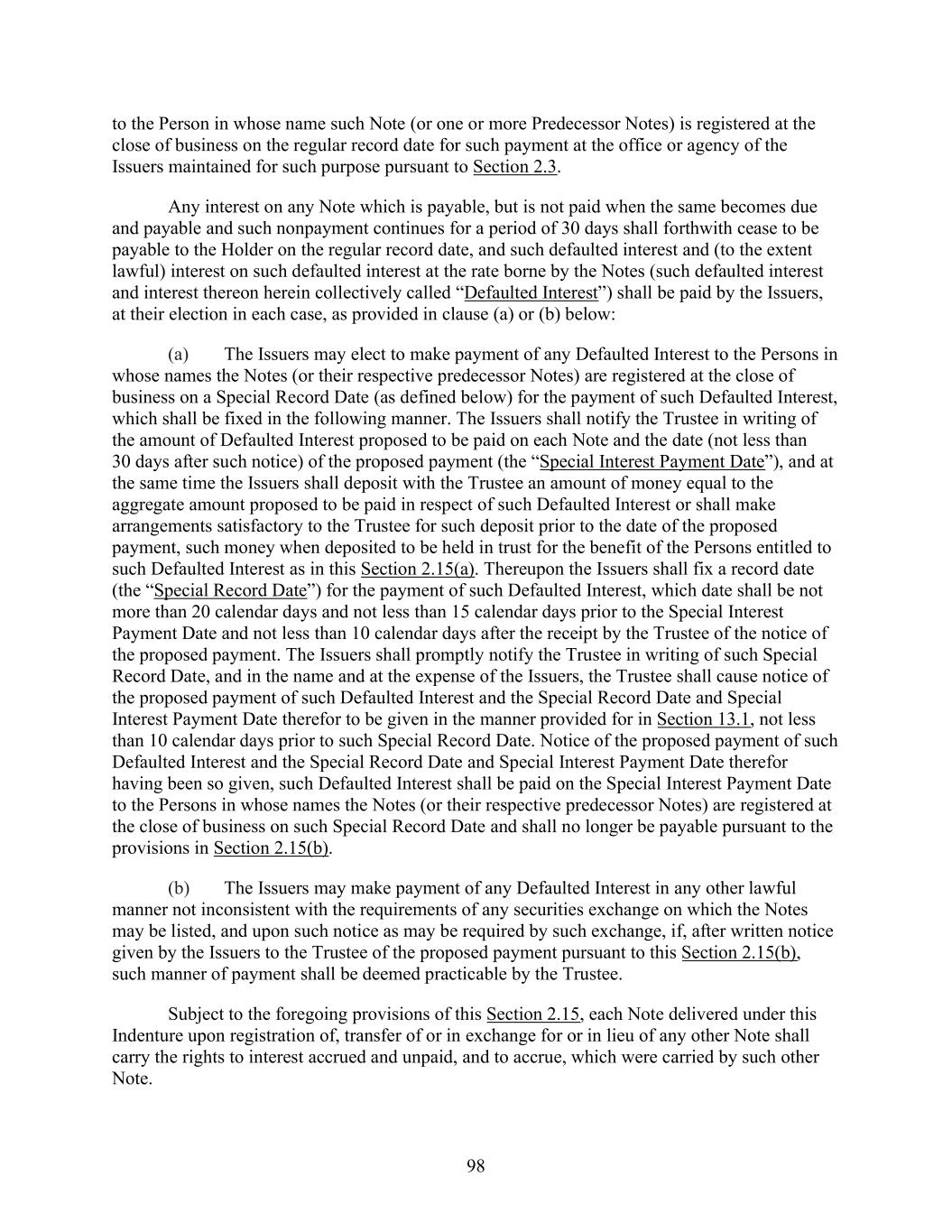
98 to the Person in whose name such Note (or one or more Predecessor Notes) is registered at the close of business on the regular record date for such payment at the office or agency of the Issuers maintained for such purpose pursuant to Section 2.3. Any interest on any Note which is payable, but is not paid when the same becomes due and payable and such nonpayment continues for a period of 30 days shall forthwith cease to be payable to the Holder on the regular record date, and such defaulted interest and (to the extent lawful) interest on such defaulted interest at the rate borne by the Notes (such defaulted interest and interest thereon herein collectively called “Defaulted Interest”) shall be paid by the Issuers, at their election in each case, as provided in clause (a) or (b) below: (a) The Issuers may elect to make payment of any Defaulted Interest to the Persons in whose names the Notes (or their respective predecessor Notes) are registered at the close of business on a Special Record Date (as defined below) for the payment of such Defaulted Interest, which shall be fixed in the following manner. The Issuers shall notify the Trustee in writing of the amount of Defaulted Interest proposed to be paid on each Note and the date (not less than 30 days after such notice) of the proposed payment (the “Special Interest Payment Date”), and at the same time the Issuers shall deposit with the Trustee an amount of money equal to the aggregate amount proposed to be paid in respect of such Defaulted Interest or shall make arrangements satisfactory to the Trustee for such deposit prior to the date of the proposed payment, such money when deposited to be held in trust for the benefit of the Persons entitled to such Defaulted Interest as in this Section 2.15(a). Thereupon the Issuers shall fix a record date (the “Special Record Date”) for the payment of such Defaulted Interest, which date shall be not more than 20 calendar days and not less than 15 calendar days prior to the Special Interest Payment Date and not less than 10 calendar days after the receipt by the Trustee of the notice of the proposed payment. The Issuers shall promptly notify the Trustee in writing of such Special Record Date, and in the name and at the expense of the Issuers, the Trustee shall cause notice of the proposed payment of such Defaulted Interest and the Special Record Date and Special Interest Payment Date therefor to be given in the manner provided for in Section 13.1, not less than 10 calendar days prior to such Special Record Date. Notice of the proposed payment of such Defaulted Interest and the Special Record Date and Special Interest Payment Date therefor having been so given, such Defaulted Interest shall be paid on the Special Interest Payment Date to the Persons in whose names the Notes (or their respective predecessor Notes) are registered at the close of business on such Special Record Date and shall no longer be payable pursuant to the provisions in Section 2.15(b). (b) The Issuers may make payment of any Defaulted Interest in any other lawful manner not inconsistent with the requirements of any securities exchange on which the Notes may be listed, and upon such notice as may be required by such exchange, if, after written notice given by the Issuers to the Trustee of the proposed payment pursuant to this Section 2.15(b), such manner of payment shall be deemed practicable by the Trustee. Subject to the foregoing provisions of this Section 2.15, each Note delivered under this Indenture upon registration of, transfer of or in exchange for or in lieu of any other Note shall carry the rights to interest accrued and unpaid, and to accrue, which were carried by such other Note.

100 provided further that Non-Guarantors may not Incur Indebtedness under this Section 3.2(a) if, after giving pro forma effect to such Incurrence (including a pro forma application of the net proceeds therefrom), more than an aggregate of the greater of (a) $1,250.0 million and (b) 50.0% of LTM EBITDA of Indebtedness of Non-Guarantors would be outstanding pursuant to this Section 3.2(a) at such time. (b) Section 3.2(a) shall not prohibit the Incurrence of the following Indebtedness (collectively, “Permitted Debt”): (1) Indebtedness Incurred under any Credit Facility (including letters of credit or bankers’ acceptances issued or created under any Credit Facility), and Guarantees in respect of such Indebtedness, up to an aggregate principal amount at the time of incurrence not exceeding the sum of (a) $8,000.0 million plus (b) the greater of (x) $2,500.0 million and (y) the aggregate amount of LTM EBITDA plus (c) an additional amount after all amounts have been incurred under clauses (1)(a) and (b), if after giving pro forma effect to the incurrence of such additional amount and the application of the proceeds therefrom, the Consolidated First Lien Secured Leverage Ratio would be no greater than 4.50 to 1.00 (or such ratio would not be higher than it was immediately prior to such Incurrence) outstanding at any one time, and any Refinancing Indebtedness in respect thereof; (2) Guarantees by the Company or any Restricted Subsidiary of Indebtedness or other obligations of the Company or any Restricted Subsidiary so long as the Incurrence of such Indebtedness or other obligations is not prohibited by the terms of this Indenture and any incurrence by the Co-Issuer of Indebtedness as a co-issuer of Indebtedness of the Issuer that was permitted to be incurred under this Indenture; (3) Indebtedness of the Company to any Restricted Subsidiary or Indebtedness of a Restricted Subsidiary to the Company or any Restricted Subsidiary; provided, however, that: (i) any subsequent issuance or transfer of Capital Stock or any other event which results in any such Indebtedness being beneficially held by a Person other than the Company or a Restricted Subsidiary; and (ii) any sale or other transfer of any such Indebtedness to a Person other than the Company or a Restricted Subsidiary, shall be deemed, in each case, to constitute an Incurrence of such Indebtedness by the Company or such Restricted Subsidiary, as the case may be; (4) Indebtedness represented by (i) the Notes (other than any Additional Notes), including any Guarantee thereof, (ii) any Indebtedness (other than Indebtedness incurred pursuant to Sections 3.2(b)(1) and (4)(i)) outstanding on the Issue Date, including the Existing Notes and any Guarantees thereof (including any exchange notes and related exchange guarantees issued in respect of such Existing Notes and excluding any “additional notes” issued pursuant to the indentures governing such Existing Notes), (iii) Refinancing Indebtedness (including with respect to the Notes and any Guarantee
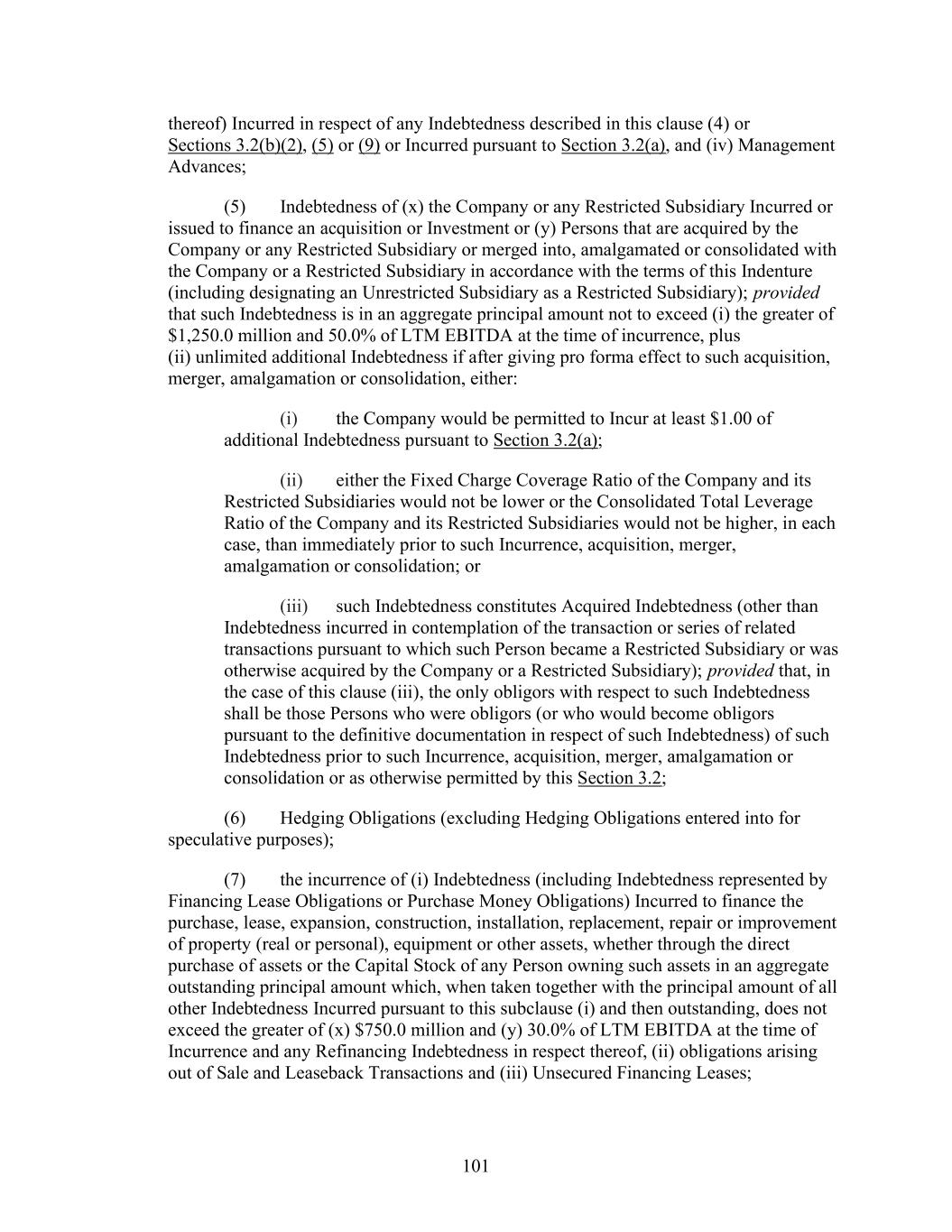
101 thereof) Incurred in respect of any Indebtedness described in this clause (4) or Sections 3.2(b)(2), (5) or (9) or Incurred pursuant to Section 3.2(a), and (iv) Management Advances; (5) Indebtedness of (x) the Company or any Restricted Subsidiary Incurred or issued to finance an acquisition or Investment or (y) Persons that are acquired by the Company or any Restricted Subsidiary or merged into, amalgamated or consolidated with the Company or a Restricted Subsidiary in accordance with the terms of this Indenture (including designating an Unrestricted Subsidiary as a Restricted Subsidiary); provided that such Indebtedness is in an aggregate principal amount not to exceed (i) the greater of $1,250.0 million and 50.0% of LTM EBITDA at the time of incurrence, plus (ii) unlimited additional Indebtedness if after giving pro forma effect to such acquisition, merger, amalgamation or consolidation, either: (i) the Company would be permitted to Incur at least $1.00 of additional Indebtedness pursuant to Section 3.2(a); (ii) either the Fixed Charge Coverage Ratio of the Company and its Restricted Subsidiaries would not be lower or the Consolidated Total Leverage Ratio of the Company and its Restricted Subsidiaries would not be higher, in each case, than immediately prior to such Incurrence, acquisition, merger, amalgamation or consolidation; or (iii) such Indebtedness constitutes Acquired Indebtedness (other than Indebtedness incurred in contemplation of the transaction or series of related transactions pursuant to which such Person became a Restricted Subsidiary or was otherwise acquired by the Company or a Restricted Subsidiary); provided that, in the case of this clause (iii), the only obligors with respect to such Indebtedness shall be those Persons who were obligors (or who would become obligors pursuant to the definitive documentation in respect of such Indebtedness) of such Indebtedness prior to such Incurrence, acquisition, merger, amalgamation or consolidation or as otherwise permitted by this Section 3.2; (6) Hedging Obligations (excluding Hedging Obligations entered into for speculative purposes); (7) the incurrence of (i) Indebtedness (including Indebtedness represented by Financing Lease Obligations or Purchase Money Obligations) Incurred to finance the purchase, lease, expansion, construction, installation, replacement, repair or improvement of property (real or personal), equipment or other assets, whether through the direct purchase of assets or the Capital Stock of any Person owning such assets in an aggregate outstanding principal amount which, when taken together with the principal amount of all other Indebtedness Incurred pursuant to this subclause (i) and then outstanding, does not exceed the greater of (x) $750.0 million and (y) 30.0% of LTM EBITDA at the time of Incurrence and any Refinancing Indebtedness in respect thereof, (ii) obligations arising out of Sale and Leaseback Transactions and (iii) Unsecured Financing Leases;
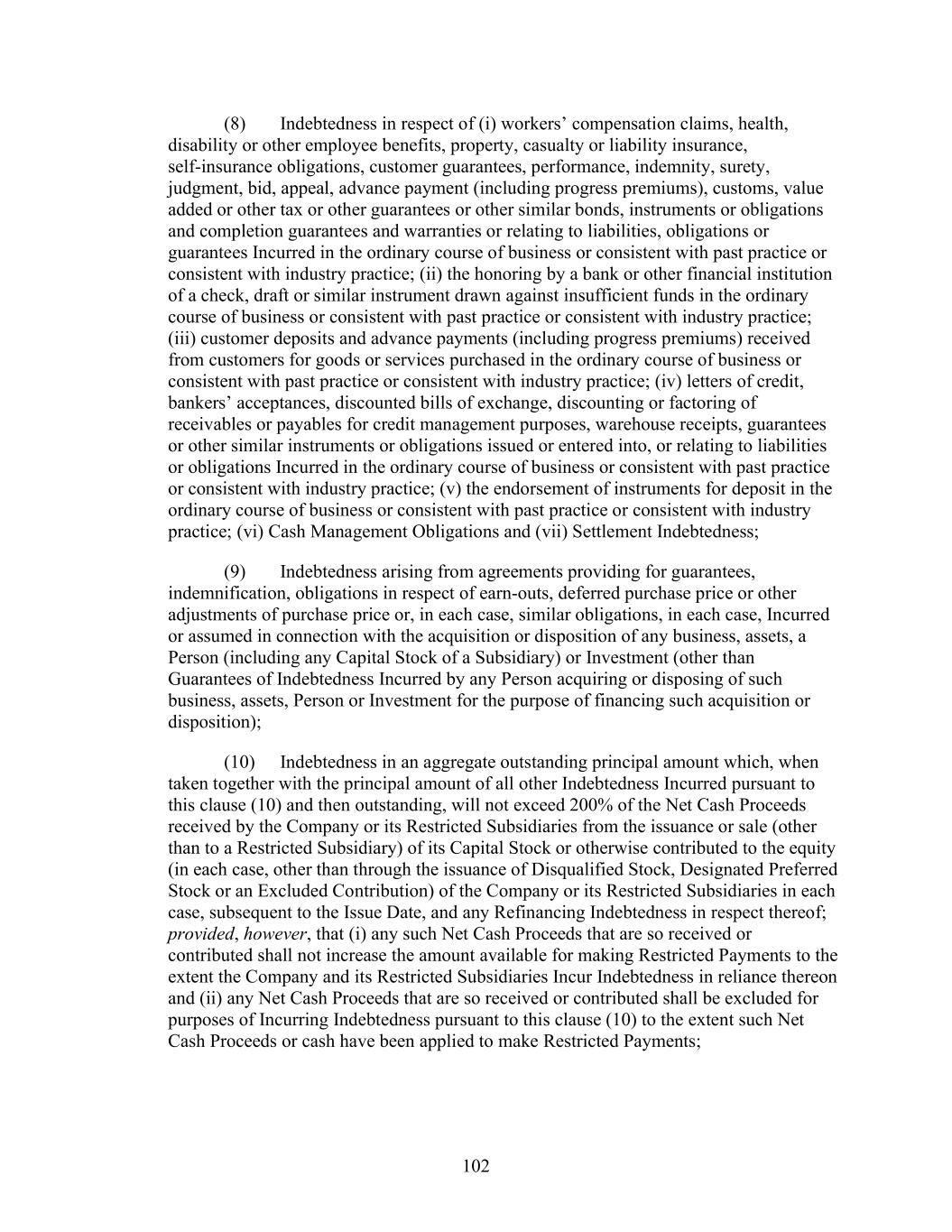
102 (8) Indebtedness in respect of (i) workers’ compensation claims, health, disability or other employee benefits, property, casualty or liability insurance, self-insurance obligations, customer guarantees, performance, indemnity, surety, judgment, bid, appeal, advance payment (including progress premiums), customs, value added or other tax or other guarantees or other similar bonds, instruments or obligations and completion guarantees and warranties or relating to liabilities, obligations or guarantees Incurred in the ordinary course of business or consistent with past practice or consistent with industry practice; (ii) the honoring by a bank or other financial institution of a check, draft or similar instrument drawn against insufficient funds in the ordinary course of business or consistent with past practice or consistent with industry practice; (iii) customer deposits and advance payments (including progress premiums) received from customers for goods or services purchased in the ordinary course of business or consistent with past practice or consistent with industry practice; (iv) letters of credit, bankers’ acceptances, discounted bills of exchange, discounting or factoring of receivables or payables for credit management purposes, warehouse receipts, guarantees or other similar instruments or obligations issued or entered into, or relating to liabilities or obligations Incurred in the ordinary course of business or consistent with past practice or consistent with industry practice; (v) the endorsement of instruments for deposit in the ordinary course of business or consistent with past practice or consistent with industry practice; (vi) Cash Management Obligations and (vii) Settlement Indebtedness; (9) Indebtedness arising from agreements providing for guarantees, indemnification, obligations in respect of earn-outs, deferred purchase price or other adjustments of purchase price or, in each case, similar obligations, in each case, Incurred or assumed in connection with the acquisition or disposition of any business, assets, a Person (including any Capital Stock of a Subsidiary) or Investment (other than Guarantees of Indebtedness Incurred by any Person acquiring or disposing of such business, assets, Person or Investment for the purpose of financing such acquisition or disposition); (10) Indebtedness in an aggregate outstanding principal amount which, when taken together with the principal amount of all other Indebtedness Incurred pursuant to this clause (10) and then outstanding, will not exceed 200% of the Net Cash Proceeds received by the Company or its Restricted Subsidiaries from the issuance or sale (other than to a Restricted Subsidiary) of its Capital Stock or otherwise contributed to the equity (in each case, other than through the issuance of Disqualified Stock, Designated Preferred Stock or an Excluded Contribution) of the Company or its Restricted Subsidiaries in each case, subsequent to the Issue Date, and any Refinancing Indebtedness in respect thereof; provided, however, that (i) any such Net Cash Proceeds that are so received or contributed shall not increase the amount available for making Restricted Payments to the extent the Company and its Restricted Subsidiaries Incur Indebtedness in reliance thereon and (ii) any Net Cash Proceeds that are so received or contributed shall be excluded for purposes of Incurring Indebtedness pursuant to this clause (10) to the extent such Net Cash Proceeds or cash have been applied to make Restricted Payments;

103 (11) Indebtedness of Non-Guarantors in an aggregate principal amount not to exceed the greater of (i) $2,500.0 million and (ii) 75.0% of LTM EBITDA at the time of incurrence, and any Refinancing Indebtedness in respect thereof; (12) (i) Indebtedness issued by the Company or any of its Subsidiaries to any future, present or former employee, director, officer, manager, contractor, consultant or advisor (or their respective Controlled Investment Affiliates or Immediate Family Members) of the Company, any of its Subsidiaries or any Parent Entity (or permitted transferees, assigns, estates, or heirs of such employee, director, contractor or consultant), in each case to finance the purchase or redemption of Capital Stock of the Company or any Parent Entity that is not prohibited by Section 3.3 hereof and (ii) Indebtedness representing deferred compensation or any other similar arrangements incurred in the ordinary course of business, consistent with past practice or consistent with industry practice or in connection with the Transactions, any Investment or any acquisition (by merger, consolidation, amalgamation or otherwise); (13) Indebtedness of the Company or any of its Restricted Subsidiaries consisting of (i) the financing of insurance premiums, (ii) take-or-pay obligations contained in supply arrangements, in each case Incurred in the ordinary course of business or consistent with past practice or consistent with industry practice, (iii) obligations to reacquire assets or inventory in connection with customer financing arrangements in the ordinary course of business or consistent with past practice or consistent with industry practice or (iv) the financing of committed expenses or costs of services of the Company or any of its Restricted Subsidiaries (including in connection with any extended payment arrangement) to the extent not constituting Indebtedness for borrowed money; (14) Indebtedness in an aggregate outstanding principal amount which, when taken together with the principal amount of all other Indebtedness Incurred pursuant to this clause (14) and then outstanding, will not exceed the greater of (a) $1,875.0 million and (b) 60.0% of LTM EBITDA, and any Refinancing Indebtedness in respect thereof; (15) Indebtedness in respect of any Qualified Securitization Financing, any Permitted Receivables Financing or any Receivables Facility; (16) Guarantees of or the assumption of up to the greater of $500.0 million and 20.0% of LTM EBITDA at any time outstanding of Indebtedness of franchisees, suppliers, distributors or licensees of the Company and its Restricted Subsidiaries, in each case to the extent such guarantee or assumption constitutes a Permitted Investment; (17) Indebtedness incurred by the Company or any of its Restricted Subsidiaries to the extent that the net proceeds thereof are promptly deposited with the Trustee to satisfy or discharge the Notes or exercise the Issuers’ legal defeasance or covenant defeasance, in each case, in accordance with this Indenture;
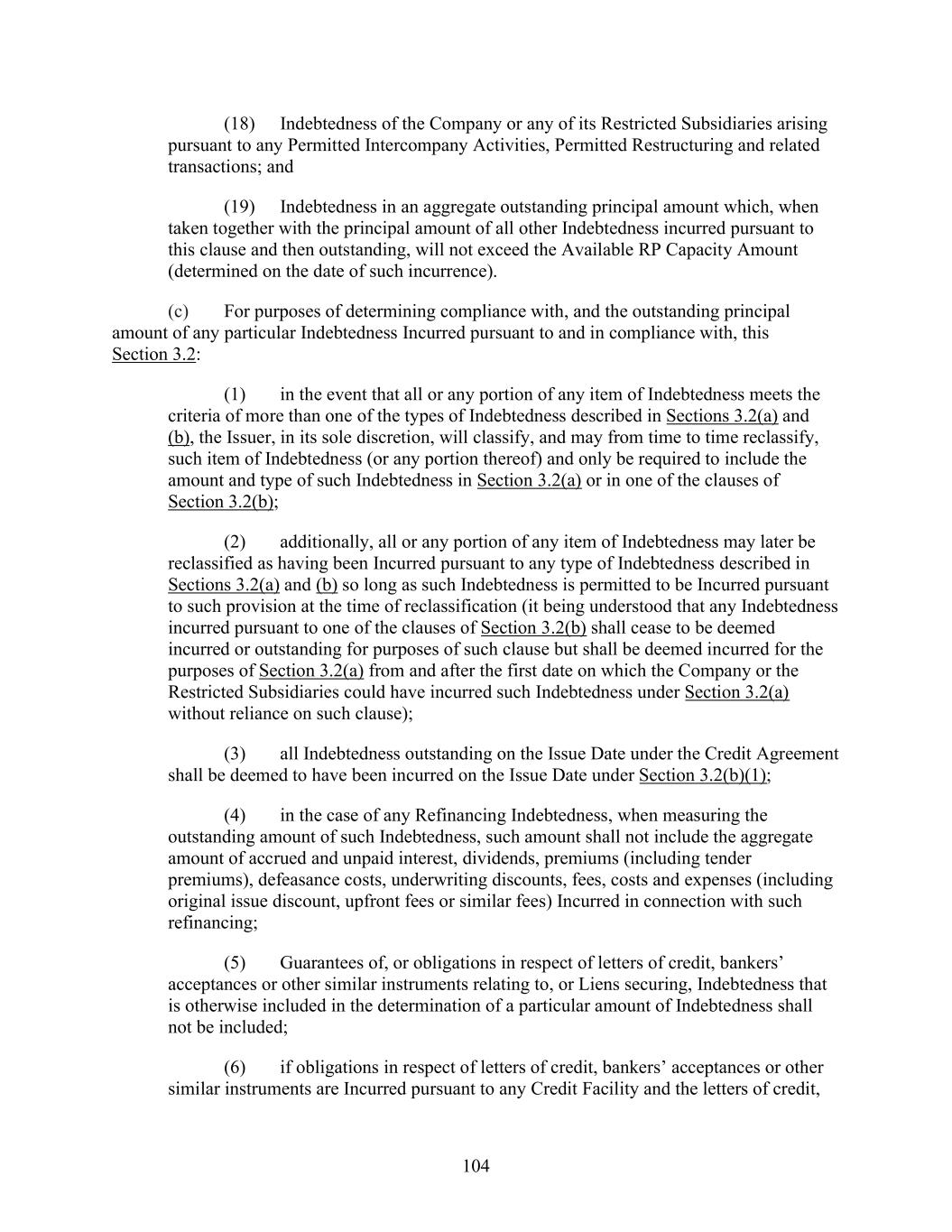
104 (18) Indebtedness of the Company or any of its Restricted Subsidiaries arising pursuant to any Permitted Intercompany Activities, Permitted Restructuring and related transactions; and (19) Indebtedness in an aggregate outstanding principal amount which, when taken together with the principal amount of all other Indebtedness incurred pursuant to this clause and then outstanding, will not exceed the Available RP Capacity Amount (determined on the date of such incurrence). (c) For purposes of determining compliance with, and the outstanding principal amount of any particular Indebtedness Incurred pursuant to and in compliance with, this Section 3.2: (1) in the event that all or any portion of any item of Indebtedness meets the criteria of more than one of the types of Indebtedness described in Sections 3.2(a) and (b), the Issuer, in its sole discretion, will classify, and may from time to time reclassify, such item of Indebtedness (or any portion thereof) and only be required to include the amount and type of such Indebtedness in Section 3.2(a) or in one of the clauses of Section 3.2(b); (2) additionally, all or any portion of any item of Indebtedness may later be reclassified as having been Incurred pursuant to any type of Indebtedness described in Sections 3.2(a) and (b) so long as such Indebtedness is permitted to be Incurred pursuant to such provision at the time of reclassification (it being understood that any Indebtedness incurred pursuant to one of the clauses of Section 3.2(b) shall cease to be deemed incurred or outstanding for purposes of such clause but shall be deemed incurred for the purposes of Section 3.2(a) from and after the first date on which the Company or the Restricted Subsidiaries could have incurred such Indebtedness under Section 3.2(a) without reliance on such clause); (3) all Indebtedness outstanding on the Issue Date under the Credit Agreement shall be deemed to have been incurred on the Issue Date under Section 3.2(b)(1); (4) in the case of any Refinancing Indebtedness, when measuring the outstanding amount of such Indebtedness, such amount shall not include the aggregate amount of accrued and unpaid interest, dividends, premiums (including tender premiums), defeasance costs, underwriting discounts, fees, costs and expenses (including original issue discount, upfront fees or similar fees) Incurred in connection with such refinancing; (5) Guarantees of, or obligations in respect of letters of credit, bankers’ acceptances or other similar instruments relating to, or Liens securing, Indebtedness that is otherwise included in the determination of a particular amount of Indebtedness shall not be included; (6) if obligations in respect of letters of credit, bankers’ acceptances or other similar instruments are Incurred pursuant to any Credit Facility and the letters of credit,

105 bankers’ acceptances or other similar instruments relate to other Indebtedness, then such other Indebtedness shall not be included; (7) the principal amount of any Disqualified Stock of the Company or a Restricted Subsidiary, or Preferred Stock of a Restricted Subsidiary, will be equal to the greater of the maximum mandatory redemption or repurchase price (not including, in either case, any redemption or repurchase premium) or the liquidation preference thereof; (8) Indebtedness permitted by this Section 3.2 need not be permitted solely by reference to one provision permitting such Indebtedness but may be permitted in part by one such provision and in part by one or more other provisions of this Section 3.2 permitting such Indebtedness; (9) for all purposes under this Indenture, including for purposes of calculating the Fixed Charge Coverage Ratio, the Consolidated First Lien Secured Leverage Ratio or the Consolidated Total Leverage Ratio, as applicable, in connection with the incurrence, issuance or assumption of any Indebtedness pursuant to Sections 3.2(a) or (b) or the incurrence or creation of any Lien pursuant to the definition of “Permitted Liens” or otherwise, the Company may elect, at its option, to treat all or any portion of the committed amount of any Indebtedness (and the issuance and creation of letters of credit and bankers’ acceptances thereunder) which is to be incurred (or any commitment in respect thereof) or secured by such Lien, as the case may be (any such committed amount elected until revoked as described below, the “Reserved Indebtedness Amount”), as being incurred as of such election date, and, if such Fixed Charge Coverage Ratio, the Consolidated First Lien Secured Leverage Ratio, the Consolidated Total Leverage Ratio or other provision of this Indenture, as applicable, is complied with (or satisfied) with respect thereto on such election date, any subsequent borrowing or reborrowing thereunder (and the issuance and creation of letters of credit and bankers’ acceptances thereunder) will be deemed to be permitted under this Section 3.2 or the definition of “Permitted Liens,” as applicable, whether or not the Fixed Charge Coverage Ratio, the Consolidated First Lien Secured Leverage Ratio, the Consolidated Total Leverage Ratio or other provision of this Indenture, as applicable, at the actual time of any subsequent borrowing or reborrowing (or issuance or creation of letters of credit or bankers’ acceptances thereunder) is complied with (or satisfied) for all purposes (including as to the absence of any continuing Default or Event of Default); provided that for purposes of subsequent calculations of the Fixed Charge Coverage Ratio, the Consolidated First Lien Secured Leverage Ratio, the Consolidated Total Leverage Ratio or other provision of this Indenture, as applicable, the Reserved Indebtedness Amount shall be deemed to be outstanding, whether or not such amount is actually outstanding, for so long as such commitments are outstanding or until the Company revokes an election of a Reserved Indebtedness Amount; (10) when calculating the availability under any basket or ratio under this Indenture or compliance with any provision of this Indenture in connection with any Limited Condition Transaction and any actions or transactions related thereto (including acquisitions, Investments, the incurrence, issuance or assumption of Indebtedness and the use of proceeds thereof, the incurrence or creation of Liens, repayments, Restricted
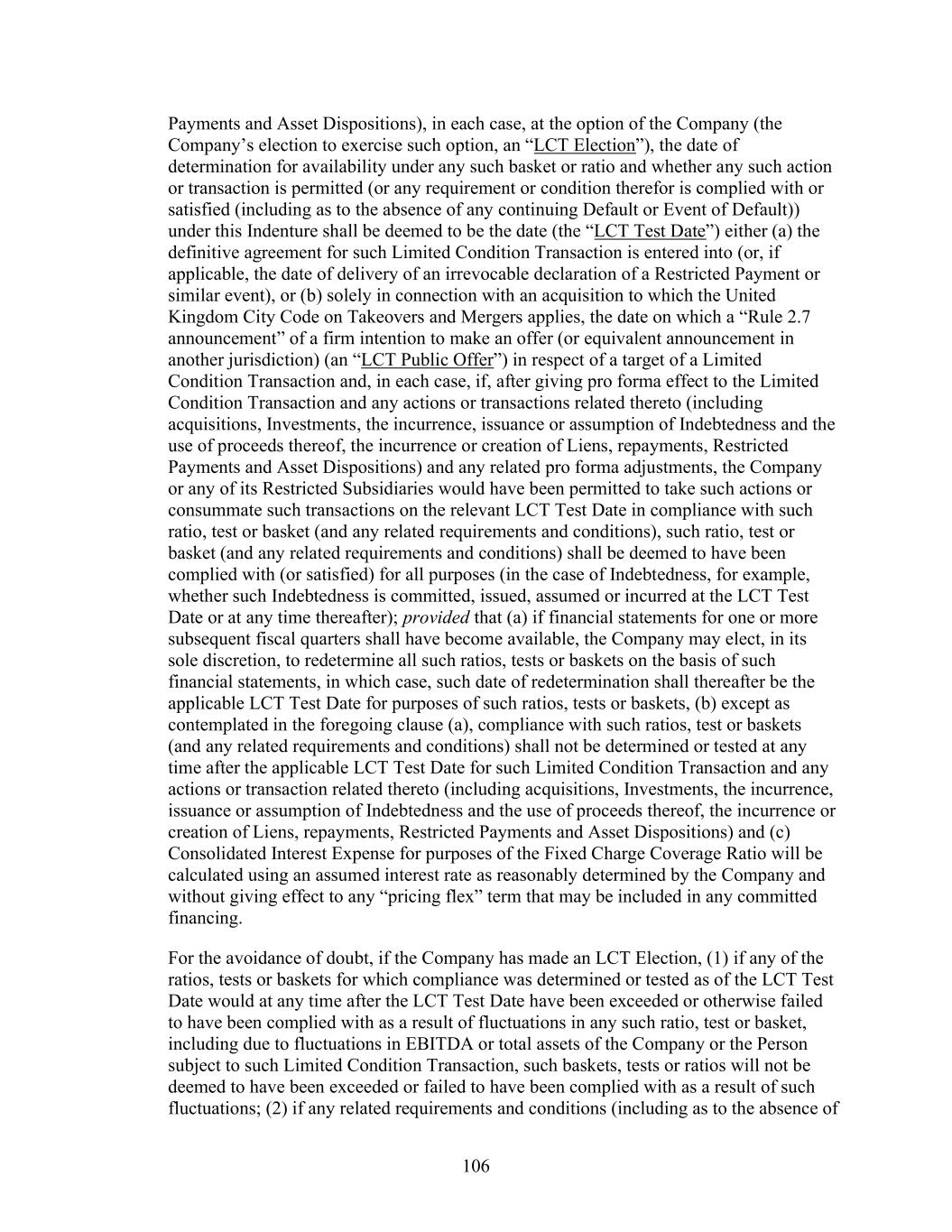
106 Payments and Asset Dispositions), in each case, at the option of the Company (the Company’s election to exercise such option, an “LCT Election”), the date of determination for availability under any such basket or ratio and whether any such action or transaction is permitted (or any requirement or condition therefor is complied with or satisfied (including as to the absence of any continuing Default or Event of Default)) under this Indenture shall be deemed to be the date (the “LCT Test Date”) either (a) the definitive agreement for such Limited Condition Transaction is entered into (or, if applicable, the date of delivery of an irrevocable declaration of a Restricted Payment or similar event), or (b) solely in connection with an acquisition to which the United Kingdom City Code on Takeovers and Mergers applies, the date on which a “Rule 2.7 announcement” of a firm intention to make an offer (or equivalent announcement in another jurisdiction) (an “LCT Public Offer”) in respect of a target of a Limited Condition Transaction and, in each case, if, after giving pro forma effect to the Limited Condition Transaction and any actions or transactions related thereto (including acquisitions, Investments, the incurrence, issuance or assumption of Indebtedness and the use of proceeds thereof, the incurrence or creation of Liens, repayments, Restricted Payments and Asset Dispositions) and any related pro forma adjustments, the Company or any of its Restricted Subsidiaries would have been permitted to take such actions or consummate such transactions on the relevant LCT Test Date in compliance with such ratio, test or basket (and any related requirements and conditions), such ratio, test or basket (and any related requirements and conditions) shall be deemed to have been complied with (or satisfied) for all purposes (in the case of Indebtedness, for example, whether such Indebtedness is committed, issued, assumed or incurred at the LCT Test Date or at any time thereafter); provided that (a) if financial statements for one or more subsequent fiscal quarters shall have become available, the Company may elect, in its sole discretion, to redetermine all such ratios, tests or baskets on the basis of such financial statements, in which case, such date of redetermination shall thereafter be the applicable LCT Test Date for purposes of such ratios, tests or baskets, (b) except as contemplated in the foregoing clause (a), compliance with such ratios, test or baskets (and any related requirements and conditions) shall not be determined or tested at any time after the applicable LCT Test Date for such Limited Condition Transaction and any actions or transaction related thereto (including acquisitions, Investments, the incurrence, issuance or assumption of Indebtedness and the use of proceeds thereof, the incurrence or creation of Liens, repayments, Restricted Payments and Asset Dispositions) and (c) Consolidated Interest Expense for purposes of the Fixed Charge Coverage Ratio will be calculated using an assumed interest rate as reasonably determined by the Company and without giving effect to any “pricing flex” term that may be included in any committed financing. For the avoidance of doubt, if the Company has made an LCT Election, (1) if any of the ratios, tests or baskets for which compliance was determined or tested as of the LCT Test Date would at any time after the LCT Test Date have been exceeded or otherwise failed to have been complied with as a result of fluctuations in any such ratio, test or basket, including due to fluctuations in EBITDA or total assets of the Company or the Person subject to such Limited Condition Transaction, such baskets, tests or ratios will not be deemed to have been exceeded or failed to have been complied with as a result of such fluctuations; (2) if any related requirements and conditions (including as to the absence of
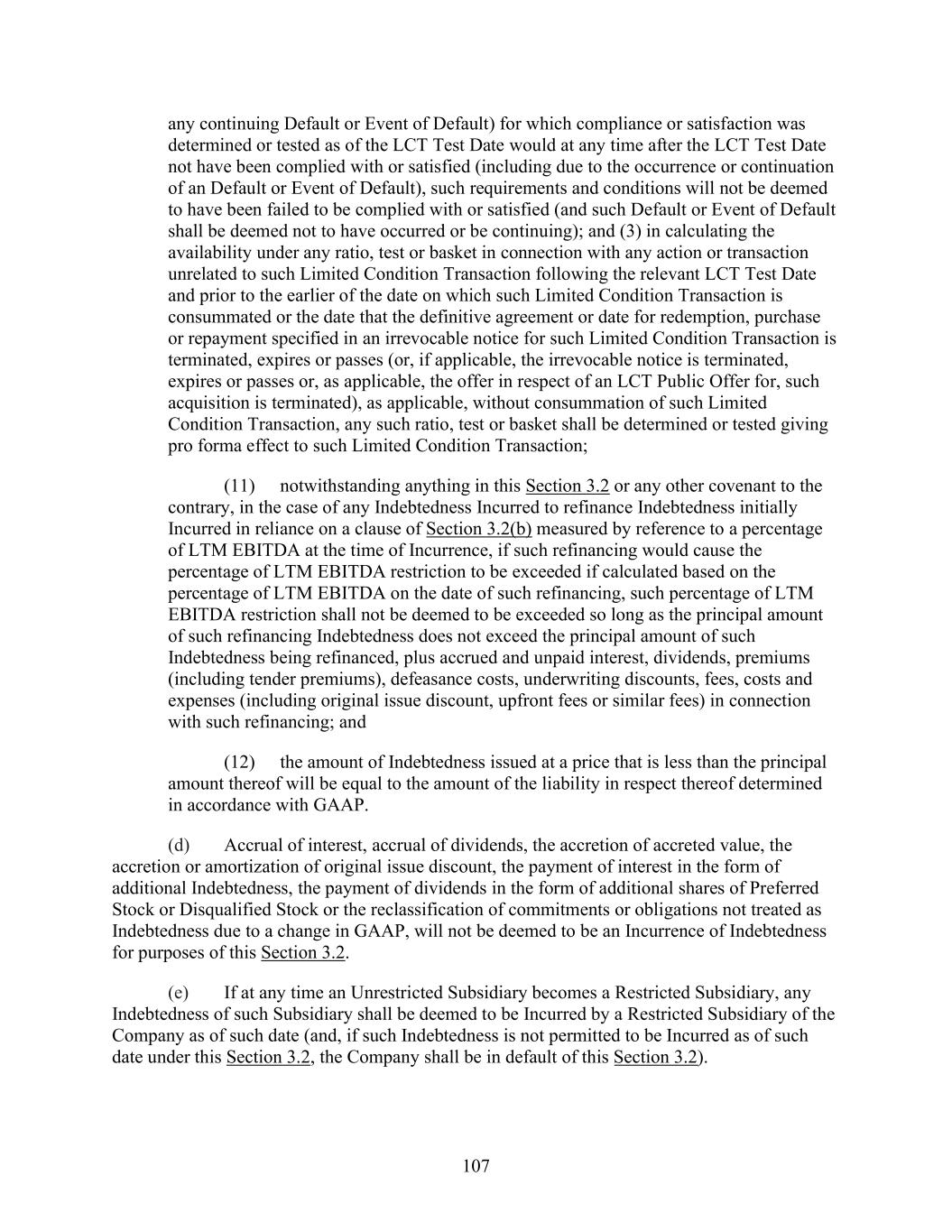
107 any continuing Default or Event of Default) for which compliance or satisfaction was determined or tested as of the LCT Test Date would at any time after the LCT Test Date not have been complied with or satisfied (including due to the occurrence or continuation of an Default or Event of Default), such requirements and conditions will not be deemed to have been failed to be complied with or satisfied (and such Default or Event of Default shall be deemed not to have occurred or be continuing); and (3) in calculating the availability under any ratio, test or basket in connection with any action or transaction unrelated to such Limited Condition Transaction following the relevant LCT Test Date and prior to the earlier of the date on which such Limited Condition Transaction is consummated or the date that the definitive agreement or date for redemption, purchase or repayment specified in an irrevocable notice for such Limited Condition Transaction is terminated, expires or passes (or, if applicable, the irrevocable notice is terminated, expires or passes or, as applicable, the offer in respect of an LCT Public Offer for, such acquisition is terminated), as applicable, without consummation of such Limited Condition Transaction, any such ratio, test or basket shall be determined or tested giving pro forma effect to such Limited Condition Transaction; (11) notwithstanding anything in this Section 3.2 or any other covenant to the contrary, in the case of any Indebtedness Incurred to refinance Indebtedness initially Incurred in reliance on a clause of Section 3.2(b) measured by reference to a percentage of LTM EBITDA at the time of Incurrence, if such refinancing would cause the percentage of LTM EBITDA restriction to be exceeded if calculated based on the percentage of LTM EBITDA on the date of such refinancing, such percentage of LTM EBITDA restriction shall not be deemed to be exceeded so long as the principal amount of such refinancing Indebtedness does not exceed the principal amount of such Indebtedness being refinanced, plus accrued and unpaid interest, dividends, premiums (including tender premiums), defeasance costs, underwriting discounts, fees, costs and expenses (including original issue discount, upfront fees or similar fees) in connection with such refinancing; and (12) the amount of Indebtedness issued at a price that is less than the principal amount thereof will be equal to the amount of the liability in respect thereof determined in accordance with GAAP. (d) Accrual of interest, accrual of dividends, the accretion of accreted value, the accretion or amortization of original issue discount, the payment of interest in the form of additional Indebtedness, the payment of dividends in the form of additional shares of Preferred Stock or Disqualified Stock or the reclassification of commitments or obligations not treated as Indebtedness due to a change in GAAP, will not be deemed to be an Incurrence of Indebtedness for purposes of this Section 3.2. (e) If at any time an Unrestricted Subsidiary becomes a Restricted Subsidiary, any Indebtedness of such Subsidiary shall be deemed to be Incurred by a Restricted Subsidiary of the Company as of such date (and, if such Indebtedness is not permitted to be Incurred as of such date under this Section 3.2, the Company shall be in default of this Section 3.2).

109 such dividend or distribution, to holders of its Capital Stock other than the Company or another Restricted Subsidiary on no more than a pro rata basis); (2) purchase, repurchase, redeem, retire or otherwise acquire or retire for value any Capital Stock of the Company or any Parent Entity held by Persons other than the Company or a Restricted Subsidiary; (3) purchase, repurchase, redeem, defease or otherwise acquire or retire for value, prior to scheduled maturity, scheduled repayment or scheduled sinking fund payment, any Subordinated Indebtedness (other than (i) any such purchase, repurchase, redemption, defeasance or other acquisition or retirement in anticipation of satisfying a sinking fund obligation, principal installment or final maturity, in each case, due within one year of the date of purchase, repurchase, redemption, defeasance or other acquisition or retirement and (ii) any Indebtedness Incurred pursuant to Section 3.2(b)(3)); or (4) make any Restricted Investment; (any such dividend, distribution, payment, purchase, redemption, repurchase, defeasance, other acquisition, retirement or Restricted Investment referred to in clauses (1) through (4) above are referred to herein as a “Restricted Payment”), if at the time the Company or such Restricted Subsidiary makes such Restricted Payment: (i) other than in the case of (x) a Restricted Investment and (y) amounts attributable to subclauses (B) through (F) of clause (iii) below, an Event of Default shall have occurred and be continuing (or would immediately thereafter result therefrom); (ii) other than in the case of (x) a Restricted Investment and (y) amounts attributable to subclauses (B) through (F) of clause (iii) below, the Issuer is not able to Incur an additional $1.00 of Indebtedness pursuant to Section 3.2(a) immediately after giving effect, on a pro forma basis, to such Restricted Payment; or (iii) the aggregate amount of such Restricted Payment and all other Restricted Payments made subsequent to December 12, 2014 (and not returned or rescinded) (including Permitted Payments made pursuant to Section 3.3(b)(1) (without duplication) and (10), but excluding all other Restricted Payments made pursuant to Section 3.3(b)) would exceed the sum of (without duplication): (A) 50% of Consolidated Net Income for the period (treated as one accounting period) from October 1, 2014 to the end of the most recent fiscal quarter ending prior to the date of such Restricted Payment for which consolidated financial statements are available (which may be, at the Company’s election, internal financial statements) (or, in the case such Consolidated Net Income is a deficit, minus 100% of such deficit) (which amount shall not be less than zero);
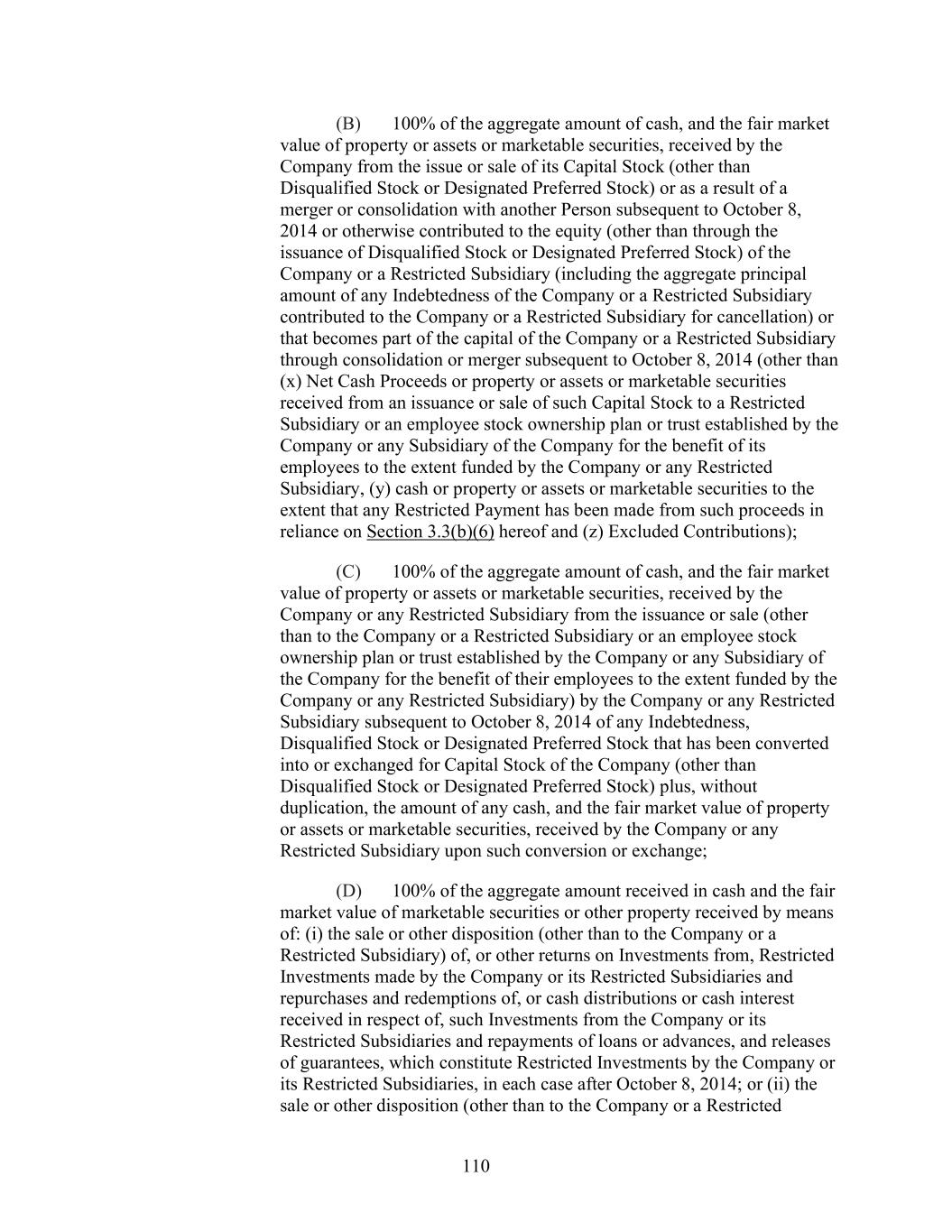
110 (B) 100% of the aggregate amount of cash, and the fair market value of property or assets or marketable securities, received by the Company from the issue or sale of its Capital Stock (other than Disqualified Stock or Designated Preferred Stock) or as a result of a merger or consolidation with another Person subsequent to October 8, 2014 or otherwise contributed to the equity (other than through the issuance of Disqualified Stock or Designated Preferred Stock) of the Company or a Restricted Subsidiary (including the aggregate principal amount of any Indebtedness of the Company or a Restricted Subsidiary contributed to the Company or a Restricted Subsidiary for cancellation) or that becomes part of the capital of the Company or a Restricted Subsidiary through consolidation or merger subsequent to October 8, 2014 (other than (x) Net Cash Proceeds or property or assets or marketable securities received from an issuance or sale of such Capital Stock to a Restricted Subsidiary or an employee stock ownership plan or trust established by the Company or any Subsidiary of the Company for the benefit of its employees to the extent funded by the Company or any Restricted Subsidiary, (y) cash or property or assets or marketable securities to the extent that any Restricted Payment has been made from such proceeds in reliance on Section 3.3(b)(6) hereof and (z) Excluded Contributions); (C) 100% of the aggregate amount of cash, and the fair market value of property or assets or marketable securities, received by the Company or any Restricted Subsidiary from the issuance or sale (other than to the Company or a Restricted Subsidiary or an employee stock ownership plan or trust established by the Company or any Subsidiary of the Company for the benefit of their employees to the extent funded by the Company or any Restricted Subsidiary) by the Company or any Restricted Subsidiary subsequent to October 8, 2014 of any Indebtedness, Disqualified Stock or Designated Preferred Stock that has been converted into or exchanged for Capital Stock of the Company (other than Disqualified Stock or Designated Preferred Stock) plus, without duplication, the amount of any cash, and the fair market value of property or assets or marketable securities, received by the Company or any Restricted Subsidiary upon such conversion or exchange; (D) 100% of the aggregate amount received in cash and the fair market value of marketable securities or other property received by means of: (i) the sale or other disposition (other than to the Company or a Restricted Subsidiary) of, or other returns on Investments from, Restricted Investments made by the Company or its Restricted Subsidiaries and repurchases and redemptions of, or cash distributions or cash interest received in respect of, such Investments from the Company or its Restricted Subsidiaries and repayments of loans or advances, and releases of guarantees, which constitute Restricted Investments by the Company or its Restricted Subsidiaries, in each case after October 8, 2014; or (ii) the sale or other disposition (other than to the Company or a Restricted
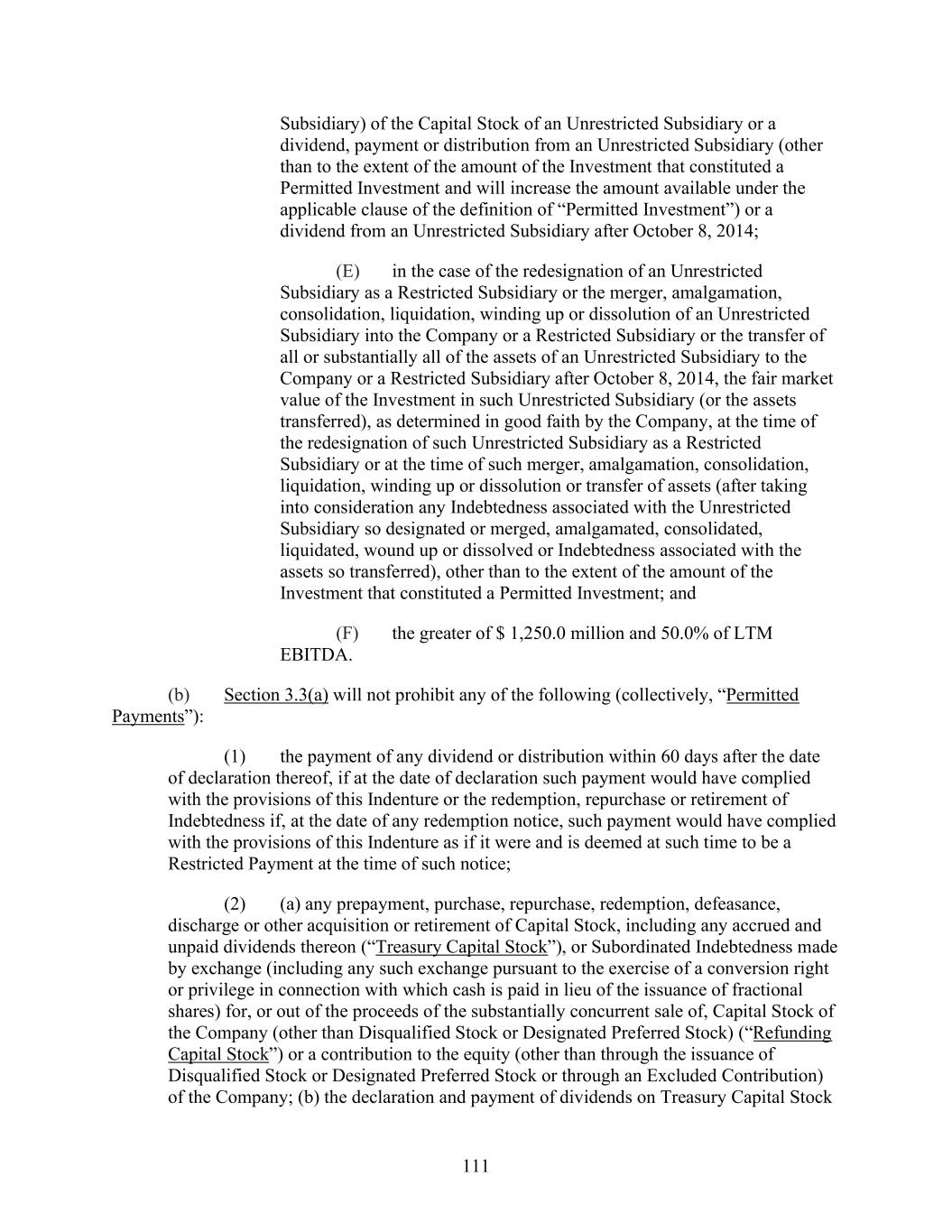
111 Subsidiary) of the Capital Stock of an Unrestricted Subsidiary or a dividend, payment or distribution from an Unrestricted Subsidiary (other than to the extent of the amount of the Investment that constituted a Permitted Investment and will increase the amount available under the applicable clause of the definition of “Permitted Investment”) or a dividend from an Unrestricted Subsidiary after October 8, 2014; (E) in the case of the redesignation of an Unrestricted Subsidiary as a Restricted Subsidiary or the merger, amalgamation, consolidation, liquidation, winding up or dissolution of an Unrestricted Subsidiary into the Company or a Restricted Subsidiary or the transfer of all or substantially all of the assets of an Unrestricted Subsidiary to the Company or a Restricted Subsidiary after October 8, 2014, the fair market value of the Investment in such Unrestricted Subsidiary (or the assets transferred), as determined in good faith by the Company, at the time of the redesignation of such Unrestricted Subsidiary as a Restricted Subsidiary or at the time of such merger, amalgamation, consolidation, liquidation, winding up or dissolution or transfer of assets (after taking into consideration any Indebtedness associated with the Unrestricted Subsidiary so designated or merged, amalgamated, consolidated, liquidated, wound up or dissolved or Indebtedness associated with the assets so transferred), other than to the extent of the amount of the Investment that constituted a Permitted Investment; and (F) the greater of $ 1,250.0 million and 50.0% of LTM EBITDA. (b) Section 3.3(a) will not prohibit any of the following (collectively, “Permitted Payments”): (1) the payment of any dividend or distribution within 60 days after the date of declaration thereof, if at the date of declaration such payment would have complied with the provisions of this Indenture or the redemption, repurchase or retirement of Indebtedness if, at the date of any redemption notice, such payment would have complied with the provisions of this Indenture as if it were and is deemed at such time to be a Restricted Payment at the time of such notice; (2) (a) any prepayment, purchase, repurchase, redemption, defeasance, discharge or other acquisition or retirement of Capital Stock, including any accrued and unpaid dividends thereon (“Treasury Capital Stock”), or Subordinated Indebtedness made by exchange (including any such exchange pursuant to the exercise of a conversion right or privilege in connection with which cash is paid in lieu of the issuance of fractional shares) for, or out of the proceeds of the substantially concurrent sale of, Capital Stock of the Company (other than Disqualified Stock or Designated Preferred Stock) (“Refunding Capital Stock”) or a contribution to the equity (other than through the issuance of Disqualified Stock or Designated Preferred Stock or through an Excluded Contribution) of the Company; (b) the declaration and payment of dividends on Treasury Capital Stock
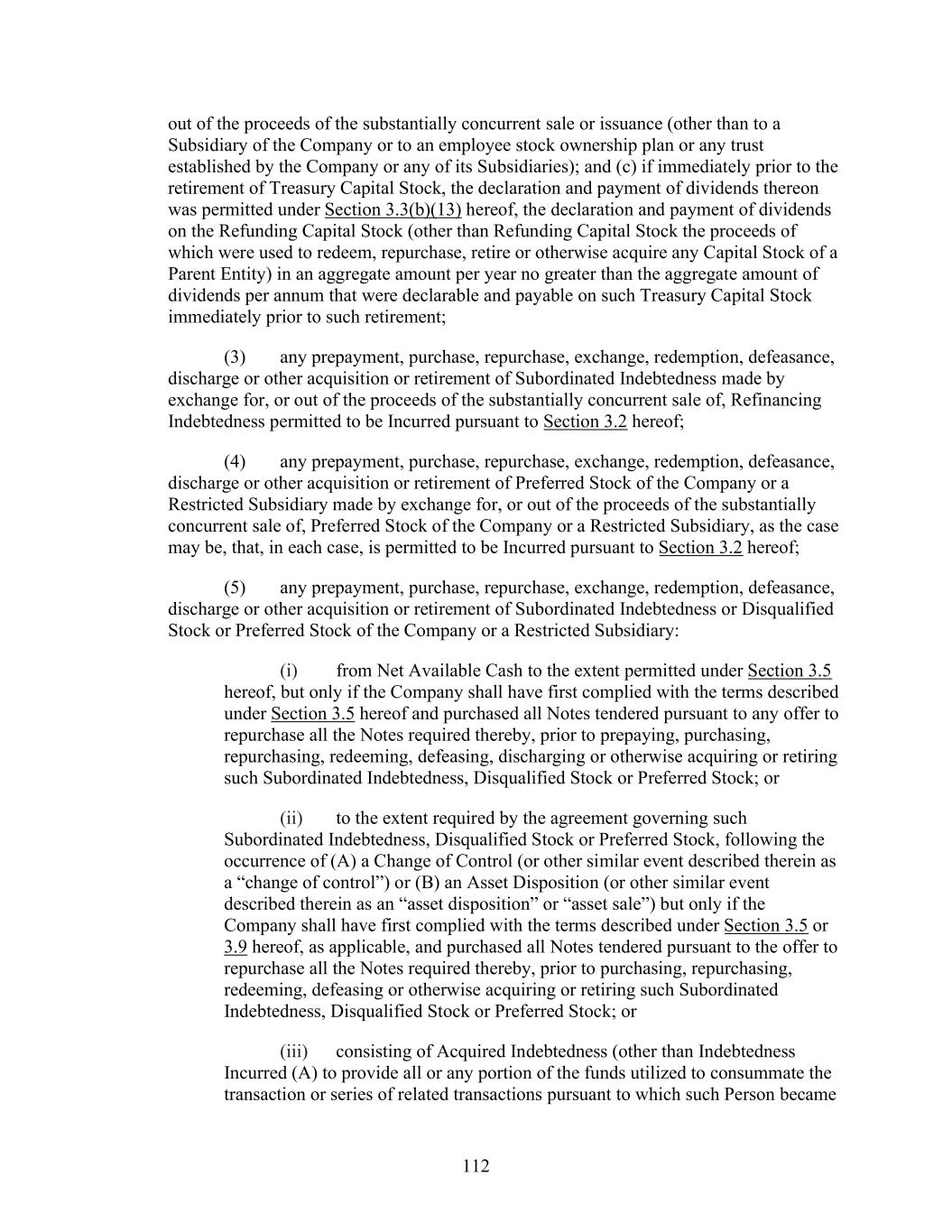
112 out of the proceeds of the substantially concurrent sale or issuance (other than to a Subsidiary of the Company or to an employee stock ownership plan or any trust established by the Company or any of its Subsidiaries); and (c) if immediately prior to the retirement of Treasury Capital Stock, the declaration and payment of dividends thereon was permitted under Section 3.3(b)(13) hereof, the declaration and payment of dividends on the Refunding Capital Stock (other than Refunding Capital Stock the proceeds of which were used to redeem, repurchase, retire or otherwise acquire any Capital Stock of a Parent Entity) in an aggregate amount per year no greater than the aggregate amount of dividends per annum that were declarable and payable on such Treasury Capital Stock immediately prior to such retirement; (3) any prepayment, purchase, repurchase, exchange, redemption, defeasance, discharge or other acquisition or retirement of Subordinated Indebtedness made by exchange for, or out of the proceeds of the substantially concurrent sale of, Refinancing Indebtedness permitted to be Incurred pursuant to Section 3.2 hereof; (4) any prepayment, purchase, repurchase, exchange, redemption, defeasance, discharge or other acquisition or retirement of Preferred Stock of the Company or a Restricted Subsidiary made by exchange for, or out of the proceeds of the substantially concurrent sale of, Preferred Stock of the Company or a Restricted Subsidiary, as the case may be, that, in each case, is permitted to be Incurred pursuant to Section 3.2 hereof; (5) any prepayment, purchase, repurchase, exchange, redemption, defeasance, discharge or other acquisition or retirement of Subordinated Indebtedness or Disqualified Stock or Preferred Stock of the Company or a Restricted Subsidiary: (i) from Net Available Cash to the extent permitted under Section 3.5 hereof, but only if the Company shall have first complied with the terms described under Section 3.5 hereof and purchased all Notes tendered pursuant to any offer to repurchase all the Notes required thereby, prior to prepaying, purchasing, repurchasing, redeeming, defeasing, discharging or otherwise acquiring or retiring such Subordinated Indebtedness, Disqualified Stock or Preferred Stock; or (ii) to the extent required by the agreement governing such Subordinated Indebtedness, Disqualified Stock or Preferred Stock, following the occurrence of (A) a Change of Control (or other similar event described therein as a “change of control”) or (B) an Asset Disposition (or other similar event described therein as an “asset disposition” or “asset sale”) but only if the Company shall have first complied with the terms described under Section 3.5 or 3.9 hereof, as applicable, and purchased all Notes tendered pursuant to the offer to repurchase all the Notes required thereby, prior to purchasing, repurchasing, redeeming, defeasing or otherwise acquiring or retiring such Subordinated Indebtedness, Disqualified Stock or Preferred Stock; or (iii) consisting of Acquired Indebtedness (other than Indebtedness Incurred (A) to provide all or any portion of the funds utilized to consummate the transaction or series of related transactions pursuant to which such Person became
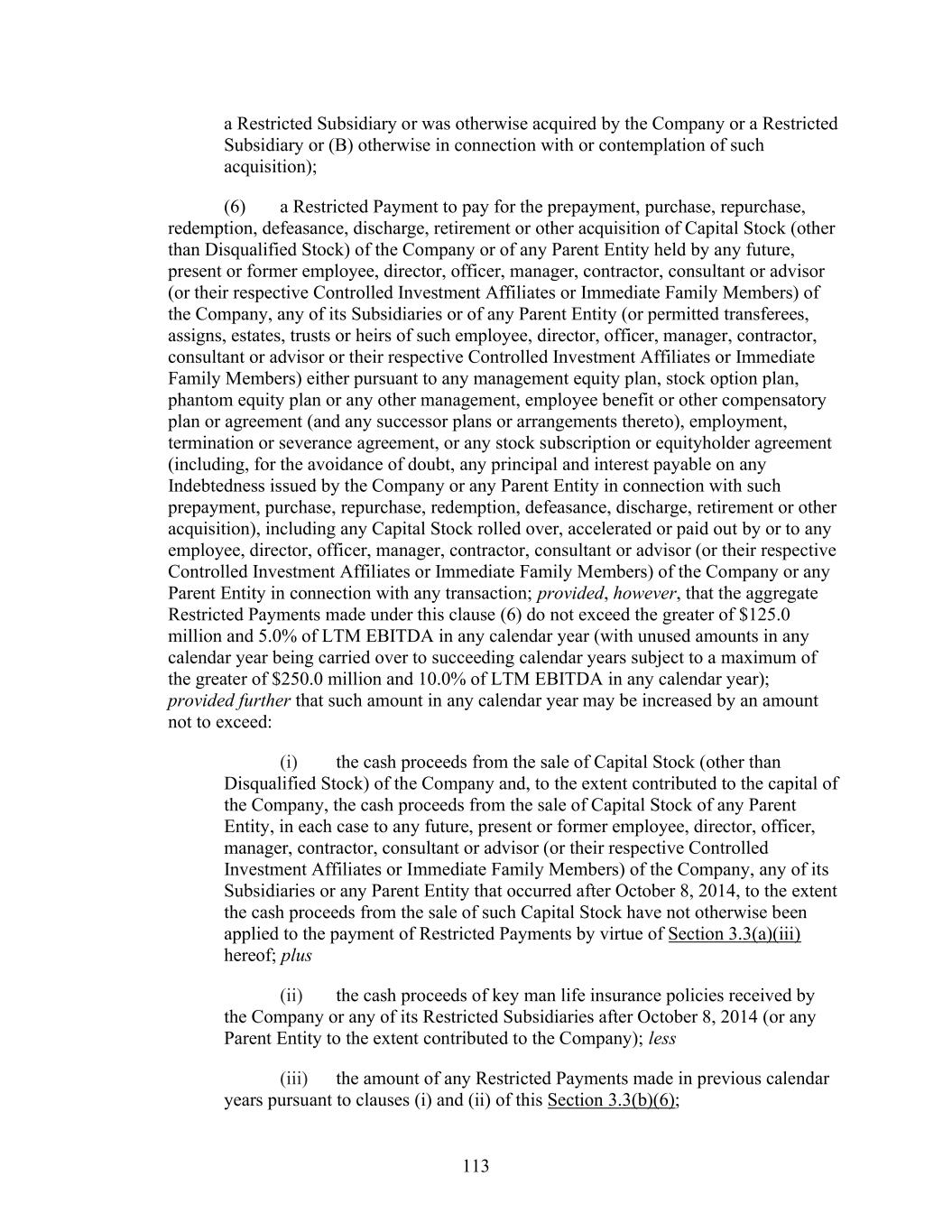
113 a Restricted Subsidiary or was otherwise acquired by the Company or a Restricted Subsidiary or (B) otherwise in connection with or contemplation of such acquisition); (6) a Restricted Payment to pay for the prepayment, purchase, repurchase, redemption, defeasance, discharge, retirement or other acquisition of Capital Stock (other than Disqualified Stock) of the Company or of any Parent Entity held by any future, present or former employee, director, officer, manager, contractor, consultant or advisor (or their respective Controlled Investment Affiliates or Immediate Family Members) of the Company, any of its Subsidiaries or of any Parent Entity (or permitted transferees, assigns, estates, trusts or heirs of such employee, director, officer, manager, contractor, consultant or advisor or their respective Controlled Investment Affiliates or Immediate Family Members) either pursuant to any management equity plan, stock option plan, phantom equity plan or any other management, employee benefit or other compensatory plan or agreement (and any successor plans or arrangements thereto), employment, termination or severance agreement, or any stock subscription or equityholder agreement (including, for the avoidance of doubt, any principal and interest payable on any Indebtedness issued by the Company or any Parent Entity in connection with such prepayment, purchase, repurchase, redemption, defeasance, discharge, retirement or other acquisition), including any Capital Stock rolled over, accelerated or paid out by or to any employee, director, officer, manager, contractor, consultant or advisor (or their respective Controlled Investment Affiliates or Immediate Family Members) of the Company or any Parent Entity in connection with any transaction; provided, however, that the aggregate Restricted Payments made under this clause (6) do not exceed the greater of $125.0 million and 5.0% of LTM EBITDA in any calendar year (with unused amounts in any calendar year being carried over to succeeding calendar years subject to a maximum of the greater of $250.0 million and 10.0% of LTM EBITDA in any calendar year); provided further that such amount in any calendar year may be increased by an amount not to exceed: (i) the cash proceeds from the sale of Capital Stock (other than Disqualified Stock) of the Company and, to the extent contributed to the capital of the Company, the cash proceeds from the sale of Capital Stock of any Parent Entity, in each case to any future, present or former employee, director, officer, manager, contractor, consultant or advisor (or their respective Controlled Investment Affiliates or Immediate Family Members) of the Company, any of its Subsidiaries or any Parent Entity that occurred after October 8, 2014, to the extent the cash proceeds from the sale of such Capital Stock have not otherwise been applied to the payment of Restricted Payments by virtue of Section 3.3(a)(iii) hereof; plus (ii) the cash proceeds of key man life insurance policies received by the Company or any of its Restricted Subsidiaries after October 8, 2014 (or any Parent Entity to the extent contributed to the Company); less (iii) the amount of any Restricted Payments made in previous calendar years pursuant to clauses (i) and (ii) of this Section 3.3(b)(6);
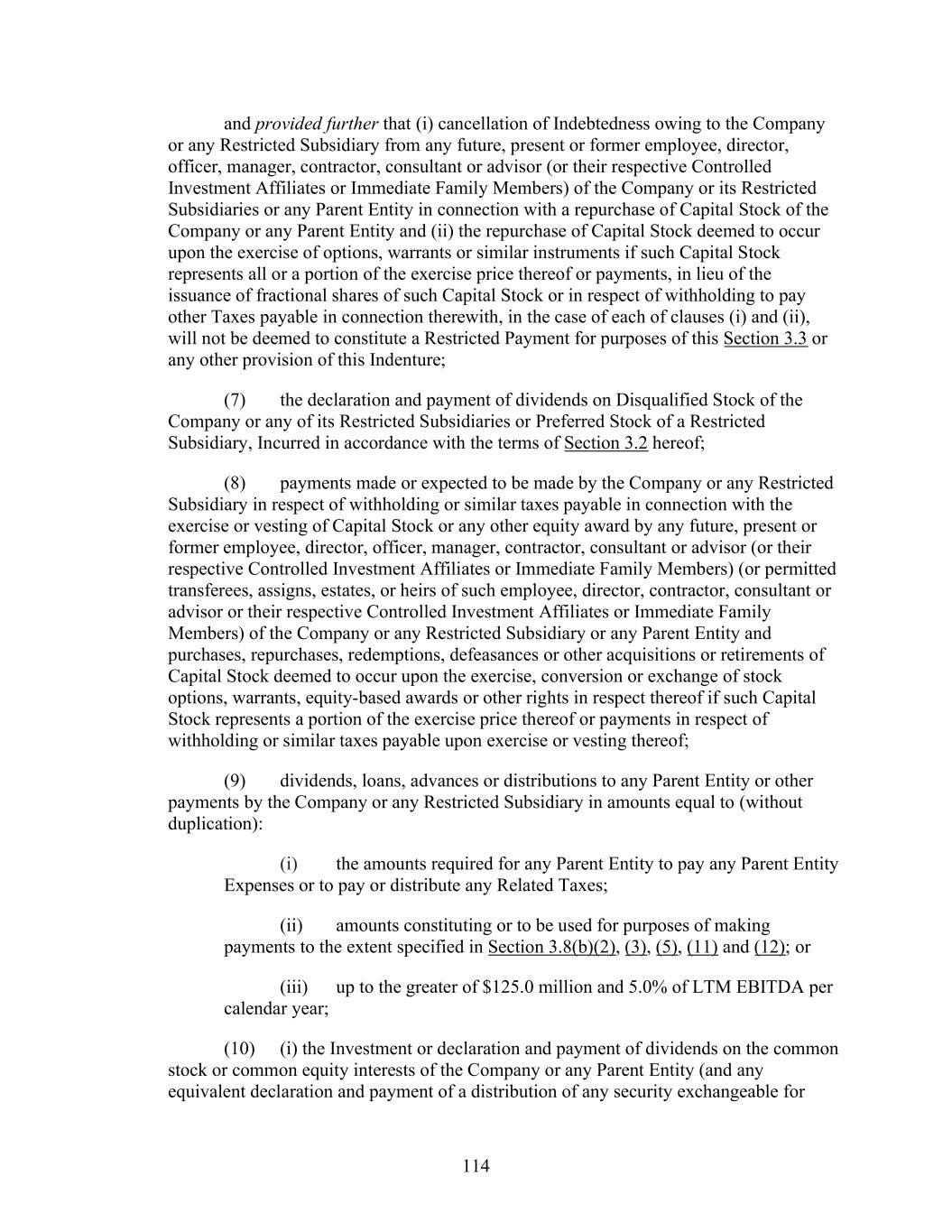
114 and provided further that (i) cancellation of Indebtedness owing to the Company or any Restricted Subsidiary from any future, present or former employee, director, officer, manager, contractor, consultant or advisor (or their respective Controlled Investment Affiliates or Immediate Family Members) of the Company or its Restricted Subsidiaries or any Parent Entity in connection with a repurchase of Capital Stock of the Company or any Parent Entity and (ii) the repurchase of Capital Stock deemed to occur upon the exercise of options, warrants or similar instruments if such Capital Stock represents all or a portion of the exercise price thereof or payments, in lieu of the issuance of fractional shares of such Capital Stock or in respect of withholding to pay other Taxes payable in connection therewith, in the case of each of clauses (i) and (ii), will not be deemed to constitute a Restricted Payment for purposes of this Section 3.3 or any other provision of this Indenture; (7) the declaration and payment of dividends on Disqualified Stock of the Company or any of its Restricted Subsidiaries or Preferred Stock of a Restricted Subsidiary, Incurred in accordance with the terms of Section 3.2 hereof; (8) payments made or expected to be made by the Company or any Restricted Subsidiary in respect of withholding or similar taxes payable in connection with the exercise or vesting of Capital Stock or any other equity award by any future, present or former employee, director, officer, manager, contractor, consultant or advisor (or their respective Controlled Investment Affiliates or Immediate Family Members) (or permitted transferees, assigns, estates, or heirs of such employee, director, contractor, consultant or advisor or their respective Controlled Investment Affiliates or Immediate Family Members) of the Company or any Restricted Subsidiary or any Parent Entity and purchases, repurchases, redemptions, defeasances or other acquisitions or retirements of Capital Stock deemed to occur upon the exercise, conversion or exchange of stock options, warrants, equity-based awards or other rights in respect thereof if such Capital Stock represents a portion of the exercise price thereof or payments in respect of withholding or similar taxes payable upon exercise or vesting thereof; (9) dividends, loans, advances or distributions to any Parent Entity or other payments by the Company or any Restricted Subsidiary in amounts equal to (without duplication): (i) the amounts required for any Parent Entity to pay any Parent Entity Expenses or to pay or distribute any Related Taxes; (ii) amounts constituting or to be used for purposes of making payments to the extent specified in Section 3.8(b)(2), (3), (5), (11) and (12); or (iii) up to the greater of $125.0 million and 5.0% of LTM EBITDA per calendar year; (10) (i) the Investment or declaration and payment of dividends on the common stock or common equity interests of the Company or any Parent Entity (and any equivalent declaration and payment of a distribution of any security exchangeable for
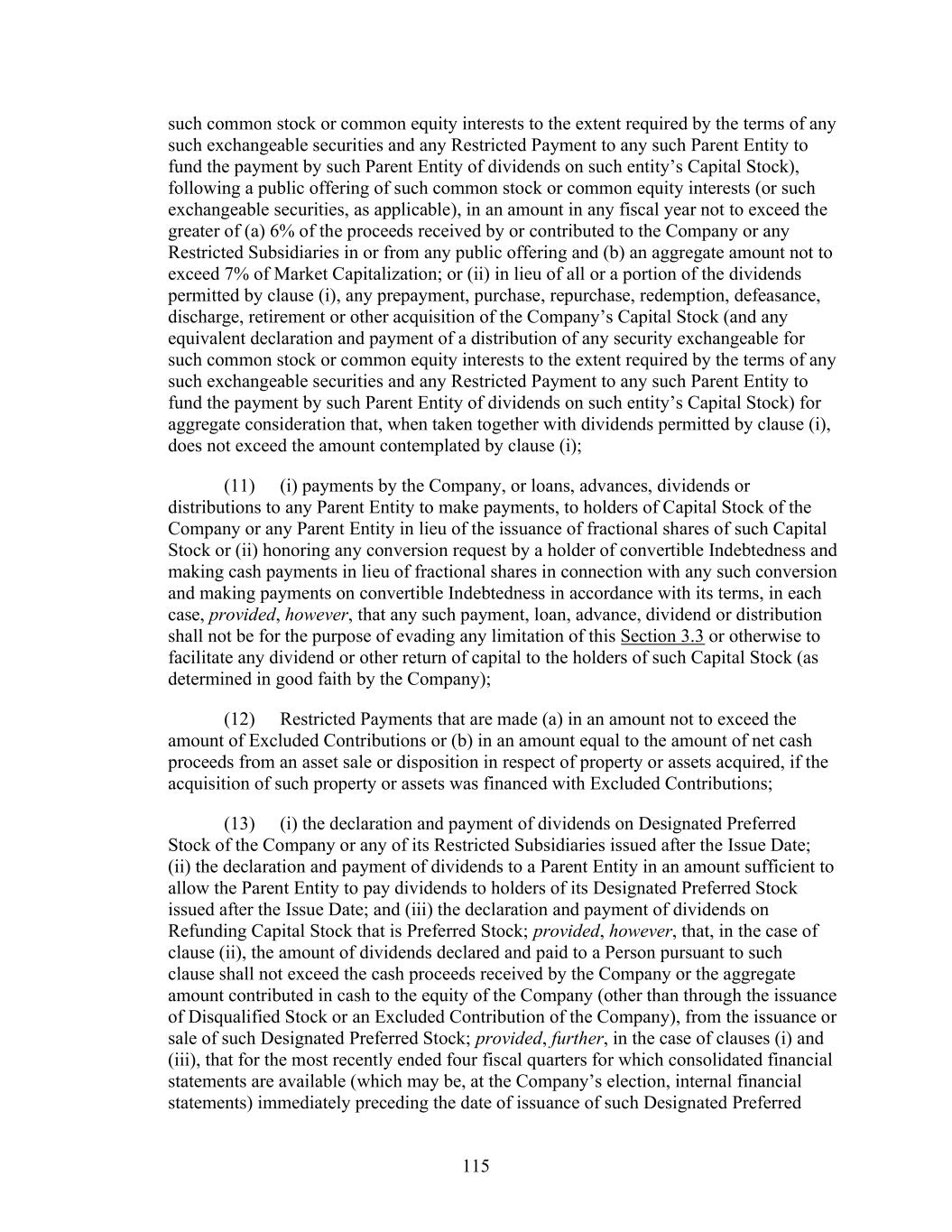
115 such common stock or common equity interests to the extent required by the terms of any such exchangeable securities and any Restricted Payment to any such Parent Entity to fund the payment by such Parent Entity of dividends on such entity’s Capital Stock), following a public offering of such common stock or common equity interests (or such exchangeable securities, as applicable), in an amount in any fiscal year not to exceed the greater of (a) 6% of the proceeds received by or contributed to the Company or any Restricted Subsidiaries in or from any public offering and (b) an aggregate amount not to exceed 7% of Market Capitalization; or (ii) in lieu of all or a portion of the dividends permitted by clause (i), any prepayment, purchase, repurchase, redemption, defeasance, discharge, retirement or other acquisition of the Company’s Capital Stock (and any equivalent declaration and payment of a distribution of any security exchangeable for such common stock or common equity interests to the extent required by the terms of any such exchangeable securities and any Restricted Payment to any such Parent Entity to fund the payment by such Parent Entity of dividends on such entity’s Capital Stock) for aggregate consideration that, when taken together with dividends permitted by clause (i), does not exceed the amount contemplated by clause (i); (11) (i) payments by the Company, or loans, advances, dividends or distributions to any Parent Entity to make payments, to holders of Capital Stock of the Company or any Parent Entity in lieu of the issuance of fractional shares of such Capital Stock or (ii) honoring any conversion request by a holder of convertible Indebtedness and making cash payments in lieu of fractional shares in connection with any such conversion and making payments on convertible Indebtedness in accordance with its terms, in each case, provided, however, that any such payment, loan, advance, dividend or distribution shall not be for the purpose of evading any limitation of this Section 3.3 or otherwise to facilitate any dividend or other return of capital to the holders of such Capital Stock (as determined in good faith by the Company); (12) Restricted Payments that are made (a) in an amount not to exceed the amount of Excluded Contributions or (b) in an amount equal to the amount of net cash proceeds from an asset sale or disposition in respect of property or assets acquired, if the acquisition of such property or assets was financed with Excluded Contributions; (13) (i) the declaration and payment of dividends on Designated Preferred Stock of the Company or any of its Restricted Subsidiaries issued after the Issue Date; (ii) the declaration and payment of dividends to a Parent Entity in an amount sufficient to allow the Parent Entity to pay dividends to holders of its Designated Preferred Stock issued after the Issue Date; and (iii) the declaration and payment of dividends on Refunding Capital Stock that is Preferred Stock; provided, however, that, in the case of clause (ii), the amount of dividends declared and paid to a Person pursuant to such clause shall not exceed the cash proceeds received by the Company or the aggregate amount contributed in cash to the equity of the Company (other than through the issuance of Disqualified Stock or an Excluded Contribution of the Company), from the issuance or sale of such Designated Preferred Stock; provided, further, in the case of clauses (i) and (iii), that for the most recently ended four fiscal quarters for which consolidated financial statements are available (which may be, at the Company’s election, internal financial statements) immediately preceding the date of issuance of such Designated Preferred
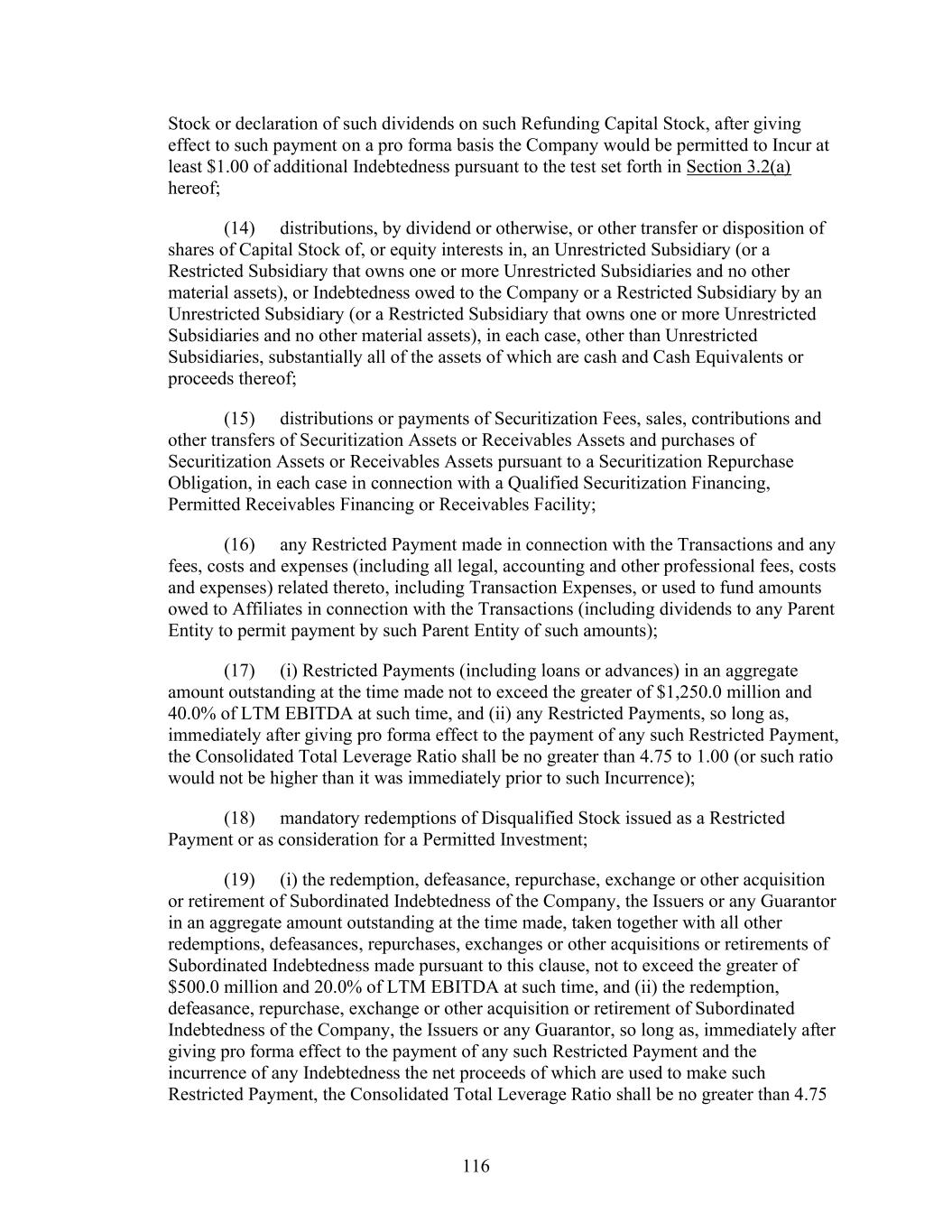
116 Stock or declaration of such dividends on such Refunding Capital Stock, after giving effect to such payment on a pro forma basis the Company would be permitted to Incur at least $1.00 of additional Indebtedness pursuant to the test set forth in Section 3.2(a) hereof; (14) distributions, by dividend or otherwise, or other transfer or disposition of shares of Capital Stock of, or equity interests in, an Unrestricted Subsidiary (or a Restricted Subsidiary that owns one or more Unrestricted Subsidiaries and no other material assets), or Indebtedness owed to the Company or a Restricted Subsidiary by an Unrestricted Subsidiary (or a Restricted Subsidiary that owns one or more Unrestricted Subsidiaries and no other material assets), in each case, other than Unrestricted Subsidiaries, substantially all of the assets of which are cash and Cash Equivalents or proceeds thereof; (15) distributions or payments of Securitization Fees, sales, contributions and other transfers of Securitization Assets or Receivables Assets and purchases of Securitization Assets or Receivables Assets pursuant to a Securitization Repurchase Obligation, in each case in connection with a Qualified Securitization Financing, Permitted Receivables Financing or Receivables Facility; (16) any Restricted Payment made in connection with the Transactions and any fees, costs and expenses (including all legal, accounting and other professional fees, costs and expenses) related thereto, including Transaction Expenses, or used to fund amounts owed to Affiliates in connection with the Transactions (including dividends to any Parent Entity to permit payment by such Parent Entity of such amounts); (17) (i) Restricted Payments (including loans or advances) in an aggregate amount outstanding at the time made not to exceed the greater of $1,250.0 million and 40.0% of LTM EBITDA at such time, and (ii) any Restricted Payments, so long as, immediately after giving pro forma effect to the payment of any such Restricted Payment, the Consolidated Total Leverage Ratio shall be no greater than 4.75 to 1.00 (or such ratio would not be higher than it was immediately prior to such Incurrence); (18) mandatory redemptions of Disqualified Stock issued as a Restricted Payment or as consideration for a Permitted Investment; (19) (i) the redemption, defeasance, repurchase, exchange or other acquisition or retirement of Subordinated Indebtedness of the Company, the Issuers or any Guarantor in an aggregate amount outstanding at the time made, taken together with all other redemptions, defeasances, repurchases, exchanges or other acquisitions or retirements of Subordinated Indebtedness made pursuant to this clause, not to exceed the greater of $500.0 million and 20.0% of LTM EBITDA at such time, and (ii) the redemption, defeasance, repurchase, exchange or other acquisition or retirement of Subordinated Indebtedness of the Company, the Issuers or any Guarantor, so long as, immediately after giving pro forma effect to the payment of any such Restricted Payment and the incurrence of any Indebtedness the net proceeds of which are used to make such Restricted Payment, the Consolidated Total Leverage Ratio shall be no greater than 4.75
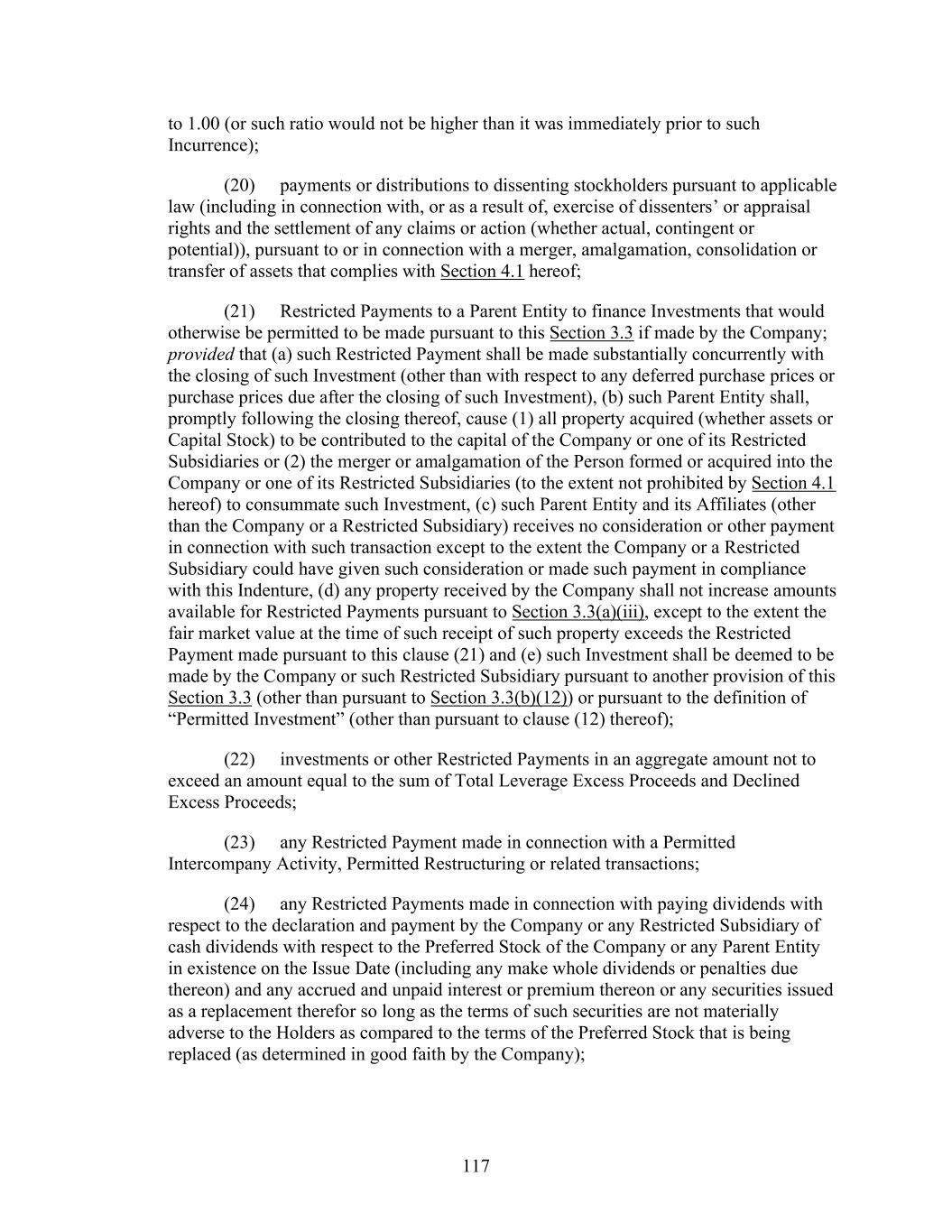
117 to 1.00 (or such ratio would not be higher than it was immediately prior to such Incurrence); (20) payments or distributions to dissenting stockholders pursuant to applicable law (including in connection with, or as a result of, exercise of dissenters’ or appraisal rights and the settlement of any claims or action (whether actual, contingent or potential)), pursuant to or in connection with a merger, amalgamation, consolidation or transfer of assets that complies with Section 4.1 hereof; (21) Restricted Payments to a Parent Entity to finance Investments that would otherwise be permitted to be made pursuant to this Section 3.3 if made by the Company; provided that (a) such Restricted Payment shall be made substantially concurrently with the closing of such Investment (other than with respect to any deferred purchase prices or purchase prices due after the closing of such Investment), (b) such Parent Entity shall, promptly following the closing thereof, cause (1) all property acquired (whether assets or Capital Stock) to be contributed to the capital of the Company or one of its Restricted Subsidiaries or (2) the merger or amalgamation of the Person formed or acquired into the Company or one of its Restricted Subsidiaries (to the extent not prohibited by Section 4.1 hereof) to consummate such Investment, (c) such Parent Entity and its Affiliates (other than the Company or a Restricted Subsidiary) receives no consideration or other payment in connection with such transaction except to the extent the Company or a Restricted Subsidiary could have given such consideration or made such payment in compliance with this Indenture, (d) any property received by the Company shall not increase amounts available for Restricted Payments pursuant to Section 3.3(a)(iii), except to the extent the fair market value at the time of such receipt of such property exceeds the Restricted Payment made pursuant to this clause (21) and (e) such Investment shall be deemed to be made by the Company or such Restricted Subsidiary pursuant to another provision of this Section 3.3 (other than pursuant to Section 3.3(b)(12)) or pursuant to the definition of “Permitted Investment” (other than pursuant to clause (12) thereof); (22) investments or other Restricted Payments in an aggregate amount not to exceed an amount equal to the sum of Total Leverage Excess Proceeds and Declined Excess Proceeds; (23) any Restricted Payment made in connection with a Permitted Intercompany Activity, Permitted Restructuring or related transactions; (24) any Restricted Payments made in connection with paying dividends with respect to the declaration and payment by the Company or any Restricted Subsidiary of cash dividends with respect to the Preferred Stock of the Company or any Parent Entity in existence on the Issue Date (including any make whole dividends or penalties due thereon) and any accrued and unpaid interest or premium thereon or any securities issued as a replacement therefor so long as the terms of such securities are not materially adverse to the Holders as compared to the terms of the Preferred Stock that is being replaced (as determined in good faith by the Company);
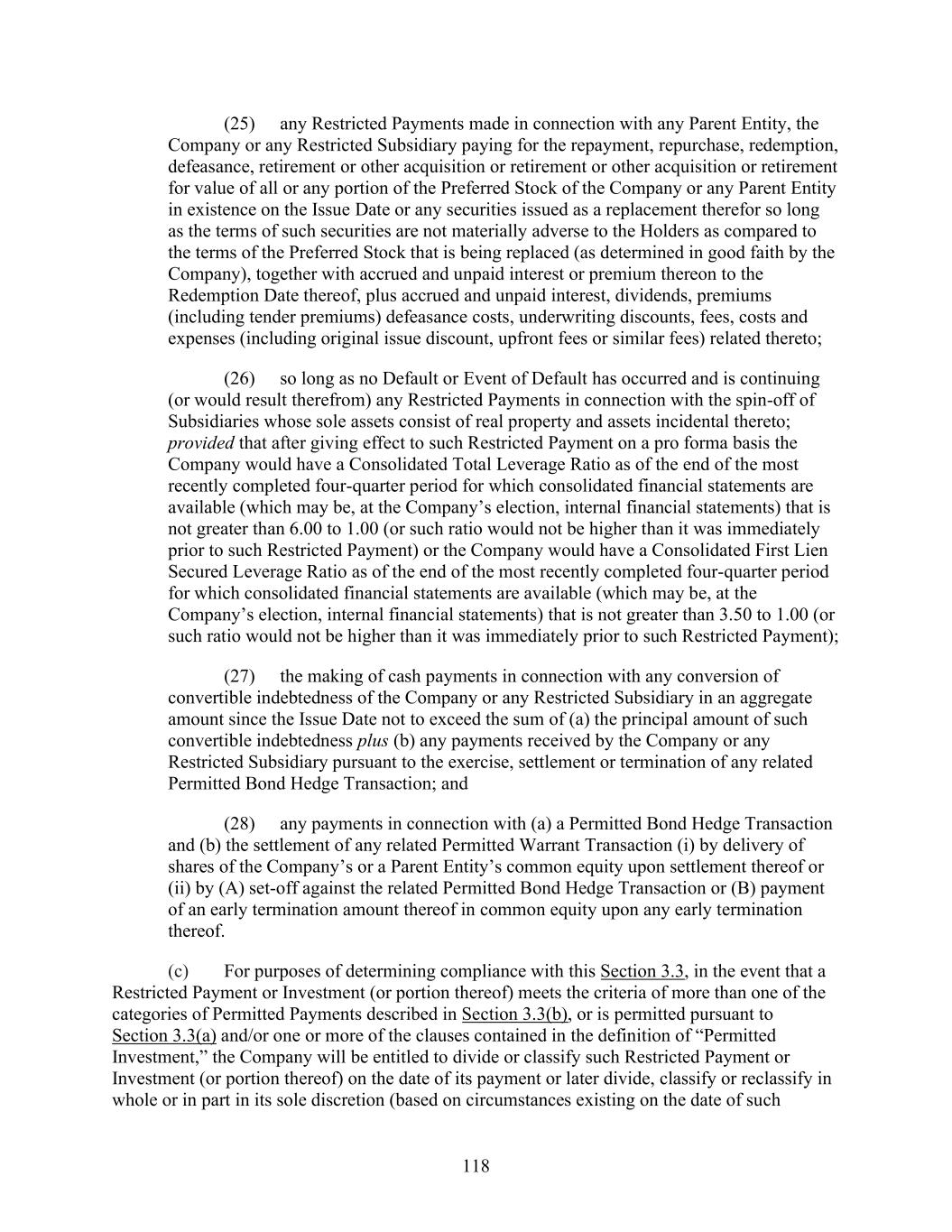
118 (25) any Restricted Payments made in connection with any Parent Entity, the Company or any Restricted Subsidiary paying for the repayment, repurchase, redemption, defeasance, retirement or other acquisition or retirement or other acquisition or retirement for value of all or any portion of the Preferred Stock of the Company or any Parent Entity in existence on the Issue Date or any securities issued as a replacement therefor so long as the terms of such securities are not materially adverse to the Holders as compared to the terms of the Preferred Stock that is being replaced (as determined in good faith by the Company), together with accrued and unpaid interest or premium thereon to the Redemption Date thereof, plus accrued and unpaid interest, dividends, premiums (including tender premiums) defeasance costs, underwriting discounts, fees, costs and expenses (including original issue discount, upfront fees or similar fees) related thereto; (26) so long as no Default or Event of Default has occurred and is continuing (or would result therefrom) any Restricted Payments in connection with the spin-off of Subsidiaries whose sole assets consist of real property and assets incidental thereto; provided that after giving effect to such Restricted Payment on a pro forma basis the Company would have a Consolidated Total Leverage Ratio as of the end of the most recently completed four-quarter period for which consolidated financial statements are available (which may be, at the Company’s election, internal financial statements) that is not greater than 6.00 to 1.00 (or such ratio would not be higher than it was immediately prior to such Restricted Payment) or the Company would have a Consolidated First Lien Secured Leverage Ratio as of the end of the most recently completed four-quarter period for which consolidated financial statements are available (which may be, at the Company’s election, internal financial statements) that is not greater than 3.50 to 1.00 (or such ratio would not be higher than it was immediately prior to such Restricted Payment); (27) the making of cash payments in connection with any conversion of convertible indebtedness of the Company or any Restricted Subsidiary in an aggregate amount since the Issue Date not to exceed the sum of (a) the principal amount of such convertible indebtedness plus (b) any payments received by the Company or any Restricted Subsidiary pursuant to the exercise, settlement or termination of any related Permitted Bond Hedge Transaction; and (28) any payments in connection with (a) a Permitted Bond Hedge Transaction and (b) the settlement of any related Permitted Warrant Transaction (i) by delivery of shares of the Company’s or a Parent Entity’s common equity upon settlement thereof or (ii) by (A) set-off against the related Permitted Bond Hedge Transaction or (B) payment of an early termination amount thereof in common equity upon any early termination thereof. (c) For purposes of determining compliance with this Section 3.3, in the event that a Restricted Payment or Investment (or portion thereof) meets the criteria of more than one of the categories of Permitted Payments described in Section 3.3(b), or is permitted pursuant to Section 3.3(a) and/or one or more of the clauses contained in the definition of “Permitted Investment,” the Company will be entitled to divide or classify such Restricted Payment or Investment (or portion thereof) on the date of its payment or later divide, classify or reclassify in whole or in part in its sole discretion (based on circumstances existing on the date of such
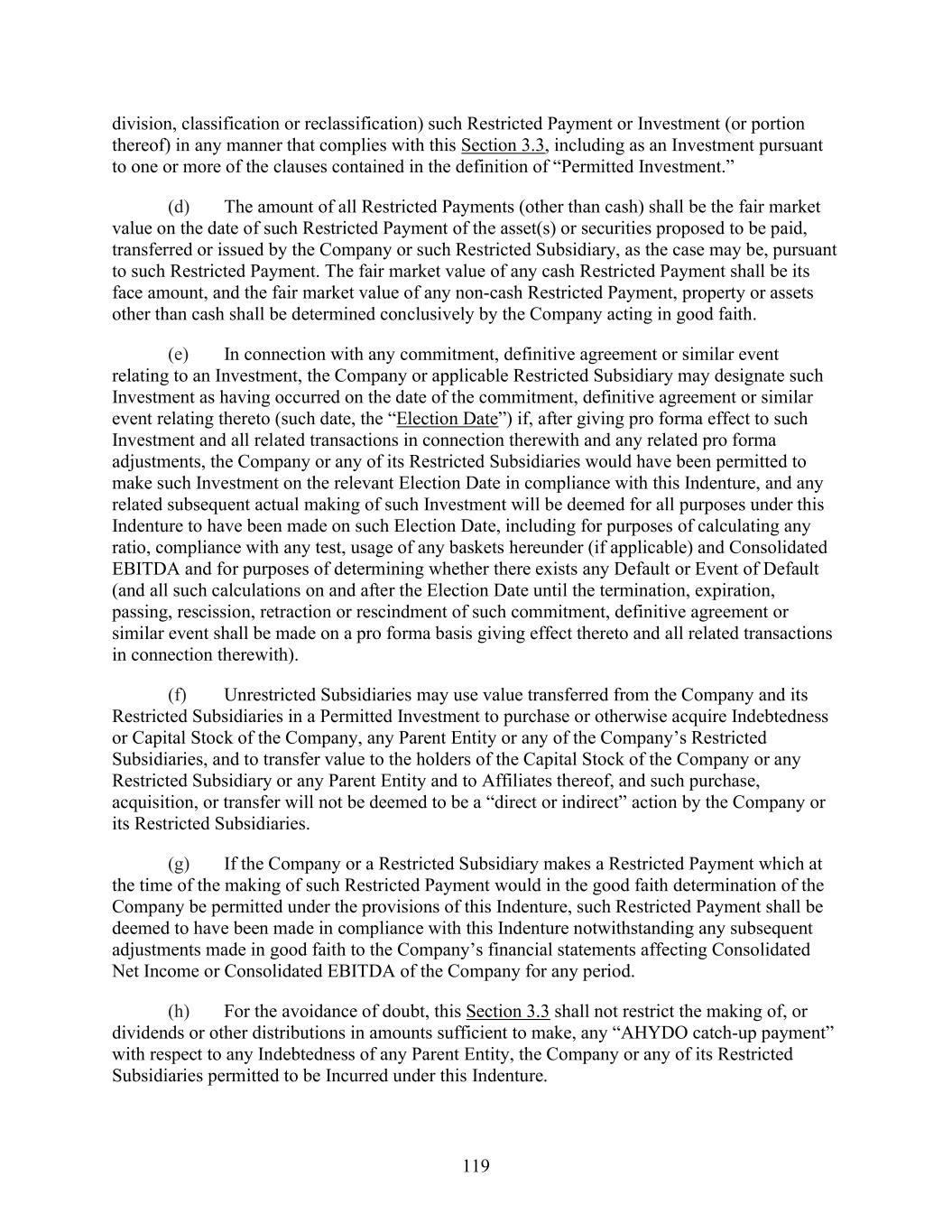
119 division, classification or reclassification) such Restricted Payment or Investment (or portion thereof) in any manner that complies with this Section 3.3, including as an Investment pursuant to one or more of the clauses contained in the definition of “Permitted Investment.” (d) The amount of all Restricted Payments (other than cash) shall be the fair market value on the date of such Restricted Payment of the asset(s) or securities proposed to be paid, transferred or issued by the Company or such Restricted Subsidiary, as the case may be, pursuant to such Restricted Payment. The fair market value of any cash Restricted Payment shall be its face amount, and the fair market value of any non-cash Restricted Payment, property or assets other than cash shall be determined conclusively by the Company acting in good faith. (e) In connection with any commitment, definitive agreement or similar event relating to an Investment, the Company or applicable Restricted Subsidiary may designate such Investment as having occurred on the date of the commitment, definitive agreement or similar event relating thereto (such date, the “Election Date”) if, after giving pro forma effect to such Investment and all related transactions in connection therewith and any related pro forma adjustments, the Company or any of its Restricted Subsidiaries would have been permitted to make such Investment on the relevant Election Date in compliance with this Indenture, and any related subsequent actual making of such Investment will be deemed for all purposes under this Indenture to have been made on such Election Date, including for purposes of calculating any ratio, compliance with any test, usage of any baskets hereunder (if applicable) and Consolidated EBITDA and for purposes of determining whether there exists any Default or Event of Default (and all such calculations on and after the Election Date until the termination, expiration, passing, rescission, retraction or rescindment of such commitment, definitive agreement or similar event shall be made on a pro forma basis giving effect thereto and all related transactions in connection therewith). (f) Unrestricted Subsidiaries may use value transferred from the Company and its Restricted Subsidiaries in a Permitted Investment to purchase or otherwise acquire Indebtedness or Capital Stock of the Company, any Parent Entity or any of the Company’s Restricted Subsidiaries, and to transfer value to the holders of the Capital Stock of the Company or any Restricted Subsidiary or any Parent Entity and to Affiliates thereof, and such purchase, acquisition, or transfer will not be deemed to be a “direct or indirect” action by the Company or its Restricted Subsidiaries. (g) If the Company or a Restricted Subsidiary makes a Restricted Payment which at the time of the making of such Restricted Payment would in the good faith determination of the Company be permitted under the provisions of this Indenture, such Restricted Payment shall be deemed to have been made in compliance with this Indenture notwithstanding any subsequent adjustments made in good faith to the Company’s financial statements affecting Consolidated Net Income or Consolidated EBITDA of the Company for any period. (h) For the avoidance of doubt, this Section 3.3 shall not restrict the making of, or dividends or other distributions in amounts sufficient to make, any “AHYDO catch-up payment” with respect to any Indebtedness of any Parent Entity, the Company or any of its Restricted Subsidiaries permitted to be Incurred under this Indenture.
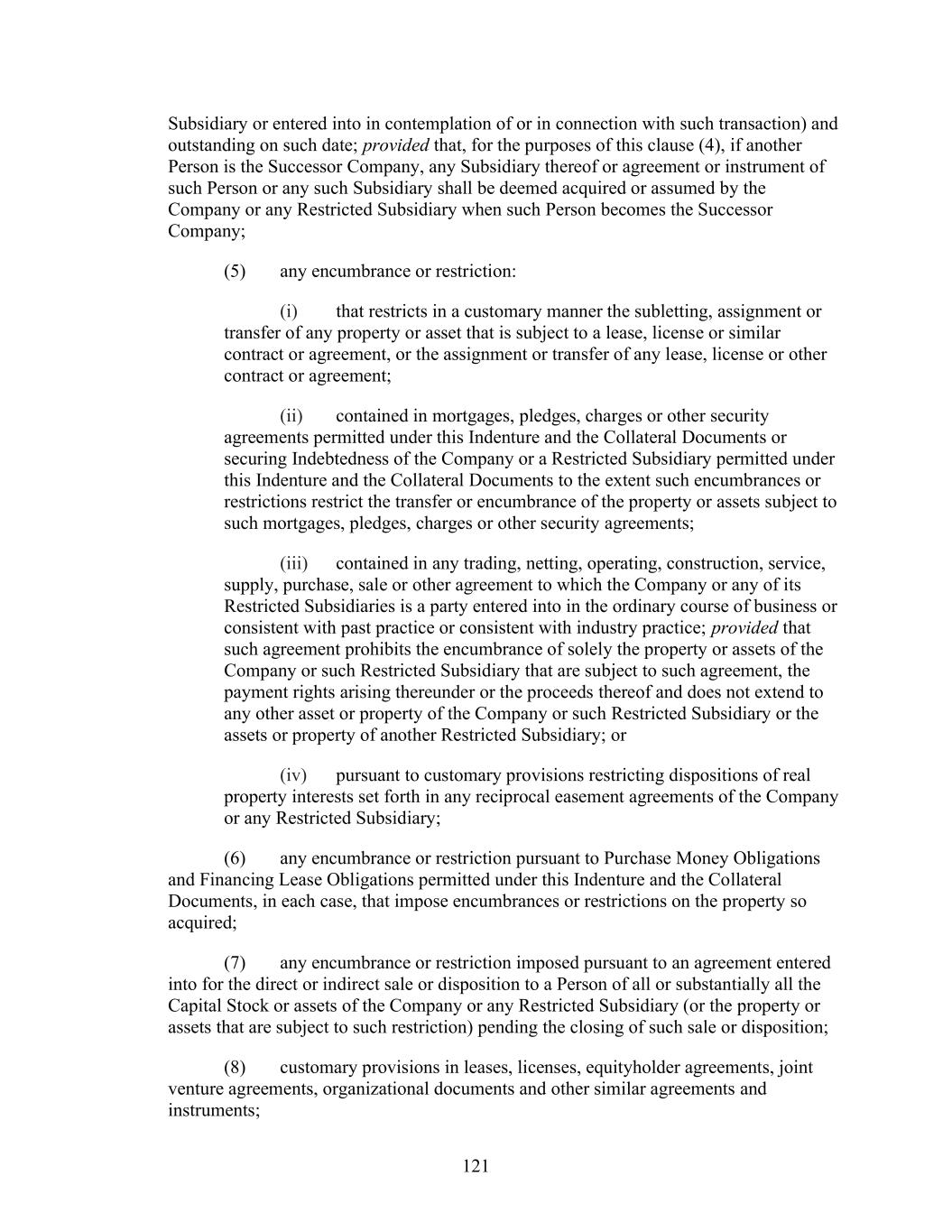
121 Subsidiary or entered into in contemplation of or in connection with such transaction) and outstanding on such date; provided that, for the purposes of this clause (4), if another Person is the Successor Company, any Subsidiary thereof or agreement or instrument of such Person or any such Subsidiary shall be deemed acquired or assumed by the Company or any Restricted Subsidiary when such Person becomes the Successor Company; (5) any encumbrance or restriction: (i) that restricts in a customary manner the subletting, assignment or transfer of any property or asset that is subject to a lease, license or similar contract or agreement, or the assignment or transfer of any lease, license or other contract or agreement; (ii) contained in mortgages, pledges, charges or other security agreements permitted under this Indenture and the Collateral Documents or securing Indebtedness of the Company or a Restricted Subsidiary permitted under this Indenture and the Collateral Documents to the extent such encumbrances or restrictions restrict the transfer or encumbrance of the property or assets subject to such mortgages, pledges, charges or other security agreements; (iii) contained in any trading, netting, operating, construction, service, supply, purchase, sale or other agreement to which the Company or any of its Restricted Subsidiaries is a party entered into in the ordinary course of business or consistent with past practice or consistent with industry practice; provided that such agreement prohibits the encumbrance of solely the property or assets of the Company or such Restricted Subsidiary that are subject to such agreement, the payment rights arising thereunder or the proceeds thereof and does not extend to any other asset or property of the Company or such Restricted Subsidiary or the assets or property of another Restricted Subsidiary; or (iv) pursuant to customary provisions restricting dispositions of real property interests set forth in any reciprocal easement agreements of the Company or any Restricted Subsidiary; (6) any encumbrance or restriction pursuant to Purchase Money Obligations and Financing Lease Obligations permitted under this Indenture and the Collateral Documents, in each case, that impose encumbrances or restrictions on the property so acquired; (7) any encumbrance or restriction imposed pursuant to an agreement entered into for the direct or indirect sale or disposition to a Person of all or substantially all the Capital Stock or assets of the Company or any Restricted Subsidiary (or the property or assets that are subject to such restriction) pending the closing of such sale or disposition; (8) customary provisions in leases, licenses, equityholder agreements, joint venture agreements, organizational documents and other similar agreements and instruments;
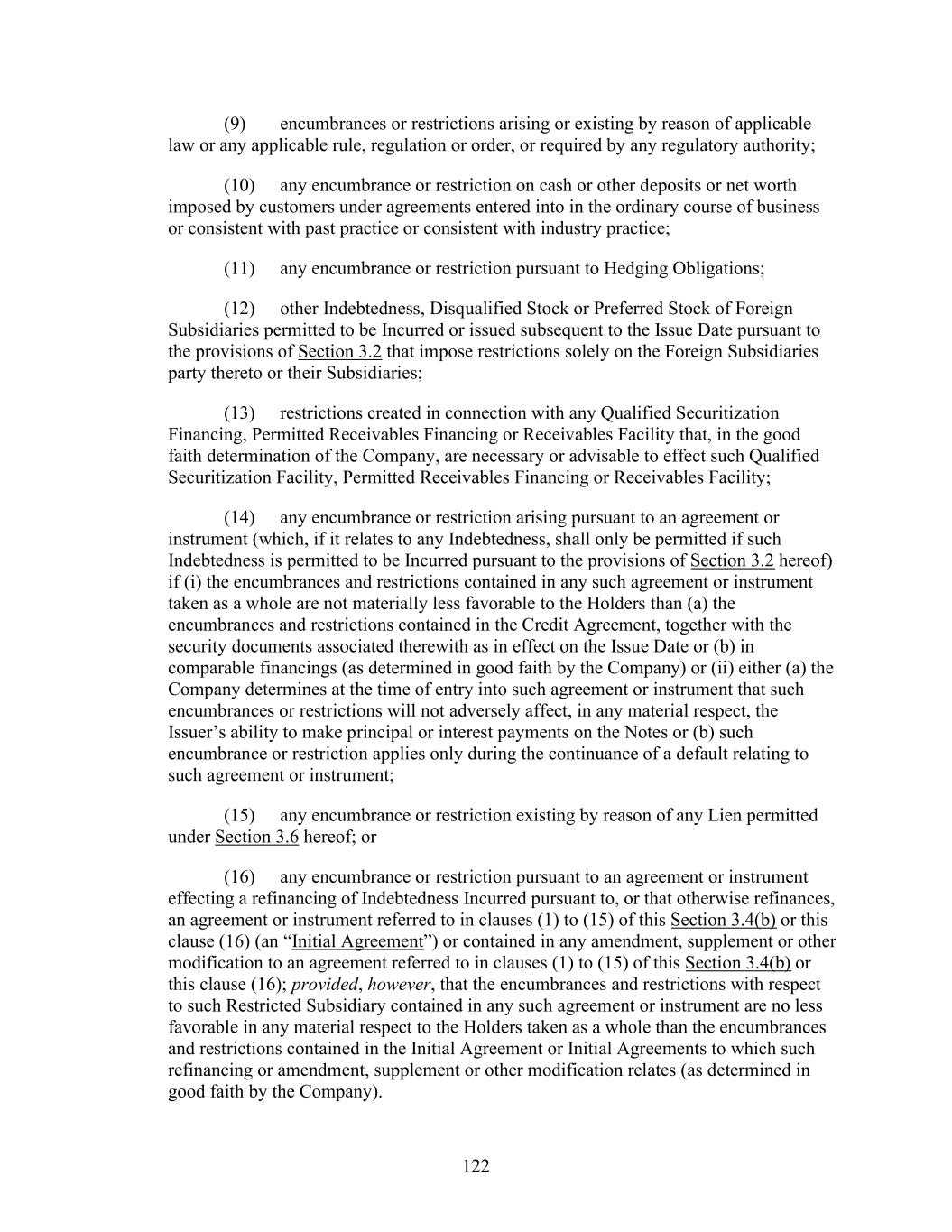
122 (9) encumbrances or restrictions arising or existing by reason of applicable law or any applicable rule, regulation or order, or required by any regulatory authority; (10) any encumbrance or restriction on cash or other deposits or net worth imposed by customers under agreements entered into in the ordinary course of business or consistent with past practice or consistent with industry practice; (11) any encumbrance or restriction pursuant to Hedging Obligations; (12) other Indebtedness, Disqualified Stock or Preferred Stock of Foreign Subsidiaries permitted to be Incurred or issued subsequent to the Issue Date pursuant to the provisions of Section 3.2 that impose restrictions solely on the Foreign Subsidiaries party thereto or their Subsidiaries; (13) restrictions created in connection with any Qualified Securitization Financing, Permitted Receivables Financing or Receivables Facility that, in the good faith determination of the Company, are necessary or advisable to effect such Qualified Securitization Facility, Permitted Receivables Financing or Receivables Facility; (14) any encumbrance or restriction arising pursuant to an agreement or instrument (which, if it relates to any Indebtedness, shall only be permitted if such Indebtedness is permitted to be Incurred pursuant to the provisions of Section 3.2 hereof) if (i) the encumbrances and restrictions contained in any such agreement or instrument taken as a whole are not materially less favorable to the Holders than (a) the encumbrances and restrictions contained in the Credit Agreement, together with the security documents associated therewith as in effect on the Issue Date or (b) in comparable financings (as determined in good faith by the Company) or (ii) either (a) the Company determines at the time of entry into such agreement or instrument that such encumbrances or restrictions will not adversely affect, in any material respect, the Issuer’s ability to make principal or interest payments on the Notes or (b) such encumbrance or restriction applies only during the continuance of a default relating to such agreement or instrument; (15) any encumbrance or restriction existing by reason of any Lien permitted under Section 3.6 hereof; or (16) any encumbrance or restriction pursuant to an agreement or instrument effecting a refinancing of Indebtedness Incurred pursuant to, or that otherwise refinances, an agreement or instrument referred to in clauses (1) to (15) of this Section 3.4(b) or this clause (16) (an “Initial Agreement”) or contained in any amendment, supplement or other modification to an agreement referred to in clauses (1) to (15) of this Section 3.4(b) or this clause (16); provided, however, that the encumbrances and restrictions with respect to such Restricted Subsidiary contained in any such agreement or instrument are no less favorable in any material respect to the Holders taken as a whole than the encumbrances and restrictions contained in the Initial Agreement or Initial Agreements to which such refinancing or amendment, supplement or other modification relates (as determined in good faith by the Company).
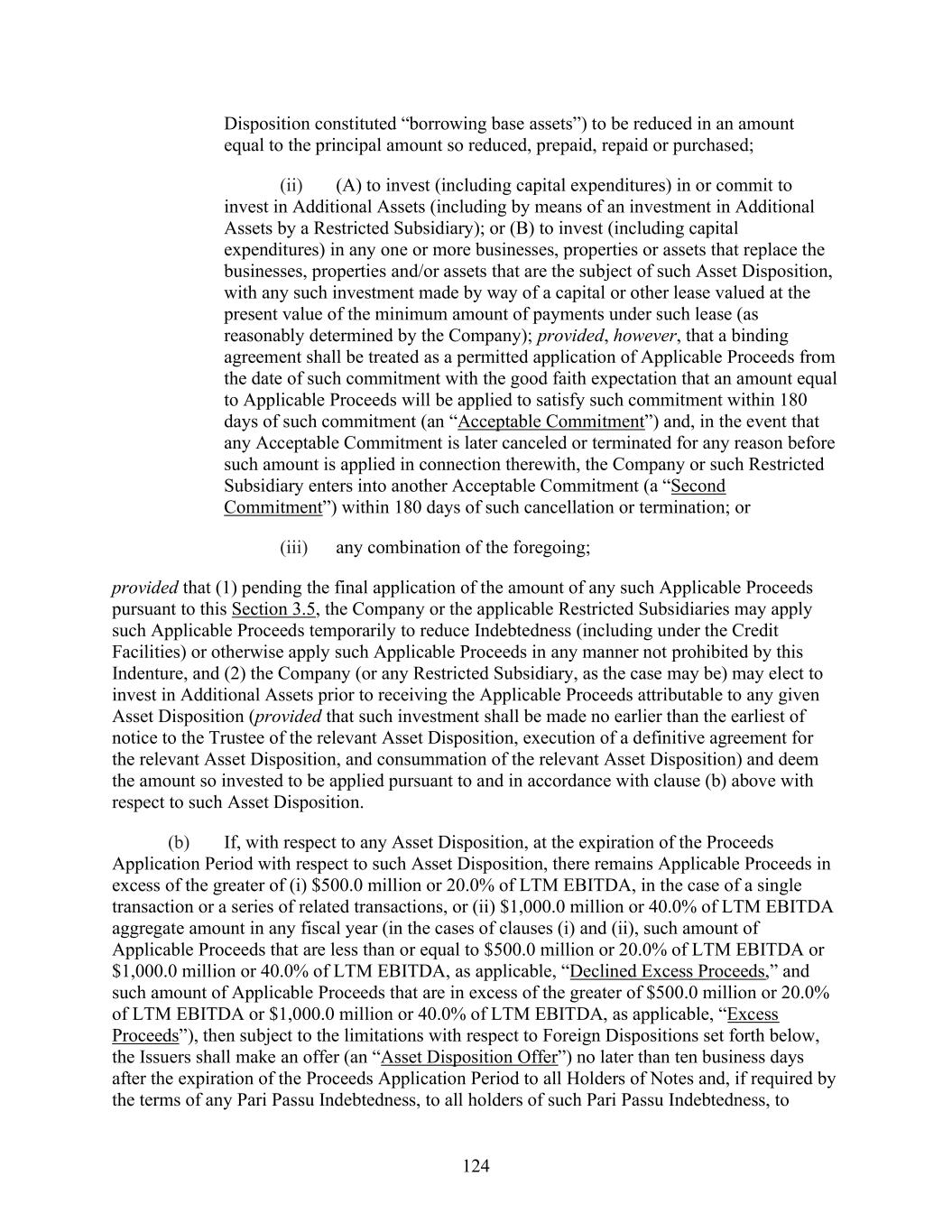
124 Disposition constituted “borrowing base assets”) to be reduced in an amount equal to the principal amount so reduced, prepaid, repaid or purchased; (ii) (A) to invest (including capital expenditures) in or commit to invest in Additional Assets (including by means of an investment in Additional Assets by a Restricted Subsidiary); or (B) to invest (including capital expenditures) in any one or more businesses, properties or assets that replace the businesses, properties and/or assets that are the subject of such Asset Disposition, with any such investment made by way of a capital or other lease valued at the present value of the minimum amount of payments under such lease (as reasonably determined by the Company); provided, however, that a binding agreement shall be treated as a permitted application of Applicable Proceeds from the date of such commitment with the good faith expectation that an amount equal to Applicable Proceeds will be applied to satisfy such commitment within 180 days of such commitment (an “Acceptable Commitment”) and, in the event that any Acceptable Commitment is later canceled or terminated for any reason before such amount is applied in connection therewith, the Company or such Restricted Subsidiary enters into another Acceptable Commitment (a “Second Commitment”) within 180 days of such cancellation or termination; or (iii) any combination of the foregoing; provided that (1) pending the final application of the amount of any such Applicable Proceeds pursuant to this Section 3.5, the Company or the applicable Restricted Subsidiaries may apply such Applicable Proceeds temporarily to reduce Indebtedness (including under the Credit Facilities) or otherwise apply such Applicable Proceeds in any manner not prohibited by this Indenture, and (2) the Company (or any Restricted Subsidiary, as the case may be) may elect to invest in Additional Assets prior to receiving the Applicable Proceeds attributable to any given Asset Disposition (provided that such investment shall be made no earlier than the earliest of notice to the Trustee of the relevant Asset Disposition, execution of a definitive agreement for the relevant Asset Disposition, and consummation of the relevant Asset Disposition) and deem the amount so invested to be applied pursuant to and in accordance with clause (b) above with respect to such Asset Disposition. (b) If, with respect to any Asset Disposition, at the expiration of the Proceeds Application Period with respect to such Asset Disposition, there remains Applicable Proceeds in excess of the greater of (i) $500.0 million or 20.0% of LTM EBITDA, in the case of a single transaction or a series of related transactions, or (ii) $1,000.0 million or 40.0% of LTM EBITDA aggregate amount in any fiscal year (in the cases of clauses (i) and (ii), such amount of Applicable Proceeds that are less than or equal to $500.0 million or 20.0% of LTM EBITDA or $1,000.0 million or 40.0% of LTM EBITDA, as applicable, “Declined Excess Proceeds,” and such amount of Applicable Proceeds that are in excess of the greater of $500.0 million or 20.0% of LTM EBITDA or $1,000.0 million or 40.0% of LTM EBITDA, as applicable, “Excess Proceeds”), then subject to the limitations with respect to Foreign Dispositions set forth below, the Issuers shall make an offer (an “Asset Disposition Offer”) no later than ten business days after the expiration of the Proceeds Application Period to all Holders of Notes and, if required by the terms of any Pari Passu Indebtedness, to all holders of such Pari Passu Indebtedness, to
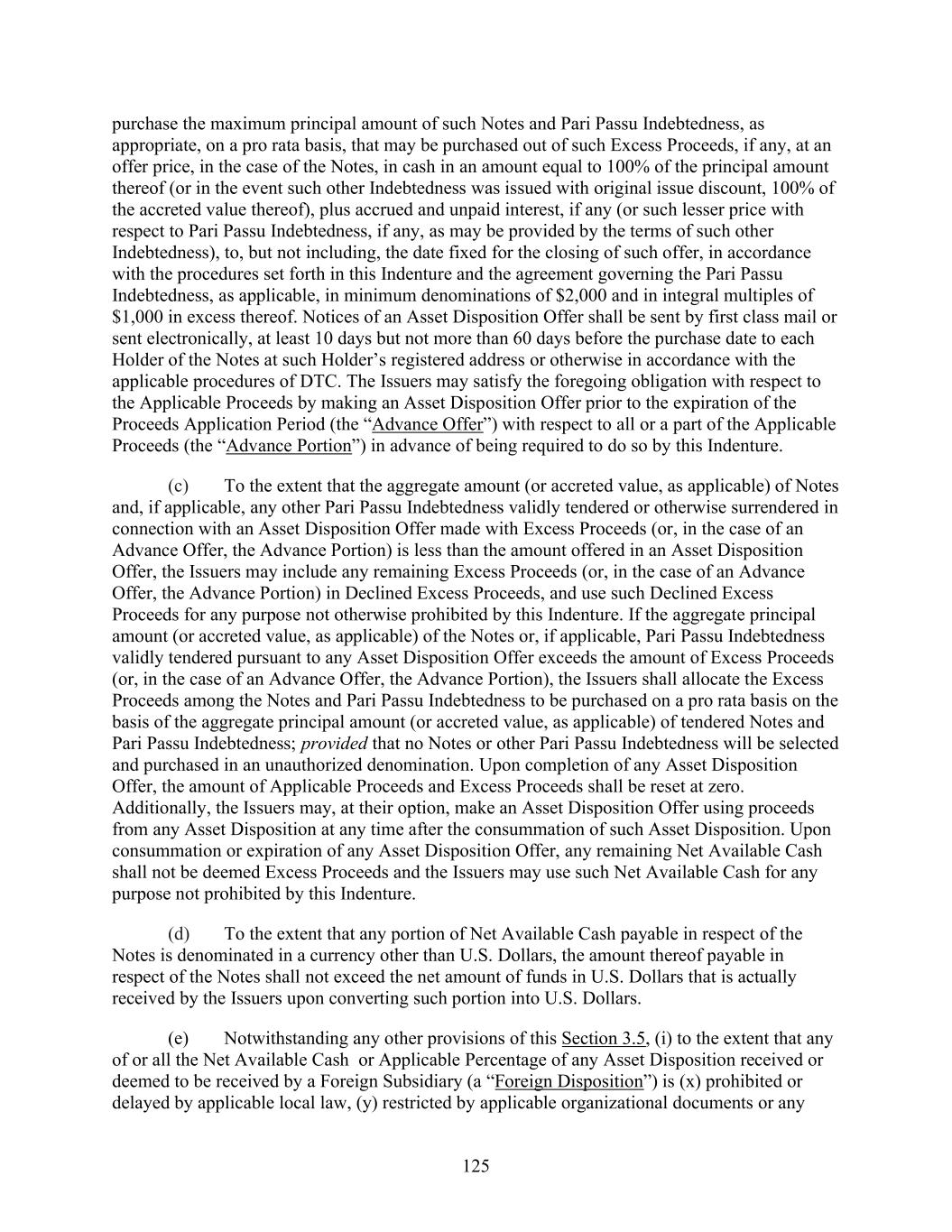
125 purchase the maximum principal amount of such Notes and Pari Passu Indebtedness, as appropriate, on a pro rata basis, that may be purchased out of such Excess Proceeds, if any, at an offer price, in the case of the Notes, in cash in an amount equal to 100% of the principal amount thereof (or in the event such other Indebtedness was issued with original issue discount, 100% of the accreted value thereof), plus accrued and unpaid interest, if any (or such lesser price with respect to Pari Passu Indebtedness, if any, as may be provided by the terms of such other Indebtedness), to, but not including, the date fixed for the closing of such offer, in accordance with the procedures set forth in this Indenture and the agreement governing the Pari Passu Indebtedness, as applicable, in minimum denominations of $2,000 and in integral multiples of $1,000 in excess thereof. Notices of an Asset Disposition Offer shall be sent by first class mail or sent electronically, at least 10 days but not more than 60 days before the purchase date to each Holder of the Notes at such Holder’s registered address or otherwise in accordance with the applicable procedures of DTC. The Issuers may satisfy the foregoing obligation with respect to the Applicable Proceeds by making an Asset Disposition Offer prior to the expiration of the Proceeds Application Period (the “Advance Offer”) with respect to all or a part of the Applicable Proceeds (the “Advance Portion”) in advance of being required to do so by this Indenture. (c) To the extent that the aggregate amount (or accreted value, as applicable) of Notes and, if applicable, any other Pari Passu Indebtedness validly tendered or otherwise surrendered in connection with an Asset Disposition Offer made with Excess Proceeds (or, in the case of an Advance Offer, the Advance Portion) is less than the amount offered in an Asset Disposition Offer, the Issuers may include any remaining Excess Proceeds (or, in the case of an Advance Offer, the Advance Portion) in Declined Excess Proceeds, and use such Declined Excess Proceeds for any purpose not otherwise prohibited by this Indenture. If the aggregate principal amount (or accreted value, as applicable) of the Notes or, if applicable, Pari Passu Indebtedness validly tendered pursuant to any Asset Disposition Offer exceeds the amount of Excess Proceeds (or, in the case of an Advance Offer, the Advance Portion), the Issuers shall allocate the Excess Proceeds among the Notes and Pari Passu Indebtedness to be purchased on a pro rata basis on the basis of the aggregate principal amount (or accreted value, as applicable) of tendered Notes and Pari Passu Indebtedness; provided that no Notes or other Pari Passu Indebtedness will be selected and purchased in an unauthorized denomination. Upon completion of any Asset Disposition Offer, the amount of Applicable Proceeds and Excess Proceeds shall be reset at zero. Additionally, the Issuers may, at their option, make an Asset Disposition Offer using proceeds from any Asset Disposition at any time after the consummation of such Asset Disposition. Upon consummation or expiration of any Asset Disposition Offer, any remaining Net Available Cash shall not be deemed Excess Proceeds and the Issuers may use such Net Available Cash for any purpose not prohibited by this Indenture. (d) To the extent that any portion of Net Available Cash payable in respect of the Notes is denominated in a currency other than U.S. Dollars, the amount thereof payable in respect of the Notes shall not exceed the net amount of funds in U.S. Dollars that is actually received by the Issuers upon converting such portion into U.S. Dollars. (e) Notwithstanding any other provisions of this Section 3.5, (i) to the extent that any of or all the Net Available Cash or Applicable Percentage of any Asset Disposition received or deemed to be received by a Foreign Subsidiary (a “Foreign Disposition”) is (x) prohibited or delayed by applicable local law, (y) restricted by applicable organizational documents or any
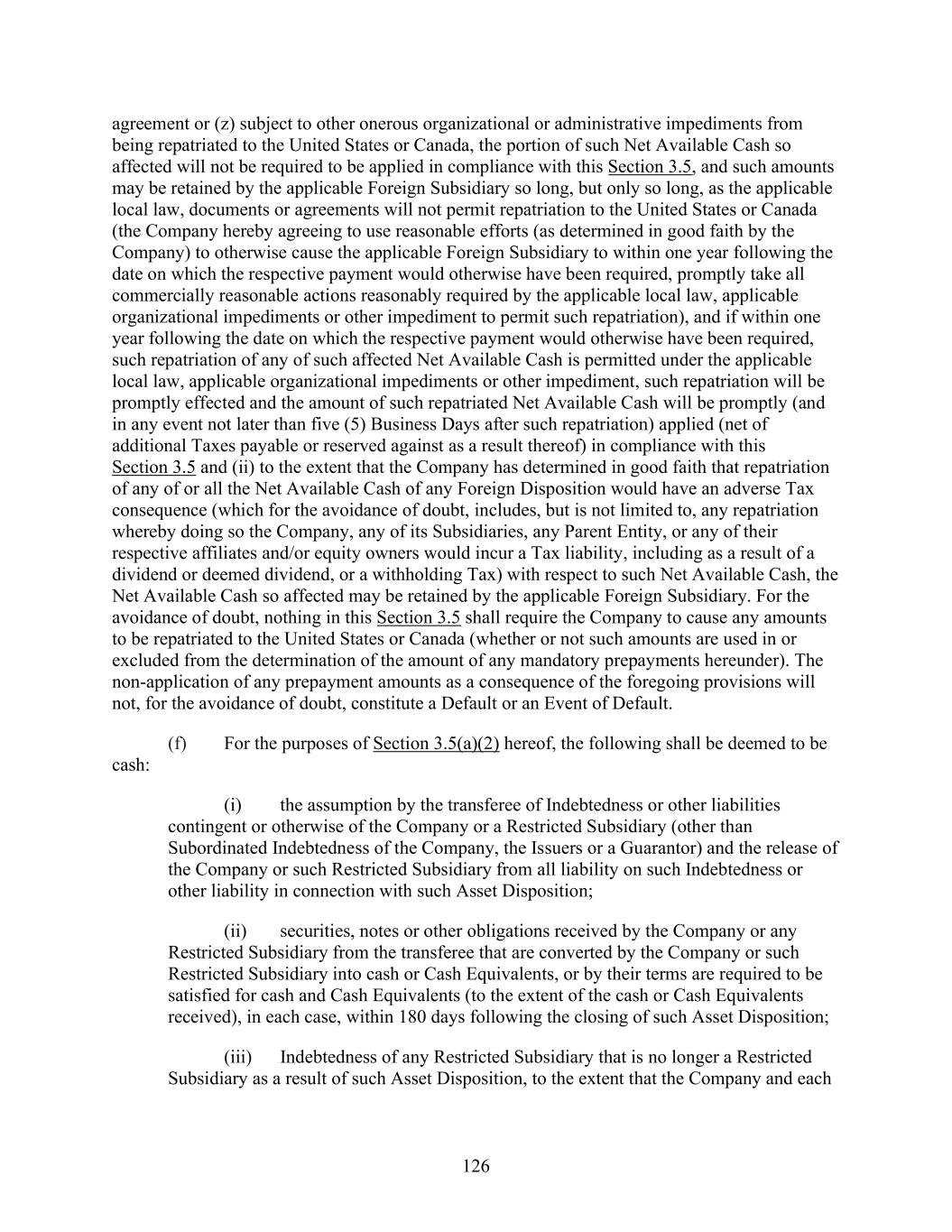
126 agreement or (z) subject to other onerous organizational or administrative impediments from being repatriated to the United States or Canada, the portion of such Net Available Cash so affected will not be required to be applied in compliance with this Section 3.5, and such amounts may be retained by the applicable Foreign Subsidiary so long, but only so long, as the applicable local law, documents or agreements will not permit repatriation to the United States or Canada (the Company hereby agreeing to use reasonable efforts (as determined in good faith by the Company) to otherwise cause the applicable Foreign Subsidiary to within one year following the date on which the respective payment would otherwise have been required, promptly take all commercially reasonable actions reasonably required by the applicable local law, applicable organizational impediments or other impediment to permit such repatriation), and if within one year following the date on which the respective payment would otherwise have been required, such repatriation of any of such affected Net Available Cash is permitted under the applicable local law, applicable organizational impediments or other impediment, such repatriation will be promptly effected and the amount of such repatriated Net Available Cash will be promptly (and in any event not later than five (5) Business Days after such repatriation) applied (net of additional Taxes payable or reserved against as a result thereof) in compliance with this Section 3.5 and (ii) to the extent that the Company has determined in good faith that repatriation of any of or all the Net Available Cash of any Foreign Disposition would have an adverse Tax consequence (which for the avoidance of doubt, includes, but is not limited to, any repatriation whereby doing so the Company, any of its Subsidiaries, any Parent Entity, or any of their respective affiliates and/or equity owners would incur a Tax liability, including as a result of a dividend or deemed dividend, or a withholding Tax) with respect to such Net Available Cash, the Net Available Cash so affected may be retained by the applicable Foreign Subsidiary. For the avoidance of doubt, nothing in this Section 3.5 shall require the Company to cause any amounts to be repatriated to the United States or Canada (whether or not such amounts are used in or excluded from the determination of the amount of any mandatory prepayments hereunder). The non-application of any prepayment amounts as a consequence of the foregoing provisions will not, for the avoidance of doubt, constitute a Default or an Event of Default. (f) For the purposes of Section 3.5(a)(2) hereof, the following shall be deemed to be cash: (i) the assumption by the transferee of Indebtedness or other liabilities contingent or otherwise of the Company or a Restricted Subsidiary (other than Subordinated Indebtedness of the Company, the Issuers or a Guarantor) and the release of the Company or such Restricted Subsidiary from all liability on such Indebtedness or other liability in connection with such Asset Disposition; (ii) securities, notes or other obligations received by the Company or any Restricted Subsidiary from the transferee that are converted by the Company or such Restricted Subsidiary into cash or Cash Equivalents, or by their terms are required to be satisfied for cash and Cash Equivalents (to the extent of the cash or Cash Equivalents received), in each case, within 180 days following the closing of such Asset Disposition; (iii) Indebtedness of any Restricted Subsidiary that is no longer a Restricted Subsidiary as a result of such Asset Disposition, to the extent that the Company and each
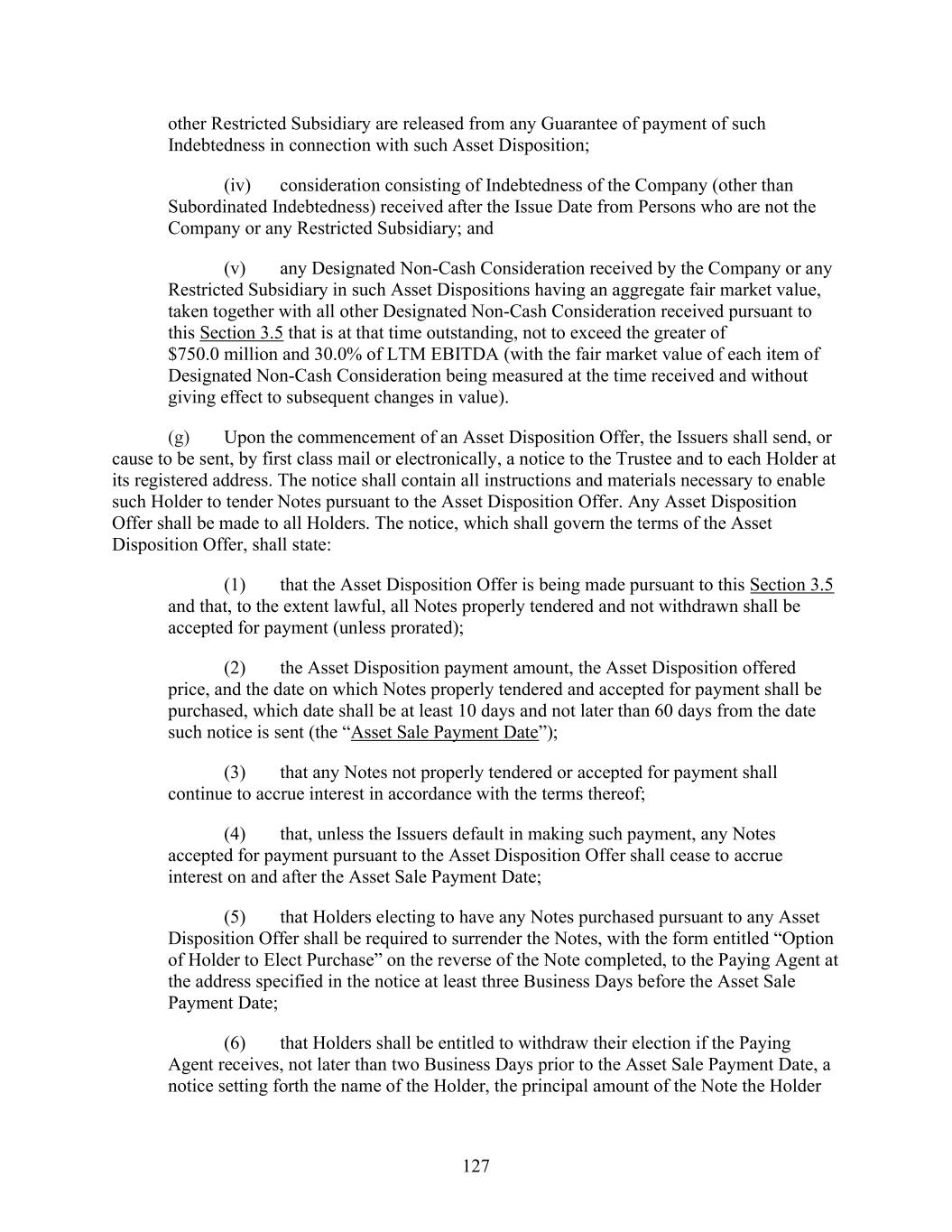
127 other Restricted Subsidiary are released from any Guarantee of payment of such Indebtedness in connection with such Asset Disposition; (iv) consideration consisting of Indebtedness of the Company (other than Subordinated Indebtedness) received after the Issue Date from Persons who are not the Company or any Restricted Subsidiary; and (v) any Designated Non-Cash Consideration received by the Company or any Restricted Subsidiary in such Asset Dispositions having an aggregate fair market value, taken together with all other Designated Non-Cash Consideration received pursuant to this Section 3.5 that is at that time outstanding, not to exceed the greater of $750.0 million and 30.0% of LTM EBITDA (with the fair market value of each item of Designated Non-Cash Consideration being measured at the time received and without giving effect to subsequent changes in value). (g) Upon the commencement of an Asset Disposition Offer, the Issuers shall send, or cause to be sent, by first class mail or electronically, a notice to the Trustee and to each Holder at its registered address. The notice shall contain all instructions and materials necessary to enable such Holder to tender Notes pursuant to the Asset Disposition Offer. Any Asset Disposition Offer shall be made to all Holders. The notice, which shall govern the terms of the Asset Disposition Offer, shall state: (1) that the Asset Disposition Offer is being made pursuant to this Section 3.5 and that, to the extent lawful, all Notes properly tendered and not withdrawn shall be accepted for payment (unless prorated); (2) the Asset Disposition payment amount, the Asset Disposition offered price, and the date on which Notes properly tendered and accepted for payment shall be purchased, which date shall be at least 10 days and not later than 60 days from the date such notice is sent (the “Asset Sale Payment Date”); (3) that any Notes not properly tendered or accepted for payment shall continue to accrue interest in accordance with the terms thereof; (4) that, unless the Issuers default in making such payment, any Notes accepted for payment pursuant to the Asset Disposition Offer shall cease to accrue interest on and after the Asset Sale Payment Date; (5) that Holders electing to have any Notes purchased pursuant to any Asset Disposition Offer shall be required to surrender the Notes, with the form entitled “Option of Holder to Elect Purchase” on the reverse of the Note completed, to the Paying Agent at the address specified in the notice at least three Business Days before the Asset Sale Payment Date; (6) that Holders shall be entitled to withdraw their election if the Paying Agent receives, not later than two Business Days prior to the Asset Sale Payment Date, a notice setting forth the name of the Holder, the principal amount of the Note the Holder
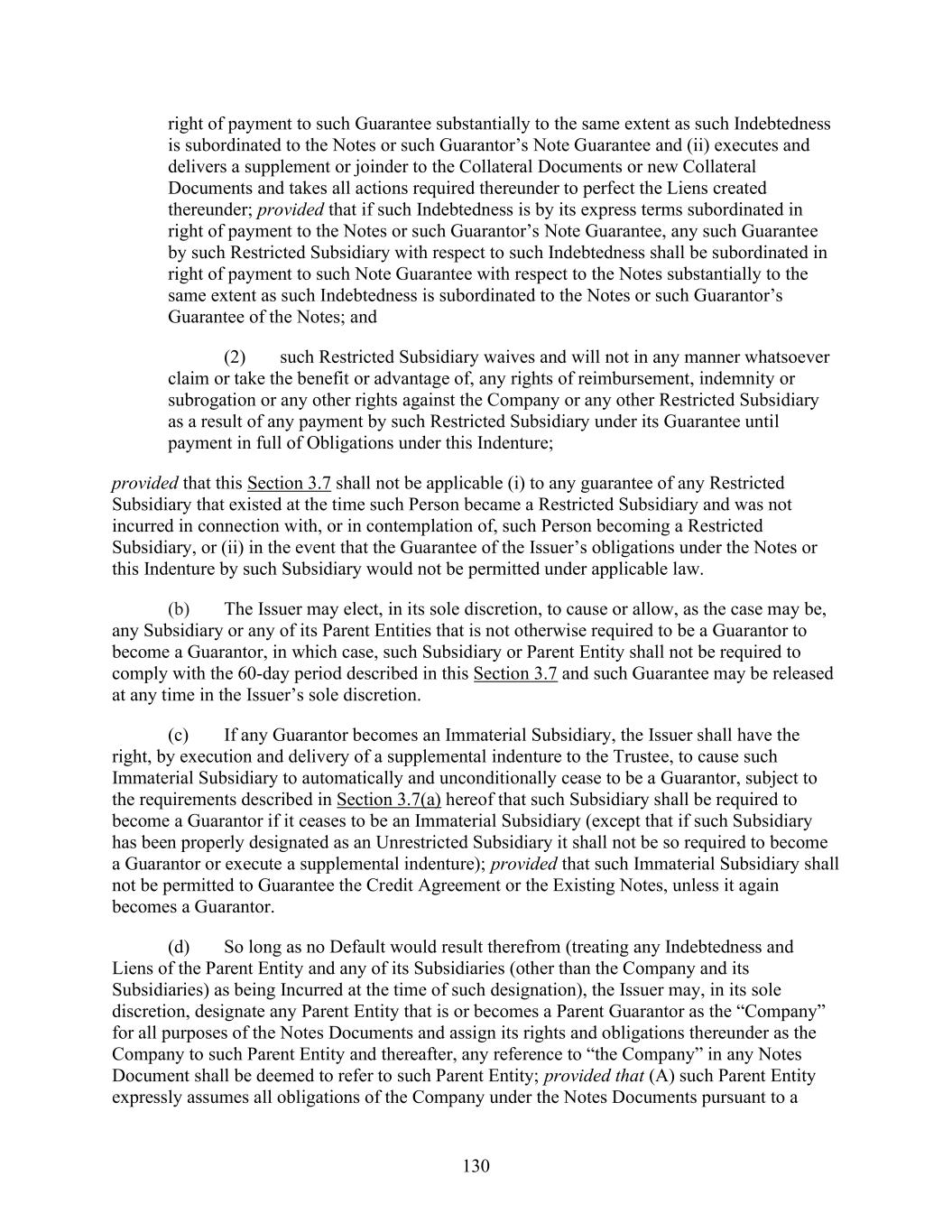
130 right of payment to such Guarantee substantially to the same extent as such Indebtedness is subordinated to the Notes or such Guarantor’s Note Guarantee and (ii) executes and delivers a supplement or joinder to the Collateral Documents or new Collateral Documents and takes all actions required thereunder to perfect the Liens created thereunder; provided that if such Indebtedness is by its express terms subordinated in right of payment to the Notes or such Guarantor’s Note Guarantee, any such Guarantee by such Restricted Subsidiary with respect to such Indebtedness shall be subordinated in right of payment to such Note Guarantee with respect to the Notes substantially to the same extent as such Indebtedness is subordinated to the Notes or such Guarantor’s Guarantee of the Notes; and (2) such Restricted Subsidiary waives and will not in any manner whatsoever claim or take the benefit or advantage of, any rights of reimbursement, indemnity or subrogation or any other rights against the Company or any other Restricted Subsidiary as a result of any payment by such Restricted Subsidiary under its Guarantee until payment in full of Obligations under this Indenture; provided that this Section 3.7 shall not be applicable (i) to any guarantee of any Restricted Subsidiary that existed at the time such Person became a Restricted Subsidiary and was not incurred in connection with, or in contemplation of, such Person becoming a Restricted Subsidiary, or (ii) in the event that the Guarantee of the Issuer’s obligations under the Notes or this Indenture by such Subsidiary would not be permitted under applicable law. (b) The Issuer may elect, in its sole discretion, to cause or allow, as the case may be, any Subsidiary or any of its Parent Entities that is not otherwise required to be a Guarantor to become a Guarantor, in which case, such Subsidiary or Parent Entity shall not be required to comply with the 60-day period described in this Section 3.7 and such Guarantee may be released at any time in the Issuer’s sole discretion. (c) If any Guarantor becomes an Immaterial Subsidiary, the Issuer shall have the right, by execution and delivery of a supplemental indenture to the Trustee, to cause such Immaterial Subsidiary to automatically and unconditionally cease to be a Guarantor, subject to the requirements described in Section 3.7(a) hereof that such Subsidiary shall be required to become a Guarantor if it ceases to be an Immaterial Subsidiary (except that if such Subsidiary has been properly designated as an Unrestricted Subsidiary it shall not be so required to become a Guarantor or execute a supplemental indenture); provided that such Immaterial Subsidiary shall not be permitted to Guarantee the Credit Agreement or the Existing Notes, unless it again becomes a Guarantor. (d) So long as no Default would result therefrom (treating any Indebtedness and Liens of the Parent Entity and any of its Subsidiaries (other than the Company and its Subsidiaries) as being Incurred at the time of such designation), the Issuer may, in its sole discretion, designate any Parent Entity that is or becomes a Parent Guarantor as the “Company” for all purposes of the Notes Documents and assign its rights and obligations thereunder as the Company to such Parent Entity and thereafter, any reference to “the Company” in any Notes Document shall be deemed to refer to such Parent Entity; provided that (A) such Parent Entity expressly assumes all obligations of the Company under the Notes Documents pursuant to a

132 its Subsidiaries or any of its Parent Entities and (b) directors’ qualifying shares and shares issued to foreign nationals as required under applicable law; (3) any Management Advances and any waiver or transaction with respect thereto; (4) (a) any transaction between or among the Company and any Restricted Subsidiary (or entity that becomes a Restricted Subsidiary as a result of such transaction), or between or among Restricted Subsidiaries and (b) any merger, amalgamation or consolidation with any Parent Entity; provided that such Parent Entity shall have no material liabilities and no material assets other than cash, Cash Equivalents and the Capital Stock of the Company and such merger, amalgamation or consolidation is otherwise permitted under this Indenture; (5) the payment of compensation, fees, costs and expenses to, and indemnities (including under insurance policies) and reimbursements, employment and severance arrangements, and employee benefit and pension expenses provided on behalf of, or for the benefit of, future, current or former employees, directors, officers, managers, contractors, consultants, distributors or advisors (or their respective Controlled Investment Affiliates or Immediate Family Members) of the Company, any Parent Entity or any Restricted Subsidiary (whether directly or indirectly including through any Person owned or controlled by any of such employees, directors, officers, managers, contractors, consultants, distributors or advisors (or their respective Controlled Investment Affiliates or Immediate Family Members)); (6) the entry into and performance of obligations of the Company or any of its Restricted Subsidiaries under the terms of any transaction arising out of, and any payments pursuant to or for purposes of funding, any agreement or instrument in effect as of or on the Issue Date, as these agreements and instruments may be amended, modified, supplemented, extended, renewed or refinanced from time to time in accordance with the other terms of this Section 3.8 or to the extent not more disadvantageous to the Holders in any material respect in the reasonable determination of the Company when taken as a whole as compared to the applicable agreement as in effect on the Issue Date; (7) any transaction effected as part of a Qualified Securitization Financing, Permitted Receivables Financing or Receivables Facility, any disposition or acquisition of Securitization Assets, Receivables Assets or related assets in connection with any Qualified Securitization Financing, Permitted Receivables Financing or Receivables Facility; (8) transactions with customers, vendors, clients, joint venture partners, suppliers, contractors, distributors or purchasers or sellers of goods or services, in each case in the ordinary course of business or consistent with past practice or consistent with industry practice, which are fair to the Company or the relevant Restricted Subsidiary in the reasonable determination of the Company or the relevant Restricted Subsidiary, or are on terms, taken as a whole, that are not materially less favorable as might reasonably have been obtained at such time from an unaffiliated party;
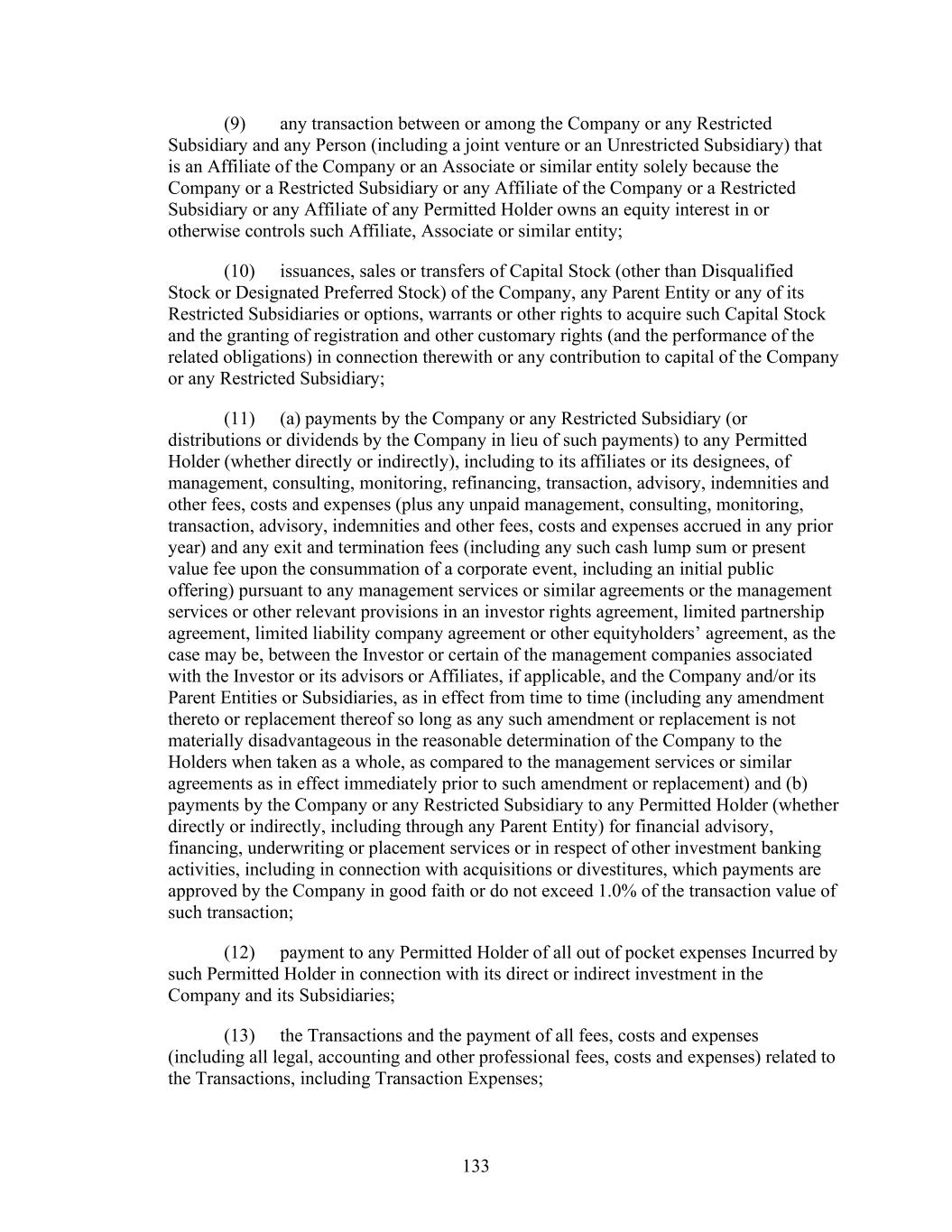
133 (9) any transaction between or among the Company or any Restricted Subsidiary and any Person (including a joint venture or an Unrestricted Subsidiary) that is an Affiliate of the Company or an Associate or similar entity solely because the Company or a Restricted Subsidiary or any Affiliate of the Company or a Restricted Subsidiary or any Affiliate of any Permitted Holder owns an equity interest in or otherwise controls such Affiliate, Associate or similar entity; (10) issuances, sales or transfers of Capital Stock (other than Disqualified Stock or Designated Preferred Stock) of the Company, any Parent Entity or any of its Restricted Subsidiaries or options, warrants or other rights to acquire such Capital Stock and the granting of registration and other customary rights (and the performance of the related obligations) in connection therewith or any contribution to capital of the Company or any Restricted Subsidiary; (11) (a) payments by the Company or any Restricted Subsidiary (or distributions or dividends by the Company in lieu of such payments) to any Permitted Holder (whether directly or indirectly), including to its affiliates or its designees, of management, consulting, monitoring, refinancing, transaction, advisory, indemnities and other fees, costs and expenses (plus any unpaid management, consulting, monitoring, transaction, advisory, indemnities and other fees, costs and expenses accrued in any prior year) and any exit and termination fees (including any such cash lump sum or present value fee upon the consummation of a corporate event, including an initial public offering) pursuant to any management services or similar agreements or the management services or other relevant provisions in an investor rights agreement, limited partnership agreement, limited liability company agreement or other equityholders’ agreement, as the case may be, between the Investor or certain of the management companies associated with the Investor or its advisors or Affiliates, if applicable, and the Company and/or its Parent Entities or Subsidiaries, as in effect from time to time (including any amendment thereto or replacement thereof so long as any such amendment or replacement is not materially disadvantageous in the reasonable determination of the Company to the Holders when taken as a whole, as compared to the management services or similar agreements as in effect immediately prior to such amendment or replacement) and (b) payments by the Company or any Restricted Subsidiary to any Permitted Holder (whether directly or indirectly, including through any Parent Entity) for financial advisory, financing, underwriting or placement services or in respect of other investment banking activities, including in connection with acquisitions or divestitures, which payments are approved by the Company in good faith or do not exceed 1.0% of the transaction value of such transaction; (12) payment to any Permitted Holder of all out of pocket expenses Incurred by such Permitted Holder in connection with its direct or indirect investment in the Company and its Subsidiaries; (13) the Transactions and the payment of all fees, costs and expenses (including all legal, accounting and other professional fees, costs and expenses) related to the Transactions, including Transaction Expenses;
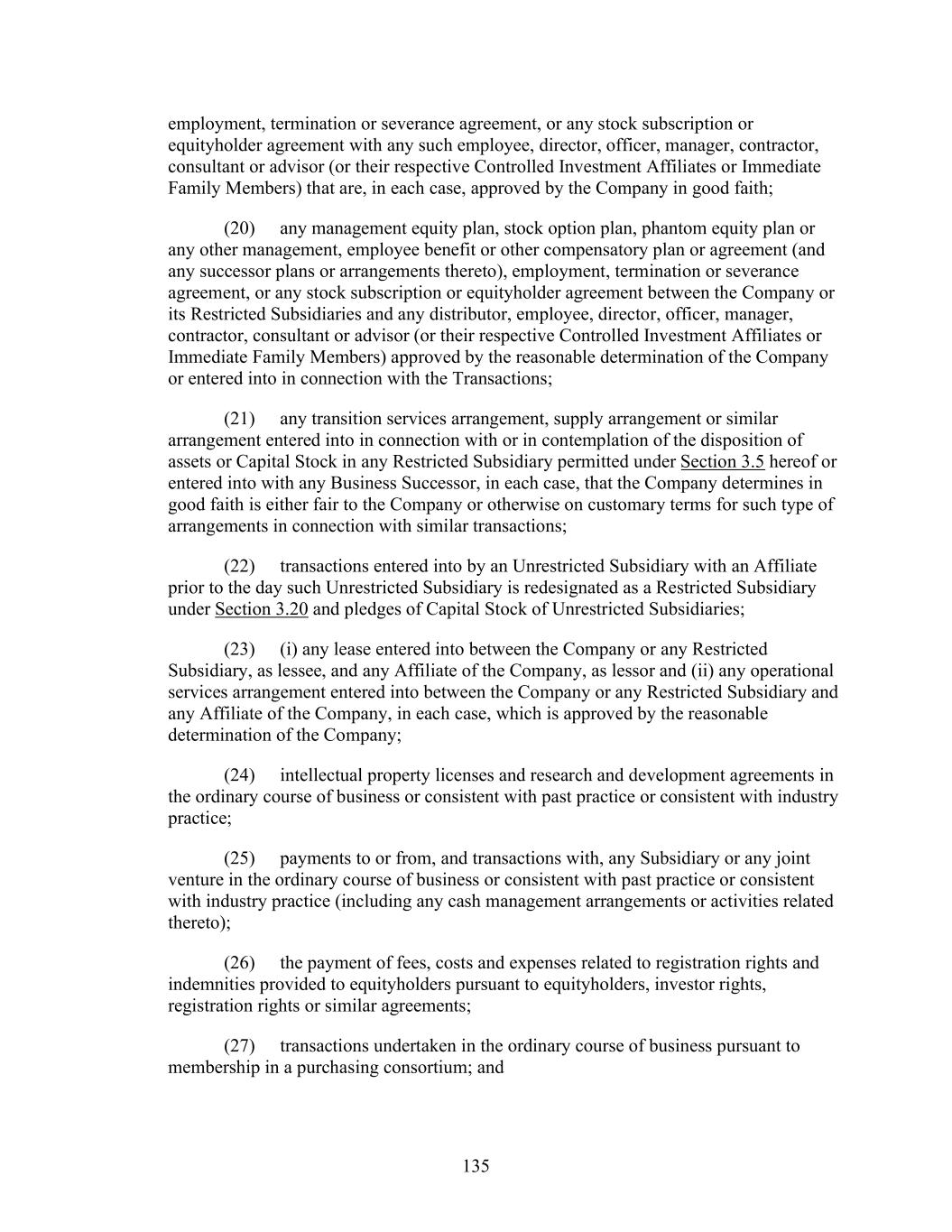
135 employment, termination or severance agreement, or any stock subscription or equityholder agreement with any such employee, director, officer, manager, contractor, consultant or advisor (or their respective Controlled Investment Affiliates or Immediate Family Members) that are, in each case, approved by the Company in good faith; (20) any management equity plan, stock option plan, phantom equity plan or any other management, employee benefit or other compensatory plan or agreement (and any successor plans or arrangements thereto), employment, termination or severance agreement, or any stock subscription or equityholder agreement between the Company or its Restricted Subsidiaries and any distributor, employee, director, officer, manager, contractor, consultant or advisor (or their respective Controlled Investment Affiliates or Immediate Family Members) approved by the reasonable determination of the Company or entered into in connection with the Transactions; (21) any transition services arrangement, supply arrangement or similar arrangement entered into in connection with or in contemplation of the disposition of assets or Capital Stock in any Restricted Subsidiary permitted under Section 3.5 hereof or entered into with any Business Successor, in each case, that the Company determines in good faith is either fair to the Company or otherwise on customary terms for such type of arrangements in connection with similar transactions; (22) transactions entered into by an Unrestricted Subsidiary with an Affiliate prior to the day such Unrestricted Subsidiary is redesignated as a Restricted Subsidiary under Section 3.20 and pledges of Capital Stock of Unrestricted Subsidiaries; (23) (i) any lease entered into between the Company or any Restricted Subsidiary, as lessee, and any Affiliate of the Company, as lessor and (ii) any operational services arrangement entered into between the Company or any Restricted Subsidiary and any Affiliate of the Company, in each case, which is approved by the reasonable determination of the Company; (24) intellectual property licenses and research and development agreements in the ordinary course of business or consistent with past practice or consistent with industry practice; (25) payments to or from, and transactions with, any Subsidiary or any joint venture in the ordinary course of business or consistent with past practice or consistent with industry practice (including any cash management arrangements or activities related thereto); (26) the payment of fees, costs and expenses related to registration rights and indemnities provided to equityholders pursuant to equityholders, investor rights, registration rights or similar agreements; (27) transactions undertaken in the ordinary course of business pursuant to membership in a purchasing consortium; and
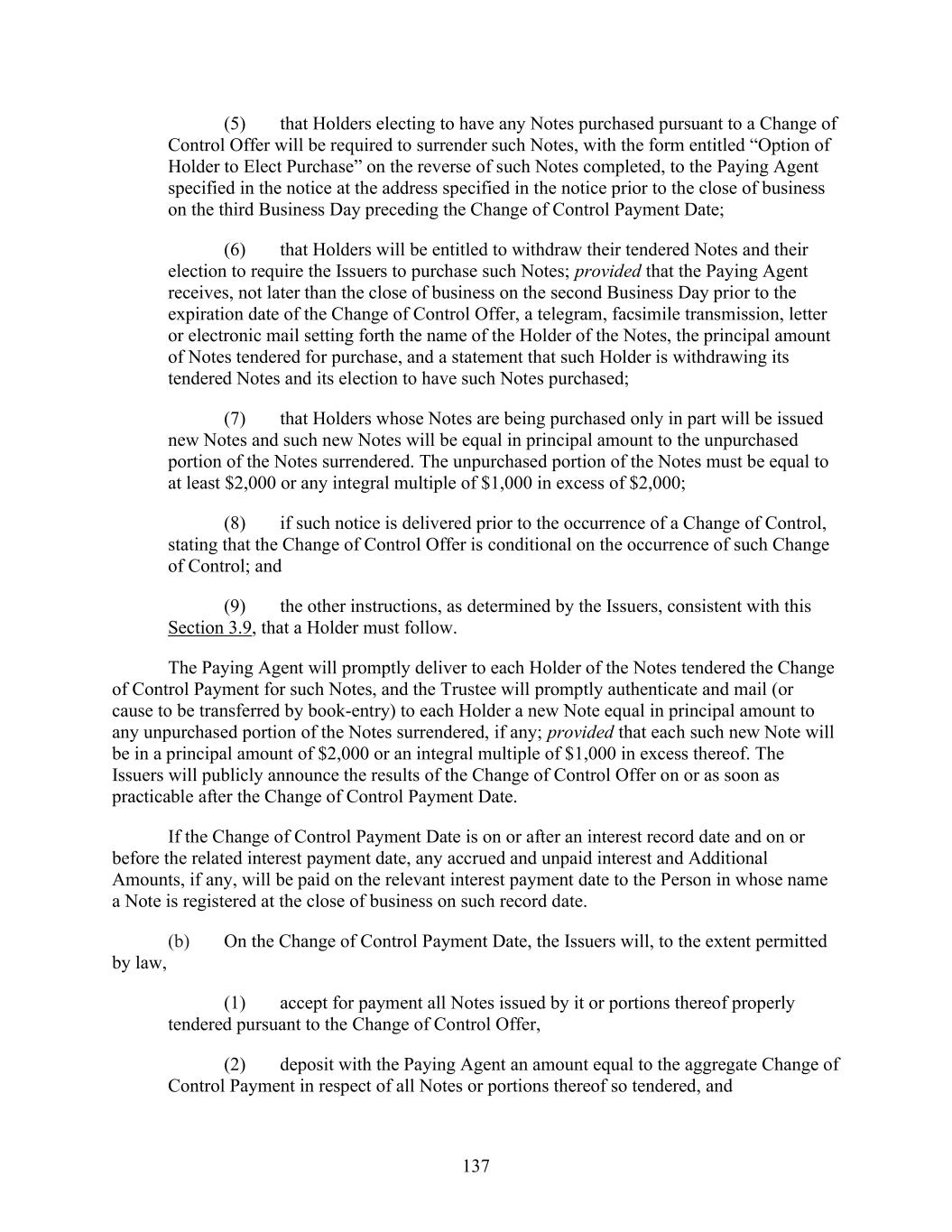
137 (5) that Holders electing to have any Notes purchased pursuant to a Change of Control Offer will be required to surrender such Notes, with the form entitled “Option of Holder to Elect Purchase” on the reverse of such Notes completed, to the Paying Agent specified in the notice at the address specified in the notice prior to the close of business on the third Business Day preceding the Change of Control Payment Date; (6) that Holders will be entitled to withdraw their tendered Notes and their election to require the Issuers to purchase such Notes; provided that the Paying Agent receives, not later than the close of business on the second Business Day prior to the expiration date of the Change of Control Offer, a telegram, facsimile transmission, letter or electronic mail setting forth the name of the Holder of the Notes, the principal amount of Notes tendered for purchase, and a statement that such Holder is withdrawing its tendered Notes and its election to have such Notes purchased; (7) that Holders whose Notes are being purchased only in part will be issued new Notes and such new Notes will be equal in principal amount to the unpurchased portion of the Notes surrendered. The unpurchased portion of the Notes must be equal to at least $2,000 or any integral multiple of $1,000 in excess of $2,000; (8) if such notice is delivered prior to the occurrence of a Change of Control, stating that the Change of Control Offer is conditional on the occurrence of such Change of Control; and (9) the other instructions, as determined by the Issuers, consistent with this Section 3.9, that a Holder must follow. The Paying Agent will promptly deliver to each Holder of the Notes tendered the Change of Control Payment for such Notes, and the Trustee will promptly authenticate and mail (or cause to be transferred by book-entry) to each Holder a new Note equal in principal amount to any unpurchased portion of the Notes surrendered, if any; provided that each such new Note will be in a principal amount of $2,000 or an integral multiple of $1,000 in excess thereof. The Issuers will publicly announce the results of the Change of Control Offer on or as soon as practicable after the Change of Control Payment Date. If the Change of Control Payment Date is on or after an interest record date and on or before the related interest payment date, any accrued and unpaid interest and Additional Amounts, if any, will be paid on the relevant interest payment date to the Person in whose name a Note is registered at the close of business on such record date. (b) On the Change of Control Payment Date, the Issuers will, to the extent permitted by law, (1) accept for payment all Notes issued by it or portions thereof properly tendered pursuant to the Change of Control Offer, (2) deposit with the Paying Agent an amount equal to the aggregate Change of Control Payment in respect of all Notes or portions thereof so tendered, and
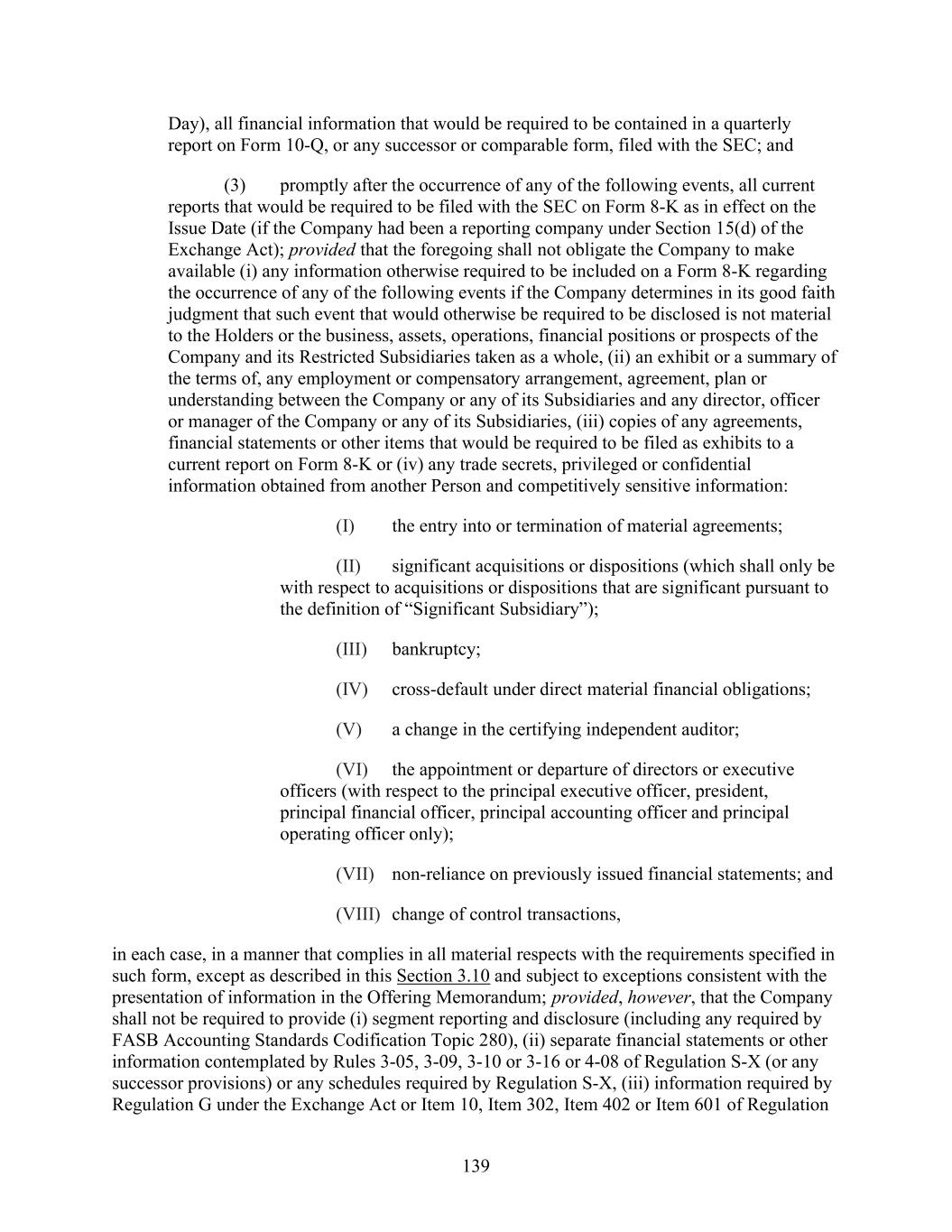
139 Day), all financial information that would be required to be contained in a quarterly report on Form 10-Q, or any successor or comparable form, filed with the SEC; and (3) promptly after the occurrence of any of the following events, all current reports that would be required to be filed with the SEC on Form 8-K as in effect on the Issue Date (if the Company had been a reporting company under Section 15(d) of the Exchange Act); provided that the foregoing shall not obligate the Company to make available (i) any information otherwise required to be included on a Form 8-K regarding the occurrence of any of the following events if the Company determines in its good faith judgment that such event that would otherwise be required to be disclosed is not material to the Holders or the business, assets, operations, financial positions or prospects of the Company and its Restricted Subsidiaries taken as a whole, (ii) an exhibit or a summary of the terms of, any employment or compensatory arrangement, agreement, plan or understanding between the Company or any of its Subsidiaries and any director, officer or manager of the Company or any of its Subsidiaries, (iii) copies of any agreements, financial statements or other items that would be required to be filed as exhibits to a current report on Form 8-K or (iv) any trade secrets, privileged or confidential information obtained from another Person and competitively sensitive information: (I) the entry into or termination of material agreements; (II) significant acquisitions or dispositions (which shall only be with respect to acquisitions or dispositions that are significant pursuant to the definition of “Significant Subsidiary”); (III) bankruptcy; (IV) cross-default under direct material financial obligations; (V) a change in the certifying independent auditor; (VI) the appointment or departure of directors or executive officers (with respect to the principal executive officer, president, principal financial officer, principal accounting officer and principal operating officer only); (VII) non-reliance on previously issued financial statements; and (VIII) change of control transactions, in each case, in a manner that complies in all material respects with the requirements specified in such form, except as described in this Section 3.10 and subject to exceptions consistent with the presentation of information in the Offering Memorandum; provided, however, that the Company shall not be required to provide (i) segment reporting and disclosure (including any required by FASB Accounting Standards Codification Topic 280), (ii) separate financial statements or other information contemplated by Rules 3-05, 3-09, 3-10 or 3-16 or 4-08 of Regulation S-X (or any successor provisions) or any schedules required by Regulation S-X, (iii) information required by Regulation G under the Exchange Act or Item 10, Item 302, Item 402 or Item 601 of Regulation
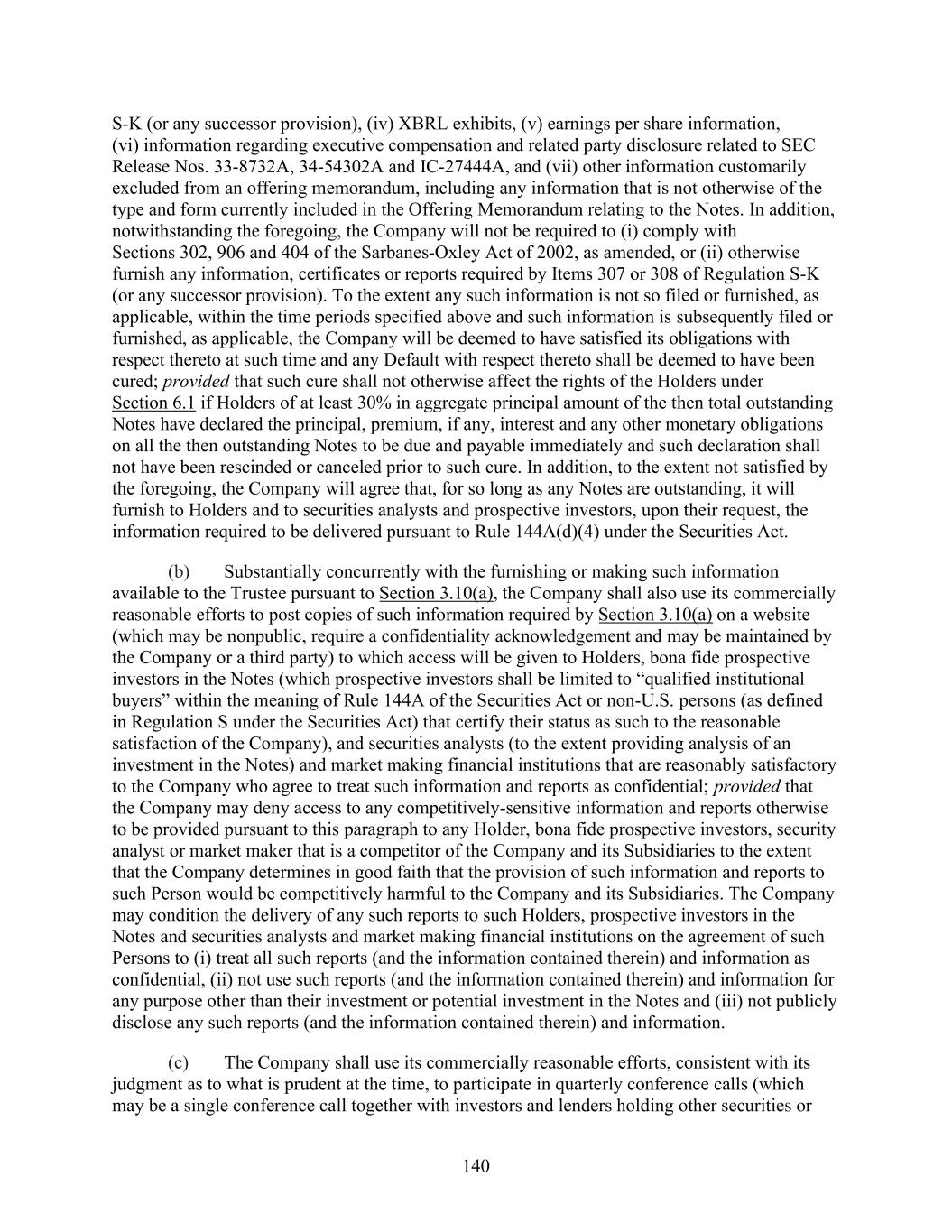
140 S-K (or any successor provision), (iv) XBRL exhibits, (v) earnings per share information, (vi) information regarding executive compensation and related party disclosure related to SEC Release Nos. 33-8732A, 34-54302A and IC-27444A, and (vii) other information customarily excluded from an offering memorandum, including any information that is not otherwise of the type and form currently included in the Offering Memorandum relating to the Notes. In addition, notwithstanding the foregoing, the Company will not be required to (i) comply with Sections 302, 906 and 404 of the Xxxxxxxx-Xxxxx Act of 2002, as amended, or (ii) otherwise furnish any information, certificates or reports required by Items 307 or 308 of Regulation S-K (or any successor provision). To the extent any such information is not so filed or furnished, as applicable, within the time periods specified above and such information is subsequently filed or furnished, as applicable, the Company will be deemed to have satisfied its obligations with respect thereto at such time and any Default with respect thereto shall be deemed to have been cured; provided that such cure shall not otherwise affect the rights of the Holders under Section 6.1 if Holders of at least 30% in aggregate principal amount of the then total outstanding Notes have declared the principal, premium, if any, interest and any other monetary obligations on all the then outstanding Notes to be due and payable immediately and such declaration shall not have been rescinded or canceled prior to such cure. In addition, to the extent not satisfied by the foregoing, the Company will agree that, for so long as any Notes are outstanding, it will furnish to Holders and to securities analysts and prospective investors, upon their request, the information required to be delivered pursuant to Rule 144A(d)(4) under the Securities Act. (b) Substantially concurrently with the furnishing or making such information available to the Trustee pursuant to Section 3.10(a), the Company shall also use its commercially reasonable efforts to post copies of such information required by Section 3.10(a) on a website (which may be nonpublic, require a confidentiality acknowledgement and may be maintained by the Company or a third party) to which access will be given to Holders, bona fide prospective investors in the Notes (which prospective investors shall be limited to “qualified institutional buyers” within the meaning of Rule 144A of the Securities Act or non-U.S. persons (as defined in Regulation S under the Securities Act) that certify their status as such to the reasonable satisfaction of the Company), and securities analysts (to the extent providing analysis of an investment in the Notes) and market making financial institutions that are reasonably satisfactory to the Company who agree to treat such information and reports as confidential; provided that the Company may deny access to any competitively-sensitive information and reports otherwise to be provided pursuant to this paragraph to any Holder, bona fide prospective investors, security analyst or market maker that is a competitor of the Company and its Subsidiaries to the extent that the Company determines in good faith that the provision of such information and reports to such Person would be competitively harmful to the Company and its Subsidiaries. The Company may condition the delivery of any such reports to such Holders, prospective investors in the Notes and securities analysts and market making financial institutions on the agreement of such Persons to (i) treat all such reports (and the information contained therein) and information as confidential, (ii) not use such reports (and the information contained therein) and information for any purpose other than their investment or potential investment in the Notes and (iii) not publicly disclose any such reports (and the information contained therein) and information. (c) The Company shall use its commercially reasonable efforts, consistent with its judgment as to what is prudent at the time, to participate in quarterly conference calls (which may be a single conference call together with investors and lenders holding other securities or
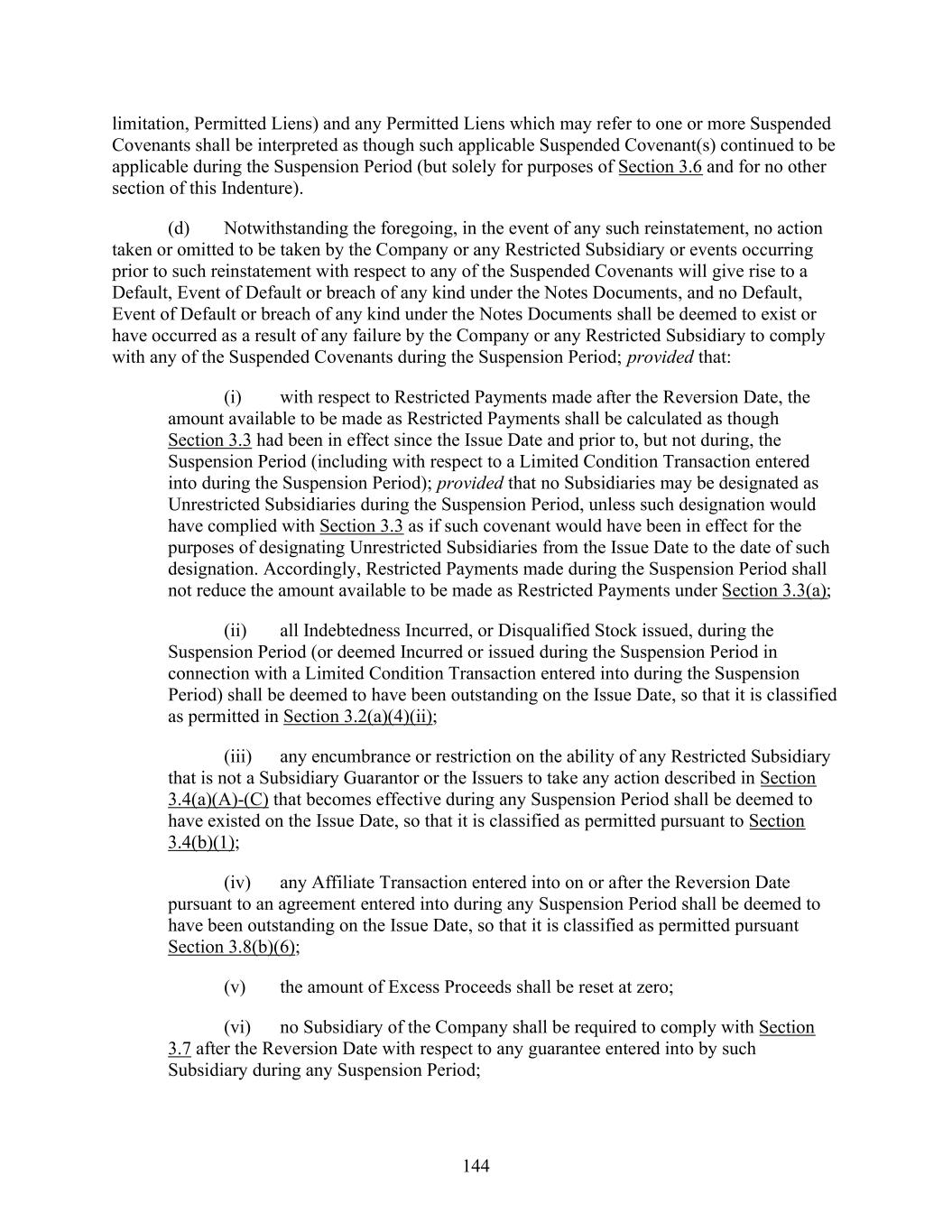
144 limitation, Permitted Liens) and any Permitted Liens which may refer to one or more Suspended Covenants shall be interpreted as though such applicable Suspended Covenant(s) continued to be applicable during the Suspension Period (but solely for purposes of Section 3.6 and for no other section of this Indenture). (d) Notwithstanding the foregoing, in the event of any such reinstatement, no action taken or omitted to be taken by the Company or any Restricted Subsidiary or events occurring prior to such reinstatement with respect to any of the Suspended Covenants will give rise to a Default, Event of Default or breach of any kind under the Notes Documents, and no Default, Event of Default or breach of any kind under the Notes Documents shall be deemed to exist or have occurred as a result of any failure by the Company or any Restricted Subsidiary to comply with any of the Suspended Covenants during the Suspension Period; provided that: (i) with respect to Restricted Payments made after the Reversion Date, the amount available to be made as Restricted Payments shall be calculated as though Section 3.3 had been in effect since the Issue Date and prior to, but not during, the Suspension Period (including with respect to a Limited Condition Transaction entered into during the Suspension Period); provided that no Subsidiaries may be designated as Unrestricted Subsidiaries during the Suspension Period, unless such designation would have complied with Section 3.3 as if such covenant would have been in effect for the purposes of designating Unrestricted Subsidiaries from the Issue Date to the date of such designation. Accordingly, Restricted Payments made during the Suspension Period shall not reduce the amount available to be made as Restricted Payments under Section 3.3(a); (ii) all Indebtedness Incurred, or Disqualified Stock issued, during the Suspension Period (or deemed Incurred or issued during the Suspension Period in connection with a Limited Condition Transaction entered into during the Suspension Period) shall be deemed to have been outstanding on the Issue Date, so that it is classified as permitted in Section 3.2(a)(4)(ii); (iii) any encumbrance or restriction on the ability of any Restricted Subsidiary that is not a Subsidiary Guarantor or the Issuers to take any action described in Section 3.4(a)(A)-(C) that becomes effective during any Suspension Period shall be deemed to have existed on the Issue Date, so that it is classified as permitted pursuant to Section 3.4(b)(1); (iv) any Affiliate Transaction entered into on or after the Reversion Date pursuant to an agreement entered into during any Suspension Period shall be deemed to have been outstanding on the Issue Date, so that it is classified as permitted pursuant Section 3.8(b)(6); (v) the amount of Excess Proceeds shall be reset at zero; (vi) no Subsidiary of the Company shall be required to comply with Section 3.7 after the Reversion Date with respect to any guarantee entered into by such Subsidiary during any Suspension Period;
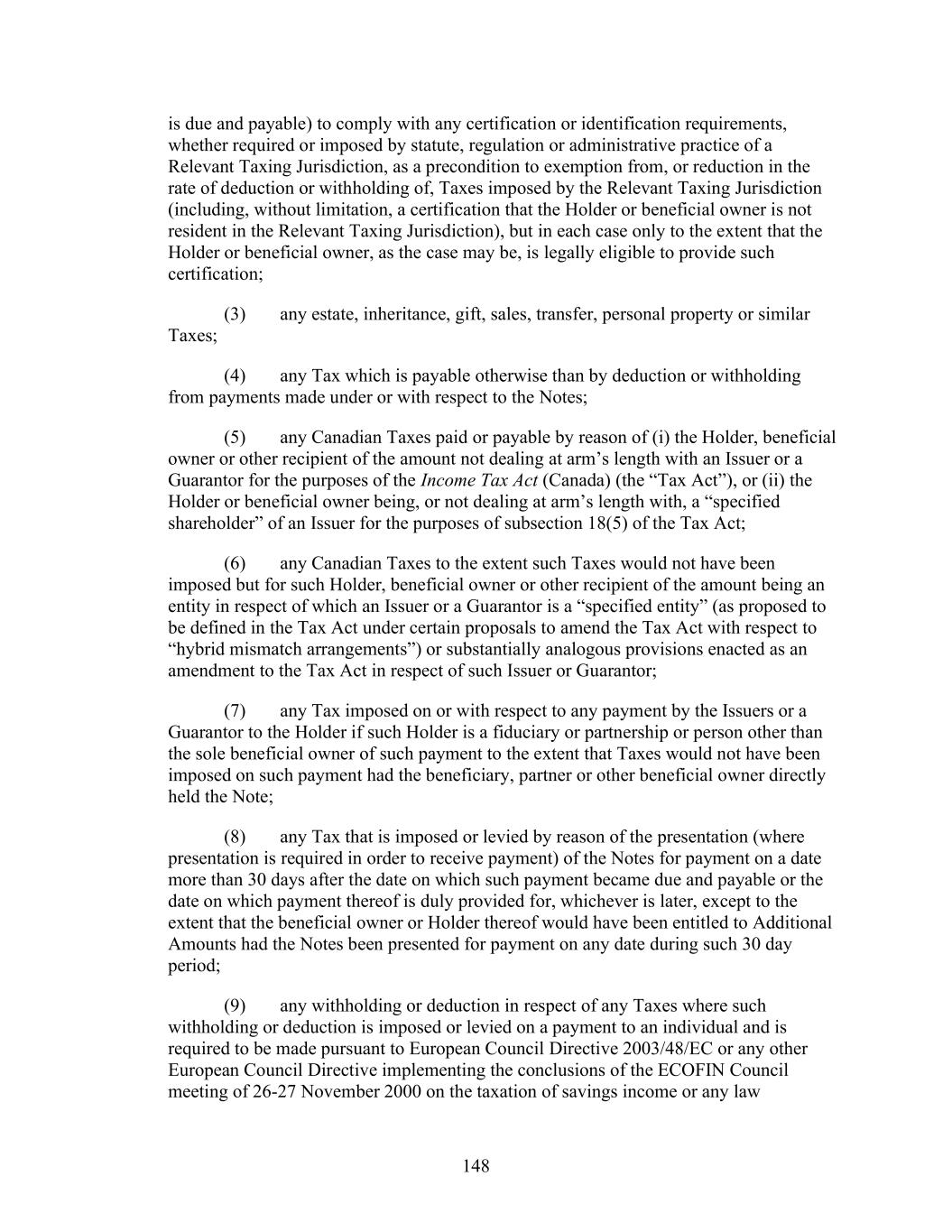
148 is due and payable) to comply with any certification or identification requirements, whether required or imposed by statute, regulation or administrative practice of a Relevant Taxing Jurisdiction, as a precondition to exemption from, or reduction in the rate of deduction or withholding of, Taxes imposed by the Relevant Taxing Jurisdiction (including, without limitation, a certification that the Holder or beneficial owner is not resident in the Relevant Taxing Jurisdiction), but in each case only to the extent that the Holder or beneficial owner, as the case may be, is legally eligible to provide such certification; (3) any estate, inheritance, gift, sales, transfer, personal property or similar Taxes; (4) any Tax which is payable otherwise than by deduction or withholding from payments made under or with respect to the Notes; (5) any Canadian Taxes paid or payable by reason of (i) the Holder, beneficial owner or other recipient of the amount not dealing at arm’s length with an Issuer or a Guarantor for the purposes of the Income Tax Act (Canada) (the “Tax Act”), or (ii) the Holder or beneficial owner being, or not dealing at arm’s length with, a “specified shareholder” of an Issuer for the purposes of subsection 18(5) of the Tax Act; (6) any Canadian Taxes to the extent such Taxes would not have been imposed but for such Holder, beneficial owner or other recipient of the amount being an entity in respect of which an Issuer or a Guarantor is a “specified entity” (as proposed to be defined in the Tax Act under certain proposals to amend the Tax Act with respect to “hybrid mismatch arrangements”) or substantially analogous provisions enacted as an amendment to the Tax Act in respect of such Issuer or Guarantor; (7) any Tax imposed on or with respect to any payment by the Issuers or a Guarantor to the Holder if such Holder is a fiduciary or partnership or person other than the sole beneficial owner of such payment to the extent that Taxes would not have been imposed on such payment had the beneficiary, partner or other beneficial owner directly held the Note; (8) any Tax that is imposed or levied by reason of the presentation (where presentation is required in order to receive payment) of the Notes for payment on a date more than 30 days after the date on which such payment became due and payable or the date on which payment thereof is duly provided for, whichever is later, except to the extent that the beneficial owner or Holder thereof would have been entitled to Additional Amounts had the Notes been presented for payment on any date during such 30 day period; (9) any withholding or deduction in respect of any Taxes where such withholding or deduction is imposed or levied on a payment to an individual and is required to be made pursuant to European Council Directive 2003/48/EC or any other European Council Directive implementing the conclusions of the ECOFIN Council meeting of 26-27 November 2000 on the taxation of savings income or any law
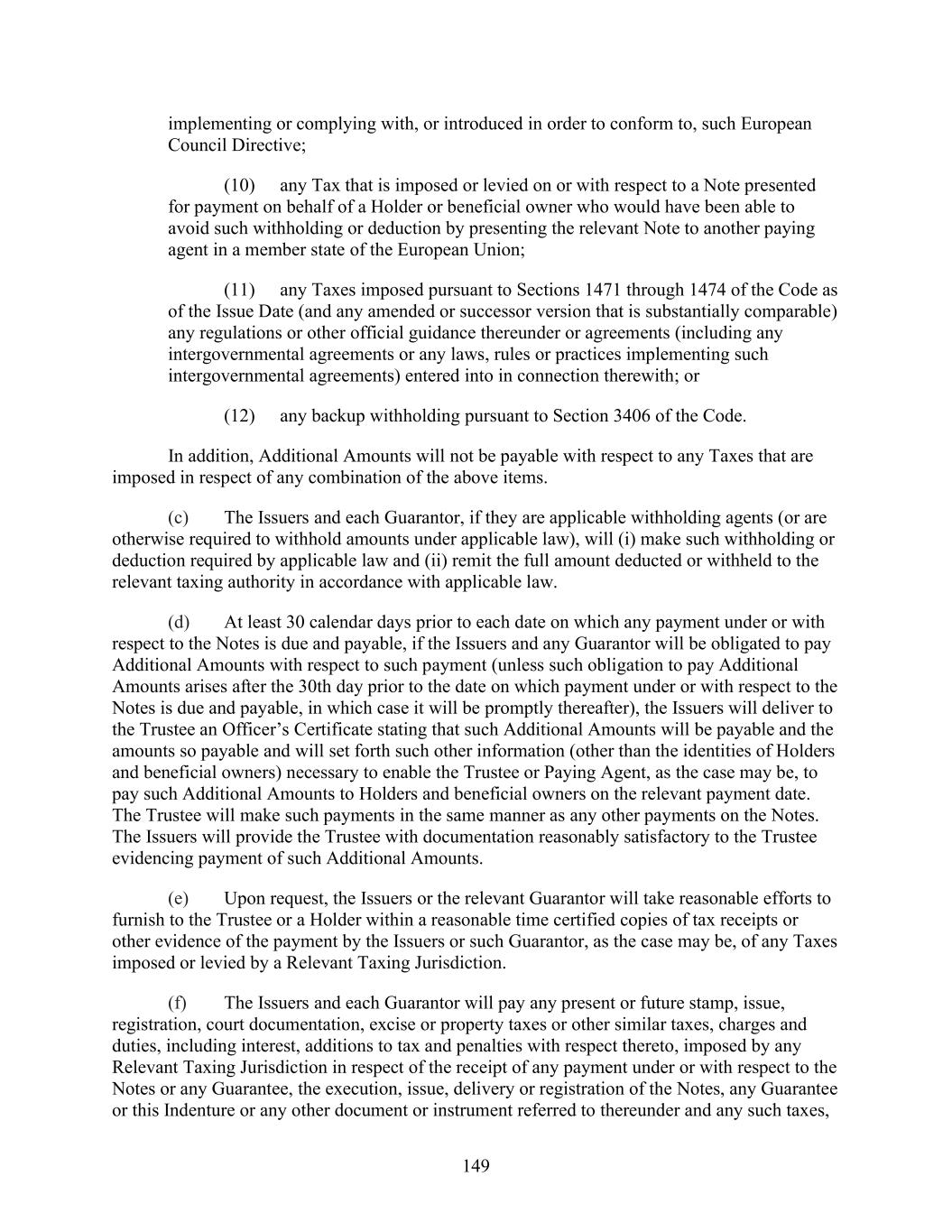
149 implementing or complying with, or introduced in order to conform to, such European Council Directive; (10) any Tax that is imposed or levied on or with respect to a Note presented for payment on behalf of a Holder or beneficial owner who would have been able to avoid such withholding or deduction by presenting the relevant Note to another paying agent in a member state of the European Union; (11) any Taxes imposed pursuant to Sections 1471 through 1474 of the Code as of the Issue Date (and any amended or successor version that is substantially comparable) any regulations or other official guidance thereunder or agreements (including any intergovernmental agreements or any laws, rules or practices implementing such intergovernmental agreements) entered into in connection therewith; or (12) any backup withholding pursuant to Section 3406 of the Code. In addition, Additional Amounts will not be payable with respect to any Taxes that are imposed in respect of any combination of the above items. (c) The Issuers and each Guarantor, if they are applicable withholding agents (or are otherwise required to withhold amounts under applicable law), will (i) make such withholding or deduction required by applicable law and (ii) remit the full amount deducted or withheld to the relevant taxing authority in accordance with applicable law. (d) At least 30 calendar days prior to each date on which any payment under or with respect to the Notes is due and payable, if the Issuers and any Guarantor will be obligated to pay Additional Amounts with respect to such payment (unless such obligation to pay Additional Amounts arises after the 30th day prior to the date on which payment under or with respect to the Notes is due and payable, in which case it will be promptly thereafter), the Issuers will deliver to the Trustee an Officer’s Certificate stating that such Additional Amounts will be payable and the amounts so payable and will set forth such other information (other than the identities of Holders and beneficial owners) necessary to enable the Trustee or Paying Agent, as the case may be, to pay such Additional Amounts to Holders and beneficial owners on the relevant payment date. The Trustee will make such payments in the same manner as any other payments on the Notes. The Issuers will provide the Trustee with documentation reasonably satisfactory to the Trustee evidencing payment of such Additional Amounts. (e) Upon request, the Issuers or the relevant Guarantor will take reasonable efforts to furnish to the Trustee or a Holder within a reasonable time certified copies of tax receipts or other evidence of the payment by the Issuers or such Guarantor, as the case may be, of any Taxes imposed or levied by a Relevant Taxing Jurisdiction. (f) The Issuers and each Guarantor will pay any present or future stamp, issue, registration, court documentation, excise or property taxes or other similar taxes, charges and duties, including interest, additions to tax and penalties with respect thereto, imposed by any Relevant Taxing Jurisdiction in respect of the receipt of any payment under or with respect to the Notes or any Guarantee, the execution, issue, delivery or registration of the Notes, any Guarantee or this Indenture or any other document or instrument referred to thereunder and any such taxes,
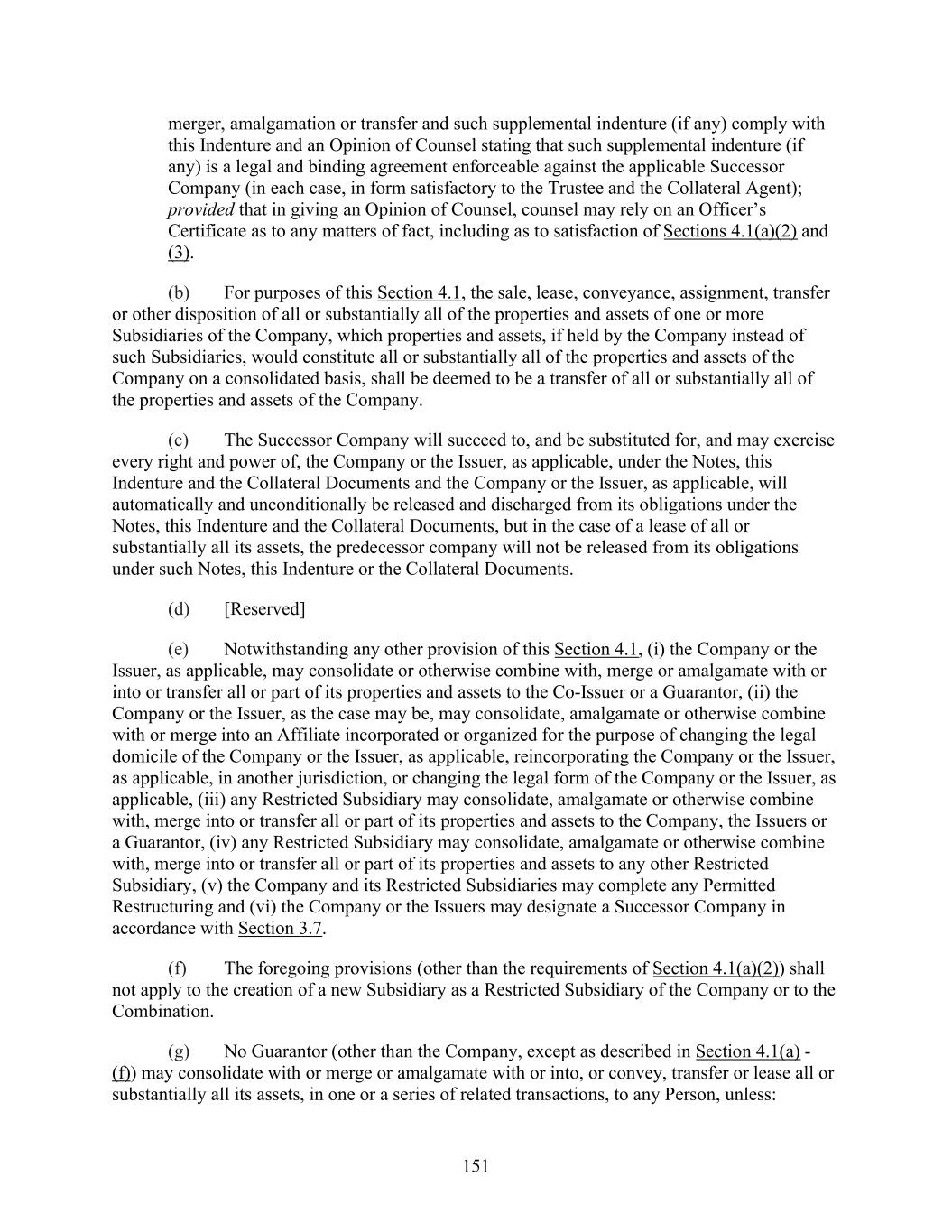
151 merger, amalgamation or transfer and such supplemental indenture (if any) comply with this Indenture and an Opinion of Counsel stating that such supplemental indenture (if any) is a legal and binding agreement enforceable against the applicable Successor Company (in each case, in form satisfactory to the Trustee and the Collateral Agent); provided that in giving an Opinion of Counsel, counsel may rely on an Officer’s Certificate as to any matters of fact, including as to satisfaction of Sections 4.1(a)(2) and (3). (b) For purposes of this Section 4.1, the sale, lease, conveyance, assignment, transfer or other disposition of all or substantially all of the properties and assets of one or more Subsidiaries of the Company, which properties and assets, if held by the Company instead of such Subsidiaries, would constitute all or substantially all of the properties and assets of the Company on a consolidated basis, shall be deemed to be a transfer of all or substantially all of the properties and assets of the Company. (c) The Successor Company will succeed to, and be substituted for, and may exercise every right and power of, the Company or the Issuer, as applicable, under the Notes, this Indenture and the Collateral Documents and the Company or the Issuer, as applicable, will automatically and unconditionally be released and discharged from its obligations under the Notes, this Indenture and the Collateral Documents, but in the case of a lease of all or substantially all its assets, the predecessor company will not be released from its obligations under such Notes, this Indenture or the Collateral Documents. (d) [Reserved] (e) Notwithstanding any other provision of this Section 4.1, (i) the Company or the Issuer, as applicable, may consolidate or otherwise combine with, merge or amalgamate with or into or transfer all or part of its properties and assets to the Co-Issuer or a Guarantor, (ii) the Company or the Issuer, as the case may be, may consolidate, amalgamate or otherwise combine with or merge into an Affiliate incorporated or organized for the purpose of changing the legal domicile of the Company or the Issuer, as applicable, reincorporating the Company or the Issuer, as applicable, in another jurisdiction, or changing the legal form of the Company or the Issuer, as applicable, (iii) any Restricted Subsidiary may consolidate, amalgamate or otherwise combine with, merge into or transfer all or part of its properties and assets to the Company, the Issuers or a Guarantor, (iv) any Restricted Subsidiary may consolidate, amalgamate or otherwise combine with, merge into or transfer all or part of its properties and assets to any other Restricted Subsidiary, (v) the Company and its Restricted Subsidiaries may complete any Permitted Restructuring and (vi) the Company or the Issuers may designate a Successor Company in accordance with Section 3.7. (f) The foregoing provisions (other than the requirements of Section 4.1(a)(2)) shall not apply to the creation of a new Subsidiary as a Restricted Subsidiary of the Company or to the Combination. (g) No Guarantor (other than the Company, except as described in Section 4.1(a) - (f)) may consolidate with or merge or amalgamate with or into, or convey, transfer or lease all or substantially all its assets, in one or a series of related transactions, to any Person, unless:
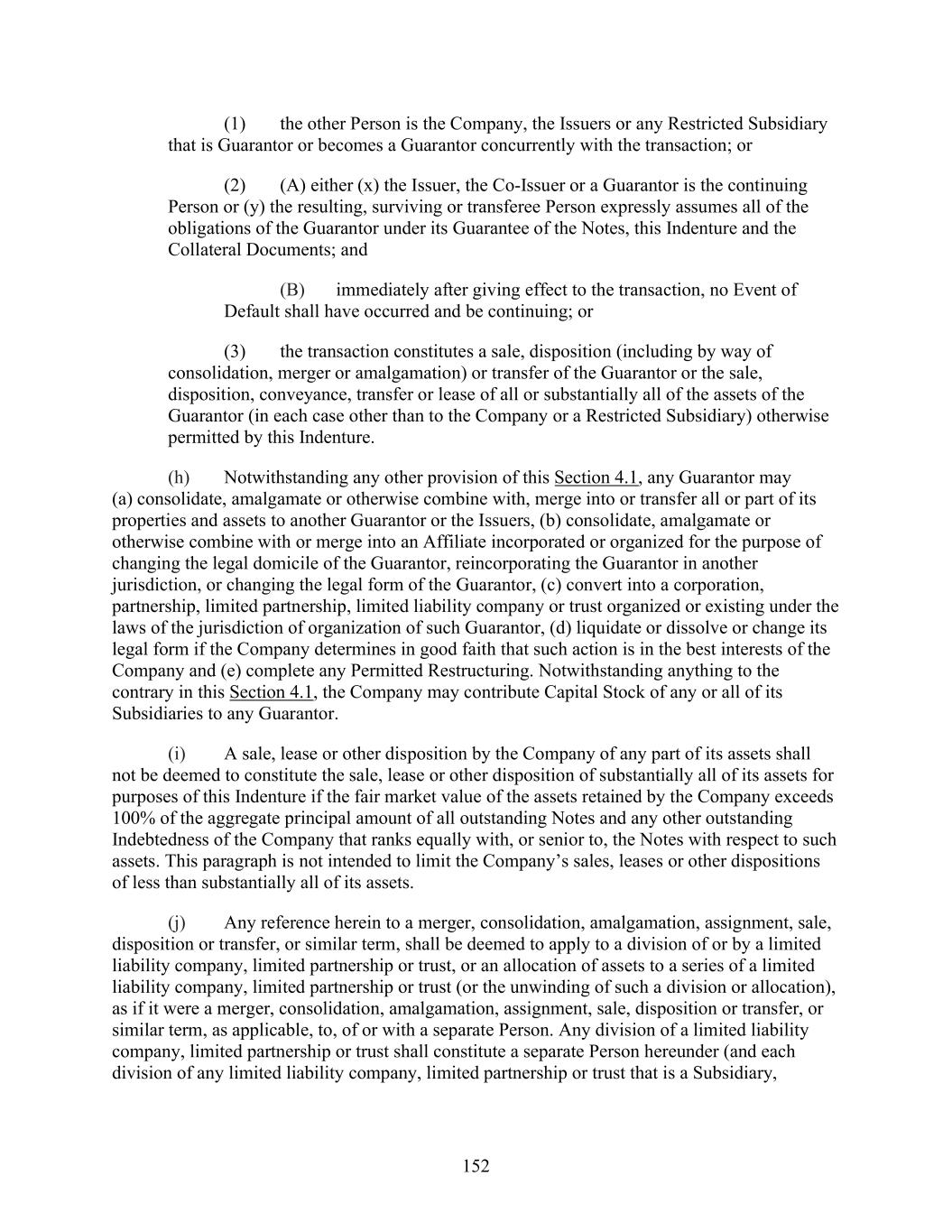
152 (1) the other Person is the Company, the Issuers or any Restricted Subsidiary that is Guarantor or becomes a Guarantor concurrently with the transaction; or (2) (A) either (x) the Issuer, the Co-Issuer or a Guarantor is the continuing Person or (y) the resulting, surviving or transferee Person expressly assumes all of the obligations of the Guarantor under its Guarantee of the Notes, this Indenture and the Collateral Documents; and (B) immediately after giving effect to the transaction, no Event of Default shall have occurred and be continuing; or (3) the transaction constitutes a sale, disposition (including by way of consolidation, merger or amalgamation) or transfer of the Guarantor or the sale, disposition, conveyance, transfer or lease of all or substantially all of the assets of the Guarantor (in each case other than to the Company or a Restricted Subsidiary) otherwise permitted by this Indenture. (h) Notwithstanding any other provision of this Section 4.1, any Guarantor may (a) consolidate, amalgamate or otherwise combine with, merge into or transfer all or part of its properties and assets to another Guarantor or the Issuers, (b) consolidate, amalgamate or otherwise combine with or merge into an Affiliate incorporated or organized for the purpose of changing the legal domicile of the Guarantor, reincorporating the Guarantor in another jurisdiction, or changing the legal form of the Guarantor, (c) convert into a corporation, partnership, limited partnership, limited liability company or trust organized or existing under the laws of the jurisdiction of organization of such Guarantor, (d) liquidate or dissolve or change its legal form if the Company determines in good faith that such action is in the best interests of the Company and (e) complete any Permitted Restructuring. Notwithstanding anything to the contrary in this Section 4.1, the Company may contribute Capital Stock of any or all of its Subsidiaries to any Guarantor. (i) A sale, lease or other disposition by the Company of any part of its assets shall not be deemed to constitute the sale, lease or other disposition of substantially all of its assets for purposes of this Indenture if the fair market value of the assets retained by the Company exceeds 100% of the aggregate principal amount of all outstanding Notes and any other outstanding Indebtedness of the Company that ranks equally with, or senior to, the Notes with respect to such assets. This paragraph is not intended to limit the Company’s sales, leases or other dispositions of less than substantially all of its assets. (j) Any reference herein to a merger, consolidation, amalgamation, assignment, sale, disposition or transfer, or similar term, shall be deemed to apply to a division of or by a limited liability company, limited partnership or trust, or an allocation of assets to a series of a limited liability company, limited partnership or trust (or the unwinding of such a division or allocation), as if it were a merger, consolidation, amalgamation, assignment, sale, disposition or transfer, or similar term, as applicable, to, of or with a separate Person. Any division of a limited liability company, limited partnership or trust shall constitute a separate Person hereunder (and each division of any limited liability company, limited partnership or trust that is a Subsidiary,
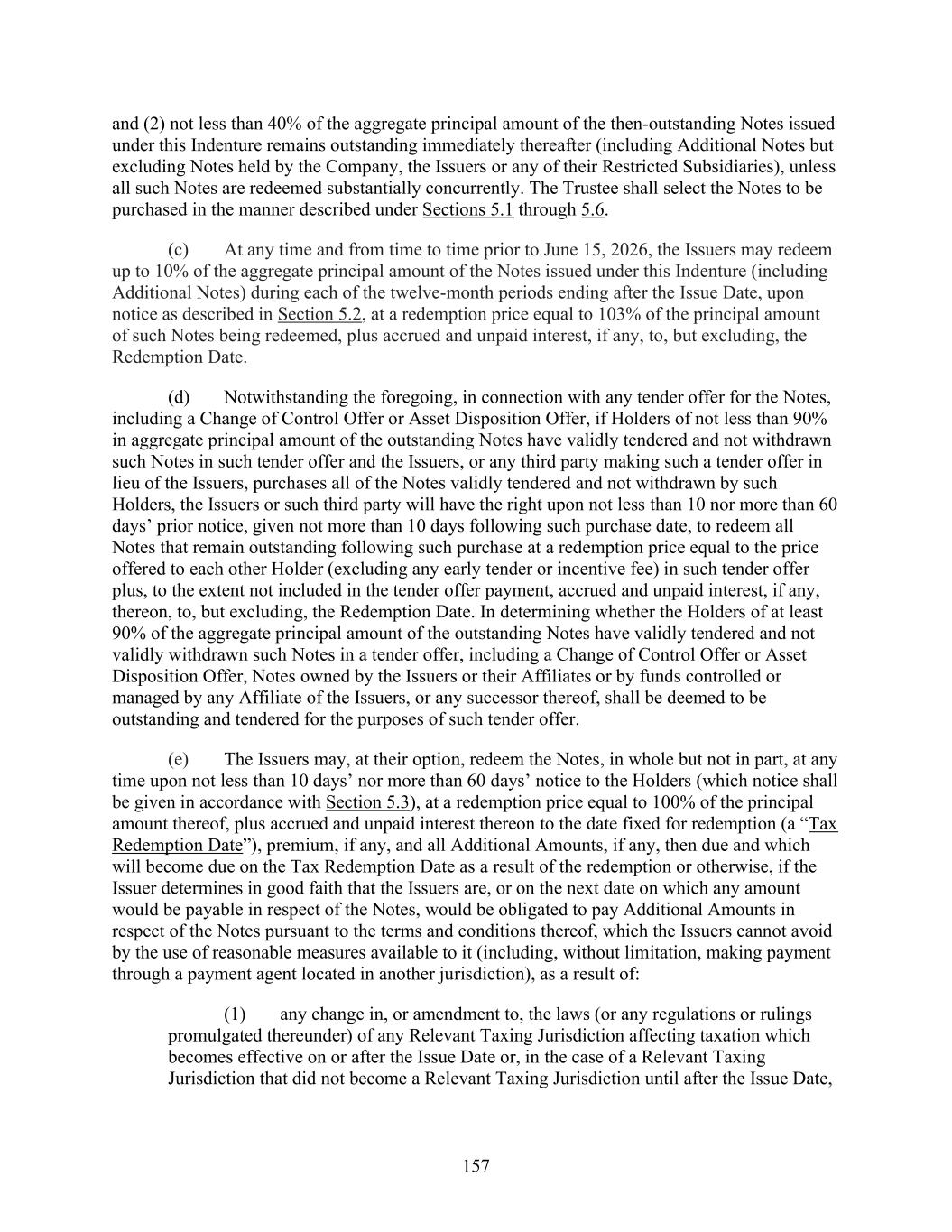
157 and (2) not less than 40% of the aggregate principal amount of the then-outstanding Notes issued under this Indenture remains outstanding immediately thereafter (including Additional Notes but excluding Notes held by the Company, the Issuers or any of their Restricted Subsidiaries), unless all such Notes are redeemed substantially concurrently. The Trustee shall select the Notes to be purchased in the manner described under Sections 5.1 through 5.6. (c) At any time and from time to time prior to June 15, 2026, the Issuers may redeem up to 10% of the aggregate principal amount of the Notes issued under this Indenture (including Additional Notes) during each of the twelve-month periods ending after the Issue Date, upon notice as described in Section 5.2, at a redemption price equal to 103% of the principal amount of such Notes being redeemed, plus accrued and unpaid interest, if any, to, but excluding, the Redemption Date. (d) Notwithstanding the foregoing, in connection with any tender offer for the Notes, including a Change of Control Offer or Asset Disposition Offer, if Holders of not less than 90% in aggregate principal amount of the outstanding Notes have validly tendered and not withdrawn such Notes in such tender offer and the Issuers, or any third party making such a tender offer in lieu of the Issuers, purchases all of the Notes validly tendered and not withdrawn by such Holders, the Issuers or such third party will have the right upon not less than 10 nor more than 60 days’ prior notice, given not more than 10 days following such purchase date, to redeem all Notes that remain outstanding following such purchase at a redemption price equal to the price offered to each other Holder (excluding any early tender or incentive fee) in such tender offer plus, to the extent not included in the tender offer payment, accrued and unpaid interest, if any, thereon, to, but excluding, the Redemption Date. In determining whether the Holders of at least 90% of the aggregate principal amount of the outstanding Notes have validly tendered and not validly withdrawn such Notes in a tender offer, including a Change of Control Offer or Asset Disposition Offer, Notes owned by the Issuers or their Affiliates or by funds controlled or managed by any Affiliate of the Issuers, or any successor thereof, shall be deemed to be outstanding and tendered for the purposes of such tender offer. (e) The Issuers may, at their option, redeem the Notes, in whole but not in part, at any time upon not less than 10 days’ nor more than 60 days’ notice to the Holders (which notice shall be given in accordance with Section 5.3), at a redemption price equal to 100% of the principal amount thereof, plus accrued and unpaid interest thereon to the date fixed for redemption (a “Tax Redemption Date”), premium, if any, and all Additional Amounts, if any, then due and which will become due on the Tax Redemption Date as a result of the redemption or otherwise, if the Issuer determines in good faith that the Issuers are, or on the next date on which any amount would be payable in respect of the Notes, would be obligated to pay Additional Amounts in respect of the Notes pursuant to the terms and conditions thereof, which the Issuers cannot avoid by the use of reasonable measures available to it (including, without limitation, making payment through a payment agent located in another jurisdiction), as a result of: (1) any change in, or amendment to, the laws (or any regulations or rulings promulgated thereunder) of any Relevant Taxing Jurisdiction affecting taxation which becomes effective on or after the Issue Date or, in the case of a Relevant Taxing Jurisdiction that did not become a Relevant Taxing Jurisdiction until after the Issue Date,
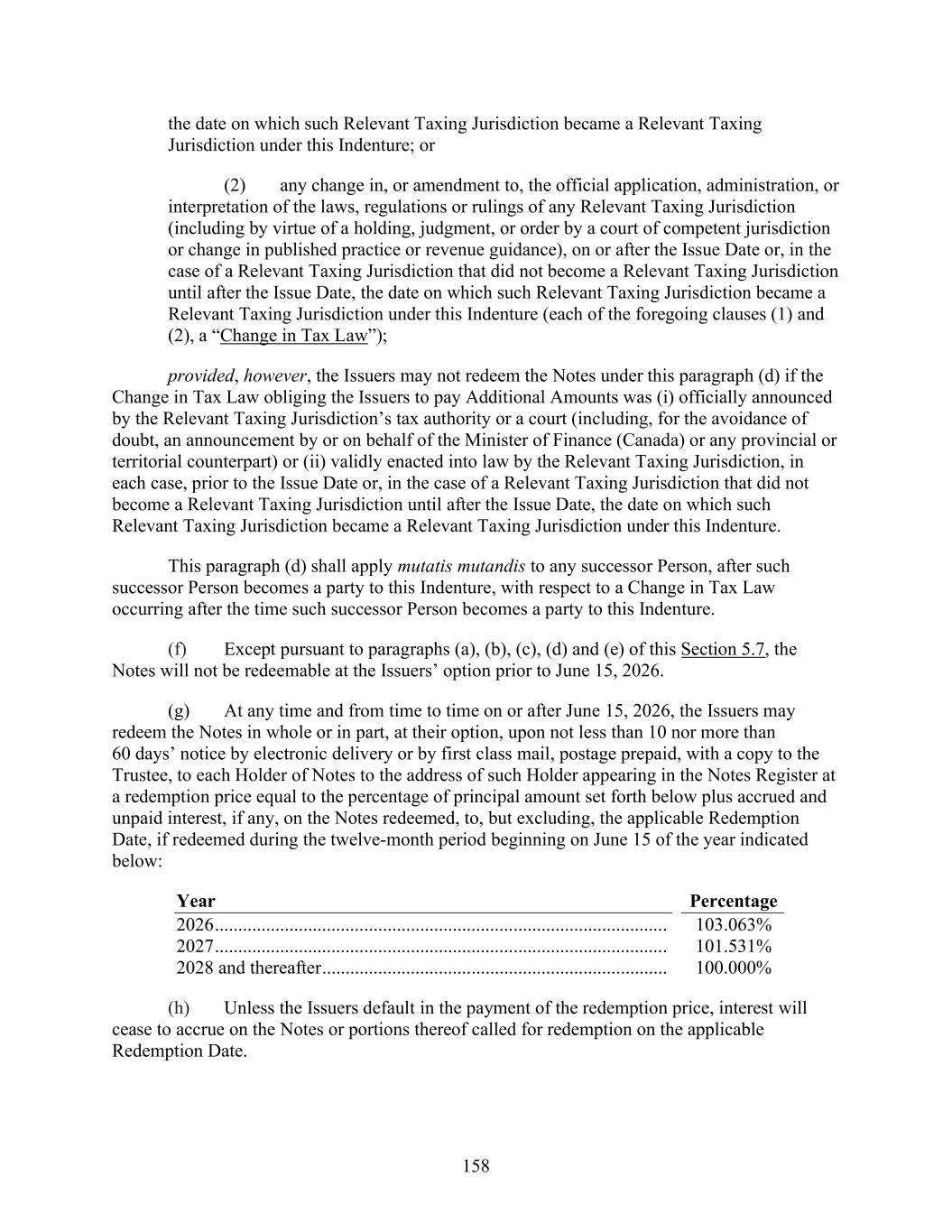
158 the date on which such Relevant Taxing Jurisdiction became a Relevant Taxing Jurisdiction under this Indenture; or (2) any change in, or amendment to, the official application, administration, or interpretation of the laws, regulations or rulings of any Relevant Taxing Jurisdiction (including by virtue of a holding, judgment, or order by a court of competent jurisdiction or change in published practice or revenue guidance), on or after the Issue Date or, in the case of a Relevant Taxing Jurisdiction that did not become a Relevant Taxing Jurisdiction until after the Issue Date, the date on which such Relevant Taxing Jurisdiction became a Relevant Taxing Jurisdiction under this Indenture (each of the foregoing clauses (1) and (2), a “Change in Tax Law”); provided, however, the Issuers may not redeem the Notes under this paragraph (d) if the Change in Tax Law obliging the Issuers to pay Additional Amounts was (i) officially announced by the Relevant Taxing Jurisdiction’s tax authority or a court (including, for the avoidance of doubt, an announcement by or on behalf of the Minister of Finance (Canada) or any provincial or territorial counterpart) or (ii) validly enacted into law by the Relevant Taxing Jurisdiction, in each case, prior to the Issue Date or, in the case of a Relevant Taxing Jurisdiction that did not become a Relevant Taxing Jurisdiction until after the Issue Date, the date on which such Relevant Taxing Jurisdiction became a Relevant Taxing Jurisdiction under this Indenture. This paragraph (d) shall apply mutatis mutandis to any successor Person, after such successor Xxxxxx becomes a party to this Indenture, with respect to a Change in Tax Law occurring after the time such successor Person becomes a party to this Indenture. (f) Except pursuant to paragraphs (a), (b), (c), (d) and (e) of this Section 5.7, the Notes will not be redeemable at the Issuers’ option prior to June 15, 2026. (g) At any time and from time to time on or after June 15, 2026, the Issuers may redeem the Notes in whole or in part, at their option, upon not less than 10 nor more than 60 days’ notice by electronic delivery or by first class mail, postage prepaid, with a copy to the Trustee, to each Holder of Notes to the address of such Holder appearing in the Notes Register at a redemption price equal to the percentage of principal amount set forth below plus accrued and unpaid interest, if any, on the Notes redeemed, to, but excluding, the applicable Redemption Date, if redeemed during the twelve-month period beginning on June 15 of the year indicated below: Year Percentage 2026 ................................................................................................. 103.063% 2027 ................................................................................................. 101.531% 2028 and thereafter .......................................................................... 100.000% (h) Unless the Issuers default in the payment of the redemption price, interest will cease to accrue on the Notes or portions thereof called for redemption on the applicable Redemption Date.
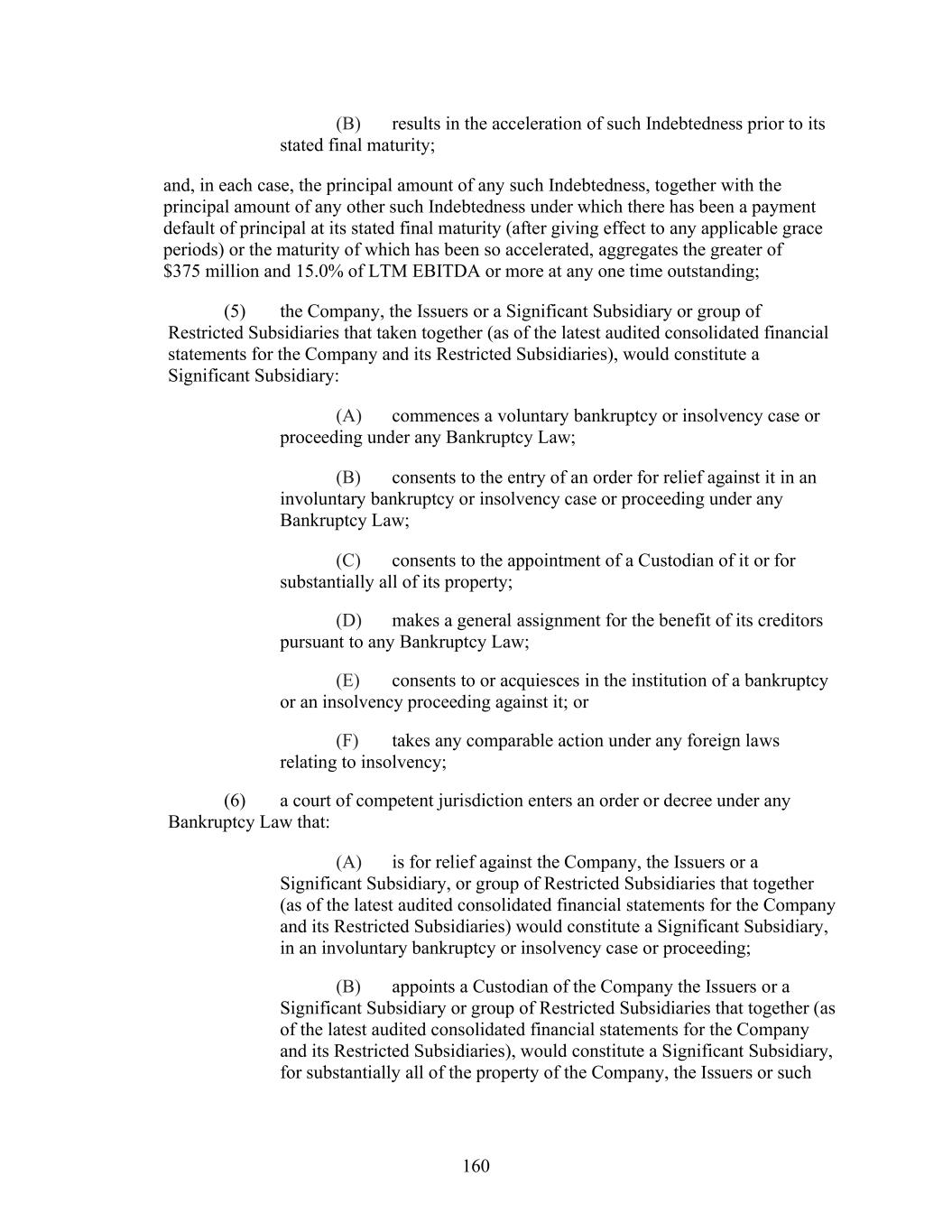
160 (B) results in the acceleration of such Indebtedness prior to its stated final maturity; and, in each case, the principal amount of any such Indebtedness, together with the principal amount of any other such Indebtedness under which there has been a payment default of principal at its stated final maturity (after giving effect to any applicable grace periods) or the maturity of which has been so accelerated, aggregates the greater of $375 million and 15.0% of LTM EBITDA or more at any one time outstanding; (5) the Company, the Issuers or a Significant Subsidiary or group of Restricted Subsidiaries that taken together (as of the latest audited consolidated financial statements for the Company and its Restricted Subsidiaries), would constitute a Significant Subsidiary: (A) commences a voluntary bankruptcy or insolvency case or proceeding under any Bankruptcy Law; (B) consents to the entry of an order for relief against it in an involuntary bankruptcy or insolvency case or proceeding under any Bankruptcy Law; (C) consents to the appointment of a Custodian of it or for substantially all of its property; (D) makes a general assignment for the benefit of its creditors pursuant to any Bankruptcy Law; (E) consents to or acquiesces in the institution of a bankruptcy or an insolvency proceeding against it; or (F) takes any comparable action under any foreign laws relating to insolvency; (6) a court of competent jurisdiction enters an order or decree under any Bankruptcy Law that: (A) is for relief against the Company, the Issuers or a Significant Subsidiary, or group of Restricted Subsidiaries that together (as of the latest audited consolidated financial statements for the Company and its Restricted Subsidiaries) would constitute a Significant Subsidiary, in an involuntary bankruptcy or insolvency case or proceeding; (B) appoints a Custodian of the Company the Issuers or a Significant Subsidiary or group of Restricted Subsidiaries that together (as of the latest audited consolidated financial statements for the Company and its Restricted Subsidiaries), would constitute a Significant Subsidiary, for substantially all of the property of the Company, the Issuers or such
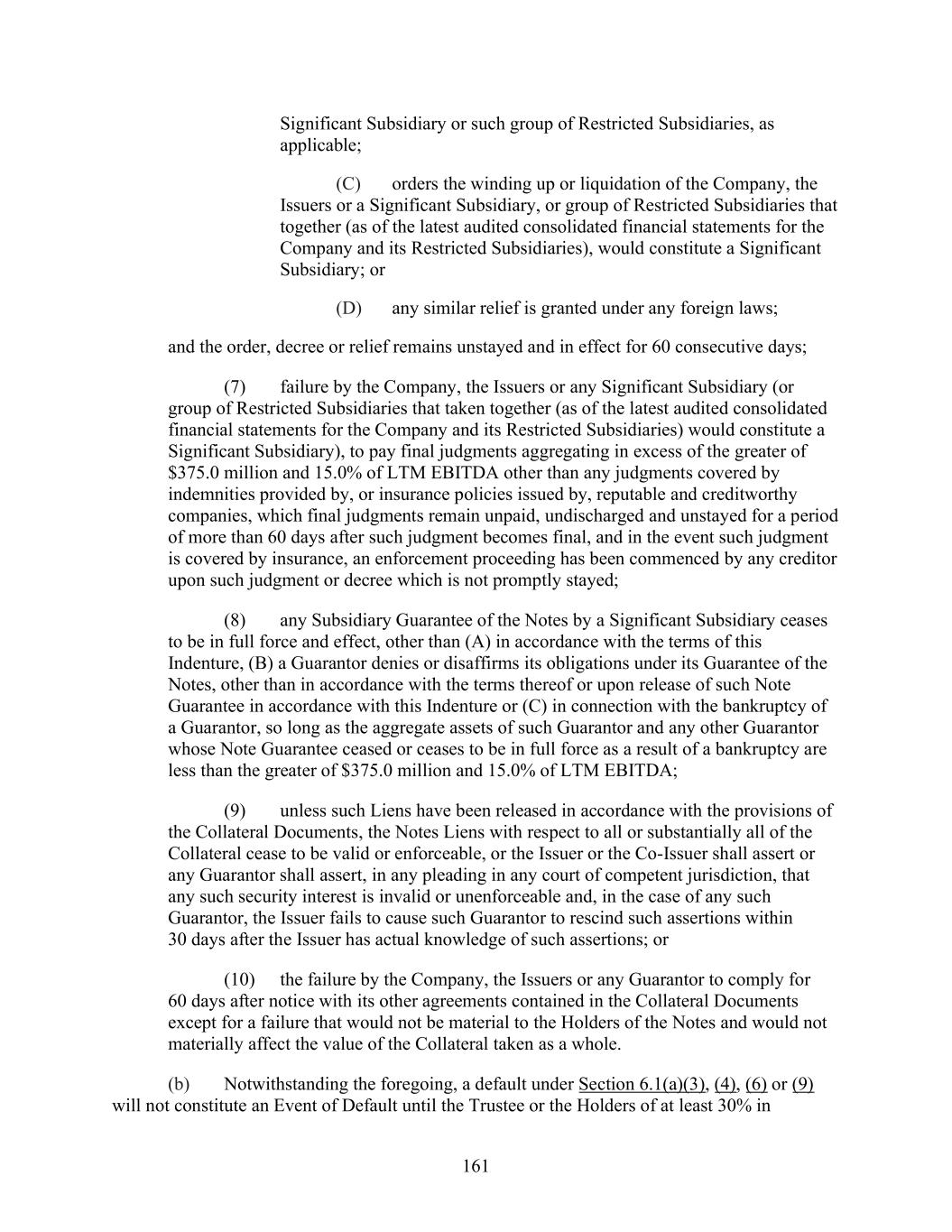
161 Significant Subsidiary or such group of Restricted Subsidiaries, as applicable; (C) orders the winding up or liquidation of the Company, the Issuers or a Significant Subsidiary, or group of Restricted Subsidiaries that together (as of the latest audited consolidated financial statements for the Company and its Restricted Subsidiaries), would constitute a Significant Subsidiary; or (D) any similar relief is granted under any foreign laws; and the order, decree or relief remains unstayed and in effect for 60 consecutive days; (7) failure by the Company, the Issuers or any Significant Subsidiary (or group of Restricted Subsidiaries that taken together (as of the latest audited consolidated financial statements for the Company and its Restricted Subsidiaries) would constitute a Significant Subsidiary), to pay final judgments aggregating in excess of the greater of $375.0 million and 15.0% of LTM EBITDA other than any judgments covered by indemnities provided by, or insurance policies issued by, reputable and creditworthy companies, which final judgments remain unpaid, undischarged and unstayed for a period of more than 60 days after such judgment becomes final, and in the event such judgment is covered by insurance, an enforcement proceeding has been commenced by any creditor upon such judgment or decree which is not promptly stayed; (8) any Subsidiary Guarantee of the Notes by a Significant Subsidiary ceases to be in full force and effect, other than (A) in accordance with the terms of this Indenture, (B) a Guarantor denies or disaffirms its obligations under its Guarantee of the Notes, other than in accordance with the terms thereof or upon release of such Note Guarantee in accordance with this Indenture or (C) in connection with the bankruptcy of a Guarantor, so long as the aggregate assets of such Guarantor and any other Guarantor whose Note Guarantee ceased or ceases to be in full force as a result of a bankruptcy are less than the greater of $375.0 million and 15.0% of LTM EBITDA; (9) unless such Liens have been released in accordance with the provisions of the Collateral Documents, the Notes Liens with respect to all or substantially all of the Collateral cease to be valid or enforceable, or the Issuer or the Co-Issuer shall assert or any Guarantor shall assert, in any pleading in any court of competent jurisdiction, that any such security interest is invalid or unenforceable and, in the case of any such Guarantor, the Issuer fails to cause such Guarantor to rescind such assertions within 30 days after the Issuer has actual knowledge of such assertions; or (10) the failure by the Company, the Issuers or any Guarantor to comply for 60 days after notice with its other agreements contained in the Collateral Documents except for a failure that would not be material to the Holders of the Notes and would not materially affect the value of the Collateral taken as a whole. (b) Notwithstanding the foregoing, a default under Section 6.1(a)(3), (4), (6) or (9) will not constitute an Event of Default until the Trustee or the Holders of at least 30% in
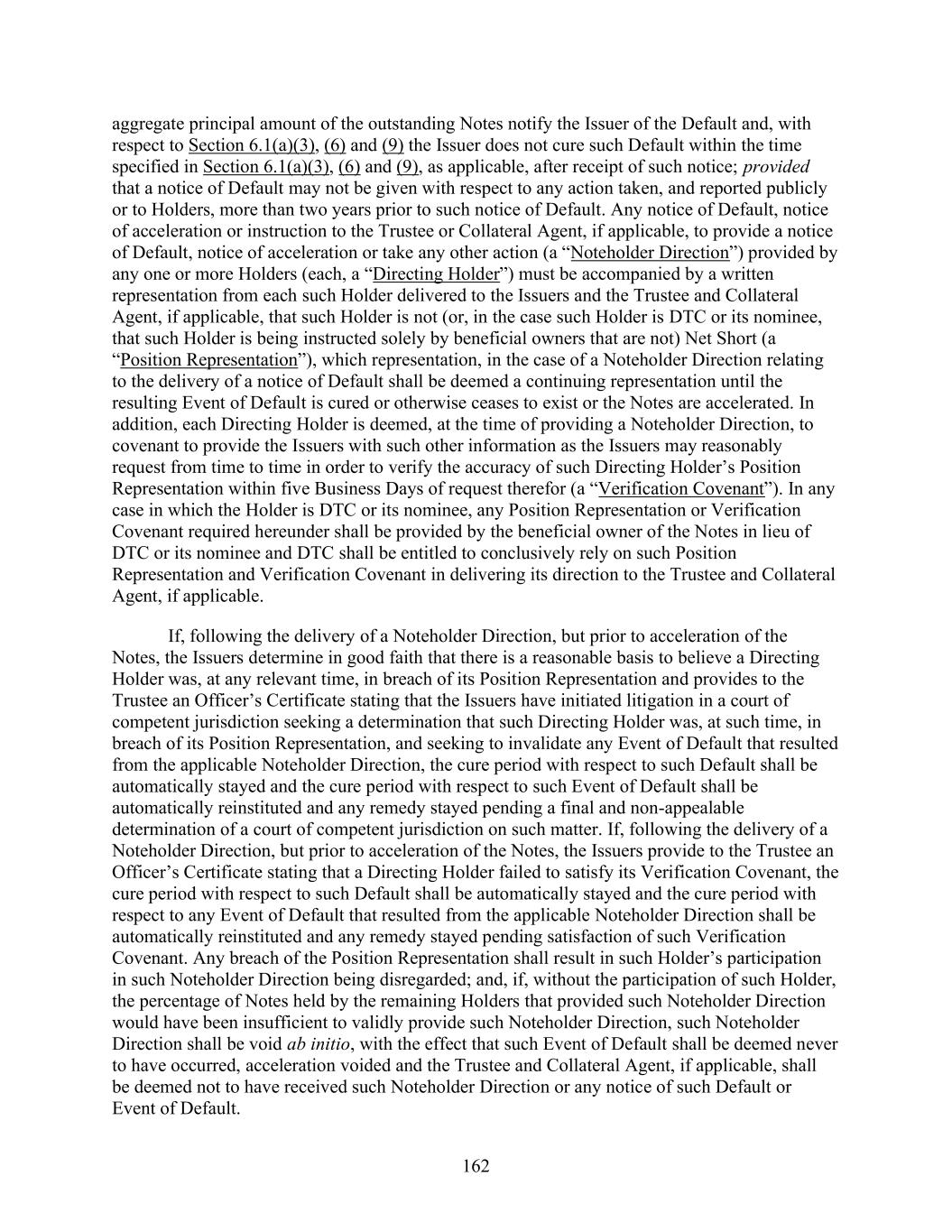
162 aggregate principal amount of the outstanding Notes notify the Issuer of the Default and, with respect to Section 6.1(a)(3), (6) and (9) the Issuer does not cure such Default within the time specified in Section 6.1(a)(3), (6) and (9), as applicable, after receipt of such notice; provided that a notice of Default may not be given with respect to any action taken, and reported publicly or to Holders, more than two years prior to such notice of Default. Any notice of Default, notice of acceleration or instruction to the Trustee or Collateral Agent, if applicable, to provide a notice of Default, notice of acceleration or take any other action (a “Noteholder Direction”) provided by any one or more Holders (each, a “Directing Holder”) must be accompanied by a written representation from each such Holder delivered to the Issuers and the Trustee and Collateral Agent, if applicable, that such Holder is not (or, in the case such Holder is DTC or its nominee, that such Holder is being instructed solely by beneficial owners that are not) Net Short (a “Position Representation”), which representation, in the case of a Noteholder Direction relating to the delivery of a notice of Default shall be deemed a continuing representation until the resulting Event of Default is cured or otherwise ceases to exist or the Notes are accelerated. In addition, each Directing Holder is deemed, at the time of providing a Noteholder Direction, to covenant to provide the Issuers with such other information as the Issuers may reasonably request from time to time in order to verify the accuracy of such Directing Holder’s Position Representation within five Business Days of request therefor (a “Verification Covenant”). In any case in which the Holder is DTC or its nominee, any Position Representation or Verification Covenant required hereunder shall be provided by the beneficial owner of the Notes in lieu of DTC or its nominee and DTC shall be entitled to conclusively rely on such Position Representation and Verification Covenant in delivering its direction to the Trustee and Collateral Agent, if applicable. If, following the delivery of a Noteholder Direction, but prior to acceleration of the Notes, the Issuers determine in good faith that there is a reasonable basis to believe a Directing Holder was, at any relevant time, in breach of its Position Representation and provides to the Trustee an Officer’s Certificate stating that the Issuers have initiated litigation in a court of competent jurisdiction seeking a determination that such Directing Holder was, at such time, in breach of its Position Representation, and seeking to invalidate any Event of Default that resulted from the applicable Noteholder Direction, the cure period with respect to such Default shall be automatically stayed and the cure period with respect to such Event of Default shall be automatically reinstituted and any remedy stayed pending a final and non-appealable determination of a court of competent jurisdiction on such matter. If, following the delivery of a Noteholder Direction, but prior to acceleration of the Notes, the Issuers provide to the Trustee an Officer’s Certificate stating that a Directing Holder failed to satisfy its Verification Covenant, the cure period with respect to such Default shall be automatically stayed and the cure period with respect to any Event of Default that resulted from the applicable Noteholder Direction shall be automatically reinstituted and any remedy stayed pending satisfaction of such Verification Covenant. Any breach of the Position Representation shall result in such Holder’s participation in such Noteholder Direction being disregarded; and, if, without the participation of such Holder, the percentage of Notes held by the remaining Holders that provided such Noteholder Direction would have been insufficient to validly provide such Noteholder Direction, such Noteholder Direction shall be void ab initio, with the effect that such Event of Default shall be deemed never to have occurred, acceleration voided and the Trustee and Collateral Agent, if applicable, shall be deemed not to have received such Noteholder Direction or any notice of such Default or Event of Default.
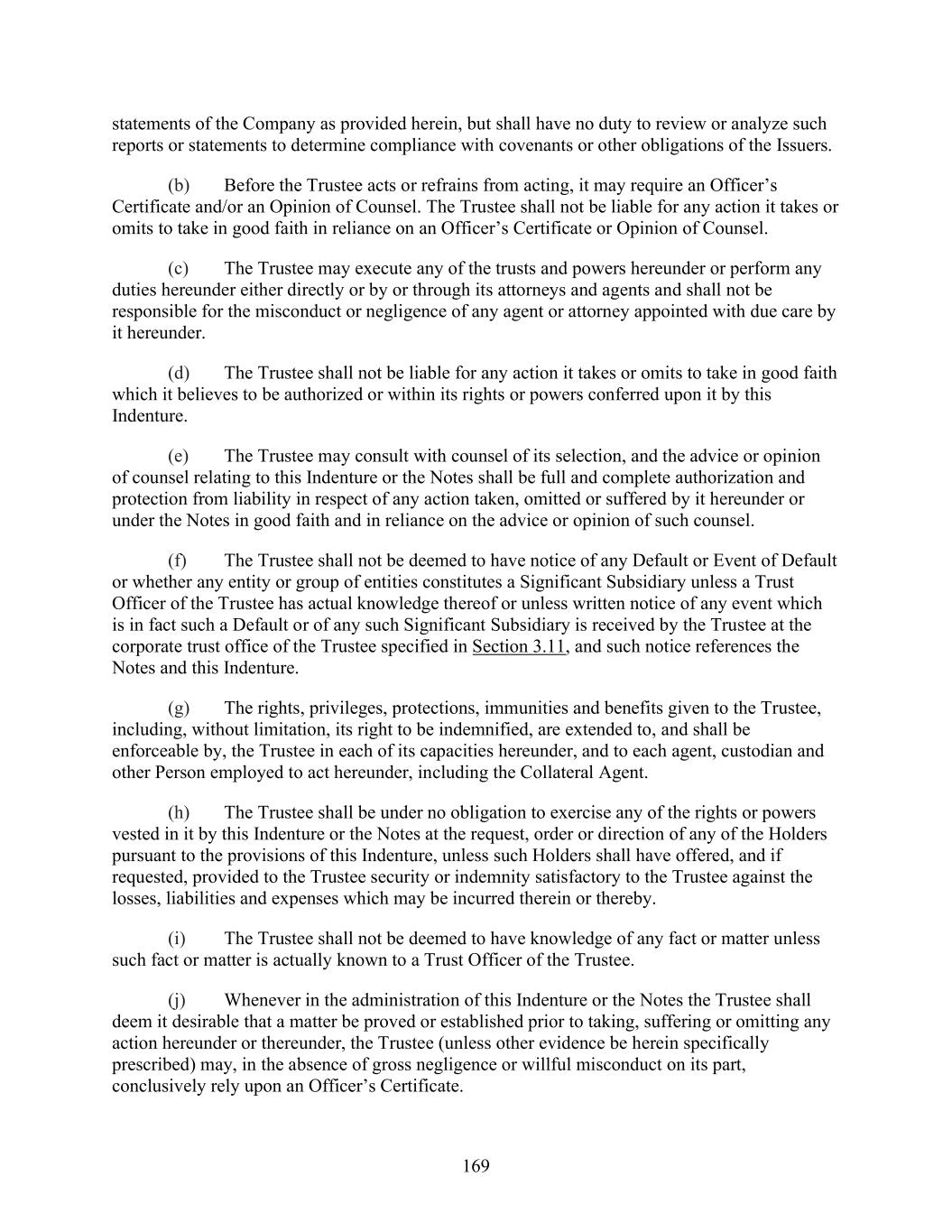
169 statements of the Company as provided herein, but shall have no duty to review or analyze such reports or statements to determine compliance with covenants or other obligations of the Issuers. (b) Before the Trustee acts or refrains from acting, it may require an Officer’s Certificate and/or an Opinion of Counsel. The Trustee shall not be liable for any action it takes or omits to take in good faith in reliance on an Officer’s Certificate or Opinion of Counsel. (c) The Trustee may execute any of the trusts and powers hereunder or perform any duties hereunder either directly or by or through its attorneys and agents and shall not be responsible for the misconduct or negligence of any agent or attorney appointed with due care by it hereunder. (d) The Trustee shall not be liable for any action it takes or omits to take in good faith which it believes to be authorized or within its rights or powers conferred upon it by this Indenture. (e) The Trustee may consult with counsel of its selection, and the advice or opinion of counsel relating to this Indenture or the Notes shall be full and complete authorization and protection from liability in respect of any action taken, omitted or suffered by it hereunder or under the Notes in good faith and in reliance on the advice or opinion of such counsel. (f) The Trustee shall not be deemed to have notice of any Default or Event of Default or whether any entity or group of entities constitutes a Significant Subsidiary unless a Trust Officer of the Trustee has actual knowledge thereof or unless written notice of any event which is in fact such a Default or of any such Significant Subsidiary is received by the Trustee at the corporate trust office of the Trustee specified in Section 3.11, and such notice references the Notes and this Indenture. (g) The rights, privileges, protections, immunities and benefits given to the Trustee, including, without limitation, its right to be indemnified, are extended to, and shall be enforceable by, the Trustee in each of its capacities hereunder, and to each agent, custodian and other Person employed to act hereunder, including the Collateral Agent. (h) The Trustee shall be under no obligation to exercise any of the rights or powers vested in it by this Indenture or the Notes at the request, order or direction of any of the Holders pursuant to the provisions of this Indenture, unless such Holders shall have offered, and if requested, provided to the Trustee security or indemnity satisfactory to the Trustee against the losses, liabilities and expenses which may be incurred therein or thereby. (i) The Trustee shall not be deemed to have knowledge of any fact or matter unless such fact or matter is actually known to a Trust Officer of the Trustee. (j) Whenever in the administration of this Indenture or the Notes the Trustee shall deem it desirable that a matter be proved or established prior to taking, suffering or omitting any action hereunder or thereunder, the Trustee (unless other evidence be herein specifically prescribed) may, in the absence of gross negligence or willful misconduct on its part, conclusively rely upon an Officer’s Certificate.
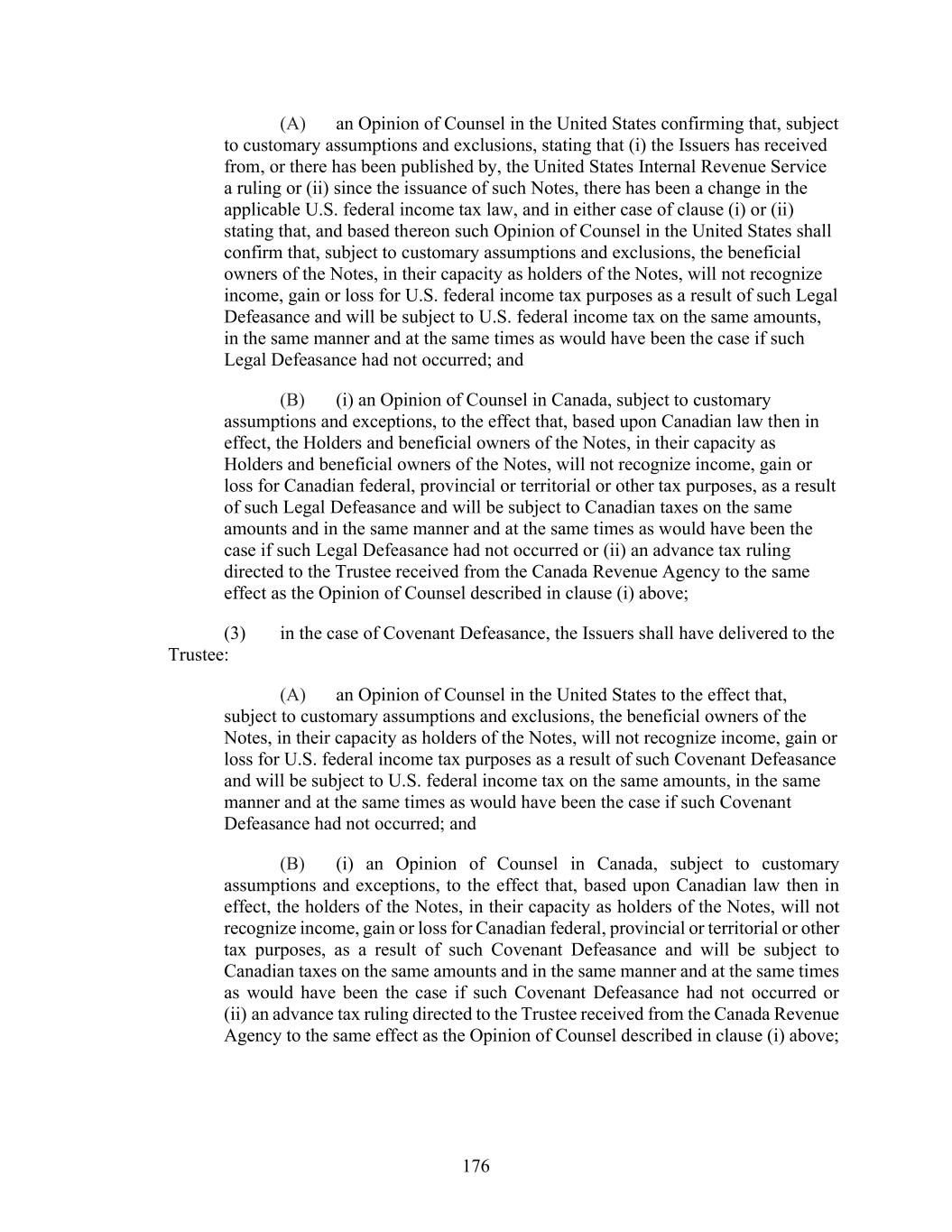
176 (A) an Opinion of Counsel in the United States confirming that, subject to customary assumptions and exclusions, stating that (i) the Issuers has received from, or there has been published by, the United States Internal Revenue Service a ruling or (ii) since the issuance of such Notes, there has been a change in the applicable U.S. federal income tax law, and in either case of clause (i) or (ii) stating that, and based thereon such Opinion of Counsel in the United States shall confirm that, subject to customary assumptions and exclusions, the beneficial owners of the Notes, in their capacity as holders of the Notes, will not recognize income, gain or loss for U.S. federal income tax purposes as a result of such Legal Defeasance and will be subject to U.S. federal income tax on the same amounts, in the same manner and at the same times as would have been the case if such Legal Defeasance had not occurred; and (B) (i) an Opinion of Counsel in Canada, subject to customary assumptions and exceptions, to the effect that, based upon Canadian law then in effect, the Holders and beneficial owners of the Notes, in their capacity as Holders and beneficial owners of the Notes, will not recognize income, gain or loss for Canadian federal, provincial or territorial or other tax purposes, as a result of such Legal Defeasance and will be subject to Canadian taxes on the same amounts and in the same manner and at the same times as would have been the case if such Legal Defeasance had not occurred or (ii) an advance tax ruling directed to the Trustee received from the Canada Revenue Agency to the same effect as the Opinion of Counsel described in clause (i) above; (3) in the case of Covenant Defeasance, the Issuers shall have delivered to the Trustee: (A) an Opinion of Counsel in the United States to the effect that, subject to customary assumptions and exclusions, the beneficial owners of the Notes, in their capacity as holders of the Notes, will not recognize income, gain or loss for U.S. federal income tax purposes as a result of such Covenant Defeasance and will be subject to U.S. federal income tax on the same amounts, in the same manner and at the same times as would have been the case if such Covenant Defeasance had not occurred; and (B) (i) an Opinion of Counsel in Canada, subject to customary assumptions and exceptions, to the effect that, based upon Canadian law then in effect, the holders of the Notes, in their capacity as holders of the Notes, will not recognize income, gain or loss for Canadian federal, provincial or territorial or other tax purposes, as a result of such Covenant Defeasance and will be subject to Canadian taxes on the same amounts and in the same manner and at the same times as would have been the case if such Covenant Defeasance had not occurred or (ii) an advance tax ruling directed to the Trustee received from the Canada Revenue Agency to the same effect as the Opinion of Counsel described in clause (i) above;
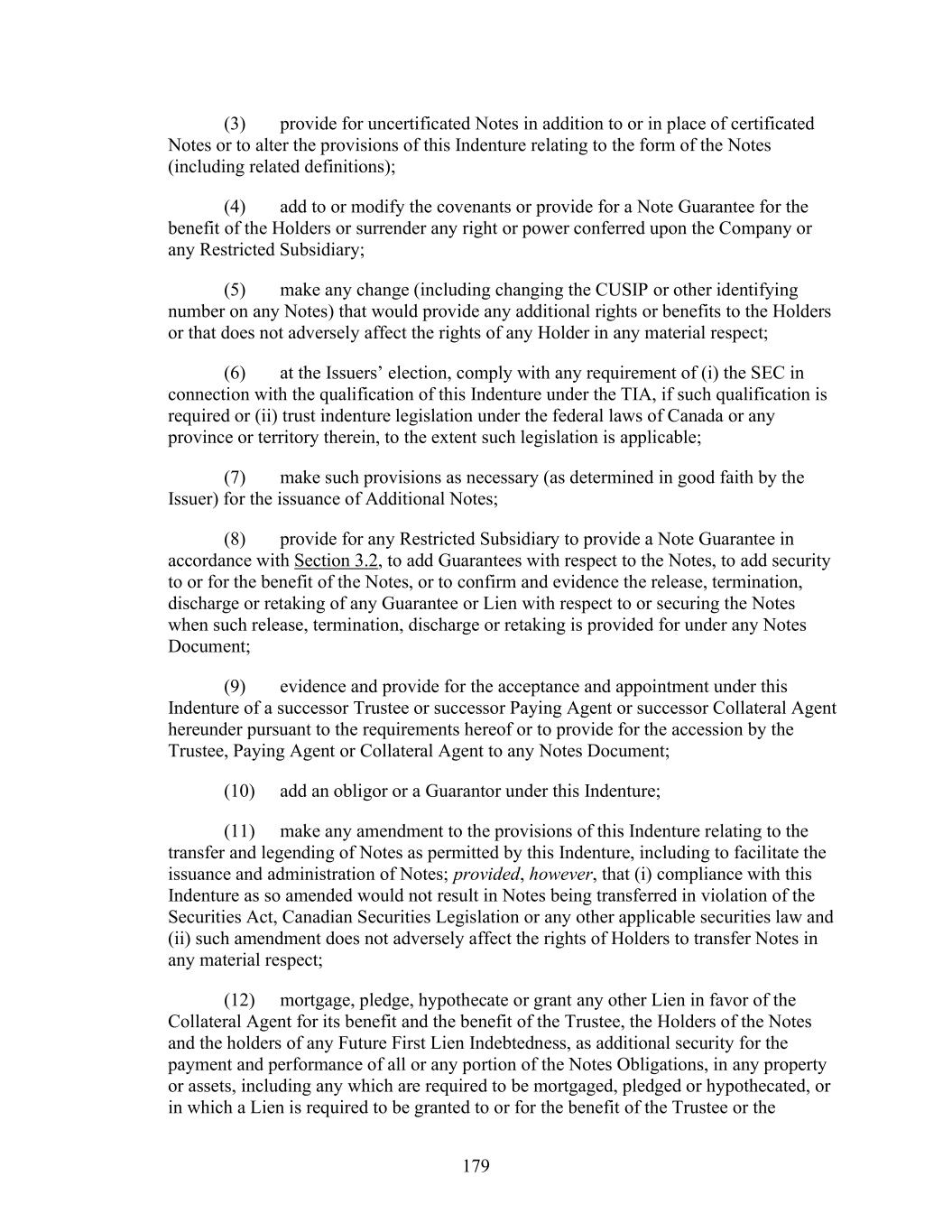
179 (3) provide for uncertificated Notes in addition to or in place of certificated Notes or to alter the provisions of this Indenture relating to the form of the Notes (including related definitions); (4) add to or modify the covenants or provide for a Note Guarantee for the benefit of the Holders or surrender any right or power conferred upon the Company or any Restricted Subsidiary; (5) make any change (including changing the CUSIP or other identifying number on any Notes) that would provide any additional rights or benefits to the Holders or that does not adversely affect the rights of any Holder in any material respect; (6) at the Issuers’ election, comply with any requirement of (i) the SEC in connection with the qualification of this Indenture under the TIA, if such qualification is required or (ii) trust indenture legislation under the federal laws of Canada or any province or territory therein, to the extent such legislation is applicable; (7) make such provisions as necessary (as determined in good faith by the Issuer) for the issuance of Additional Notes; (8) provide for any Restricted Subsidiary to provide a Note Guarantee in accordance with Section 3.2, to add Guarantees with respect to the Notes, to add security to or for the benefit of the Notes, or to confirm and evidence the release, termination, discharge or retaking of any Guarantee or Lien with respect to or securing the Notes when such release, termination, discharge or retaking is provided for under any Notes Document; (9) evidence and provide for the acceptance and appointment under this Indenture of a successor Trustee or successor Paying Agent or successor Collateral Agent hereunder pursuant to the requirements hereof or to provide for the accession by the Trustee, Paying Agent or Collateral Agent to any Notes Document; (10) add an obligor or a Guarantor under this Indenture; (11) make any amendment to the provisions of this Indenture relating to the transfer and legending of Notes as permitted by this Indenture, including to facilitate the issuance and administration of Notes; provided, however, that (i) compliance with this Indenture as so amended would not result in Notes being transferred in violation of the Securities Act, Canadian Securities Legislation or any other applicable securities law and (ii) such amendment does not adversely affect the rights of Holders to transfer Notes in any material respect; (12) mortgage, pledge, hypothecate or grant any other Lien in favor of the Collateral Agent for its benefit and the benefit of the Trustee, the Holders of the Notes and the holders of any Future First Lien Indebtedness, as additional security for the payment and performance of all or any portion of the Notes Obligations, in any property or assets, including any which are required to be mortgaged, pledged or hypothecated, or in which a Lien is required to be granted to or for the benefit of the Trustee or the
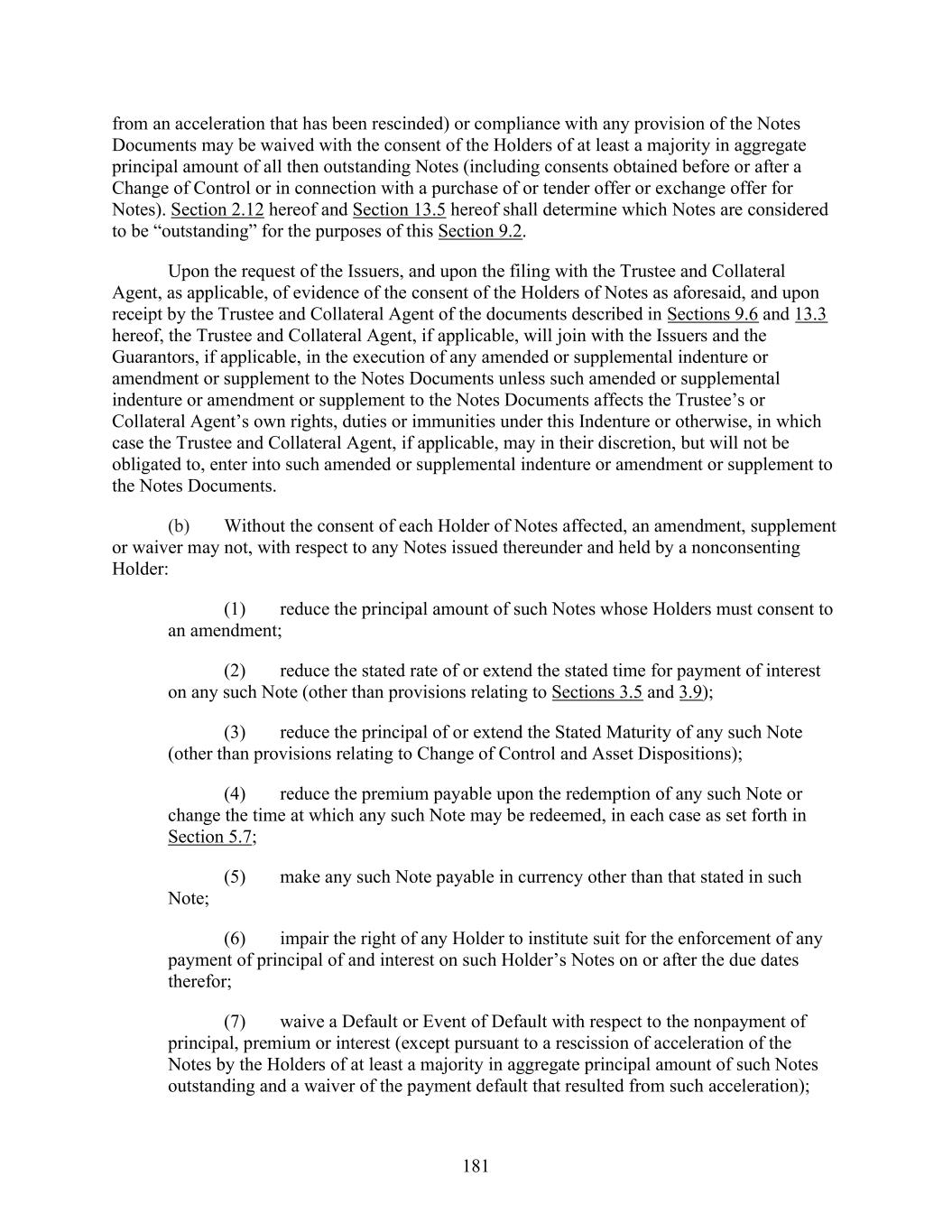
181 from an acceleration that has been rescinded) or compliance with any provision of the Notes Documents may be waived with the consent of the Holders of at least a majority in aggregate principal amount of all then outstanding Notes (including consents obtained before or after a Change of Control or in connection with a purchase of or tender offer or exchange offer for Notes). Section 2.12 hereof and Section 13.5 hereof shall determine which Notes are considered to be “outstanding” for the purposes of this Section 9.2. Upon the request of the Issuers, and upon the filing with the Trustee and Collateral Agent, as applicable, of evidence of the consent of the Holders of Notes as aforesaid, and upon receipt by the Trustee and Collateral Agent of the documents described in Sections 9.6 and 13.3 hereof, the Trustee and Collateral Agent, if applicable, will join with the Issuers and the Guarantors, if applicable, in the execution of any amended or supplemental indenture or amendment or supplement to the Notes Documents unless such amended or supplemental indenture or amendment or supplement to the Notes Documents affects the Trustee’s or Collateral Agent’s own rights, duties or immunities under this Indenture or otherwise, in which case the Trustee and Collateral Agent, if applicable, may in their discretion, but will not be obligated to, enter into such amended or supplemental indenture or amendment or supplement to the Notes Documents. (b) Without the consent of each Holder of Notes affected, an amendment, supplement or waiver may not, with respect to any Notes issued thereunder and held by a nonconsenting Holder: (1) reduce the principal amount of such Notes whose Holders must consent to an amendment; (2) reduce the stated rate of or extend the stated time for payment of interest on any such Note (other than provisions relating to Sections 3.5 and 3.9); (3) reduce the principal of or extend the Stated Maturity of any such Note (other than provisions relating to Change of Control and Asset Dispositions); (4) reduce the premium payable upon the redemption of any such Note or change the time at which any such Note may be redeemed, in each case as set forth in Section 5.7; (5) make any such Note payable in currency other than that stated in such Note; (6) impair the right of any Holder to institute suit for the enforcement of any payment of principal of and interest on such Holder’s Notes on or after the due dates therefor; (7) waive a Default or Event of Default with respect to the nonpayment of principal, premium or interest (except pursuant to a rescission of acceleration of the Notes by the Holders of at least a majority in aggregate principal amount of such Notes outstanding and a waiver of the payment default that resulted from such acceleration);
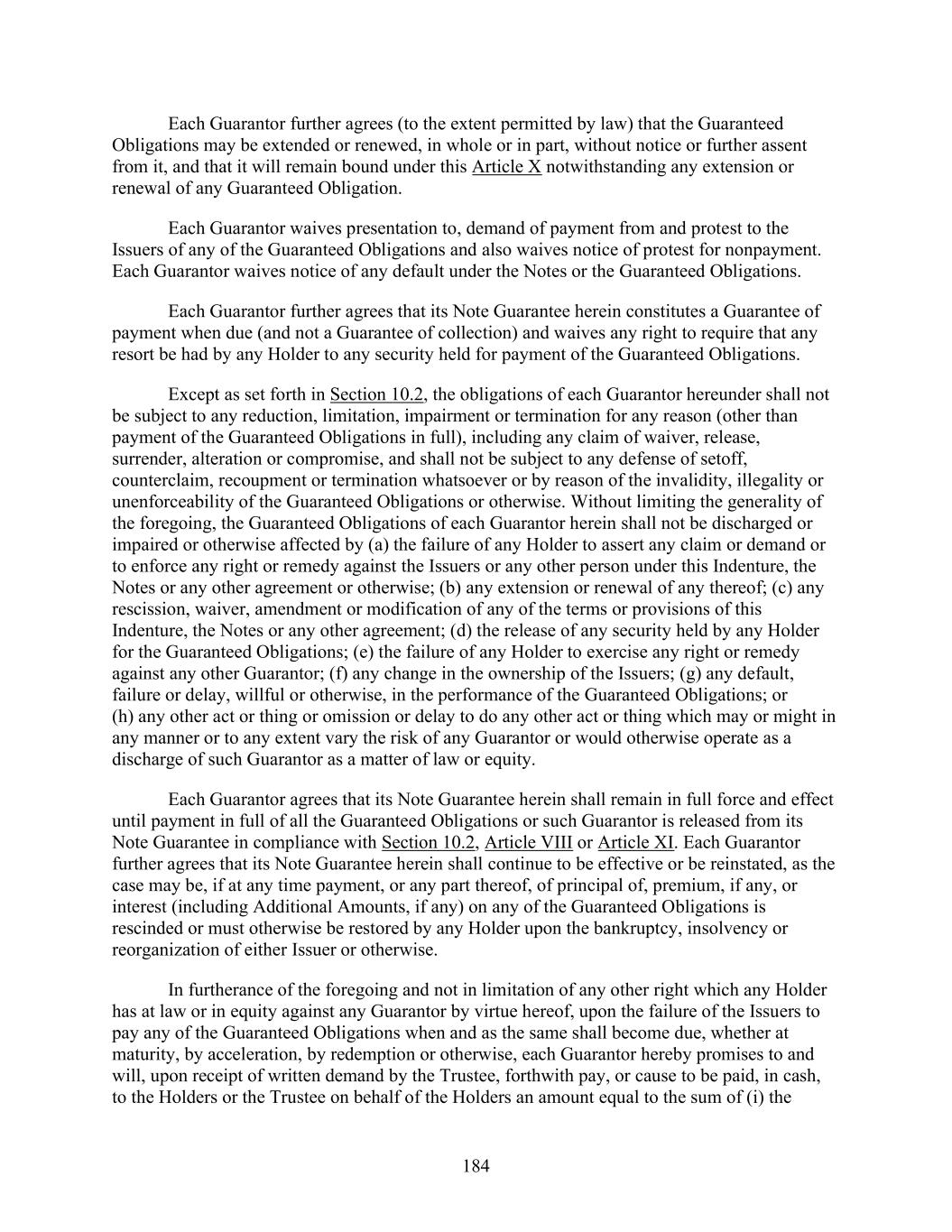
184 Each Guarantor further agrees (to the extent permitted by law) that the Guaranteed Obligations may be extended or renewed, in whole or in part, without notice or further assent from it, and that it will remain bound under this Article X notwithstanding any extension or renewal of any Guaranteed Obligation. Each Guarantor waives presentation to, demand of payment from and protest to the Issuers of any of the Guaranteed Obligations and also waives notice of protest for nonpayment. Each Guarantor waives notice of any default under the Notes or the Guaranteed Obligations. Each Guarantor further agrees that its Note Guarantee herein constitutes a Guarantee of payment when due (and not a Guarantee of collection) and waives any right to require that any resort be had by any Holder to any security held for payment of the Guaranteed Obligations. Except as set forth in Section 10.2, the obligations of each Guarantor hereunder shall not be subject to any reduction, limitation, impairment or termination for any reason (other than payment of the Guaranteed Obligations in full), including any claim of waiver, release, surrender, alteration or compromise, and shall not be subject to any defense of setoff, counterclaim, recoupment or termination whatsoever or by reason of the invalidity, illegality or unenforceability of the Guaranteed Obligations or otherwise. Without limiting the generality of the foregoing, the Guaranteed Obligations of each Guarantor herein shall not be discharged or impaired or otherwise affected by (a) the failure of any Holder to assert any claim or demand or to enforce any right or remedy against the Issuers or any other person under this Indenture, the Notes or any other agreement or otherwise; (b) any extension or renewal of any thereof; (c) any rescission, waiver, amendment or modification of any of the terms or provisions of this Indenture, the Notes or any other agreement; (d) the release of any security held by any Holder for the Guaranteed Obligations; (e) the failure of any Holder to exercise any right or remedy against any other Guarantor; (f) any change in the ownership of the Issuers; (g) any default, failure or delay, willful or otherwise, in the performance of the Guaranteed Obligations; or (h) any other act or thing or omission or delay to do any other act or thing which may or might in any manner or to any extent vary the risk of any Guarantor or would otherwise operate as a discharge of such Guarantor as a matter of law or equity. Each Guarantor agrees that its Note Guarantee herein shall remain in full force and effect until payment in full of all the Guaranteed Obligations or such Guarantor is released from its Note Guarantee in compliance with Section 10.2, Article VIII or Article XI. Each Guarantor further agrees that its Note Guarantee herein shall continue to be effective or be reinstated, as the case may be, if at any time payment, or any part thereof, of principal of, premium, if any, or interest (including Additional Amounts, if any) on any of the Guaranteed Obligations is rescinded or must otherwise be restored by any Holder upon the bankruptcy, insolvency or reorganization of either Issuer or otherwise. In furtherance of the foregoing and not in limitation of any other right which any Holder has at law or in equity against any Guarantor by virtue hereof, upon the failure of the Issuers to pay any of the Guaranteed Obligations when and as the same shall become due, whether at maturity, by acceleration, by redemption or otherwise, each Guarantor hereby promises to and will, upon receipt of written demand by the Trustee, forthwith pay, or cause to be paid, in cash, to the Holders or the Trustee on behalf of the Holders an amount equal to the sum of (i) the
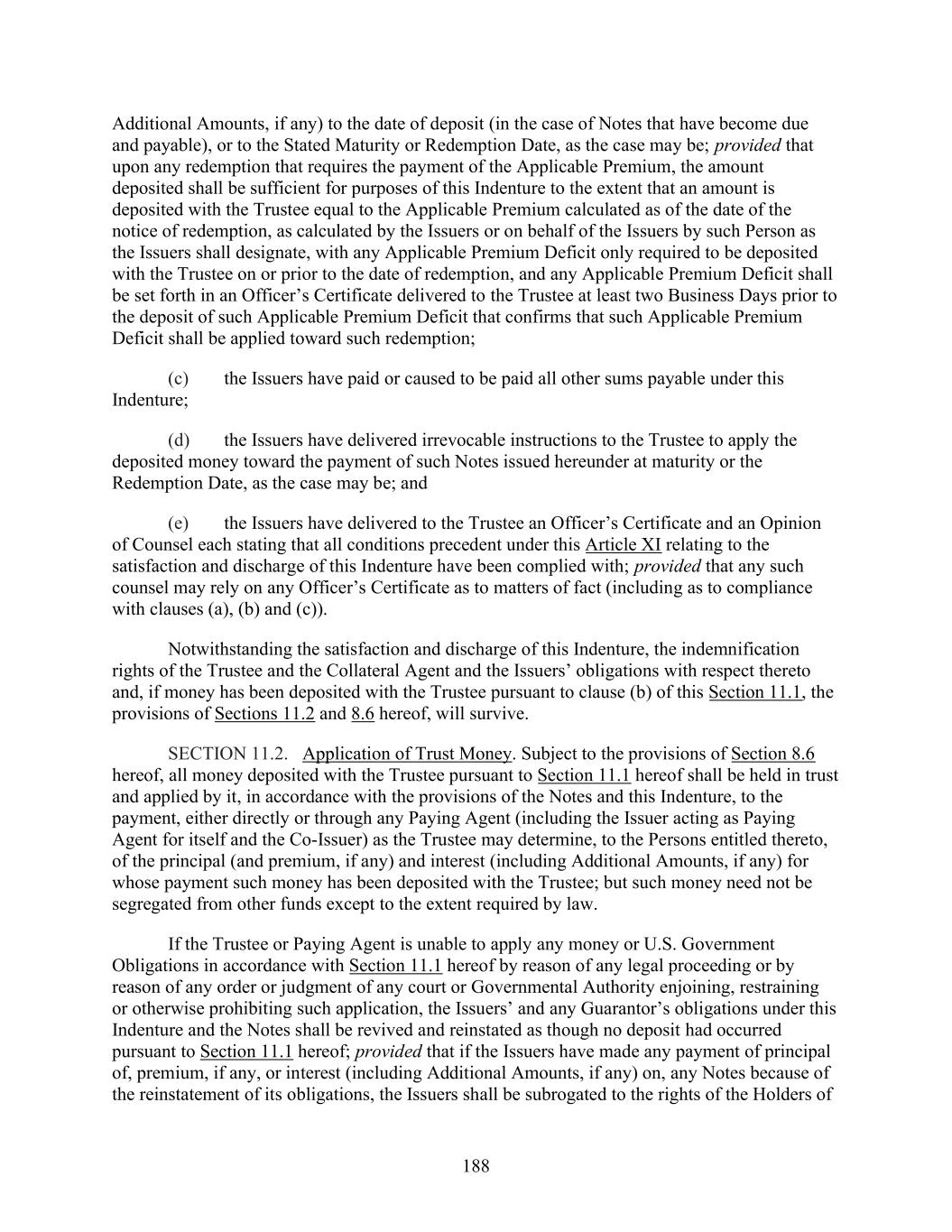
188 Additional Amounts, if any) to the date of deposit (in the case of Notes that have become due and payable), or to the Stated Maturity or Redemption Date, as the case may be; provided that upon any redemption that requires the payment of the Applicable Premium, the amount deposited shall be sufficient for purposes of this Indenture to the extent that an amount is deposited with the Trustee equal to the Applicable Premium calculated as of the date of the notice of redemption, as calculated by the Issuers or on behalf of the Issuers by such Person as the Issuers shall designate, with any Applicable Premium Deficit only required to be deposited with the Trustee on or prior to the date of redemption, and any Applicable Premium Deficit shall be set forth in an Officer’s Certificate delivered to the Trustee at least two Business Days prior to the deposit of such Applicable Premium Deficit that confirms that such Applicable Premium Deficit shall be applied toward such redemption; (c) the Issuers have paid or caused to be paid all other sums payable under this Indenture; (d) the Issuers have delivered irrevocable instructions to the Trustee to apply the deposited money toward the payment of such Notes issued hereunder at maturity or the Redemption Date, as the case may be; and (e) the Issuers have delivered to the Trustee an Officer’s Certificate and an Opinion of Counsel each stating that all conditions precedent under this Article XI relating to the satisfaction and discharge of this Indenture have been complied with; provided that any such counsel may rely on any Officer’s Certificate as to matters of fact (including as to compliance with clauses (a), (b) and (c)). Notwithstanding the satisfaction and discharge of this Indenture, the indemnification rights of the Trustee and the Collateral Agent and the Issuers’ obligations with respect thereto and, if money has been deposited with the Trustee pursuant to clause (b) of this Section 11.1, the provisions of Sections 11.2 and 8.6 hereof, will survive. SECTION 11.2. Application of Trust Money. Subject to the provisions of Section 8.6 hereof, all money deposited with the Trustee pursuant to Section 11.1 hereof shall be held in trust and applied by it, in accordance with the provisions of the Notes and this Indenture, to the payment, either directly or through any Paying Agent (including the Issuer acting as Paying Agent for itself and the Co-Issuer) as the Trustee may determine, to the Persons entitled thereto, of the principal (and premium, if any) and interest (including Additional Amounts, if any) for whose payment such money has been deposited with the Trustee; but such money need not be segregated from other funds except to the extent required by law. If the Trustee or Paying Agent is unable to apply any money or U.S. Government Obligations in accordance with Section 11.1 hereof by reason of any legal proceeding or by reason of any order or judgment of any court or Governmental Authority enjoining, restraining or otherwise prohibiting such application, the Issuers’ and any Guarantor’s obligations under this Indenture and the Notes shall be revived and reinstated as though no deposit had occurred pursuant to Section 11.1 hereof; provided that if the Issuers have made any payment of principal of, premium, if any, or interest (including Additional Amounts, if any) on, any Notes because of the reinstatement of its obligations, the Issuers shall be subrogated to the rights of the Holders of
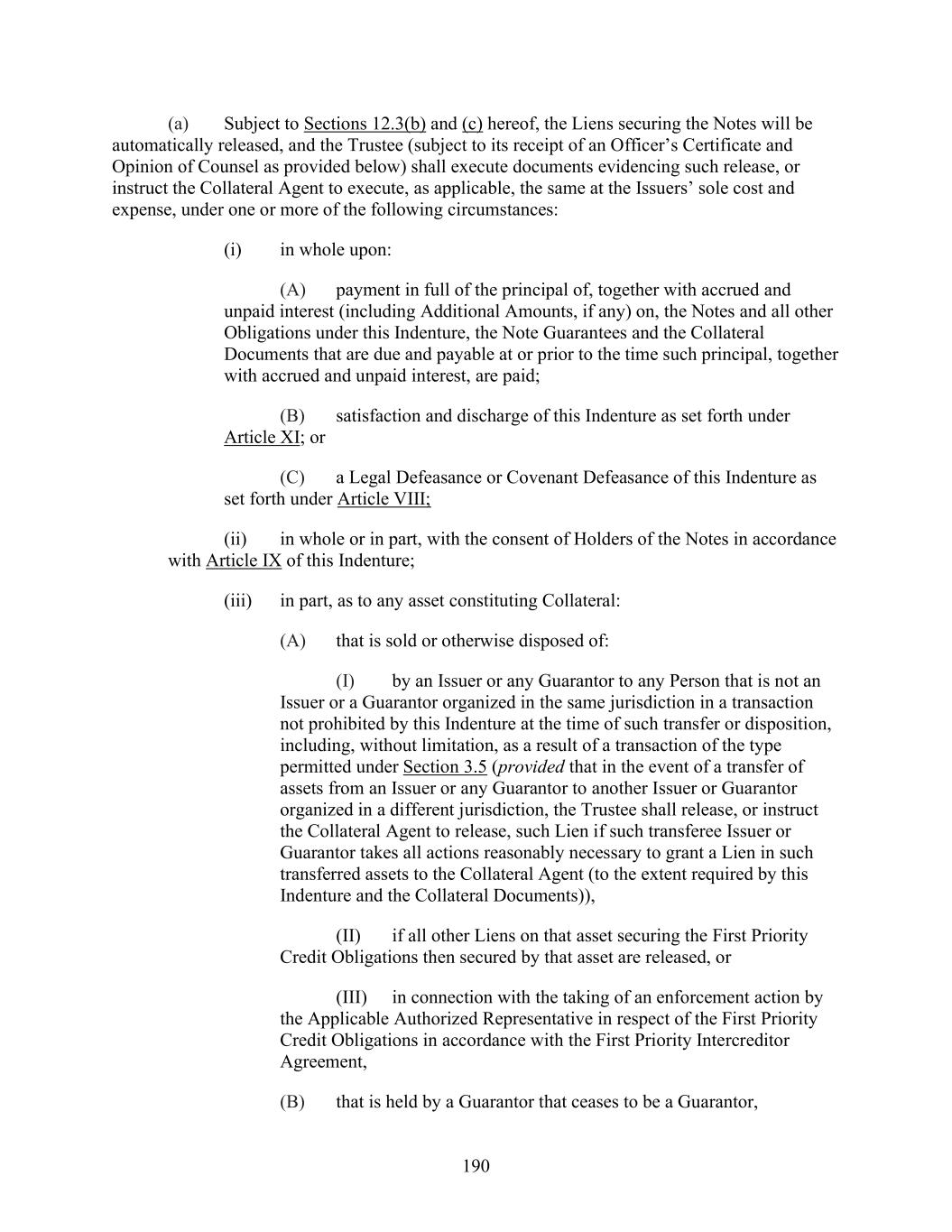
190 (a) Subject to Sections 12.3(b) and (c) hereof, the Liens securing the Notes will be automatically released, and the Trustee (subject to its receipt of an Officer’s Certificate and Opinion of Counsel as provided below) shall execute documents evidencing such release, or instruct the Collateral Agent to execute, as applicable, the same at the Issuers’ sole cost and expense, under one or more of the following circumstances: (i) in whole upon: (A) payment in full of the principal of, together with accrued and unpaid interest (including Additional Amounts, if any) on, the Notes and all other Obligations under this Indenture, the Note Guarantees and the Collateral Documents that are due and payable at or prior to the time such principal, together with accrued and unpaid interest, are paid; (B) satisfaction and discharge of this Indenture as set forth under Article XI; or (C) a Legal Defeasance or Covenant Defeasance of this Indenture as set forth under Article VIII; (ii) in whole or in part, with the consent of Holders of the Notes in accordance with Article IX of this Indenture; (iii) in part, as to any asset constituting Collateral: (A) that is sold or otherwise disposed of: (I) by an Issuer or any Guarantor to any Person that is not an Issuer or a Guarantor organized in the same jurisdiction in a transaction not prohibited by this Indenture at the time of such transfer or disposition, including, without limitation, as a result of a transaction of the type permitted under Section 3.5 (provided that in the event of a transfer of assets from an Issuer or any Guarantor to another Issuer or Guarantor organized in a different jurisdiction, the Trustee shall release, or instruct the Collateral Agent to release, such Lien if such transferee Issuer or Guarantor takes all actions reasonably necessary to xxxxx x Xxxx in such transferred assets to the Collateral Agent (to the extent required by this Indenture and the Collateral Documents)), (II) if all other Liens on that asset securing the First Priority Credit Obligations then secured by that asset are released, or (III) in connection with the taking of an enforcement action by the Applicable Authorized Representative in respect of the First Priority Credit Obligations in accordance with the First Priority Intercreditor Agreement, (B) that is held by a Guarantor that ceases to be a Guarantor,
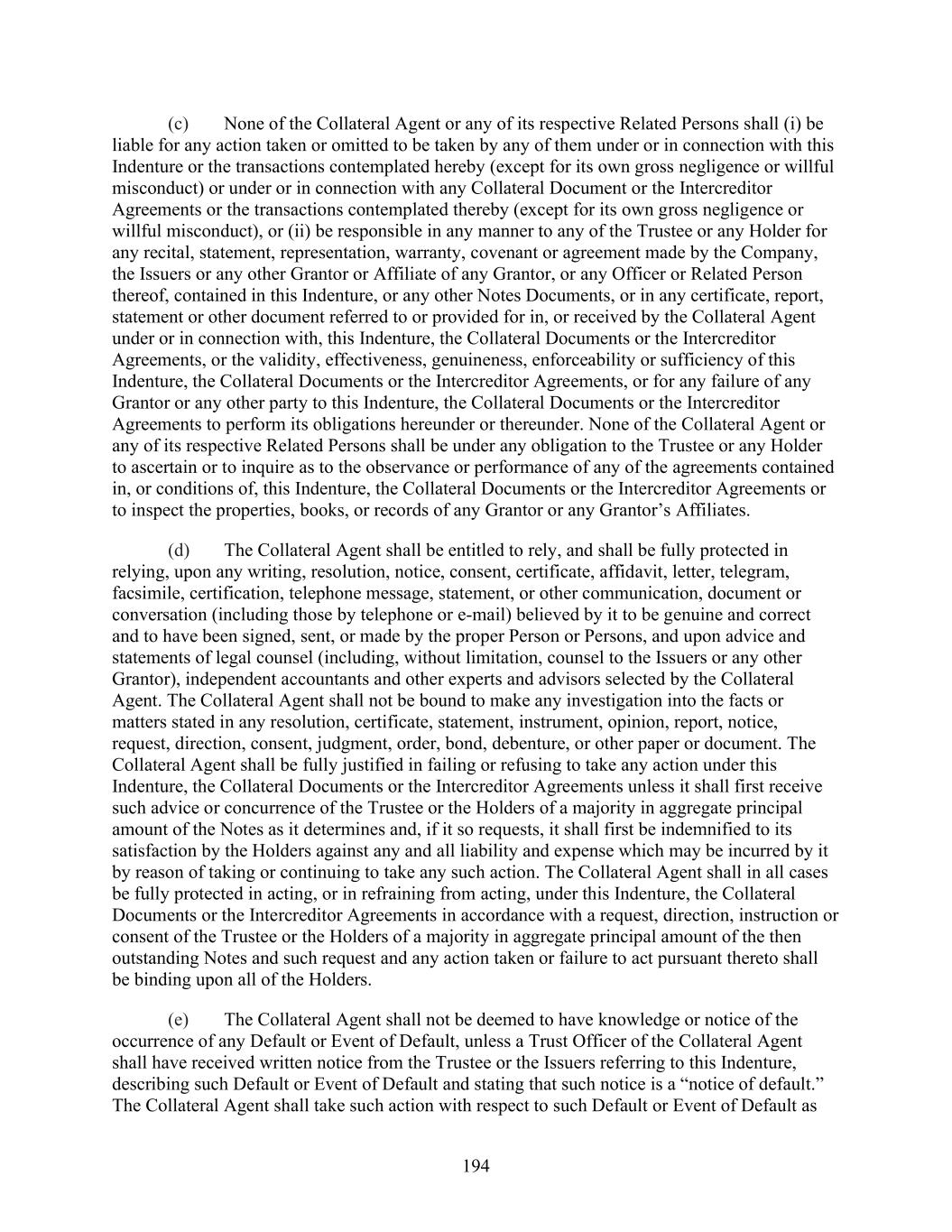
194 (c) None of the Collateral Agent or any of its respective Related Persons shall (i) be liable for any action taken or omitted to be taken by any of them under or in connection with this Indenture or the transactions contemplated hereby (except for its own gross negligence or willful misconduct) or under or in connection with any Collateral Document or the Intercreditor Agreements or the transactions contemplated thereby (except for its own gross negligence or willful misconduct), or (ii) be responsible in any manner to any of the Trustee or any Holder for any recital, statement, representation, warranty, covenant or agreement made by the Company, the Issuers or any other Grantor or Affiliate of any Grantor, or any Officer or Related Person thereof, contained in this Indenture, or any other Notes Documents, or in any certificate, report, statement or other document referred to or provided for in, or received by the Collateral Agent under or in connection with, this Indenture, the Collateral Documents or the Intercreditor Agreements, or the validity, effectiveness, genuineness, enforceability or sufficiency of this Indenture, the Collateral Documents or the Intercreditor Agreements, or for any failure of any Grantor or any other party to this Indenture, the Collateral Documents or the Intercreditor Agreements to perform its obligations hereunder or thereunder. None of the Collateral Agent or any of its respective Related Persons shall be under any obligation to the Trustee or any Holder to ascertain or to inquire as to the observance or performance of any of the agreements contained in, or conditions of, this Indenture, the Collateral Documents or the Intercreditor Agreements or to inspect the properties, books, or records of any Grantor or any Grantor’s Affiliates. (d) The Collateral Agent shall be entitled to rely, and shall be fully protected in relying, upon any writing, resolution, notice, consent, certificate, affidavit, letter, telegram, facsimile, certification, telephone message, statement, or other communication, document or conversation (including those by telephone or e-mail) believed by it to be genuine and correct and to have been signed, sent, or made by the proper Person or Persons, and upon advice and statements of legal counsel (including, without limitation, counsel to the Issuers or any other Grantor), independent accountants and other experts and advisors selected by the Collateral Agent. The Collateral Agent shall not be bound to make any investigation into the facts or matters stated in any resolution, certificate, statement, instrument, opinion, report, notice, request, direction, consent, judgment, order, bond, debenture, or other paper or document. The Collateral Agent shall be fully justified in failing or refusing to take any action under this Indenture, the Collateral Documents or the Intercreditor Agreements unless it shall first receive such advice or concurrence of the Trustee or the Holders of a majority in aggregate principal amount of the Notes as it determines and, if it so requests, it shall first be indemnified to its satisfaction by the Holders against any and all liability and expense which may be incurred by it by reason of taking or continuing to take any such action. The Collateral Agent shall in all cases be fully protected in acting, or in refraining from acting, under this Indenture, the Collateral Documents or the Intercreditor Agreements in accordance with a request, direction, instruction or consent of the Trustee or the Holders of a majority in aggregate principal amount of the then outstanding Notes and such request and any action taken or failure to act pursuant thereto shall be binding upon all of the Holders. (e) The Collateral Agent shall not be deemed to have knowledge or notice of the occurrence of any Default or Event of Default, unless a Trust Officer of the Collateral Agent shall have received written notice from the Trustee or the Issuers referring to this Indenture, describing such Default or Event of Default and stating that such notice is a “notice of default.” The Collateral Agent shall take such action with respect to such Default or Event of Default as
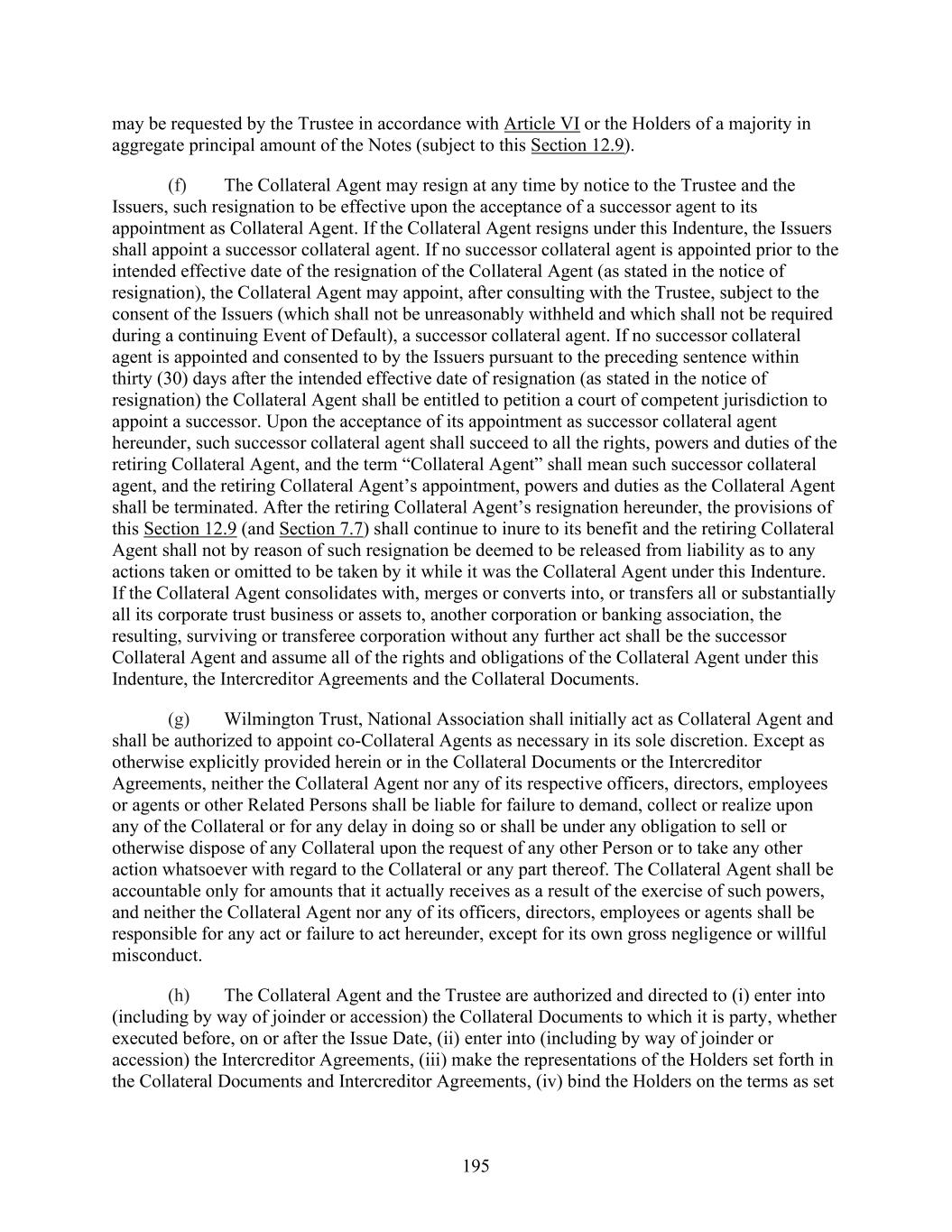
195 may be requested by the Trustee in accordance with Article VI or the Holders of a majority in aggregate principal amount of the Notes (subject to this Section 12.9). (f) The Collateral Agent may resign at any time by notice to the Trustee and the Issuers, such resignation to be effective upon the acceptance of a successor agent to its appointment as Collateral Agent. If the Collateral Agent resigns under this Indenture, the Issuers shall appoint a successor collateral agent. If no successor collateral agent is appointed prior to the intended effective date of the resignation of the Collateral Agent (as stated in the notice of resignation), the Collateral Agent may appoint, after consulting with the Trustee, subject to the consent of the Issuers (which shall not be unreasonably withheld and which shall not be required during a continuing Event of Default), a successor collateral agent. If no successor collateral agent is appointed and consented to by the Issuers pursuant to the preceding sentence within thirty (30) days after the intended effective date of resignation (as stated in the notice of resignation) the Collateral Agent shall be entitled to petition a court of competent jurisdiction to appoint a successor. Upon the acceptance of its appointment as successor collateral agent hereunder, such successor collateral agent shall succeed to all the rights, powers and duties of the retiring Collateral Agent, and the term “Collateral Agent” shall mean such successor collateral agent, and the retiring Collateral Agent’s appointment, powers and duties as the Collateral Agent shall be terminated. After the retiring Collateral Agent’s resignation hereunder, the provisions of this Section 12.9 (and Section 7.7) shall continue to inure to its benefit and the retiring Collateral Agent shall not by reason of such resignation be deemed to be released from liability as to any actions taken or omitted to be taken by it while it was the Collateral Agent under this Indenture. If the Collateral Agent consolidates with, merges or converts into, or transfers all or substantially all its corporate trust business or assets to, another corporation or banking association, the resulting, surviving or transferee corporation without any further act shall be the successor Collateral Agent and assume all of the rights and obligations of the Collateral Agent under this Indenture, the Intercreditor Agreements and the Collateral Documents. (g) Wilmington Trust, National Association shall initially act as Collateral Agent and shall be authorized to appoint co-Collateral Agents as necessary in its sole discretion. Except as otherwise explicitly provided herein or in the Collateral Documents or the Intercreditor Agreements, neither the Collateral Agent nor any of its respective officers, directors, employees or agents or other Related Persons shall be liable for failure to demand, collect or realize upon any of the Collateral or for any delay in doing so or shall be under any obligation to sell or otherwise dispose of any Collateral upon the request of any other Person or to take any other action whatsoever with regard to the Collateral or any part thereof. The Collateral Agent shall be accountable only for amounts that it actually receives as a result of the exercise of such powers, and neither the Collateral Agent nor any of its officers, directors, employees or agents shall be responsible for any act or failure to act hereunder, except for its own gross negligence or willful misconduct. (h) The Collateral Agent and the Trustee are authorized and directed to (i) enter into (including by way of joinder or accession) the Collateral Documents to which it is party, whether executed before, on or after the Issue Date, (ii) enter into (including by way of joinder or accession) the Intercreditor Agreements, (iii) make the representations of the Holders set forth in the Collateral Documents and Intercreditor Agreements, (iv) bind the Holders on the terms as set
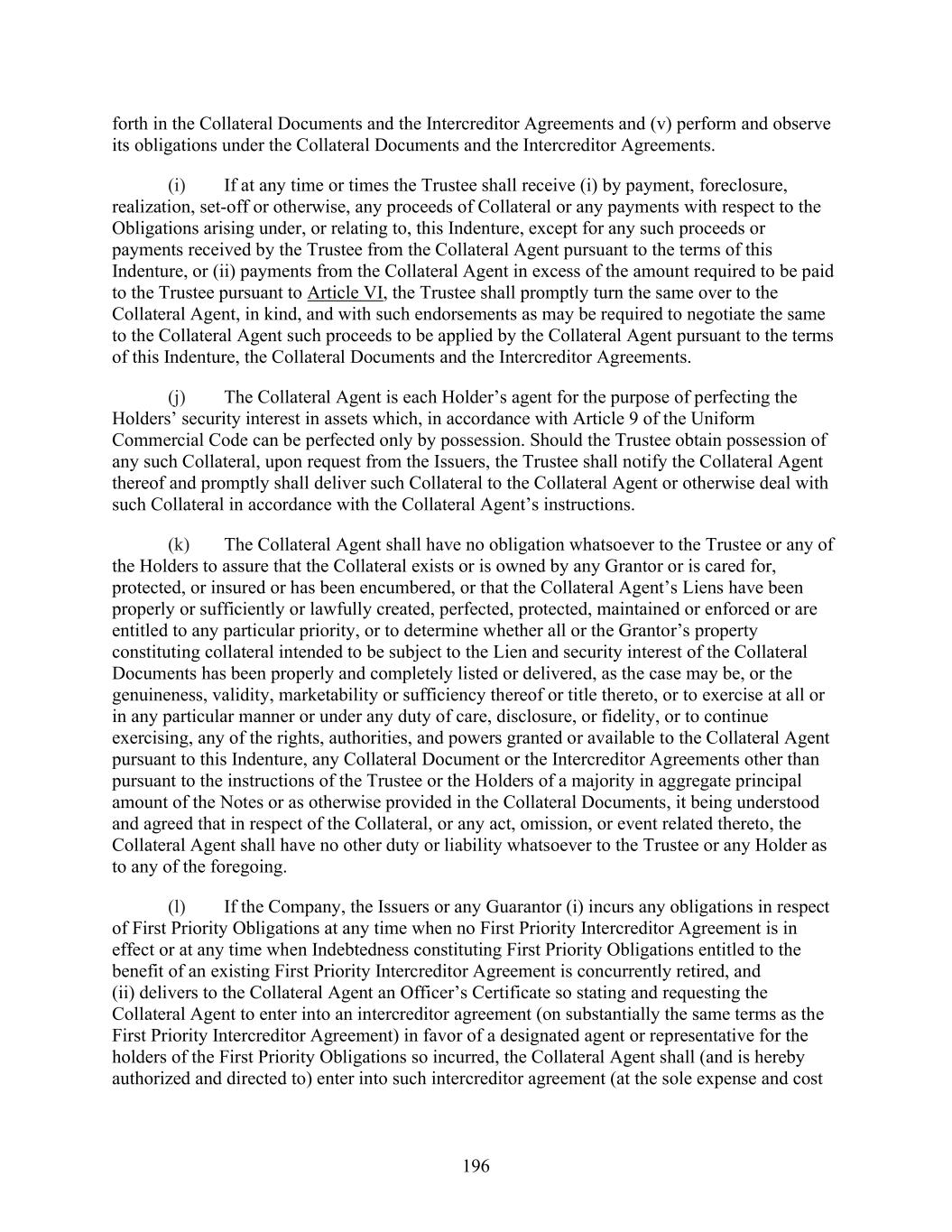
196 forth in the Collateral Documents and the Intercreditor Agreements and (v) perform and observe its obligations under the Collateral Documents and the Intercreditor Agreements. (i) If at any time or times the Trustee shall receive (i) by payment, foreclosure, realization, set-off or otherwise, any proceeds of Collateral or any payments with respect to the Obligations arising under, or relating to, this Indenture, except for any such proceeds or payments received by the Trustee from the Collateral Agent pursuant to the terms of this Indenture, or (ii) payments from the Collateral Agent in excess of the amount required to be paid to the Trustee pursuant to Article VI, the Trustee shall promptly turn the same over to the Collateral Agent, in kind, and with such endorsements as may be required to negotiate the same to the Collateral Agent such proceeds to be applied by the Collateral Agent pursuant to the terms of this Indenture, the Collateral Documents and the Intercreditor Agreements. (j) The Collateral Agent is each Holder’s agent for the purpose of perfecting the Holders’ security interest in assets which, in accordance with Article 9 of the Uniform Commercial Code can be perfected only by possession. Should the Trustee obtain possession of any such Collateral, upon request from the Issuers, the Trustee shall notify the Collateral Agent thereof and promptly shall deliver such Collateral to the Collateral Agent or otherwise deal with such Collateral in accordance with the Collateral Agent’s instructions. (k) The Collateral Agent shall have no obligation whatsoever to the Trustee or any of the Holders to assure that the Collateral exists or is owned by any Grantor or is cared for, protected, or insured or has been encumbered, or that the Collateral Agent’s Liens have been properly or sufficiently or lawfully created, perfected, protected, maintained or enforced or are entitled to any particular priority, or to determine whether all or the Grantor’s property constituting collateral intended to be subject to the Lien and security interest of the Collateral Documents has been properly and completely listed or delivered, as the case may be, or the genuineness, validity, marketability or sufficiency thereof or title thereto, or to exercise at all or in any particular manner or under any duty of care, disclosure, or fidelity, or to continue exercising, any of the rights, authorities, and powers granted or available to the Collateral Agent pursuant to this Indenture, any Collateral Document or the Intercreditor Agreements other than pursuant to the instructions of the Trustee or the Holders of a majority in aggregate principal amount of the Notes or as otherwise provided in the Collateral Documents, it being understood and agreed that in respect of the Collateral, or any act, omission, or event related thereto, the Collateral Agent shall have no other duty or liability whatsoever to the Trustee or any Holder as to any of the foregoing. (l) If the Company, the Issuers or any Guarantor (i) incurs any obligations in respect of First Priority Obligations at any time when no First Priority Intercreditor Agreement is in effect or at any time when Indebtedness constituting First Priority Obligations entitled to the benefit of an existing First Priority Intercreditor Agreement is concurrently retired, and (ii) delivers to the Collateral Agent an Officer’s Certificate so stating and requesting the Collateral Agent to enter into an intercreditor agreement (on substantially the same terms as the First Priority Intercreditor Agreement) in favor of a designated agent or representative for the holders of the First Priority Obligations so incurred, the Collateral Agent shall (and is hereby authorized and directed to) enter into such intercreditor agreement (at the sole expense and cost
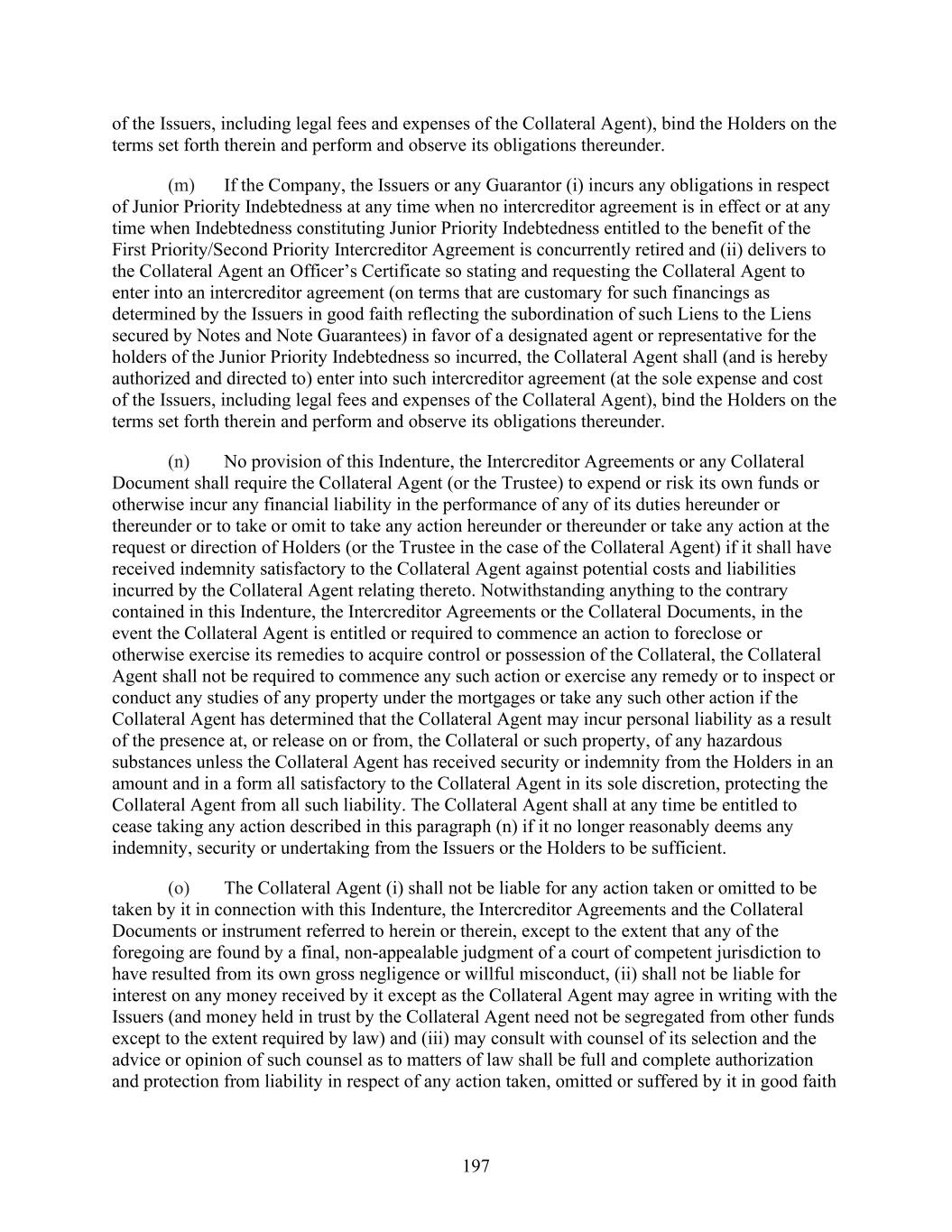
197 of the Issuers, including legal fees and expenses of the Collateral Agent), bind the Holders on the terms set forth therein and perform and observe its obligations thereunder. (m) If the Company, the Issuers or any Guarantor (i) incurs any obligations in respect of Junior Priority Indebtedness at any time when no intercreditor agreement is in effect or at any time when Indebtedness constituting Junior Priority Indebtedness entitled to the benefit of the First Priority/Second Priority Intercreditor Agreement is concurrently retired and (ii) delivers to the Collateral Agent an Officer’s Certificate so stating and requesting the Collateral Agent to enter into an intercreditor agreement (on terms that are customary for such financings as determined by the Issuers in good faith reflecting the subordination of such Liens to the Liens secured by Notes and Note Guarantees) in favor of a designated agent or representative for the holders of the Junior Priority Indebtedness so incurred, the Collateral Agent shall (and is hereby authorized and directed to) enter into such intercreditor agreement (at the sole expense and cost of the Issuers, including legal fees and expenses of the Collateral Agent), bind the Holders on the terms set forth therein and perform and observe its obligations thereunder. (n) No provision of this Indenture, the Intercreditor Agreements or any Collateral Document shall require the Collateral Agent (or the Trustee) to expend or risk its own funds or otherwise incur any financial liability in the performance of any of its duties hereunder or thereunder or to take or omit to take any action hereunder or thereunder or take any action at the request or direction of Holders (or the Trustee in the case of the Collateral Agent) if it shall have received indemnity satisfactory to the Collateral Agent against potential costs and liabilities incurred by the Collateral Agent relating thereto. Notwithstanding anything to the contrary contained in this Indenture, the Intercreditor Agreements or the Collateral Documents, in the event the Collateral Agent is entitled or required to commence an action to foreclose or otherwise exercise its remedies to acquire control or possession of the Collateral, the Collateral Agent shall not be required to commence any such action or exercise any remedy or to inspect or conduct any studies of any property under the mortgages or take any such other action if the Collateral Agent has determined that the Collateral Agent may incur personal liability as a result of the presence at, or release on or from, the Collateral or such property, of any hazardous substances unless the Collateral Agent has received security or indemnity from the Holders in an amount and in a form all satisfactory to the Collateral Agent in its sole discretion, protecting the Collateral Agent from all such liability. The Collateral Agent shall at any time be entitled to cease taking any action described in this paragraph (n) if it no longer reasonably deems any indemnity, security or undertaking from the Issuers or the Holders to be sufficient. (o) The Collateral Agent (i) shall not be liable for any action taken or omitted to be taken by it in connection with this Indenture, the Intercreditor Agreements and the Collateral Documents or instrument referred to herein or therein, except to the extent that any of the foregoing are found by a final, non-appealable judgment of a court of competent jurisdiction to have resulted from its own gross negligence or willful misconduct, (ii) shall not be liable for interest on any money received by it except as the Collateral Agent may agree in writing with the Issuers (and money held in trust by the Collateral Agent need not be segregated from other funds except to the extent required by law) and (iii) may consult with counsel of its selection and the advice or opinion of such counsel as to matters of law shall be full and complete authorization and protection from liability in respect of any action taken, omitted or suffered by it in good faith
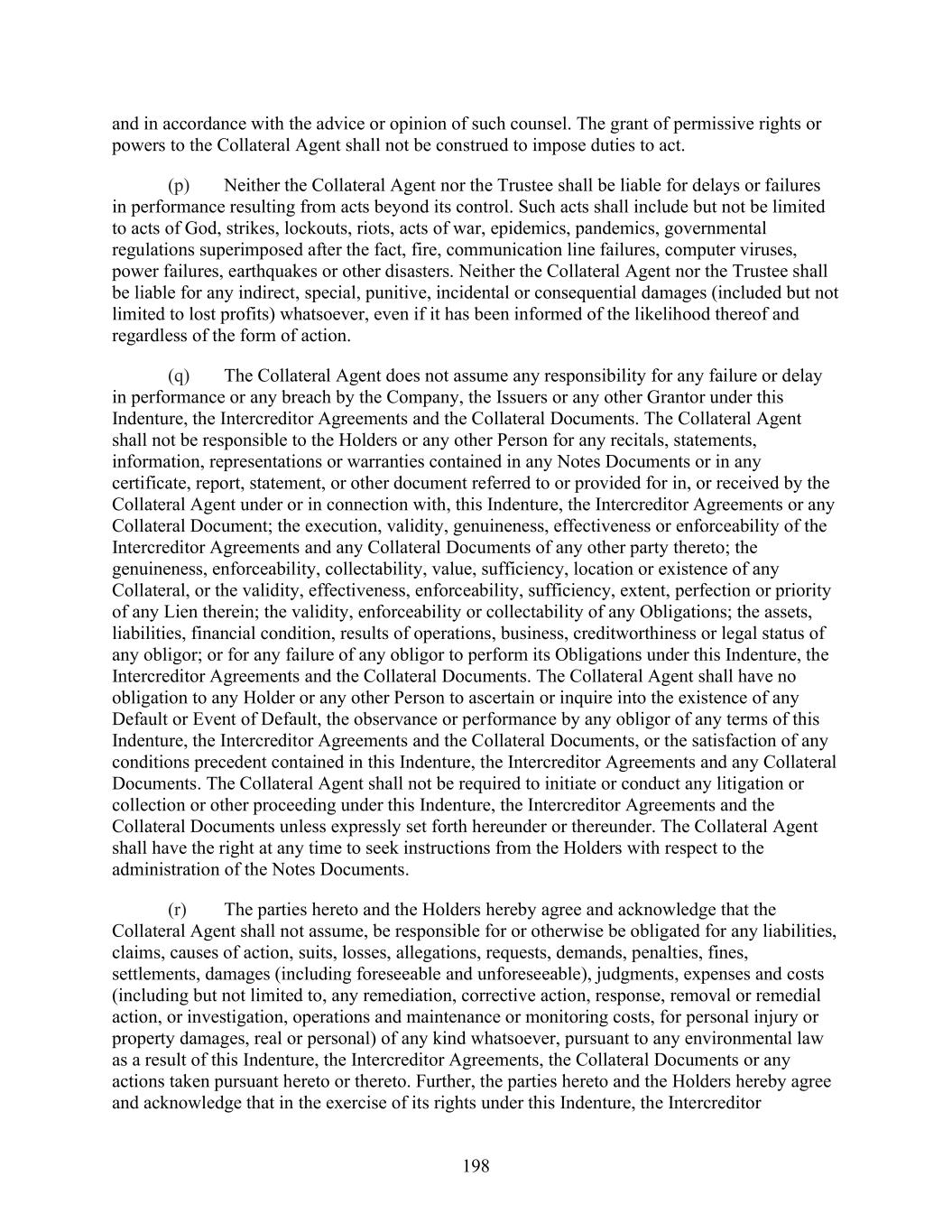
198 and in accordance with the advice or opinion of such counsel. The grant of permissive rights or powers to the Collateral Agent shall not be construed to impose duties to act. (p) Neither the Collateral Agent nor the Trustee shall be liable for delays or failures in performance resulting from acts beyond its control. Such acts shall include but not be limited to acts of God, strikes, lockouts, riots, acts of war, epidemics, pandemics, governmental regulations superimposed after the fact, fire, communication line failures, computer viruses, power failures, earthquakes or other disasters. Neither the Collateral Agent nor the Trustee shall be liable for any indirect, special, punitive, incidental or consequential damages (included but not limited to lost profits) whatsoever, even if it has been informed of the likelihood thereof and regardless of the form of action. (q) The Collateral Agent does not assume any responsibility for any failure or delay in performance or any breach by the Company, the Issuers or any other Grantor under this Indenture, the Intercreditor Agreements and the Collateral Documents. The Collateral Agent shall not be responsible to the Holders or any other Person for any recitals, statements, information, representations or warranties contained in any Notes Documents or in any certificate, report, statement, or other document referred to or provided for in, or received by the Collateral Agent under or in connection with, this Indenture, the Intercreditor Agreements or any Collateral Document; the execution, validity, genuineness, effectiveness or enforceability of the Intercreditor Agreements and any Collateral Documents of any other party thereto; the genuineness, enforceability, collectability, value, sufficiency, location or existence of any Collateral, or the validity, effectiveness, enforceability, sufficiency, extent, perfection or priority of any Lien therein; the validity, enforceability or collectability of any Obligations; the assets, liabilities, financial condition, results of operations, business, creditworthiness or legal status of any obligor; or for any failure of any obligor to perform its Obligations under this Indenture, the Intercreditor Agreements and the Collateral Documents. The Collateral Agent shall have no obligation to any Holder or any other Person to ascertain or inquire into the existence of any Default or Event of Default, the observance or performance by any obligor of any terms of this Indenture, the Intercreditor Agreements and the Collateral Documents, or the satisfaction of any conditions precedent contained in this Indenture, the Intercreditor Agreements and any Collateral Documents. The Collateral Agent shall not be required to initiate or conduct any litigation or collection or other proceeding under this Indenture, the Intercreditor Agreements and the Collateral Documents unless expressly set forth hereunder or thereunder. The Collateral Agent shall have the right at any time to seek instructions from the Holders with respect to the administration of the Notes Documents. (r) The parties hereto and the Holders hereby agree and acknowledge that the Collateral Agent shall not assume, be responsible for or otherwise be obligated for any liabilities, claims, causes of action, suits, losses, allegations, requests, demands, penalties, fines, settlements, damages (including foreseeable and unforeseeable), judgments, expenses and costs (including but not limited to, any remediation, corrective action, response, removal or remedial action, or investigation, operations and maintenance or monitoring costs, for personal injury or property damages, real or personal) of any kind whatsoever, pursuant to any environmental law as a result of this Indenture, the Intercreditor Agreements, the Collateral Documents or any actions taken pursuant hereto or thereto. Further, the parties hereto and the Holders hereby agree and acknowledge that in the exercise of its rights under this Indenture, the Intercreditor
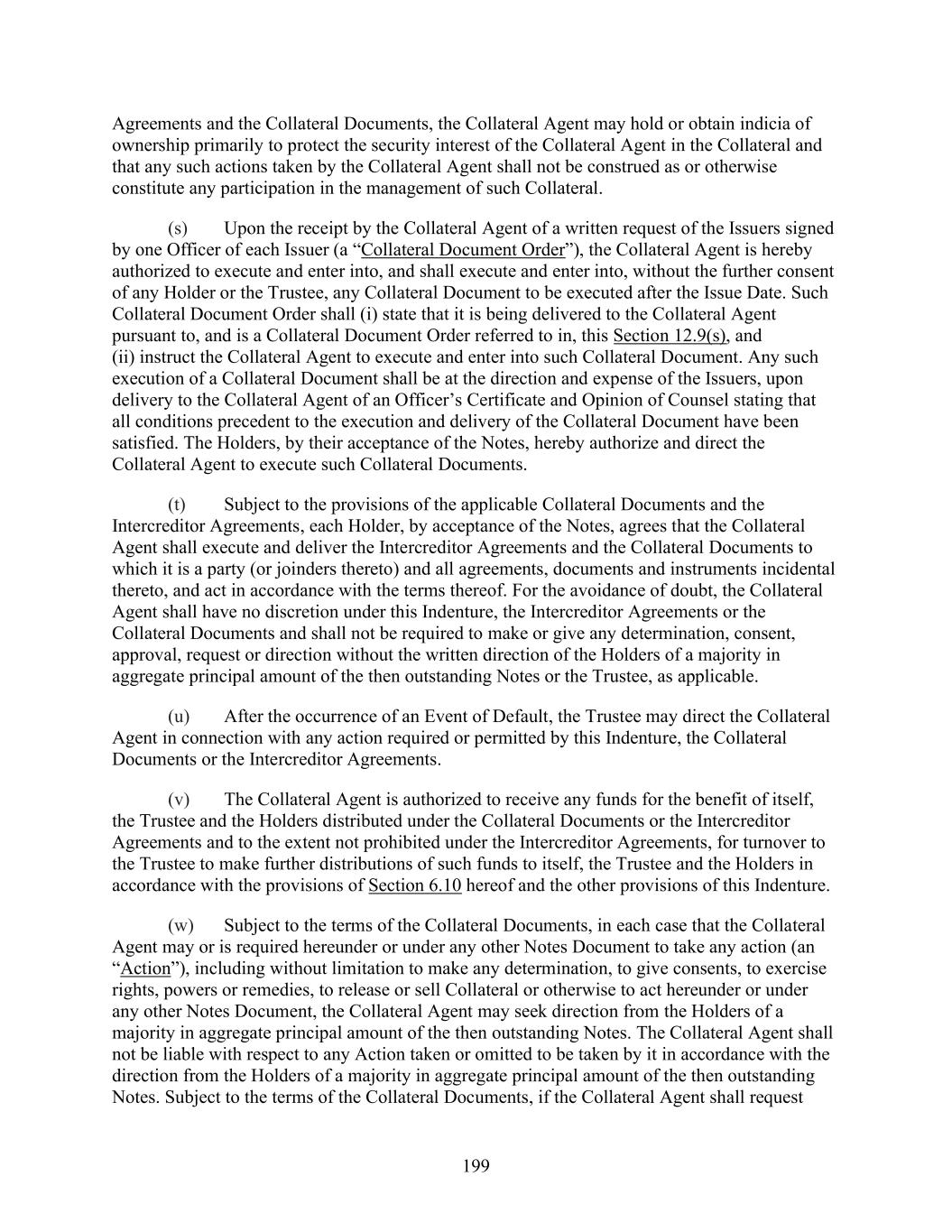
199 Agreements and the Collateral Documents, the Collateral Agent may hold or obtain indicia of ownership primarily to protect the security interest of the Collateral Agent in the Collateral and that any such actions taken by the Collateral Agent shall not be construed as or otherwise constitute any participation in the management of such Collateral. (s) Upon the receipt by the Collateral Agent of a written request of the Issuers signed by one Officer of each Issuer (a “Collateral Document Order”), the Collateral Agent is hereby authorized to execute and enter into, and shall execute and enter into, without the further consent of any Holder or the Trustee, any Collateral Document to be executed after the Issue Date. Such Collateral Document Order shall (i) state that it is being delivered to the Collateral Agent pursuant to, and is a Collateral Document Order referred to in, this Section 12.9(s), and (ii) instruct the Collateral Agent to execute and enter into such Collateral Document. Any such execution of a Collateral Document shall be at the direction and expense of the Issuers, upon delivery to the Collateral Agent of an Officer’s Certificate and Opinion of Counsel stating that all conditions precedent to the execution and delivery of the Collateral Document have been satisfied. The Holders, by their acceptance of the Notes, hereby authorize and direct the Collateral Agent to execute such Collateral Documents. (t) Subject to the provisions of the applicable Collateral Documents and the Intercreditor Agreements, each Holder, by acceptance of the Notes, agrees that the Collateral Agent shall execute and deliver the Intercreditor Agreements and the Collateral Documents to which it is a party (or joinders thereto) and all agreements, documents and instruments incidental thereto, and act in accordance with the terms thereof. For the avoidance of doubt, the Collateral Agent shall have no discretion under this Indenture, the Intercreditor Agreements or the Collateral Documents and shall not be required to make or give any determination, consent, approval, request or direction without the written direction of the Holders of a majority in aggregate principal amount of the then outstanding Notes or the Trustee, as applicable. (u) After the occurrence of an Event of Default, the Trustee may direct the Collateral Agent in connection with any action required or permitted by this Indenture, the Collateral Documents or the Intercreditor Agreements. (v) The Collateral Agent is authorized to receive any funds for the benefit of itself, the Trustee and the Holders distributed under the Collateral Documents or the Intercreditor Agreements and to the extent not prohibited under the Intercreditor Agreements, for turnover to the Trustee to make further distributions of such funds to itself, the Trustee and the Holders in accordance with the provisions of Section 6.10 hereof and the other provisions of this Indenture. (w) Subject to the terms of the Collateral Documents, in each case that the Collateral Agent may or is required hereunder or under any other Notes Document to take any action (an “Action”), including without limitation to make any determination, to give consents, to exercise rights, powers or remedies, to release or sell Collateral or otherwise to act hereunder or under any other Notes Document, the Collateral Agent may seek direction from the Holders of a majority in aggregate principal amount of the then outstanding Notes. The Collateral Agent shall not be liable with respect to any Action taken or omitted to be taken by it in accordance with the direction from the Holders of a majority in aggregate principal amount of the then outstanding Notes. Subject to the terms of the Collateral Documents, if the Collateral Agent shall request
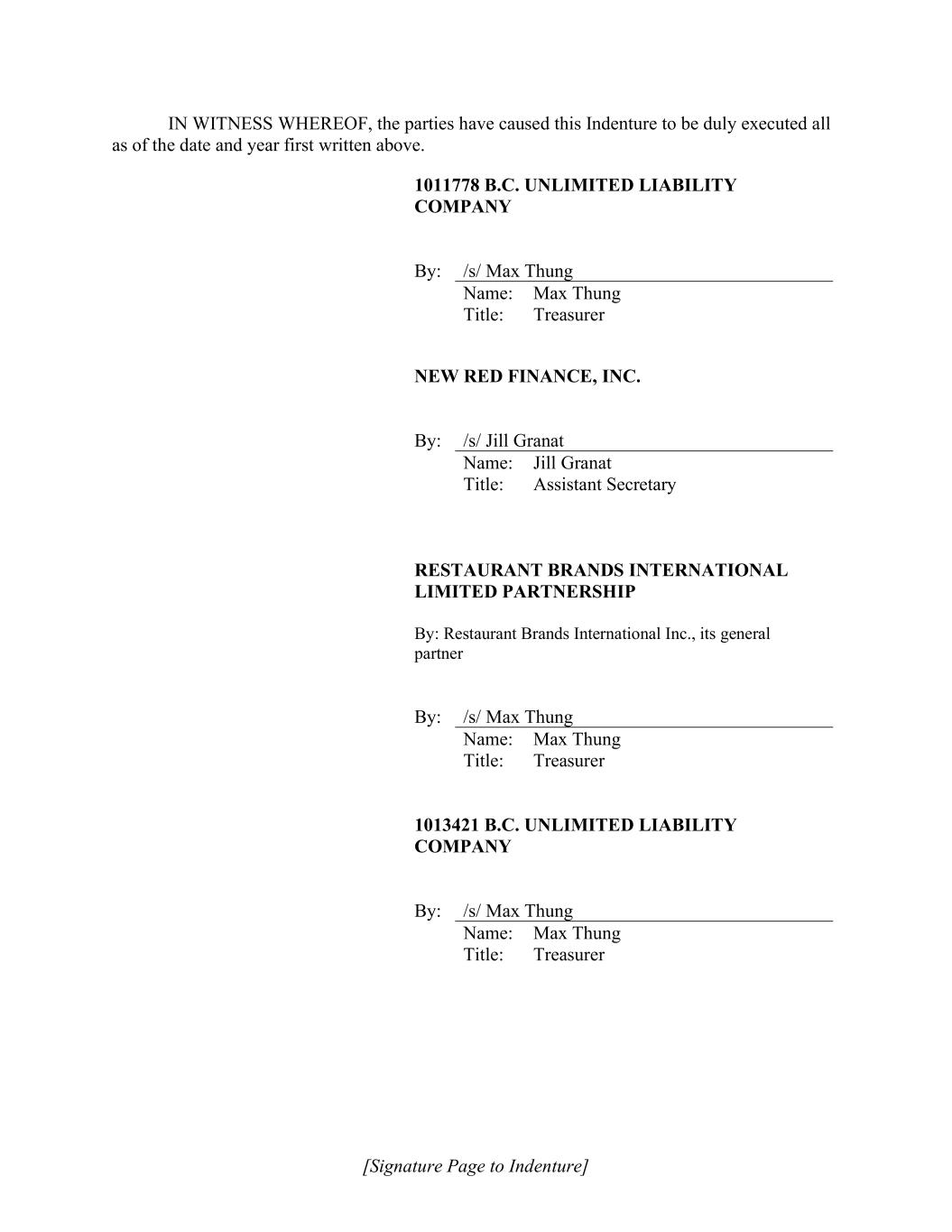
[Signature Page to Indenture] IN WITNESS WHEREOF, the parties have caused this Indenture to be duly executed all as of the date and year first written above. 1011778 B.C. UNLIMITED LIABILITY COMPANY By: /s/ Xxx Xxxxx Name: Xxx Xxxxx Title: Treasurer NEW RED FINANCE, INC. By: /s/ Xxxx Xxxxxx Name: Xxxx Xxxxxx Title: Assistant Secretary RESTAURANT BRANDS INTERNATIONAL LIMITED PARTNERSHIP By: Restaurant Brands International Inc., its general partner By: /s/ Xxx Xxxxx Name: Xxx Xxxxx Title: Treasurer 1013421 B.C. UNLIMITED LIABILITY COMPANY By: /s/ Xxx Xxxxx Name: Xxx Xxxxx Title: Treasurer
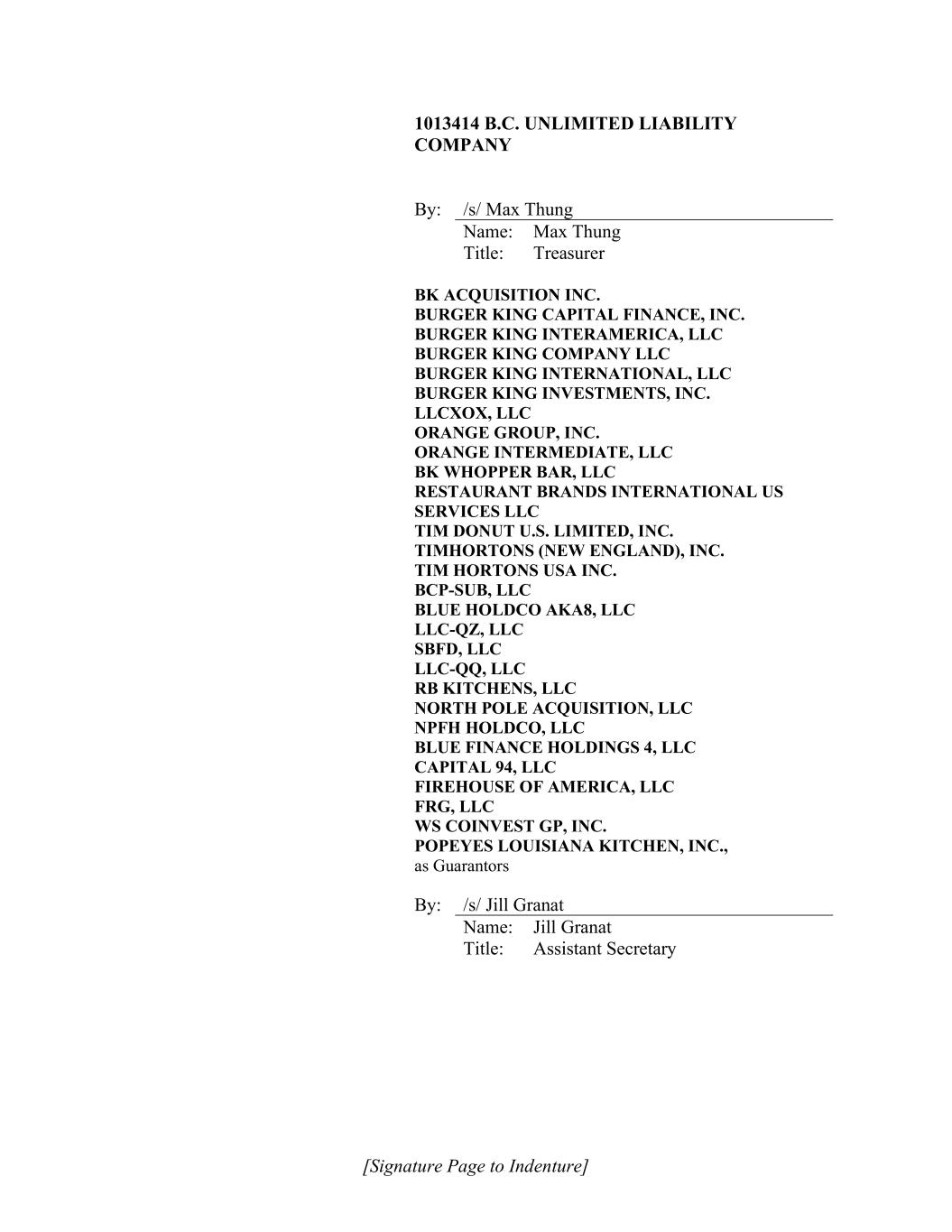
[Signature Page to Indenture] 1013414 B.C. UNLIMITED LIABILITY COMPANY By: /s/ Xxx Xxxxx Name: Xxx Xxxxx Title: Treasurer BK ACQUISITION INC. BURGER KING CAPITAL FINANCE, INC. BURGER KING INTERAMERICA, LLC BURGER KING COMPANY LLC BURGER KING INTERNATIONAL, LLC BURGER KING INVESTMENTS, INC. LLCXOX, LLC ORANGE GROUP, INC. ORANGE INTERMEDIATE, LLC BK WHOPPER BAR, LLC RESTAURANT BRANDS INTERNATIONAL US SERVICES LLC XXX DONUT U.S. LIMITED, INC. TIMHORTONS (NEW ENGLAND), INC. XXX HORTONS USA INC. BCP-SUB, LLC BLUE HOLDCO AKA8, LLC LLC-QZ, LLC SBFD, LLC LLC-QQ, LLC XX XXXXXXXX, LLC NORTH POLE ACQUISITION, LLC NPFH HOLDCO, LLC BLUE FINANCE HOLDINGS 4, LLC CAPITAL 94, LLC FIREHOUSE OF AMERICA, LLC FRG, LLC WS COINVEST GP, INC. POPEYES LOUISIANA KITCHEN, INC., as Guarantors By: /s/ Xxxx Xxxxxx Name: Xxxx Xxxxxx Title: Assistant Secretary
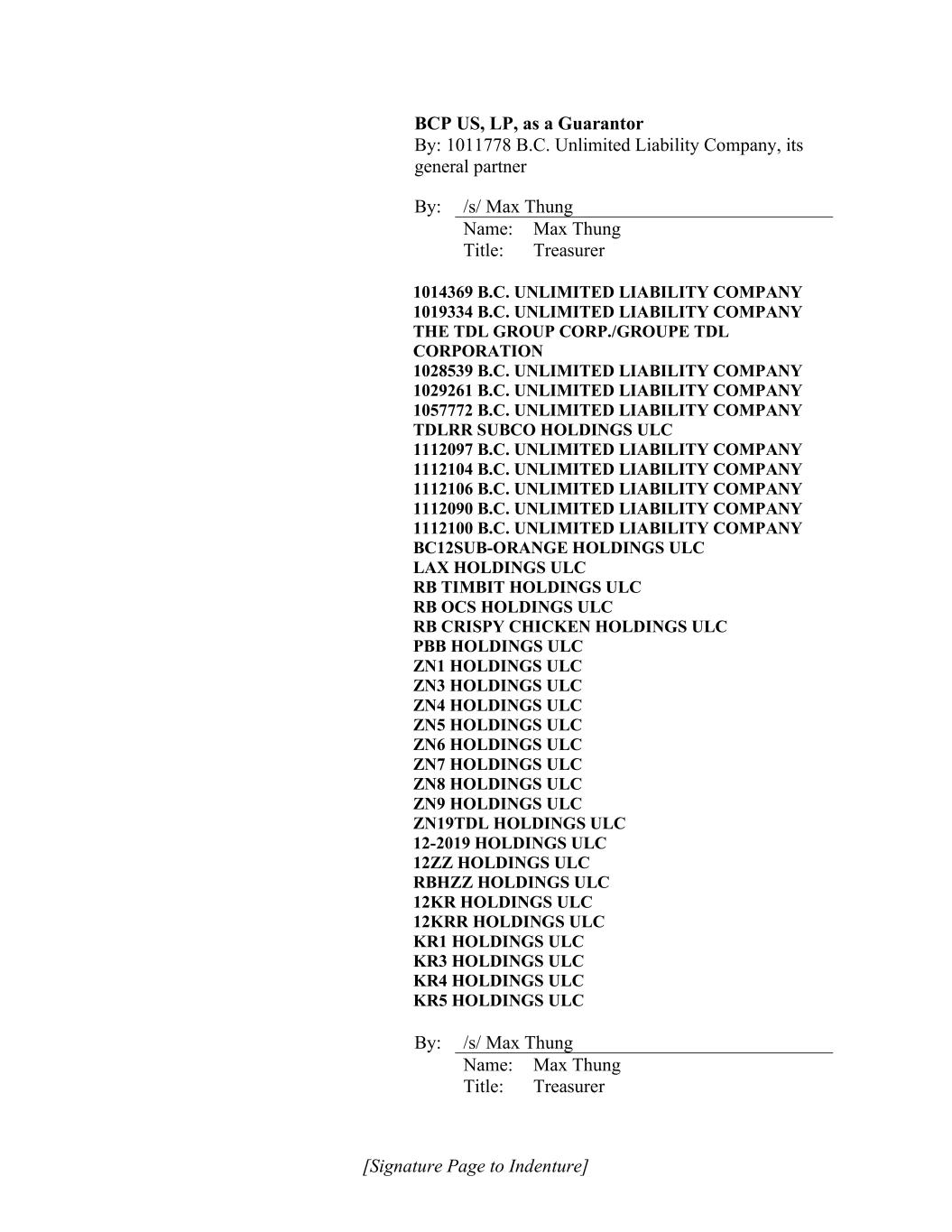
[Signature Page to Indenture] BCP US, LP, as a Guarantor By: 1011778 B.C. Unlimited Liability Company, its general partner By: /s/ Xxx Xxxxx Name: Xxx Xxxxx Title: Treasurer 1014369 B.C. UNLIMITED LIABILITY COMPANY 1019334 B.C. UNLIMITED LIABILITY COMPANY THE TDL GROUP CORP./GROUPE TDL CORPORATION 1028539 B.C. UNLIMITED LIABILITY COMPANY 1029261 B.C. UNLIMITED LIABILITY COMPANY 1057772 B.C. UNLIMITED LIABILITY COMPANY TDLRR SUBCO HOLDINGS ULC 1112097 B.C. UNLIMITED LIABILITY COMPANY 1112104 B.C. UNLIMITED LIABILITY COMPANY 1112106 B.C. UNLIMITED LIABILITY COMPANY 1112090 B.C. UNLIMITED LIABILITY COMPANY 1112100 B.C. UNLIMITED LIABILITY COMPANY BC12SUB-ORANGE HOLDINGS ULC LAX HOLDINGS ULC RB TIMBIT HOLDINGS ULC RB OCS HOLDINGS ULC RB CRISPY CHICKEN HOLDINGS ULC PBB HOLDINGS ULC ZN1 HOLDINGS ULC ZN3 HOLDINGS ULC ZN4 HOLDINGS ULC ZN5 HOLDINGS ULC ZN6 HOLDINGS ULC ZN7 HOLDINGS ULC ZN8 HOLDINGS ULC ZN9 HOLDINGS ULC ZN19TDL HOLDINGS ULC 12-2019 HOLDINGS ULC 12ZZ HOLDINGS ULC RBHZZ HOLDINGS ULC 12KR HOLDINGS ULC 12KRR HOLDINGS ULC KR1 HOLDINGS ULC KR3 HOLDINGS ULC KR4 HOLDINGS ULC KR5 HOLDINGS ULC By: /s/ Xxx Xxxxx Name: Xxx Xxxxx Title: Treasurer
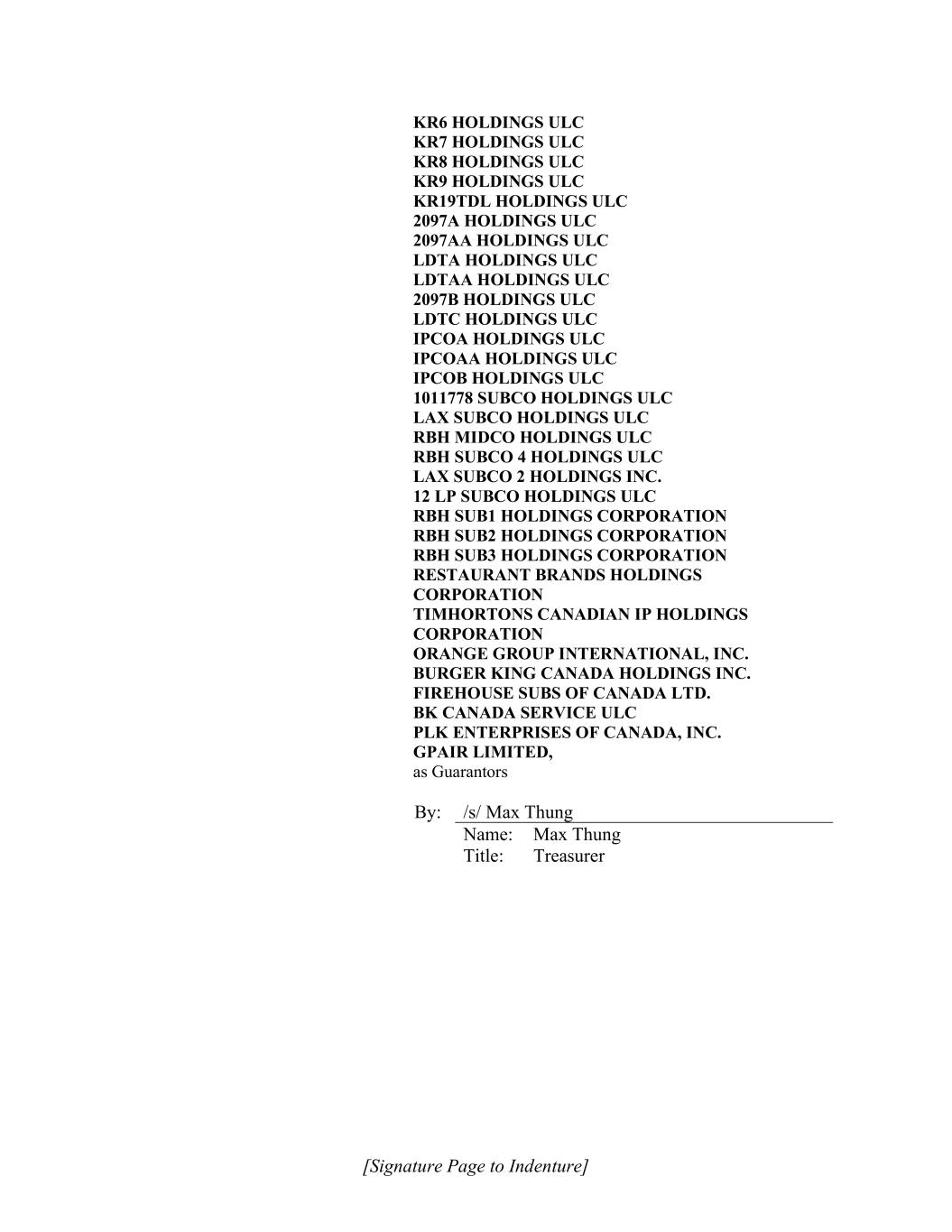
[Signature Page to Indenture] KR6 HOLDINGS ULC KR7 HOLDINGS ULC KR8 HOLDINGS ULC KR9 HOLDINGS ULC KR19TDL HOLDINGS ULC 2097A HOLDINGS ULC 2097AA HOLDINGS ULC LDTA HOLDINGS ULC LDTAA HOLDINGS ULC 2097B HOLDINGS ULC LDTC HOLDINGS ULC IPCOA HOLDINGS ULC IPCOAA HOLDINGS ULC IPCOB HOLDINGS ULC 1011778 SUBCO HOLDINGS ULC LAX SUBCO HOLDINGS ULC RBH MIDCO HOLDINGS ULC RBH SUBCO 4 HOLDINGS ULC LAX SUBCO 2 HOLDINGS INC. 12 LP SUBCO HOLDINGS ULC RBH SUB1 HOLDINGS CORPORATION RBH SUB2 HOLDINGS CORPORATION RBH SUB3 HOLDINGS CORPORATION RESTAURANT BRANDS HOLDINGS CORPORATION TIMHORTONS CANADIAN IP HOLDINGS CORPORATION ORANGE GROUP INTERNATIONAL, INC. BURGER KING CANADA HOLDINGS INC. FIREHOUSE SUBS OF CANADA LTD. BK CANADA SERVICE ULC PLK ENTERPRISES OF CANADA, INC. GPAIR LIMITED, as Guarantors By: /s/ Xxx Xxxxx Name: Xxx Xxxxx Title: Treasurer
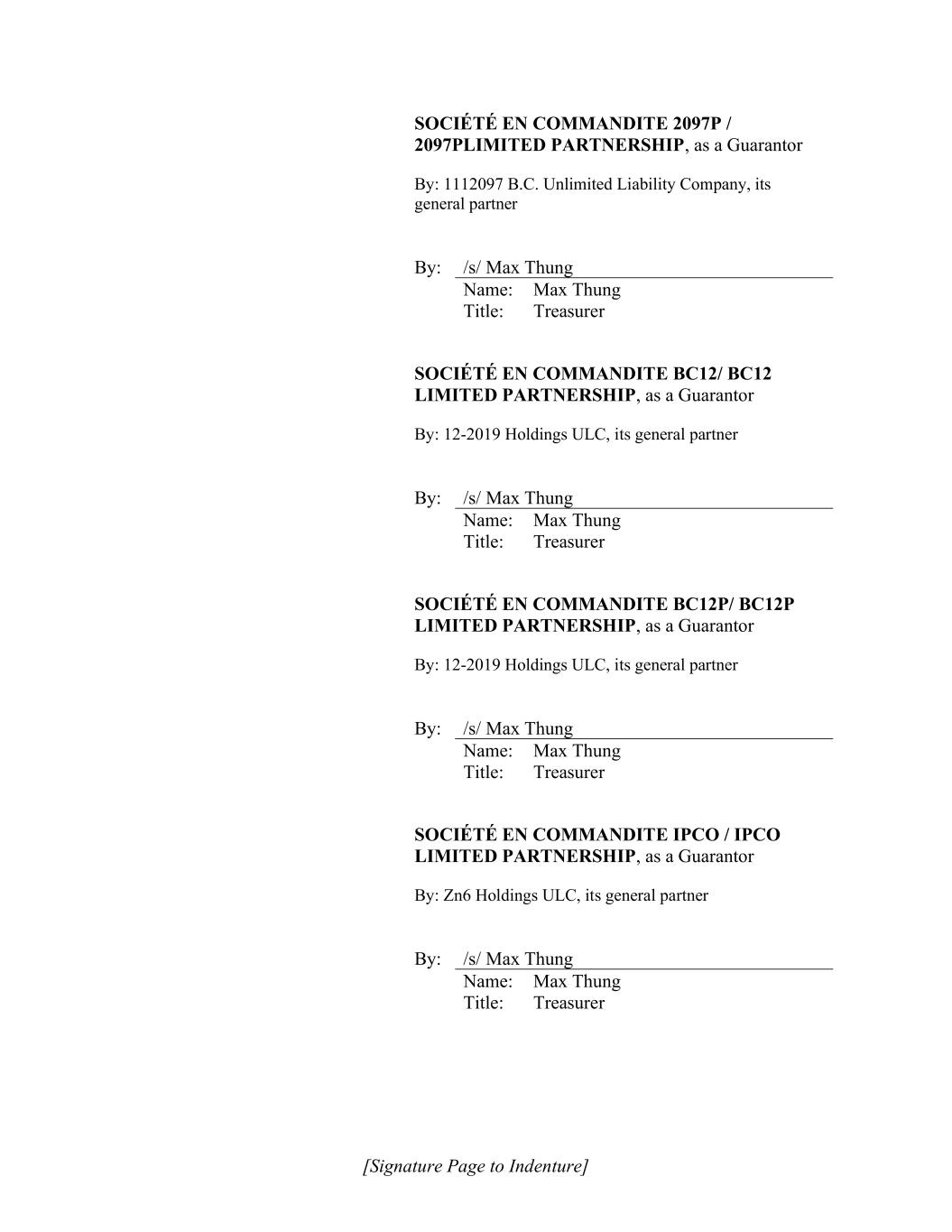
[Signature Page to Indenture] SOCIÉTÉ EN COMMANDITE 2097P / 2097PLIMITED PARTNERSHIP, as a Guarantor By: 1112097 B.C. Unlimited Liability Company, its general partner By: /s/ Xxx Xxxxx Name: Xxx Xxxxx Title: Treasurer SOCIÉTÉ EN COMMANDITE BC12/ BC12 LIMITED PARTNERSHIP, as a Guarantor By: 12-2019 Holdings ULC, its general partner By: /s/ Xxx Xxxxx Name: Xxx Xxxxx Title: Treasurer SOCIÉTÉ EN COMMANDITE BC12P/ BC12P LIMITED PARTNERSHIP, as a Guarantor By: 12-2019 Holdings ULC, its general partner By: /s/ Xxx Xxxxx Name: Xxx Xxxxx Title: Treasurer SOCIÉTÉ EN COMMANDITE IPCO / IPCO LIMITED PARTNERSHIP, as a Guarantor By: Zn6 Holdings ULC, its general partner By: /s/ Xxx Xxxxx Name: Xxx Xxxxx Title: Treasurer
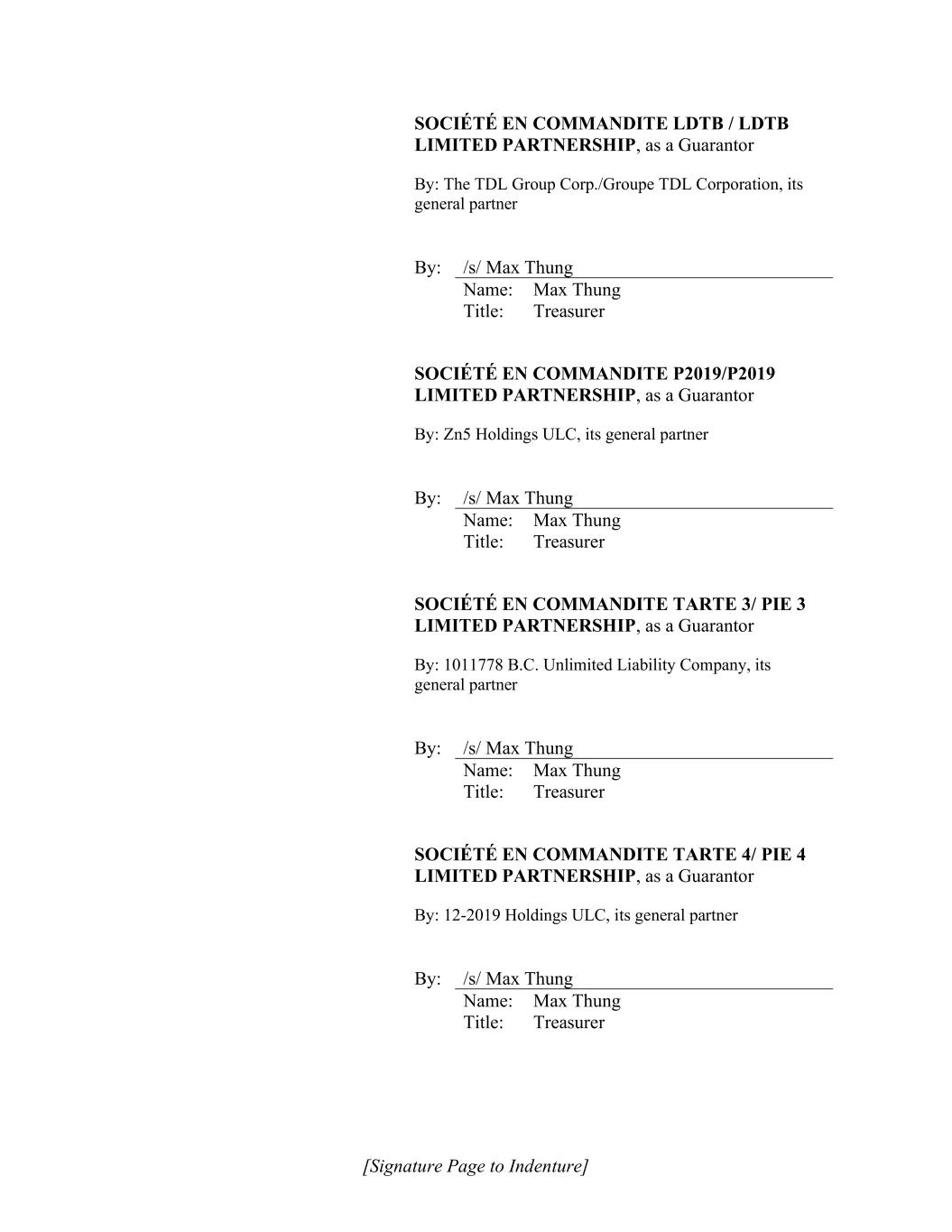
[Signature Page to Indenture] SOCIÉTÉ EN COMMANDITE LDTB / LDTB LIMITED PARTNERSHIP, as a Guarantor By: The TDL Group Corp./Groupe TDL Corporation, its general partner By: /s/ Xxx Xxxxx Name: Xxx Xxxxx Title: Treasurer SOCIÉTÉ EN COMMANDITE P2019/P2019 LIMITED PARTNERSHIP, as a Guarantor By: Zn5 Holdings ULC, its general partner By: /s/ Xxx Xxxxx Name: Xxx Xxxxx Title: Treasurer SOCIÉTÉ EN COMMANDITE TARTE 3/ PIE 3 LIMITED PARTNERSHIP, as a Guarantor By: 1011778 B.C. Unlimited Liability Company, its general partner By: /s/ Xxx Xxxxx Name: Xxx Xxxxx Title: Treasurer SOCIÉTÉ EN COMMANDITE TARTE 4/ PIE 4 LIMITED PARTNERSHIP, as a Guarantor By: 12-2019 Holdings ULC, its general partner By: /s/ Xxx Xxxxx Name: Xxx Xxxxx Title: Treasurer

[Signature Page to Indenture] WILMINGTON TRUST, NATIONAL ASSOCIATION, as Trustee and Collateral Agent By: /s/ Xxxxxxx X. Xxxxxxxx Name: Xxxxxxx X. Xxxxxxxx Title: Assistant Vice President
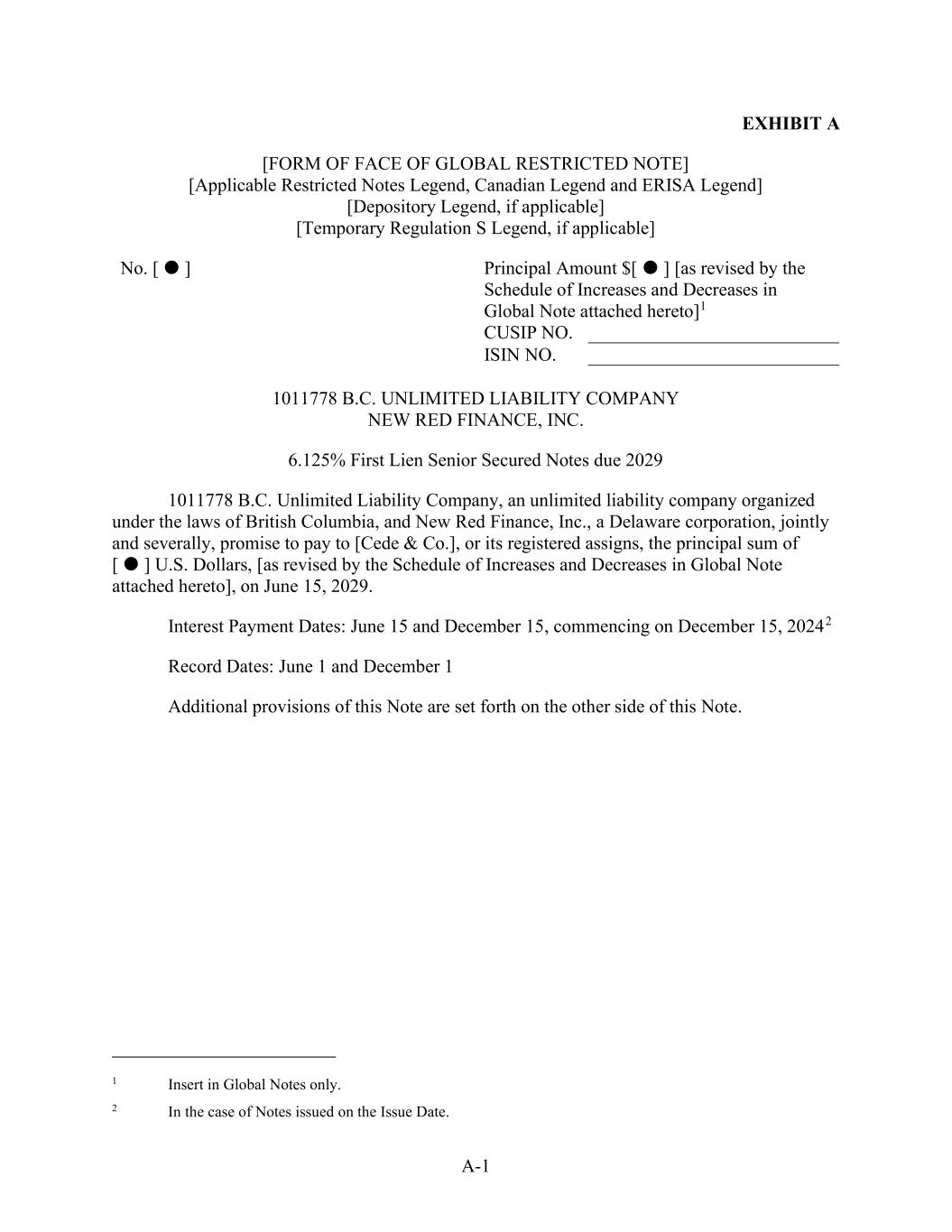
A-1 EXHIBIT A [FORM OF FACE OF GLOBAL RESTRICTED NOTE] [Applicable Restricted Notes Legend, Canadian Legend and ERISA Legend] [Depository Legend, if applicable] [Temporary Regulation S Legend, if applicable] No. [ ] Principal Amount $[ ] [as revised by the Schedule of Increases and Decreases in Global Note attached hereto]1 CUSIP NO. ISIN NO. 1011778 B.C. UNLIMITED LIABILITY COMPANY NEW RED FINANCE, INC. 6.125% First Lien Senior Secured Notes due 2029 1011778 B.C. Unlimited Liability Company, an unlimited liability company organized under the laws of British Columbia, and New Red Finance, Inc., a Delaware corporation, jointly and severally, promise to pay to [Cede & Co.], or its registered assigns, the principal sum of [ ] U.S. Dollars, [as revised by the Schedule of Increases and Decreases in Global Note attached hereto], on June 15, 2029. Interest Payment Dates: June 15 and December 15, commencing on December 15, 20242 Record Dates: June 1 and December 1 Additional provisions of this Note are set forth on the other side of this Note. 1 Insert in Global Notes only. 2 In the case of Notes issued on the Issue Date.
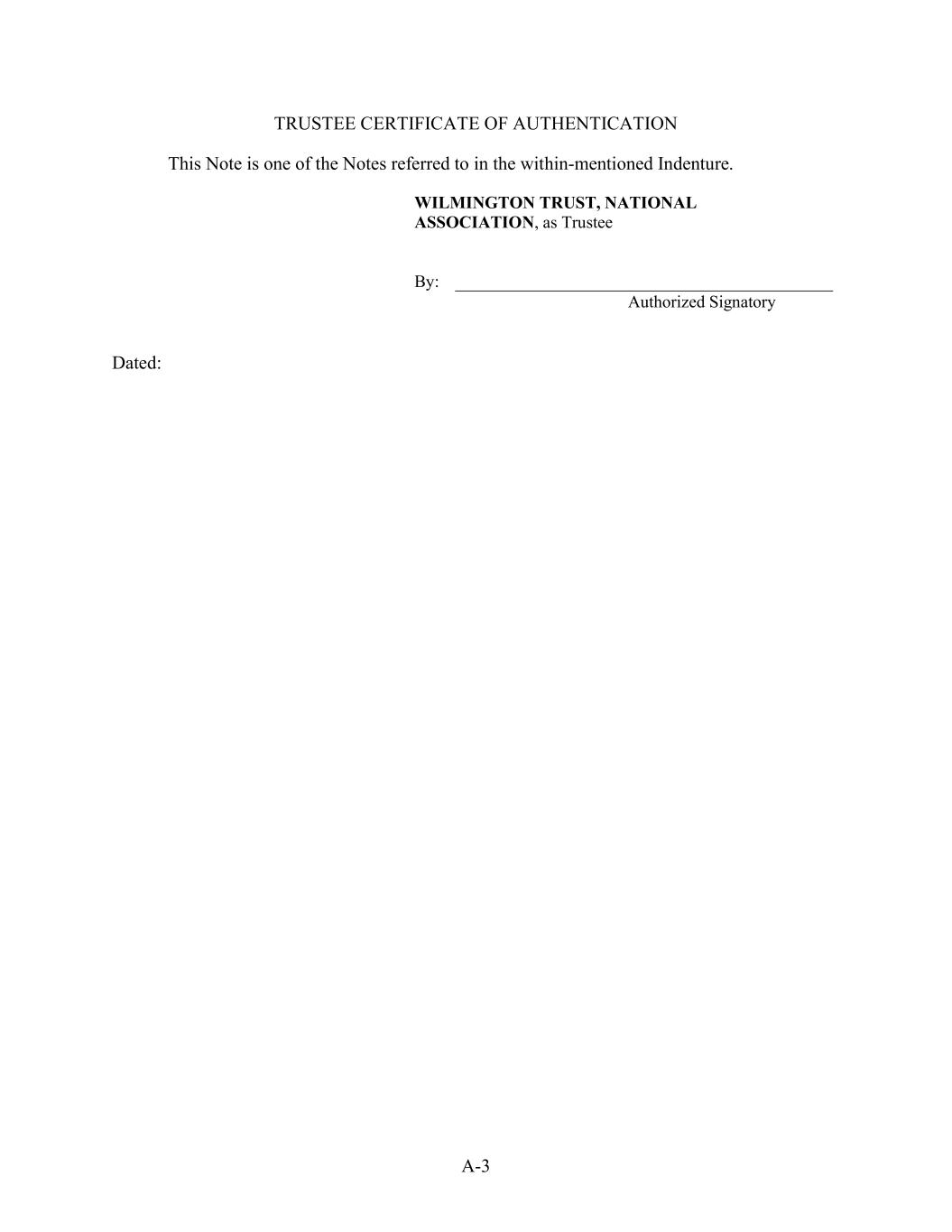
A-3 TRUSTEE CERTIFICATE OF AUTHENTICATION This Note is one of the Notes referred to in the within-mentioned Indenture. WILMINGTON TRUST, NATIONAL ASSOCIATION, as Trustee By: Authorized Signatory Dated:
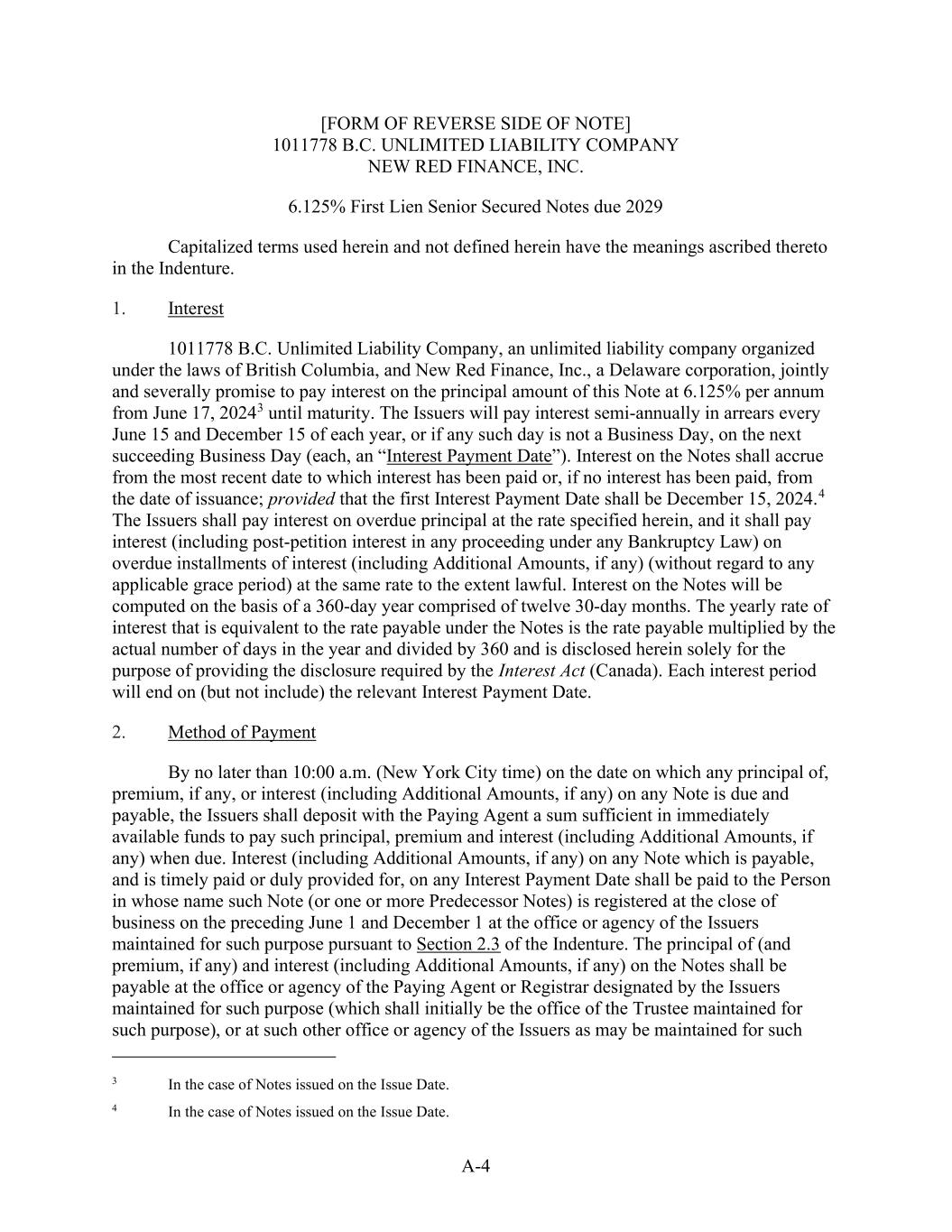
A-4 [FORM OF REVERSE SIDE OF NOTE] 1011778 B.C. UNLIMITED LIABILITY COMPANY NEW RED FINANCE, INC. 6.125% First Lien Senior Secured Notes due 2029 Capitalized terms used herein and not defined herein have the meanings ascribed thereto in the Indenture. 1. Interest 1011778 B.C. Unlimited Liability Company, an unlimited liability company organized under the laws of British Columbia, and New Red Finance, Inc., a Delaware corporation, jointly and severally promise to pay interest on the principal amount of this Note at 6.125% per annum from June 17, 20243 until maturity. The Issuers will pay interest semi-annually in arrears every June 15 and December 15 of each year, or if any such day is not a Business Day, on the next succeeding Business Day (each, an “Interest Payment Date”). Interest on the Notes shall accrue from the most recent date to which interest has been paid or, if no interest has been paid, from the date of issuance; provided that the first Interest Payment Date shall be December 15, 2024.4 The Issuers shall pay interest on overdue principal at the rate specified herein, and it shall pay interest (including post-petition interest in any proceeding under any Bankruptcy Law) on overdue installments of interest (including Additional Amounts, if any) (without regard to any applicable grace period) at the same rate to the extent lawful. Interest on the Notes will be computed on the basis of a 360-day year comprised of twelve 30-day months. The yearly rate of interest that is equivalent to the rate payable under the Notes is the rate payable multiplied by the actual number of days in the year and divided by 360 and is disclosed herein solely for the purpose of providing the disclosure required by the Interest Act (Canada). Each interest period will end on (but not include) the relevant Interest Payment Date. 2. Method of Payment By no later than 10:00 a.m. (New York City time) on the date on which any principal of, premium, if any, or interest (including Additional Amounts, if any) on any Note is due and payable, the Issuers shall deposit with the Paying Agent a sum sufficient in immediately available funds to pay such principal, premium and interest (including Additional Amounts, if any) when due. Interest (including Additional Amounts, if any) on any Note which is payable, and is timely paid or duly provided for, on any Interest Payment Date shall be paid to the Person in whose name such Note (or one or more Predecessor Notes) is registered at the close of business on the preceding June 1 and December 1 at the office or agency of the Issuers maintained for such purpose pursuant to Section 2.3 of the Indenture. The principal of (and premium, if any) and interest (including Additional Amounts, if any) on the Notes shall be payable at the office or agency of the Paying Agent or Registrar designated by the Issuers maintained for such purpose (which shall initially be the office of the Trustee maintained for such purpose), or at such other office or agency of the Issuers as may be maintained for such 3 In the case of Notes issued on the Issue Date. 4 In the case of Notes issued on the Issue Date.
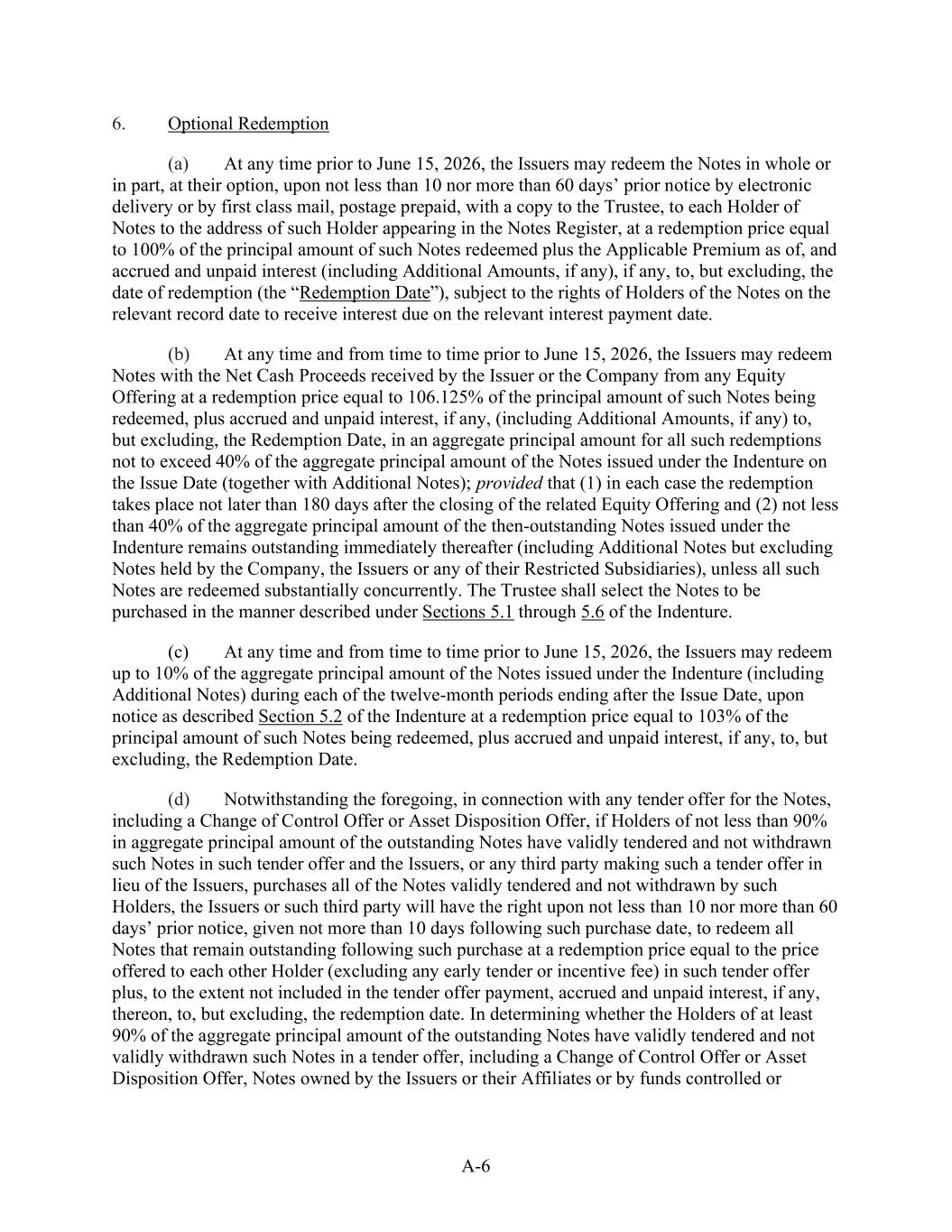
A-6 6. Optional Redemption (a) At any time prior to June 15, 2026, the Issuers may redeem the Notes in whole or in part, at their option, upon not less than 10 nor more than 60 days’ prior notice by electronic delivery or by first class mail, postage prepaid, with a copy to the Trustee, to each Holder of Notes to the address of such Holder appearing in the Notes Register, at a redemption price equal to 100% of the principal amount of such Notes redeemed plus the Applicable Premium as of, and accrued and unpaid interest (including Additional Amounts, if any), if any, to, but excluding, the date of redemption (the “Redemption Date”), subject to the rights of Holders of the Notes on the relevant record date to receive interest due on the relevant interest payment date. (b) At any time and from time to time prior to June 15, 2026, the Issuers may redeem Notes with the Net Cash Proceeds received by the Issuer or the Company from any Equity Offering at a redemption price equal to 106.125% of the principal amount of such Notes being redeemed, plus accrued and unpaid interest, if any, (including Additional Amounts, if any) to, but excluding, the Redemption Date, in an aggregate principal amount for all such redemptions not to exceed 40% of the aggregate principal amount of the Notes issued under the Indenture on the Issue Date (together with Additional Notes); provided that (1) in each case the redemption takes place not later than 180 days after the closing of the related Equity Offering and (2) not less than 40% of the aggregate principal amount of the then-outstanding Notes issued under the Indenture remains outstanding immediately thereafter (including Additional Notes but excluding Notes held by the Company, the Issuers or any of their Restricted Subsidiaries), unless all such Notes are redeemed substantially concurrently. The Trustee shall select the Notes to be purchased in the manner described under Sections 5.1 through 5.6 of the Indenture. (c) At any time and from time to time prior to June 15, 2026, the Issuers may redeem up to 10% of the aggregate principal amount of the Notes issued under the Indenture (including Additional Notes) during each of the twelve-month periods ending after the Issue Date, upon notice as described Section 5.2 of the Indenture at a redemption price equal to 103% of the principal amount of such Notes being redeemed, plus accrued and unpaid interest, if any, to, but excluding, the Redemption Date. (d) Notwithstanding the foregoing, in connection with any tender offer for the Notes, including a Change of Control Offer or Asset Disposition Offer, if Holders of not less than 90% in aggregate principal amount of the outstanding Notes have validly tendered and not withdrawn such Notes in such tender offer and the Issuers, or any third party making such a tender offer in lieu of the Issuers, purchases all of the Notes validly tendered and not withdrawn by such Holders, the Issuers or such third party will have the right upon not less than 10 nor more than 60 days’ prior notice, given not more than 10 days following such purchase date, to redeem all Notes that remain outstanding following such purchase at a redemption price equal to the price offered to each other Holder (excluding any early tender or incentive fee) in such tender offer plus, to the extent not included in the tender offer payment, accrued and unpaid interest, if any, thereon, to, but excluding, the redemption date. In determining whether the Holders of at least 90% of the aggregate principal amount of the outstanding Notes have validly tendered and not validly withdrawn such Notes in a tender offer, including a Change of Control Offer or Asset Disposition Offer, Notes owned by the Issuers or their Affiliates or by funds controlled or
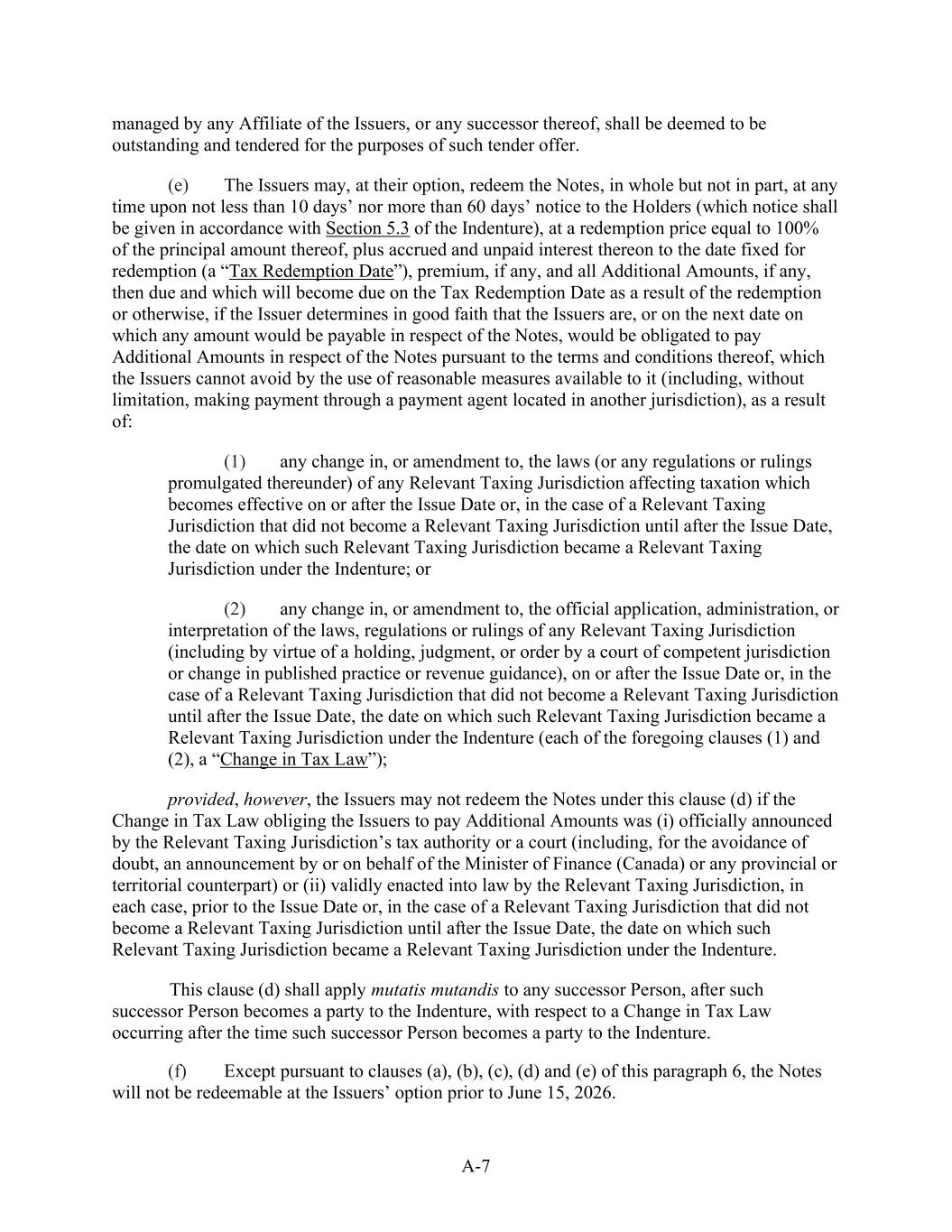
A-7 managed by any Affiliate of the Issuers, or any successor thereof, shall be deemed to be outstanding and tendered for the purposes of such tender offer. (e) The Issuers may, at their option, redeem the Notes, in whole but not in part, at any time upon not less than 10 days’ nor more than 60 days’ notice to the Holders (which notice shall be given in accordance with Section 5.3 of the Indenture), at a redemption price equal to 100% of the principal amount thereof, plus accrued and unpaid interest thereon to the date fixed for redemption (a “Tax Redemption Date”), premium, if any, and all Additional Amounts, if any, then due and which will become due on the Tax Redemption Date as a result of the redemption or otherwise, if the Issuer determines in good faith that the Issuers are, or on the next date on which any amount would be payable in respect of the Notes, would be obligated to pay Additional Amounts in respect of the Notes pursuant to the terms and conditions thereof, which the Issuers cannot avoid by the use of reasonable measures available to it (including, without limitation, making payment through a payment agent located in another jurisdiction), as a result of: (1) any change in, or amendment to, the laws (or any regulations or rulings promulgated thereunder) of any Relevant Taxing Jurisdiction affecting taxation which becomes effective on or after the Issue Date or, in the case of a Relevant Taxing Jurisdiction that did not become a Relevant Taxing Jurisdiction until after the Issue Date, the date on which such Relevant Taxing Jurisdiction became a Relevant Taxing Jurisdiction under the Indenture; or (2) any change in, or amendment to, the official application, administration, or interpretation of the laws, regulations or rulings of any Relevant Taxing Jurisdiction (including by virtue of a holding, judgment, or order by a court of competent jurisdiction or change in published practice or revenue guidance), on or after the Issue Date or, in the case of a Relevant Taxing Jurisdiction that did not become a Relevant Taxing Jurisdiction until after the Issue Date, the date on which such Relevant Taxing Jurisdiction became a Relevant Taxing Jurisdiction under the Indenture (each of the foregoing clauses (1) and (2), a “Change in Tax Law”); provided, however, the Issuers may not redeem the Notes under this clause (d) if the Change in Tax Law obliging the Issuers to pay Additional Amounts was (i) officially announced by the Relevant Taxing Jurisdiction’s tax authority or a court (including, for the avoidance of doubt, an announcement by or on behalf of the Minister of Finance (Canada) or any provincial or territorial counterpart) or (ii) validly enacted into law by the Relevant Taxing Jurisdiction, in each case, prior to the Issue Date or, in the case of a Relevant Taxing Jurisdiction that did not become a Relevant Taxing Jurisdiction until after the Issue Date, the date on which such Relevant Taxing Jurisdiction became a Relevant Taxing Jurisdiction under the Indenture. This clause (d) shall apply mutatis mutandis to any successor Person, after such successor Persxx xxxomes a party to the Indenture, with respect to a Change in Tax Law occurring after the time such successor Person becomes a party to the Indenture. (f) Except pursuant to clauses (a), (b), (c), (d) and (e) of this paragraph 6, the Notes will not be redeemable at the Issuers’ option prior to June 15, 2026.
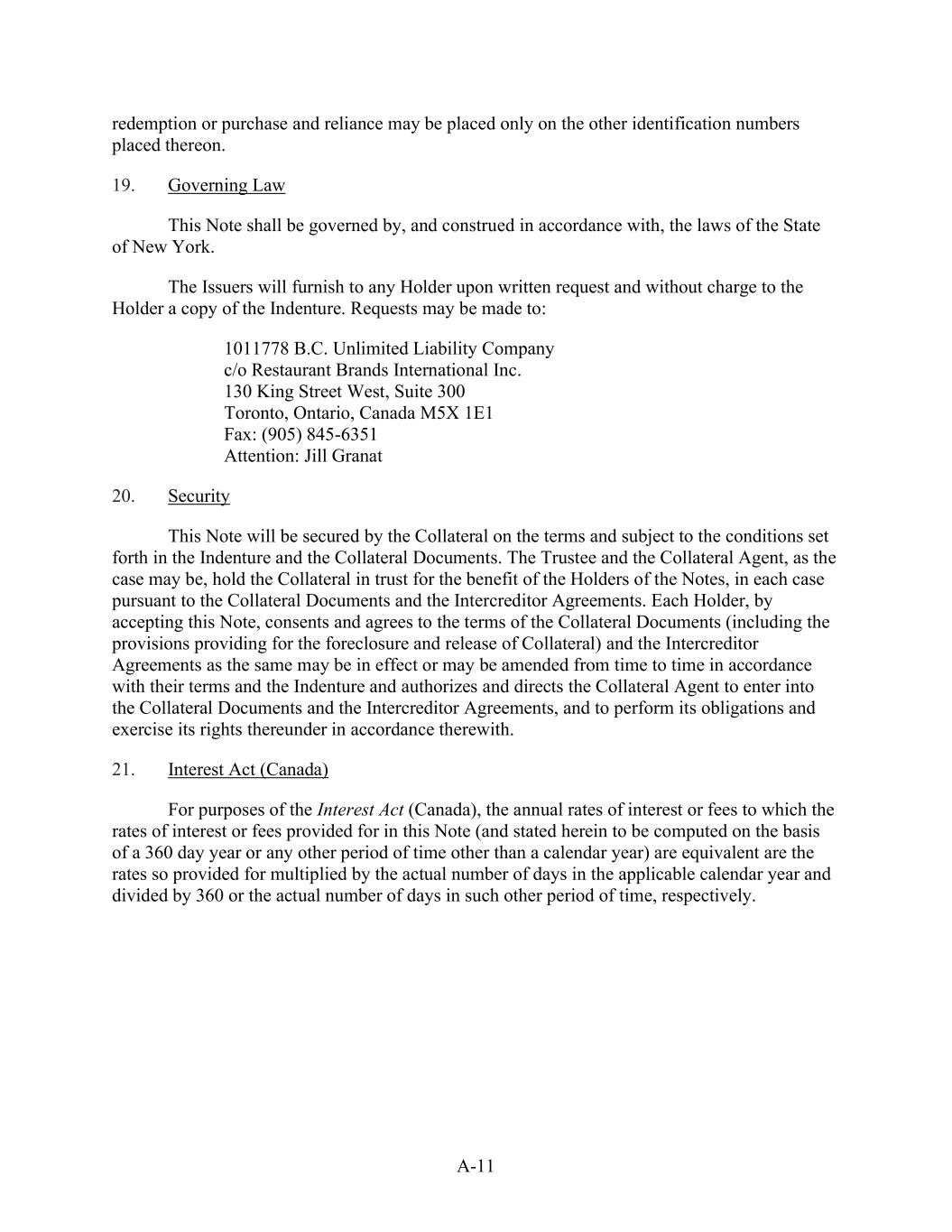
A-11 redemption or purchase and reliance may be placed only on the other identification numbers placed thereon. 19. Governing Law This Note shall be governed by, and construed in accordance with, the laws of the State of New York. The Issuers will furnish to any Holder upon written request and without charge to the Holder a copy of the Indenture. Requests may be made to: 1011778 B.C. Unlimited Liability Company c/o Restaurant Brands International Inc. 000 Xxxx Xxxxxx Xxxx, Xxxxx 000 Xxxxxxx, Xxxxxxx, Xxxxxx X0X 0X0 Fax: (000) 000-0000 Attention: Xxxx Xxxxxx 20. Security This Note will be secured by the Collateral on the terms and subject to the conditions set forth in the Indenture and the Collateral Documents. The Trustee and the Collateral Agent, as the case may be, hold the Collateral in trust for the benefit of the Holders of the Notes, in each case pursuant to the Collateral Documents and the Intercreditor Agreements. Each Holder, by accepting this Note, consents and agrees to the terms of the Collateral Documents (including the provisions providing for the foreclosure and release of Collateral) and the Intercreditor Agreements as the same may be in effect or may be amended from time to time in accordance with their terms and the Indenture and authorizes and directs the Collateral Agent to enter into the Collateral Documents and the Intercreditor Agreements, and to perform its obligations and exercise its rights thereunder in accordance therewith. 21. Interest Act (Canada) For purposes of the Interest Act (Canada), the annual rates of interest or fees to which the rates of interest or fees provided for in this Note (and stated herein to be computed on the basis of a 360 day year or any other period of time other than a calendar year) are equivalent are the rates so provided for multiplied by the actual number of days in the applicable calendar year and divided by 360 or the actual number of days in such other period of time, respectively.
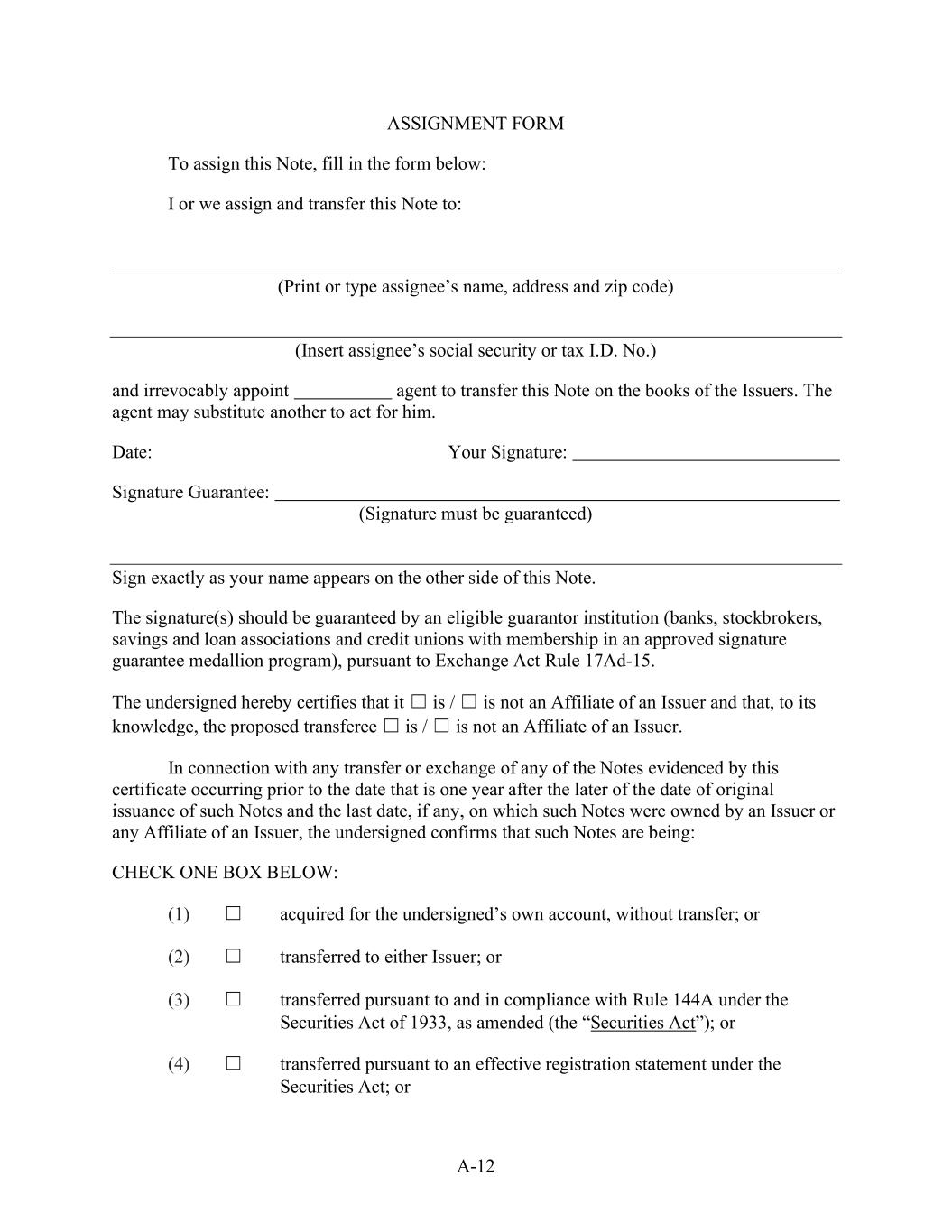
A-12 ASSIGNMENT FORM To assign this Note, fill in the form below: I or we assign and transfer this Note to: (Print or type assignee’s name, address and zip code) (Insert assignee’s social security or tax I.D. No.) and irrevocably appoint agent to transfer this Note on the books of the Issuers. The agent may substitute another to act for him. Date: Your Signature: Signature Guarantee: (Signature must be guaranteed) Sign exactly as your name appears on the other side of this Note. The signature(s) should be guaranteed by an eligible guarantor institution (banks, stockbrokers, savings and loan associations and credit unions with membership in an approved signature guarantee medallion program), pursuant to Exchange Act Rule 17Ad-15. The undersigned hereby certifies that it ☐ is / ☐ is not an Affiliate of an Issuer and that, to its knowledge, the proposed transferee ☐ is / ☐ is not an Affiliate of an Issuer. In connection with any transfer or exchange of any of the Notes evidenced by this certificate occurring prior to the date that is one year after the later of the date of original issuance of such Notes and the last date, if any, on which such Notes were owned by an Issuer or any Affiliate of an Issuer, the undersigned confirms that such Notes are being: CHECK ONE BOX BELOW: (1) ☐ acquired for the undersigned’s own account, without transfer; or (2) ☐ transferred to either Issuer; or (3) ☐ transferred pursuant to and in compliance with Rule 144A under the Securities Act of 1933, as amended (the “Securities Act”); or (4) ☐ transferred pursuant to an effective registration statement under the Securities Act; or
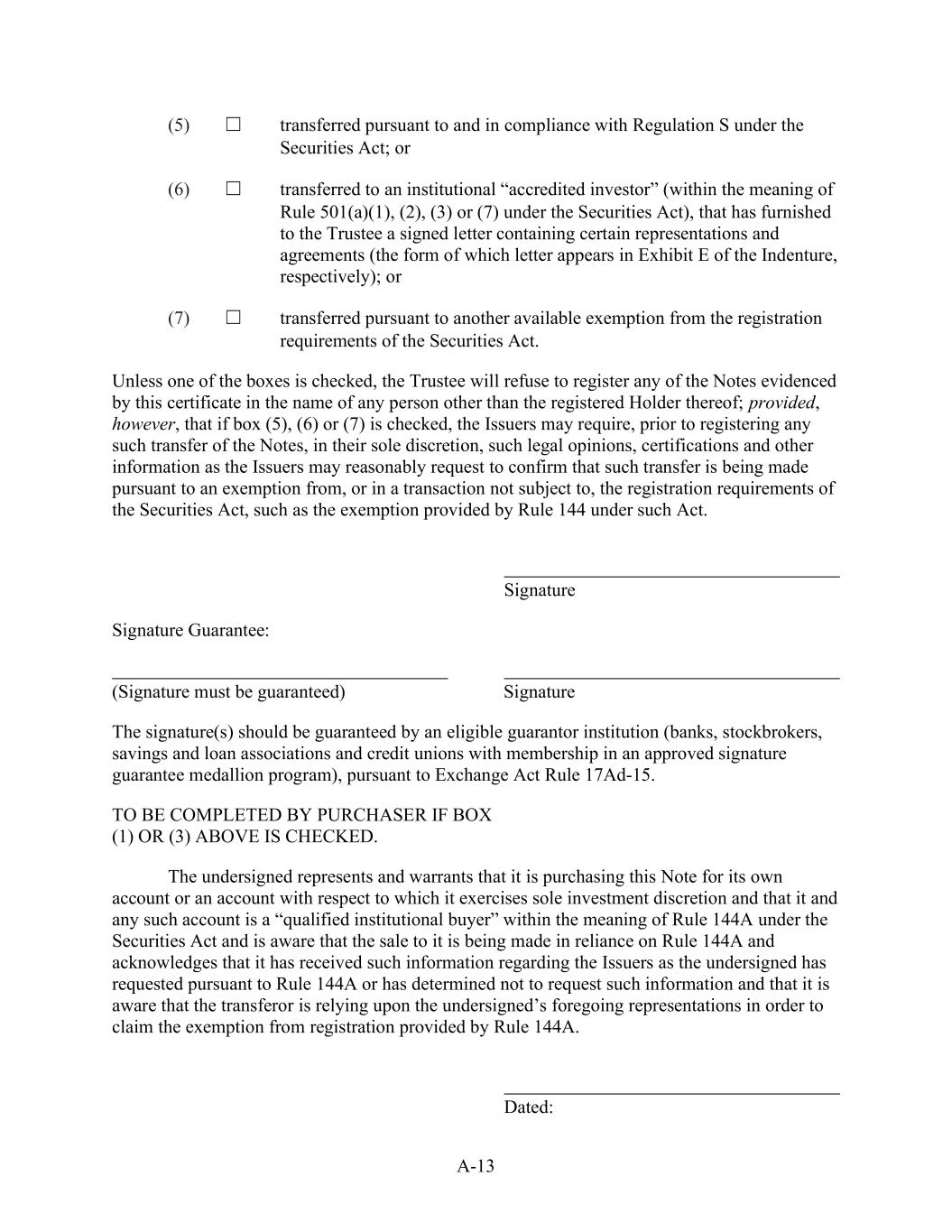
A-13 (5) ☐ transferred pursuant to and in compliance with Regulation S under the Securities Act; or (6) ☐ transferred to an institutional “accredited investor” (within the meaning of Rule 501(a)(1), (2), (3) or (7) under the Securities Act), that has furnished to the Trustee a signed letter containing certain representations and agreements (the form of which letter appears in Exhibit E of the Indenture, respectively); or (7) ☐ transferred pursuant to another available exemption from the registration requirements of the Securities Act. Unless one of the boxes is checked, the Trustee will refuse to register any of the Notes evidenced by this certificate in the name of any person other than the registered Holder thereof; provided, however, that if box (5), (6) or (7) is checked, the Issuers may require, prior to registering any such transfer of the Notes, in their sole discretion, such legal opinions, certifications and other information as the Issuers may reasonably request to confirm that such transfer is being made pursuant to an exemption from, or in a transaction not subject to, the registration requirements of the Securities Act, such as the exemption provided by Rule 144 under such Act. Signature Signature Guarantee: (Signature must be guaranteed) Signature The signature(s) should be guaranteed by an eligible guarantor institution (banks, stockbrokers, savings and loan associations and credit unions with membership in an approved signature guarantee medallion program), pursuant to Exchange Act Rule 17Ad-15. TO BE COMPLETED BY PURCHASER IF BOX (1) OR (3) ABOVE IS CHECKED. The undersigned represents and warrants that it is purchasing this Note for its own account or an account with respect to which it exercises sole investment discretion and that it and any such account is a “qualified institutional buyer” within the meaning of Rule 144A under the Securities Act and is aware that the sale to it is being made in reliance on Rule 144A and acknowledges that it has received such information regarding the Issuers as the undersigned has requested pursuant to Rule 144A or has determined not to request such information and that it is aware that the transferor is relying upon the undersigned’s foregoing representations in order to claim the exemption from registration provided by Rule 144A. Dated:
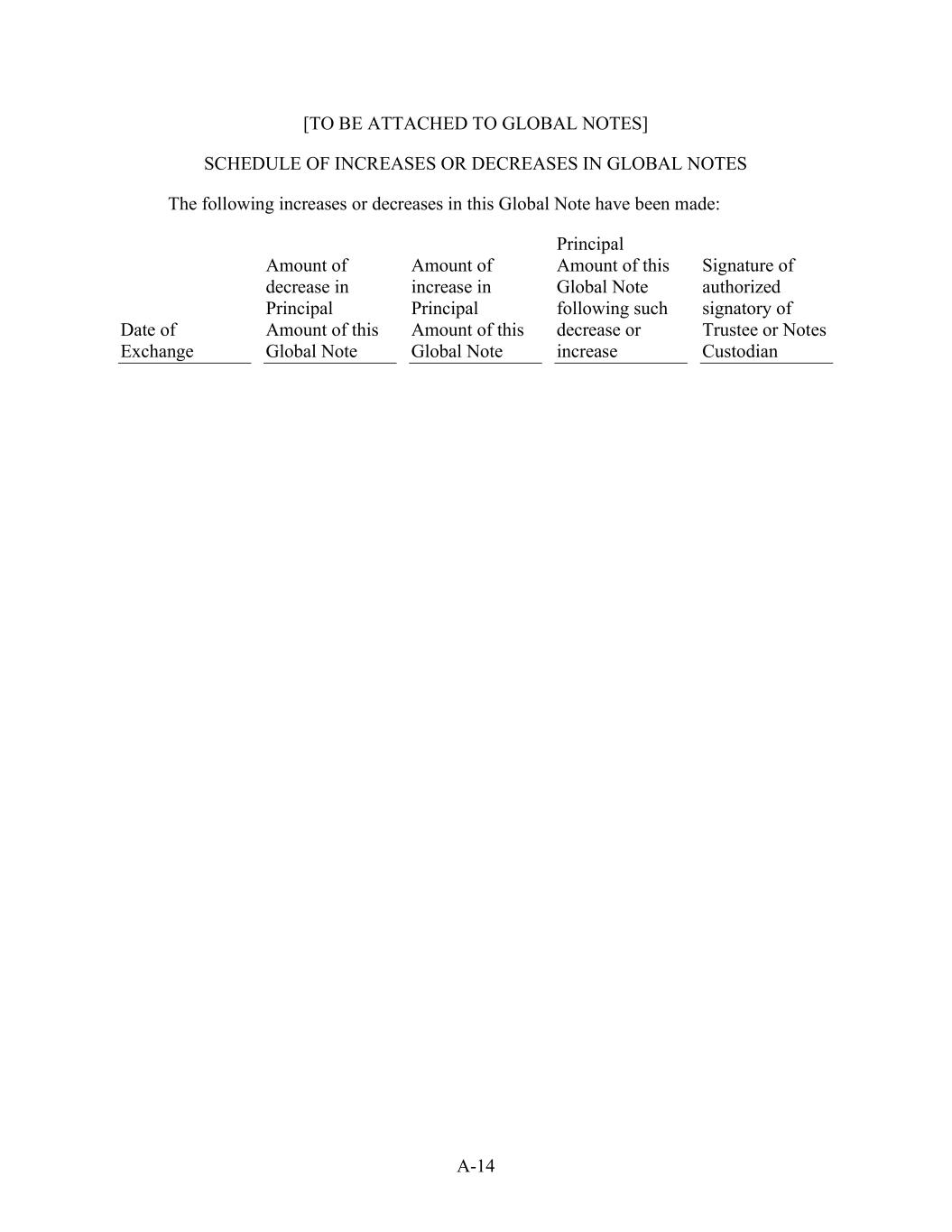
A-14 [TO BE ATTACHED TO GLOBAL NOTES] SCHEDULE OF INCREASES OR DECREASES IN GLOBAL NOTES The following increases or decreases in this Global Note have been made: Date of Exchange Amount of decrease in Principal Amount of this Global Note Amount of increase in Principal Amount of this Global Note Principal Amount of this Global Note following such decrease or increase Signature of authorized signatory of Trustee or Notes Custodian
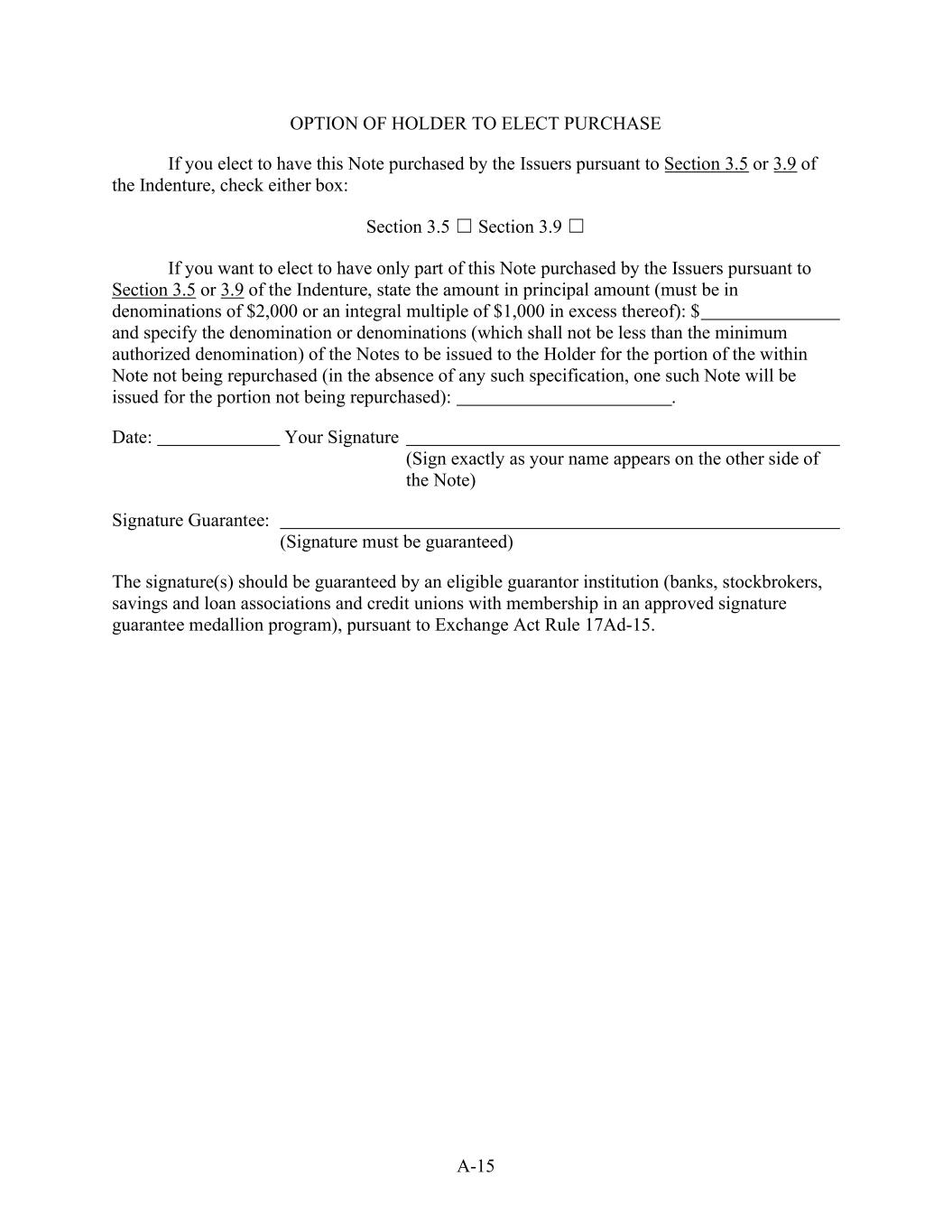
A-15 OPTION OF HOLDER TO ELECT PURCHASE If you elect to have this Note purchased by the Issuers pursuant to Section 3.5 or 3.9 of the Indenture, check either box: Section 3.5 ☐ Section 3.9 ☐ If you want to elect to have only part of this Note purchased by the Issuers pursuant to Section 3.5 or 3.9 of the Indenture, state the amount in principal amount (must be in denominations of $2,000 or an integral multiple of $1,000 in excess thereof): $ and specify the denomination or denominations (which shall not be less than the minimum authorized denomination) of the Notes to be issued to the Holder for the portion of the within Note not being repurchased (in the absence of any such specification, one such Note will be issued for the portion not being repurchased): . Date: Your Signature (Sign exactly as your name appears on the other side of the Note) Signature Guarantee: (Signature must be guaranteed) The signature(s) should be guaranteed by an eligible guarantor institution (banks, stockbrokers, savings and loan associations and credit unions with membership in an approved signature guarantee medallion program), pursuant to Exchange Act Rule 17Ad-15.

B-5 WILMINGTON TRUST, NATIONAL ASSOCIATION, as Trustee and Collateral Agent By: Name: Title:
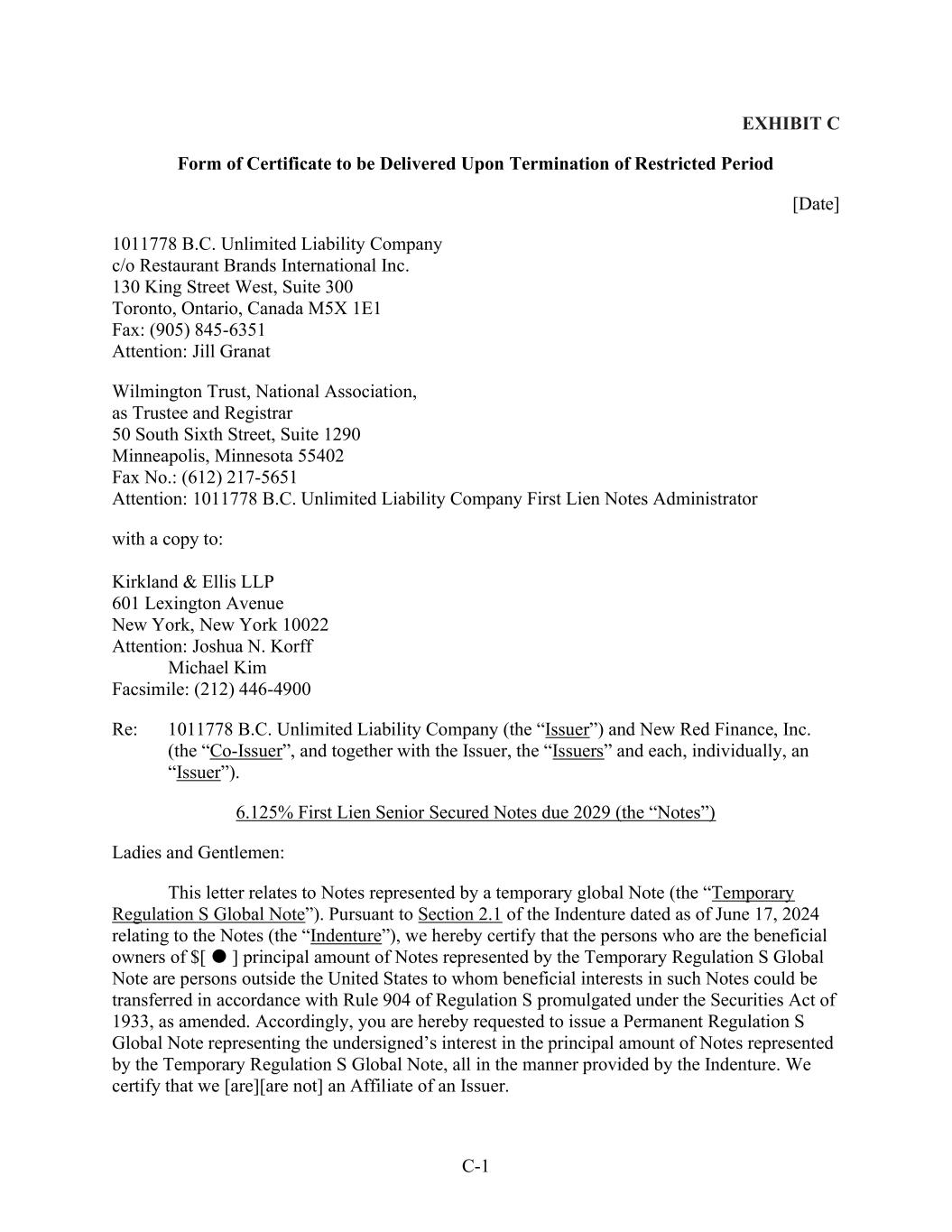
C-1 EXHIBIT C Form of Certificate to be Delivered Upon Termination of Restricted Period [Date] 1011778 B.C. Unlimited Liability Company c/o Restaurant Brands International Inc. 000 Xxxx Xxxxxx Xxxx, Xxxxx 000 Xxxxxxx, Xxxxxxx, Xxxxxx X0X 0X0 Fax: (000) 000-0000 Attention: Xxxx Xxxxxx Xxxmington Trust, National Association, as Trustee and Registrar 00 Xxxxx Xxxxx Xxxxxx, Xxxxx 0000 Xxxxxxxxxxx, Xxxxxxxxx 00000 Fax No.: (000) 000-0000 Attention: 1011778 B.C. Unlimited Liability Company First Lien Notes Administrator with a copy to: Xxxxxxxx & Xxxxx LLP 000 Xxxxxxxxx Xxxxxx Xxx Xxxx, Xxx Xxxx 00000 Attention: Xxxxxx X. Xxxxx Xxxxxxx Xxx Facsimile: (000) 000-0000 Re: 1011778 B.C. Unlimited Liability Company (the “Issuer”) and New Red Finance, Inc. (the “Co-Issuer”, and together with the Issuer, the “Issuers” and each, individually, an “Issuer”). 6.125% First Lien Senior Secured Notes due 2029 (the “Notes”) Ladies and Gentlemen: This letter relates to Notes represented by a temporary global Note (the “Temporary Regulation S Global Note”). Pursuant to Section 2.1 of the Indenture dated as of June 17, 2024 relating to the Notes (the “Indenture”), we hereby certify that the persons who are the beneficial owners of $[ ] principal amount of Notes represented by the Temporary Regulation S Global Note are persons outside the United States to whom beneficial interests in such Notes could be transferred in accordance with Rule 904 of Regulation S promulgated under the Securities Act of 1933, as amended. Accordingly, you are hereby requested to issue a Permanent Regulation S Global Note representing the undersigned’s interest in the principal amount of Notes represented by the Temporary Regulation S Global Note, all in the manner provided by the Indenture. We certify that we [are][are not] an Affiliate of an Issuer.
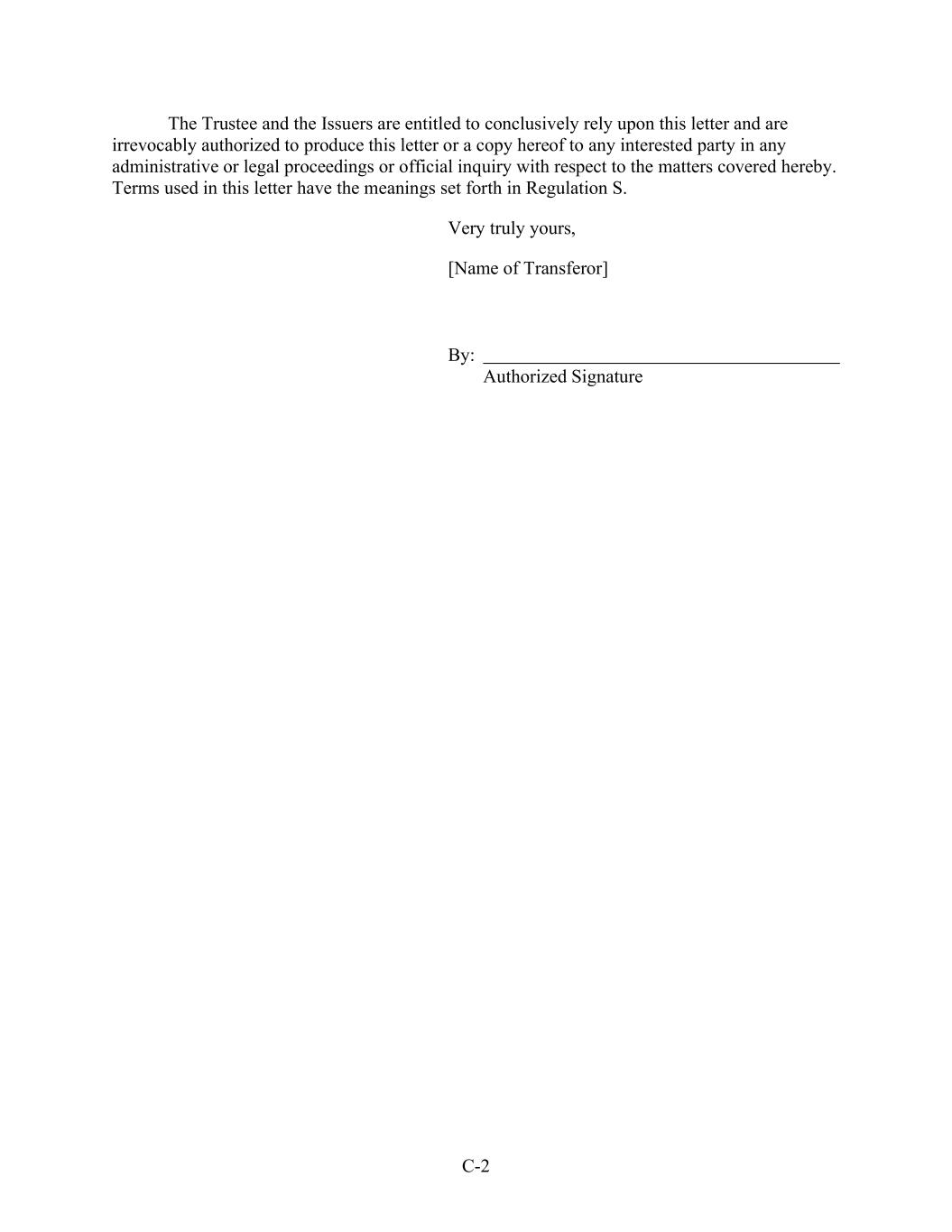
C-2 The Trustee and the Issuers are entitled to conclusively rely upon this letter and are irrevocably authorized to produce this letter or a copy hereof to any interested party in any administrative or legal proceedings or official inquiry with respect to the matters covered hereby. Terms used in this letter have the meanings set forth in Regulation S. Very truly yours, [Name of Transferor] By: Authorized Signature
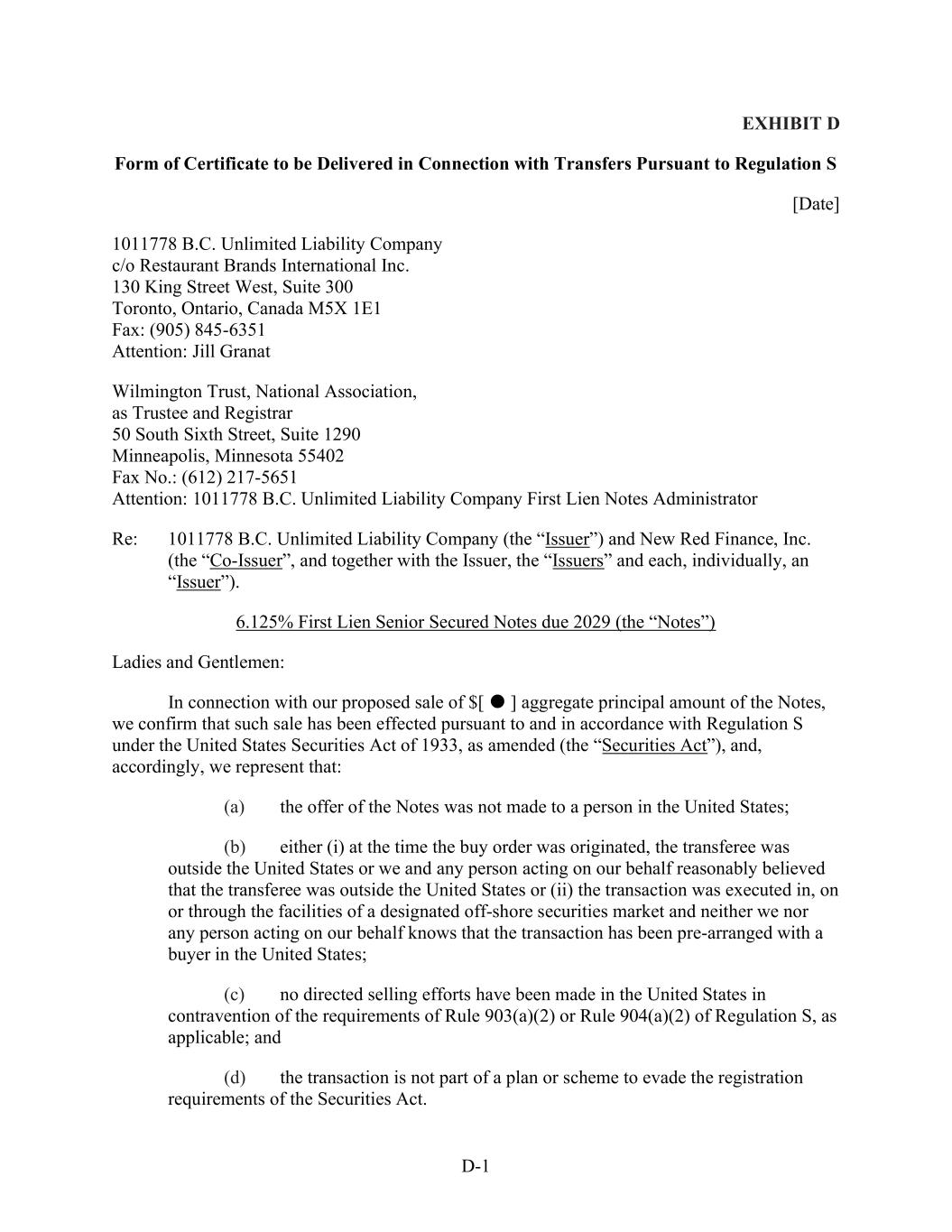
D-1 EXHIBIT D Form of Certificate to be Delivered in Connection with Transfers Pursuant to Regulation S [Date] 1011778 B.C. Unlimited Liability Company c/o Restaurant Brands International Inc. 000 Xxxx Xxxxxx Xxxx, Xxxxx 000 Xxxxxxx, Xxxxxxx, Xxxxxx X0X 0X0 Fax: (000) 000-0000 Attention: Xxxx Xxxxxx Xxxmington Trust, National Association, as Trustee and Registrar 00 Xxxxx Xxxxx Xxxxxx, Xxxxx 0000 Xxxxxxxxxxx, Xxxxxxxxx 00000 Fax No.: (000) 000-0000 Attention: 1011778 B.C. Unlimited Liability Company First Lien Notes Administrator Re: 1011778 B.C. Unlimited Liability Company (the “Issuer”) and New Red Finance, Inc. (the “Co-Issuer”, and together with the Issuer, the “Issuers” and each, individually, an “Issuer”). 6.125% First Lien Senior Secured Notes due 2029 (the “Notes”) Ladies and Gentlemen: In connection with our proposed sale of $[ ] aggregate principal amount of the Notes, we confirm that such sale has been effected pursuant to and in accordance with Regulation S under the United States Securities Act of 1933, as amended (the “Securities Act”), and, accordingly, we represent that: (a) the offer of the Notes was not made to a person in the United States; (b) either (i) at the time the buy order was originated, the transferee was outside the United States or we and any person acting on our behalf reasonably believed that the transferee was outside the United States or (ii) the transaction was executed in, on or through the facilities of a designated off-shore securities market and neither we nor any person acting on our behalf knows that the transaction has been pre-arranged with a buyer in the United States; (c) no directed selling efforts have been made in the United States in contravention of the requirements of Rule 903(a)(2) or Rule 904(a)(2) of Regulation S, as applicable; and (d) the transaction is not part of a plan or scheme to evade the registration requirements of the Securities Act.
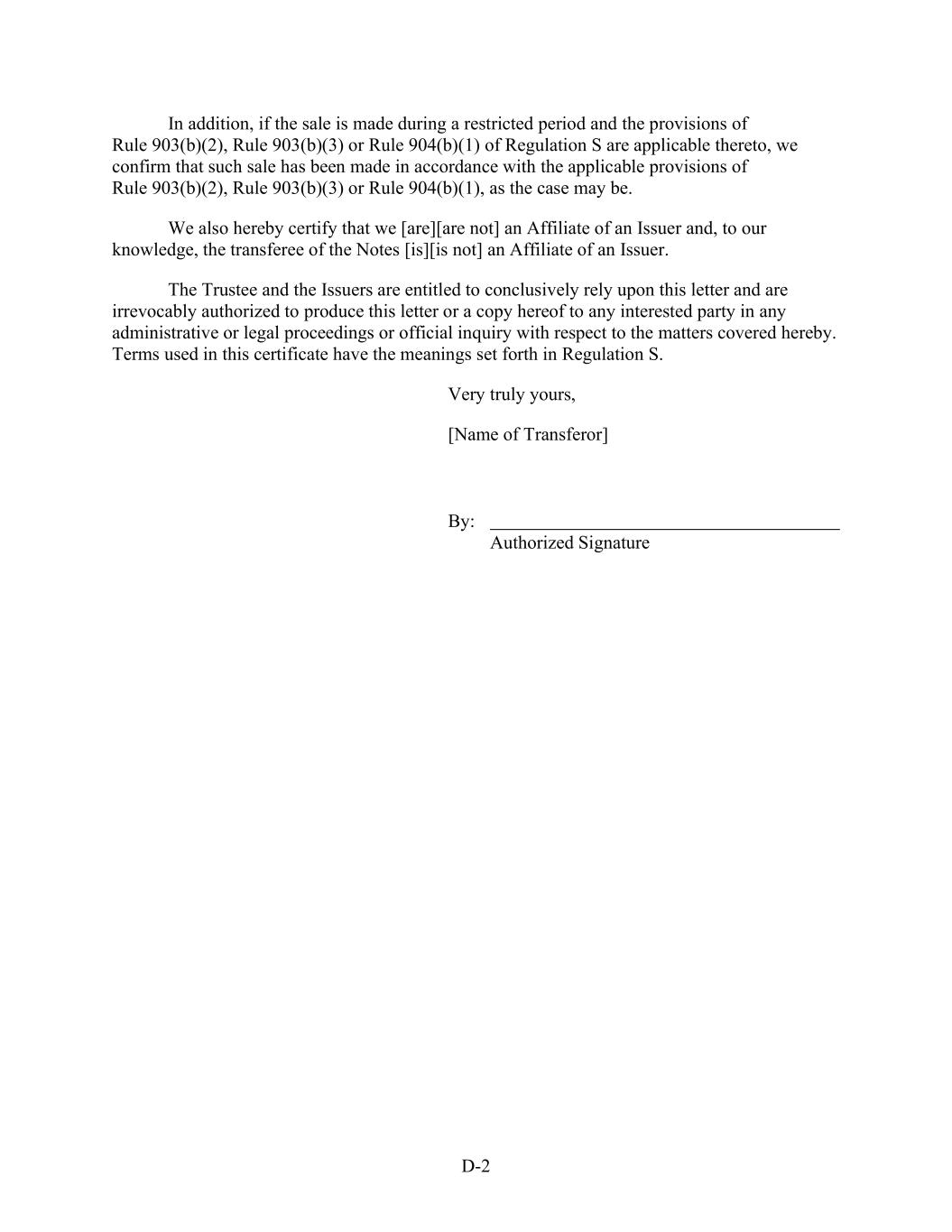
D-2 In addition, if the sale is made during a restricted period and the provisions of Rule 903(b)(2), Rule 903(b)(3) or Rule 904(b)(1) of Regulation S are applicable thereto, we confirm that such sale has been made in accordance with the applicable provisions of Rule 903(b)(2), Rule 903(b)(3) or Rule 904(b)(1), as the case may be. We also hereby certify that we [are][are not] an Affiliate of an Issuer and, to our knowledge, the transferee of the Notes [is][is not] an Affiliate of an Issuer. The Trustee and the Issuers are entitled to conclusively rely upon this letter and are irrevocably authorized to produce this letter or a copy hereof to any interested party in any administrative or legal proceedings or official inquiry with respect to the matters covered hereby. Terms used in this certificate have the meanings set forth in Regulation S. Very truly yours, [Name of Transferor] By: Authorized Signature
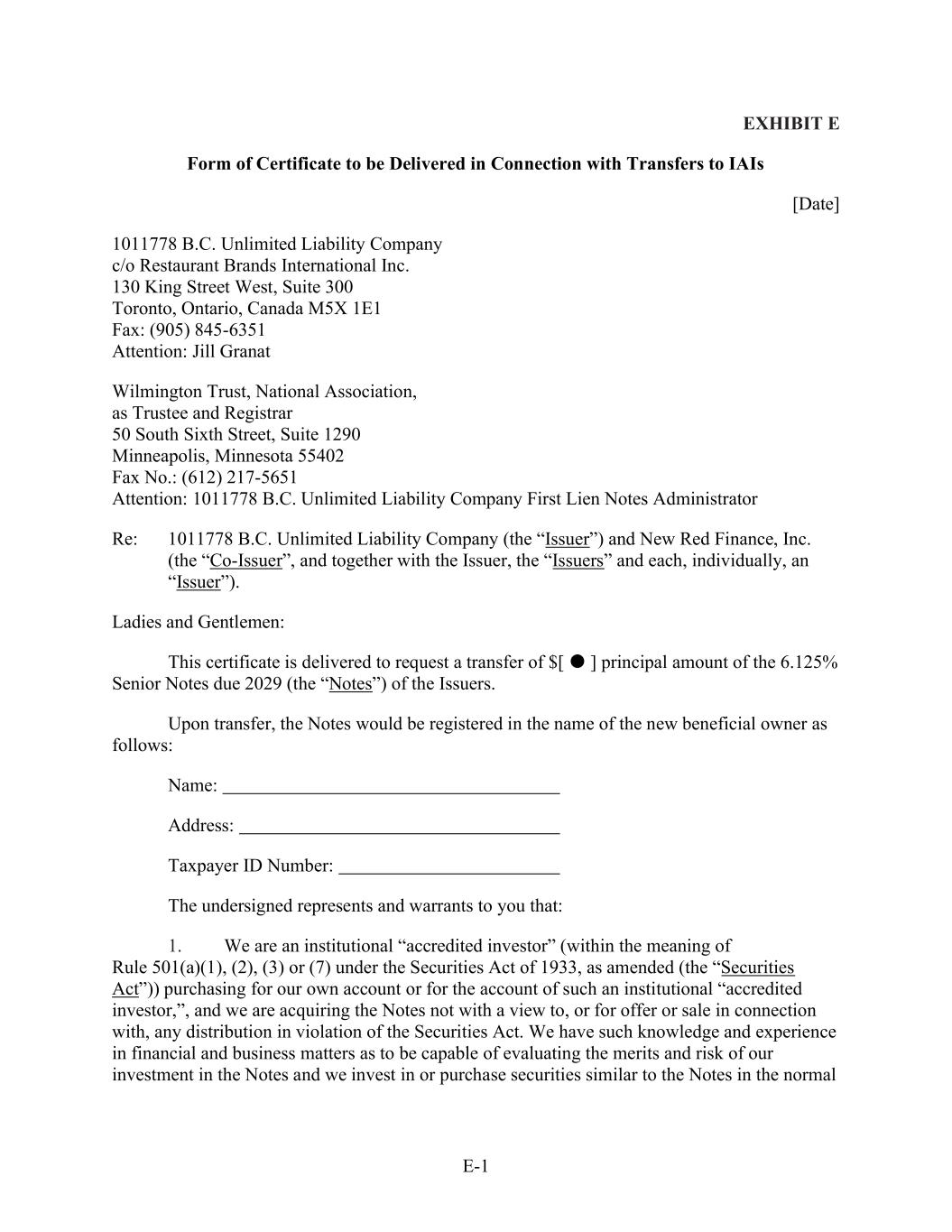
E-1 EXHIBIT E Form of Certificate to be Delivered in Connection with Transfers to IAIs [Date] 1011778 B.C. Unlimited Liability Company c/o Restaurant Brands International Inc. 000 Xxxx Xxxxxx Xxxx, Xxxxx 000 Xxxxxxx, Xxxxxxx, Xxxxxx X0X 0X0 Fax: (000) 000-0000 Attention: Xxxx Xxxxxx Wilmington Trust, National Association, as Trustee and Registrar 00 Xxxxx Xxxxx Xxxxxx, Xxxxx 0000 Xxxxxxxxxxx, Xxxxxxxxx 00000 Fax No.: (000) 000-0000 Attention: 1011778 B.C. Unlimited Liability Company First Lien Notes Administrator Re: 1011778 B.C. Unlimited Liability Company (the “Issuer”) and New Red Finance, Inc. (the “Co-Issuer”, and together with the Issuer, the “Issuers” and each, individually, an “Issuer”). Ladies and Gentlemen: This certificate is delivered to request a transfer of $[ ] principal amount of the 6.125% Senior Notes due 2029 (the “Notes”) of the Issuers. Upon transfer, the Notes would be registered in the name of the new beneficial owner as follows: Name: Address: Taxpayer ID Number: The undersigned represents and warrants to you that: 1. We are an institutional “accredited investor” (within the meaning of Rule 501(a)(1), (2), (3) or (7) under the Securities Act of 1933, as amended (the “Securities Act”)) purchasing for our own account or for the account of such an institutional “accredited investor,”, and we are acquiring the Notes not with a view to, or for offer or sale in connection with, any distribution in violation of the Securities Act. We have such knowledge and experience in financial and business matters as to be capable of evaluating the merits and risk of our investment in the Notes and we invest in or purchase securities similar to the Notes in the normal
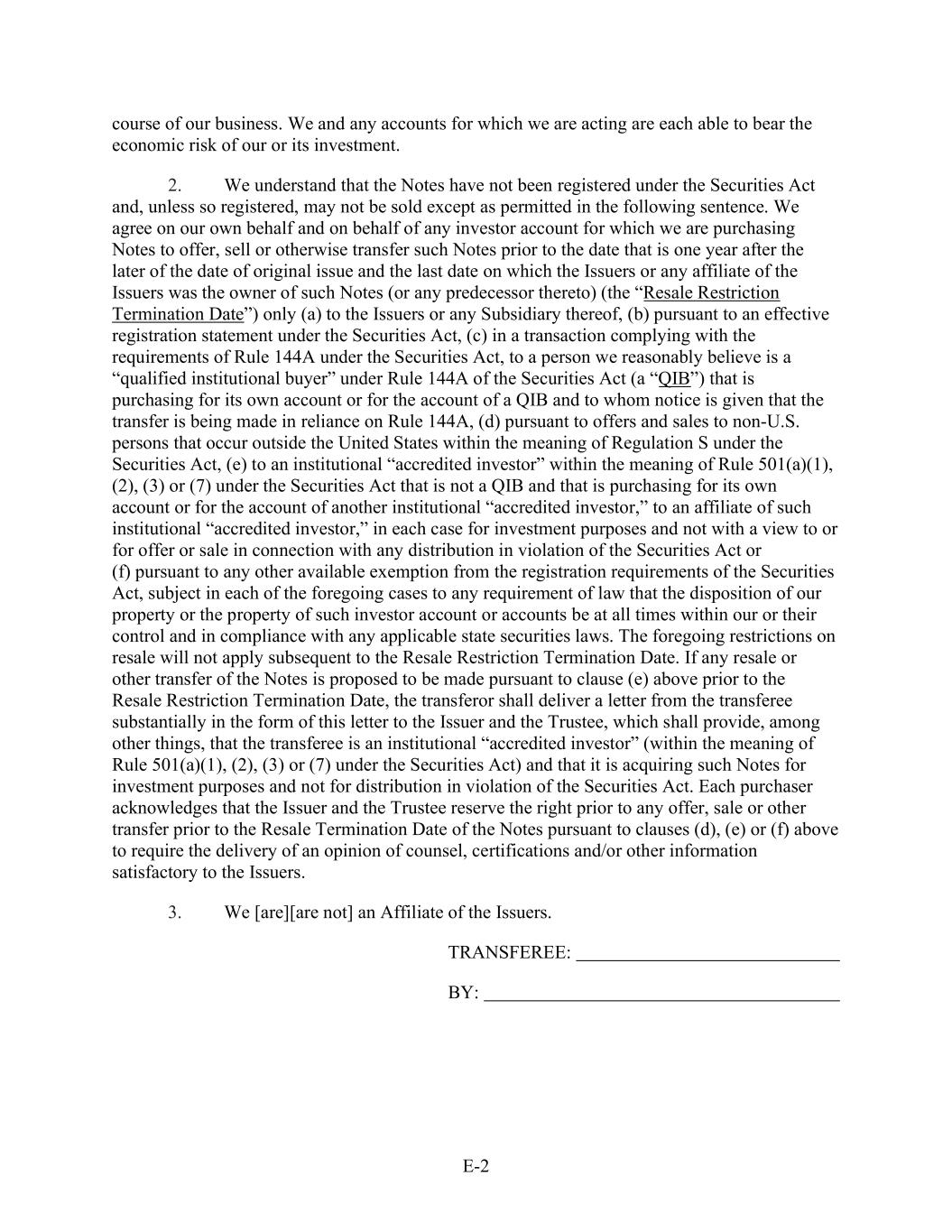
E-2 course of our business. We and any accounts for which we are acting are each able to bear the economic risk of our or its investment. 2. We understand that the Notes have not been registered under the Securities Act and, unless so registered, may not be sold except as permitted in the following sentence. We agree on our own behalf and on behalf of any investor account for which we are purchasing Notes to offer, sell or otherwise transfer such Notes prior to the date that is one year after the later of the date of original issue and the last date on which the Issuers or any affiliate of the Issuers was the owner of such Notes (or any predecessor thereto) (the “Resale Restriction Termination Date”) only (a) to the Issuers or any Subsidiary thereof, (b) pursuant to an effective registration statement under the Securities Act, (c) in a transaction complying with the requirements of Rule 144A under the Securities Act, to a person we reasonably believe is a “qualified institutional buyer” under Rule 144A of the Securities Act (a “QIB”) that is purchasing for its own account or for the account of a QIB and to whom notice is given that the transfer is being made in reliance on Rule 144A, (d) pursuant to offers and sales to non-U.S. persons that occur outside the United States within the meaning of Regulation S under the Securities Act, (e) to an institutional “accredited investor” within the meaning of Rule 501(a)(1), (2), (3) or (7) under the Securities Act that is not a QIB and that is purchasing for its own account or for the account of another institutional “accredited investor,” to an affiliate of such institutional “accredited investor,” in each case for investment purposes and not with a view to or for offer or sale in connection with any distribution in violation of the Securities Act or (f) pursuant to any other available exemption from the registration requirements of the Securities Act, subject in each of the foregoing cases to any requirement of law that the disposition of our property or the property of such investor account or accounts be at all times within our or their control and in compliance with any applicable state securities laws. The foregoing restrictions on resale will not apply subsequent to the Resale Restriction Termination Date. If any resale or other transfer of the Notes is proposed to be made pursuant to clause (e) above prior to the Resale Restriction Termination Date, the transferor shall deliver a letter from the transferee substantially in the form of this letter to the Issuer and the Trustee, which shall provide, among other things, that the transferee is an institutional “accredited investor” (within the meaning of Rule 501(a)(1), (2), (3) or (7) under the Securities Act) and that it is acquiring such Notes for investment purposes and not for distribution in violation of the Securities Act. Each purchaser acknowledges that the Issuer and the Trustee reserve the right prior to any offer, sale or other transfer prior to the Resale Termination Date of the Notes pursuant to clauses (d), (e) or (f) above to require the delivery of an opinion of counsel, certifications and/or other information satisfactory to the Issuers. 3. We [are][are not] an Affiliate of the Issuers. TRANSFEREE: BY:























































































